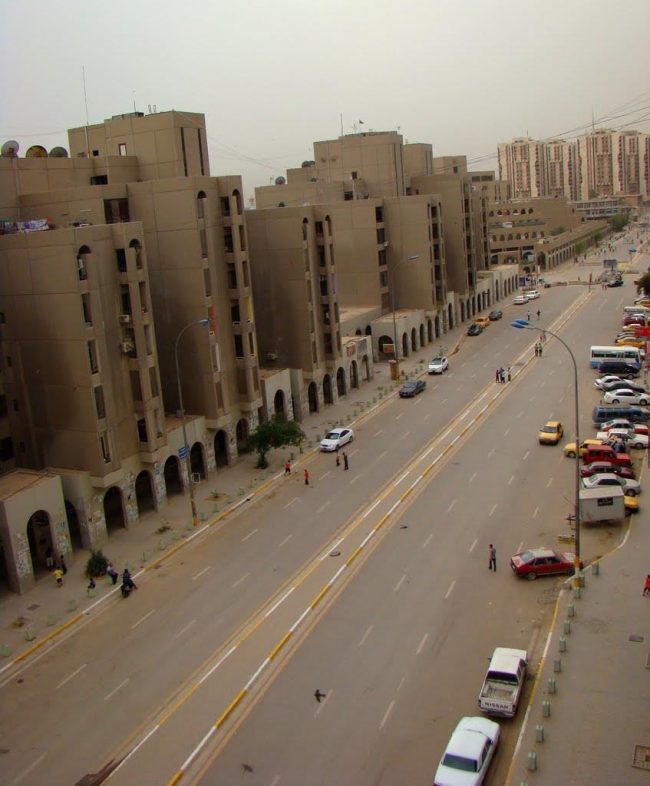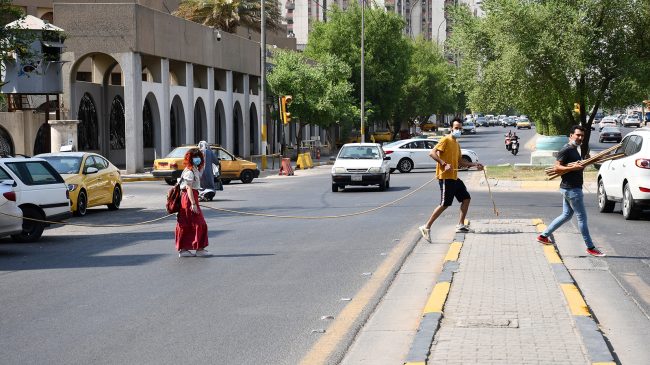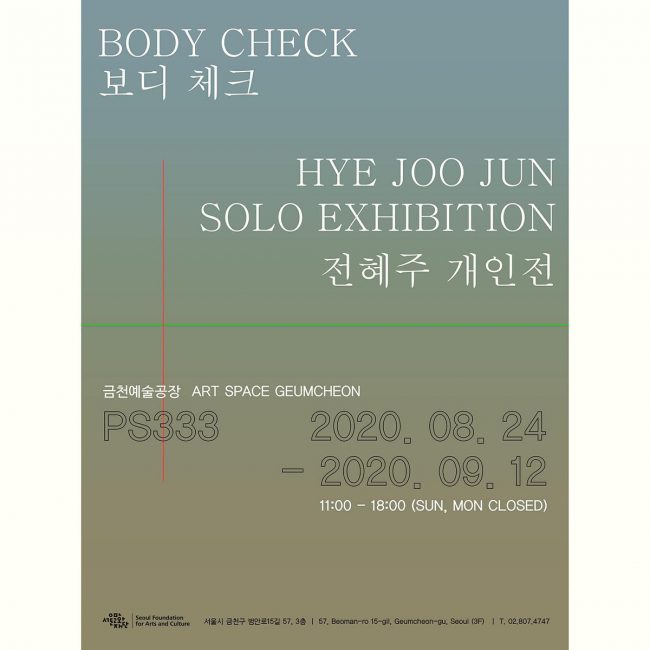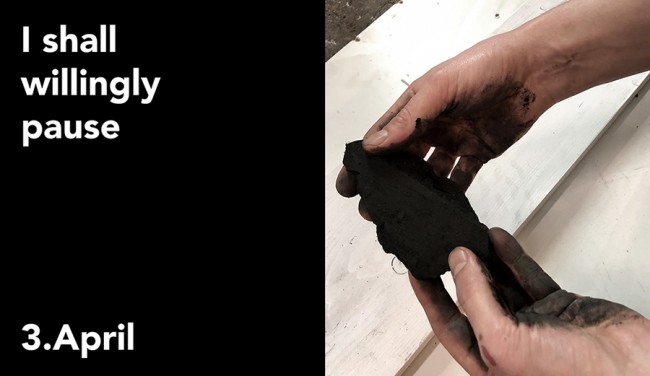27 - 28 October 2023 / Collaboration, Exhibition ⟶
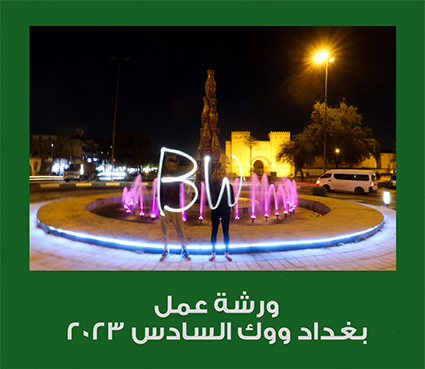
Baghdad Walk VI
Baghdad Walk IVGroup exhibition in public space
Baghdad Walk is an annual series of workshops culminating in a group exhibition presented in public spaces across the city of Baghdad. This year’s sixth edition – Baghdad Walk VI – took place over two meandering days in the vicinity of Al-Alawi and Al-Sarafiya Bridge. Fifteen Iraqi artists presented their works in a variety of artistic medias and expressive forms, addressing fundamental topics from human rights to climate change. The works speak to how these topical issues manifest in the artists’ surroundings and how the infringement of these rights effects their lives and the broader community.
The presented works demonstrate how upcoming generations are making sense of the changing social, political and environmental dynamics in Iraq. Many artists have taken the opportunity to focuses on artivism – artistic activism – in order to create public awareness around pressing societal issues like child labour, housing, water scarcity, environmental pollution, women’s roles in the public sphere, climate migration, land-use planning, injustice, politicized infrastructure, and coping strategies for collective and personal trauma.
Baghdad Walk IV features site-specific interventions and presentations by the following artists: Sally Naeem, Zahraa Soubhi, Noor Abd Ali, Razan Aldouri, Amnah Ali, Mahmoud Mohammed, Loay Al Hadhary, Muhaned Taha, Mohammed Kadhim, Atef Al Jaffal, Hassan Al Narjes, Haider Almaslmawe, Taqi Mohammed, Hussam Mohammed, Tarkib Collaboration.
Workshops and curatorial support: Susanne Bosch, Hella Mewis, Christina Werner
Please find the project’s bilingual (Englisch-Arabic) website here.
Baghdad Walk VI is conceptualized and organized by Tarkib and the Institut für Raumexperimente (Institute for Spatial Experiments), Berlin, and in collaboration with UNAMI Human Rights Office, the Embassy of the Kingdom of Netherlands to Iraq and Arab Fund for Arts and Culture (AFAC).
Photos: Hella Mewis, Zahraa Soubhi, Hassan Al Narjes, Atef Al Jaffal
Baghdad Walk IVGroup exhibition in public space
Baghdad Walk is an annual series of workshops culminating in a group exhibition presented in public spaces across the city of Baghdad. This year’s sixth edition – Baghdad Walk VI – took place over two meandering days in the vicinity of Al-Alawi and Al-Sarafiya Bridge. Fifteen Iraqi artists presented their works in a variety of artistic medias and expressive forms, addressing fundamental topics from human rights to climate change. The works speak to how these topical issues manifest in the artists’ surroundings and how the infringement of these rights effects their lives and the broader community.
The presented works demonstrate how upcoming generations are making sense of the changing social, political and environmental dynamics in Iraq. Many artists have taken the opportunity to focuses on artivism – artistic activism – in order to create public awareness around pressing societal issues like child labour, housing, water scarcity, environmental pollution, women’s roles in the public sphere, climate migration, land-use planning, injustice, politicized infrastructure, and coping strategies for collective and personal trauma.
Baghdad Walk IV features site-specific interventions and presentations by the following artists: Sally Naeem, Zahraa Soubhi, Noor Abd Ali, Razan Aldouri, Amnah Ali, Mahmoud Mohammed, Loay Al Hadhary, Muhaned Taha, Mohammed Kadhim, Atef Al Jaffal, Hassan Al Narjes, Haider Almaslmawe, Taqi Mohammed, Hussam Mohammed, Tarkib Collaboration.
Workshops and curatorial support: Susanne Bosch, Hella Mewis, Christina Werner
Please find the project’s bilingual (Englisch-Arabic) website here.
Baghdad Walk VI is conceptualized and organized by Tarkib and the Institut für Raumexperimente (Institute for Spatial Experiments), Berlin, and in collaboration with UNAMI Human Rights Office, the Embassy of the Kingdom of Netherlands to Iraq and Arab Fund for Arts and Culture (AFAC).
Photos: Hella Mewis, Zahraa Soubhi, Hassan Al Narjes, Atef Al Jaffal
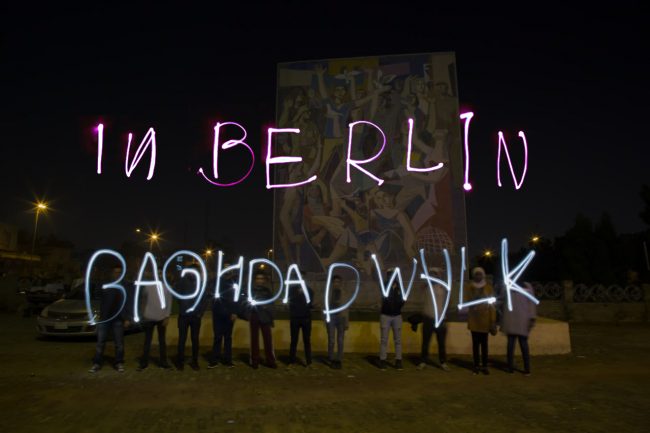
Baghdad Walk in Berlin at Salon am Moritzplatz
Salon am Moritzplatz, Oranienstraße 58, 10969 Berlin
Opening: 23 June at 6 pm
24 June — 26 June 2022. Daily from 2 pm to 8 pm
BAGHDAD WALK is an annual group exhibitions series which takes place in public spaces across the city of Baghdad, Iraq. BAGHDAD WALK IN BERLIN presents selected works by emerging Iraqi artists at Salon am Moritzplatz.
Since 2018, the independent artist group TARKIB has organised an ongoing series of art workshops and seminars in Baghdad in cooperation with the Goethe-Institut Irak and the Institut für Raumexperimente in Berlin, which culminate in the exhibition series BAGHDAD WALK. Urban realities and decisive events that have become part of Baghdad’s collective cultural memory are creatively explored and the artists’ works offer moments of reflection.
The exhibition in Berlin reveals how the participating artists develop artistic strategies and narratives in Baghdad’s public spaces. The shared experiences of the interventions on the streets of Baghdad are transferred into an exhibition format presenting photography, video, sound, painting, and documentation of performances and art interventions that collaboratively connect perspectives from Baghdad and Berlin. Works by Berlin-based artists who took part in the seminar series and previously hosted artistic projects in Baghdad are presented in dialogue with works of the participating Iraqi artists. Five of the exhibiting artists from Baghdad as well as the Berlin-based artists will be present at the opening.
–
With contributions by Tabarek Al Atrakchi @_tabiii9, Atef Al Jaffal @atef.ja, Muntadher Amel @muntadheramal, Shams Aqeel @tooshiepie, Loay Al Hadhary @artist_loay_alhadhary, Fabian Knecht @studiofabianknecht, Hella Mewis, Hussam Mohammed @husam_mohammed_a, Ameen Mokdad @ameen_mokdad, Yousr Mokdad @yousr.mokdad, Hussain Muttar @hussain_a_mutar, Fatima Dhahi, Hajer Qusay @hajer_qussay, Zaid Saad @zaid_saad_a, Muhaned Taha @mohanad_taha_k, Vlado Velkov #vladovelkov, Raul Walch @raulwalch, Basma Watheq.
Please find the project’s bilingual (Englisch-Arabic) website here.
–
Baghdad Walk is a project by the Goethe-Institut Irak, conceived and organised in collaboration with the Institut für Raumexperimente (Institute for Spatial Experiments), Berlin and hosted by TARKIB Baghdad Contemporary Arts Institute in BAIT TARKIB, choreographed by Hella Mewis and Christina Werner. It is the result of the workshop series „Arts Seminar in Baghdad“.
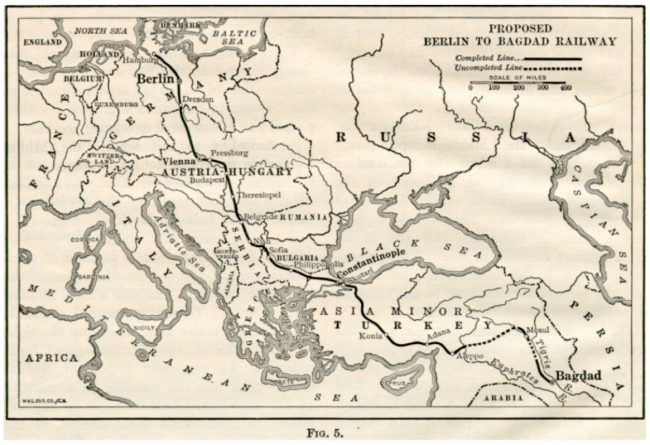
Arts Seminar in Baghdad, 2021
Revised design for Baghdad Railway Station drawn by Frank A Evans. Credit: Barry Joyce
Arts Seminar in Baghdad – Workshop Series
Arts Seminar in Baghdad is a workshop series that invites Iraqi artists and creatives to engage with their art works and interventions in the urban space of Baghdad. The seminar starts with a kick-off session – workshops and exercises at TARKIB Baghdad Contemporary Arts Institute and in the city –, followed by regular mentoring sessions and results in an group exhibition in Baghdad. The latest edition – Baghdad Walk IV – took place at Baghdad Central Station.
Participants:
Mayar Abdulkareem, Atef Al Jaffal, Zahraa Al Obaidi, Muntadher Amel, Anees Amer, Shams Aqeel, Tabarek Al Atrakchi, Fatima Dhahir, Loay Al Hadhary, Maryam Hazim, Zahraa Hassan, Nada Hussain, Hella Mewis, Hussam Mohammed, Ameen Mokdad, Yousr Mokdad, Hussain Muttar, Mohammed Nameer, Karrar Saad, Zaid Saad, Muhaned Taha, Basma Watheq, Mohanad Yakoob, Rose Yousif
–
The workshop series Arts Seminar in Baghdad is conceived and organised by the Goethe-Institut Irak, in collaboration with the Institut für Raumexperimente (Institut for Spatial Experiments), Berlin and hosted by TARKIB Baghdad Contemporary Arts Institute in BAIT TARKIB. The series is choreographed by Christina Werner and realized with support by Hella Mewis.
–
Revised design for Baghdad Railway Station drawn by Frank A Evans. Credit: Barry Joyce
Arts Seminar in Baghdad – Workshop Series
Arts Seminar in Baghdad is a workshop series that invites Iraqi artists and creatives to engage with their art works and interventions in the urban space of Baghdad. The seminar starts with a kick-off session – workshops and exercises at TARKIB Baghdad Contemporary Arts Institute and in the city –, followed by regular mentoring sessions and results in an group exhibition in Baghdad. The latest edition – Baghdad Walk IV – took place at Baghdad Central Station.
Participants:
Mayar Abdulkareem, Atef Al Jaffal, Zahraa Al Obaidi, Muntadher Amel, Anees Amer, Shams Aqeel, Tabarek Al Atrakchi, Fatima Dhahir, Loay Al Hadhary, Maryam Hazim, Zahraa Hassan, Nada Hussain, Hella Mewis, Hussam Mohammed, Ameen Mokdad, Yousr Mokdad, Hussain Muttar, Mohammed Nameer, Karrar Saad, Zaid Saad, Muhaned Taha, Basma Watheq, Mohanad Yakoob, Rose Yousif
–
The workshop series Arts Seminar in Baghdad is conceived and organised by the Goethe-Institut Irak, in collaboration with the Institut für Raumexperimente (Institut for Spatial Experiments), Berlin and hosted by TARKIB Baghdad Contemporary Arts Institute in BAIT TARKIB. The series is choreographed by Christina Werner and realized with support by Hella Mewis.
–
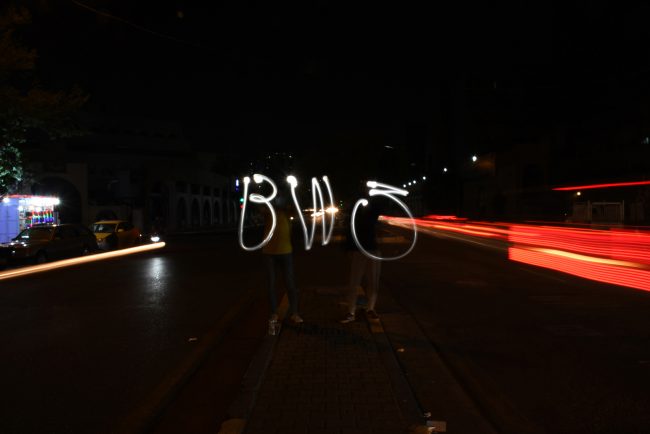
Baghdad Walk III
Baghdad Walk IIIGroup exhibition in public space
BAGHDAD WALK is a series of group exhibitions in public spaces across the city of Baghdad, Iraq. Th third edition of these art walks – Baghdad Walk III – took place along Haifa Street in November 2020, featuring site-specific interventions and presentations by the following artists:
Ali Adnan, Anees Amer, Shams Aqeel, Tabarek Al Atrakchi, Loay Al Hadhary, Hussam Mohammed, Ameen Mokdad, Hussain Muttar, Hadjer Qusay, Zaid Saad, Zain Saad, Muhaned Taha
–
Please find the project’s bilingual (Englisch-Arabic) website here.
–
Baghdad Walk is a project by the Goethe-Institut Irak, conceived and organised in collaboration with the Institut für Raumexperimente (Institute for Spatial Experiments), Berlin and hosted by TARKIB Baghdad Contemporary Arts Institute in BAIT TARKIB, choreographed by Hella Mewis and Christina Werner. It is the result of the workshop series „Arts Seminar in Baghdad“.
Photos: Ameen Mokdad, Anees Amer, Atef Al Jaffal
Baghdad Walk IIIGroup exhibition in public space
BAGHDAD WALK is a series of group exhibitions in public spaces across the city of Baghdad, Iraq. Th third edition of these art walks – Baghdad Walk III – took place along Haifa Street in November 2020, featuring site-specific interventions and presentations by the following artists:
Ali Adnan, Anees Amer, Shams Aqeel, Tabarek Al Atrakchi, Loay Al Hadhary, Hussam Mohammed, Ameen Mokdad, Hussain Muttar, Hadjer Qusay, Zaid Saad, Zain Saad, Muhaned Taha
–
Please find the project’s bilingual (Englisch-Arabic) website here.
–
Baghdad Walk is a project by the Goethe-Institut Irak, conceived and organised in collaboration with the Institut für Raumexperimente (Institute for Spatial Experiments), Berlin and hosted by TARKIB Baghdad Contemporary Arts Institute in BAIT TARKIB, choreographed by Hella Mewis and Christina Werner. It is the result of the workshop series „Arts Seminar in Baghdad“.
Photos: Ameen Mokdad, Anees Amer, Atef Al Jaffal
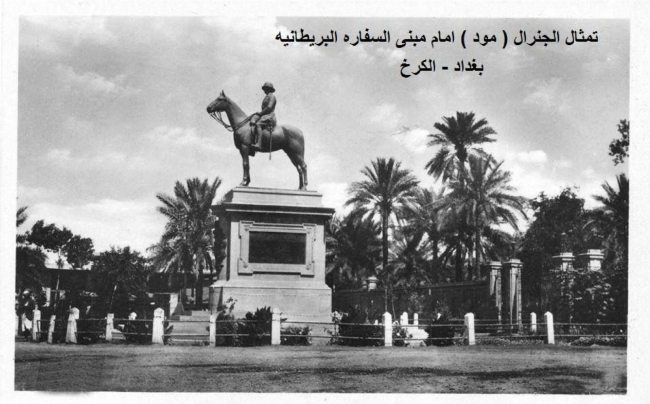
Kick-Off Workshop – Day 1
Presentations and workshops
King Faysal I by Pietro Canonica, 1933 and 2020
Haifa Street from the roof top and Haifa Street in the distance, photos by Hussain Muttar
Development plans for Haifa Street by the Municipality of Baghdad, early 80ties
Presentations and workshops
King Faysal I by Pietro Canonica, 1933 and 2020
Haifa Street from the roof top and Haifa Street in the distance, photos by Hussain Muttar
Development plans for Haifa Street by the Municipality of Baghdad, early 80ties

Arts Seminar in Baghdad, 2020
Arts Seminar in Baghdad – Workshop Series
Arts Seminar in Baghdad is a workshop series that prepares the participants to engage with their art works and interventions in the urban space of Baghdad. The seminar starts with a kick-off session – workshops and exercises at TARKIB Baghdad Contemporary Arts Institute and along Haifa Street –, followed by regular online sessions and results in an exhibition, that is also a guided tour of the city. The exhibition Baghdad Walk III will take place in November 2020 and presenting site-specific interventions along Haifa Street.
Baghdad Walk takes the Iraqi capital as a case study, addressing the memories embedded in the texture of urban life, from personal events and stories, to architectural heritage and public monuments, the urban web is saturated with memories to be re-visited and revealed.
Participants:
Ali Adnan, Anees Amer, Shams Aqeel, Tabarek Al Atrakchi, Loay Al Hadhary, Hussam Mohammed, Ameen Mokdad, Hussain Muttar, Hadjer Qusay, Zaid Saad, Zain Saad, Muhaned Taha
–
The workshop series Arts Seminar in Baghdad is conceived and organised by the Goethe-Institut Irak, in collaboration with the Institut für Raumexperimente (Institut for Spatial Experiments), Berlin and hosted by TARKIB Baghdad Contemporary Arts Institute in BAIT TARKIB. The series is choreographed by Christina Werner and realized with support by Hella Mewis.
Arts Seminar in Baghdad – Workshop Series
Arts Seminar in Baghdad is a workshop series that prepares the participants to engage with their art works and interventions in the urban space of Baghdad. The seminar starts with a kick-off session – workshops and exercises at TARKIB Baghdad Contemporary Arts Institute and along Haifa Street –, followed by regular online sessions and results in an exhibition, that is also a guided tour of the city. The exhibition Baghdad Walk III will take place in November 2020 and presenting site-specific interventions along Haifa Street.
Baghdad Walk takes the Iraqi capital as a case study, addressing the memories embedded in the texture of urban life, from personal events and stories, to architectural heritage and public monuments, the urban web is saturated with memories to be re-visited and revealed.
Participants:
Ali Adnan, Anees Amer, Shams Aqeel, Tabarek Al Atrakchi, Loay Al Hadhary, Hussam Mohammed, Ameen Mokdad, Hussain Muttar, Hadjer Qusay, Zaid Saad, Zain Saad, Muhaned Taha
–
The workshop series Arts Seminar in Baghdad is conceived and organised by the Goethe-Institut Irak, in collaboration with the Institut für Raumexperimente (Institut for Spatial Experiments), Berlin and hosted by TARKIB Baghdad Contemporary Arts Institute in BAIT TARKIB. The series is choreographed by Christina Werner and realized with support by Hella Mewis.

Baghdad Walk IV
Baghdad Walk IVGroup exhibition in public space
BAGHDAD WALK is a series of group exhibitions in public spaces across the city of Baghdad, Iraq. The latest edition of these art walks – Baghdad Walk IV – took place at Baghdad Central Station.
Baghdad Walk IV features site-specific interventions and presentations by the following artists:
Mayar Abdulkareem, Atef Al Jaffal, Zahraa Al Obaidi, Muntadher Amel, Anees Amer, Shams Aqeel, Tabarek Al Atrakchi, Fatima Dhahir, Loay Al Hadhary, Maryam Hazim, Zahraa Hassan, Nada Hussain, Hella Mewis, Hussam Mohammed, Ameen Mokdad, Yousr Mokdad, Hussain Muttar, Mohammed Nameer, Karrar Saad, Zaid Saad, Muhaned Taha, Basma Watheq, Mohanad Yakoob, Rose Yousif
Please find the project’s bilingual (Englisch-Arabic) website here.
–
Baghdad Walk is a project by the Goethe-Institut Irak, conceived and organised in collaboration with the Institut für Raumexperimente (Institute for Spatial Experiments), Berlin and hosted by TARKIB Baghdad Contemporary Arts Institute in BAIT TARKIB, choreographed by Hella Mewis and Christina Werner. It is the result of the workshop series „Arts Seminar in Baghdad“.
Photos: Hella Mewis, Anees Amer, Muntadher Amel
Baghdad Walk IVGroup exhibition in public space
BAGHDAD WALK is a series of group exhibitions in public spaces across the city of Baghdad, Iraq. The latest edition of these art walks – Baghdad Walk IV – took place at Baghdad Central Station.
Baghdad Walk IV features site-specific interventions and presentations by the following artists:
Mayar Abdulkareem, Atef Al Jaffal, Zahraa Al Obaidi, Muntadher Amel, Anees Amer, Shams Aqeel, Tabarek Al Atrakchi, Fatima Dhahir, Loay Al Hadhary, Maryam Hazim, Zahraa Hassan, Nada Hussain, Hella Mewis, Hussam Mohammed, Ameen Mokdad, Yousr Mokdad, Hussain Muttar, Mohammed Nameer, Karrar Saad, Zaid Saad, Muhaned Taha, Basma Watheq, Mohanad Yakoob, Rose Yousif
Please find the project’s bilingual (Englisch-Arabic) website here.
–
Baghdad Walk is a project by the Goethe-Institut Irak, conceived and organised in collaboration with the Institut für Raumexperimente (Institute for Spatial Experiments), Berlin and hosted by TARKIB Baghdad Contemporary Arts Institute in BAIT TARKIB, choreographed by Hella Mewis and Christina Werner. It is the result of the workshop series „Arts Seminar in Baghdad“.
Photos: Hella Mewis, Anees Amer, Muntadher Amel

NOWs: Hypochondria Heart by Nina Schuiki
Nina Schuiki: Sorrow Window, 2020. Spray paint, existing window panes
FORUM STADTPARK, Graz
curated by zweintopf
What we don’t want to do here is to place an eloquent text in front of the work of art, outlining the only correct and exclusively rational approach to the work. The installation created by Nina Schuiki for Forum Stadtpark attempts to carefully expose all that is hidden behind objects, and the text is also intended to emphasise this transparency of the work. “Transparency” writes Susan Sonntag “means experiencing the luminosity of the object itself, of all the things in its essence”[1]. Text should not interfere with the sensual experience of art. Instead, the viewers should be given the opportunity to re-activate their senses. Susan Sonntag’s statement “We must learn in order to see more, to hear more and to feel more”[2]provides clear instructions for visiting the exhibition.
“The space should remain as empty as possible; I want to emphasise the dialogue that takes place between inside and outside“ wrote Nina Schuiki in February 2020 when describing her site-specific installation. The exhibition originally would have been opened in May, so it was already set up before that. And still, one has to view the work at present both through the lens of the pandemic and in context with it. It is not possible to separate the two, because the work fits quite naturally within the framework of experiential and emotional references that we have been given during this momentous year. Good works of art often manage to make life more understandable to us in new ways. But sometimes it’s the other way around: Life or even a pandemic can enable us to understand art in a new way. As a watchword for the visual arts programme in Forum Stadpark, KUNST [ART] today means exactly that: Good art is always current. And its contemporary nature, its strategic position at a crossroads within society – with all of its trends and problems – also inspires Nina Schuiki in important ways. Her works walk the tightrope between comfort and discomfort and serve as an example of a “therapeutic use of art”. Aristotle cited this use in his philosophy: By challenging us, art brings hidden emotions to light and purifies them.[3]
The phrase “Hypochondria Heart”[4], chosen as the title of the exhibition, has been taken from a book by Svetlana Boym. It refers to nostalgia as an incurable illness, as a longing for another time and a primordial form of experiencing the sense of self, free from forced progress and productive time management. In this context, Nina Schuiki‘s persistent preoccupation with transience and continuity also adopts a utopian dimension – after all, she is searching for a time beyond time.
In her central work Sorrow Window, Nina Schuiki takes a characteristic window façade and creates a pattern based on photographs of broken panes of safetyglass that she found in public space; these images are then sprayed directly onto the pane. This thin membrane that is revealed between the art venue and the – in part politically and deliberately problematised – public sphere exposes a seeming fragility, which we may never have noticed before. Perhaps it has always been present. As Susan Sonntag writes, it is as if Nina Schuiki reduced the content of her work precisely for this reason, until the matter itself was exposed: the essence of this relationship between space, art and society. The English term sorrow indicates sadness, but also suffering, pain and grief. Sorrow Window thus becomes an existential wailing wall that subtly but urgently reveals what we potentially have to lose. In terms of places and relationships. So much has fallen by the wayside this year. And yet: We will get these back.
zweintopf 2020
[1] Susan Sonntag, Gegen Interpretation, in: Susan Sonntag, Kunst und Antikunst. 24 literarischeAnalysen, Frankfurt, 201511, p. 21
[2] ditto, p. 22
[3] ditto,p. 11
[4] Svetlana Boym, The Future of Nostalgia, 2001
Video concept: Claudia Gerhäusser, Constantin Lederer, Nina Schuiki; Camera, Edit: Constantin Lederer Realtime Films; Text: Who Is Speaking, Bettina Landl, 2020; Speaker: Bettina Landl und Anja Korherr; Audio Recording: Arne Glöckner; Exhibition guard: Anja Korherr
WORKS:
DarknessSpoken, 2020. This work takes the idea of the spoken newspaper and runs with it. Emil Breisach used this format in the opening week of Forum Stadtpark to express current political commentary. Nina Schuiki has invited artists to provide her with text fragments at dark times. In the exhibition, these texts are kept deliberately short and are spoken into the space at a certain interval by a member of the supervisory staff. Selected texts by Melanie Ender, Elaine Wing-Ah Ho, Mihret Kebede, Bettina Landl and Catharina Szonn are performed orally within the exhibition.
For silence is a desolation scream inside your heart, 2020. Text, installed in three display windows in the outer façade
I still see you in everything (II), 2020. Tears, glass objects (hermetically sealed)
I still see you in everything (III), 2020. Eight-part photo series, direct print on white glass, each 20 cm in diameter
WoundsItch, 2019. Wax, colour pigments. According to an ancient custom practiced in Jerusalem, candles are cut to the exact height of a child and lit to ward off illness or stress. Nina Schuiki used black-coloured wax to assemble seven long, white candles from fragments.
Nina Schuiki: Sorrow Window, 2020. Spray paint, existing window panes
FORUM STADTPARK, Graz
curated by zweintopf
What we don’t want to do here is to place an eloquent text in front of the work of art, outlining the only correct and exclusively rational approach to the work. The installation created by Nina Schuiki for Forum Stadtpark attempts to carefully expose all that is hidden behind objects, and the text is also intended to emphasise this transparency of the work. “Transparency” writes Susan Sonntag “means experiencing the luminosity of the object itself, of all the things in its essence”[1]. Text should not interfere with the sensual experience of art. Instead, the viewers should be given the opportunity to re-activate their senses. Susan Sonntag’s statement “We must learn in order to see more, to hear more and to feel more”[2]provides clear instructions for visiting the exhibition.
“The space should remain as empty as possible; I want to emphasise the dialogue that takes place between inside and outside“ wrote Nina Schuiki in February 2020 when describing her site-specific installation. The exhibition originally would have been opened in May, so it was already set up before that. And still, one has to view the work at present both through the lens of the pandemic and in context with it. It is not possible to separate the two, because the work fits quite naturally within the framework of experiential and emotional references that we have been given during this momentous year. Good works of art often manage to make life more understandable to us in new ways. But sometimes it’s the other way around: Life or even a pandemic can enable us to understand art in a new way. As a watchword for the visual arts programme in Forum Stadpark, KUNST [ART] today means exactly that: Good art is always current. And its contemporary nature, its strategic position at a crossroads within society – with all of its trends and problems – also inspires Nina Schuiki in important ways. Her works walk the tightrope between comfort and discomfort and serve as an example of a “therapeutic use of art”. Aristotle cited this use in his philosophy: By challenging us, art brings hidden emotions to light and purifies them.[3]
The phrase “Hypochondria Heart”[4], chosen as the title of the exhibition, has been taken from a book by Svetlana Boym. It refers to nostalgia as an incurable illness, as a longing for another time and a primordial form of experiencing the sense of self, free from forced progress and productive time management. In this context, Nina Schuiki‘s persistent preoccupation with transience and continuity also adopts a utopian dimension – after all, she is searching for a time beyond time.
In her central work Sorrow Window, Nina Schuiki takes a characteristic window façade and creates a pattern based on photographs of broken panes of safetyglass that she found in public space; these images are then sprayed directly onto the pane. This thin membrane that is revealed between the art venue and the – in part politically and deliberately problematised – public sphere exposes a seeming fragility, which we may never have noticed before. Perhaps it has always been present. As Susan Sonntag writes, it is as if Nina Schuiki reduced the content of her work precisely for this reason, until the matter itself was exposed: the essence of this relationship between space, art and society. The English term sorrow indicates sadness, but also suffering, pain and grief. Sorrow Window thus becomes an existential wailing wall that subtly but urgently reveals what we potentially have to lose. In terms of places and relationships. So much has fallen by the wayside this year. And yet: We will get these back.
zweintopf 2020
[1] Susan Sonntag, Gegen Interpretation, in: Susan Sonntag, Kunst und Antikunst. 24 literarischeAnalysen, Frankfurt, 201511, p. 21
[2] ditto, p. 22
[3] ditto,p. 11
[4] Svetlana Boym, The Future of Nostalgia, 2001
Video concept: Claudia Gerhäusser, Constantin Lederer, Nina Schuiki; Camera, Edit: Constantin Lederer Realtime Films; Text: Who Is Speaking, Bettina Landl, 2020; Speaker: Bettina Landl und Anja Korherr; Audio Recording: Arne Glöckner; Exhibition guard: Anja Korherr
WORKS:
DarknessSpoken, 2020. This work takes the idea of the spoken newspaper and runs with it. Emil Breisach used this format in the opening week of Forum Stadtpark to express current political commentary. Nina Schuiki has invited artists to provide her with text fragments at dark times. In the exhibition, these texts are kept deliberately short and are spoken into the space at a certain interval by a member of the supervisory staff. Selected texts by Melanie Ender, Elaine Wing-Ah Ho, Mihret Kebede, Bettina Landl and Catharina Szonn are performed orally within the exhibition.
For silence is a desolation scream inside your heart, 2020. Text, installed in three display windows in the outer façade
I still see you in everything (II), 2020. Tears, glass objects (hermetically sealed)
I still see you in everything (III), 2020. Eight-part photo series, direct print on white glass, each 20 cm in diameter
WoundsItch, 2019. Wax, colour pigments. According to an ancient custom practiced in Jerusalem, candles are cut to the exact height of a child and lit to ward off illness or stress. Nina Schuiki used black-coloured wax to assemble seven long, white candles from fragments.
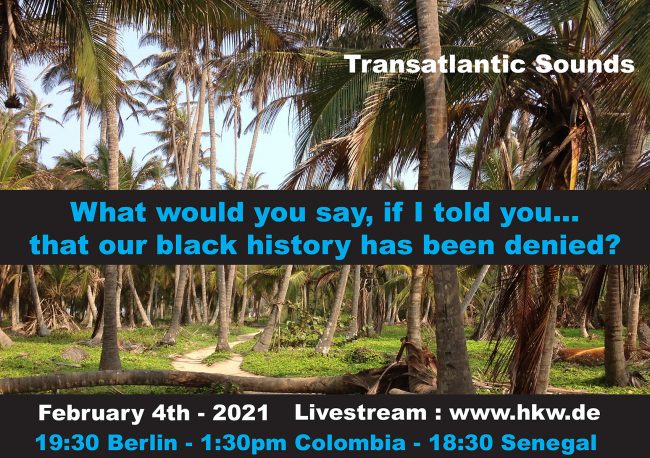
NOWs: Transatlantic Sounds
Transatlantic SoundsWhat would you say if I told you that our Black history has been denied?
as part of #Healing (Faju), New Alphabet School, HKW – Haus der Kulturen der Welt, Berlin
Thursday, Feb 4, 7.30–11pm
Sound marathon by Tomás Espinosa, Jorge Gómez, Carina Madsius and Linda-Philomène Tsoungui with Laeïla Adjovi, Margarita Ariza, Corinna Fiora, Mario Henao, Christian Howard Hooker, Ibaaku, Muhammed Lamin Jadama, LoMaasBello, Macú, Daba Makourejah, Daniela Maldonado (Red Comunitaria Trans), Plu con Pla, Johan Mijail, Yos Piña Narvaez, Ariel Palacios, Fundación Cultural Pilón, Abdulah Sow.
Partly in Spanish with translation into English
The African diaspora carries pain but also embraces transformation. Against the backdrop of trauma and violence, diasporic movements turned the Atlantic into a tunnel of cultural exchanges, where different Africas met the Caribbean, the Atlantic and the Pacific coast of Abya Yala as Indigenous people call the pre-colonized territory of what today is referred to as the American continent. They have been laying the foundations of a mestizaje that is reflected in dance, ritual practices, popular religiosity, musical instruments, drums, percussion. These manifestations have been undervalued, diluted and racialized by colonial structures of power, generating disconnections between afro-diasporic communities and a part of history – the history of the Black Atlantic.In a digital marathon, an archive of sounds, voices and experiences will be created while the participants exchange ideas, generate discussions and listen to each other. The marathon will bring together musicians, artists and other guests from Senegal, the Caribbean, Colombia and the Senegalese diaspora in Berlin. Through poems, interventions and other means, they will share their experience as members of the diaspora with the participants. This marathon lays the ground for the online transmission on February 6th.
This marathon lays the ground for the Transatlantic Sounds public event on February 6th, audio stream via hkw.de/healing. In a performance ritualbeing streamed into the digital realm, Transatlantic Sounds will be offering improvisations, live sound interventions and jam sessions based on samples from the online marathon of February 4th. Communicated through a communal radio frequency, they will open a portal and connect Tumaco with Dakar and Berlin:
Saturday, Feb 6, 2–4pm
Transatlantic Sounds: “What would you say if I told you that our Black history has been denied?”
Performance ritual by Tomás Espinosa, Jorge Gómez, Carina Madsius and Linda-Philomène Tsoungui with Muhammed Lamin Jadama, Abdulah Sow and Co.
To recognize oneself as afro-diasporic is to be aware that identities are the result of ruptures and fragmentations. This reveals that a part of history has been silenced and disconnected. These wounds are not yet repaired but might be healed through sounds and the act of listening to each other. In an audio performance ritual streamed into the digital realm, the contributors will be offering improvisations, live sound interventions and jam sessions based on samples from the sound marathon of February 4. Communicated through a communal radio frequency they will open a portal and connect Tumaco with Dakar, Berlin and other points of the partially disconnected African diaspora. The act of listening and the cathartic power of music and its vibrations permeate the body to heal the traumas of the past, to connect and vibrate together.
–
This is a poem for you
Transatlantic Sounds: What would you say, if I tell you that our black history has
been denied?
1.
If I can’ t trust the books,
incorrectly written
and hegemonic.
So I’m going to ask the stones, the heavens
I’m going to ask… the water, the ocean.
The ocean answers…
loaded
heavy
Not as much as my head,
who doesn’t want to get into more theory.
But this is something else…
Let’s go back to the ocean.
The ocean is loaded,
furious.
The ocean will not know about books,
but it does know about history
History!!
and the Atlantic becomes dark.
Transatlantico.
Transatlantic.
Transatlantisch.
Transatlantische.
2.
The history has been groped,
it is lost
the history under scopolamine
excited
drunk
telling stories.
Colonized and patriarchal.
The History is not allowed to drag
But…. What do you do when you are banned from drag?
dresses in the bathroom,
hidden.
History has been taken to study,
colonial color theory.
She learned from Europe and did not understand the rest
fell asleep
did not fall asleep!!
history has been drugged
she only can see in white
ahhh don’t tell me
history has been bleached.
3.
Neither one, nor the other, nor the other!
But yes the mixture of many.
Also the trauma of all.
They tell me that I am not the coca leaf,
that I am not the yam,
that I don’t own the plantation.
I am a Diaspora.
Disconnected !
Racializada
Vibrate! or don’t you have a voice?
Don’t you feel it?
Speak up!
I can’t find it…
Do you want to talk about Colonialism?
Let’s talk about fragmentations and ruptures.
Of movements.
Of movement in one direction!
Because this one doesn’t come back nor is it expected.
Glorious movement!
Glorious?
Painful. Painful.
Exchange.
Robbery!
Let’s talk about the drum! because I can’t hear it.
African, Caribbean, South American, Pacific, Europe!
Disconnected, fragmented.
Without a visa but with the gold somewhere else.
The forbidden language. The story that has not been properly told.. The bastard daughter. The
distant one.
History disguised a miracle.
Miracle?
rupture!
and does it hurt?
it didn’t hurt
It hurts.
With Joy,
Carina Madsius, Linda-Philomène Tsoungui, Jorge Gómez and Tomás Espinosa and the rest of the #Healing team
Transatlantic SoundsWhat would you say if I told you that our Black history has been denied?
as part of #Healing (Faju), New Alphabet School, HKW – Haus der Kulturen der Welt, Berlin
Thursday, Feb 4, 7.30–11pm
Sound marathon by Tomás Espinosa, Jorge Gómez, Carina Madsius and Linda-Philomène Tsoungui with Laeïla Adjovi, Margarita Ariza, Corinna Fiora, Mario Henao, Christian Howard Hooker, Ibaaku, Muhammed Lamin Jadama, LoMaasBello, Macú, Daba Makourejah, Daniela Maldonado (Red Comunitaria Trans), Plu con Pla, Johan Mijail, Yos Piña Narvaez, Ariel Palacios, Fundación Cultural Pilón, Abdulah Sow.
Partly in Spanish with translation into English
The African diaspora carries pain but also embraces transformation. Against the backdrop of trauma and violence, diasporic movements turned the Atlantic into a tunnel of cultural exchanges, where different Africas met the Caribbean, the Atlantic and the Pacific coast of Abya Yala as Indigenous people call the pre-colonized territory of what today is referred to as the American continent. They have been laying the foundations of a mestizaje that is reflected in dance, ritual practices, popular religiosity, musical instruments, drums, percussion. These manifestations have been undervalued, diluted and racialized by colonial structures of power, generating disconnections between afro-diasporic communities and a part of history – the history of the Black Atlantic.In a digital marathon, an archive of sounds, voices and experiences will be created while the participants exchange ideas, generate discussions and listen to each other. The marathon will bring together musicians, artists and other guests from Senegal, the Caribbean, Colombia and the Senegalese diaspora in Berlin. Through poems, interventions and other means, they will share their experience as members of the diaspora with the participants. This marathon lays the ground for the online transmission on February 6th.
This marathon lays the ground for the Transatlantic Sounds public event on February 6th, audio stream via hkw.de/healing. In a performance ritualbeing streamed into the digital realm, Transatlantic Sounds will be offering improvisations, live sound interventions and jam sessions based on samples from the online marathon of February 4th. Communicated through a communal radio frequency, they will open a portal and connect Tumaco with Dakar and Berlin:
Saturday, Feb 6, 2–4pm
Transatlantic Sounds: “What would you say if I told you that our Black history has been denied?”
Performance ritual by Tomás Espinosa, Jorge Gómez, Carina Madsius and Linda-Philomène Tsoungui with Muhammed Lamin Jadama, Abdulah Sow and Co.
To recognize oneself as afro-diasporic is to be aware that identities are the result of ruptures and fragmentations. This reveals that a part of history has been silenced and disconnected. These wounds are not yet repaired but might be healed through sounds and the act of listening to each other. In an audio performance ritual streamed into the digital realm, the contributors will be offering improvisations, live sound interventions and jam sessions based on samples from the sound marathon of February 4. Communicated through a communal radio frequency they will open a portal and connect Tumaco with Dakar, Berlin and other points of the partially disconnected African diaspora. The act of listening and the cathartic power of music and its vibrations permeate the body to heal the traumas of the past, to connect and vibrate together.
–
This is a poem for you
Transatlantic Sounds: What would you say, if I tell you that our black history has
been denied?
1.
If I can’ t trust the books,
incorrectly written
and hegemonic.
So I’m going to ask the stones, the heavens
I’m going to ask… the water, the ocean.
The ocean answers…
loaded
heavy
Not as much as my head,
who doesn’t want to get into more theory.
But this is something else…
Let’s go back to the ocean.
The ocean is loaded,
furious.
The ocean will not know about books,
but it does know about history
History!!
and the Atlantic becomes dark.
Transatlantico.
Transatlantic.
Transatlantisch.
Transatlantische.
2.
The history has been groped,
it is lost
the history under scopolamine
excited
drunk
telling stories.
Colonized and patriarchal.
The History is not allowed to drag
But…. What do you do when you are banned from drag?
dresses in the bathroom,
hidden.
History has been taken to study,
colonial color theory.
She learned from Europe and did not understand the rest
fell asleep
did not fall asleep!!
history has been drugged
she only can see in white
ahhh don’t tell me
history has been bleached.
3.
Neither one, nor the other, nor the other!
But yes the mixture of many.
Also the trauma of all.
They tell me that I am not the coca leaf,
that I am not the yam,
that I don’t own the plantation.
I am a Diaspora.
Disconnected !
Racializada
Vibrate! or don’t you have a voice?
Don’t you feel it?
Speak up!
I can’t find it…
Do you want to talk about Colonialism?
Let’s talk about fragmentations and ruptures.
Of movements.
Of movement in one direction!
Because this one doesn’t come back nor is it expected.
Glorious movement!
Glorious?
Painful. Painful.
Exchange.
Robbery!
Let’s talk about the drum! because I can’t hear it.
African, Caribbean, South American, Pacific, Europe!
Disconnected, fragmented.
Without a visa but with the gold somewhere else.
The forbidden language. The story that has not been properly told.. The bastard daughter. The
distant one.
History disguised a miracle.
Miracle?
rupture!
and does it hurt?
it didn’t hurt
It hurts.
With Joy,
Carina Madsius, Linda-Philomène Tsoungui, Jorge Gómez and Tomás Espinosa and the rest of the #Healing team

NOWs: Tanznacht Berlin Vertigo
Tanznacht Berlin Vertigogroup exhibition
Tanznacht Berlin
Badstr. 41a
13357 Berlin Wedding
Opening
9 September 6 – 11 pm,
7:30 pm choir performance and opening speeches
Performances
durational: Rike Horb Gummimauer / flexible walls
durational: Roger Sala Reyner when it lands will my eyes be closed or open?
Hana Lee Erdmann Animal Companion
At the heart of this year’s edition of Tanznacht Berlin Vertigo (Part One) is a choreographic group exhibition, showing throughout the festival in Studio 14, where projects in various artistic fields can interact and exchange viewpoints. Choreographer Kat Válastur is showing an installation developed in cooperation with visual artist Leon Eixenberger from the stage set for her piece Stelllar Fauna. Visual artist Rike Horb, meanwhile, is extending her installation Gummimauer / flexible walls to incorporate a performance by the diese Frau collective.
Other performances also add dynamic elements to the sculptural and installation aspects of the exhibition: Roger Sala Reyner, Guillaume Marie and Igor Dobričić have transformed the solo piece Roger into a living installation, going beyond the original choreographic format to counter suffering with comfort and a gesture of empathy and bring it into the centre of society. Complete artwork devotee Liina Magnea and opera singer Sigrún Gyða Sveinsdóttir keep art alive in Sehnsucht + and imagine themselves as cells in a sleeping body.
These two formats, adapted and developed especially in response to the pandemic for the first part of Tanznacht, are accompanied by Hana Lee Erdman’s Animal Companion. Here, the eponymous associates escort visitors through the exhibition, shifting perspectives on conventional modes of encounter between humans and animals.
For the closing event of this year’s edition of Tanznacht Berlin, the curators have invited Mmakgosi Kgabi and Dasniya Baddhanasiri to round off the programme with a dialogue that is as physical as it is vocal.
Info:
Mouth/nose protection is required
Tanznacht Berlin Vertigogroup exhibition
Tanznacht Berlin
Badstr. 41
13357 Berlin Wedding
Opening
9. September, 18 – 23 h
19h30 Chorauftritt und Reden
Im Mittelpunkt der diesjährigen Ausgabe der Tanznacht Berlin, „Vertigo (Part One)“, steht eine choreografische Gruppenausstellung im Studio 14, die über den Zeitraum des ganzen Festivals hinweg künstlerische Positionen aus unterschiedlichen Disziplinen miteinander ins Gespräch bringt.
Die Choreografin Kat Válastur hat in Kooperation mit dem Bildenden Künstler Leon Eixenberger aus dem Bühnenbild ihres Stücks „Stellar Fauna“ eine Installation entwickelt. Die Bildende Künstlerin Rike Horb wiederrum erweitert ihre Installation „Gummmimauer / flexible walls“ um eine Performance des Kollektivs diese Frau.
Neben Rike Horbs Arbeit dynamisieren weitere Performances die installativ-skulpturale Landschaft des Ausstellungsprogramms: Roger Sala Reyner, Guillaume Marie und Igor Dobričić haben das Bühnensolo „Roger“ in eine lebende Installation verwandelt. Jenseits der ursprünglichen choreografischen Form schenken sie dem Leiden durch Trost so eine Geste der Empathie und einen Platz mitten in der Gesellschaft. Gesamtkunstwerkerin Liina Magnea und Opernsängerin Sigrún Gyða Sveinsdóttir halten die Kunst in „Sehnsucht +“ lebendig und imaginieren sich dazu als Zellen in einem schlafenden Körper.
Ergänzt werden diese beiden coronabedingten und so speziell für den ersten Teil der Tanznacht entwickelten Formate durch „Animal Companion“ von Hana Lee Erdman. Ihre tierischen Gefährt*innen begleiten die Besucher*innen durch die Ausstellung, um den Blick auf übliche Verhaltensmodi zwischen Mensch und Tier zu verändern.
Zur Finissage der Ausstellung und auf Einladung der Kuratoren runden Mmakgosi Kgabi und Dasniya Baddhanasiri das Programm der diesjährigen Ausgabe der Tanznacht Berlin mit einem stimmlich-körperlichen Dialog ab.
Mund- und Nasenschutz erforderlich.
Slots mit 90 Minuten Gültigkeit buchbar.
Eine Weitergabe des Zeitfenstertickets an Dritte ist nicht möglich.
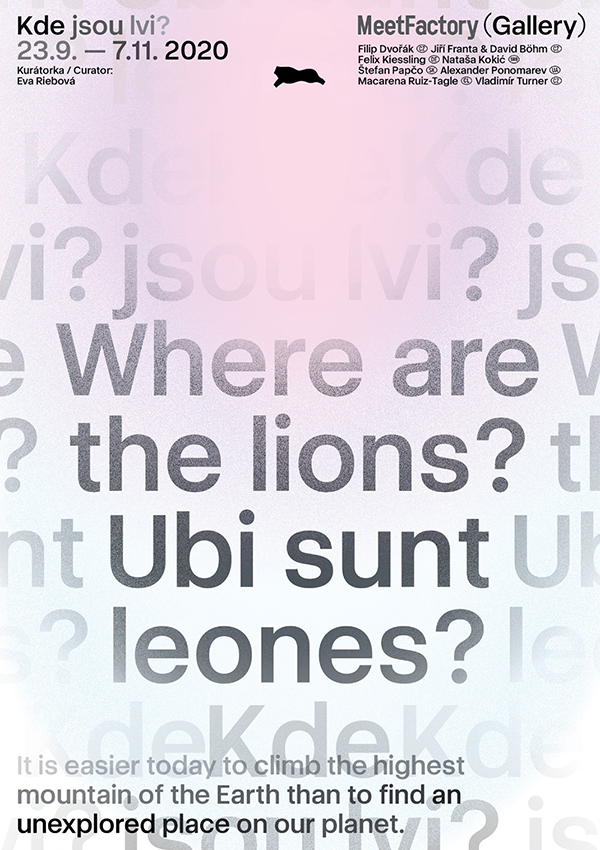
NOWs: Where are the lions? Ubi sunt leones?
Where are the lions? Ubi sunt leones?group exhibition
Opening
22 September
(Public House Event)
MeetFactory Galery
Ke Sklárně 3213/15
150 00 Praha 5
The exhibition Where Are the Lions? / Ubi sunt leones? looks into a phenomenon of human fascination for overcoming physical and psychological limits through adventures, extreme sports, and explorative expeditions. The title of the exhibition itself, being derived from the cartographic description of unexplored territories (Hic sunt leones) reminds us that it is easier today to climb the highest mountain of the Earth than to find an unexplored place on our planet.
The exhibition attempts to develop a story of artists-explorers from both historical and contemporary perspectives. It follows different motivations and objects of their fascinations. At the same time, the exhibition draws attention to the dilemma of today’s adventurers who want to satisfy their romantic lust for exploring new sites and being at the same time responsible for our ecosystem. The title of the show therefore can be also seen as a metaphoric question: where are today’s “lions” and their unknown territories?
The project connects international and Czech artists combining loaned artworks with works commissioned especially for the exhibition during the first half of 2020.
with works by
Filip Dvořák (CZ), Jiří Franta & David Böhm (CZ), Felix Kiessling (DE), Nataša Kokić (RS), Štefan Papčo (SK), Alexander Ponomarev (UA), Macarena Ruiz-Tagle (CL), Vladimír Turner (CZ)
curated by: Eva Riebová
production: Jan Vítek
architecture: Heinich & Stibitz
Where are the lions? Ubi sunt leones?group exhibition
Opening
22 September
(Public House Event)
MeetFactory Galery
Ke Sklárně 3213/15
150 00 Praha 5
The exhibition Where Are the Lions? / Ubi sunt leones? looks into a phenomenon of human fascination for overcoming physical and psychological limits through adventures, extreme sports, and explorative expeditions. The title of the exhibition itself, being derived from the cartographic description of unexplored territories (Hic sunt leones) reminds us that it is easier today to climb the highest mountain of the Earth than to find an unexplored place on our planet.
The exhibition attempts to develop a story of artists-explorers from both historical and contemporary perspectives. It follows different motivations and objects of their fascinations. At the same time, the exhibition draws attention to the dilemma of today’s adventurers who want to satisfy their romantic lust for exploring new sites and being at the same time responsible for our ecosystem. The title of the show therefore can be also seen as a metaphoric question: where are today’s “lions” and their unknown territories?
The project connects international and Czech artists combining loaned artworks with works commissioned especially for the exhibition during the first half of 2020.
with works by
Filip Dvořák (CZ), Jiří Franta & David Böhm (CZ), Felix Kiessling (DE), Nataša Kokić (RS), Štefan Papčo (SK), Alexander Ponomarev (UA), Macarena Ruiz-Tagle (CL), Vladimír Turner (CZ)
curated by: Eva Riebová
production: Jan Vítek
architecture: Heinich & Stibitz
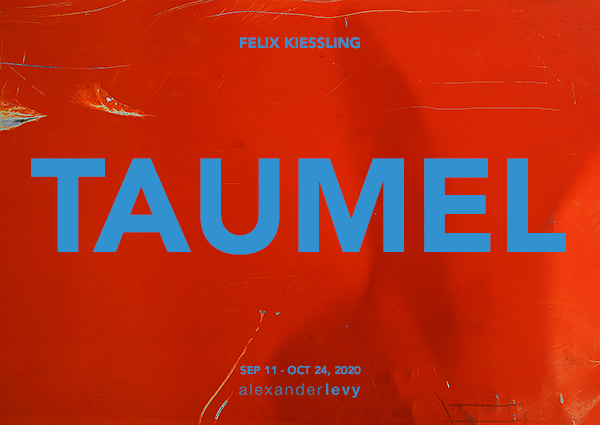
NOWs: Trauma by Felix Kiessling
Traumasolo exhibition
alexander levy
Rudi-Dutschke-Strasse 26
10969 Berlin
Soft opening 12 September 12–7 pm
Accompanied by a text by Larissa Kikol
The current hygiene regulations will be maintained for the entire duration of the exhibition.
The gallery alexander levy is pleased to present new works by Felix Kiessling for this year’s Gallery Weekend Berlin (Sep 11 – Sep 13).
The chaos has been a starting point for many of Felix Kiessling’s works over the past few years. In a playful way, he fathoms human perception and the question of how the world is connected. Hereby, physical parameters such as energy, tension and effect are decisive for him. Kiessling tries to explore and expand the limits of the possible. For the upcoming exhibition he is now going to examine the chaos within the social context of large cities.
In the exhibition, individual work complexes are combined to form an overall spatial concept. When entering the gallery space, the observer becomes part of an abstract, chaotic urban playground. The entire floor will be covered with paving slabs, which are commonly known from our cityscape. Nevertheless, some of them are wobbling, which results in a feeling of insecurity.
A new series of works deals with the bicycle as representation for the dealing with public space and property: the bicycle stands for mobility and independence, though through choice of model and color it also stands for individuality and differentiation. The bicycle that has been forgotten or left behind, rusted and broken on the street on the other hand, shows the divided relationship of an affluent society to its artifacts. Combined into abstract sculptures and covered with fresh paint, the old, deformed corpses are transformed into new objects that highlight the tense field between individuality and mass production.
Two further current works unfold through the dialogue with the space. For the first work, Felix Kiessling transposes the material steel into a minimalist sculpture by bending a four-meter long plank and connecting its ends. The sculpture is thus exposed to permanent tension, always close to escalation. The chained sequence of action and reaction is therefore put to halt. The sculpture is in a moment of suspension, almost an uncanny calm. In another work, drywall profiles are braced against the gallery ceiling by a scaffolding spindle. The sculpture freezes for a moment from a deformation process and the individual elements merge into a collective unit.
Felix Kiessling’s series is the result of extensive researches about the possibilities and weaknesses of industrially produced materials. They refer to a time, in which large cities are marked by construction projects and estate speculations and the societies of our globalized reality are confronted with social segregation and exclusion. Our environment is built from geometric and symmetrical construction materials. These materials will be the elements on which the forces of the exhibition will rub off, will cause them to totter and destroy their symmetry.
The artist hereby raises the questions of who and to which extent actually shapes the city – the citizens or the economy, and looks at what our culturally constructed sense of stability consists of and considers moments in which our reality begins to crumble.
Felix Kiessling, born in Hamburg in 1980, studied at the University of Arts Berlin. In 2014 he was a master student of Olafur Eliasson, at whose Institute for Space Experiments he studied from 2009 to 2014.
Felix Kiessling’s works have been shown in national and international institutions and exhibitions, including Matucana100 (Santiago, Chile), MOCAK – Museum of Contemporary Art Krakow (Krakow, Poland), Neue Nationalgalerie (Berlin), Hamburger Bahnhof (Berlin), Sprengel Museum (Hanover) and the 5th Moscow International Biennale for Young Art (Moscow, Russia).
alexander levy
Rudi-Dutschke-Strasse 26
10969 Berlin
Soft opening 12 September 12–7 pm
Accompanied by a text by Larissa Kikol
The current hygiene regulations will be maintained for the entire duration of the exhibition.
The gallery alexander levy is pleased to present new works by Felix Kiessling for this year’s Gallery Weekend Berlin (Sep 11 – Sep 13).
The chaos has been a starting point for many of Felix Kiessling’s works over the past few years. In a playful way, he fathoms human perception and the question of how the world is connected. Hereby, physical parameters such as energy, tension and effect are decisive for him. Kiessling tries to explore and expand the limits of the possible. For the upcoming exhibition he is now going to examine the chaos within the social context of large cities.
In the exhibition, individual work complexes are combined to form an overall spatial concept. When entering the gallery space, the observer becomes part of an abstract, chaotic urban playground. The entire floor will be covered with paving slabs, which are commonly known from our cityscape. Nevertheless, some of them are wobbling, which results in a feeling of insecurity.
A new series of works deals with the bicycle as representation for the dealing with public space and property: the bicycle stands for mobility and independence, though through choice of model and color it also stands for individuality and differentiation. The bicycle that has been forgotten or left behind, rusted and broken on the street on the other hand, shows the divided relationship of an affluent society to its artifacts. Combined into abstract sculptures and covered with fresh paint, the old, deformed corpses are transformed into new objects that highlight the tense field between individuality and mass production.
Two further current works unfold through the dialogue with the space. For the first work, Felix Kiessling transposes the material steel into a minimalist sculpture by bending a four-meter long plank and connecting its ends. The sculpture is thus exposed to permanent tension, always close to escalation. The chained sequence of action and reaction is therefore put to halt. The sculpture is in a moment of suspension, almost an uncanny calm. In another work, drywall profiles are braced against the gallery ceiling by a scaffolding spindle. The sculpture freezes for a moment from a deformation process and the individual elements merge into a collective unit.
Felix Kiessling’s series is the result of extensive researches about the possibilities and weaknesses of industrially produced materials. They refer to a time, in which large cities are marked by construction projects and estate speculations and the societies of our globalized reality are confronted with social segregation and exclusion. Our environment is built from geometric and symmetrical construction materials. These materials will be the elements on which the forces of the exhibition will rub off, will cause them to totter and destroy their symmetry.
The artist hereby raises the questions of who and to which extent actually shapes the city – the citizens or the economy, and looks at what our culturally constructed sense of stability consists of and considers moments in which our reality begins to crumble.
Felix Kiessling, born in Hamburg in 1980, studied at the University of Arts Berlin. In 2014 he was a master student of Olafur Eliasson, at whose Institute for Space Experiments he studied from 2009 to 2014.
Felix Kiessling’s works have been shown in national and international institutions and exhibitions, including Matucana100 (Santiago, Chile), MOCAK – Museum of Contemporary Art Krakow (Krakow, Poland), Neue Nationalgalerie (Berlin), Hamburger Bahnhof (Berlin), Sprengel Museum (Hanover) and the 5th Moscow International Biennale for Young Art (Moscow, Russia).
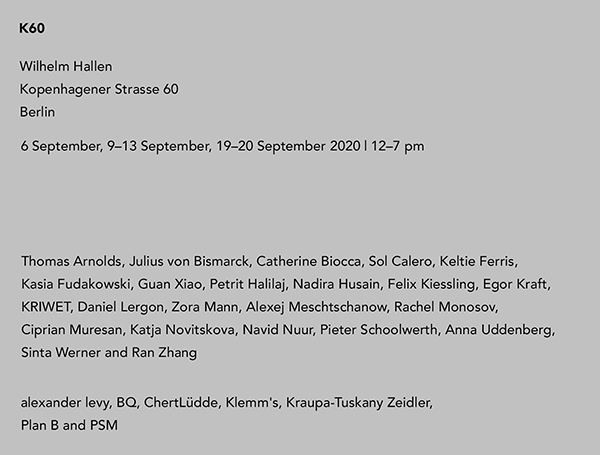
NOWs: K60
K60group exhibition
K60
Wilhelm Hallen
Kopenhagener Strasse 60
13407 Berlin
Opening 06.09.2020, 12–7 pm
Opening hours: 9–13 September, 19–20 September 2020, 12–7 pm
Seven Berlin galleries – alexander levy, BQ, ChertLüdde, Klemm’s, Kraupa-Tuskany Zeidler, Plan B and PSM – will open the joint exhibition K60 on September 6th, 2020. The opening will feature the performance installation The Blind Leader by artist Rachel Monosov.
Works by Thomas Arnolds, Julius von Bismarck, Catherine Biocca, Sol Calero, Keltie Ferris, Kasia Fudakowski, Guan Xiao, Petrit Halilaj, Nadira Husain, Felix Kiessling, Egor Kraft, KRIWET, Daniel Lergon, Zora Mann, Alexej Meschtschanow, Rachel Monosov, Ciprian Muresan, Katja Novitskova, Navid Nuur, Pieter Schoolwerth, Anna Uddenberg, Sinta Werner and Ran Zhang will be on view.
All events take place in compliance with current hygiene measures.
K60group exhibition
K60
Wilhelm Hallen
Kopenhagener Strasse 60
13407 Berlin
Opening 06.09.2020, 12–7 pm
Opening hours: 9–13 September, 19–20 September 2020, 12–7 pm
Seven Berlin galleries – alexander levy, BQ, ChertLüdde, Klemm’s, Kraupa-Tuskany Zeidler, Plan B and PSM – will open the joint exhibition K60 on September 6th, 2020. The opening will feature the performance installation The Blind Leader by artist Rachel Monosov.
Works by Thomas Arnolds, Julius von Bismarck, Catherine Biocca, Sol Calero, Keltie Ferris, Kasia Fudakowski, Guan Xiao, Petrit Halilaj, Nadira Husain, Felix Kiessling, Egor Kraft, KRIWET, Daniel Lergon, Zora Mann, Alexej Meschtschanow, Rachel Monosov, Ciprian Muresan, Katja Novitskova, Navid Nuur, Pieter Schoolwerth, Anna Uddenberg, Sinta Werner and Ran Zhang will be on view.
All events take place in compliance with current hygiene measures.
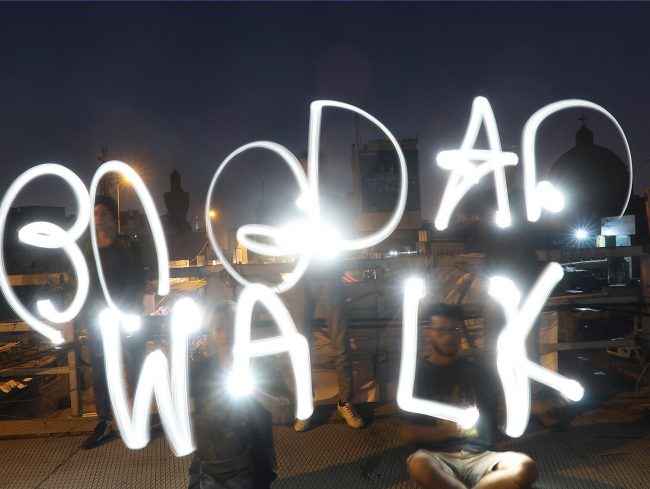
Baghdad Walk II
BAGHDAD WALK IIGroup exhibition in public space
BAGHDAD WALK is a series of group exhibitions with artworks by emerging Iraqi artists presented in public space and in different locations in Baghdad. Baghdad Walk is an exhibition and a narrative tour of the city. The participating artists connect their works with the specific locations, introducing background information on site. Manifold stories about the city of Baghdad are told and retold anew through the artists’ perspectives and the encounters they create.
Baghdad Walk II was originally planned for November 2019. Due to the ongoing protests in Iraq, the sit-in at Baghdad’s Al Tahrir Square and the adjacent neighbourhoods, and the strike of Iraqi educational and cultural organisations and institutions, Baghdad Walk II was postponed. The format had to be slightly adjusted and took place in March 2020.
Twelve artists presented their perspectives on memory culture in the neighbourhood around Mutanabbi Street and the Shorja Bazaar, interpreting events and local circumstances that have become part of the collective cultural memory as well as its various forms in the contemporary urban reality. The potential of visual culture to create moments of reflection in contemporary society is activated by the diverse artistic interventions.
The art walk started at the ruins of the former court building Al Mutasarefiya and the Al Mutanabbi Statue on Mutanabbi Street, then proceeded to Al Rasheed Street, meandered through the Shorja Bazaar, circled back to Al Rusafi Square, and ended at Al Mutasarefiya.
Please find the project’s bilingual (Englisch-Arabic) website here.
Participating artists: Tabarek Al Atrakchi, Atef Al Jaffal, Loay Al Hadhary, Ahmed Majid, Hella Mewis, Muhaned Mohammed, Hussam Mohammed, Ameen Mokdad, Hussain Muttar, Zaid Saad, Muhaned Taha.
–
Baghdad Walk is a project by the Goethe-Institut Irak, conceived and organised in collaboration with the Institut für Raumexperimente (Institute for Spatial Experiments), Berlin and hosted by TARKIB Baghdad Contemporary Arts Institute in BAIT TARKIB, choreographed by Hella Mewis and Christina Werner. It is the result of the workshop series „Arts Seminar in Baghdad“ led by Christina Werner.
Photos: Muntadher Amel, Hella Mewis, Christina Werner
BAGHDAD WALK IIGroup exhibition in public space
BAGHDAD WALK is a series of group exhibitions with artworks by emerging Iraqi artists presented in public space and in different locations in Baghdad. Baghdad Walk is an exhibition and a narrative tour of the city. The participating artists connect their works with the specific locations, introducing background information on site. Manifold stories about the city of Baghdad are told and retold anew through the artists’ perspectives and the encounters they create.
Baghdad Walk II was originally planned for November 2019. Due to the ongoing protests in Iraq, the sit-in at Baghdad’s Al Tahrir Square and the adjacent neighbourhoods, and the strike of Iraqi educational and cultural organisations and institutions, Baghdad Walk II was postponed. The format had to be slightly adjusted and took place in March 2020.
Twelve artists presented their perspectives on memory culture in the neighbourhood around Mutanabbi Street and the Shorja Bazaar, interpreting events and local circumstances that have become part of the collective cultural memory as well as its various forms in the contemporary urban reality. The potential of visual culture to create moments of reflection in contemporary society is activated by the diverse artistic interventions.
The art walk started at the ruins of the former court building Al Mutasarefiya and the Al Mutanabbi Statue on Mutanabbi Street, then proceeded to Al Rasheed Street, meandered through the Shorja Bazaar, circled back to Al Rusafi Square, and ended at Al Mutasarefiya.
Please find the project’s bilingual (Englisch-Arabic) website here.
Participating artists: Tabarek Al Atrakchi, Atef Al Jaffal, Loay Al Hadhary, Ahmed Majid, Hella Mewis, Muhaned Mohammed, Hussam Mohammed, Ameen Mokdad, Hussain Muttar, Zaid Saad, Muhaned Taha.
–
Baghdad Walk is a project by the Goethe-Institut Irak, conceived and organised in collaboration with the Institut für Raumexperimente (Institute for Spatial Experiments), Berlin and hosted by TARKIB Baghdad Contemporary Arts Institute in BAIT TARKIB, choreographed by Hella Mewis and Christina Werner. It is the result of the workshop series „Arts Seminar in Baghdad“ led by Christina Werner.
Photos: Muntadher Amel, Hella Mewis, Christina Werner
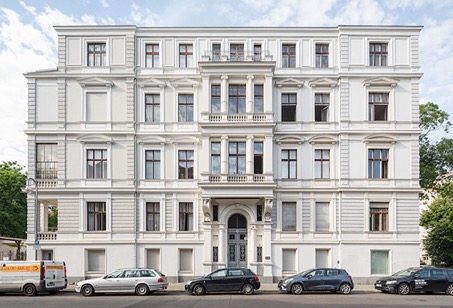
NOWs: Vom bürgerlichen Wohnhaus zum selbstverwalteten Hausprojekt / Kumi*13 mit Yves Mettler et al.
Foto: Anne Herdin, Landesdenkmalamt Berlin
Vom bürgerlichen Wohnhaus zum selbstverwalteten HausprojektAusstellung zum Tag des offenen Denkmals
12. & 13. September
geöffnet von 13.00 – 18.00 Uhr
Zum Tag des Denkmals öffnen wir den Innenhof und die Garage. Wir zeigen eine CHRONOLOGIE aller Eigentümer*innen und Bewohner*innen, mit Namen und Berufen, von 1877 bis heute, die die Altmieterin Susanne Kahl aus Telefon- und Adressbüchern zusammengetragen hat.
Mit FENSTERBILDERZWISCHENWELTEN präsentieren wir Pastellgemälde von Peter Klemke, der sein Atelier in den 80er Jahren in der Kurmärkischen 13 hatte und wir stellen das SYNDIKATSMODELL vor in Gesprächen und mit der Dokumentation „Das ist unser Haus“ von Burkhard Grießenauer, Daniel Kunle, Holger Lauinger.
Der diesjährige Tag des offenen Denkmals, bundesweit koordiniert durch die Deutsche Stiftung Denkmalschutz, findet unter dem Motto „Chance Denkmal: Erinnern. Erhalten. Neu denken” statt. Für Berlin gibt es ein Extra-Motto: „Denk_mal nachhaltig.“
Aufgrund aktueller Bauarbeiten und Corona-bedingter Einschränkungen wird die Ausstellung in der Garage stattfinden; ein Besuch des Haupthauses wird nicht möglich sein.
Kumi*13
– ein Hausprojekt in Selbstverwaltung –
Kurmärkische Str. 13
10783 Berlin
Foto: Anne Herdin, Landesdenkmalamt Berlin
Vom bürgerlichen Wohnhaus zum selbstverwalteten HausprojektAusstellung zum Tag des offenen Denkmals
12. & 13. September
geöffnet von 13.00 – 18.00 Uhr
Zum Tag des Denkmals öffnen wir den Innenhof und die Garage. Wir zeigen eine CHRONOLOGIE aller Eigentümer*innen und Bewohner*innen, mit Namen und Berufen, von 1877 bis heute, die die Altmieterin Susanne Kahl aus Telefon- und Adressbüchern zusammengetragen hat.
Mit FENSTERBILDERZWISCHENWELTEN präsentieren wir Pastellgemälde von Peter Klemke, der sein Atelier in den 80er Jahren in der Kurmärkischen 13 hatte und wir stellen das SYNDIKATSMODELL vor in Gesprächen und mit der Dokumentation „Das ist unser Haus“ von Burkhard Grießenauer, Daniel Kunle, Holger Lauinger.
Der diesjährige Tag des offenen Denkmals, bundesweit koordiniert durch die Deutsche Stiftung Denkmalschutz, findet unter dem Motto „Chance Denkmal: Erinnern. Erhalten. Neu denken” statt. Für Berlin gibt es ein Extra-Motto: „Denk_mal nachhaltig.“
Aufgrund aktueller Bauarbeiten und Corona-bedingter Einschränkungen wird die Ausstellung in der Garage stattfinden; ein Besuch des Haupthauses wird nicht möglich sein.
Kumi*13
– ein Hausprojekt in Selbstverwaltung –
Kurmärkische Str. 13
10783 Berlin

NOWs: Waschtage / Kumi*13 with Yves Mettler et al.
Man Ray, Moving sculpture, 1922
WaschtageInstallation
Parkplatz Zietenstrasse / Ecke Bülowstrasse
07. – 27. September, ganztägig
Klatsch mit Kuminist*innen: 10., 17. und 24. 09. von 17.00 bis 20.00 Uhr
Wehende Wäsche in einer Momentaufnahme. Ein Bild, das die Zeit einfriert: am Waschtag versammelten sich die Frauen zum Arbeiten und Reden. Das typische Geräusch beim Waschen – das laute Klatschen der ausgelaugten Wäsche, wenn der Schmutz auf dem Stein ausgeschlagen wird – bezeichnet auch das die Arbeit erleichternde Gerede, das Schwatzen und Lästern, – das Klatschen eben.
Klatsch ist eine unterschätzte Form der Wissensvermittlung. Die Klatschenden spekulieren über soziale, politische oder sexuelle Überschreitungen und genießen die Indiskretion, man testet soziales Verhalten von sich und anderen, man erfindet sich neu. Der Klatsch zirkuliert unkontrolliert zwischen Leuten, angeblich meist Frauen, er unterläuft subversive den öffentlichen Radar, Klatsch kann nicht zensuriert werden.
Versammeln wir uns zu nachbarschaftlichen Klatschtagen in der Zietenstraße.
An den Donnerstagen (10., 17. & 24.) sitzen diverse Kuminist*innen auf dem Waschplatz und bieten zwischen 17.00 – 20.00 Uhr Klatsch an und würden auch gerne welchen hören.
RESPEKT UND EIN HOCH AUF DEN KLATSCH !
Die Kumi*13 beteiligt sich hiermit an einem Nachbarschaftsprojekt der Initiative Kiez erFahren: Die Initiative hat 5 Parkplätze gemietet und die AnwohnerInnen zeigen dort Vorschläge, welche anderweitigen Nutzungen auf diesen 12 qm großen Autostellfläche denkbar wären.
SchöneFläche Nord ist ein Modul innerhalb des Mobilitätsprojektes Kiez erFahren, das das Bezirksamt Tempelhof-Schöneberg in Schöneberg Nord durchführt. Gemeinsam entwickelt mit hochC Landschaftsarchitekten, zeigen die fünf SchönenFlächen im September alternative Nutzungen von Parkflächen. Das Projekt wird gefördert durch das Bundesministerium für Umwelt, Naturschutz und nukleare Sicherheit im Rahmen der Nationalen Klimaschutzinitiative (NKI) im Förderstrang „Kurze Wege für den Klimaschutz“.
https://kiezerfahren.berlin
Kumi*13
– ein Hausprojekt in Selbstverwaltung –
Kurmärkische Str. 13
10783 Berlin
Man Ray, Moving sculpture, 1922
WaschtageInstallation
Parkplatz Zietenstrasse / Ecke Bülowstrasse
07. – 27. September, ganztägig
Klatsch mit Kuminist*innen: 10., 17. und 24. 09. von 17.00 bis 20.00 Uhr
Wehende Wäsche in einer Momentaufnahme. Ein Bild, das die Zeit einfriert: am Waschtag versammelten sich die Frauen zum Arbeiten und Reden. Das typische Geräusch beim Waschen – das laute Klatschen der ausgelaugten Wäsche, wenn der Schmutz auf dem Stein ausgeschlagen wird – bezeichnet auch das die Arbeit erleichternde Gerede, das Schwatzen und Lästern, – das Klatschen eben.
Klatsch ist eine unterschätzte Form der Wissensvermittlung. Die Klatschenden spekulieren über soziale, politische oder sexuelle Überschreitungen und genießen die Indiskretion, man testet soziales Verhalten von sich und anderen, man erfindet sich neu. Der Klatsch zirkuliert unkontrolliert zwischen Leuten, angeblich meist Frauen, er unterläuft subversive den öffentlichen Radar, Klatsch kann nicht zensuriert werden.
Versammeln wir uns zu nachbarschaftlichen Klatschtagen in der Zietenstraße.
An den Donnerstagen (10., 17. & 24.) sitzen diverse Kuminist*innen auf dem Waschplatz und bieten zwischen 17.00 – 20.00 Uhr Klatsch an und würden auch gerne welchen hören.
RESPEKT UND EIN HOCH AUF DEN KLATSCH !
Die Kumi*13 beteiligt sich hiermit an einem Nachbarschaftsprojekt der Initiative Kiez erFahren: Die Initiative hat 5 Parkplätze gemietet und die AnwohnerInnen zeigen dort Vorschläge, welche anderweitigen Nutzungen auf diesen 12 qm großen Autostellfläche denkbar wären.
SchöneFläche Nord ist ein Modul innerhalb des Mobilitätsprojektes Kiez erFahren, das das Bezirksamt Tempelhof-Schöneberg in Schöneberg Nord durchführt. Gemeinsam entwickelt mit hochC Landschaftsarchitekten, zeigen die fünf SchönenFlächen im September alternative Nutzungen von Parkflächen. Das Projekt wird gefördert durch das Bundesministerium für Umwelt, Naturschutz und nukleare Sicherheit im Rahmen der Nationalen Klimaschutzinitiative (NKI) im Förderstrang „Kurze Wege für den Klimaschutz“.
https://kiezerfahren.berlin
Kumi*13
– ein Hausprojekt in Selbstverwaltung –
Kurmärkische Str. 13
10783 Berlin
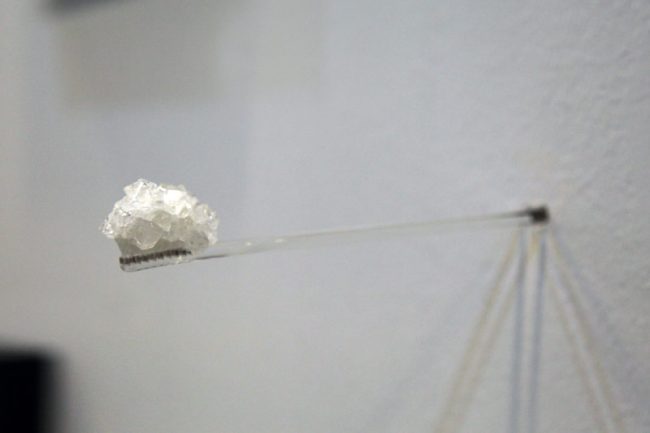
NOWs: La Fabrique du Temps – Acte 2
Sophia Pompéry, "White Charm", Alumcrystals, Toothbrush
La Fabrique du Temps - Acte 2group exhibition
Galerie Dix9
19 rue des Filles du Calvaire
75003 Paris
Opening: 30 August 2020, 12 – 7 pm
Aristide Barraud, Françoise Coutant, Camille Fallet, Katia Kameli, Vincent Lemaire, Louisa Marajo, Nathan, Sophia Pompéry, Sebastian Riemer, Paula de Solminihac
As a follow up to the exhibit La Fabrique du Temps (Interpretation of Time), with its theme of analyzing the interpretation of time and its materialization, Act 2 focuses on an approach where the predominant idea is the resurgence of the past in the present world. Testimony of a world gone or collapsing, reactivation of a past image or an abandoned place, revelation of the horrors of time or fantasies of a golden age, so many proposals of artists from diverse backgrounds questioning the relevance of memory and history in the present world and to come.
Come and visit the booth of Galerie Dix9 at PHOTO BASEL @ Flughafen Tempelhof, Berlin 10 – 13 September 2020
Sophia Pompéry, "White Charm", Alumcrystals, Toothbrush
La Fabrique du Temps - Acte 2Gruppenausstellung
Galerie Dix9
19 rue des Filles du Calvaire
75003 Paris
Eröffnung: 30. August 2020, 12 – 19 h
Aristide Barraud, Françoise Coutant, Camille Fallet, Katia Kameli, Vincent Lemaire, Louisa Marajo, Nathan, Sophia Pompéry, Sebastian Riemer, Paula de Solminihac
As a follow up to the exhibit La Fabrique du Temps (Interpretation of Time), with its theme of analyzing the interpretation of time and its materialization, Act 2 focuses on an approach where the predominant idea is the resurgence of the past in the present world. Testimony of a world gone or collapsing, reactivation of a past image or an abandoned place, revelation of the horrors of time or fantasies of a golden age, so many proposals of artists from diverse backgrounds questioning the relevance of memory and history in the present world and to come.
Come and visit the booth of Galerie Dix9 at PHOTO BASEL @ Flughafen Tempelhof, Berlin 10 – 13 September 2020

NOWs: Sleep is overrated
Sleep is overrated, © Jan Peter Zaugg 2020
Sleep is overratedgroup exhibition
With: Heather Allen, Heike Baranowsky, Emmanuelle Castellan, Katharina Grosse, Ilona Kálnoky, Mark Le Ruez, Via Lewandowsky, Sophia Pompéry, Karin Sander, Salah Saouli, Karen Scheper, Veronika Witte, Jan Peter Zaugg, Georg Zey
Vernissage: Friday, 28 August 2020, 6 – 10 pm
during Ortstermin Festival: 29 + 30 August 2020, 3 – 8 pm
regular opening hours: Fr – Sun 4 – 7 pm and by appointment
Finissage: Sunday, 13 September 2020, 4 – 7 pm
In the group exhibition Sleep is overrated Kurt-Kurt takes the visitors on a tour through the international art scene of Moabit; just in time for “Ortstermin” the local art festival and the Berlin Art Week.
We hope that the art, perceived insitu at a self-chosen period of time, is contagious and infects the audience again and again; of course within all the rules of the Covid regulations valid at the end of August.
Kunst und Kontext im Stadtlabor Berlin-Moabit
A project lead by Simone Zaugg and Pfelder at the birthplace of Kurt Tucholsky.
Lübecker Str. 13 | 10559 Berlin | Tel 030-397 46 942 | Mail info@kurt-kurt.de
www.kurt-kurt.de | www.sanspapiers.de
Sleep is overrated, © Jan Peter Zaugg 2020
Sleep is overratedgroup exhibition
With: Heather Allen, Heike Baranowsky, Emmanuelle Castellan, Katharina Grosse, Ilona Kálnoky, Mark Le Ruez, Via Lewandowsky, Sophia Pompéry, Karin Sander, Salah Saouli, Karen Scheper, Veronika Witte, Jan Peter Zaugg, Georg Zey
Vernissage: Friday, 28 August 2020, 6 – 10 pm
during Ortstermin Festival: 29 + 30 August 2020, 3 – 8 pm
regular opening hours: Fr – Sun 4 – 7 pm and by appointment
Finissage: Sunday, 13 September 2020, 4 – 7 pm
In the group exhibition Sleep is overrated Kurt-Kurt takes the visitors on a tour through the international art scene of Moabit; just in time for “Ortstermin” the local art festival and the Berlin Art Week.
We hope that the art, perceived insitu at a self-chosen period of time, is contagious and infects the audience again and again; of course within all the rules of the Covid regulations valid at the end of August.
Kunst und Kontext im Stadtlabor Berlin-Moabit
A project lead by Simone Zaugg and Pfelder at the birthplace of Kurt Tucholsky.
Lübecker Str. 13 | 10559 Berlin | Tel 030-397 46 942 | Mail info@kurt-kurt.de
www.kurt-kurt.de | www.sanspapiers.de
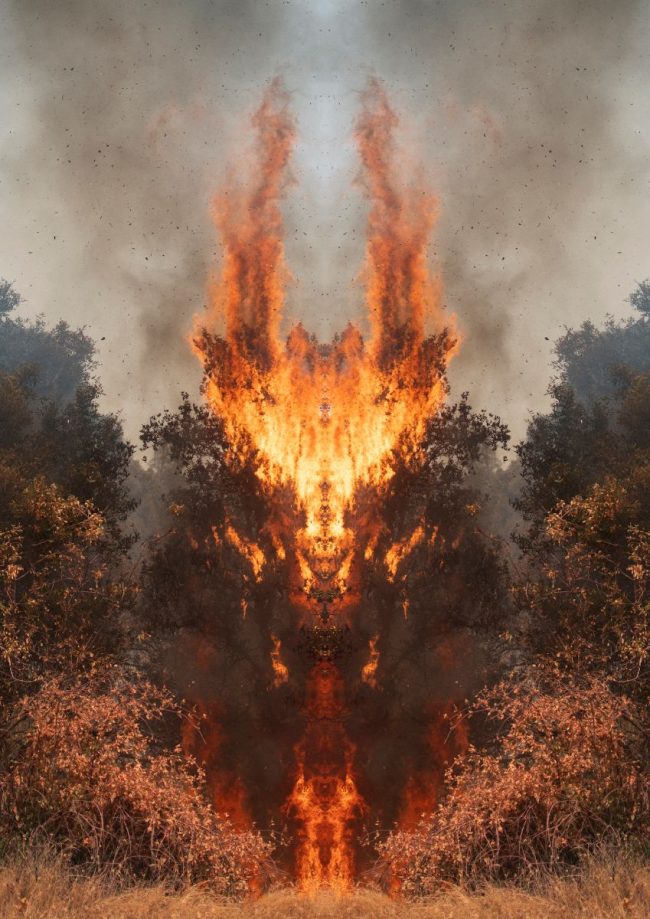
NOWs: Feuer mit Feuer by Julius von Bismarck
Julius von Bismarck, from the series Fire with Fire, 2020, fine art inkjet print, 164 x 117 cm. Courtesy the artist; alexander levy, Berlin; Sies + Höke, Düsseldorf
Fire with Firesolo exhibition
Bundeskunsthalle
Museumsmeile Bonn
Helmut-Kohl-Allee 4
53113 Bonn
Opening
3 September 2020, 6 – 8 pm
What do we perceive today as nature? Has the view of nature changed through confrontations with natural disasters, via the media or in real life? Do we still entertain a romantic image of nature?
Humankind has always had to fight against the forces of nature, but when these become rampant or turn into catastrophes, real events influence our notion of nature and are reflected in pictorial representations of our visual cultures.
«Nowhere else does one dream as one does in front of the flame of a candle.» Gaston Bachelard, Philosopher
Julius von Bismarck delves into questions regarding a contemporary conception of nature within the context of recent climate changes. In his performances, installations, sculptures, videos and photographs, he oscillates experimentally between scientific and artistic perspectives and, in doing so, creates powerful aesthetic imagery. ‘I draw my inspiration from science and work artistically,’ von Bismarck explains his working strategy. Always on the lookout for alternative forms of perception, he translates nature and technology into fresh, hitherto unseen images.
For an exhibition in 2015, von Bismarck spun around on a large, fast-rotating dish, his Egocentric System, thus confronting himself with centrifugal forces for an entire week. For his work Punishment, the thirty-six-year-old artist gave the ocean in Rio de Janeiro and the mountains in the Swiss Alps a whipping, ironizing the human ambivalence between megalomania and pettiness. In Venezuela, he used rockets to trigger lightning, forming it and manipulating the forces of nature through his intervention. The artist has exposed himself to extreme weather events often understood to be consequences of climate change: the hurricanes Irma in Florida and Ophelia in Ireland. The results are slow-motion video works: The camera stretches seconds to minutes, presenting wind and floods not as apocalyptic scenes but rather as moments of great calm and poesy. “Suddenly, you look into the aesthetics of this storm […] and see plants being caressed by the storm. The result is something very delicate, something very beautiful – trees dancing with the wind,” von Bismarck explains.
His visual processing of natural events seems to want to convey that, as devastating and powerful as the forces of nature appear to be, there is a boundless beauty hidden in the catastrophe which needs to be depicted. This contrast becomes particularly clear in the exhibition Fire with Fire, which is based on von Bismarck’s expeditions to various forest fire sites.
The central work in the exhibition space is a large LED screen, on which a video is presented depicting decelerated images of forest fires in a vertical symmetry. This mirroring explicitly refers to the aesthetics of the so-called ‘inkblot images’ developed by the Swiss psychoanalyst Herman Rorschach for his test of ‘psychological diagnostics and personality psychology’.
«I draw my inspiration from science and work artistically.» Julius von Bismarck
The French philosopher Gaston Bachelard ascribes such a hypnotic effect to fire that he concludes that ‘nowhere else does one dream as one does in front of the flame of a candle’. It captivates us, and we can neither turn our gaze away from the burning of a campfire nor from the roar of a forest fire. If we follow Bachelard and Rorschach, this ‘psychoanalysis with fire’ creates a space for reflection. With the publicity associated with forest fires—the collective staring into the flame—a complex psychograph of our contemporary society reveals itself. While viewing the work, moments of irritation arise, since the illusions created by the vertical mirroring of the image differ greatly from the brutal reality filmed.
A promenade lined by eight sculptures leads to this present-day campfire, created with the help of modern media technology. ‘Eternal flames’ in monuments and memorials – constructed sites of collective memory worldwide – are the models for these sculptures. The originals made of bronze or stone are duplicated here in fired ceramics, the blazing fire transformed into flickering LEDs.
The production of fire is one of the great cultural techniques; its use and mastery has been a central factor for all civilisations. As a force that creates everything and destroys everything, fire dominates both the profane and the intellectual realms of human thought more than any other element – the narratives about purgatory, the funeral pyre, the Easter fire, the Biikebrennen, the liturgical formula ‘ashes to ashes’ and the myth of Prometheus, who robs the gods of fire in order to bring it to the people, are but a few examples of the thematic variations of the dynamics of fire.
All these thoughts lead back to the exhibition title, Fire with Fire, which Julius von Bismarck uses as an image to refer to the ambiguity, reflection and interaction of the element – its purifying and destructive, civilising and barbaric power.
Julius von Bismarck during his research and production for the exhibition Feuer mit Feuer. ©️Studio Julius von Bismarck, VG Bild-Kunst, Bonn 2020
Julius von Bismarck, from the series Fire with Fire, 2020, fine art inkjet print, 164 x 117 cm. Courtesy the artist; alexander levy, Berlin; Sies + Höke, Düsseldorf
Feuer mit FeuerEinzelausstellung
Bundeskunsthalle
Museumsmeile Bonn
Helmut-Kohl-Allee 4
53113 Bonn
Eröffnung
3. September 2020, 18 – 20 h
Was nehmen wir heute als Natur wahr? Hat sich der Blick auf sie durch die mediale und reale Konfrontation mit Naturkatastrophen verändert? Erlauben wir uns noch ein romantisches Bild der Natur?
Gegen Naturgewalten mussten Menschen schon immer kämpfen, nehmen sie aber überhand oder gehen in Katastrophen über, beeinflusst das reale Geschehen unsere Vorstellung von Natur und spiegelt sich in bildlichen Darstellungen unserer visuellen Kulturen.
«Nirgends wird so geträumt, wie vor der Flamme einer Kerze.»Gaston Bachelard, Philosoph
Julius von Bismarck spürt den Fragen einer zeitgenössischen Auffassung von Natur entlang der jüngsten Klimaveränderungen nach. In seinen Performances, Installationen, Skulpturen, Videos und Fotografien changiert er experimentell zwischen naturwissenschaftlichen und künstlerischen Perspektiven und schafft so ästhetische Bildgewalten. „Ich ziehe meine Inspiration aus der Wissenschaft und arbeite künstlerisch“, sagt von Bismarck über seine Werkstrategie. Immer auf der Suche nach alternativen Formen der Wahrnehmung, übersetzt er Natur und Technologie in unverbrauchte, so noch nie gesehene Bilder.
2015 rotiert von Bismarck in einer Ausstellung auf einer schnell drehenden Schüssel, seinem Egocentric System, und konfrontiert sich so eine Woche lang mit den Fliehkräften. Für seine Arbeit Punishment peitscht der 36-jährige Künstler in Rio de Janeiro das Meer aus oder in den Schweizer Alpen die Berge und ironisiert damit die menschliche Ambivalenz zwischen Größenwahn und Kleinlichkeit. In Venezuela löst er mittels Raketen Blitze aus, formt diese und manipuliert durch seinen Eingriff die Naturgewalt. Der Künstler liefert sich selbst den oft als Folgen der Klimaveränderung verstandenen Wetterextremen aus: den Wirbelstürmen Irma in Florida oder Ophelia in Irland. Dabei entstehen Zeitlupen-Videoarbeiten: Die Kamera, die Sekunden zu Minuten dehnt und so Wind und Hochwasser nicht als apokalyptische Szenerie, sondern als Augenblicke großer Ruhe und Poesie zeichnet. „Plötzlich schaut man in die Ästhetik dieses Sturms … und man sieht, wie Pflanzen vom Sturm gestreichelt werden. Es entsteht etwas ganz Zartes, etwas sehr Schönes – ein Tanz der Bäume mit dem Wind“, so von Bismarck.
Seine visuelle Verarbeitung des Naturgeschehens scheint vermitteln zu wollen: So verheerend und gewaltig die Naturkräfte auch zu sein scheinen, ist doch eine grenzenlose Schönheit in der Katastrophe verborgen, die es darzustellen gilt. Dieser Gegensatz wird in der Ausstellung Feuer mit Feuer, die auf von Bismarcks Expeditionen zu verschiedenen Waldbrandgebieten basiert, besonders deutlich.
Die zentrale Arbeit im Ausstellungsraum bildet ein großer LED-Bildschirm, auf dem ein Video gezeigt wird, das verlangsamte Aufnahmen von Waldbränden vertikal symmetrisch zeigt. Diese Spiegelung verweist explizit auf die Ästhetik der sogenannten „Tintenklecks-Bilder“, die der Schweizer Psychoanalytiker Herman Rorschach für seinen Test „der psychologischen Diagnostik und Persönlichkeitspsychologie“ entwickelt hat.
«Ich ziehe meine Inspiration aus der Wissenschaft und arbeite künstlerisch.» Julius von Bismarck
Der französische Philosoph Gaston Bachelard spricht dem Feuer eine so hypnotische Wirkung zu, dass er zu dem Schluss kommt, dass „nirgends so geträumt wird, wie vor der Flamme einer Kerze“. Sie zieht uns in ihren Bann, und weder können wir unseren Blick vom Zündeln eines Lagerfeuers noch vom Toben eines Waldbrands wenden. Folgen wir Bachelard und Rorschach, entsteht durch diese „Psychoanalyse mit dem Feuer“ ein Raum für Reflexion. Mit der mit den Waldbränden einhergehenden Öffentlichkeit, dem kollektiven Starren ins Feuer, entsteht hier ein vielschichtiges Psychogramm unserer heutigen Gesellschaft. Bei der Betrachtung ergeben sich Momente der Irritation, da die durch die vertikale Spiegelung des Bildes entstandenen Illusionen stark von der gefilmten brutalen Realität abweichen.
Zu diesem – durch moderne Medientechnik – erzeugten Lagerfeuer der Jetztzeit führt ein Wandelgang aus acht Skulpturen. „Ewige Feuer“ in Monumenten, Mahnmälern, Ehrendenkmälern –, gebaute Orte der kollektiven Erinnerung weltweit sind die Vorbilder für diese Skulpturen. Die Originale aus Bronze oder Stein sind hier in gebrannter Keramik dupliziert, das lodernde Feuer wird zu flackernden LEDs.
Die Erzeugung von Feuer zählt zu den großen Kulturtechniken, seine Nutzung und Beherrschung war ein zentraler Faktor für alle Zivilisationen. Als alles bringende, alles zerstörende Kraft dominiert das Feuer wie kein anderes Element die profanen wie auch intellektuellen Gedankenwelten der Menschen – die Narrative um das Fegefeuer, den Scheiterhaufen, das Osterfeuer, das Biikebrennen, die liturgische Formel „Asche zu Asche“ oder der Mythos des Prometheus, der den Göttern das Feuer raubt, um es den Menschen zu bringen, sind nur einige inhaltliche Variationen der Feuerdynamik.
All diese Gedanken führen zurück zum Ausstellungstitel Feuer mit Feuer, den Julius von Bismarck als Bild benutzt, um auf die Mehrdeutigkeit, Spiegelung und Wechselwirkungen des Elements hinzuweisen – auf die reinigende neben der zerstörerischen, die zivilisatorische wie auch barbarische Kraft.
Julius von Bismarck during his research and production for the exhibition Feuer mit Feuer. ©️Studio Julius von Bismarck, VG Bild-Kunst, Bonn 2020
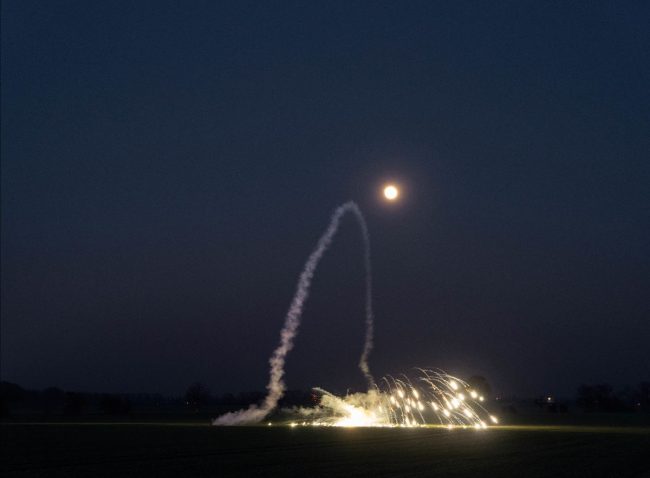
NOWs: Bottom Up by Malte Bartsch
Bottom Upsolo exhibition by Malte Bartsch
Lemoyne
Feldstrasse 121
8004 Zurich
Opening
6 September, 2 – 7 pm
Lemoyne is happy to announce Malte Bartsch‘s (*1984) first solo show in Zurich titled Bottom Up.
In this exhibition, the Berlin-based artist explores themes of innovation, labor and the relationship between man and machine that are recurrent in his œuvre. The so-called ‘bottom-up approach’ describes the optimization of work processes from ‘bottom to top’. In this process, an increased and thus more profitable work performance is achieved by giving employees the right of co-determination with regard to certain projects and processes, thereby stimulating their motivation. This process culminates in an apparent freedom that is particularly popular in times of tech start-ups, which have now grown into giants, and is part of their innovation-driven success. In his exhibition ‘Bottom Up’, Malte Bartsch discusses what technological progress, competition and labor can stand for in an age of technology and globalization. The measurability of success and optimization is questioned, as well as the inability of humans to deal with their own failure.
Bottom UpEinzelausstellung von Malte Bartsch
Lemoyne
Feldstrasse 121
8004 Zurich
Opening
6 September, 2 – 7 pm
Lemoyne is happy to announce Malte Bartsch‘s (*1984) first solo show in Zurich titled Bottom Up.
In this exhibition, the Berlin-based artist explores themes of innovation, labor and the relationship between man and machine that are recurrent in his œuvre. The so-called ‘bottom-up approach’ describes the optimization of work processes from ‘bottom to top’. In this process, an increased and thus more profitable work performance is achieved by giving employees the right of co-determination with regard to certain projects and processes, thereby stimulating their motivation. This process culminates in an apparent freedom that is particularly popular in times of tech start-ups, which have now grown into giants, and is part of their innovation-driven success. In his exhibition ‘Bottom Up’, Malte Bartsch discusses what technological progress, competition and labor can stand for in an age of technology and globalization. The measurability of success and optimization is questioned, as well as the inability of humans to deal with their own failure.
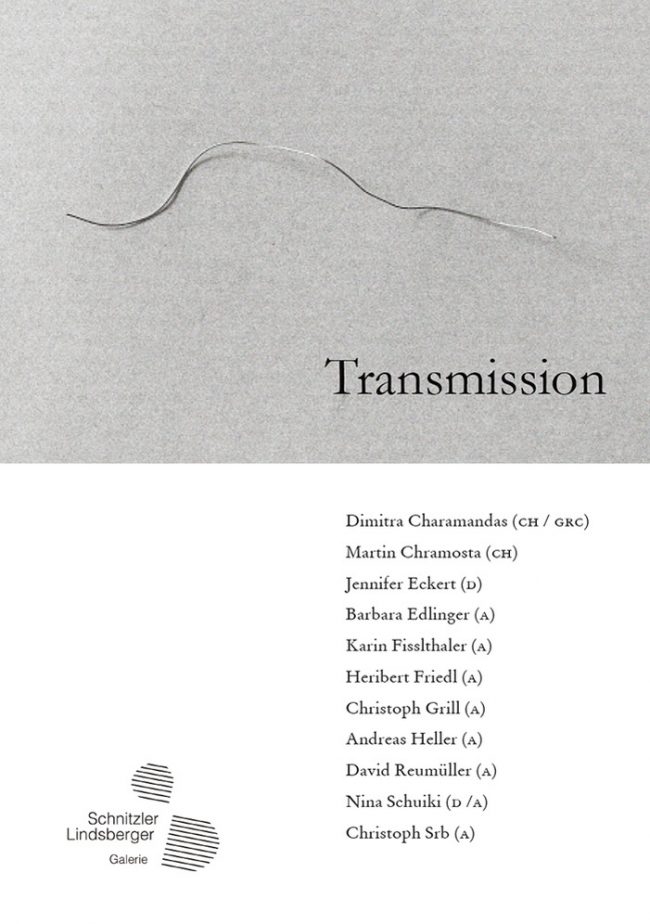
NOWs: Transmission
transmission with Nina Schuiki et al.group exhibition
Artists: Dimitra Charamandas, Martin Chramosta, Jennifer Eckert, Barbara Edlinger, Karin Fisslthaler, Heribert Friedl, Christoph Grill, Andreas Heller, David Reumüller, Nina Schuiki, Christoph Srb
curated by Andreas HellerOpening 3 September 2020, 5 – 10 pmGalerie Schnitzler & LindsbergerRechbauerstraße 21, 8010 Graz Opening times: Thursdays and Fridays 3 – 6 pmas well as by appointmentwww.sl-galerie.at
Den Wegfall traditioneller Begründungen und Normativitäten, klassischer Ikonografie sowie mimetischer Verpflichtungen durch Demokratisierung, Säkularisierung und die Erfindung der Fotografie hat die Kunst bekanntlich durch den Rückzug auf das ihr Ureigene, mit Selbstreferenzialität kompensiert. Das Ende der großen Erzählungen betrifft die bildende Kunst auch in einem sehr wörtlichen Sinn, es manifestiert sich zunächst ja schon im Fragwürdig-Werden bewährter Narrationen, derer sich die Kunst ehemals zwanglos bedienen konnte, um an Spannung zu gewinnen. Der „fruchtbare Augenblick“, auf den die gute Darstellung dabei zurückgreifen konnte, ist damit nicht länger einer schon erzählten Geschichte – wie prototypisch jener von Lessing besprochenen des Priesters Laokoon – zu entnehmen, sondern muss sich nun eher ausschließlich aus dem Eigentlichen des jeweiligen Entstehungsprozesses ergeben. „Denn wo etwas noch nicht ist, aber soeben entsteht, befindet sich der essentielle Ort in jeder Schöpfung, dorthin muss man vordringen, und die Arbeit besteht ebenso sehr darin, dorthin zu gelangen, wie in dem, was dort getan wird. Und das eine, das zum anderen wird, die Verwandlung, ist die Methode der Kunst“, resümiert Karl Ove Knausgård.
Wie die von Andreas Heller für die Galerie Schnitzler und Lindsberger kuratierte Schau Transmission anhand klug ausgewählter, sehr zeitgenössischer Beispiele zeigt, verdankt sich der gute, weil am meisten erzählende Moment dabei zwar weiterhin einem präzisen Austarieren unterschiedlicher Zustände, gelingt als Fest- und In-Schwebe-Halten labiler Gleichgewichte, wie sie an den Umschlagpunkten der Form oder zwischen Licht und Schatten liegen. Jedoch ereignet er sich inzwischen im Rahmen mitunter zufälliger Verwandlungsprozesse von Größe, Substanz oder Gestalt sowie während der Transformation semantischer Gehalte ins pure Material des textlichen Gewebes oder in die Poesie, die ein synästhetischer Gegenentwurf zur geruchslosen Glätte des „Digitalschönen“ mit sich bringt.
Ulrich Tragatschnig
transmission with Nina Schuiki et al.group exhibition
Künstler*innen: Dimitra Charamandas, Martin Chramosta, Jennifer Eckert, Barbara Edlinger, Karin Fisslthaler, Heribert Friedl, Christoph Grill, Andreas Heller, David Reumüller, Nina Schuiki, Christoph Srb
Kuratiert von Andreas HellerEröffnung: 03.09.2020, 17:00 – 22:00Galerie Schnitzler & LindsbergerRechbauerstraße 21, 8010 Graz Öffnungszeiten: Donnerstag und Freitag: 15:00 – 18:00sowie nach Vereinbarungwww.sl-galerie.at
Den Wegfall traditioneller Begründungen und Normativitäten, klassischer Ikonografie sowie mimetischer Verpflichtungen durch Demokratisierung, Säkularisierung und die Erfindung der Fotografie hat die Kunst bekanntlich durch den Rückzug auf das ihr Ureigene, mit Selbstreferenzialität kompensiert. Das Ende der großen Erzählungen betrifft die bildende Kunst auch in einem sehr wörtlichen Sinn, es manifestiert sich zunächst ja schon im Fragwürdig-Werden bewährter Narrationen, derer sich die Kunst ehemals zwanglos bedienen konnte, um an Spannung zu gewinnen. Der „fruchtbare Augenblick“, auf den die gute Darstellung dabei zurückgreifen konnte, ist damit nicht länger einer schon erzählten Geschichte – wie prototypisch jener von Lessing besprochenen des Priesters Laokoon – zu entnehmen, sondern muss sich nun eher ausschließlich aus dem Eigentlichen des jeweiligen Entstehungsprozesses ergeben. „Denn wo etwas noch nicht ist, aber soeben entsteht, befindet sich der essentielle Ort in jeder Schöpfung, dorthin muss man vordringen, und die Arbeit besteht ebenso sehr darin, dorthin zu gelangen, wie in dem, was dort getan wird. Und das eine, das zum anderen wird, die Verwandlung, ist die Methode der Kunst“, resümiert Karl Ove Knausgård.
Wie die von Andreas Heller für die Galerie Schnitzler und Lindsberger kuratierte Schau Transmission anhand klug ausgewählter, sehr zeitgenössischer Beispiele zeigt, verdankt sich der gute, weil am meisten erzählende Moment dabei zwar weiterhin einem präzisen Austarieren unterschiedlicher Zustände, gelingt als Fest- und In-Schwebe-Halten labiler Gleichgewichte, wie sie an den Umschlagpunkten der Form oder zwischen Licht und Schatten liegen. Jedoch ereignet er sich inzwischen im Rahmen mitunter zufälliger Verwandlungsprozesse von Größe, Substanz oder Gestalt sowie während der Transformation semantischer Gehalte ins pure Material des textlichen Gewebes oder in die Poesie, die ein synästhetischer Gegenentwurf zur geruchslosen Glätte des „Digitalschönen“ mit sich bringt.
Ulrich Tragatschnig

NOWs: Unmuted
unmuted with Nina Schuiki et al.group exhibition
Ausstellung im Rahmen von The Frankfurt Art Experience
LSTNR-Space
Große Eschenheimer Str. 16
60313 Frankfurt a. M.
Öffnungszeiten der Ausstellung:
Eröffnung: 3. September
Freitag, 4. September, 11–18 Uhr
Samstag, 5. September, 11–20 Uhr
Sonntag, 6. September, 11–16 Uhr
www.mananabold.de
www.frankfurtexperience.art/
mit Julia Hainz, Hanne Lippard, Ann Lislegaard, Nina Schuiki, Adrian Williams
Artist Talk mit Julia Mihály
unmuted widmet sich der Stimme als einem Medium der Bewegung in der Zeit, eines sprachlichen Voraus- und Zurückschauens. Welche Rolle spielt der Klang des Gesprochenen in Zeiten, in denen eingefroren scheint, was kommen könnte, was erwartet, gefürchtet und erhofft wird? Wie viel Utopie und Dystopie vermag Stimme zu beschwören? Eine Stimme ist meist an eine Subjektposition geknüpft. Sie kann jedoch variiert, verstellt und unterschiedlich intoniert – ebenso wie programmiert – werden. Eine Stimme verleiht einer Aussage Dynamik, Nachdruck und Emotion. Je nach Situation, in der sie sich Gehör verschafft, bewegt sie sich anders im Raum: Sie stolpert über sich selbst, nimmt mehrfach Anlauf, kehrt zurück, läuft voraus und überholt das Gesprochene.
Nina Schuiki: any other where, 2018; ©Foto: Tobias Wootton, Kunstverein Wilhelmshöhe, 2018
unmuted mit Nina Schuiki et. al.Gruppenausstellung
Ausstellung im Rahmen von The Frankfurt Art Experience
LSTNR-Space
Große Eschenheimer Str. 16
60313 Frankfurt a. M.
Öffnungszeiten der Ausstellung:
Eröffnung: 3. September
Freitag, 4. September, 11–18 Uhr
Samstag, 5. September, 11–20 Uhr
Sonntag, 6. September, 11–16 Uhr
www.mananabold.de
www.frankfurtexperience.art/
mit Julia Hainz, Hanne Lippard, Ann Lislegaard, Nina Schuiki, Adrian Williams
Artist Talk mit Julia Mihály
unmuted widmet sich der Stimme als einem Medium der Bewegung in der Zeit, eines sprachlichen Voraus- und Zurückschauens. Welche Rolle spielt der Klang des Gesprochenen in Zeiten, in denen eingefroren scheint, was kommen könnte, was erwartet, gefürchtet und erhofft wird? Wie viel Utopie und Dystopie vermag Stimme zu beschwören? Eine Stimme ist meist an eine Subjektposition geknüpft. Sie kann jedoch variiert, verstellt und unterschiedlich intoniert – ebenso wie programmiert – werden. Eine Stimme verleiht einer Aussage Dynamik, Nachdruck und Emotion. Je nach Situation, in der sie sich Gehör verschafft, bewegt sie sich anders im Raum: Sie stolpert über sich selbst, nimmt mehrfach Anlauf, kehrt zurück, läuft voraus und überholt das Gesprochene.
Nina Schuiki: any other where, 2018; ©Foto: Tobias Wootton, Kunstverein Wilhelmshöhe, 2018
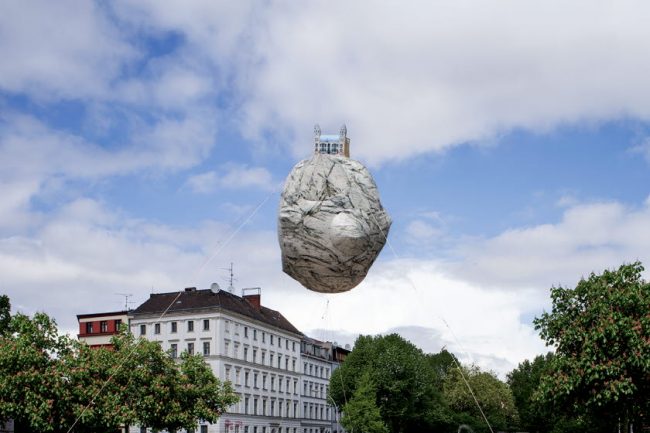
NOWs: Floating Utopias
Floating Utopiasgroup exhibition
Lunds Konsthall
Mårtenstorget 3
223 51 Lund
Press preview on 4 September at noon
Ant Farm, Anetta Mona Chisa & Lucia Tkácová, Elise Eeraerts, Eventstructure Research Group, Anna Hoetjes, Franco Mazzucchelli, Dawn Ng, Ahmet Öğüt, Tomás Saraceno, Graham Stevens, SUPERFLEX, Tools for Action, UFO, Artúr van Balen, The Yes Men
Floating Utopias presents various inflatable media at Lunds konsthall, accompanied by an intervention in urban space. The exhibition juxtaposes historical and contemporary works and shows how inflatables may be used in artistic and activist practices: formless bundles of material are instantly transformed into voluminous spatial presence.
The exhibited works invite us to be playful and to claim space. They demonstrate a potential to forge communities and prompt participation. Floating Utopias indicates that inflatables could and should be used to critique the present order and create better futures.
The exhibition navigates the broad cultural history of inflatables in art, activism and architecture, their impact on our collective imagination. The first manned balloon flight in the late eighteenth century shifted the general understanding of the possible, suggested new worlds and encouraged visionary utopianism.
The history of inflatables is closely intertwined with industrial development. In the 1930s, the car tire industry found a new market in giant inflatable rubber puppets. Soon these figures hovered above socialist and capitalist parades, used for propaganda and advertisement in cities across the Soviet Union and the United States.
In the late 1960s, a time of global political turmoil and the promise of space travel, plastic became widely available as an affordable material and was used in pneumatic experiments. Artists, activists and architects tested new forms of performance, protest and alternative living.
Recent artistic practices show how inflatables can be used as tools in activism, as an artistic material to challenge monumental spaces and political symbols, and as vehicles for rethinking our dependency on fossil fuels.
Floating Utopias foregrounds contemporary inflatable artworks, reflecting a world defined by technological advances, climate change and increasing political polarisation and offering new approaches to social engagement.
Southern Sweden and the Copenhagen Area have a tradition of urban activism, including utopian art projects and happenings with inflatable objects. This legacy is also part of the exhibition history of Lunds konsthall. Futures-oriented exhibitions such as Superlund and New Babylon in the 1960s imagined new roles and habitats for humankind in relation to nature and the city, and Floating Utopias continues this progressive tradition.
During the exhibition’s opening weekend, the helium balloon Castle of Vooruit by Kurdish artist Ahmet Öğüt will float over Lund. It will take off from Stortorget Friday 4 September, as soon as wind conditions allow it.
Floating Utopias was first shown at nGbK neue Gesellschaft für bildende Kunst in Berlin in 2018 and then at ArtScience Museum Singapore in 2019. Now the exhibition lands for the third time at Lunds konsthall. It is organised by the three curators Artúr van Balen, Fabiola Bierhoff and Anna Hoetjes. The exhibition design was created in collaboration with Agustina Pascotto and Jazmin Schenone.
Floating Utopiasgroup exhibition
Lunds Konsthall
Mårtenstorget 3
223 51 Lund
Press preview on 4 September at noon
Ant Farm, Anetta Mona Chisa & Lucia Tkácová, Elise Eeraerts, Eventstructure Research Group, Anna Hoetjes, Franco Mazzucchelli, Dawn Ng, Ahmet Öğüt, Tomás Saraceno, Graham Stevens, SUPERFLEX, Tools for Action, UFO, Artúr van Balen, The Yes Men
Floating Utopias presents various inflatable media at Lunds konsthall, accompanied by an intervention in urban space. The exhibition juxtaposes historical and contemporary works and shows how inflatables may be used in artistic and activist practices: formless bundles of material are instantly transformed into voluminous spatial presence.
The exhibited works invite us to be playful and to claim space. They demonstrate a potential to forge communities and prompt participation. Floating Utopias indicates that inflatables could and should be used to critique the present order and create better futures.
The exhibition navigates the broad cultural history of inflatables in art, activism and architecture, their impact on our collective imagination. The first manned balloon flight in the late eighteenth century shifted the general understanding of the possible, suggested new worlds and encouraged visionary utopianism.
The history of inflatables is closely intertwined with industrial development. In the 1930s, the car tire industry found a new market in giant inflatable rubber puppets. Soon these figures hovered above socialist and capitalist parades, used for propaganda and advertisement in cities across the Soviet Union and the United States.
In the late 1960s, a time of global political turmoil and the promise of space travel, plastic became widely available as an affordable material and was used in pneumatic experiments. Artists, activists and architects tested new forms of performance, protest and alternative living.
Recent artistic practices show how inflatables can be used as tools in activism, as an artistic material to challenge monumental spaces and political symbols, and as vehicles for rethinking our dependency on fossil fuels.
Floating Utopias foregrounds contemporary inflatable artworks, reflecting a world defined by technological advances, climate change and increasing political polarisation and offering new approaches to social engagement.
Southern Sweden and the Copenhagen Area have a tradition of urban activism, including utopian art projects and happenings with inflatable objects. This legacy is also part of the exhibition history of Lunds konsthall. Futures-oriented exhibitions such as Superlund and New Babylon in the 1960s imagined new roles and habitats for humankind in relation to nature and the city, and Floating Utopias continues this progressive tradition.
During the exhibition’s opening weekend, the helium balloon Castle of Vooruit by Kurdish artist Ahmet Öğüt will float over Lund. It will take off from Stortorget Friday 4 September, as soon as wind conditions allow it.
Floating Utopias was first shown at nGbK neue Gesellschaft für bildende Kunst in Berlin in 2018 and then at ArtScience Museum Singapore in 2019. Now the exhibition lands for the third time at Lunds konsthall. It is organised by the three curators Artúr van Balen, Fabiola Bierhoff and Anna Hoetjes. The exhibition design was created in collaboration with Agustina Pascotto and Jazmin Schenone.

NOWs: Contributions at Yokohama Triennale 2020
Resonance of the Unforeseen, Yokohama Museum of Art. Photos by KATO Ken © Ivana Franke, © Yokohama Triennale. Courtesy of Organizing Committee for Yokohama Triennale
Yokohama Triennale 2020Afterglow
Yokohama Museum of Art
Afterglow
A luminous interval, a glowing anticipation, a lambent flow, a charged current of energy between thickets of presence and becoming
Yokohama Triennale 2020, its 7th edition, will be led by Raqs Media Collective, a collective of three artists based in New Delhi, India, as its artistic director. Under Raqs Media Collective’s direction, it will take the artists and co-travelers on a journey through time and space.
The title of Yokohama Triennale 2020 is “AFTERGLOW,” a word chosen by Raqs Media Collective to reference how, in our everyday lives, we unknowingly experience the residues of light sparked at the beginning of our time, as in the case of how the “white noise” on our analog televisions included fragments of cosmic microwave background radiation left over from the cosmic Big Bang. By referring to the Big Bang’s destructive energy that propelled creativity and over time, gave birth to life on this planet, and its radiation that is toxic as well as therapeutic, Raqs Media Collective takes interest in the cycle of destruction/toxicity and recovery/care in the human activities of the contemporary age. Together with the artists, audience, and others, Raqs Media Collective will explore ways to co-exist with toxicity for human sustenance and survival in this world in flux, rather than eliminate it.
Artists @ Yokohama Museum of Art (YMA)
Morehshin Allahyari / Robert Andrew / Aono Fumiaki / Arai Takashi / Rosa Barba / Taysir Batniji / Nick Cave / Chen Zhe / Jesse Darling / Max De Esteban / Eva Fàbregas / Alia Farid / Ivana Franke / Zuza Golińska / Nilbar Güreş / Ingela Ihrman / Iiyama Yuki / Iwama Asako / Kaneuji Teppei / Lebohang Kganye / Kim Yunchul / Make or Break (Rebecca Gallo & Connie Anthes) / Taus Makhacheva/ James Nasmyth / Park Chan-Kyong / Renuka Rajiv / Oscar Santillan / Sarker Protick / Sato Masaharu / Sato Risa / Tsherin Sherpa / Elias Sime / Rayyane Tabet / Takemura Kei / Omer Wasim & Saira Sheikh / Lantian Xie / Zhang Xu Zhan
Artists @ PLOT 48
Haig Aivazian / Farah Al Qasimi / Korakrit Arunanondchai / Hicham Berrada / Farming Architects / Rahima Gambo / Andreas Greiner / Tina Havelock Stevens / Joyce Ho / Iikawa Takehiro / Kawakubo Yoi / Elena Knox with collaborating artists / Lau Wai / Russ Ligtas / Naeem Mohaiemen / Amol K. Patil / Aluaiy Pulidan / Oscar Santillan / Sarker Protick / Sato Risa / Renu Savant / Anton Vidokle / Zheng Bo
Artist @ NYK Maritime Museum / Marianne Fahmy
Artists @ Ongoing Episōdos
Episōdo 02 / Deliberations on Discursive Justice / Michelle Wong, Lantian Xie, Kabelo Malatsie / Scenography for Suspended Time / Protagonists: Heron, fish, copper, Nanni, Kinoshita Takahiro, Mr. King, Cici Wu, Pallavi Paul, Sunday Lai Long Sang, Hicham Berrada, money plant, snake plant, butterfly palm, Pushie the cat, and George Mahashe/ Johannesburg—July 3 to August 14, 2020
Episōdo 03 / Deliberations on Discursive Justice / Michelle WONG, Lantian XIE, Kabelo MALATSIE / Yokohama / Chasing the Scent / With Merv ESPINA and PUGMENT / @ YMA
Episōdo 04 / Institute for Tropical and Galactical Studies / Curated by Inti Guerrero / From the YMA collection: Ishikawa Mao, Ishiuchi Miyako, Paul Jacoulet, Tanaka Atsuko, Wilhelm Von Gloeden, and with invited artists: Kathy Jetñil-Kikiner with Dan Lin, Eisa Jocson, Cristina Lucas and Anting-Anting artifacts from the Philippines / @ YMA
Episōdo 06 / Broom stars / Iwai Masaru / @ YMA and dispersed in the city
Episōdo 09 / The case of the ringing bell / Dennis Tan / @ PLOT 48
Episōdo X / Online with artists, docents, volunteers, and viewers
Artists @ Forthcoming Episōdos
Episōdo 01 / Deliberations on Discursive Justice / Michelle Wong, Lantian Xie, Kabelo Malatsie / Afterparty / Protagonists: Phastoki, Fotan Laikee, Amiya Napgal, and Jerome Reyes / Hong Kong (TBA)
Episōdo 05 / SURE INN / Printing Sound / @ PLOT 48
Episōdo 07 / Sound Reasons / Ish Shehrawat (Ish S), Venzha Christ / @ YMA
Episōdo 08 / Chemistry – The Story of C / Tamura Yuichiro / @ YMA + online
Episōdo 10 / TBA
Artists @ Episōdo 00 / Sharing the Sources / November 30, 2019 / Shintaku Kanako, Tamura Yuichiro, Lantian Xie, Ivana Franke, Hicham Berrada / @ PLOT 48
Sourcebook / Yokohama Triennale
Asako Iwama: non-visible (still), 2013. © Asako Iwama and Derrick Wang
Andreas Greiner: From Strings To Dinosaurs, 2014 © Andreas Greiner, composition by Tyler Friedman
Resonance of the Unforeseen, Yokohama Museum of Art. Photos by KATO Ken © Ivana Franke, © Yokohama Triennale. Courtesy of Organizing Committee for Yokohama Triennale
Yokohama Triennale 2020Afterglow
Yokohama Museum of Art
Afterglow
A luminous interval, a glowing anticipation, a lambent flow, a charged current of energy between thickets of presence and becoming
Yokohama Triennale 2020, its 7th edition, will be led by Raqs Media Collective, a collective of three artists based in New Delhi, India, as its artistic director. Under Raqs Media Collective’s direction, it will take the artists and co-travelers on a journey through time and space.
The title of Yokohama Triennale 2020 is “AFTERGLOW,” a word chosen by Raqs Media Collective to reference how, in our everyday lives, we unknowingly experience the residues of light sparked at the beginning of our time, as in the case of how the “white noise” on our analog televisions included fragments of cosmic microwave background radiation left over from the cosmic Big Bang. By referring to the Big Bang’s destructive energy that propelled creativity and over time, gave birth to life on this planet, and its radiation that is toxic as well as therapeutic, Raqs Media Collective takes interest in the cycle of destruction/toxicity and recovery/care in the human activities of the contemporary age. Together with the artists, audience, and others, Raqs Media Collective will explore ways to co-exist with toxicity for human sustenance and survival in this world in flux, rather than eliminate it.
Artists @ Yokohama Museum of Art (YMA)
Morehshin Allahyari / Robert Andrew / Aono Fumiaki / Arai Takashi / Rosa Barba / Taysir Batniji / Nick Cave / Chen Zhe / Jesse Darling / Max De Esteban / Eva Fàbregas / Alia Farid / Ivana Franke / Zuza Golińska / Nilbar Güreş / Ingela Ihrman / Iiyama Yuki / Iwama Asako / Kaneuji Teppei / Lebohang Kganye / Kim Yunchul / Make or Break (Rebecca Gallo & Connie Anthes) / Taus Makhacheva/ James Nasmyth / Park Chan-Kyong / Renuka Rajiv / Oscar Santillan / Sarker Protick / Sato Masaharu / Sato Risa / Tsherin Sherpa / Elias Sime / Rayyane Tabet / Takemura Kei / Omer Wasim & Saira Sheikh / Lantian Xie / Zhang Xu Zhan
Artists @ PLOT 48
Haig Aivazian / Farah Al Qasimi / Korakrit Arunanondchai / Hicham Berrada / Farming Architects / Rahima Gambo / Andreas Greiner / Tina Havelock Stevens / Joyce Ho / Iikawa Takehiro / Kawakubo Yoi / Elena Knox with collaborating artists / Lau Wai / Russ Ligtas / Naeem Mohaiemen / Amol K. Patil / Aluaiy Pulidan / Oscar Santillan / Sarker Protick / Sato Risa / Renu Savant / Anton Vidokle / Zheng Bo
Artist @ NYK Maritime Museum / Marianne Fahmy
Artists @ Ongoing Episōdos
Episōdo 02 / Deliberations on Discursive Justice / Michelle Wong, Lantian Xie, Kabelo Malatsie / Scenography for Suspended Time / Protagonists: Heron, fish, copper, Nanni, Kinoshita Takahiro, Mr. King, Cici Wu, Pallavi Paul, Sunday Lai Long Sang, Hicham Berrada, money plant, snake plant, butterfly palm, Pushie the cat, and George Mahashe/ Johannesburg—July 3 to August 14, 2020
Episōdo 03 / Deliberations on Discursive Justice / Michelle WONG, Lantian XIE, Kabelo MALATSIE / Yokohama / Chasing the Scent / With Merv ESPINA and PUGMENT / @ YMA
Episōdo 04 / Institute for Tropical and Galactical Studies / Curated by Inti Guerrero / From the YMA collection: Ishikawa Mao, Ishiuchi Miyako, Paul Jacoulet, Tanaka Atsuko, Wilhelm Von Gloeden, and with invited artists: Kathy Jetñil-Kikiner with Dan Lin, Eisa Jocson, Cristina Lucas and Anting-Anting artifacts from the Philippines / @ YMA
Episōdo 06 / Broom stars / Iwai Masaru / @ YMA and dispersed in the city
Episōdo 09 / The case of the ringing bell / Dennis Tan / @ PLOT 48
Episōdo X / Online with artists, docents, volunteers, and viewers
Artists @ Forthcoming Episōdos
Episōdo 01 / Deliberations on Discursive Justice / Michelle Wong, Lantian Xie, Kabelo Malatsie / Afterparty / Protagonists: Phastoki, Fotan Laikee, Amiya Napgal, and Jerome Reyes / Hong Kong (TBA)
Episōdo 05 / SURE INN / Printing Sound / @ PLOT 48
Episōdo 07 / Sound Reasons / Ish Shehrawat (Ish S), Venzha Christ / @ YMA
Episōdo 08 / Chemistry – The Story of C / Tamura Yuichiro / @ YMA + online
Episōdo 10 / TBA
Artists @ Episōdo 00 / Sharing the Sources / November 30, 2019 / Shintaku Kanako, Tamura Yuichiro, Lantian Xie, Ivana Franke, Hicham Berrada / @ PLOT 48
Sourcebook / Yokohama Triennale
Asako Iwama: non-visible (still), 2013. © Asako Iwama and Derrick Wang
Andreas Greiner: From Strings To Dinosaurs, 2014 © Andreas Greiner, composition by Tyler Friedman
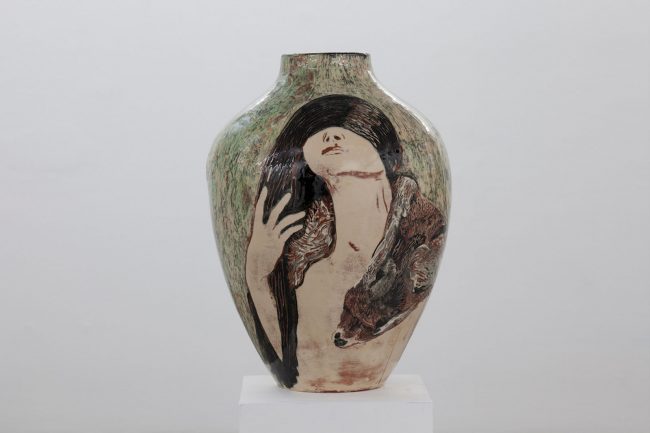
NOWs: Cool Clay – Ceramic Containers in Art Today
Cool Clay - Ceramic Containers in Art Todaygroup exhibition
Gammel Holtegaard
Attemosevej 170
2840 Holte
Denmark
OPENING
27 August 2020, 5 – 7:30 pm
PROGRAM
Welcome by Maria Gadegaard, director of Gl. Holtegaard.
The performanceduo Philip I Schneider will be performing their piece SOIL – WATER – SUN together with six choristers.
The performace will take place twice on the courtyard on the opening night at: 5:30pm and 6:45pm
Gammel Holtegaard is serving eco beer and some sweets.
Ceramic: Clay in art is more popular than ever both in Denmark and internationally. COOL CLAY – Ceramic Containers in Art Today presents 20 Danish artists’ reinterpretation of clay pots as works of art. Here the clay container exists as applied art, myth, body, sound instrument, canvas, and sculpture.
The staging of the exhibition – with tons of earth on the gallery floors and heavy textiles on the walls – arouses the senses – touch, sight, smell and hearing intensify the experience of the many works filling the galleries.
ARTISTS
Lisbeth Bank (b.1975), Claus Carstensen (b.1957), Cathrine Raben Davidsen (b. 1972), Rose Eken (b.1976), Nour Fog (b.1981), Ida Kvetny (b.1980), Klara Lilja (b.1989), Carl Mannov (b.1990), Karl Monies (b.1984), Mie Mørkeberg (b.1980), Ursula Nistrup (b.1974), Fie Norsker (b.1974), Frederik Nystrup-Larsen (b.1992), Frederik Næblerød (b.1988), Knud Odde (b.1955), Anna Samsøe (b.1987), Andreas Schulenburg (b.1975), Anna Stahn (b.1994), Dan Stockholm (b.1982), Anna Sørensen (b.1968)
The exhibition is generously supported by:
The Augustinus Foundation, the Spar Nord Foundation, the Foundation of June 15th, the Louis-Hansen Foundation, the Jorck Foundation, the Knud Højgaard Foundation, the William Demant Foundation, the Ernst B. Sund Foundation, and the Toyota Foundation.
The exhibition events programme is supported by the Nordea Foundation.
The Danish Art Foundation supports Gammel Holtegaard’s exhibition programme.
Thanks to Kvadrat.
Klara Lilja
Mie Mørkeberg
Cool Clay - Ceramic Containers in Art Todaygroup exhibition
Gammel Holtegaard
Attemosevej 170
2840 Holte
Denmark
OPENING
27 August 2020, 5 – 7:30 pm
PROGRAM
Welcome by Maria Gadegaard, director of Gl. Holtegaard.
The performanceduo Philip I Schneider will be performing their piece SOIL – WATER – SUN together with six choristers.
The performace will take place twice on the courtyard on the opening night at: 5:30pm and 6:45pm
Gammel Holtegaard is serving eco beer and some sweets.
Ceramic: Clay in art is more popular than ever both in Denmark and internationally. COOL CLAY – Ceramic Containers in Art Today presents 20 Danish artists’ reinterpretation of clay pots as works of art. Here the clay container exists as applied art, myth, body, sound instrument, canvas, and sculpture.
The staging of the exhibition – with tons of earth on the gallery floors and heavy textiles on the walls – arouses the senses – touch, sight, smell and hearing intensify the experience of the many works filling the galleries.
ARTISTS
Lisbeth Bank (b.1975), Claus Carstensen (b.1957), Cathrine Raben Davidsen (b. 1972), Rose Eken (b.1976), Nour Fog (b.1981), Ida Kvetny (b.1980), Klara Lilja (b.1989), Carl Mannov (b.1990), Karl Monies (b.1984), Mie Mørkeberg (b.1980), Ursula Nistrup (b.1974), Fie Norsker (b.1974), Frederik Nystrup-Larsen (b.1992), Frederik Næblerød (b.1988), Knud Odde (b.1955), Anna Samsøe (b.1987), Andreas Schulenburg (b.1975), Anna Stahn (b.1994), Dan Stockholm (b.1982), Anna Sørensen (b.1968)
The exhibition is generously supported by:
The Augustinus Foundation, the Spar Nord Foundation, the Foundation of June 15th, the Louis-Hansen Foundation, the Jorck Foundation, the Knud Højgaard Foundation, the William Demant Foundation, the Ernst B. Sund Foundation, and the Toyota Foundation.
The exhibition events programme is supported by the Nordea Foundation.
The Danish Art Foundation supports Gammel Holtegaard’s exhibition programme.
Thanks to Kvadrat.
Klara Lilja
Mie Mørkeberg
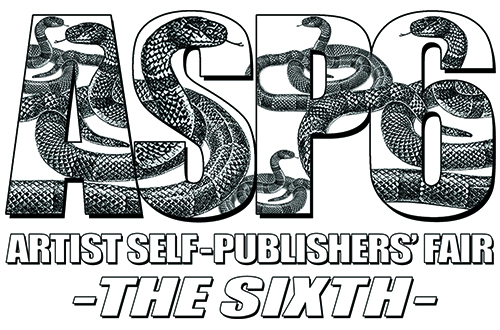
NOWs: ZTSCRT #35 – Fragen
ZTSCRT #35 - FragenBerlin release of ZTSCRT magazine’s latest issue Fragen
Release party
29 August, 5–10pm
with a video piece by Mårten Spångberg
Hopscotch Reading Room (outdoors)
Kurfürstenstrasse 14
10785 Berlin
Featuring contributions by
Nikita Kadan, Nora Turato, Mårten Spångberg, Johanna Dumet, Barry Schwabsky, Till Megerle, Michael Baers, John Miller, Alexander Wolff, Marco Poloni, Eugenia Lai, Sarah Ortmeyer, Olivier Foulon, George Porteus and Christian Egger
Since 2002, the artists Christian Egger, Christian Kosmas Mayer, Yves Mettler, Magda Tothova and Alexander Wolff have been producing a magazine as an independent, international publication on contemporary art, theory and society. The magazine changes its font with each issue. The name of the font becomes the issues’ title.
Published so far: Chicago, Times, Plotter, Helvetica, DIN, Techno, Löhfelm, RR_02, Univers, Tiffany, Circuit, Memphis, Gringo, Zeus, The Mix, Princess Lulu, Pigiarniq, Paper, Libertine, Trixie, Déjà Vu, Auto, Rediviva, Acid, Wanda, Loraine, Hallo, Korpus, Spiegel, Zeitschrift, FIG, Museo, Lisa Fittko, Dyslexie and Fragen.
Edited and published by: Christian Egger, Christian Kosmas Mayer, Yves Mettler, Magda Tóthová, Alexander Wolff
—
Upcoming: ASP6 Fair The Sixth 2020
ASP6 will be taking place on Sunday the 27th of September, 2–7 pm and will be 100% online: www.aspfair.uk
ZTSCRT #35 - FragenBerlin release of ZTSCRT magazine’s latest issue Fragen
Release party
29 August, 5–10pm
with a video piece by Mårten Spångberg
Hopscotch Reading Room (outdoors)
Kurfürstenstrasse 14
10785 Berlin
Featuring contributions by
Nikita Kadan, Nora Turato, Mårten Spångberg, Johanna Dumet, Barry Schwabsky, Till Megerle, Michael Baers, John Miller, Alexander Wolff, Marco Poloni, Eugenia Lai, Sarah Ortmeyer, Olivier Foulon, George Porteus and Christian Egger
Since 2002, the artists Christian Egger, Christian Kosmas Mayer, Yves Mettler, Magda Tothova and Alexander Wolff have been producing a magazine as an independent, international publication on contemporary art, theory and society. The magazine changes its font with each issue. The name of the font becomes the issues’ title.
Published so far: Chicago, Times, Plotter, Helvetica, DIN, Techno, Löhfelm, RR_02, Univers, Tiffany, Circuit, Memphis, Gringo, Zeus, The Mix, Princess Lulu, Pigiarniq, Paper, Libertine, Trixie, Déjà Vu, Auto, Rediviva, Acid, Wanda, Loraine, Hallo, Korpus, Spiegel, Zeitschrift, FIG, Museo, Lisa Fittko, Dyslexie and Fragen.
Edited and published by: Christian Egger, Christian Kosmas Mayer, Yves Mettler, Magda Tóthová, Alexander Wolff
—
Upcoming: ASP6 Fair The Sixth 2020
ASP6 will be taking place on Sunday the 27th of September, 2–7 pm and will be 100% online: www.aspfair.uk
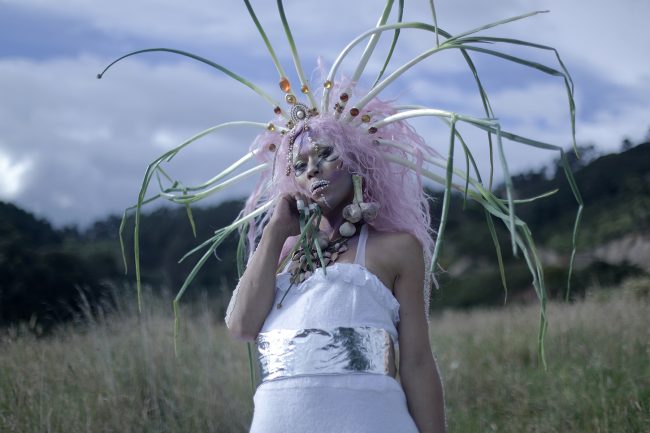
NOWs: Continuum II by La Red Communitaria Trans/Tomás Espinosa
Continuum IIVideo installation
Center for Literature
Burg Hülshoff
Schonebeck 6
48329 Havixbeck
watch teaser here
Continuum II is on view as part of the festival Keine Sorge / Don’t Care.
Check out the full program here.
Continuum II is an invitation to immerse oneself in the lives of six transgender women sex workers and is an opportunity not only to understand their pain but to see what they have done with it. We hear stories and testimonies that have not been told. It is memories of oppression, persecution and violence that need to be told and shared, because this recognition is a guarantee to heal the present and open the way to the future.*
Art in the form of performance and installation is used as a tool to make the violence known, to express and acknowledge it, to embrace the pain and then let it go.
*32 trans people were murdered in Colombia during the preparations for Continuum II
A work by Daniela Maldonado, Ana Bravo, Paula Gempeler, Juan David Cortes, Tomás Espinosa in Collaboration with the Red Comunitaria Trans: Valeria Lopez, Franchesca Caballero, Nini Palomino, Natalia Bernal and Bárbara Sanchez
read the artist statement here (Englisch/Spanisch)
Continuum IIVideo installation
Center for Literature
Burg Hülshoff
Schonebeck 6
48329 Havixbeck
watch teaser here
Continuum II ist zu sehen als Teil des Festivals Keine Sorge / Don’t Care.
Zum vollen Programm hier.
Continuum II ist eine Einladung, in das Leben von sechs transsexuellen Sexarbeiterinnen in Kolumbien einzutauchen, und eine Gelegenheit, nicht nur ihren Schmerz zu verstehen, sondern auch zu sehen, was sie daraus gemacht haben. Wir hören Geschichten und Zeugenaussagen, die nie erzählt wurden. Es sind Erinnerungen an Unterdrückung, Verfolgung und Gewalt, die erzählt und geteilt werden müssen, denn diese Anerkennung ist eine Garantie, um die Gegenwart zu heilen und den Weg in die Zukunft zu öffnen.*
Kunst in Form von Performance und Installation wird als Werkzeug genutzt, um die Gewalt bekannt zu machen, sie auszudrücken und anzuerkennen, den Schmerz zu umarmen und ihn dann loszulassen.
*Während der Vorbereitungen zu Continuum II wurden 32 trans Menschen in Kolumbien ermordet.
Eine Arbeit von Daniela Maldonado, Ana Bravo, Paula Gempeler, Juan David Cortes, Tomás Espinosa in Zusammenarbeit mit der Red Comunitaria Trans: Valeria Lopez, Franchesca Caballero, Nini Palomino, Natalia Bernal und Bárbara Sanchez
zum Künstlerstatement (Englisch/Spanisch)

NOWs: Future archaeology – a return from the moon by Fabian Anselm Orasch
photo by the artist
Fabian Anselm Orasch: Future archaeology - a return from the moonat msu– Museum of Contemporary Art in Zagreb
During his residency in Zagreb in July 2019, the artist researched the specificities of contemporary Croatian art, the permanent collection at MSU, but also the city of Zagreb. He was especially attracted by the open character of the Kožarić Studio, as well as by Zagreb’s modernist architecture and the way in which its elements were present in the development of the city. Installations and sculptures he is preparing for this exhibition in his Berlin studio will reference the atmosphere and the invisible structure of Zagreb. During his numerous walks in the streets of the city, he noticed the exhaust pipes of the underground steam pipeline and the manholes that extended from the heating plants to the consumers. They were partly invisible because they were located in the underground zone of the city. The surreal atmosphere—reminiscent of the reflection of the Moon on the Earth’s surface—will produce a device that will generate steam in the installation space. The steam will come out of sculptural elements that visually reference the abovementioned exhaust pipes.
Fabian Anselm Orasch creates works that are based on research into the local context. They function independently, but also in relation to other elements of the exhibition display. The exhibition artifacts come from a familiar world, but form wondrous and new ensembles, which are strange to us, and which we cannot easily identify. In doing so, he uses aesthetic and functional aspects that are familiar to him from architecture, urban planning, science, nature, and from the context of the place where the exhibition is created. This encourages the viewer to establish personal imaginative and associative worlds.
Fabian Anselm Orasch is a German artist of the middle generation (Berlin, 1981). After studying philosophy and art history at the FU Berlin, he studied sculpture at AdBK Karlsruhe, where he graduated under Professor Harald Klingelhöller in 2013. From 2013 to 2014, he continued his studies with Klingelhöller. He has exhibited in numerous group and solo exhibitions both at home and abroad and has won awards and scholarships (2014 Baden-Württemberg Scholarship for a stay in Warsaw).
Curator of the exhibition: Nataša Ivančević, Museum Advisor
photo by the artist
Fabian Anselm Orasch: Future archaeology - a return from the moonat msu– Museum of Contemporary Art in Zagreb
During his residency in Zagreb in July 2019, the artist researched the specificities of contemporary Croatian art, the permanent collection at MSU, but also the city of Zagreb. He was especially attracted by the open character of the Kožarić Studio, as well as by Zagreb’s modernist architecture and the way in which its elements were present in the development of the city. Installations and sculptures he is preparing for this exhibition in his Berlin studio will reference the atmosphere and the invisible structure of Zagreb. During his numerous walks in the streets of the city, he noticed the exhaust pipes of the underground steam pipeline and the manholes that extended from the heating plants to the consumers. They were partly invisible because they were located in the underground zone of the city. The surreal atmosphere—reminiscent of the reflection of the Moon on the Earth’s surface—will produce a device that will generate steam in the installation space. The steam will come out of sculptural elements that visually reference the abovementioned exhaust pipes.
Fabian Anselm Orasch creates works that are based on research into the local context. They function independently, but also in relation to other elements of the exhibition display. The exhibition artifacts come from a familiar world, but form wondrous and new ensembles, which are strange to us, and which we cannot easily identify. In doing so, he uses aesthetic and functional aspects that are familiar to him from architecture, urban planning, science, nature, and from the context of the place where the exhibition is created. This encourages the viewer to establish personal imaginative and associative worlds.
Fabian Anselm Orasch is a German artist of the middle generation (Berlin, 1981). After studying philosophy and art history at the FU Berlin, he studied sculpture at AdBK Karlsruhe, where he graduated under Professor Harald Klingelhöller in 2013. From 2013 to 2014, he continued his studies with Klingelhöller. He has exhibited in numerous group and solo exhibitions both at home and abroad and has won awards and scholarships (2014 Baden-Württemberg Scholarship for a stay in Warsaw).
Curator of the exhibition: Nataša Ivančević, Museum Advisor
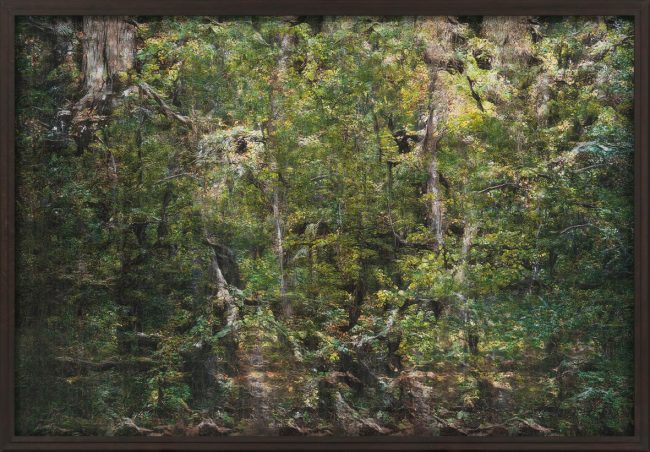
NOWs: Jungle Memory by Andreas Greiner
Andreas Greiner, Jungle Memory 0001, 2019
Andreas Greiner: Jungle Memory
at DITTRICH & SCHLECHTRIEM, Berlin
In Andreas Greiner’s work, there is no contradiction between art and science. His multi-media, multi-disciplinary practice includes time-based living and digital sculptures, photographs, and video works that chart complex concerns and expose vital issues in contemporary society, including environmental and ecological challenges. In the exhibition Jungle Memory, Greiner recreates nature, representing his research into endangered forests in Germany and Poland.
Greiner probes the relationship between ecology and technology. Amid a simulated forest and light scenario that transforms the main gallery space, Greiner presents a large-format video work made with the aid of artificial intelligence. A dataset comprising several thousand photographs that Greiner shot in the ancient Hambacher Forst and Białowieża forests was fed into a digital calculus to derive the idea of a forest. In processing the pictures, the artist created generated recollections or algorithmic projections of an abundant and unruly nature whose romantic flair is unmistakable. The resulting images are layered and morphed together to create a cinematic dance of trees, bright and illusionary yet concerning and oddly foreboding of a post-human world. A sound composition accompanies the installation.
Paralleling the abstractions on the four-square-meter LED screen and the sound piece, Greiner premieres a video in the first room. A two-channel video, created in collaboration with Paul Rohlfs, is presented on screens (purchased second-hand) that are connected to a central control box. In addition, the screens display archival quotes from texts on the economic or protective vision of silviculture, and a video illustrating the current process of natural dynamic reforestation. The video shows how the death of old spruce trees at the hands of the bark beetles allows the forest to regenerate, making it versatile and resilient. […]
The exhibition can be read as a cognitive and emotional collage that highlights, through a concrete local example, the interdependence of historical factors, economic decisions and climate change. Taking as a starting point the catastrophic situation of the forests of the Harz (a highland region in Lower Saxony), the works address an immediate reality that is tied as much to past centuries’ silviculture as to contemporary global ecological choices.
With Jungle Memory, Greiner probes the question whether, in our age of climate change and the mass extinction of species, the language of art is actually capable of adequately articulating these concerns. The passages above are excerpts from an essay that Bernard Vienat contributed for the gallery catalogue, which will be published in September 2020 and available at the gallery and via the online shop.
Andreas Greiner, Jungle Memory 0001, 2019
Andreas Greiner: Jungle Memory
DITTRICH & SCHLECHTRIEM, Berlin
Zwischen Kunst und Wissenschaft gibt es im Schaffen von Andreas Greiner keinen Widerspruch. Seine multimediale und interdisziplinäre Praxis umfasst zeitbasierte lebende und digitale Skulpturen, Fotografien und Videos, die komplexe Themen anschaulich machen und ein Schlaglicht auf drängende Fragen der heutigen Gesellschaft und insbesondere Umweltprobleme und ökologische Herausforderungen werfen. In Jungle Memory schafft Greiner Natur nach, um seine Forschungen zu gefährdeten Wäldern in Deutschland und Polen darzustellen.
Greiner hinterfragt das Verhältnis zwischen Ökologie und Technologie. In einer Nachbildung eines Waldes und einem Lichtszenario, das den Hauptraum der Galerie verwandelt, zeigt Greiner eine großformatige Videoarbeit, für die künstliche Intelligenz zum Einsatz kam. Aus einem Datensatz von mehreren tausend Fotografien, die Greiner im uralten Hambacher Forst und im Białowieża-Urwald geschossen hat, wurde mittels digitaler Rechenverfahren die Idee eines Waldes abstrahiert. Aus dem Bildmaterial fabrizierte der Künstler so Erinnerungen an oder algorithmische Projektionen einer reichhaltigen, unbändigen Natur, deren romantische Aura unverkennbar ist. Durch Überlagerung und Verformung der Bilder entstand ein filmreifer Tanz der Bäume, eine leuchtende, aber auch befremdliche Illusion, die eine Ahnung einer Welt ohne Menschen vermittelt. Eine Klangkomposition untermalt die Installation.
Parallel zu den Abstraktionen auf dem vier Quadratmeter messenden LED-Bildschirm und der Soundarbeit zeigt Greiner im ersten Raum eine neue Videoarbeit. Am Anfang der Ausstellung wird auf (gebraucht gekauften) Bildschirmen, die mit einer zentralen Kontrolleinheit verbunden sind, ein in Zusammenarbeit mit Paul Rohlfs entstandenes Zweikanalvideo gezeigt. Außerdem werden Archivzitate aus Schriften zum wirtschaftlich orientierten oder auf Bewahrung zielenden Waldbau sowie ein Video eingeblendet, das den derzeitigen Prozess naturnah-dynamischer Aufforstung veranschaulicht. Das Video zeigt, wie das durch den Borkenkäfer verursachte Absterben alter Fichten eine Verjüngung des Waldes ermöglicht, aus der er seine Wandlungs- und Widerstandsfähigkeit zieht. […]
Die Ausstellung lässt sich als Collage von Gedanken und Gefühlen lesen, die anhand eines konkreten Beispiels aus der näheren Umgebung ein Schlaglicht auf die Verbindungen zwischen historischen Faktoren, wirtschaftlichen Entscheidungen und Klimawandel wirft. Ausgehend vom katastrophalen Zustand der Wälder im niedersächsischen Harz wenden die Arbeiten sich einer handgreiflichen Wirklichkeit zu, die das Ergebnis von Jahrhunderten der Forstbewirtschaftung ebenso wie heutiger globaler ökologischer Weichenstellungen ist.
In Jungle Memory geht Greiner der Frage nach, ob die Sprache der Kunst in unserer von Klimawandel und massenhaftem Artensterben geprägten Zeit überhaupt in der Lage ist, diese Themen angemessen zu artikulieren. Die zitierten Passagen stammen aus einem Essay von Bernard Vienat für den Katalog, der im September 2020 erscheinen und in der Galerie sowie über unseren Onlineshop zu beziehen sein wird.
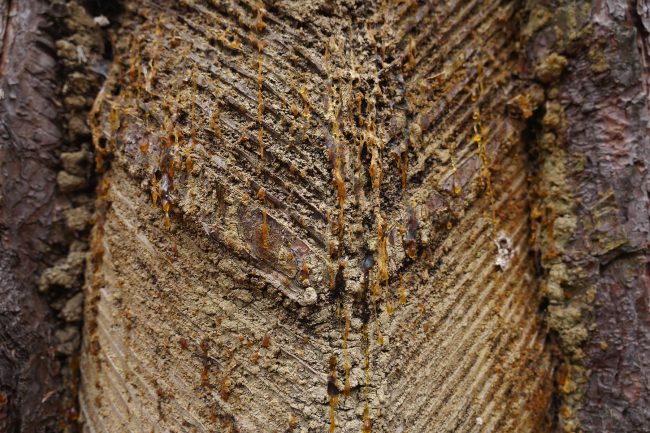
NOWs: Asako Iwama’s Pinocchio at Things Entangling. A collaboration between MOT and KADIST
photos: Asako Iwama
Things EntanglingA collaboration between MOT and KADIST
The Museum of Contemporary Art Tokyo and KADIST present the exhibition Things Entangling, the culmination of a major, long-term curatorial collaboration.
Trees, fossils, books, artifacts—these are some of our companions as we live in and make sense of a world in which realities and histories collide and reverberate continuously. This exhibition features artworks by twelve artists/groups that trace and animate the trajectories, nexuses, and mutations of things that resonate with a specific time and place. These things might be material objects or living subjects, but they are always also mediators of meaning, ideology, and memory. When these artists’ practices invoke anthropology, archaeology, or historiography to seek rootedness, they aim less to excavate or clarify the past than to open up a new politics of interpretation for building the present. Haunted by different time spans and territories, positions and subjectivities, the artists reveal unexpected intersections, elusive networks, and fleeting affinities between things. Through their work they aspire to open up the closed circles, exclusive territories, and static systems that are around and also within us.
Artists: Pio Abad, Liu Chuang, Hikaru Fujii, Dale Harding, Yukihisa Isobe, Asako Iwama, Kapwani Kiwanga, Jumana Manna, mixrice, Tom Nicholson, The Propeller Group and Superflex, Alexandra Pirici.
―
Asako Iwama: Pinocchio (2020)
The installation produced for this exhibition, Pinocchio (2020), is one such project. It began when the artist learned that the Japanese imperial army had attempted to develop alternative aviation fuel from pine roots towards the end of World War II. She investigated the historical background and chemical research to render pine tree sap―the fluid for circulating nutrition and closing wounds―into energy used for wars, as well as the use of pine in France and Germany, where the artist resides. She visited pine forests still remaining in Germany, making molds of the scars left on pine trunks and collecting resin from the trees. Through her archival research, she produced a series of prints from the traces of the bodies of workers who engage in the extraction of pine sap, including their extraction tools and distillation devices.
Pinocchio is an installation assembling pieces produced in this process of physical engagement and research. Different forms of resin and objects reminiscent of distillation point toward the contention with human forces that transforms this natural element, as well as this long, close relationship that reflects the condition of human society. The title of the piece, appropriated from Carlo Collodi’s The Adventures of Pinocchio, reflects the story of a pine trunk (pino = pine) becoming a human child.
As another figure in which human and pine meet, Iwama additionally created a small print with the image of the “pine hermit” from Taoism, said to eat pine needles in order to attain eternal life. The nexuses of pine trees and humans generate alterities without delineating linear histories or fixed meanings, offering the possibility for viewers to find their own micro-views and narratives.
–
Asako Iwama, born in 1975 in Tokyo. Lives and works in Berlin and Tokyo.
With her professional experience as a chef and interest in the production, distribution, and consumption of food as well as labor, the circulation of resources, and the social relationships they create, Asako Iwama has organized various types of workshops and performances for collective discourse. Her recent work includes videos and objects of various media made in collaboration with others, reflecting systems of society by way of shifts in the technological, ecological, and cultural relationships between humans and natural materials.
photos: Asako Iwama
Things EntanglingA collaboration between MOT and KADIST
The Museum of Contemporary Art Tokyo and KADIST present the exhibition Things Entangling, the culmination of a major, long-term curatorial collaboration.
Trees, fossils, books, artifacts—these are some of our companions as we live in and make sense of a world in which realities and histories collide and reverberate continuously. This exhibition features artworks by twelve artists/groups that trace and animate the trajectories, nexuses, and mutations of things that resonate with a specific time and place. These things might be material objects or living subjects, but they are always also mediators of meaning, ideology, and memory. When these artists’ practices invoke anthropology, archaeology, or historiography to seek rootedness, they aim less to excavate or clarify the past than to open up a new politics of interpretation for building the present. Haunted by different time spans and territories, positions and subjectivities, the artists reveal unexpected intersections, elusive networks, and fleeting affinities between things. Through their work they aspire to open up the closed circles, exclusive territories, and static systems that are around and also within us.
Artists: Pio Abad, Liu Chuang, Hikaru Fujii, Dale Harding, Yukihisa Isobe, Asako Iwama, Kapwani Kiwanga, Jumana Manna, mixrice, Tom Nicholson, The Propeller Group and Superflex, Alexandra Pirici.
―
Asako Iwama: Pinocchio (2020)
The installation produced for this exhibition, Pinocchio (2020), is one such project. It began when the artist learned that the Japanese imperial army had attempted to develop alternative aviation fuel from pine roots towards the end of World War II. She investigated the historical background and chemical research to render pine tree sap―the fluid for circulating nutrition and closing wounds―into energy used for wars, as well as the use of pine in France and Germany, where the artist resides. She visited pine forests still remaining in Germany, making molds of the scars left on pine trunks and collecting resin from the trees. Through her archival research, she produced a series of prints from the traces of the bodies of workers who engage in the extraction of pine sap, including their extraction tools and distillation devices.
Pinocchio is an installation assembling pieces produced in this process of physical engagement and research. Different forms of resin and objects reminiscent of distillation point toward the contention with human forces that transforms this natural element, as well as this long, close relationship that reflects the condition of human society. The title of the piece, appropriated from Carlo Collodi’s The Adventures of Pinocchio, reflects the story of a pine trunk (pino = pine) becoming a human child.
As another figure in which human and pine meet, Iwama additionally created a small print with the image of the “pine hermit” from Taoism, said to eat pine needles in order to attain eternal life. The nexuses of pine trees and humans generate alterities without delineating linear histories or fixed meanings, offering the possibility for viewers to find their own micro-views and narratives.
–
Asako Iwama, born in 1975 in Tokyo. Lives and works in Berlin and Tokyo.
With her professional experience as a chef and interest in the production, distribution, and consumption of food as well as labor, the circulation of resources, and the social relationships they create, Asako Iwama has organized various types of workshops and performances for collective discourse. Her recent work includes videos and objects of various media made in collaboration with others, reflecting systems of society by way of shifts in the technological, ecological, and cultural relationships between humans and natural materials.
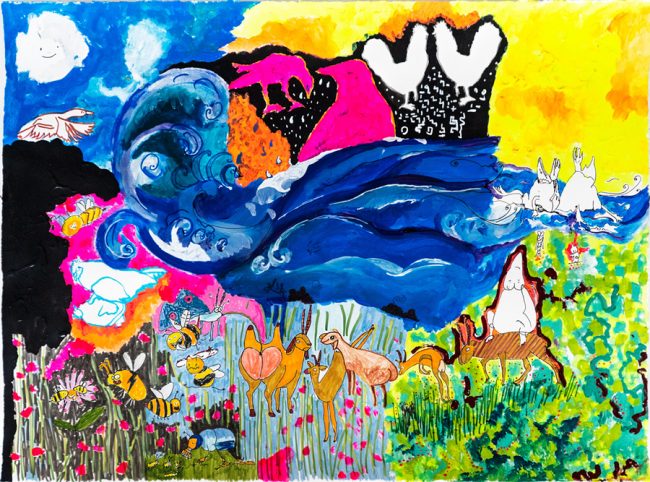
NOWs: HERR DER KRÄHEN
HERR DER KRÄHEN
DIRECTED BY Carlos Manuel
Premiere August 28th at 7 pm in the JTW
Gelsenkircherstr. 20, 12583 Berlin
The production deals with the novel “Lord of the Crows” by the Kenyan author Ngugi wa Thiong’o and creates a polyphonic political parable that does not know the one truth: in the confusion of voices, everyone seeks their place in the world And every story opens up a new event. In a country that wants to reach the sky with the tallest tower in the world, everyone has their hardship – from the simple policeman to the housewife, from the corrupt magnate to the countless unemployed who work in long periods Queues stand and wait until the dictator himself …
Director: Carlos Manuel | Choreography: Jenny Mezile | Stage / Installation: Anne Duk Hee Jordan | Costume: Verena Hay
with André Bertholdt, Andrea Manke, Daria Lazarieva, Esra Meyer, Florian Henning, Gianni Masariè, Jawid Arthen, Jingyun Li, Joachim Giera, Joyce Ferse, Leon Schley, Lia Runau, Maria Cecília, Martina-Malte Rathmann, Natalia Matthies, Pedro Ramires , Renate Schönfisch, Samson Ghebrehiwet, Sibel Kir
Register at schreiner@jtw-spandau.de or at 030-37587623
We would be delighted to see you here at jtw spandau.
HERR DER KRÄHEN
DIRECTED BY Carlos Manuel
Premiere August 28th at 7 pm in the JTW
Gelsenkircherstr. 20, 12583 Berlin
The production deals with the novel “Lord of the Crows” by the Kenyan author Ngugi wa Thiong’o and creates a polyphonic political parable that does not know the one truth: in the confusion of voices, everyone seeks their place in the world And every story opens up a new event. In a country that wants to reach the sky with the tallest tower in the world, everyone has their hardship – from the simple policeman to the housewife, from the corrupt magnate to the countless unemployed who work in long periods Queues stand and wait until the dictator himself …
Director: Carlos Manuel | Choreography: Jenny Mezile | Stage / Installation: Anne Duk Hee Jordan | Costume: Verena Hay
with André Bertholdt, Andrea Manke, Daria Lazarieva, Esra Meyer, Florian Henning, Gianni Masariè, Jawid Arthen, Jingyun Li, Joachim Giera, Joyce Ferse, Leon Schley, Lia Runau, Maria Cecília, Martina-Malte Rathmann, Natalia Matthies, Pedro Ramires , Renate Schönfisch, Samson Ghebrehiwet, Sibel Kir
Register at schreiner@jtw-spandau.de or at 030-37587623
We would be delighted to see you here at jtw spandau.
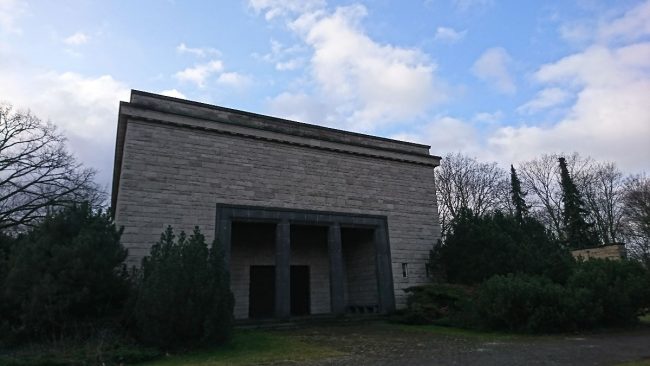
NOWs: A Handful of Dust
Lösch Mir Die Augen Aus (Anne Duk Hee Jordan, Viron Erol Vert, 2020), 3D Simulation
A HANDFUL OF DUSTEhrenhalle Lilienthalstrasse Neukölln
Lilienthalstraße Cemetery, Lilienthalstraße 7, 10965 Berlin
CURATED BY
Pauline Doutreluingne & Petra Poelzl
ARTISTS
Anne Duk Hee Jordan & Viron Erol Vert
CONTRIBUTIONS BY
Mika Hayashi Ebbesen, Sara Neidorf, Mmakgosi Kgabi, Nathalie Mba Bikoro, Ariel Efraim Ashbel, Cymin Samawatie, Korhan Erel, Ralf Schwarz, Lena Ditte Nissen, Sandra Franz and Dr. Anna Zakrisson
www.ahandfulofdust.com
Departing from the so-called “Ehrenhalle” (Hall of Honour), built between 1938 and 1941 as a “Temple of the Fatherland” at the site of the Lilienthalstraße cemetery in Berlin-Neukölln, A Handful of Dust deals with the topic of fear within historical socio-political contexts. The generation of social fear has always been a reliable tool in the process of gaining power and occupies the core of the National Socialist structures and colonial history. Recently, the creation of the concept of the enemy is used to fuel fear, which serves to build up and expand political and social power structures. For instead of a constructive and strategic approach to issues such as climate change, migration and technological upheaval, populism and emotionalization are fanning the flames of insecurity in broad sections of society and thus nurturing the ground for fear to ripen and flourish.
A Handful of Dust understands itself as a questioning of black-and-white juxtapositions and seeks ways of thinking and acting outside of these extremes in order to make visible the complexity of historiography. The project aims to counter the advancing polarization and social division through a collective search for nuance, variation and lyricism.
Together with the artists Anne Duk Hee Jordan and Viron Erol Vert, the curators Pauline Doutreluingne and Petra Poelzl have developed an artistic, performative and discursive space of experience, searching for strategies for deconstructing hegemonic systems of thought and making multiform, norm-converting imaginations and narratives visible, audible, and tangible.
In addition to a collaboratively developed artistic installation by Anne Duk Hee Jordan and Viron Erol Vert in the Ehrenhalle in the center of the cemetery site, the area surrounding the hall will also be used for four weekends (04.09.2020 – 27.09.2020) through sound, discursive and performative formats. The curators, artists, performers, scientists and musicians will consciously enter this “foreign body”, a historically occupied non-art space, and aim to open up pluralistic spaces of thought through a reflective examination on the embodiment of fear.
PROGRAM
DURATION OF THE EXHIBITION | 04.09. – 27.09.2020
OPENING HOURS EXHIBITION | Fri, Sat, Sun | 1 – 7 pm
Location Lilienthalstraße Cemetery
Lilienthalstraße 7 | 10965 Berlin
FRIDAY | 04.09.2020 | 3 – 9 pm
OPENING & SONIC MANIFESTATION
7 pm | Mika Hayashi Ebbesen and Sara Neidorf
SATURDAY | 05.09.2020
PERFORMANCE
1 – 8 pm | Durational Performance by Nathalie Mba Bikoro
SATURDAY | 12.09.2020
PERFORMATIVE WALK
5 pm | Performative Walk | Lena Ditte Nissen & Sandra Franz
SATURDAY | 19.09.2020
SONIC MANIFESTATION & PERFORMATIVE WALK
5.00 pm | Sonic Manifestation | Mika Hayashi Ebbesen and Sara Neidorf
6.00 pm | Performative Walk | Ariel Efraim Ashbel
SATURDAY | 26.09.2020
LECTURE
5 pm | Lecture | Dr. Anna Zakrisson
SUNDAY, 27.09.2020
SOUND IMPROVISATION | FINISSAGE
5 pm | Concert
Cymin Samawatie, Korhan Erel & Ralf Schwarz
Lösch Mir Die Augen Aus (Anne Duk Hee Jordan, Viron Erol Vert, 2020), 3D Simulation
A HANDFUL OF DUSTEhrenhalle Lilienthalstrasse Neukölln
Lilienthalstraße Cemetery, Lilienthalstraße 7, 10965 Berlin
CURATED BY
Pauline Doutreluingne & Petra Poelzl
ARTISTS
Anne Duk Hee Jordan & Viron Erol Vert
CONTRIBUTIONS BY
Mika Hayashi Ebbesen, Sara Neidorf, Mmakgosi Kgabi, Nathalie Mba Bikoro, Ariel Efraim Ashbel, Cymin Samawatie, Korhan Erel, Ralf Schwarz, Lena Ditte Nissen, Sandra Franz and Dr. Anna Zakrisson
www.ahandfulofdust.com
Departing from the so-called “Ehrenhalle” (Hall of Honour), built between 1938 and 1941 as a “Temple of the Fatherland” at the site of the Lilienthalstraße cemetery in Berlin-Neukölln, A Handful of Dust deals with the topic of fear within historical socio-political contexts. The generation of social fear has always been a reliable tool in the process of gaining power and occupies the core of the National Socialist structures and colonial history. Recently, the creation of the concept of the enemy is used to fuel fear, which serves to build up and expand political and social power structures. For instead of a constructive and strategic approach to issues such as climate change, migration and technological upheaval, populism and emotionalization are fanning the flames of insecurity in broad sections of society and thus nurturing the ground for fear to ripen and flourish.
A Handful of Dust understands itself as a questioning of black-and-white juxtapositions and seeks ways of thinking and acting outside of these extremes in order to make visible the complexity of historiography. The project aims to counter the advancing polarization and social division through a collective search for nuance, variation and lyricism.
Together with the artists Anne Duk Hee Jordan and Viron Erol Vert, the curators Pauline Doutreluingne and Petra Poelzl have developed an artistic, performative and discursive space of experience, searching for strategies for deconstructing hegemonic systems of thought and making multiform, norm-converting imaginations and narratives visible, audible, and tangible.
In addition to a collaboratively developed artistic installation by Anne Duk Hee Jordan and Viron Erol Vert in the Ehrenhalle in the center of the cemetery site, the area surrounding the hall will also be used for four weekends (04.09.2020 – 27.09.2020) through sound, discursive and performative formats. The curators, artists, performers, scientists and musicians will consciously enter this “foreign body”, a historically occupied non-art space, and aim to open up pluralistic spaces of thought through a reflective examination on the embodiment of fear.
PROGRAM
DURATION OF THE EXHIBITION | 04.09. – 27.09.2020
OPENING HOURS EXHIBITION | Fri, Sat, Sun | 1 – 7 pm
Location Lilienthalstraße Cemetery
Lilienthalstraße 7 | 10965 Berlin
FRIDAY | 04.09.2020 | 3 – 9 pm
OPENING & SONIC MANIFESTATION
7 pm | Mika Hayashi Ebbesen and Sara Neidorf
SATURDAY | 05.09.2020
PERFORMANCE
1 – 8 pm | Durational Performance by Nathalie Mba Bikoro
SATURDAY | 12.09.2020
PERFORMATIVE WALK
5 pm | Performative Walk | Lena Ditte Nissen & Sandra Franz
SATURDAY | 19.09.2020
SONIC MANIFESTATION & PERFORMATIVE WALK
5.00 pm | Sonic Manifestation | Mika Hayashi Ebbesen and Sara Neidorf
6.00 pm | Performative Walk | Ariel Efraim Ashbel
SATURDAY | 26.09.2020
LECTURE
5 pm | Lecture | Dr. Anna Zakrisson
SUNDAY, 27.09.2020
SOUND IMPROVISATION | FINISSAGE
5 pm | Concert
Cymin Samawatie, Korhan Erel & Ralf Schwarz
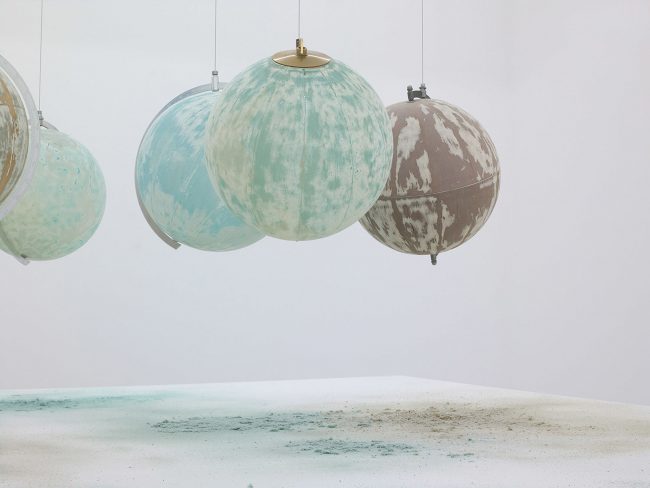
NOWs: Towards No Earthly Pole by Julian Charrière
Julian Charrière, We Are All Astronauts, 2013. Ausstellungsansicht Centre Culturel Suisse, Paris, Frankreich, 2014. Courtesy the artist © 2020, Pro Litteris, Zürich
Julian Charrière: Towards No Earthly Pole
Aargauer Kunsthaus
Switzerland
With Towards No Earthly Pole the Aargauer Kunsthaus is presenting the work of the Swiss artist Julian Charrière (b. 1987). The subject of travel as well as the actual expedition assume a central importance in his artistic practice. Time and again, he seeks out regions that have global significance for our past, present and future. For his latest, monumental film work Towards No Earthly Pole he journeyed to the most inhospitable parts of the planet: the Antarctic, Greenland and Iceland, but also extraordinary domestic topographies such as the alpine glaciers.
The projection that lends its title to the solo exhibition allows the viewers to immerse themselves in fascinating ice landscapes, and transports them into a remote and deserted spot. It shows regions that we think we know thanks to collectively constructed images, but which very few of us have visited in person. The depiction of these places in Charrière’s feature-length film work astonishes with its deliberately subjective, poetic reproduction of these unusual territories.
Other works in the exhibition—photographs, sculptures, videos and installations—are steeped in the artist’s curiosity about understanding the environment: photographs of idyllic palm beaches treated with radioactive material, floating globes stripped of their surface information, or pictures showing Charrière himself melting a glacier. For visitors, the tour of the exhibition becomes a journey through the cosmos of Charrière, who is both artist and researcher, and offers an engagement with the inseparable connection between humanity and nature.
In cooperation with MASI Lugano
Publication
To coincide with the exhibition, in October a comprehensive publication (German/English) will be released on the subject of Julian Charrière’s latest film Towards No Earthly Pole. With essays by: Francesca Benini, Amanda Boetzkes, Katherine Brodbeck, Dehlia Hannah, Scott MacKenzie & Anna Westerståhl Stenport, Shane McCorristine, Nadim Samman and Katrin Weilenmann, as well as a conversation between the artist and the climate expert Konrad Steffen.
Aargauer Kunsthaus, MASI Lugano, Dallas Museum of Art, and Mousse Publishing, ISBN 978-88-6749-434-7
Julian Charrière, We Are All Astronauts, 2013. Ausstellungsansicht Centre Culturel Suisse, Paris, Frankreich, 2014. Courtesy the artist © 2020, Pro Litteris, Zürich
Julian Charrière: Towards No Earthly Pole
Aargauer Kunsthaus
Switzerland
With Towards No Earthly Pole the Aargauer Kunsthaus is presenting the work of the Swiss artist Julian Charrière (b. 1987). The subject of travel as well as the actual expedition assume a central importance in his artistic practice. Time and again, he seeks out regions that have global significance for our past, present and future. For his latest, monumental film work Towards No Earthly Pole he journeyed to the most inhospitable parts of the planet: the Antarctic, Greenland and Iceland, but also extraordinary domestic topographies such as the alpine glaciers.
The projection that lends its title to the solo exhibition allows the viewers to immerse themselves in fascinating ice landscapes, and transports them into a remote and deserted spot. It shows regions that we think we know thanks to collectively constructed images, but which very few of us have visited in person. The depiction of these places in Charrière’s feature-length film work astonishes with its deliberately subjective, poetic reproduction of these unusual territories.
Other works in the exhibition—photographs, sculptures, videos and installations—are steeped in the artist’s curiosity about understanding the environment: photographs of idyllic palm beaches treated with radioactive material, floating globes stripped of their surface information, or pictures showing Charrière himself melting a glacier. For visitors, the tour of the exhibition becomes a journey through the cosmos of Charrière, who is both artist and researcher, and offers an engagement with the inseparable connection between humanity and nature.
In cooperation with MASI Lugano
Publication
To coincide with the exhibition, in October a comprehensive publication (German/English) will be released on the subject of Julian Charrière’s latest film Towards No Earthly Pole. With essays by: Francesca Benini, Amanda Boetzkes, Katherine Brodbeck, Dehlia Hannah, Scott MacKenzie & Anna Westerståhl Stenport, Shane McCorristine, Nadim Samman and Katrin Weilenmann, as well as a conversation between the artist and the climate expert Konrad Steffen.
Aargauer Kunsthaus, MASI Lugano, Dallas Museum of Art, and Mousse Publishing, ISBN 978-88-6749-434-7
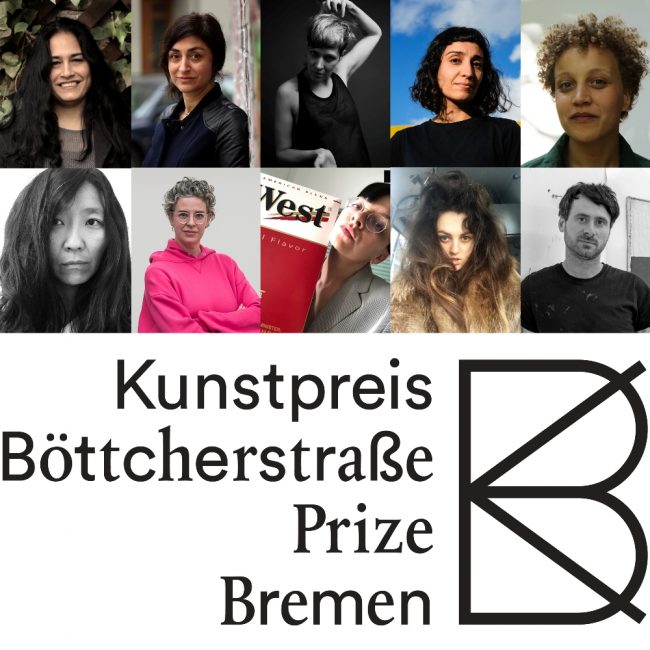
NOWs: Anne Duk Hee Jordan nominated for the Böttcherstrasse Prize Bremen
f.l.t.r.: Bani Abidi (photo: Schokofeh Kamiz), Nevin Aladağ, Jesse Darling (photo: Christa Holka), Toulu Hassani (photo: Volker Crone), Janine Jembere (© Sebastian Bodirsky), Anne Duk Hee Jordan, Ulrike Müller (© Katja Illner), Henrike Naumann (photo: Henrike Naumann), Raphaela Vogel (photo: Jane Eyre), Stefan Vogel
Prize of the Böttcherstraße in Bremen 2020art prize and group exhibition
Exhibition: 29 August – 1 November 2020
Press conference: 28 August 2020, 11am
Award ceremony: 27 October 2020, 7pm
Curated by Mara-Lisa KinneThe Kunsthalle Bremen presents ten young and promising positions in contemporary art. Distinguished curators such as Johan Holten, Bonaventure Soh Bejeng Ndikung and Bettina Steinbrügge have nominated ten artists from the German-speaking area. Their works can be seen in the Kunsthalle Bremen in an exhibition from 29 August to 1 November 2020.The Prize of the Böttcherstraße in Bremen is among the leading and highest awards in the field of contemporary art in Germany. The competition features 30,000 Euro in prize money for the winner and, in 2020, it was held for the 47th time in the Kunsthalle Bremen. A prominent jury determines the winner of the prize during the course of the exhibition. The following ten artists have been nominated for the 2020 Prize of the Böttcherstraße in Bremen:Bani Abidi (born 1971 in Karachi, Pakistan, lives in Berlin), nominated by Natasha Ginwala, Gropius Bau, Berlin
Nevin Aladağ (born 1972 in Van, Turkey, lives in Berlin), nominated by Johan Holten, Kunsthalle Mannheim
Jesse Darling (born 1984 in Coventry, UK, lives in Berlin and London), nominated by Dr. Andrea Schlieker, Tate Britain, London
Toulu Hassani (born 1984 in Ahwaz, Iran, lives in Hanover), nominated by Stifterkreis des Kunstpreis der Böttcherstraße, Bremen
Janine Jembere (born 1985 in Magdeburg, lives in Vienna), nominated by Dr. Yvette Mutumba, Contemporary And (C&) und Universität der Künste, Berlin
Anne Duk Hee Jordan (born 1978 in Korea, lives in Berlin), nominated by Dr. Bonaventure Soh Bejeng Ndikung, SAVVY Contemporary, Berlin
Ulrike Müller (born 1971 in Brixlegg, Austria, lives in New York), nominated by Prof. Dr. Christoph Grunenberg, Kunsthalle Bremen
Henrike Naumann (born 1984 in Zwickau, lives in Berlin), nominated by Severin Dünser, Belvedere 21, Vienna
Raphaela Vogel (born 1988 in Nuremberg, lives in Berlin), nominated by Thomas D. Trummer, Kunsthaus Bregenz
Stefan Vogel (born 1981 in Fürth, lives in Leipzig), nominated by Prof. Dr. Bettina Steinbrügge, Kunstverein in Hamburg
The art prize has been awarded for over sixty years. Since 1985 the prize and the exhibition has been presented in the Kunsthalle Bremen with the support of the Donors’ Circle (Stifterkreis) of the Kunstverein in Bremen (Bremen Art Association). They have also made possible the purchase of a work by each of the prize’s winners. The Kunsthalle Bremen has thus been able to expand its collection through significant works by Martin Honert, Olafur Eliasson, Wolfgang Tillmans, Tino Sehgal, Ulla von Brandenburg, Thea Djordjadze or Daniel Knorr and Nina Beier, among others. Every two years, ten distinguished curators each independently select one artist from the German-speaking area.
v.l.n.r.: Bani Abidi (photo: Schokofeh Kamiz), Nevin Aladağ, Jesse Darling (photo: Christa Holka), Toulu Hassani (photo: Volker Crone), Janine Jembere (© Sebastian Bodirsky), Anne Duk Hee Jordan, Ulrike Müller (© Katja Illner), Henrike Naumann (photo: Henrike Naumann), Raphaela Vogel (photo: Jane Eyre), Stefan Vogel
Kunstpreis der Böttcherstraße Bremen 2020Kunstpreis und Gruppenausstellung
Ausstellung: 29. August bis 1. November 2020
Pressekonferenz: Freitag, 28. August 2020, 11 Uhr
Preisverleihung: Dienstag, 27. Oktober 2020, 19 Uhr
Kuratorin: Mara-Lisa Kinne
Im Jahr 2020 findet der Kunstpreis der Böttcherstraße in Bremen zum 47. Mal statt. Vom 29. August bis 1. November 2020 präsentiert die Kunsthalle Bremen zehn vielversprechende Positionen der zeitgenössischen Kunst. Angesehene Kurator*innen wie Johan Holten, Bonaventure Soh Bejeng Ndikung oder Bettina Steinbrügge haben zehn Künstler*innen aus dem deutschsprachigen Raum nominiert. Nun stehen die nominierten Positionen fest.
Der Kunstpreis der Böttcherstraße in Bremen zählt zu den anerkanntesten und mit 30.000 Euro Preisgeld am höchsten dotierten Auszeichnungen, die im Bereich der zeitgenössischen Kunst in Deutschland, Österreich und der Schweiz vergeben werden. Die Wettbewerbsausstellung findet 2020 zum 47. Mal statt. Im Laufe der Ausstellung ermittelt eine hochrangige fünfköpfige Jury den/die Preisträger*in. In der Vergangenheit waren unter den Preisträger*innen sowie unter den vorgeschlagenen Künstler*innen zahlreiche Namen, die in den folgenden Jahren in der internationalen Kunstszene große Aufmerksamkeit erhielten. Dazu gehören zum Beispiel Tomma Abts, die später mit dem Turnerpreis ausgezeichnet wurde, sowie Dirk Skreber, der den Preis für Junge Kunst der Nationalgalerie Berlin erhielt.
Für den Kunstpreis der Böttcherstraße in Bremen 2020 wurden folgende zehn Künstler*innen nominiert:
Bani Abidi (geboren 1971 in Karatschi, Pakistan, lebt in Berlin) vorgeschlagen von Natasha Ginwala, Gropius Bau, Berlin
Nevin Aladağ (geboren 1972 in Van, Türkei, lebt in Berlin) vorgeschlagen von Johan Holten, Kunsthalle Mannheim
Jesse Darling (geboren 1984 in Coventry, UK, lebt in Berlin und London) vorgeschlagen von Dr. Andrea Schlieker, Tate Britain, London
Toulu Hassani (geboren 1984 in Ahwaz, Iran, lebt in Hannover) vorgeschlagen vom Stifterkreis des Kunstpreis der Böttcherstraße, Bremen
Janine Jembere (geboren 1985 in Magdeburg, lebt in Wien) vorgeschlagen von Dr. Yvette Mutumba, Contemporary And (C&) und Universität der Künste, Berlin
Anne Duk Hee Jordan (geboren 1978 in Korea, lebt in Berlin) vorgeschlagen von Dr. Bonaventure Soh Bejeng Ndikung, SAVVY Contemporary, Berlin
Ulrike Müller (geboren 1971 in Brixlegg, Österreich, lebt in New York) vorgeschlagen von Prof. Dr. Christoph Grunenberg, Kunsthalle Bremen
Henrike Naumann (geboren 1984 in Zwickau, lebt in Berlin) vorgeschlagen von Severin Dünser, Belvedere 21, Wien
Raphaela Vogel (geboren 1988 in Nürnberg, lebt in Berlin) vorgeschlagen von Thomas D. Trummer, Kunsthaus Bregenz
Stefan Vogel (geboren 1981 in Fürth, lebt in Leipzig) vorgeschlagen von Prof. Dr. Bettina Steinbrügge, Kunstverein in Hamburg
Der Kunstpreis wird seit über sechzig Jahren verliehen. Getragen werden der Kunstpreis und die gemeinsame Ausstellung der nominierten Künstler*innen seit 1985 vom Stifterkreis für den Kunstpreis der Böttcherstraße des Kunstvereins in Bremen. Dieser ermöglicht zudem den Ankauf eines Werks des/der jeweiligen Preisträger*in. So konnte die Sammlung der Kunsthalle Bremen unter anderem um Arbeiten von Martin Honert, Olafur Eliasson, Wolfgang Tillmans, Tino Sehgal, Ulla von Brandenburg, Thea Djordjadze oder Daniel Knorr und Nina Beier erweitert werden. Im Zweijahresrhythmus schlagen zehn angesehene Kurator*innen unabhängig voneinander je eine*n Künstler*in aus dem deutschsprachigen Raum vor.
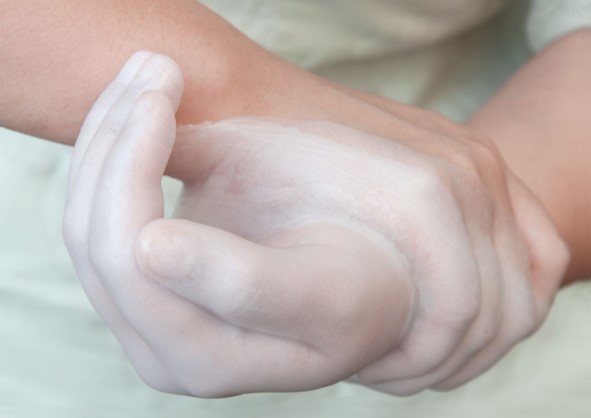
NOWs: StipendiatInnen der Hans und Charlotte Krull Stiftung 2018 – 2020
Nina Schuiki, Auf Dauer, 2019. Fotografie einer Geste (Wachs, Hände), Fine Art Print, 20 x 30 cm
ausgezeichnet | gefördertStipendiatInnen der Hans und Charlotte Krull Stiftung 2018 – 2020
In der Kommunalen Galerie Berlin
Heiner Franzen | Leonid Keller | Oskar Schmidt | Nina Schuiki | Christian Schellenberger | Stephanie Steinkopf | Leon Eixenberger
Die Hans und Charlotte Krull Stiftung fördert seit 2010 bildende Künstler*innen mit jährlichen Arbeitsstipendien von 12.000 €. Alle zwei Jahre richtet sie eine Ausstellung für ihre Stipendiat*innen aus, in diesem Jahr für die sieben der Jahre 2018 bis 2020 und zum wiederholten Mal in der Kommunalen Galerie Berlin.
Es geht um Politisches, Privates und Perspektivwechsel.
Reale und innere Mauern trennen Zimmer, Menschen und Länder, das zeigen Leon Eixenberger in einer Videoarbeit, gedreht in einem Haus des Architekten Hans Scharoun und Stephanie Steinkopf in ihrem Fotofilm über die Spuren der Berliner Mauer in Biografien. Das Schwanken zwischen Sozialismus und Kapitalismus thematisiert auch das Künstlerduo Leonid Keller in ihrer Installation. Im Dazwischen zeichnet Christian Schellenberger, meist in Bus und Bahn. Heiner Franzen befasst sich in einem Video mit Sprechakten und der Fotograf Oskar Schmidt stellt den Eurozentrismus in der Kunstgeschichte infrage. Doch am Ende ist eh alles ephemer, daran erinnert uns die Projektion von Nina Schuikis ewig verdampfender und verflüssigender Träne.
Da es dieses Jahr keine Rundgänge geben kann, werden online Videos auf Instagram eingestellt, in denen Ihnen die Werke der Künstler*innen nähergebracht werden.
Ausstellung:
25.6. – 06.9.2020 | Di., Do., Fr. 10 bis 17 Uhr | Mi. 10 – 19 Uhr | So. 11 bis 17 Uhr | Eintritt frei
Kommunale Galerie Berlin | Hohenzollerndamm 176 | 10713 Berlin | www.kommunalegalerie-berlin.de
Hans und Charlotte Krull Stiftung
c/o RA Hans-Georg Schüler
Hindenburgdamm 33
12203 Berlin
www.krull-stiftung.de
Leon Eixenberger, Filmstills Alphabet, 2020
Nina Schuiki, Auf Dauer, 2019. Fotografie einer Geste (Wachs, Hände), Fine Art Print, 20 x 30 cm
ausgezeichnet | gefördertStipendiatInnen der Hans und Charlotte Krull Stiftung 2018 – 2020
In der Kommunalen Galerie Berlin
Heiner Franzen | Leonid Keller | Oskar Schmidt | Nina Schuiki | Christian Schellenberger | Stephanie Steinkopf | Leon Eixenberger
Die Hans und Charlotte Krull Stiftung fördert seit 2010 bildende Künstler*innen mit jährlichen Arbeitsstipendien von 12.000 €. Alle zwei Jahre richtet sie eine Ausstellung für ihre Stipendiat*innen aus, in diesem Jahr für die sieben der Jahre 2018 bis 2020 und zum wiederholten Mal in der Kommunalen Galerie Berlin.
Es geht um Politisches, Privates und Perspektivwechsel.
Reale und innere Mauern trennen Zimmer, Menschen und Länder, das zeigen Leon Eixenberger in einer Videoarbeit, gedreht in einem Haus des Architekten Hans Scharoun und Stephanie Steinkopf in ihrem Fotofilm über die Spuren der Berliner Mauer in Biografien. Das Schwanken zwischen Sozialismus und Kapitalismus thematisiert auch das Künstlerduo Leonid Keller in ihrer Installation. Im Dazwischen zeichnet Christian Schellenberger, meist in Bus und Bahn. Heiner Franzen befasst sich in einem Video mit Sprechakten und der Fotograf Oskar Schmidt stellt den Eurozentrismus in der Kunstgeschichte infrage. Doch am Ende ist eh alles ephemer, daran erinnert uns die Projektion von Nina Schuikis ewig verdampfender und verflüssigender Träne.
Da es dieses Jahr keine Rundgänge geben kann, werden online Videos auf Instagram eingestellt, in denen Ihnen die Werke der Künstler*innen nähergebracht werden.
Ausstellung:
25.6. – 06.9.2020 | Di., Do., Fr. 10 bis 17 Uhr | Mi. 10 – 19 Uhr | So. 11 bis 17 Uhr | Eintritt frei
Kommunale Galerie Berlin | Hohenzollerndamm 176 | 10713 Berlin | www.kommunalegalerie-berlin.de
Hans und Charlotte Krull Stiftung
c/o RA Hans-Georg Schüler
Hindenburgdamm 33
12203 Berlin
www.krull-stiftung.de
Leon Eixenberger, Filmstills Alphabet, 2020
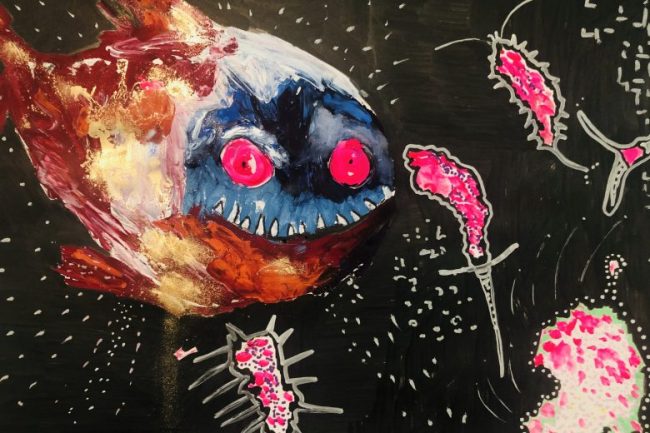
NOWs: Making Kin – Melanie Bonajo, Madison Bycroft, Anne Duk Hee Jordan
Making Kin – Melanie Bonajo, Madison Bycroft, Anne Duk Hee Jordan
Kunsthaus Hamburg
Klosterwall 15
20095 Hamburg
Der titelgebende Ausspruch „Making Kin“ (Macht euch verwandt) ist eine Maxime der Wissenschaftsphilosophin und Cyborg-Feminismus-Pionierin Donna Haraway, die zur artenübergreifenden Symbiose auffordert. In ihren Texten wimmelt es von Lebewesen unterschiedlichster Arten. Um für kommende Generationen eine Zukunft zu ermöglichen, müssen wir uns als sterbliche „Kritter“ mit unzähligen Konfigurationen aus Orten, Zeiten, Materien und Bedeutungen verflechten, damit aus dem planetenzerstörenden Homo sapiens neues Leben „kompostiert“ werden kann.
Die Künstlerinnen hinterfragen gesetzte Begriffe wie Natur, Kultur und Technik und ihre jeweiligen Trennlinien. Dabei interessieren sie sich für das hybride Netzwerk zwischen dem Menschen und seiner Umwelt. Humorvoll und spielerisch entwerfen sie experimentelle und zukunftsorientierte Szenarien, die unsere gewohnten Lebensweisen in Frage stellen und neue Modelle von Gemeinsamkeit erlebbar machen. Für die Ausstellung sind neue Arbeiten entstanden, die zum Nachdenken über ein übergreifendes ökologisches Prinzip der Verbundenheit anregen.
Anne Duk Hee Jordan, From the deep sea archive: piranhas are not so deep, 2017
Making Kin – Melanie Bonajo, Madison Bycroft, Anne Duk Hee Jordan
Kunsthaus Hamburg
Klosterwall 15
20095 Hamburg
„Making Kin”, the phrase that gave the show its title, is a maxim coined by the philosopher of science and pioneer cyborg feminist Donna Haraway who calls for an interspecies symbiosis. Her texts are teeming with all kinds of different creatures. To ensure a liveable future for the following generations, we, as mortal “critters”, need to link up ourselves with multiple configurations of places, times, matters and meanings so that new life can be “composted” from the planet-destroying Homo sapiens.
The artists scrutinize established terms like nature, culture and technology, including their definitional boundaries. They are interested in the hybrid network between humans and their environment. In a humorous and playful manner, they draw up experimental and future-oriented scenarios that challenge our customary lifestyles and likewise make new models of community both imaginable and apprehensible. New works were created for the exhibition that inspire us to reflect upon an overall ecological principle of connectivity.
Anne Duk Hee Jordan, From the deep sea archive: piranhas are not so deep, 2017

NOWs: Anne Duk Hee Jordan, Robert Lippok at Down to Earth
Down to EarthClimate Art Discourse unplugged
Gropius Bau
Niederkirchnerstraße 7
10963 Berlin
“Down to Earth”, a summer at the Gropius Bau: four weeks without electricity, loudspeakers, videos, screens, air travel or spotlights, but with daylight, heat, recycling, analogue music, dance and talks by experts on change, exhibits on the themes of the ocean, Gaia, puddles, the living earth, a sawn-up Porsche and modern rituals, in the spirit of Latour, Margulis, Lovelock and the Shipibo – 14 rooms and different overall every day.
With Frédérique Aït-Touati mit Bruno Latour und Gästen (SPEAP, Zone Critique), Kader Attia, Peter Berz, Luca Di Blasi, Grit Bürgow, Filipa César / Louis Henderson, François Chaignaud & Marie-Pierre Brébant, Marco Clausen, Johannes Comeau-Milke, Steven Corcoran, Agnes Denes, Immanuel Dorn, Jan Edler & Tim Edler, Ensemble Extrakte, Shelley Etkin, Maja Chiara Faber, Henry Farkas, Andreas Frädrich, Vibha Galhotra, Simryn Gill, Andreas Gursky, Joschka Härdtner, Benedikt Haerlin, Helen Mayer Harrison & Newton Harrison, Cornelis F. Hemmer, Femke Herregraven, Christian Heymann, Louise Höjer, Yngve Holen, Anne Duk Hee Jordan, Koo Jeong A, Rüdiger Kruse, Lukasz Kuni, Alicja Kwade, Michelle-Marie Letelier, Armin Linke, Robert Lippok, Diego Maronese, Konstanze Meyer, Dr. Motte, Marion Müller, Hermann E. Ott, Jean Painlevé, Khien Phuc, Kirsten Pieroth, Asad Raza, Tomás Saraceno, Birgit Schattling, Karin Schönberger, Isabell Schrickel, Carla Schulte-Fischedick, Dorothea Schwierskott, Tino Sehgal, Claire Vivianne, Sobottke, Himali Singh Soin, Kerstin Stark, Anja Steglich, Stegreif Orchester, Joulia Strauss, Meg Stuart, Rirkrit Tiravanija / Nikolaus Hirsch / Michel Müller, Marcus Vietzke, Andrea Voets, Andreas Weber, Peter Weibel, Peter Wilhelm, Susanne Winter, Bartosz Żurowski and many others
Initiated by Thomas Oberender
Co-curated by Julia Badaljan, Thomas Oberender, Anja Predeick, Tino Sehgal, Jeroen Versteele
Curatorial associates Descha Daemgen, Stefanie Hessler, Marc Pohl, Joulia Strauss, Frédérique Aït-Touati
An exhibition organised by Berliner Festspiele as part of the programme series Immersion.
Down to EarthKlima Kunst Diskurs unplugged
Gropius Bau
Niederkirchnerstraße 7
10963 Berlin
„Down to Earth“, der Sommer im Gropius Bau: Vier Wochen ohne Strom, Lautsprecher, Videos, Screens, Flugreisen, Scheinwerfer, dafür mit Tageslicht, Hitze, Recycling, analoger Musik, Tanz, Talks mit Expert*innen des Wandels, Exponaten zum Thema Ozean, Gaia, Wasserpfützen, lebender Erde, einem zersägten Porsche, modernen Ritualen, im Geiste Latours, Margulis, Lovelocks und der Shipibo – 14 Räume, im Ganzen jeden Tag anders.
Mit Frédérique Aït-Touati mit Bruno Latour und Gästen (SPEAP, Zone Critique), Kader Attia, Peter Berz, Luca Di Blasi, Grit Bürgow, Filipa César / Louis Henderson, François Chaignaud & Marie-Pierre Brébant, Marco Clausen, Johannes Comeau-Milke, Steven Corcoran, Agnes Denes, Immanuel Dorn, Jan Edler & Tim Edler, Ensemble Extrakte, Shelley Etkin, Maja Chiara Faber, Henry Farkas, Andreas Frädrich, Vibha Galhotra, Simryn Gill, Andreas Gursky, Joschka Härdtner, Benedikt Haerlin, Helen Mayer Harrison & Newton Harrison, Cornelis F. Hemmer, Femke Herregraven, Christian Heymann, Louise Höjer, Yngve Holen, Anne Duk Hee Jordan, Koo Jeong A, Rüdiger Kruse, Lukasz Kuni, Alicja Kwade, Michelle-Marie Letelier, Armin Linke, Robert Lippok, Diego Maronese, Konstanze Meyer, Dr. Motte, Marion Müller, Hermann E. Ott, Jean Painlevé, Khien Phuc, Kirsten Pieroth, Asad Raza, Tomás Saraceno, Birgit Schattling, Karin Schönberger, Isabell Schrickel, Carla Schulte-Fischedick, Dorothea Schwierskott, Tino Sehgal, Claire Vivianne, Sobottke, Himali Singh Soin, Kerstin Stark, Anja Steglich, Stegreif Orchester, Joulia Strauss, Meg Stuart, Rirkrit Tiravanija / Nikolaus Hirsch / Michel Müller, Marcus Vietzke, Andrea Voets, Andreas Weber, Peter Weibel, Peter Wilhelm, Susanne Winter, Bartosz Żurowski u.v.a.
Initiiert von Thomas Oberender
Kuratorisches Team Julia Badaljan, Thomas Oberender, Anja Predeick, Tino Sehgal, Jeroen Versteele
Kuratorische Mitarbeit Descha Daemgen, Stefanie Hessler, Marc Pohl, Joulia Strauss, Frédérique Aït-Touati
Eine Ausstellung der Berliner Festspiele im Rahmen der Programmreihe Immersion.
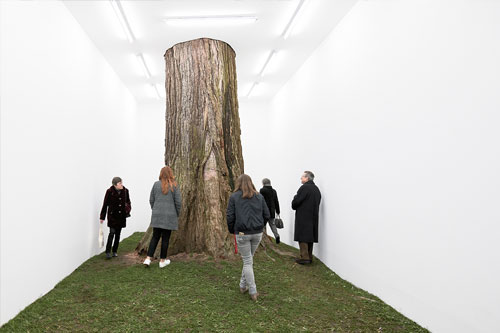
NOWs: Fabian Knecht – Werkstattpreisträger 2020
Isolation (Stamm), 2018. Installation in public space, Baden-Baden, Germany. Courtesy Fabian Knecht and alexander levy
Fabian Knecht – Werkstattpreisträger 2020
Kunststiftung Erich Hauser
Saline 36
78628 Rottweil
Ausstellungseröffnung am 26. September 2020, 19.00 Uhr
Seit 1997 wird der Werkstattpreis der Kunststiftung Erich Hauser an eine junge Bildhauerin/einen jungen Bildhauer vergeben. Inzwischen haben 25 Künstlerinnen und Künstler diese Auszeichnung erhalten. Der Preis bietet die Möglichkeit, mehrere Wochen in der Werkstatthalle zu arbeiten und die entstandenen Werke dort zu präsentieren. Es erscheint ein Katalog.
Fabian Knecht, geb. 1980 in Magdeburg, studierte an der Universität der Künste Berlin und am California Institute of Arts. 2012 arbeitete er im Studio von Matthew Barney in New York. 2014 war er Meisterschüler von Olafur Eliasson, an dessen Institut für Raumexperimente er von 2009 bis 2014 studierte.
In seinen auf einer konzeptuellen Herangehensweise beruhenden Skulpturen, Aktionen und Interventionen bezieht Fabian Knecht den öffentlichen Raum, das Alltagsleben wie auch den Naturkontext mit ein. Er verändert Wahrnehmungs- und Handlungsmuster, reflektiert Kunstbegriffe und Machtstrukturen und stellt soziale Verhältnisse und Normen durch Gegenbilder
infrage.
Fabian Knechts Werke wurden in nationalen und internationalen Institutionen und Ausstellungen unter anderem im MSU Museum für zeitgenössische Kunst, Zagreb, auf der Moscow International Biennale for Young Art, in der Neuen Nationalgalerie Berlin, im Hamburger Bahnhof, Berlin, im Imperial War Museum, London, und in der Staatlichen Kunsthalle Baden-Baden gezeigt.
Die Jury, bestehend aus Charlotte Mumm, Werkstattpreisträgerin von 2018, Dr. Claudia Emmert, Direktorin Zeppelinmuseum Friedrichshafen, und Roland Nachtigäller, Direktor Marta Herford gGmbH, haben einstimmig entschieden, den Werkstattpreis an Fabian Knecht zu vergeben. Die Jury hob hervor, dass sie Fabian Knecht für besonders geeignet hält, sich mit dem Kunst-, Arbeits- und Alltagskosmos des Bildhauers Erich Hauser auseinanderzusetzen und zu einer eigenständigen künstlerischen Positionierung zu kommen. Im Rahmen des diesjährigen Jubiläumsjahres – Erich Hauser wäre in diesem Jahr 90 Jahre alt geworden – wünscht sich die Kunststiftung einen Dialog des Preisträgers mit Erich Hauser. In seinen, auf einer konzeptuellen Herangehensweise beruhenden Skulpturen, Aktionen und Interventionen bezieht Fabian Knecht den öffentlichen Raum, das Alltagsleben wie auch den Naturkontext mit ein. Er verändert Wahrnehmungs- und Handlungsmuster, reflektiert Kunstbegriffe und Machtstrukturen, stellt soziale Verhältnisse und Normen durch starke Gegenbilder infrage.
Isolation (Stamm), 2018. Installation in public space, Baden-Baden, Germany. Courtesy Fabian Knecht and alexander levy
Fabian Knecht – Werkstattpreisträger 2020
Kunststiftung Erich Hauser
Saline 36
78628 Rottweil
Ausstellungseröffnung am 26. September 2020, 19.00 Uhr
Seit 1997 wird der Werkstattpreis der Kunststiftung Erich Hauser an eine junge Bildhauerin/einen jungen Bildhauer vergeben. Inzwischen haben 25 Künstlerinnen und Künstler diese Auszeichnung erhalten. Der Preis bietet die Möglichkeit, mehrere Wochen in der Werkstatthalle zu arbeiten und die entstandenen Werke dort zu präsentieren. Es erscheint ein Katalog.
Fabian Knecht, geb. 1980 in Magdeburg, studierte an der Universität der Künste Berlin und am California Institute of Arts. 2012 arbeitete er im Studio von Matthew Barney in New York. 2014 war er Meisterschüler von Olafur Eliasson, an dessen Institut für Raumexperimente er von 2009 bis 2014 studierte.
In seinen auf einer konzeptuellen Herangehensweise beruhenden Skulpturen, Aktionen und Interventionen bezieht Fabian Knecht den öffentlichen Raum, das Alltagsleben wie auch den Naturkontext mit ein. Er verändert Wahrnehmungs- und Handlungsmuster, reflektiert Kunstbegriffe und Machtstrukturen und stellt soziale Verhältnisse und Normen durch Gegenbilder
infrage.
Fabian Knechts Werke wurden in nationalen und internationalen Institutionen und Ausstellungen unter anderem im MSU Museum für zeitgenössische Kunst, Zagreb, auf der Moscow International Biennale for Young Art, in der Neuen Nationalgalerie Berlin, im Hamburger Bahnhof, Berlin, im Imperial War Museum, London, und in der Staatlichen Kunsthalle Baden-Baden gezeigt.
Die Jury, bestehend aus Charlotte Mumm, Werkstattpreisträgerin von 2018, Dr. Claudia Emmert, Direktorin Zeppelinmuseum Friedrichshafen, und Roland Nachtigäller, Direktor Marta Herford gGmbH, haben einstimmig entschieden, den Werkstattpreis an Fabian Knecht zu vergeben. Die Jury hob hervor, dass sie Fabian Knecht für besonders geeignet hält, sich mit dem Kunst-, Arbeits- und Alltagskosmos des Bildhauers Erich Hauser auseinanderzusetzen und zu einer eigenständigen künstlerischen Positionierung zu kommen. Im Rahmen des diesjährigen Jubiläumsjahres – Erich Hauser wäre in diesem Jahr 90 Jahre alt geworden – wünscht sich die Kunststiftung einen Dialog des Preisträgers mit Erich Hauser. In seinen, auf einer konzeptuellen Herangehensweise beruhenden Skulpturen, Aktionen und Interventionen bezieht Fabian Knecht den öffentlichen Raum, das Alltagsleben wie auch den Naturkontext mit ein. Er verändert Wahrnehmungs- und Handlungsmuster, reflektiert Kunstbegriffe und Machtstrukturen, stellt soziale Verhältnisse und Normen durch starke Gegenbilder infrage.
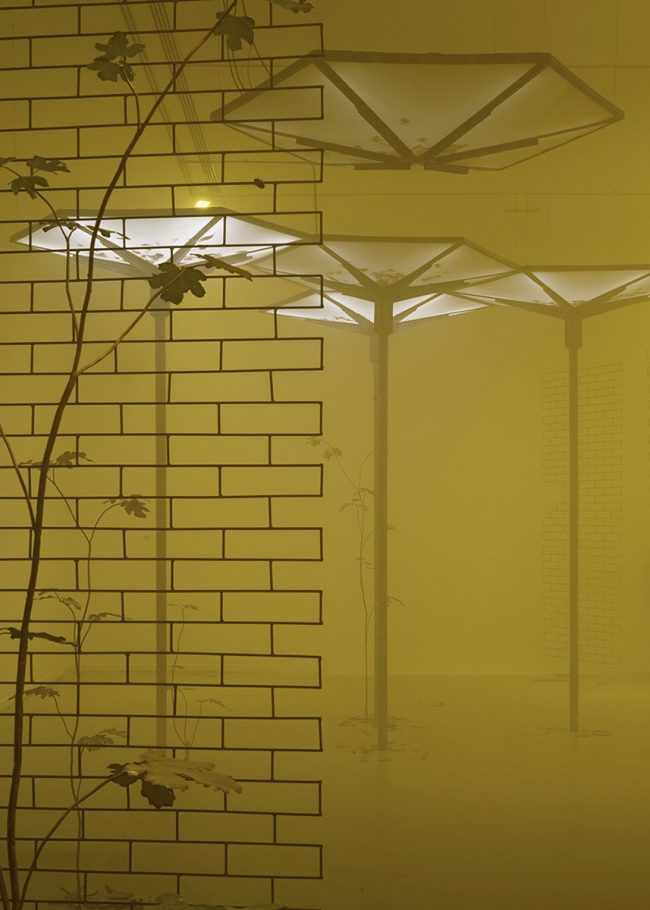
NOWs: El Despertar by Alvaro Urbano
NOWs: El Despertar solo exhibition by Alvaro Urbano
La Casa Encendida
Ronda de Valencia, 2
28012 Madrid
Reopening on the 1st of July 2020 until the 10 of January 2021
Like a strange dream that seems to go on forever, El Despertar (The Awakening) reanimates a building whose life appears to have expired long ago. Through an immersive installation comprised of fragments that make up the body of a building, a forgotten edifice is reactivated to provoke speculative thought about its past and future.
In this exhibition in one scene, artist Alvaro Urbano (Madrid, 1983) uses as a case study the celebrated Hexagon Pavilion, designed by architects José Antonio Corrales and Ramón Vázquez Molezún. The building, now languishing in a ruinous state in Madrid’s Casa de Campo park, was first presented as the Spanish Pavilion at the 1958 Brussels World’s Fair and is considered an important example of modern Spanish architecture. After years of abandonment, it is hard to believe what it once was and what it contained.
Here, where the architecture and vegetation seem to be frozen in time, where the building itself holds a pictorial and sonic landscape that speaks of the past experiences lived within its walls, and where a pair of raccoons intermittently dwells—an endless twilight bathes the space in color and brings it to life.
Like an unscripted film that captures daily existence, The Awakening constructs a parallel life for an exhausted building in order to revive seemingly dormant histories.
Curator: José Esparza Chong Cuy
Soundscape: Coeval and Alvaro Urbano
Photos: Trevor Lloyd
Read here an interview with Alvaro Urbano published in Umbigo magazine
download the exhibition publication by clicking on the image above
“Monja en el interior del Pabellón España Expo 1958. Bruselas” Image from Wikipedia
NOWs: El Despertar solo exhibition by Alvaro Urbano
La Casa Encendida
Ronda de Valencia, 2
28012 Madrid
Reopening on the 1st of July 2020 until the 10 of January 2021
Like a strange dream that seems to go on forever, El Despertar (The Awakening) reanimates a building whose life appears to have expired long ago. Through an immersive installation comprised of fragments that make up the body of a building, a forgotten edifice is reactivated to provoke speculative thought about its past and future.
In this exhibition in one scene, artist Alvaro Urbano (Madrid, 1983) uses as a case study the celebrated Hexagon Pavilion, designed by architects José Antonio Corrales and Ramón Vázquez Molezún. The building, now languishing in a ruinous state in Madrid’s Casa de Campo park, was first presented as the Spanish Pavilion at the 1958 Brussels World’s Fair and is considered an important example of modern Spanish architecture. After years of abandonment, it is hard to believe what it once was and what it contained.
Here, where the architecture and vegetation seem to be frozen in time, where the building itself holds a pictorial and sonic landscape that speaks of the past experiences lived within its walls, and where a pair of raccoons intermittently dwells—an endless twilight bathes the space in color and brings it to life.
Like an unscripted film that captures daily existence, The Awakening constructs a parallel life for an exhausted building in order to revive seemingly dormant histories.
Curator: José Esparza Chong Cuy
Soundscape: Coeval and Alvaro Urbano
Photos: Trevor Lloyd
Read here an interview with Alvaro Urbano published in Umbigo magazine
download the exhibition publication by clicking on the image above
“Monja en el interior del Pabellón España Expo 1958. Bruselas” Image from Wikipedia
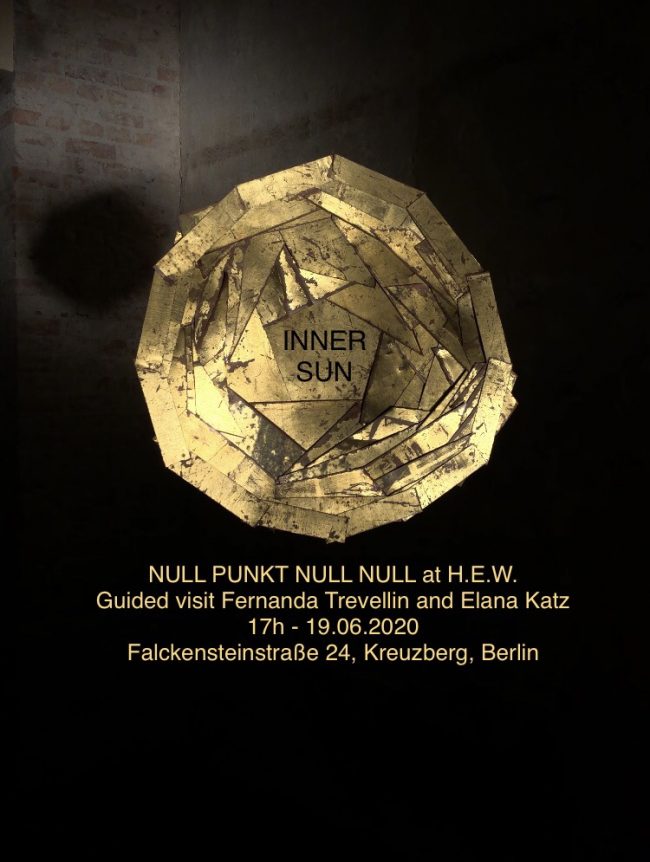
NOWs: Inner Sun by Fernanda Trevellin
Null Punkt Null Nullat H.E.W., Falckensteinstraße 24, Berlin
INNER SUN
Fernanda Trevellin
NULL PUNKT NULL NULL is a break.
and then,
to embrace what is potential,
what is already there.
to be delicate with the present.
recognise it.
and everything to start,
with pleasure,
again.
–
Null Punkt Null Nullat H.E.W., Falckensteinstraße 24, Berlin
INNER SUN
Fernanda Trevellin
NULL PUNKT NULL NULL is a break.
and then,
to embrace what is potential,
what is already there.
to be delicate with the present.
recognise it.
and everything to start,
with pleasure,
again.
–
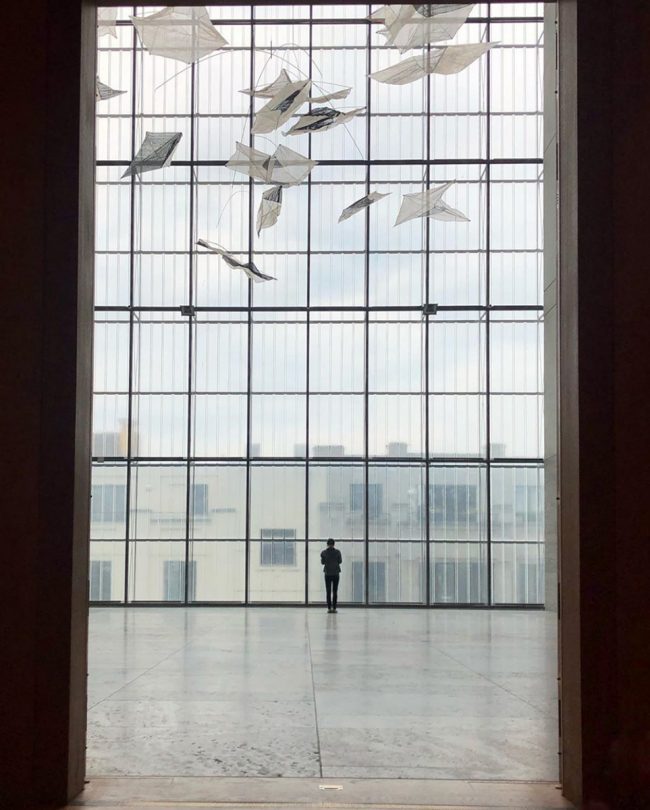
NOWS: Zero Waste at MdbK
Raul Walch: Laborant s Pause, 2018. Photo by the artist.
Zero WasteGroup exhibition at Museum der bildenden Künste Leipzig
Soft Opening: 24/06/2020, 18–21 h
–
Waste is everywhere: in the Great Pacific garbage patch, as fine particular matter in the air, or as microplastics in the food chain. The group exhibition Zero Waste showcases international positions in contemporary art that point out the urgency to save resources, consume less, and live more sustainably. In diverse installations, videos, sculptural works, and photographs the artists investigate the global consequences of plastic packaging, tire abrasion, toxic chemicals, and the overproduction of consumer goods. Zero Waste will be realized by the German Environment Agency in cooperation with the MdbK and curated by Hannah Beck-Mannagetta and Lena Fließbach.
Every day shreds from the horticultural greenhouses in southern Spain, also known as “El Mar de Plástico”, drift into the sea – Raul Walch uses these remnants as material for his expansive kinetic objects. For their video work the artist duo Irwan Ahmett & Tita Salina transferred a small fish from a polluted water in Jakarta to a crystal-clear river. Erik Sturm scrapes fine dust from window sills along heavily trafficked streets for producing paint, whereas Swaantje Güntzel’s photographs and objects illustrate the effects microplastics have in cosmetics and on marine creatures. In his laboratory Dani Ploeger experiments with manufacturers’ intentional obsolescence of electronic devices, and Eliana Heredia’s installation works with disposable products and cleaning agents.
The exhibition takes a critical look at the current condition of our planet but also aims to imagine possible solutions, encourage alternative scopes of action, and propose visions for the future. While questioning the lifestyle of the international jet set as well as the lavish use of materials in the art world, the project follows self-imposed climate-friendly rules in an attempt to make its own carbon footprint transparent and to compensate it.
Exhibiting artists: Irwan Ahmett & Tita Salina, Michel de Broin, Nadine Fecht, Vibha Galhotra, Tue Greenfort, Andreas Greiner, Swaantje Güntzel, Eliana Heredia, Bianca Kennedy & The Swan Collective, Wolf von Kries, Christoph Medicus, Klara Meinhardt, Alexander Oelofse, Kadija de Paula & Chico Togni, Dani Ploeger, Mika Rottenberg, Erik Sturm, Raul Walch
Raul Walch: Laborant s Pause, 2018. Photo by the artist.
Zero WasteGroup exhibition at Museum der bildenden Künste Leipzig
Soft Opening: 24/06/2020, 18–21 h
–
Waste is everywhere: in the Great Pacific garbage patch, as fine particular matter in the air, or as microplastics in the food chain. The group exhibition Zero Waste showcases international positions in contemporary art that point out the urgency to save resources, consume less, and live more sustainably. In diverse installations, videos, sculptural works, and photographs the artists investigate the global consequences of plastic packaging, tire abrasion, toxic chemicals, and the overproduction of consumer goods. Zero Waste will be realized by the German Environment Agency in cooperation with the MdbK and curated by Hannah Beck-Mannagetta and Lena Fließbach.
Every day shreds from the horticultural greenhouses in southern Spain, also known as “El Mar de Plástico”, drift into the sea – Raul Walch uses these remnants as material for his expansive kinetic objects. For their video work the artist duo Irwan Ahmett & Tita Salina transferred a small fish from a polluted water in Jakarta to a crystal-clear river. Erik Sturm scrapes fine dust from window sills along heavily trafficked streets for producing paint, whereas Swaantje Güntzel’s photographs and objects illustrate the effects microplastics have in cosmetics and on marine creatures. In his laboratory Dani Ploeger experiments with manufacturers’ intentional obsolescence of electronic devices, and Eliana Heredia’s installation works with disposable products and cleaning agents.
The exhibition takes a critical look at the current condition of our planet but also aims to imagine possible solutions, encourage alternative scopes of action, and propose visions for the future. While questioning the lifestyle of the international jet set as well as the lavish use of materials in the art world, the project follows self-imposed climate-friendly rules in an attempt to make its own carbon footprint transparent and to compensate it.
Exhibiting artists: Irwan Ahmett & Tita Salina, Michel de Broin, Nadine Fecht, Vibha Galhotra, Tue Greenfort, Andreas Greiner, Swaantje Güntzel, Eliana Heredia, Bianca Kennedy & The Swan Collective, Wolf von Kries, Christoph Medicus, Klara Meinhardt, Alexander Oelofse, Kadija de Paula & Chico Togni, Dani Ploeger, Mika Rottenberg, Erik Sturm, Raul Walch
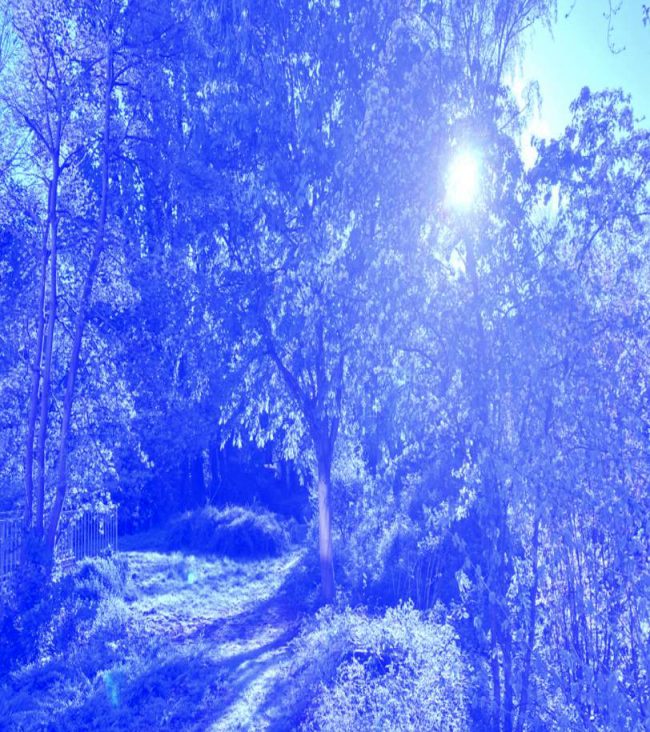
NOWs: Garten der Gegenwart
Garten der GegenwartSommerausstellung in Hamburg
Jeder neue Tag hat zwei Griffe.
Wir können ihn am Griff der Ängstlichkeit oder am Griff der Zuversicht halten.
(H. Beecher, 1813-1887)
–
Statt ihrem “Salon der Gegenwart” veranstalten Margarita und Christian Holle dieses Jahr Corona-bedingt den “Garten der Gegenwart”: Fast 30 Künstler zeigen in Harvestehude ihre Werke.
–
Die Adresse:
Garten der Gegenwart
Rothenbaumchaussee 145
20149 Hamburg
–
Künstler und Künstlerinnen:
Nevin Aladag, Christian Awe, Tjorg Douglas Beer, Matthias Bitzer, Jonas Burgert, Claudia Comte, Jose Dávila, Henrik Eiben, Jeppe Hein, Gregor Hildebrandt, Fabian Knecht, Lilia Kovka, Gerold Miller, Paul Morrison, Timo Nasseri, Anselm Reyle, Hoda Tawakol
–
Fabian Knecht: Bruch 3 (studio view), Bronze, 123 x 34 x 34 cm, 2019
Garten der GegenwartSommerausstellung in Hamburg
Jeder neue Tag hat zwei Griffe.
Wir können ihn am Griff der Ängstlichkeit oder am Griff der Zuversicht halten.
(H. Beecher, 1813-1887)
–
Statt ihrem “Salon der Gegenwart” veranstalten Margarita und Christian Holle dieses Jahr Corona-bedingt den “Garten der Gegenwart”: Fast 30 Künstler zeigen in Harvestehude ihre Werke.
–
Die Adresse:
Garten der Gegenwart
Rothenbaumchaussee 145
20149 Hamburg
–
Künstler und Künstlerinnen:
Nevin Aladag, Christian Awe, Tjorg Douglas Beer, Matthias Bitzer, Jonas Burgert, Claudia Comte, Jose Dávila, Henrik Eiben, Jeppe Hein, Gregor Hildebrandt, Fabian Knecht, Lilia Kovka, Gerold Miller, Paul Morrison, Timo Nasseri, Anselm Reyle, Hoda Tawakol
–
Fabian Knecht: Bruch 3 (studio view), Bronze, 123 x 34 x 34 cm, 2019
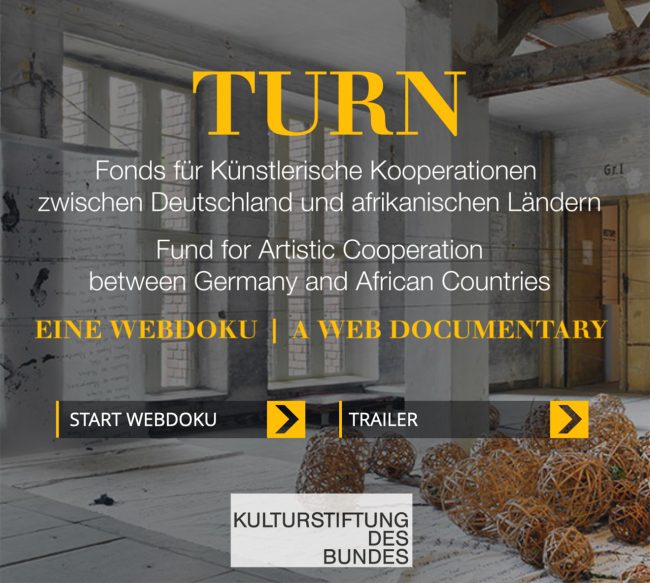
NOWs: Interactive web documentary on the TURN fund of the Federal Cultural Foundation
TURN – Fund for artistic collaborations between Germany and African countries launches an interactive web documentary on the TURN fund
For seven years the TURN Fund of the Federal Cultural Foundation has supported artistic cooperation between Germany and African countries – what experiences have the projects made? What kind of projects were supported? What challenges had to be overcome? Which themes recur again and again? How is the cultural creativity from African countries today in Germany? The interactive web documentary TURN presents exemplary projects supported by the TURN Fund and gives artists, curators, directors, dramaturgists, performers, musicians, and experts a chance to have their say. They talk about observations challenges and insights, but also about the wishes, perspectives and opportunities that the joint project work has opened up. Interactive links within the TURN film refer to further clips, links, materials, and background information.
In 2012, the Federal Cultural Foundation established the TURN – Fund for Artistic Cooperation between Germany and African Countries in order to encourage a wide range of German institutions to shift their focus on the artistic production and cultural debates in African countries. German cultural organisations in all artistic areas were called upon to engage in new forms of artistic collaboration with African partners. The programme offers incentives primarily to German institutions and artists (museums, theatres, dance companies, art associations, composers, writers, publishers, etc.) to enhance their profile with new themes, working methods and perspectives. A total of 101 projects and research measures has been funded through the TURN Fund from 2013 to 2020.
Please watch the documentary here.
The documentary portrays a small selection from funded projects and summarizes some of the central questions and results from this period. The Institut für Raumexperimente (Institute for Spatial Experiments) is grateful that our long-term collaboration with Tobiya Poetic Jazz and its joint Poetry Jazz initiative with the poetry series Poetry Jazz: Wax and Honey, I’m home has been one of those 101 projects.
TURN – Fonds für künstlerische Kooperationen zwischen Deutschland und afrikanischen Ländern stellt eine interaktive Webdoku zum Fonds TURN vor
Sieben Jahre lang hat die Kulturstiftung des Bundes mit dem Fonds TURN künstlerische Kooperationen zwischen Deutschland und afrikanischen Ländern gefördert – welche Erfahrungen haben die Projekte gemacht? Was für Projekte wurden im Fonds TURN gefördert? Welche Hürden mussten genommen werden? Welche Themen kehren immer wieder? Welchen Stellenwert hat die Auseinandersetzung mit dem kulturellen Schaffen in afrikanischen Ländern heute in Deutschland? Die interaktive Webdoku TURN stellt beispielhaft einzelne geförderte Projekte vor und lässt KünstlerInnen KuratorInnen RegisseurInnen DramaturgInnen PerformerInnen MusikerInnen und ExpertInnen zu Wort kommen. Sie erzählen von Beobachtungen Herausforderungen und Erkenntnissen aber auch von den Wünschen Perspektiven und Chancen die die gemeinsame Projektarbeit eröffnet hat. Interaktive Verlinkungen innerhalb des TURN-Films verweisen auf weiterführende Clips Links Materialien und Hintergrundinformationen.
Mit dem im Jahr 2012 initiierten Programm TURN – Fonds für künstlerische Kooperationen zwischen Deutschland und afrikanischen Ländern möchte die Kulturstiftung des Bundes möglichst viele unterschiedliche Institutionen in Deutschland anregen sich mit dem künstlerischen Schaffen und den kulturellen Debatten in afrikanischen Ländern zu beschäftigen. Deutsche Kultureinrichtungen aller Sparten wurden aufgefordert neue Formen der künstlerischen Zusammenarbeit mit afrikanischen Partnern zu erproben und gemeinsame Kulturprojekte auf den Weg zu bringen. Das Programm soll in erster Linie deutschen Institutionen und Akteuren (Museen, Theaterhäusern, Tanzkompanien, Kunstvereinen, Komponisten, Schriftstellern, Verlagen u.a.) Anreize bieten ihr Profil um neue Themen und Arbeitsweisen zu erweitern. Insgesamt 101 Projekte haben in den Jahren 2013 bis 2020 im Fonds TURN eine Förderung erhalten.
Sehen Sie die Webdoku hier.
Die Doku porträtiert eine kleine Auswahl der geförderten Projekte und fasst einige der zentralen Fragen und Ergebnisse aus dieser Zeit zusammen. Das Institut für Raumexperimente ist dankbar, dass die langfristige Kooperation mit Tobiya Poetic Jazz und die gemeinsame Poetry Jazz Initiative, mit der Veranstaltungsserie Poetry Jazz: Wax and Honey, I’m home zu einem der 101 Projekt zählt.
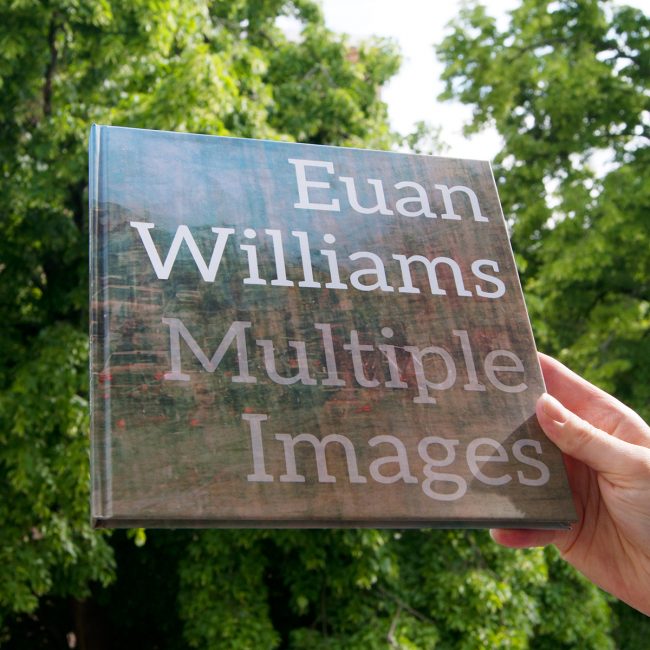
NOWs: Multiple Images by Euan Williams
Euan Williams: Multiple ImagesCatalogue with text by Lena Fließbach
The catalogue Multiple Images encapsulates the variety and development of Euan Williams’s 10 year photographic series Collapse. Rebuilding analogue cameras so that they expose images on the same part of the negative – Williams condenses walked journeys through urban and natural landscapes into a single image. A flattening of time and space. With an accompanying text by Lena Fließbach, the clinical and repetitive methodology is explored alongside the process’s painterly and impressionistic results. Multiple Images is a thorough survey of the entire Collapse series to date.
–
Euan Williams: Multiple ImagesCatalogue with text by Lena Fließbach
The catalogue Multiple Images encapsulates the variety and development of Euan Williams’s 10 year photographic series Collapse. Rebuilding analogue cameras so that they expose images on the same part of the negative – Williams condenses walked journeys through urban and natural landscapes into a single image. A flattening of time and space. With an accompanying text by Lena Fließbach, the clinical and repetitive methodology is explored alongside the process’s painterly and impressionistic results. Multiple Images is a thorough survey of the entire Collapse series to date.
–
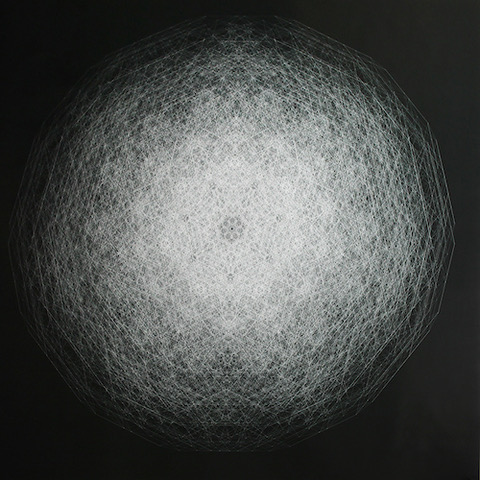
NOWs: Your country of two dimensions is not spacious enough. Limits of Perception Lab. By Ivana Franke
Ivana Franke. Planetary Nebula, World t012345_A6_0, 2019. Photo Martina Mihaljevic
Your country of two dimensions is not spacious enough. Limits of Perception Lab by Ivana Franke
at
SAAVY Contemporary, Berlin
Entrance; Plantagenstraße 31
–
OPEN LAB, EXHIBITION, EXPERIMENTS
18.06.–28.06.2020
Tuesday–Sunday
14:00–19:00
Open to the public (max of 15 people in the gallery at same time), visitors wanting to participate in the experiments should register HERE
ONLINE INVOCATIONS
21.06.2020
18:00–20:00
WITH Jarita Holbrook, Taita Juan Martín Jamioy Juajibio, Juan-Andres Leon, Sangeetha Menon, Ida Momennejad, Monica Narula, Lisa Randall, Tomas Saraceno, Sunčica Ostojić
SATELLITE EVENT: DREAMSCAPE #1
18.06.–28.06.2020
WITH Israel Lopez
In the Limits Lab in Berlin-Moabit – Open to the public by appointment HERE
…your country of Two Dimensions is not spacious enough to represent me, a being of Three, but can only exhibit a slice or section of me, which is what you call a Circle. – Edwin Abbott Abbott.1884. Flatland: A Romance of Many Dimensions
For one week, SAVVY Contemporary transforms itself into the LIMITS OF PERCEPTION LAB, a hybrid of an artist studio and a scientific laboratory, using multidisciplinary methodologies to study experience and as a means of knowledge disruption and production. [2] It is grounded in artistic practice within an extended context, drawing from and working with practitioners from the fields of cognitive and vision science, neuroscience, experimental psychology, mathematics, and architecture while being in conversation with critical practitioners from the fields of humanities, including but not limited to art history, history of science, and philosophy.
The project serves an experimental phase of a long-term platform for investigation of perceptual limits as potential sites of social transformation. This materialization of the open lab at SAVVY Contemporary focuses on perception and imaginations of extra dimensions.
The SAVVY Contemporary iteration of LIMITS OF PERCEPTION LAB concerns itself with limits of perception and epistemological categories, including Western definitions and how they shape the ways in which we are taught to think, feel, and rationalise our sensing of ourselves and the world. Ivana Franke’s work probes possibilities of approaching consciousness in “a multidimensional way,” [3] seeking means of affirming our imaginations beyond already known categories and habituated ways of perceiving – going beyond what Harvard physicist Lisa Randall calls the “pervasive but quite possibly mistaken assumption that we live in a three-dimensional world.” The weeklong exhibition and laboratory installed at SAVVY Contemporary materialises as a zone to provide experience in which to question the habitual ways of seeing and knowing in three-dimensional environments.
Visitors are invited to navigate the gallery space transformed into an open studio, and to engage with spaces of darkness, epiphanies of lights, visual quandaries and thought experiments. In addition to the public experiments, a discursive programme and a radio broadcast will address Western scientific assumptions about consciousness and the limits of perception. The project connects to and draws upon SAVVY Contemporary’s programme THE INVENTION OF SCIENCE and its long-term explorations and challenges of the frailties and fallacies of objective scientific knowledge.
The laboratory problematises the potential of “epistemological ruptures” that break with “normal science” [4] and evokes experiences to challenge existing common modes of knowledge-production, to question the “hegemonic assertions of Enlightenment ideals of the liberal white male subject,” [5] to crack open preconceived ideas of reality, and to lend it other dimensions that are decidedly fictitious, imaginary, and cosmic.
We concern ourselves with a set of questions: What is an experience and what conditions it? How does the meaning from the experience itself? How does cultural embeddedness influence perception and cognition of experience?
Every single view from within speaks the truth about its own reality. It is irreplaceable, so invaluable, and equally valid as all others are. Experiencer’s experience holds the power to subjective truth. Disrupting the Cartesian tradition of placing mind over matter, and interrupting the idea of the “liberal subject, represented as having a body, but not being a body,” as Alexander G. Weheliye states, the experiments also grapple with redrafting the hegemonic Western version of personhood, and engage with “inscriptions of humanity” … “that always incorporate their own multiplicities, as opposed to mere uncritical echoes of the white liberal humanist subject.” [6]
This project engages with scientists alongside indigenous, non-Western and non-positivist modes of investigating human consciousness. It reflects on lived experiences, which combine first and third-person perspectives, while suggesting new ways of sharing them. This opens possibilities for producing and disseminating knowledge in an unterritorialized, non-hierarchical, multidimensional, and more-than-human future planetary imagination.
–
OPEN LAB
Visitors are invited into an archive of scientific papers, literary pieces, filled questionnaires, sketched analysis of data, drawings and dreamscapes shared by subjects experiencing the exhibition. An exercise to probe the limits of our perception and imagination follow.
INSTALLATIONS BY Ivana Franke
Within the installation We close our eyes and see a flock of birds: we sit in the middle of a cylindrical room and are invited to close our eyes. We are exposed to a flickering light which gives rise to a quasi-hallucinatory visual experience of moving images behind our closed eyes. A shimmering of colours, patterns, shapes, or figures in motion happen in our heads, making us see a stream of images: birds flying, people passing by, circles and spirals swirling and whatever else one can imagine. Each person “constructs” their very own “movie”, a possible reminiscence of something long forgotten or closeby.
We are also asked to enter From The Faraway Past and From The Future: we perceive a dark space where the only thing visible are thin curved lines floating in the air, at eye level. Slowly, circular shapes start to emerge, flowing in different directions. Decontextualized specular highlights move according to the viewer’s individual movements; the unknown “object” starts to overlap, merge, shrink, expand, appear and disappear, bustling in unexpected directions, changing its shape, size and position. These curious constitutions seem to extend deep into the space, only to come back towards us in rolling motion. Our brains cannot measure what they perceive, we can only guess, speculate, imagine and try to find the coordinates.
EXPERIMENTS
After being exposed to flickering light in the first installation, participants are asked to fill a version of 5D-ASC, 5-Dimensional Altered State of Consciousness: a questionnaire to explore measures of subjective qualities of non-ordinary waking states. Following the experience of darkness in the second installation, participants are handed questionnaires inquiring about their perceptual experiences and cognitive processes – with focus on experience of spatial dimensions and interpretation of spatial concepts.
ONLINE INVOCATIONS 21.06.2020 14:00–20:00
WITH Jarita Holbrook, Taita Juan Martín Jamioy Juajibio, Juan-Andres Leon, Sangeetha Menon, Ida Momennejad, Monica Narula, Lisa Randall, Tomas Saraceno, Sunčica Ostojić, and others
A number of thinkers will examine the concept of multidimensionality within their respective disciplines and reflect on its significance as a transformative force for production and dissemination of knowledge in unterritorialized, non-hierarchical, multidimensional future world.
SATELLITE EVENT: DREAMSCAPE #1 18.06.–28.06.2020
WITH Israel Lopez
Dreamscape #1 is an installation that aims to stage a dream. The installation works based on sensory manipulation, by which a flat is staged as a place to tune down, isolate, and calibrate the sensory system in preparation for the sleepstate. Dreamscape #1 is a composition for closed eyes, is an offer of self space and an attempt to modulate the ways in which we create spatial relations.
The flat will be open for several visitors every day after a previous appointment, each occupying the flat alone.
CURATOR Elena Agudio
CO-CURATOR Kelly Krugman
ARTISTIC DIRECTION Bonaventure Soh Bejeng Ndikung
PRODUCTION Kimani Joseph
MANAGEMENT Lema Sikod
COMMUNICATIONS Anna Jäger
LIVE-STREAM Boiling Head Media
LAB COLLABORATORS Israel Lopez, Dora Sribar
THANKS to Elena Agudio, Bilge Sayim, Ida Momennejad, Heike Catherina Mertens, Katja Naie, Hannah Hurzig, Tomas Saraceno, Natalija Miodragović, Philipp Dreyer, Olafur Eliasson, Mathias Sohr, Sunčica Ostojić, Martina Kramer, Pierre Gallais, Etienne Ghys, Oliviere Varenne, Sandra Aračić, Tanja Cvetko, Elena Chronopolou, Frank Spenling, Stephan Spenling, Johann Klaphake, Israel Lopez, Alexandre Mballa Ekobena, Dora Šribar, Vedran Franke.
SUPPORT The project is supported by the Ministry of Culture of Republic of Croatia, part of the program Croatian presidency of the Council of the European Union
–
1 “When we widen our horizon to include transformative approaches to experience, especially those concerned not with escape from the world or the discovery of some hidden, true self but with releasing the everyday world from the clutches of the grasping mind and its desire for an absolute ground, we gain a sense of perspective on the world that might be brought forth by learning to embody groundlessness as compassion in a scientific culture.” Varela, Francisco J., et al. 2016. The Embodied Mind: Cognitive Science and Human Experience. The MIT Press.
2 Artworks or artist-devised tools are employed to create settings for conducting experiments and developing questionnaires in collaboration with cognitive scientists for subjective reports – including verbal and visual descriptions, and quantitative measures. One of the experiments at SAVVY Contemporary employs flickering light and standardised 5D-ASC rating scale.
3 Tim Bayne and Olivia Carter. 2018. “Dimensions of Consciousness and the Psychedelic State.” in: Neuroscience of Consciousness.
4 Thomas S. Kuhn and Ian Hacking. 2012. The Structure of Scientific Revolution. University Of Chicago Press.
5 Ibid 7.
6 Alexander G. Weheliye, 2002. “‘Feenin’: Posthuman Voices in Contemporary Black Popular Music“ in Social Text, 71 (Volume 20, Number 2), Summer 2002, 21-47, Duke University Press.
Ivana Franke. Planetary Nebula, World t012345_A6_0, 2019. Photo Martina Mihaljevic
Your country of two dimensions is not spacious enough. Limits of Perception Lab by Ivana Franke
at
SAAVY Contemporary, Berlin
Entrance; Plantagenstraße 31
–
OPEN LAB, EXHIBITION, EXPERIMENTS
18.06.–28.06.2020
Tuesday–Sunday
14:00–19:00
Open to the public (max of 15 people in the gallery at same time), visitors wanting to participate in the experiments should register HERE
ONLINE INVOCATIONS
21.06.2020
18:00–20:00
WITH Jarita Holbrook, Taita Juan Martín Jamioy Juajibio, Juan-Andres Leon, Sangeetha Menon, Ida Momennejad, Monica Narula, Lisa Randall, Tomas Saraceno, Sunčica Ostojić
SATELLITE EVENT: DREAMSCAPE #1
18.06.–28.06.2020
WITH Israel Lopez
In the Limits Lab in Berlin-Moabit – Open to the public by appointment HERE
…your country of Two Dimensions is not spacious enough to represent me, a being of Three, but can only exhibit a slice or section of me, which is what you call a Circle. – Edwin Abbott Abbott.1884. Flatland: A Romance of Many Dimensions
For one week, SAVVY Contemporary transforms itself into the LIMITS OF PERCEPTION LAB, a hybrid of an artist studio and a scientific laboratory, using multidisciplinary methodologies to study experience and as a means of knowledge disruption and production. [2] It is grounded in artistic practice within an extended context, drawing from and working with practitioners from the fields of cognitive and vision science, neuroscience, experimental psychology, mathematics, and architecture while being in conversation with critical practitioners from the fields of humanities, including but not limited to art history, history of science, and philosophy.
The project serves an experimental phase of a long-term platform for investigation of perceptual limits as potential sites of social transformation. This materialization of the open lab at SAVVY Contemporary focuses on perception and imaginations of extra dimensions.
The SAVVY Contemporary iteration of LIMITS OF PERCEPTION LAB concerns itself with limits of perception and epistemological categories, including Western definitions and how they shape the ways in which we are taught to think, feel, and rationalise our sensing of ourselves and the world. Ivana Franke’s work probes possibilities of approaching consciousness in “a multidimensional way,” [3] seeking means of affirming our imaginations beyond already known categories and habituated ways of perceiving – going beyond what Harvard physicist Lisa Randall calls the “pervasive but quite possibly mistaken assumption that we live in a three-dimensional world.” The weeklong exhibition and laboratory installed at SAVVY Contemporary materialises as a zone to provide experience in which to question the habitual ways of seeing and knowing in three-dimensional environments.
Visitors are invited to navigate the gallery space transformed into an open studio, and to engage with spaces of darkness, epiphanies of lights, visual quandaries and thought experiments. In addition to the public experiments, a discursive programme and a radio broadcast will address Western scientific assumptions about consciousness and the limits of perception. The project connects to and draws upon SAVVY Contemporary’s programme THE INVENTION OF SCIENCE and its long-term explorations and challenges of the frailties and fallacies of objective scientific knowledge.
The laboratory problematises the potential of “epistemological ruptures” that break with “normal science” [4] and evokes experiences to challenge existing common modes of knowledge-production, to question the “hegemonic assertions of Enlightenment ideals of the liberal white male subject,” [5] to crack open preconceived ideas of reality, and to lend it other dimensions that are decidedly fictitious, imaginary, and cosmic.
We concern ourselves with a set of questions: What is an experience and what conditions it? How does the meaning from the experience itself? How does cultural embeddedness influence perception and cognition of experience?
Every single view from within speaks the truth about its own reality. It is irreplaceable, so invaluable, and equally valid as all others are. Experiencer’s experience holds the power to subjective truth. Disrupting the Cartesian tradition of placing mind over matter, and interrupting the idea of the “liberal subject, represented as having a body, but not being a body,” as Alexander G. Weheliye states, the experiments also grapple with redrafting the hegemonic Western version of personhood, and engage with “inscriptions of humanity” … “that always incorporate their own multiplicities, as opposed to mere uncritical echoes of the white liberal humanist subject.” [6]
This project engages with scientists alongside indigenous, non-Western and non-positivist modes of investigating human consciousness. It reflects on lived experiences, which combine first and third-person perspectives, while suggesting new ways of sharing them. This opens possibilities for producing and disseminating knowledge in an unterritorialized, non-hierarchical, multidimensional, and more-than-human future planetary imagination.
–
OPEN LAB
Visitors are invited into an archive of scientific papers, literary pieces, filled questionnaires, sketched analysis of data, drawings and dreamscapes shared by subjects experiencing the exhibition. An exercise to probe the limits of our perception and imagination follow.
INSTALLATIONS BY Ivana Franke
Within the installation We close our eyes and see a flock of birds: we sit in the middle of a cylindrical room and are invited to close our eyes. We are exposed to a flickering light which gives rise to a quasi-hallucinatory visual experience of moving images behind our closed eyes. A shimmering of colours, patterns, shapes, or figures in motion happen in our heads, making us see a stream of images: birds flying, people passing by, circles and spirals swirling and whatever else one can imagine. Each person “constructs” their very own “movie”, a possible reminiscence of something long forgotten or closeby.
We are also asked to enter From The Faraway Past and From The Future: we perceive a dark space where the only thing visible are thin curved lines floating in the air, at eye level. Slowly, circular shapes start to emerge, flowing in different directions. Decontextualized specular highlights move according to the viewer’s individual movements; the unknown “object” starts to overlap, merge, shrink, expand, appear and disappear, bustling in unexpected directions, changing its shape, size and position. These curious constitutions seem to extend deep into the space, only to come back towards us in rolling motion. Our brains cannot measure what they perceive, we can only guess, speculate, imagine and try to find the coordinates.
EXPERIMENTS
After being exposed to flickering light in the first installation, participants are asked to fill a version of 5D-ASC, 5-Dimensional Altered State of Consciousness: a questionnaire to explore measures of subjective qualities of non-ordinary waking states. Following the experience of darkness in the second installation, participants are handed questionnaires inquiring about their perceptual experiences and cognitive processes – with focus on experience of spatial dimensions and interpretation of spatial concepts.
ONLINE INVOCATIONS 21.06.2020 14:00–20:00
WITH Jarita Holbrook, Taita Juan Martín Jamioy Juajibio, Juan-Andres Leon, Sangeetha Menon, Ida Momennejad, Monica Narula, Lisa Randall, Tomas Saraceno, Sunčica Ostojić, and others
A number of thinkers will examine the concept of multidimensionality within their respective disciplines and reflect on its significance as a transformative force for production and dissemination of knowledge in unterritorialized, non-hierarchical, multidimensional future world.
SATELLITE EVENT: DREAMSCAPE #1 18.06.–28.06.2020
WITH Israel Lopez
Dreamscape #1 is an installation that aims to stage a dream. The installation works based on sensory manipulation, by which a flat is staged as a place to tune down, isolate, and calibrate the sensory system in preparation for the sleepstate. Dreamscape #1 is a composition for closed eyes, is an offer of self space and an attempt to modulate the ways in which we create spatial relations.
The flat will be open for several visitors every day after a previous appointment, each occupying the flat alone.
CURATOR Elena Agudio
CO-CURATOR Kelly Krugman
ARTISTIC DIRECTION Bonaventure Soh Bejeng Ndikung
PRODUCTION Kimani Joseph
MANAGEMENT Lema Sikod
COMMUNICATIONS Anna Jäger
LIVE-STREAM Boiling Head Media
LAB COLLABORATORS Israel Lopez, Dora Sribar
THANKS to Elena Agudio, Bilge Sayim, Ida Momennejad, Heike Catherina Mertens, Katja Naie, Hannah Hurzig, Tomas Saraceno, Natalija Miodragović, Philipp Dreyer, Olafur Eliasson, Mathias Sohr, Sunčica Ostojić, Martina Kramer, Pierre Gallais, Etienne Ghys, Oliviere Varenne, Sandra Aračić, Tanja Cvetko, Elena Chronopolou, Frank Spenling, Stephan Spenling, Johann Klaphake, Israel Lopez, Alexandre Mballa Ekobena, Dora Šribar, Vedran Franke.
SUPPORT The project is supported by the Ministry of Culture of Republic of Croatia, part of the program Croatian presidency of the Council of the European Union
–
1 “When we widen our horizon to include transformative approaches to experience, especially those concerned not with escape from the world or the discovery of some hidden, true self but with releasing the everyday world from the clutches of the grasping mind and its desire for an absolute ground, we gain a sense of perspective on the world that might be brought forth by learning to embody groundlessness as compassion in a scientific culture.” Varela, Francisco J., et al. 2016. The Embodied Mind: Cognitive Science and Human Experience. The MIT Press.
2 Artworks or artist-devised tools are employed to create settings for conducting experiments and developing questionnaires in collaboration with cognitive scientists for subjective reports – including verbal and visual descriptions, and quantitative measures. One of the experiments at SAVVY Contemporary employs flickering light and standardised 5D-ASC rating scale.
3 Tim Bayne and Olivia Carter. 2018. “Dimensions of Consciousness and the Psychedelic State.” in: Neuroscience of Consciousness.
4 Thomas S. Kuhn and Ian Hacking. 2012. The Structure of Scientific Revolution. University Of Chicago Press.
5 Ibid 7.
6 Alexander G. Weheliye, 2002. “‘Feenin’: Posthuman Voices in Contemporary Black Popular Music“ in Social Text, 71 (Volume 20, Number 2), Summer 2002, 21-47, Duke University Press.

NOWs: ONLY by Jonas Wendelin
ONLYsolo exhibition by Jonas Wendelin
Dittrich & Schlechtriem
Linienstrasse 23
10178 Berlin
DITTRICH & SCHLECHTRIEM is pleased to present the first solo exhibition with JONAS WENDELIN (b. Düsseldorf, DE, 1985) in our gallery, titled ONLY, on view from Monday, 15 June, through Saturday, 29 August, 2020.
The exhibition was originally scheduled to open as part of Gallery Weekend Berlin 2020. Due to the lockdown in Los Angeles, the artist could not travel to Europe and the works could not be shipped to Berlin. The show was substantially conceived in 2019.
For his first solo show ONLY at the gallery, Wendelin deconstructs the actual and symbolic context of the gallery, exposing its methodologies through a fictive architectural installation and aligning strands of his thinking into a narrative spanning from conceptual found objects to the visceral physicality of his ceramics practice. ONLY engages the public in an alternative reality, pursuing an organic futuristic narrative of idealism and leaving the viewer with hope in dystopia.
An ecology held together by stories needs people to hear them and retell them. But how do these tales disintegrate without an audience? And without civilization to know the difference between natural matter and cultural objects, how might these things take on or leave behind lives of their own? Wendelin’s question is: “When we leave or vanish, how will the dust settle? If we return, what new traces will be found?”
He stages these questions in the form of a scene. The exhibition is set in a gallery concealed by broadsheets posted over its windows. These are pages of a publication commissioned and edited by the artist called THE ALLUSION, whose contributors have offered “fictions on fiction” that dissect conceits of the show while also propagating them.THE ALLUSION is produced in collaboration with multiple artists, architects, writers, and journalists and describes an entry to this illusion of abandonment. Through the juxtaposed, overlapping, and contradicting contributions, it aims to limn perspectives examining these tools of contemporary fiction. The involvement of different voices raises the question of individual agency and opens gateways toward shaping a shared evaluation of objects and belief systems.
The inside of the exhibition suggests the aftermath of some progress-halting event. Wandering among empty workstations through the stripped gallery, one can see that files and business machines have been replaced with jars of preserved foods predating the internet. Some are from the Chernobyl era, artifacts of times shaped by disaster, and in response, by the physical limitations of bodies and of resources like these. Wendelin presents them here as readymades and as bunker decor, items that might be found in a place where survivors subsist waiting for history to restart its engine.
Dozens of organic, aqueous forms are littered around the galleries themselves. These are ceramic artworks made by Wendelin titled ONLY ONE, TWO, THREE … counting upwards in numeric evolution. Despite their raw contours and appearance of natural proliferation throughout the space, these are hand-pinched and deliberately placed sculptures. Here as thousands of years ago, they are the product of ritualistic methods, the practice of which could be thought to hold some part of the time concentrated within their making. Their abyssal lusters are the result of a chemical-induced glazing technique called raku. To achieve these, the sculptures are removed from the kiln at their peak temperature of more than 1800 degrees and placed in metal containers full of paper that combusts upon contact. The resulting carbon compounds extract otherworldly colors from the suffocated glazes. Charred remnants of paper appear in traces around the sculptures. In their virgin form they are pages from the publication pasted in the gallery windows, which have also been placed in geometric stacks throughout the exhibition to be taken.
Additionally, stored up in shelves, are customized preserves from the last decades dating back to 1945, pre-internet or -Chernobyl. These objects assemble a sentiment or timeline of technology in the early stages of our kind, to the enhancements leading up to our way of life today, with generational differences widening more than ever as it accelerates. The shift in consumption laid the foundations for our technological revolutions, elevated our consciousness to experimentation, and refocused our attention to develop increasingly complex social structures. These objects are reminders of a world prior to our human-centric sphere.
The above contains excerpts from the press text of Kevin McGarry, published in THE ALLUSION.
Jonas Wendelin currently works between Los Angeles and Berlin. His work includes performance, sculpture, installation, studies in traditional ceramics, as well as the facilitation of cultural spaces, initiating, cultivating, and directing a social vision that queries cultural abetments. Wendelin is a co- founder and director of FRAGILE, a multi-disciplinary nonprofit project for contemporary artistic practices located in Berlin. FRAGILE encompasses an exhibition and a residency space, and fosters a program of conversation, antagonism, renegotiation, and celebration. He is also a co- founder of NAVEL, a community-driven nonprofit residency, learning platform, and self-defined test site for collectivity and creative practices in downtown Los Angeles. Wendelin graduated as Hito Steyerl’s Meisterschüler from the Berlin University of the Arts and was a participant at Olafur Eliasson’s Institut für Raumexperimente (Institute for Spatial Experiments). Wendelin was an artist in residence at the American Museum Of Ceramics Art, AMOCA in Pomona, California. His work has been shown at Hamburger Bahnhof— Museum für Gegenwart, Berlin; KW Institute for Contemporary Art, Berlin; MoMA PS1, New York; Neue Nationalgalerie, Berlin; The Storefront for Art and Architecture, New York; and NAVEL, Los Angeles.
For further information on the artist and the works or to request images, please contact Nils Petersen, nils(at)dittrich-schlechtriem.com.
ONLYEinzelausstellung von Jonas Wendelin
DITTRICH & SCHLECHTRIEM freuen sich, die erste Einzelausstellung von JONAS WENDELIN (geb. Düsseldorf, DE, 1985) in unserer Galerie zu präsentieren. Die Schau mit dem Titel ONLY wird ab Montag, dem 15. Juni bis zum 29. August zu besichtigen sein.
Die Ausstellung sollte ursprünglich im Rahmen des Gallery Weekend Berlin 2020 eröffnen. Aufgrund des Lockdowns in Los Angeles konnte sowohl der Künstler als auch seine Werke nicht nach Europa reisen. Die inhaltliche Auseinandersetzung der Ausstellung wurde schon im Jahr 2019 konzipiert.
Für seine Ausstellung ONLY dekonstruiert Wendelin den tatsächlichen und symbolischen Kontext der Galerie, legt deren Methodik durch eine fiktive Architekturinstallation offen und verflicht verschiedene Stränge seines Denkens zu einer Erzählung, die von konzeptuellen gefundenen Objekten bis zur handfesten Körperlichkeit seiner Keramikpraxis reicht. Die Ausstellung ONLY bezieht die Besucher in eine alternative architektonische Realität ein, verfolgt eine organische futuristische Erzählung des Idealismus und lässt den Betrachter mit Hoffnung in der Dystopie zurück.
Ein von Geschichten zusammengehaltenes Ökosystem braucht Menschen, die sie hören und nacherzählen. Wie aber vollzieht sich die Auflösung dieser Geschichten, wenn es kein Publikum für sie gibt? Und wenn keine Zivilisation mehr den Unterschied zwischen Naturstoff und Kulturgegenstand kennt, wie könnte das Eigenleben aussehen, das diese Dinge dann womöglich annähmen oder hinterließen? Wendelin formuliert es so: „Wenn wir weggehen oder verschwinden, wie wird der Staub sich legen? Wenn wir zurückkehren, welche neuen Spuren werden wir vorfinden?“
Diese Fragen setzt er in der Ausstellung in Szene. Die Fenster der Galerie sind mit großformatigen bedruckten Seiten zugehängt, die aus einer vom Künstler herausgegebenen Publikation mit dem Titel THE ALLUSION stammen. Die Autoren, die er dafür einlud, steuerten „Fiktionen über Fiktion“ bei, die die Ideen hinter der Schau auseinandernehmen, aber auch weitertragen.
THE ALLUSION ist in Zusammenarbeit mit mehreren Künstlern, Architekten, Schriftstellern und Journalisten entstanden und beschreibt einen Einstieg in jene Illusion der Verlassenheit. Durch die nebeneinanderstehenden, sich überschneidenden und einander widersprechenden Beiträge sollen Perspektiven einer Auseinandersetzung mit diesen Werkzeugen der zeitgenössischen Fiktion entworfen werden. Die Einbeziehung verschiedener Stimmen wirft die Frage nach der individuellen Handlungsmacht auf und öffnet Wege zur Gestaltung einer gemeinsamen Bewertung von Objekten und Glaubenssystemen.
Die Szene im Inneren der Galerie wirkt, als habe ein unerwartetes Ereignis den Betrieb zum Erliegen gebracht. Die Arbeitsplätze sind verwaist, die Räumlichkeiten weitgehend leer; statt Aktenschränken und Bürogeräten finden sich Nahrungsmittel in Einmachgläsern, die älter sind als das Internet – manche stammen aus der Zeit von Tschernobyl, Artefakte, in die sich die Katastrophe und die Grenzen von Körpern und Ressourcen wie diesen in der Reaktion auf sie eingeschrieben haben. Wendelin zeigt sie hier als Readymades und Bunkerausstattung, wie sie an einem Ort zu finden sein mögen, wo Überlebende ausharren, bis das Räderwerk der Geschichte sich wieder in Bewegung setzt.
Dutzende wässrig-organischer Gestalten sind über die Räume der Galerie verteilt: Keramiken von Wendelin mit den Titeln ONLY ONE, TWO, THREE … und so weiter in numerischer Reihung. Trotz ihrer rohen Konturen und dem Anschein einer Art natürlichen Ausbreitung im Raum handelt es sich um von Hand in Form gepresste und sorgfältig angeordnete Skulpturen. Hier wie vor tausenden Jahren sind sie Früchte ritueller Verfahren, in deren Ausübung man sich etwas von der Zeit, die in ihrer Herstellung verdichtet wurde, aufgespeichert denken mag. Ihr abgründiges Schimmern verdanken sie einer durch chemische Zugaben herbeigeführten Glasurtechnik namens Raku. Dazu werden die Skulpturen dem auf eine Maximaltemperatur von über 1800 Grad erhitzten Brennofen entnommen und in Metallbehälter gelegt, die mit Papier gefüllt sind, das bei der Berührung in Flammen aufgeht. Die entstehenden Kohlenstoffverbindungen entlocken den erstickten Glasuren überirdische Farben. Spuren von verkohlten Papierschnipseln sind um die Skulpturen herum zu erkennen. In unversehrter Form waren es Seiten aus der Publikation auf den Galeriefenstern; weitere Exemplare liegen in der Ausstellung in geometrischen Stapeln zum Mitnehmen aus.
In Regalen aufgestellte scheinbar aufbewahrte individuell gestaltete Artefakte aus den letzten Jahrzehnten zurück bis 1945, aus der Zeit vor dem Internet und Tschernobyl, bieten einen Eindruck oder eine Zeitleiste der Technologie in den frühen Stadien unserer Art bis hin zu den Neuentwicklungen, die zu unserer heutigen Lebensweise führen, wobei die Generationsunterschiede mehr denn je zunehmen, je schneller sie fortschreitet. Der Wandel des Konsums hat die Grundlagen für unsere technologischen Revolutionen gelegt, unser Bewusstsein auf die Stufe des Experimentierens gehoben, die in der frühen Menschheit begann, und unsere Aufmerksamkeit bewusst auf die Entwicklung unserer immer komplexeren sozialen Strukturen ausgerichtet. Diese Objekte erinnern an eine Welt vor der unseren, in der der Mensch im Mittelpunkt steht.
Diese Ausführungen stammen von Kevin McGarry, welcher einen Pressetext für THE ALLUSION verfassen hat.
Jonas Wendelin arbeitet derzeit in Los Angeles und Berlin. Sein Werk umfasst Performances, Skulpturen, Installationen, Studien zur traditionellen Keramik sowie die Moderation kultureller Räume; er initiiert, fördert und entwickelt eine gesellschaftliche Vision, die kulturelle Routinen hinterfragt. Wendelin ist Mitbegründer und Leiter von FRAGILE, eines multidisziplinären Nonprofit-Projekts für zeitgenössische künstlerische Praxen in Berlin, das einen Ausstellungs- und ein „Artist in Residence“ für eingeladene Künstler umfasst und Gesprächen, Auseinandersetzungen, Neuverhandlungen und Festivitäten Raum gibt. Außerdem ist er Mitbegründer von NAVEL, einer gemeinschaftlich betriebenen Nonprofit-Organisation in Downtown Los Angeles, die Künstleraufenthalte ermöglicht, eine Lernplattform betreibt und sich als Testgelände für Kollektivität und kreative Praxen versteht. Wendelin war Hito Steyerls Meisterschüler an der Berliner Universität der Künste, Teilnehmer an Olafur Eliassons Institut für Raumexperimente und „Artist in Residence“ in American Museum Of Ceramics Art, AMOCA in Pomona, Kalifornien. Seine Arbeiten waren im Hamburger Bahnhof – Museum für Gegenwart, Berlin, im KW Institute for Contemporary Art, Berlin, im MoMA PS1, New York, in der Neuen Nationalgalerie, Berlin, und bei The Storefront for Art and Architecture, New York, und NAVEL, Los Angeles, zu sehen.
Für weitere Informationen zum Künstler und den Arbeiten und für Bildanfragen wenden Sie sich bitte an Nils Petersen, nils(at)dittrich-schlechtriem.com.
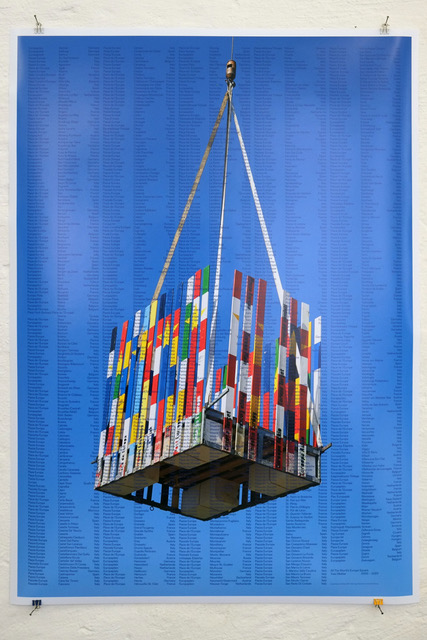
NOWs: Atlas Europe Square. A book by Yves Mettler
Atlas Europe Square. A book by Yves MettlerCall for action
Dear friends, colleagues and supporters,
I am currently working on a comprehensive book about my Europe Square project. The project is well advanced, with the documentation and the contributions coming together in an overwhelmingly inspiring layout. Altough three quarters of the budget is secured, I’m now calling on to you to get the final buck.
In order to complete the budget, I launch an exclusive numbered edition of 30 posters. On the background of an installation shot made in Daejeon, South Korea, I release the as exhaustive as possible list of Europe Squares in the world. The 100 x 70cm poster is printed in Berlin on Hahnemühle Photo Luster paper.
The price is 350.- EUR (without shipping costs). The purchase includes the signed book, which will be sent once it’s out. The order can be placed directly by writing to yvesmettler@theselection.net, including the delivery address. I’ll send an invoice that can be paid by IBAN/BIC or Paypal. Upon receiving the payment I’ll be delighted to send the numbered and signed poster.
Thank you,
Yves Mettler
About the book:
Atlas Europe Square
If the built environment is a record of our modes of organisation and the compromises we make in order to live together, then what are we to make of the plethora of Europe Squares, Europa Places, Places de l’Europe, and Europaplatzes? Public spaces that connect numerous disparate towns and cities through a ‘supersite’ called Europe, today they may appear as avatars of an idea in crisis, as ‘eurocentric values’ and the concept of Europe as a unified political space are attacked and eroded from all sides.
Atlas Europe Square documents a body of work by Swiss artist Yves Mettler who, since 2003, has engaged in an ongoing mapping and documentation of these sites, along with a series of projects triangulating between particular squares, interrogating their differing architectural, environmental, and public functions, and what they tell us about the ideality of ‘Europe’ and the (im)possibility of its concrete instantiation.
Here this work is extended into reflections on the relationship between art and public space, site-specificity, and the artist’s own implication in the imaginary of Europe as he becomes enmeshed in a network of projects, funds, and public bodies that seek to promote ‘European culture’ through art.
Alongside extensive photographic documentation, Atlas Europe Square contains texts by the artist alongside texts by Reza Negarestani, Teresa Pullano, Laurent Thévenot, and Stephen Zepke, discussing Mettler’s work and addressing the question of how to square ‘Europe’ with the contemporary complex that connects the city to the nation state and the global economy.
Contributors
Reza Negarestani, Teresa Pullano, Laurent Thévenot, Stephen Zepke
Published by
Urbanomic Ltd., Falmouth, UK.
Design
Dual Room, Biel/Bienne
Printed in
Italy
Distributed by
MIT Press
With the support of
Pro Helvetia, Erna und Curt Burgauer Stiftung, Canton de Vaud
Release date
April 2021
Atlas Europe Square. A book by Yves MettlerCall for action
Dear friends, colleagues and supporters,
I am currently working on a comprehensive book about my Europe Square project. The project is well advanced, with the documentation and the contributions coming together in an overwhelmingly inspiring layout. Altough three quarters of the budget is secured, I’m now calling on to you to get the final buck.
In order to complete the budget, I launch an exclusive numbered edition of 30 posters. On the background of an installation shot made in Daejeon, South Korea, I release the as exhaustive as possible list of Europe Squares in the world. The 100 x 70cm poster is printed in Berlin on Hahnemühle Photo Luster paper.
The price is 350.- EUR (without shipping costs). The purchase includes the signed book, which will be sent once it’s out. The order can be placed directly by writing to yvesmettler@theselection.net, including the delivery address. I’ll send an invoice that can be paid by IBAN/BIC or Paypal. Upon receiving the payment I’ll be delighted to send the numbered and signed poster.
Thank you,
Yves Mettler
About the book:
Atlas Europe Square
If the built environment is a record of our modes of organisation and the compromises we make in order to live together, then what are we to make of the plethora of Europe Squares, Europa Places, Places de l’Europe, and Europaplatzes? Public spaces that connect numerous disparate towns and cities through a ‘supersite’ called Europe, today they may appear as avatars of an idea in crisis, as ‘eurocentric values’ and the concept of Europe as a unified political space are attacked and eroded from all sides.
Atlas Europe Square documents a body of work by Swiss artist Yves Mettler who, since 2003, has engaged in an ongoing mapping and documentation of these sites, along with a series of projects triangulating between particular squares, interrogating their differing architectural, environmental, and public functions, and what they tell us about the ideality of ‘Europe’ and the (im)possibility of its concrete instantiation.
Here this work is extended into reflections on the relationship between art and public space, site-specificity, and the artist’s own implication in the imaginary of Europe as he becomes enmeshed in a network of projects, funds, and public bodies that seek to promote ‘European culture’ through art.
Alongside extensive photographic documentation, Atlas Europe Square contains texts by the artist alongside texts by Reza Negarestani, Teresa Pullano, Laurent Thévenot, and Stephen Zepke, discussing Mettler’s work and addressing the question of how to square ‘Europe’ with the contemporary complex that connects the city to the nation state and the global economy.
Contributors
Reza Negarestani, Teresa Pullano, Laurent Thévenot, Stephen Zepke
Published by
Urbanomic Ltd., Falmouth, UK.
Design
Dual Room, Biel/Bienne
Printed in
Italy
Distributed by
MIT Press
With the support of
Pro Helvetia, Erna und Curt Burgauer Stiftung, Canton de Vaud
Release date
April 2021

NOWs: #playathome. A Selection from the Arter Collection
#playathome. A Selection from the Arter Collectiononline video exhibition with Sophia Pompéry et al.
Arter presents the second edition of #playathome, an online selection of video works which can be accessed from arter.org.tr between 21 May and 21 June 2020. Selected from the Arter Collection to be played at home, this edition features nine videos with a particular focus on the act of drawing and painting, even though the contextual frames surrounding each work and the tools they utilise may differ from one another.
Practised on paper or on the surface of still water, these actions performed with everyday materials and bodily gestures enable diverse artistic genres to disperse into each other through the temporality of video.
Artists:
Josef Bares
Geta Brătescu
Marie Cool Fabio Balducci
Ali Kazma
Diána Keller & Péter Rizmayer
İz Öztat
Sophia Pompéry
Kata Tranker
Angel Vergara
Please click here to view the second edition of #playathome.
#playathome. A Selection from the Arter Collectiononline video exhibition with Sophia Pompéry et al.
Arter presents the second edition of #playathome, an online selection of video works which can be accessed from arter.org.tr between 21 May and 21 June 2020. Selected from the Arter Collection to be played at home, this edition features nine videos with a particular focus on the act of drawing and painting, even though the contextual frames surrounding each work and the tools they utilise may differ from one another.
Practised on paper or on the surface of still water, these actions performed with everyday materials and bodily gestures enable diverse artistic genres to disperse into each other through the temporality of video.
Artists:
Josef Bares
Geta Brătescu
Marie Cool Fabio Balducci
Ali Kazma
Diána Keller & Péter Rizmayer
İz Öztat
Sophia Pompéry
Kata Tranker
Angel Vergara
Please click here to view the second edition of #playathome.
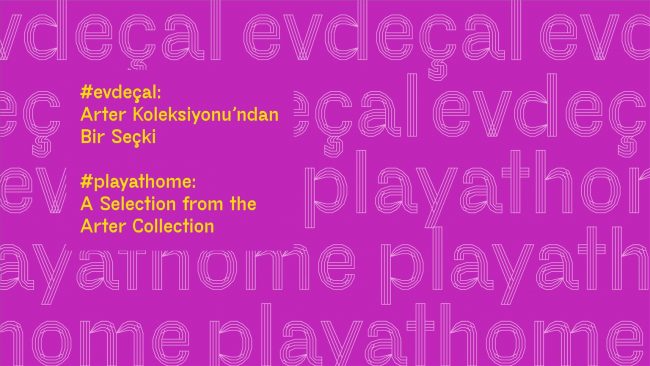
NOWs: #playathome. A Selection from the Arter Collection
#playathome. A Selection from the Arter Collectiononline video exhibition with Sophia Pompéry, Ayşe Erkmen et al.
Arter presents an online selection of video works from 15 April to 15 May 2020. Entitled #playathome, the selection features eight videos related to sound and/or music in various performative ways.
Selected from the Arter Collection to be played at home, these works explore the potential of sound to trespass physical boundaries and its ability to offer alternative ways to communicate, manifest, traverse and transgress.
Artists:
Nevin Aladağ
Ali Mahmut Demirel
Cevdet Erek
Ayşe Erkmen
Annika Kahrs
Mikhail Karikis & Uriel Orlow
Sophia Pompéry
Sarkis
Please click here to view the first edition of #playathome.
#playathome. A Selection from the Arter Collectiononline video exhibition with Sophia Pompéry, Ayşe Erkmen et al.
Arter presents an online selection of video works from 15 April to 15 May 2020. Entitled #playathome, the selection features eight videos related to sound and/or music in various performative ways.
Selected from the Arter Collection to be played at home, these works explore the potential of sound to trespass physical boundaries and its ability to offer alternative ways to communicate, manifest, traverse and transgress.
Artists:
Nevin Aladağ
Ali Mahmut Demirel
Cevdet Erek
Ayşe Erkmen
Annika Kahrs
Mikhail Karikis & Uriel Orlow
Sophia Pompéry
Sarkis
Please click here to view the first edition of #playathome.
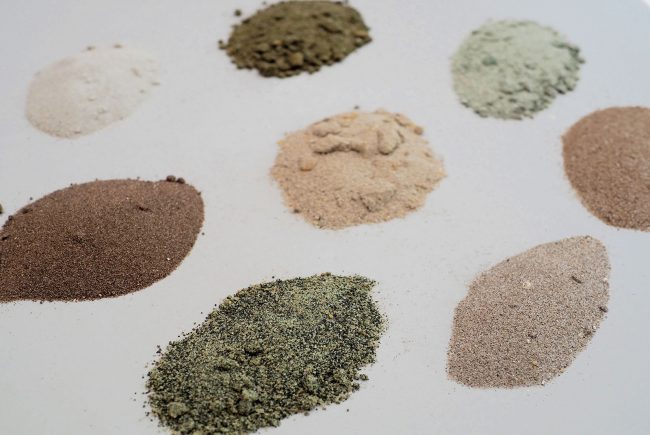
NOWs: Sand (Lommel) by Elise Eeraerts and Roberto Aparicio Ronda
Sand (Lommel)intervention by Elise Eeraerts and Roberto Aparicio Ronda
This year the intervention Sand (Lommel) will be realized at three different locations in the city center of Lommel, Belgium. It connects sand, nature, past and future in a special way. Lommel and sand as a material are intertwined through geological occurrences forming layers of sand measuring hundreds of meters below the earth’s surface. These contain quartz sand typical for the area, a fine and extremely white sand which is mined for its properties and purity.
One line divided in three parts, made of sand in the pavement will visually connect three parks in the city. Through drilling until a depth of 200 meters, sand samples have been taken at each meter. Each sand sample will be made into triangular ceramic elements as a part of the intervention. A line made of three parts will be composed of more than 1000 modular triangles to form the layers of sand in their true scale. So, sand that was located at a depth of precisely 100 meters below the earth will instead be situated in a line at a length of 100 meters on the surface of the earth. This way the depth and visual aspect of the layers of sand become perceivable.
In order to complement this intervention, additional triangular elements will be assembled into tetrahedron shaped, helices that mimic the atomic crystal structure of quartz (sand), also know as silicon dioxide. Some tetrahedrons will contain plants that are typical of the biodiversity of Lommel’s dune landscape. Other tetrahedrons will be covered in sand patterns, in reference to the local tradition of making sand carpets. Moreover, during a performative event, sand carpets will be installed temporarily in the city center.
Finally, the exact spot where the drilling occurred will be sealed with a silicon wafer, as a small memorial. This circular disc has the same diameter and shape as the drill. Silicon is crucial in our highly technological inventions, and it is the processed result that is extracted from silicon dioxide. That way the old – the natural, geological past revealed by the drilling, and the new – material transformation in science and technology, are confronted with each other.
These interventions combine and originated from the idea of making the invisible visible. From the vast layers of sand, to the crystal structures of the quartz atoms and forgotten traditions, the presence of these elements in public space will make these ideas and therefore the city’s identity more tangible.
Sand (Lommel)intervention by Elise Eeraerts and Roberto Aparicio Ronda
This year the intervention Sand (Lommel) will be realized at three different locations in the city center of Lommel, Belgium. It connects sand, nature, past and future in a special way. Lommel and sand as a material are intertwined through geological occurrences forming layers of sand measuring hundreds of meters below the earth’s surface. These contain quartz sand typical for the area, a fine and extremely white sand which is mined for its properties and purity.
One line divided in three parts, made of sand in the pavement will visually connect three parks in the city. Through drilling until a depth of 200 meters, sand samples have been taken at each meter. Each sand sample will be made into triangular ceramic elements as a part of the intervention. A line made of three parts will be composed of more than 1000 modular triangles to form the layers of sand in their true scale. So, sand that was located at a depth of precisely 100 meters below the earth will instead be situated in a line at a length of 100 meters on the surface of the earth. This way the depth and visual aspect of the layers of sand become perceivable.
In order to complement this intervention, additional triangular elements will be assembled into tetrahedron shaped, helices that mimic the atomic crystal structure of quartz (sand), also know as silicon dioxide. Some tetrahedrons will contain plants that are typical of the biodiversity of Lommel’s dune landscape. Other tetrahedrons will be covered in sand patterns, in reference to the local tradition of making sand carpets. Moreover, during a performative event, sand carpets will be installed temporarily in the city center.
Finally, the exact spot where the drilling occurred will be sealed with a silicon wafer, as a small memorial. This circular disc has the same diameter and shape as the drill. Silicon is crucial in our highly technological inventions, and it is the processed result that is extracted from silicon dioxide. That way the old – the natural, geological past revealed by the drilling, and the new – material transformation in science and technology, are confronted with each other.
These interventions combine and originated from the idea of making the invisible visible. From the vast layers of sand, to the crystal structures of the quartz atoms and forgotten traditions, the presence of these elements in public space will make these ideas and therefore the city’s identity more tangible.
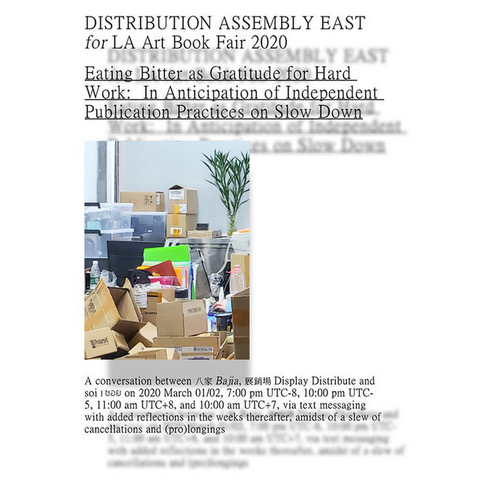
NOWs: Eating Bitter as Gratitude for Hard Work. In Anticipation of Independent Publication Practices on Slow Down
Eating Bitter as Gratitude for Hard Work. In Anticipation of Independent Publication Practices on Slow Down
A conversation between 八家 Bajia, 展銷場 Display Distribute and soi | ซอย on March 01/02, 7:00 UTC-8, 10:00 pm UTC-5, 11:00 am UTC+8, and 10:00 am UTC+7, via text messaging with added reflections in the weeks thereafter [amidst of a slew of cancellations and (pro)longings]
The PDF distributed dialogue with 張佳才 Zandie Brocket, 何穎雅 Elaine W. Ho, 凌明 Ming Lin and Judha Su concerns publishing in the shadows, possibilities for radical infrastructure, and new terms of fulfillment in lieu of Distribution Assembly East‘s participation in the 2020 LA Art Book Fair.
click here to download conversation as pdf
Eating Bitter as Gratitude for Hard Work. In Anticipation of Independent Publication Practices on Slow Down
A conversation between 八家 Bajia, 展銷場 Display Distribute and soi | ซอย on March 01/02, 7:00 UTC-8, 10:00 pm UTC-5, 11:00 am UTC+8, and 10:00 am UTC+7, via text messaging with added reflections in the weeks thereafter [amidst of a slew of cancellations and (pro)longings]
The PDF distributed dialogue with 張佳才 Zandie Brocket, 何穎雅 Elaine W. Ho, 凌明 Ming Lin and Judha Su concerns publishing in the shadows, possibilities for radical infrastructure, and new terms of fulfillment in lieu of Distribution Assembly East‘s participation in the 2020 LA Art Book Fair.
click here to download conversation as pdf
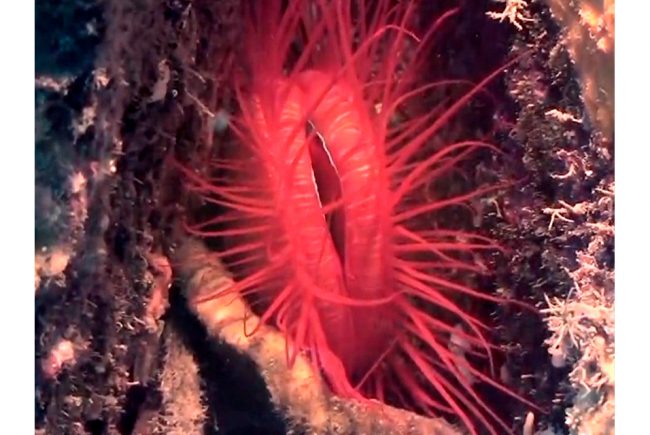
NOWs: The Far Away Is Here
The Far Away Is Hereonline video group exhibition
Anne Duk Hee Jordan, Ziggy and the Starfish, 2018, video single-channel color, 16:28 min.
Catinca Tabacaru Gallery
With: Marie José Burki, Sue de Beer, Anne Duk Hee Jordan, Sanja Latinović, Rachel Monosov
Curated by Rachel Monosov & Catinca Tabacaru
Catinca Tabacaru presents The Far Away Is Here, a video exhibition presented exclusively on our gallery website with works by Marie José Burki, Sue de Beer, Sanja Latinović, Anne Duk Hee Jordan, Rachel Monosov. It is a curatorial response to the current global crisis in both content and form.
What is happening over there will not happen here!
This time it started in China, and neither the EU, nor any other nations held meetings on how to help the red dragon; maybe thinking that COVID-19 won’t arrive to their part of the world.
This idea that war, refugee crisis, or viruses, are far-away and not here, is the complete opposite of solidarity.
Clearly, we are currently face to face with what we saw happening far-away. And now, because it is here, we are turning the world upside down.
What if we always lived with the idea that the far-away is actually also here?
Maybe this perspective will change our behavior completely.
By force, this virus brings to the forefront a global realty as each of us lives a similar experience. There is no here and there any longer. The differences are small, and all based in governmental ideology and enforcement. On a human level, we turn to solidarity, empathy, and respect in the search for a cure for both the virus and our civilization.
The video works The Far Away Is Here take these ideas as their starting point… even before these ideas were at the forefront of our minds, conversations, and news.
Sanja Latinovic’s Abandoned, a performance-based work, “is how we feel right now in Belgrade.”
Sue de Beer’s characters in her low-budget horror-thriller The White Wolf grapple to find equilibrium and meaning in the midst of an experience that is out of their control.
In It will end up in me, Rachel Monosov places ideas from traditional Indonesian medicine as a mirror in front of the “savage neo-liberalist intensification of deep social economic problems,” in Noam Chomsky’s words, as capitalist governments have known for a long time that pandemics would become a problem but failed to prepare for them because the market signals were wrong (Coronavirus – What is at stake?, DiEM25 TV, 17:00 – 18:24).
While Anne Duk Hee Jordan’s Ziggy and the Starfish gestates in a political world, it is not overtly political as it begs the question “how will we adapt?”
In A Film by Marie José Burki we listen to a familiar conversation about global warming, information we all know but do little with because global warming is happening somewhere there and not here, so we turn on our air conditioning and ignore what is happening outside our windows. Do we need to wait until our air conditioner turns into a melted stinky plastic box to change our behavior? Morton offers the example of global warming as a hyperobject which impacts meteorological conditions, such as tornado formation. Entities do not feel global warming, but instead, experience tornadoes as they cause damage in specific places (Disparitiesvon Slavoj Žižek, p. 34).
The exhibition will grow, evolve, and adapt, just as we are doing each day with shifting laws and turbulent emotions. Programming of lectures and interviews will springboard from the films and take us deeper into the issues at hand, maybe even walk us through windows we haven’t yet considered.
The Far Away Is Hereonline video group exhibition
Anne Duk Hee Jordan, Ziggy and the Starfish, 2018, video single-channel color, 16:28 min.
Catinca Tabacaru Gallery
With: Marie José Burki, Sue de Beer, Anne Duk Hee Jordan, Sanja Latinović, Rachel Monosov
Curated by Rachel Monosov & Catinca Tabacaru
Catinca Tabacaru presents The Far Away Is Here, a video exhibition presented exclusively on our gallery website with works by Marie José Burki, Sue de Beer, Sanja Latinović, Anne Duk Hee Jordan, Rachel Monosov. It is a curatorial response to the current global crisis in both content and form.
What is happening over there will not happen here!
This time it started in China, and neither the EU, nor any other nations held meetings on how to help the red dragon; maybe thinking that COVID-19 won’t arrive to their part of the world.
This idea that war, refugee crisis, or viruses, are far-away and not here, is the complete opposite of solidarity.
Clearly, we are currently face to face with what we saw happening far-away. And now, because it is here, we are turning the world upside down.
What if we always lived with the idea that the far-away is actually also here?
Maybe this perspective will change our behavior completely.
By force, this virus brings to the forefront a global realty as each of us lives a similar experience. There is no here and there any longer. The differences are small, and all based in governmental ideology and enforcement. On a human level, we turn to solidarity, empathy, and respect in the search for a cure for both the virus and our civilization.
The video works The Far Away Is Here take these ideas as their starting point… even before these ideas were at the forefront of our minds, conversations, and news.
Sanja Latinovic’s Abandoned, a performance-based work, “is how we feel right now in Belgrade.”
Sue de Beer’s characters in her low-budget horror-thriller The White Wolf grapple to find equilibrium and meaning in the midst of an experience that is out of their control.
In It will end up in me, Rachel Monosov places ideas from traditional Indonesian medicine as a mirror in front of the “savage neo-liberalist intensification of deep social economic problems,” in Noam Chomsky’s words, as capitalist governments have known for a long time that pandemics would become a problem but failed to prepare for them because the market signals were wrong (Coronavirus – What is at stake?, DiEM25 TV, 17:00 – 18:24).
While Anne Duk Hee Jordan’s Ziggy and the Starfish gestates in a political world, it is not overtly political as it begs the question “how will we adapt?”
In A Film by Marie José Burki we listen to a familiar conversation about global warming, information we all know but do little with because global warming is happening somewhere there and not here, so we turn on our air conditioning and ignore what is happening outside our windows. Do we need to wait until our air conditioner turns into a melted stinky plastic box to change our behavior? Morton offers the example of global warming as a hyperobject which impacts meteorological conditions, such as tornado formation. Entities do not feel global warming, but instead, experience tornadoes as they cause damage in specific places (Disparitiesvon Slavoj Žižek, p. 34).
The exhibition will grow, evolve, and adapt, just as we are doing each day with shifting laws and turbulent emotions. Programming of lectures and interviews will springboard from the films and take us deeper into the issues at hand, maybe even walk us through windows we haven’t yet considered.
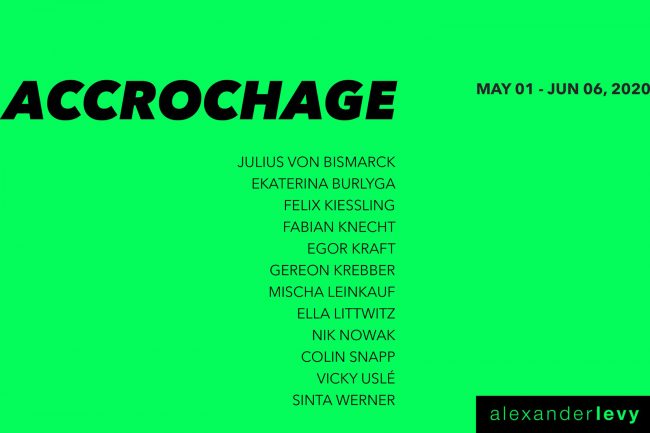
NOWs: Accrochage
Accrochageonline group show
alexander levy
Rudi-Dutschke-Strasse 26
10969 Berlin
Due to the current situation we postponed our exhibition Taumel by Felix Kiessling to September 2020 in conjunction with the official Gallery Weekend Berlin.
In this difficult time we cannot make any plans and won’t invite an artist for an exhibition that would not get the attention it deserves.
We are pleased to use this time for another great initiative: Please have a look at our Accrochage – a selection of works by: Julius von Bismarck, Ekaterina Burlyga, Felix Kiessling, Fabian Knecht, Egor Kraft, Gereon Krebber, Ella Littwitz, Mischa Leinkauf, Nik Nowak, Colin Snapp, Vicky Uslé and Sinta Werner.
The online brochure accompaning the exhibition in the gallery gives you a special insight into the artists’ practices narrating background stories of the works.
You are very welcome to visit the gallery by appointment.
AccrochageOnline Gruppenausstellung
alexander levy
Rudi-Dutschke-Strasse 26
10969 Berlin
Due to the current situation we postponed our exhibition Taumel by Felix Kiessling to September 2020 in conjunction with the official Gallery Weekend Berlin.
In this difficult time we cannot make any plans and won’t invite an artist for an exhibition that would not get the attention it deserves.
We are pleased to use this time for another great initiative: Please have a look at our Accrochage – a selection of works by: Julius von Bismarck, Ekaterina Burlyga, Felix Kiessling, Fabian Knecht, Egor Kraft, Gereon Krebber, Ella Littwitz, Mischa Leinkauf, Nik Nowak, Colin Snapp, Vicky Uslé and Sinta Werner.
The online brochure accompaning the exhibition in the gallery gives you a special insight into the artists’ practices narrating background stories of the works.
You are very welcome to visit the gallery by appointment.

NOWs: LIFE FORMS by Andreas Greiner, edited by Carson Chan
LIFE FORMSEssays on the Display, Synthesis and Simulation of Life and Artworks of Andreas Greiner
Cat. Kunstverein Heilbronn / Mönchehaus Museum Goslar; edited by Carson Chan
texts (English) by Gregory Cartelli, Ryan Roark, J.D. Schnepf, Ursula Ströbele, Mareike Vennen, J. Craig Venter, Olivier Zeitoun and German Synopses by Stefan Vicedom
Design: Sin-U-Ko
232 p with 250 coloured and 70 b/w illustrations
250 x 200 mm, Swiss brochure
Published by Snoeck Verlag, Cologne, 2020.
ISBN 978-3-86442-309-3
Order: 39,80 €
Andreas Greiner’s Artwork and the Simulation of Life
Which forms does artificial life take? How do humans today intervene in growth processes through synthetic biology? How does this affect the relationship between nature and culture? And what significance does art have in the age of the anthropocene? For Andreas Greiner (*1979), these questions are at the center of his work, where he scrutinizes the relationships between nature/technology/culture/art with regard to ethics as well as social and ecological issues. This volume places Andreas Greiner’s work in a dialogue with scientists and experts from various disciplines such as physics, computer science, biology, music and architecture. The emerging interfaces raise the integral questions that the artist examines, which are more urgent than ever after the apparent quantum leaps in the medical-biological field, such as genetic engineering
LIFE FORMSEssays on the Display, Synthesis and Simulation of Life and Artworks of Andreas Greiner
Kat. Kunstverein Heilbronn / Mönchehaus Museum Goslar; herausgegeben von Carson Chan
Texte (eng.) von Gregory Cartelli, Ryan Roark, Jennifer Schnepf, Ursula Ströbele, Mareike Vennen, J. Craig Venter, Olivier Zeitoun und deutschsprachigen Synopsen von Stefan Vicedom
Design: Sin-U-Ko
232 S. mit 250 farbigen und 70 s/w Abbildungen
250 x 200 mm, Schweizer Broschur
Erschinen im Snoeck Verlag, Köln, 2020.
ISBN 978-3-86442-309-3
Bestellung: 39,80 €
Andreas Greiners Kunst an der Schnittstelle zur Biowissenschaft
Welche Formen nimmt künstliches Leben an? Wie greift der Mensch durch synthetische Biologie heute in Wachstumsprozesse ein? Wie gestaltet sich dadurch das Verhältnis von Natur und Kultur? Und welchen Stellenwert nimmt die Kunst im Zeitalter des Anthropozäns ein? Diese Fragen stehen für Andreas Greiner (*1979) im Zentrum seines Werkes in dem er die Verhältnisse von Natur/Technik/Kultur/Kunst ethisch sowie sozial-gesellschaftlich und ökologiekritisch hinterfragt. Der Band stellt die künstlerischen Arbeiten Andreas Greiners in einen Dialog mit Wissenschaftlern und Experten aus unterschiedlichen Disziplinen wie Physik, Informatik, Biologie, Musik und Architektur. Das führt in die Schnittstellen und ruft die integralen Fragestellungen auf, mit denen sich der Künstler beschäftigt, die drängender denn je sind, nachdem Quantensprünge im medizinisch-biologischen Bereich, etwa der Gentechnologie, zu beobachten sind.
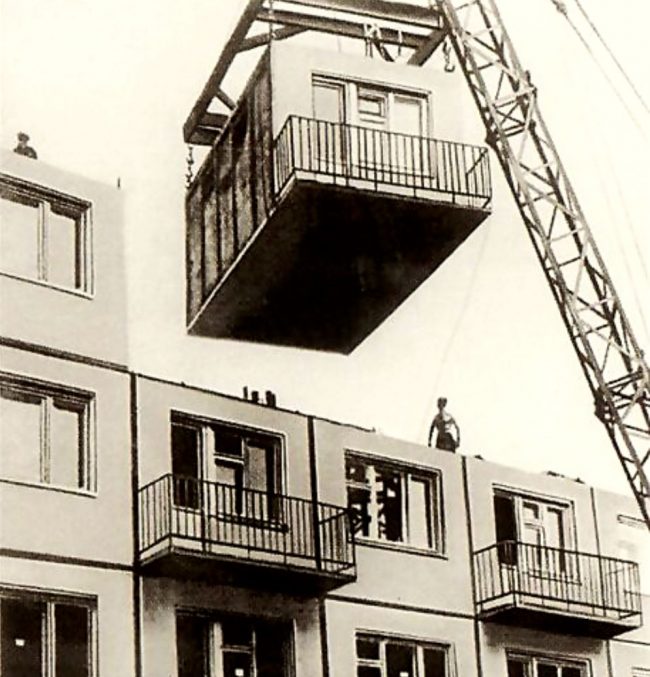
NOWs: Die Balkone
Die Balkone. Life, art, pandemic, proximity in windows & balconies
Initiated by Övül Ö. Durmusoglu and Joanna Warsza
12.-13. April 1 p.m. to 5 p.m. (Easter Sunday and Monday) + projections in the evening
#DieBalkone
If we behave like those on the other side, then we are the other side. Instead of changing the world, all we’ll achieve is a reflection of the one we want to destroy.
Jean Genet, The Balcony
We are at the very beginning of a new cycle that we cannot yet situate ourselves in. Its first palpable experiences are shifts in the relationship between inside and outside; in the distance between one day and another; between what is private, public, and political. At the same time, care, protection, and vulnerability are growing with new meanings.
Balconies serve as the public apertures of the private. They seem to be where the house ends, and yet not. In their political history, they have both been terraces of openness and hope, as well as platforms for authoritarianism and supremacy. Balconies today are the thresholds from which we can encounter the world during the confinement of the domestic: which is safe and sound for some, but not for others. They are emergency exits to take a breath of fresh air, catch a moment of sunshine or a smoke. While our freedom of mobility is on hold, they become unique sites of everyday performance or even civic mobilization. Every architecture school has its own way of designing balconies. Everyone has their own way of inhabiting them. Especially now.
In times of quarantine, so many of us cultural workers living in Berlin happen to all be here; not far from each other, and yet absent as usual. We are asked to commit to the digital space, without critically estimating the effects of for-profit information technologies.
Berlin has an important history of artist squats, takeovers, one-night exhibitions. In former East Germany, what was public, in a sense of non-intimidated or uncensored art and life, frequently happened in someone’s kitchen rather than out in the open. Specifically, Prenzlauer Berg is a place where home-made resistance against the GDR hit critical mass.
Die Balkone invites members of the artistic community living in Prenzlauer Berg to activate/inhabit their windows and balconies. With zero budget, no opening, and no crowds, the project proposes an intimate stroll (within current regulations) to search for signs of life, art, and points of kinship and connection. When some of us are cut off from our plans and our loved ones, we reach out to the balconies of the world, against isolation and individualization, not leaving everything in the hands of the virus and the fear it generates.
Please find documentation and press coverage here.
With: Salwa Aleryani and Matheus Rocha Pitta, Ulf Aminde, Rosa Barba and Jan St. Werner, Yael Bartana and Saskia Wendland, Elke Buhr and Tobi Müller, Matthias Daenschel, Jeremiah Day and Alisa Margolis, Christina Dimitriadis, Sam Durant and Ana Prvacki, Knut Eckstein, Theo Eshetu, Martin Frese and Eva Scharrer at Tina Löffelbein’s, Olaf Grawert, Jan Peter Hammer, Hannah Hurtzig, Stine Marie Jacobsen, Anne Duk Hee Jordan and Pauline Doutreluingne, Christoph Keller, Jessika Khazrik / Övül Ö. Durmusoglu, Matylda Krzykowski, Xavier le Roy and Scarlet Yu, Lage Egal, Antonia Low and Tommy Støckel, Lina Majdalanie and Rabih Mroué, Kamila Metwaly and Max Schneider, Markus Miessen and Lena Mahr, Tom McCarthy and Eva Stenram, Müller Dreimalklingeln and Sonja Lau, Olaf Nicolai, Andrea Pichl, Marta Popivoda and Ana Vujanović, David Rych and kids, Susanne Sachsse and Marc Siegel, Isabella Sedeka, Antje Stahl and Felix-Emeric Tota, Raul Walch, Joanna Warsza and Florian Malzacher, Christina Werner and others.
Die Balkone. Life, art, pandemic, proximity in windows & balconies
Fenster und Balkone im Prenzlauer Berg
12.-13. April,13:00-17:00 Uhr (Ostersonntag und -montag) + Projektionen am Abend
Initiated by Övül Ö. Durmusoglu and Joanna Warsza
#DieBalkone
Wenn wir uns wie die auf der anderen Seite verhalten, dann sind wir die andere Seite. Anstatt die Welt zu verändern, werden wir nur eine Spiegelung derer, die wir zerstören wollen, erlangen.
Jean Genet, Der Balkon
Wir stehen am Anfang eines neuen Zyklus, in dem wir uns noch nicht verorten können. Seine ersten greifbaren Erfahrungen sind Verschiebungen in der Beziehung zwischen Innen und Außen; in der Distanz zwischen einem Tag und dem nächsten; zwischen privat, öffentlich und politisch. Gleichzeitig wachsen Sorgfalt, Schutz und Verletzlichkeit und nehmen neue Bedeutungen an.
Balkone öffnen den privaten Raum nach außen. Sie befinden sich scheinbar da, wo das Haus endet, und doch wieder nicht. In ihrer politischen Geschichte stellten sie sowohl Terrassen der Offenheit und Hoffnung dar, als auch Plattformen für Autoritarismus und Vorherrschaft. Balkone sind heute die Schwellen, von denen aus wir der Welt in der Eingrenzung des Häuslichen begegnen können: Dieses Zuhause ist für einige selbstverständlich, für andere wiederum nicht. Sie sind Notausgänge, um frische Luft zu schnappen, einen Moment Sonnenschein oder eine Zigarette. Während unsere Mobilitätsfreiheit eingefroren ist, werden sie zu einzigartigen Orten täglicher Performance oder sogar bürgerlicher Mobilisierung. Jede Architekturschule hat ihre eigene Art, Balkone zu gestalten. Jeder hat seine eigene Art, sie zu bewohnen. Vor allem jetzt.
In Zeiten der Quarantäne sind so viele von uns Berliner Kulturschaffenden hier; nicht weit voneinander entfernt und doch wie immer abwesend. Wir werden gebeten, uns dem digitalen Raum zu widmen, ohne die Auswirkungen gewinnorientierter Informationstechnologien kritisch abzuschätzen.
Berlin birgt eine wichtige Geschichte von Hausbesetzungen, Übernahmen und One-Night-Ausstellungen. In der ehemaligen DDR passierte Öffentlichkeit – im Sinne einer nicht eingeschüchterten oder unzensierten Kunst und des Lebens – häufig in der Küche von Jemanden anstatt draußen im Freien. Insbesondere der Prenzlauer Berg ist ein Ort, an dem hausgemachter Widerstand gegen das DDR-Regime die kritische Masse erreichte.
Die Balkone lädt Mitglieder der im Prenzlauer Berg lebenden Künstler*innengemeinschaft ein, ihre Fenster und Balkone zu aktivieren / bewohnen. Ohne Budget, ohne Eröffnung und ohne Menschenmassen schlägt das Projekt einen intimen Spaziergang (im Rahmen der geltenden Vorschriften) vor, um nach Lebenszeichen, nach Kunst, Verwandtschafts- und Verbindungszeichen zu suchen. Zu Zeiten da einige von uns von ihren Plänen und ihren Lieben abgeschnitten sind, wenden wir uns den Balkonen der Welt zu, gegen Isolation und Individualisierung, und lassen nicht alles in den Händen des Virus und der Angst, die es erzeugt.
Dokumentation und Pressebericht finden sich hier.
Mit Salwa Aleryani and Matheus Rocha Pitta, Ulf Aminde, Rosa Barba and Jan St. Werner, Yael Bartana and Saskia Wendland, Elke Buhr and Tobi Müller, Matthias Daenschel, Jeremiah Day and Alisa Margolis, Christina Dimitriadis, Sam Durant and Ana Prvacki, Knut Eckstein, Theo Eshetu, Martin Frese and Eva Scharrer at Tina Löffelbein’s, Olaf Grawert, Jan Peter Hammer, Hannah Hurtzig, Stine Marie Jacobsen, Anne Duk Hee Jordan and Pauline Doutreluingne, Christoph Keller, Jessika Khazrik / Övül Ö. Durmusoglu, Matylda Krzykowski, Xavier le Roy and Scarlet Yu, Lage Egal, Antonia Low and Tommy Støckel, Lina Majdalanie and Rabih Mroué, Kamila Metwaly and Max Schneider, Markus Miessen and Lena Mahr, Tom McCarthy and Eva Stenram, Müller Dreimalklingeln and Sonja Lau, Olaf Nicolai, Andrea Pichl, Marta Popivoda and Ana Vujanović, David Rych and kids, Susanne Sachsse and Marc Siegel, Isabella Sedeka, Antje Stahl and Felix-Emeric Tota, Raul Walch, Joanna Warsza and Florian Malzacher, Christina Werner und anderen.
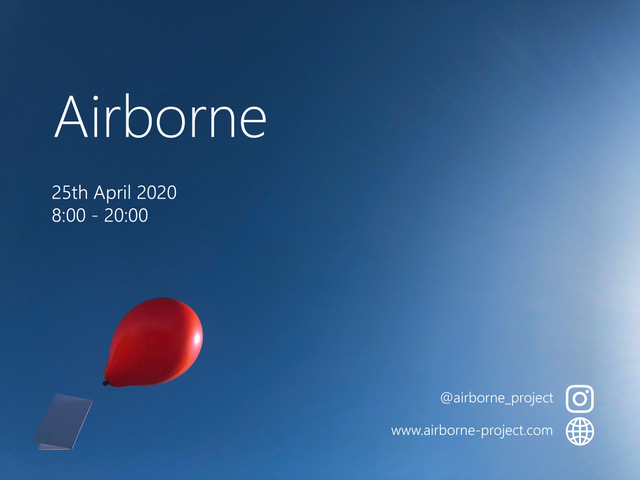
NOWs: AIRBORNE
AIRBORNE
Although lock-down measures across the world are slowly being loosened, cultural institutions and exhibition spaces still remain largely closed. We are therefore opening the guaranteed corona-free exhibition project Airborne – contactlessly transmitted messages, designed for this new, socially distant world.
On Saturday 25th April starting at 8 in the morning a balloon will ascend into the sky of Berlin every 15-30 minutes. Attached to each balloon will be a piece of paper carrying a thought, sketch, photograph or poem from artists, writers, curators and thinkers. They shall be released into the world like messages in a bottle.
The original works can be found scattered around Berlin and Brandenburg from April 25th, and the event will also be shared live on Instagram from @airborne_project starting at 8 am. The individual contributions can be viewed on the project website www.airborne-project.com from 8 pm.
A project by Diana Sprenger and Euan Williams with contributions by Be Andr, Rosie Arnold, Sven Beckstette, Fritz Bornstück, Nino Cais, Leon Eixenberger, Ivana Franke, Andreas Greiner, Lutz Henke, Alison Hugill, Samuel Imbach, Anne Duk Hee Jordan, Shinae Kim, Nele Köhler, Lydia Korndörfer, Diana Liljelund, Rebecca Partridge, Gerald Pirner, Sophia Pompery, Tiago Romagnani Silveira, Otto E. Rossler, Rike Scheffler, Nina Schuiki, Diana Sprenger, Yuichiro Jose Tamura, Julia Katharina Thiemann, Lukas Töpfer, Tomoyuki Ueno, Bernard Vienat, Tom Wagner, Jonas Wendelin, Euan Williams, e.a.
AIRBORNE
Die Lockdown-Maßnahmen werden auf der ganzen Welt langsam zurückgefahren, doch kulturelle Institutionen und Ausstellungsräume bleiben noch immer weitgehend geschlossen. Wir eröffnen deshalb das garantiert coronafreie Ausstellungsprojekt Airborne – kontaktlos übermittelte Botschaften, konzipiert für diese neue, sozial distanzierte Welt.
Am Samstag, den 25. April 2020, steigt ab 8 Uhr morgens alle 15 – 30 Minuten ein Luftballon in den Himmel über Berlin auf. An jeden Ballon ist ein Papier geheftet, das einen Gedanken, eine Zeichnung, eine Fotografie oder ein Gedicht von Künstlern, Autoren und Kuratoren in die Welt trägt. Im Gegensatz zum unbestimmten Versand einer intimen Flaschenpost, oft bestückt mit Sorgen, Nöten und Ängsten, kalkulieren die Autoren des Airborne-Projekts das Entdecken ihrer Botschaft fest ein. Gefunden zwischen Sträuchern, auf Balkonen oder Parkplätzen, in Coronakrisenzeiten mehrere Hundertmeter weit entfernt übergeben. Die subtile Anspielung auf die luftgetragene Infektion des Corona-Virus ist auch ein Versuch, den Akt des Kunstbetrachtens in Quarantäne weg von rein online-basierten Lösungen großer Institutionen zu leiten.
Die Originalkunstwerke sind ab 25. April in Berlin und Umgebung verstreut zu finden, zudem wird die Veranstaltung ab 8 Uhr live auf Instagram unter @airborne_project geteilt. Die einzelnen Beiträge können ab 20 Uhr auf der Projektwebsite www.airborne-project.com eingesehen werden.
Ein Project von Diana Sprenger und Euan Williams mit Beiträgen von Be Andr, Rosie Arnold, Sven Beckstette, Fritz Bornstück, Nino Cais, Leon Eixenberger, Ivana Franke, Andreas Greiner, Lutz Henke, Alison Hugill, Samuel Imbach, Anne Duk Hee Jordan, Shinae Kim, Nele Köhler, Lydia Korndörfer, Diana Liljelund, Rebecca Partridge, Gerald Pirner, Sophia Pompery, Tiago Romagnani Silveira, Otto E. Rossler, Rike Scheffler, Nina Schuiki, Diana Sprenger, Yuichiro Jose Tamura, Julia Katharina Thiemann, Lukas Töpfer, Tomoyuki Ueno, Bernard Vienat, Tom Wagner, Jonas Wendelin, Euan Williams, u.a.
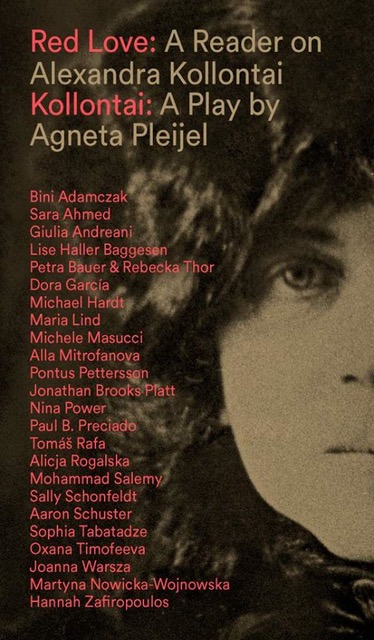
NOWs: Red Love. A Reader on Alexandra Kollontai – Discussion and Book Launch
Red Love: A Reader on Alexandra KollontaiDiscussion and Book Launch with Bini Adamczak, Maria Lind, Mechele Masucci, Aaron Schuster, Sophia Tabatadze, Oxana Timofeeva, Mohammad Salemy and Joanna Warsza
Cabinet
Ebersstrasse 3
10827 Berlin (careful: not Ebertstrasse)
12 March, 7 pm
On the occasion of the release of Red Love: A Reader on Alexandra Kollontai, please join us for an evening dedicated to exploring the legacy of the Soviet writer and revolutionary. Appointed the People’s Commissar of Social Welfare after the October Revolution, Kollontai worked to introduce a number introduction of crucial reforms for women’s liberation, including abortion rights, secularized marriage, and paid maternity leave. For her, “comradely love” was a fully political force.
The evening’s discussion featuring several of the contributors to the anthology—Bini Adamczak, Michele Masucci, Aaron Schuster, Sophia Tabatadze, Oxana Timofeeva, and Mohammad Salemy—will be moderated by two of the anthology’s editors, Maria Lind and Joanna Warsza. In addition to presenting this historical figure, we will ask how to read Kollontai’s vision of love today and how to relate it to current feminist struggles?
The anthology stems from research conducted by CuratorLab at Konstfack University in Stockholm and by Tensta konsthall in the context of an exhibition by Dora García in 2018.
Drinks and red borscht will be served.
Red Love: A Reader on Alexandra KollontaiDiscussion and Book Launch with Bini Adamczak, Maria Lind, Mechele Masucci, Aaron Schuster, Sophia Tabatadze, Oxana Timofeeva, Mohammad Salemy and Joanna Warsza
Cabinet
Ebersstrasse 3
10827 Berlin (careful: not Ebertstrasse)
12 March, 7 pm
On the occasion of the release of Red Love: A Reader on Alexandra Kollontai, please join us for an evening dedicated to exploring the legacy of the Soviet writer and revolutionary. Appointed the People’s Commissar of Social Welfare after the October Revolution, Kollontai worked to introduce a number introduction of crucial reforms for women’s liberation, including abortion rights, secularized marriage, and paid maternity leave. For her, “comradely love” was a fully political force.
The evening’s discussion featuring several of the contributors to the anthology—Bini Adamczak, Michele Masucci, Aaron Schuster, Sophia Tabatadze, Oxana Timofeeva, and Mohammad Salemy—will be moderated by two of the anthology’s editors, Maria Lind and Joanna Warsza. In addition to presenting this historical figure, we will ask how to read Kollontai’s vision of love today and how to relate it to current feminist struggles?
The anthology stems from research conducted by CuratorLab at Konstfack University in Stockholm and by Tensta konsthall in the context of an exhibition by Dora García in 2018.
Drinks and red borscht will be served.
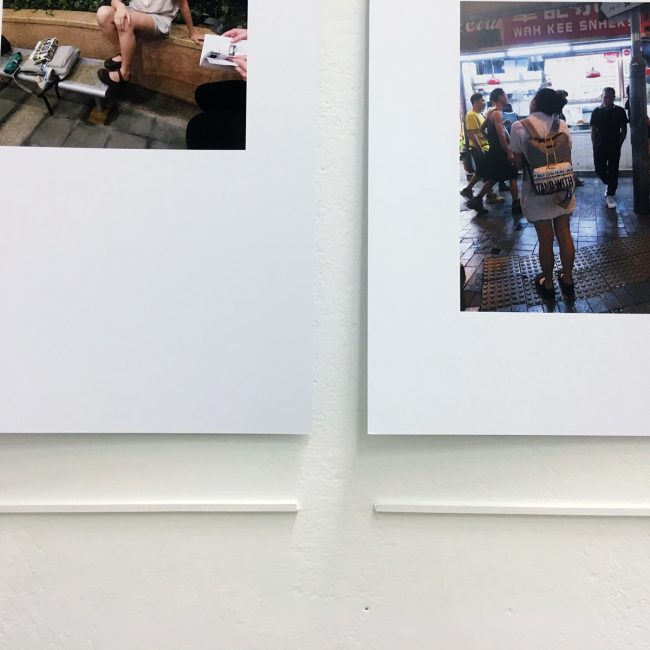
NOWs: Display Distribute presents Light Logistics
Display Distribute LIGHT LOGISTICIAN 何穎雅 Elaine W. Ho speaking with the panel "Publishing as Artistic Practice", part of the Publishing Maneuvers Symposium (2020) at Warehouse 421, Abu Dhabi; image courtesy of Warehouse421.
Publishing initiative Kayfa ta‘s series of books that “situate themselves in the space between the technical and the reflective, the everyday and the speculative, the instructional and the intuitive, the factual and the fictional” have now traversed into the realm of the exhibition, with a series of three of their “how to” model now seeping into art spaces in Beirut, Amman and Abu Dhabi.
For each iteration of the exhibition, itinerant research inquiry and artist hydra Display Distribute presented its LIGHT LOGISTICS project with the “SECOND(hand)MOUNTAIN(fortress)” imprint of bootleg books and their convoluted journeys to the Middle East. Dispatch HQL-304 and its documentation were presented in Beirut for “How to Reappear: Through the quivering leaves of independent publishing” at Beirut Art Center, then carried over as HQL-123 to Warehouse 421 in Abu Dhabi for “How to maneuver: Shape-shifting texts and other publishing tactics“. The third installment of the exhibition introduced LIGHT LOGISTICS dispatch HQL-350 with a new collaborative packaging collected from posters from Hong Kong’s anti-extradition bill movement, further protected with anti-RFID signal enabled tote bags made by artist collective nztt sewing co-op. Books and bags were hand carried from Hong Kong to Berlin, finally reaching the MMAG Foundation in Amman, where they will remain in relay until 23 April 2020. The “How to” series of publications and exhibitions exhibitions are curated by Maha MAAMOUN and Ala YOUNIS of Kayfa Ta.
–
Detail, installation view, LIGHT LOGISTICS: HQL-304, from "How to Reappear: Through the quivering leaves of independent publishing"; image courtesy of Beirut Art Center.
Display Distribute LIGHT LOGISTICIAN 何穎雅 Elaine W. Ho speaking with the panel "Publishing as Artistic Practice", part of the Publishing Maneuvers Symposium (2020) at Warehouse 421, Abu Dhabi; image courtesy of Warehouse421.
Publishing initiative Kayfa ta‘s series of books that “situate themselves in the space between the technical and the reflective, the everyday and the speculative, the instructional and the intuitive, the factual and the fictional” have now traversed into the realm of the exhibition, with a series of three of their “how to” model now seeping into art spaces in Beirut, Amman and Abu Dhabi.
For each iteration of the exhibition, itinerant research inquiry and artist hydra Display Distribute presented its LIGHT LOGISTICS project with the “SECOND(hand)MOUNTAIN(fortress)” imprint of bootleg books and their convoluted journeys to the Middle East. Dispatch HQL-304 and its documentation were presented in Beirut for “How to Reappear: Through the quivering leaves of independent publishing” at Beirut Art Center, then carried over as HQL-123 to Warehouse 421 in Abu Dhabi for “How to maneuver: Shape-shifting texts and other publishing tactics“. The third installment of the exhibition introduced LIGHT LOGISTICS dispatch HQL-350 with a new collaborative packaging collected from posters from Hong Kong’s anti-extradition bill movement, further protected with anti-RFID signal enabled tote bags made by artist collective nztt sewing co-op. Books and bags were hand carried from Hong Kong to Berlin, finally reaching the MMAG Foundation in Amman, where they will remain in relay until 23 April 2020. The “How to” series of publications and exhibitions exhibitions are curated by Maha MAAMOUN and Ala YOUNIS of Kayfa Ta.
–
Detail, installation view, LIGHT LOGISTICS: HQL-304, from "How to Reappear: Through the quivering leaves of independent publishing"; image courtesy of Beirut Art Center.

Workshop for “Atmospheres in the Urban Anthropocene – International and Cross-disciplinary Research Network”
Photo: Yero Adugna Eticha
Workshop in Addis Ababa, Ethiopia
The research project Atmospheres in the Urban Anthropocene – International and Cross-disciplinary Research Network was initiated and conceived by the Aarhus School of Architecture, established with the aim of developing an affective-sensory approach to the urban Anthropocene by bridging two strands of research which are hitherto unrelated: 1) research that has investigated the urban and the Anthropocene without much attention to affective and sensory issues, and 2) recent urban and architectural research into atmosphere that has investigated the sensory affective but most often fails to address the Anthropocene.
The network arranges three workshops in distinct climatic and sensory-affective atmospheres. The first one took place in Aarhus, Denmark, 2018; the second in Addis Ababa, Ethiopia, 2019 and the third will be take place in Tromsø, Norway, 2020.
The focus of the workshop in Addis Ababa was approaches to mapping and registering of atmospheres in the urban Anthropocene. The thematic sub-focus was on “Subnatures and Biodiversity”. The
workshop was centred around mapping-artworks produced in the week preceding the workshop by artists, Yero Adugna Eticha and Leikun Nahusenay, in collaboration with architects, Rasmus Hjortshøj and Asbjørn Jessen, as well as by Muluadam Adane, Michael Hailu, Gashahun Kassahun, Tewodros Kifle, Temesgen Mastewal, and Solomon Shifraw Abebe – students from the Alle School of Fine Arts that participated in the workshop Mapping the Invisible City led by Makeda Begashaw, Polina Chebotareva and Christina Werner. The mapping-artworks were exhibited at Guramayne Art Center for the duration of the workshop and incorporated in the workshop lectures and discussions.
–
Organisation: Polina Chebotareva (Aarhus School of Architecture) and Christina Werner (Institut für Raumexperimente / Studio Olafur Eliasson in Berlin)
Network partners: Suzel Balez (École nationale supérieure d’architecture de Grenoble), Peder Klith Bøcher (Aarhus University / Center for Biodiversity Dynamics in a Changing World (BIOCHANGE)), Thomas Juel Clemmensen (The Arctic University of Norway), Rasmus Hjortshøj (Aarhus School of Architecture), Asbjørn Jessen (University of Copenhagen, Section Landscape Architecture and Planning), Tom Nielsen (Aarhus School of Architecture), Martin Prominski (Leibniz University Hannover), Jean-Paul Thibaud (École nationale supérieure d’architecture de Grenoble)
Collaborators Addis Ababa: Yero Adugna Eticha (photographer), Makeda Begashaw (Alle School of Fine Arts and Design, Addis Ababa University), Leikun Nahusenay (artist), Robel Temesgen (Alle School of Fine Arts and Design, Addis Ababa University), Brook Teklehaimanot (Addis Ababa University, EiABC protoLAB), Mifta Zekele (Guramayne Art Center)
–
Thanks to the Alle School of Fine Arts and Design, Addis Ababa University and Guramayne Art Center.
–
Photo: Yero Adugna Eticha
Photo: Rasmus Hjortshøj
Photo: Yero Adugna Eticha
Workshop in Addis Ababa, Ethiopia
The research project Atmospheres in the Urban Anthropocene – International and Cross-disciplinary Research Network was initiated and conceived by the Aarhus School of Architecture, established with the aim of developing an affective-sensory approach to the urban Anthropocene by bridging two strands of research which are hitherto unrelated: 1) research that has investigated the urban and the Anthropocene without much attention to affective and sensory issues, and 2) recent urban and architectural research into atmosphere that has investigated the sensory affective but most often fails to address the Anthropocene.
The network arranges three workshops in distinct climatic and sensory-affective atmospheres. The first one took place in Aarhus, Denmark, 2018; the second in Addis Ababa, Ethiopia, 2019 and the third will be take place in Tromsø, Norway, 2020.
The focus of the workshop in Addis Ababa was approaches to mapping and registering of atmospheres in the urban Anthropocene. The thematic sub-focus was on “Subnatures and Biodiversity”. The
workshop was centred around mapping-artworks produced in the week preceding the workshop by artists, Yero Adugna Eticha and Leikun Nahusenay, in collaboration with architects, Rasmus Hjortshøj and Asbjørn Jessen, as well as by Muluadam Adane, Michael Hailu, Gashahun Kassahun, Tewodros Kifle, Temesgen Mastewal, and Solomon Shifraw Abebe – students from the Alle School of Fine Arts that participated in the workshop Mapping the Invisible City led by Makeda Begashaw, Polina Chebotareva and Christina Werner. The mapping-artworks were exhibited at Guramayne Art Center for the duration of the workshop and incorporated in the workshop lectures and discussions.
–
Organisation: Polina Chebotareva (Aarhus School of Architecture) and Christina Werner (Institut für Raumexperimente / Studio Olafur Eliasson in Berlin)
Network partners: Suzel Balez (École nationale supérieure d’architecture de Grenoble), Peder Klith Bøcher (Aarhus University / Center for Biodiversity Dynamics in a Changing World (BIOCHANGE)), Thomas Juel Clemmensen (The Arctic University of Norway), Rasmus Hjortshøj (Aarhus School of Architecture), Asbjørn Jessen (University of Copenhagen, Section Landscape Architecture and Planning), Tom Nielsen (Aarhus School of Architecture), Martin Prominski (Leibniz University Hannover), Jean-Paul Thibaud (École nationale supérieure d’architecture de Grenoble)
Collaborators Addis Ababa: Yero Adugna Eticha (photographer), Makeda Begashaw (Alle School of Fine Arts and Design, Addis Ababa University), Leikun Nahusenay (artist), Robel Temesgen (Alle School of Fine Arts and Design, Addis Ababa University), Brook Teklehaimanot (Addis Ababa University, EiABC protoLAB), Mifta Zekele (Guramayne Art Center)
–
Thanks to the Alle School of Fine Arts and Design, Addis Ababa University and Guramayne Art Center.
–
Photo: Yero Adugna Eticha
Photo: Rasmus Hjortshøj
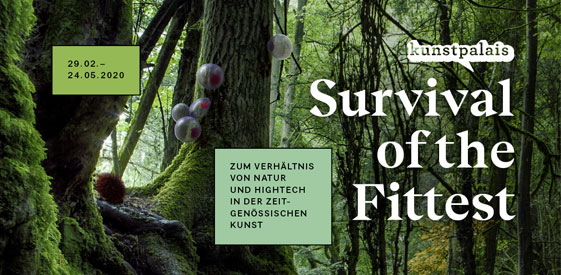
NOWs: Survival of the Fittest
Survival of the Fittestgroup exhibition with Andreas Greiner et al.
Opening
28 February
The current discourse on where humankind is heading is increasingly dominated by the danger that environmental destruction in general and climate change in particular pose for the survival of the species. Global political movements gave the issue a new level of urgency by emphasizing the need for an instant ecological paradigm shift at all levels of society. The role that technology can play in the future is being debated controversially.
From Artificial Intelligence (AI) to blockchain technology, big data and bioengineering – while optimists praise technological innovation as the key to preserving our habitat, skeptics warn about a naive hope that is fueled by an increased lack of understanding of technology. In a flood of contradictory information it becomes harder and harder to objectively evaluate the current state of the world. Caught in a doomsday atmosphere, feelings swing between euphoria and impotence, departure and demise, decadence and “Weltschmerz”.
The international group show features 10 artists that work on the boundaries between nature and high technology and approach their multifaceted relations through photography, computer simulation, video, installations and performances. The exhibition looks at our relation to planet earth and how to shape it in the future – from deconstructive critical perspectives to optimistic views towards the future or fantastic visions of the re-enchantment of nature.
Participating artists: Tega Brain (AU) & Julian Oliver (NZ) & Bengt Sjölen (SE), James Bridle (UK), Simon Denny (NZ), Anna Dumitriu (UK) & Alex May (UK), Futurefarmers (International), Alexandra Daisy Ginsberg (UK), Andreas Greiner (DE), Paul Seidler (DE) & Paul Kolling & Max Hampshire (UK), Jonas Staal (NL), und Pinar Yoldas (TR)
Survival of the FittestGruppenausstellung mit Andreas Greiner et al.
Eröffnung
28. Februar
Im aktuellen Diskurs um die Zukunft der Menschheit wird zunehmend die Gefahr ins Zentrum gerückt, die von Umweltzerstörung und insbesondere den Folgen des Klimawandels für das Überleben unserer Spezies ausgeht. Globale politische Bewegungen gaben dem Thema im letzten Jahr eine neue Dringlichkeit. Sie fordern einen sofortigen ökologischen Paradigmenwechsel auf allen Ebenen der Gesellschaft. Die Rolle, die Technologie dabei spielen kann und sollte, wird kontrovers diskutiert.
Ob Künstliche Intelligenz, Blockchain-Technologie, Big Data oder Bioengineering – Optimist*innen preisen technologische Innovationen als Schlüssel zur Rettung unserer Umwelt, während Kritiker*innen diese Hoffnung als naiv bezeichnen und auf einen zunehmenden Mangel an Verständnis neuester Technologien zurückführen. In einer Flut von widersprüchlichen Informationen über den Zustand der Welt und angesichts des rasanten technologischen Fortschritts wird es zunehmend schwieriger, den Status Quo zu evaluieren. In eine Endzeitstimmung ähnlich der Zeit vor hundert Jahren mischen sich Gefühle von Aufbruch und Untergang, Euphorie und Ohnmacht, Dekadenz und Weltschmerz.
Die internationale Gruppenausstellung im Kunstpalais zeigt 10 künstlerische Positionen, die sich in unterschiedlichen Medien dem komplexen Verhältnis von Natur und Hightech nähern. In Fotografie, Computersimulation, Video, Plastik, Installation und Performance wird das diskursive Feld weit gesteckt. Von dekonstruktiv-kritischen Positionen über optimistische Zukunftsperspektiven bis hin zu phantastischen Visionen einer Wiederverzauberung der Natur wird der Frage nachgegangen, wie sich unser Verhältnis zur Umwelt in Zukunft gestalten lässt. Die Ausstellung begegnet der wachsenden Komplexität des Themas mit ungewöhnlichen und kreativen Perspektiven, die die Grenzen des Erwartbaren verschieben.
Teilnehmende Künstlerinnen und Künstler: Christina Agapakis (US) & Alexandra Daisy Ginsberg (UK) & Sissel Tolaas (NO), Tega Brain (AU) & Julian Oliver (NZ) & Bengt Sjölen (SE), James Bridle (UK), Simon Denny (NZ), Anna Dumitriu (UK) & Alex May (UK), Futurefarmers (International), Páll Ragnar Pálsson (IS) & Andreas Greiner (DE), Paul Seidler (DE) & Paul Kolling (DE) & Max Hampshire (UK), Jonas Staal (NL), Pinar Yoldas (TR)
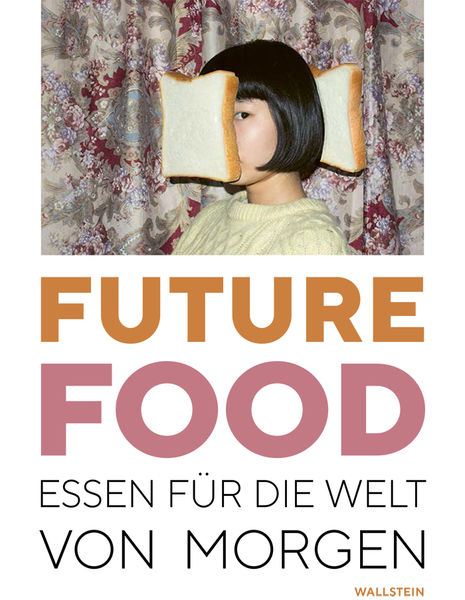
NOWs: Future Food
Michael Zee, Symmetry Breakfast / Fotografien, 2013 – 2019 © Michael Zee
Future Food. Essen für die Welt von morgenGroup exhibition with Andreas Greiner et al.
Deutsches Hygiene-Museum
Lingnerplatz 1
01069 Dresden
Stellen Sie sich einen Restaurantbesuch im Jahr 2050 vor. Was wird auf Ihrem Teller liegen – das gute alte Schnitzel, ein Gemüse-Burger oder Fleisch, das im Labor gezüchtet wurde? Oder wird Ihr Teller leer bleiben, weil eine auf zehn Milliarden Menschen angewachsene Weltbevölkerung schlicht nicht mehr satt zu bekommen ist?
Die Ausstellung Future Food. Essen für die Welt von morgen konfrontiert Sie mit einer der größten Herausforderungen unserer Zeit. In drei Kapiteln folgen Sie dem Weg unserer Lebensmittel vom Stall oder Feld bis auf den Tisch. Es geht um Themen wie globale Verteilungsgerechtigkeit, um vegetarische Ernährung oder die Macht der großen Lebensmittelkonzerne. Und natürlich geht es um das Essen als Erlebnis voller Genuss, das Identität und Gemeinschaft stiftet.
Die Ausstellung zeigt, dass die Zukunft der Welternährung von politischen Weichenstellungen, aber auch von persönlichen Entscheidungen abhängen wird. Neben musealen Exponaten präsentiert Future Food interaktive Medien, Videoinstallationen, wissenschaftliche Prototypen sowie künstlerische Positionen. Nützliches Faktenwissen vermittelt die Ausstellung in anschaulichen Wandgrafiken.
Historische Dokumente und Objekte erzählen von Ideen, die ihrer Zeit weit voraus waren, und von solchen, die an den Gesetzen des Markts und den Gewohnheiten der Konsument*innen scheiterten. Bei Ihrem Rundgang durch ein Gewächshaus, ein Logistikzentrum, einen Supermarkt und an einer Festtafel können Sie sich die Frage stellen: Werden WIR es künftig besser machen?
Beteiligte Künstler*innen und Designer*innen
Wojtek Doroszuk, Kasia Fudakowski, Andreas Greiner, Jinhyun Jeon, Ana Lira, NEFF & Reiko Kaneko, Laura López, Izumi Miyazaki, Neozoon, Haley Morris-Caf iero, Ingrid Pollard, Stephanie De Rouge, Carolin Schulze, Taryn Simon, Michael Zee
Kuratorin und Projektleiterin: Viktoria Krason
Begleitpublikation: Future Food. Essen für die Welt von morgen. Herausgegeben von Anna-Lisa Dieter und Viktoria Krason für das Deutsche Hygiene-Museum Dresden. Wallstein Verlag, Göttingen 2020, 176 Seiten, 19,90 €
Michael Zee, Symmetry Breakfast / Fotografien, 2013 – 2019 © Michael Zee
Future Food. Essen für die Welt von morgenGroup exhibition with Andreas Greiner et al.
Deutsches Hygiene-Museum
Lingnerplatz 1
01069 Dresden
Stellen Sie sich einen Restaurantbesuch im Jahr 2050 vor. Was wird auf Ihrem Teller liegen – das gute alte Schnitzel, ein Gemüse-Burger oder Fleisch, das im Labor gezüchtet wurde? Oder wird Ihr Teller leer bleiben, weil eine auf zehn Milliarden Menschen angewachsene Weltbevölkerung schlicht nicht mehr satt zu bekommen ist?
Die Ausstellung Future Food. Essen für die Welt von morgen konfrontiert Sie mit einer der größten Herausforderungen unserer Zeit. In drei Kapiteln folgen Sie dem Weg unserer Lebensmittel vom Stall oder Feld bis auf den Tisch. Es geht um Themen wie globale Verteilungsgerechtigkeit, um vegetarische Ernährung oder die Macht der großen Lebensmittelkonzerne. Und natürlich geht es um das Essen als Erlebnis voller Genuss, das Identität und Gemeinschaft stiftet.
Die Ausstellung zeigt, dass die Zukunft der Welternährung von politischen Weichenstellungen, aber auch von persönlichen Entscheidungen abhängen wird. Neben musealen Exponaten präsentiert Future Food interaktive Medien, Videoinstallationen, wissenschaftliche Prototypen sowie künstlerische Positionen. Nützliches Faktenwissen vermittelt die Ausstellung in anschaulichen Wandgrafiken.
Historische Dokumente und Objekte erzählen von Ideen, die ihrer Zeit weit voraus waren, und von solchen, die an den Gesetzen des Markts und den Gewohnheiten der Konsument*innen scheiterten. Bei Ihrem Rundgang durch ein Gewächshaus, ein Logistikzentrum, einen Supermarkt und an einer Festtafel können Sie sich die Frage stellen: Werden WIR es künftig besser machen?
Beteiligte Künstler*innen und Designer*innen
Wojtek Doroszuk, Kasia Fudakowski, Andreas Greiner, Jinhyun Jeon, Ana Lira, NEFF & Reiko Kaneko, Laura López, Izumi Miyazaki, Neozoon, Haley Morris-Caf iero, Ingrid Pollard, Stephanie De Rouge, Carolin Schulze, Taryn Simon, Michael Zee
Kuratorin und Projektleiterin: Viktoria Krason
Begleitpublikation: Future Food. Essen für die Welt von morgen. Herausgegeben von Anna-Lisa Dieter und Viktoria Krason für das Deutsche Hygiene-Museum Dresden. Wallstein Verlag, Göttingen 2020, 176 Seiten, 19,90 €

NOWs: Mindscapes by Elise Eeraerts and Claude Cattelain
Mindscapesexhibition by Elise Eeraerts and Claude Cattelain
Opening
8 March, 3 pm – 7 pm
Plagiarama
Rivoli Building C24
690 chaussée de Waterloo / Waterloosesteenweg
Brussels, Belgium
exhibition concept by Yuna Mathieu-Chovet
The works of Elise Eeraerts and Claude Cattelain rely upon strong ties that unite them to the materials they work with. They both work from simple raw material, with only light transformations. Transfers, movements and balances of materials are at the heart of their practices, with particular attention paid to prehistoric and early cultures.
Elise Eeraerts presents soil samples containing several centuries of geological history. She considers human traces on nature, as well as the scientific, mathematical and chemical representations of it, and she is interested in the geometry resulting from observations. Her most recent works on metals and their conductive qualities has led her to work with technological means.
Claude Cattelain challenges the environment through performance. The place of the body is central: a “ferryman”, the center of intention, is the one who relates human construction to nature. His works are commensurate to his own body. He is attached to ancestral gestures and rituals: leaving a trace in the clay, placing objects in balance or igniting an object. He expresses the body as a support that distributes energies.
The artists question their environment by showing a keen interest in the landscape, nature and the human impact on its biotope, both personally and collectively. By using the notion of landscape in relation to humans, the artists are returning to interiority, while including the human in its context. They highlight that access to outside is made through inside and invite us to observe our own mental landscape.
Mindscapesexhibition by Elise Eeraerts and Claude Cattelain
Opening
8 March, 3 pm – 7 pm
Plagiarama
Rivoli Building C24
690 chaussée de Waterloo / Waterloosesteenweg
Brussels, Belgium
exhibition concept by Yuna Mathieu-Chovet
The works of Elise Eeraerts and Claude Cattelain rely upon strong ties that unite them to the materials they work with. They both work from simple raw material, with only light transformations. Transfers, movements and balances of materials are at the heart of their practices, with particular attention paid to prehistoric and early cultures.
Elise Eeraerts presents soil samples containing several centuries of geological history. She considers human traces on nature, as well as the scientific, mathematical and chemical representations of it, and she is interested in the geometry resulting from observations. Her most recent works on metals and their conductive qualities has led her to work with technological means.
Claude Cattelain challenges the environment through performance. The place of the body is central: a “ferryman”, the center of intention, is the one who relates human construction to nature. His works are commensurate to his own body. He is attached to ancestral gestures and rituals: leaving a trace in the clay, placing objects in balance or igniting an object. He expresses the body as a support that distributes energies.
The artists question their environment by showing a keen interest in the landscape, nature and the human impact on its biotope, both personally and collectively. By using the notion of landscape in relation to humans, the artists are returning to interiority, while including the human in its context. They highlight that access to outside is made through inside and invite us to observe our own mental landscape.
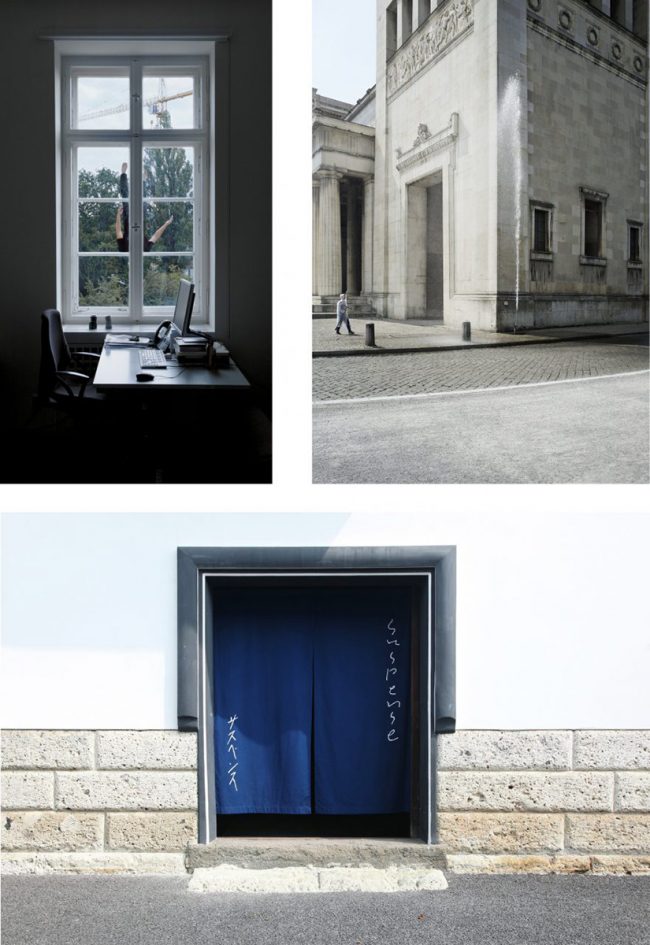
NOWs: suspense by Fabian Knecht, Yuichiro Tamura, Raul Walch
top left: Fabian Knecht, still from Genitiv, 2017;
top right: Raul Walch, Eureka (Königsplatz Munich), 2018;
bottom: Yuichiro Tamura, suspense, 2020
suspensegroup exhibition by Fabian Knecht, Yuichiro Tamura, Raul Walch
Yuka Tsuruno Gallery
1-33-10-3F
Higashi-Shinagawa
Shinagawa-ku
Tokyo, Japan
Yuka Tsuruno Gallery is pleased to present a three person show suspense with Fabian Knecht, Yuichiro Tamura, and Raul Walch, from March 7th to April 4th, 2020. The dialogue between these three artists, which emerged from their time together in 2013 at the Institut für Raumexperimente, Berlin University of the Arts led by Olafur Eliasson, has continued to present day as their paths cross globally. An examination of the common practices and aesthetic languages present in the three artists’ works allows for a renewed reading of their works.
Among Knecht, Tamura, and Walch, all three have developed their practices by engaging with diverse media such as photography, video, installation, public intervention, and performance. In this exhibition, the works on view elicit intangible relationships and de-stabilize the inherent norm by interrupting the contours of social codes, meanings, and histories associated to spaces, locations, things, and events, and assembling hypothetical, dissimilative circumstances.
The title suspense, like the genre, points to the psychological state of continued internal tension in the audience as the plot approaches its conclusion, but this can also allude to “the prolonged state of being suspended.” This “state of being suspended” appears in the work of the three artists as a trajectory of ephemeral exercise in the form of repetition without end, fixed vertical motion, and floating objects.
For example, in Genitiv (2017), a work by Fabian Knecht, who often presents work that dismantles the framework of “exhibitions,” a man plunging is seen through a window of the Hamburger Bahnhof – Museum für Gegenwart in Berlin; in Yuichiro Tamura’s C’s Ladder, N’s Ashbins (2020) and suspense (2020), a ladder and ashbins intended for falling, as well as a hanging curtain are displayed; in Raul Walch’s public intervention Eureka (2016/2018), the projectile water that should strike the ground and disappear is captured momentarily. These works which retain the process that confronts an event even while anticipating its ending, and concern the motion of hovering in space, induce the simultaneously physical and immaterial temporality and its recurrence. At the opening reception, there will be a performance of Raul Walch’s intervention Eureka Tokyo.
-
Fabian Knecht
Born 1980 in Magdeburg, Fabian Knecht studied at the Universität der Künste Berlin and at the California Institute of the Arts. In 2014 he completed his master’s degree with Olafur Eliasson, at whose Institut für Raumexperimente he studied from 2009 to 2014. In 2012 he assisted in the studio of Matthew Barney in New York. Fabian Knecht’s works have been shown in national and international institutions and exhibitions, among them the MSU Museum for Contemporary Art (Zagreb), the Moscow International Biennale for Young Art, the Neue Nationalgalerie (Berlin), Hamburger Bahnhof (Berlin), the Imperial War Museum (London), and the Staatliche Kunsthalle Baden-Baden.
Yuichiro Tamura
Born 1977 in Toyama, Yuichiro Tamura lives and works in Kyoto. He holds a doctoral degree from the Graduate School of Film and New Media, Tokyo University of the Arts. He was a guest researcher for the Institut für Raumexperimente at the Berlin University of the Arts. His recent solo exhibitions include Milky Mountain (Govett-Brewster Art Gallery, New Zealand, 2019) and Hell Scream (@KCUA, Kyoto, 2018), and group shows include Asian Art Biennial (National Taiwan Museum of Fine Arts, Taichung, 2019), Image Narratives: Literature in Japan (National Art Center, Tokyo, 2019), Roppongi Crossing 2019: Connexions (Mori Art Museum, Tokyo), Busan Biennale (Museum of Contemporary Art Busan, 2018), Nissan Art Award 2017 (BankART Studio NYK, Yokohama), and 2 or 3 Tigers (Haus der Kulturen der Welt, Berlin, 2017).
Raul Walch
Born in 1980, Raul Walch began studying sculpture at the Kunsthochschule Berlin-Weißensee, completed his studies Freien Kunst (free art) at the University of the Arts in Berlin with Olafur Eliasson and became a scholarship holder at Institut für Raumexperimente Berlin. His work has been exhibited at the Neue Nationalgalerie Berlin, Hamburger Bahnhof Berlin, Kunsthaus Dresden, and Kunstverein Arnsberg. Numerous artist-in-residence programs have made it possible to work internationally, such as Tokyo Arts and Space, the Nida Art Colony, and the Hessian Cultural Foundation. Walch currently teaches “Public Art and New Artistic Strategies” at the Bauhaus-University Weimar.
top left: Fabian Knecht, still from Genitiv, 2017; top right: Raul Walch, Eureka (Königsplatz Munich), 2018; bottom: Yuichiro Tamura, suspense, 2020
suspensegroup exhibition by Fabian Knecht, Yuichiro Tamura, Raul Walch
Yuka Tsuruno Gallery
1-33-10-3F
Higashi-Shinagawa
Shinagawa-ku
Tokyo, Japan
Yuka Tsuruno Gallery is pleased to present a three person show suspense with Fabian Knecht, Yuichiro Tamura, and Raul Walch, from March 7th to April 4th, 2020. The dialogue between these three artists, which emerged from their time together in 2013 at the Institut für Raumexperimente, Berlin University of the Arts led by Olafur Eliasson, has continued to present day as their paths cross globally. An examination of the common practices and aesthetic languages present in the three artists’ works allows for a renewed reading of their works.
Among Knecht, Tamura, and Walch, all three have developed their practices by engaging with diverse media such as photography, video, installation, public intervention, and performance. In this exhibition, the works on view elicit intangible relationships and de-stabilize the inherent norm by interrupting the contours of social codes, meanings, and histories associated to spaces, locations, things, and events, and assembling hypothetical, dissimilative circumstances.
The title suspense, like the genre, points to the psychological state of continued internal tension in the audience as the plot approaches its conclusion, but this can also allude to “the prolonged state of being suspended.” This “state of being suspended” appears in the work of the three artists as a trajectory of ephemeral exercise in the form of repetition without end, fixed vertical motion, and floating objects.
For example, in Genitiv (2017), a work by Fabian Knecht, who often presents work that dismantles the framework of “exhibitions,” a man plunging is seen through a window of the Hamburger Bahnhof – Museum für Gegenwart in Berlin; in Yuichiro Tamura’s C’s Ladder, N’s Ashbins (2020) and suspense (2020), a ladder and ashbins intended for falling, as well as a hanging curtain are displayed; in Raul Walch’s public intervention Eureka (2016/2018), the projectile water that should strike the ground and disappear is captured momentarily. These works which retain the process that confronts an event even while anticipating its ending, and concern the motion of hovering in space, induce the simultaneously physical and immaterial temporality and its recurrence. At the opening reception, there will be a performance of Raul Walch’s intervention Eureka Tokyo.
-
Fabian Knecht
Born 1980 in Magdeburg, Fabian Knecht studied at the Universität der Künste Berlin and at the California Institute of the Arts. In 2014 he completed his master’s degree with Olafur Eliasson, at whose Institut für Raumexperimente he studied from 2009 to 2014. In 2012 he assisted in the studio of Matthew Barney in New York. Fabian Knecht’s works have been shown in national and international institutions and exhibitions, among them the MSU Museum for Contemporary Art (Zagreb), the Moscow International Biennale for Young Art, the Neue Nationalgalerie (Berlin), Hamburger Bahnhof (Berlin), the Imperial War Museum (London), and the Staatliche Kunsthalle Baden-Baden.
Yuichiro Tamura
Born 1977 in Toyama, Yuichiro Tamura lives and works in Kyoto. He holds a doctoral degree from the Graduate School of Film and New Media, Tokyo University of the Arts. He was a guest researcher for the Institut für Raumexperimente at the Berlin University of the Arts. His recent solo exhibitions include Milky Mountain (Govett-Brewster Art Gallery, New Zealand, 2019) and Hell Scream (@KCUA, Kyoto, 2018), and group shows include Asian Art Biennial (National Taiwan Museum of Fine Arts, Taichung, 2019), Image Narratives: Literature in Japan (National Art Center, Tokyo, 2019), Roppongi Crossing 2019: Connexions (Mori Art Museum, Tokyo), Busan Biennale (Museum of Contemporary Art Busan, 2018), Nissan Art Award 2017 (BankART Studio NYK, Yokohama), and 2 or 3 Tigers (Haus der Kulturen der Welt, Berlin, 2017).
Raul Walch
Born in 1980, Raul Walch began studying sculpture at the Kunsthochschule Berlin-Weißensee, completed his studies Freien Kunst (free art) at the University of the Arts in Berlin with Olafur Eliasson and became a scholarship holder at Institut für Raumexperimente Berlin. His work has been exhibited at the Neue Nationalgalerie Berlin, Hamburger Bahnhof Berlin, Kunsthaus Dresden, and Kunstverein Arnsberg. Numerous artist-in-residence programs have made it possible to work internationally, such as Tokyo Arts and Space, the Nida Art Colony, and the Hessian Cultural Foundation. Walch currently teaches “Public Art and New Artistic Strategies” at the Bauhaus-University Weimar.
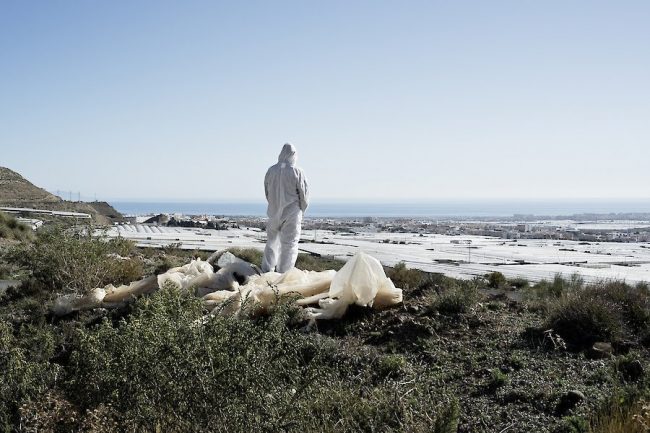
NOWs: Zero Waste
Zero Wastegroup exhibition with Andreas Greiner, Raul Walch et al.
Museum der bildenden Künste Leipzig
Katharinenstraße 10
04109 Leipzig
Opening
26 March, 6 pm
Waste is everywhere: in the Great Pacific garbage patch, as fine particular matter in the air, or as microplastics in the food chain. The group exhibition Zero Waste showcases international positions in contemporary art that point out the urgency to save resources, consume less, and live more sustainably. In diverse installations, videos, sculptural works, and photographs the artists investigate the global consequences of plastic packaging, tire abrasion, toxic chemicals, and the overproduction of consumer goods. Zero Waste will be realized by the German Environment Agency in cooperation with the MdbK and curated by Hannah Beck-Mannagetta and Lena Fließbach.
Every day shreds from the horticultural greenhouses in southern Spain, also known as “El Mar de Plástico”, drift into the sea – Raul Walch uses these remnants as material for his expansive kinetic objects. For their video work the artist duo Irwan Ahmett & Tita Salina transferred a small fish from a polluted water in Jakarta to a crystal-clear river. Erik Sturm scrapes fine dust from window sills along heavily trafficked streets for producing paint, whereas Swaantje Güntzel’s photographs and objects illustrate the effects microplastics have in cosmetics and on marine creatures. In his laboratory Dani Ploeger experiments with manufacturers’ intentional obsolescence of electronic devices, and Eliana Heredia’s installation works with disposable products and cleaning agents.
The exhibition takes a critical look at the current condition of our planet but also aims to imagine possible solutions, encourage alternative scopes of action, and propose visions for the future. While questioning the lifestyle of the international jet set as well as the lavish use of materials in the art world, the project follows self-imposed climate-friendly rules in an attempt to make its own carbon footprint transparent and to compensate it.
Exhibiting artists: Irwan Ahmett & Tita Salina, Michel de Broin, Nadine Fecht, Vibha Galhotra, Tue Greenfort, Andreas Greiner, Swaantje Güntzel, Eliana Heredia, Bianca Kennedy & The Swan Collective, Wolf von Kries, Christoph Medicus, Klara Meinhardt, Alexander Oelofse, Kadija de Paula & Chico Togni, Dani Ploeger, Mika Rottenberg, Erik Sturm, Raul Walch
Zero Waste will be accompanied by an extensive program of events, including interactive tours and performances, film talks, DIY workshops, and repair cafés. The program is supported by the Fonds Soziokultur e. V.
Irwan Ahmett & Tita Salina, Very Very Important Fish (Still), 2013, Credit to Logout Corps, Jakarta 32°, © Künstlerduo
Michel de Brain, Shared Propulsion Car, 2005, Stills aus der Videodokumentation New York 2015, © Künstler
Vibha Galhotra, Breath by Breath, 2016/17, Foto: Rajesh Kumar, © Künstlerin
Swaantje Güntzel, Mikroplastik II, 2016, Foto: Henriette Pogoda, © VG Bild-Kunst Bonn, 2020
Christoph Medicus, Miss calculations poetry is the working class heroin (Unterschlupf), 2016, Ausstellungsansicht Betakontext Berlin, 2016), © VG Bild-Kunst Bonn, 2020
Zero WasteGruppenausstellung mit Andreas Greiner, Raul Walch et al.
Museum der bildenden Künste Leipzig
Katharinenstraße 10
04109 Leipzig
Eröffnung
26. März, 18 h
Müll ist überall: als gigantischer Strudel im Pazifik, Feinstaub in der Luft und Mikroplastik in der Nahrungskette. Die Gruppenausstellung Zero Waste zeigt internationale Positionen zeitgenössischer Kunst, die auf die Dringlichkeit verweisen, Ressourcen zu schonen, weniger zu konsumieren und nachhaltiger zu leben. In Installationen, Videos, Skulpturen und Fotografien untersuchen die beteiligten KünstlerInnen globale Konsequenzen von Plastikverpackungen, Reifenabrieb, giftigen Chemikalien und Überproduktion. Zero Waste wird realisiert vom Umweltbundesamt in Kooperation mit dem MdbK und kuratiert von Hannah Beck-Mannagetta und Lena Fließbach.
Täglich verwehen Fetzen der als „mar de plástico“ bekannten Gemüseplantagen in Südspanien ins Meer. Raul Walch dienen sie als Material für sein raumgreifendes Mobile. Das Künstlerduo Irwan Ahmett und Tita Salina überführt für seine Videoarbeit einen kleinen Fisch von einem vermüllten Gewässer in Jakarta in einen kristallklaren Fluss. Während Erik Sturm Feinstaub von Fensterbänken stark befahrener Straßen kratzt, um daraus Farbe herzustellen, führt Swaantje Güntzel in ihren Fotografien und Objekten die Auswirkungen von Mikroplastik aus Kosmetikprodukten auf Meerestiere vor Augen. In seinem Labor experimentiert Dani Ploeger mit dem von Herstellern bewusst herbeigeführten Alterungsprozess elektronischer Geräte und Eliana Heredia arbeitet in ihrer Installation mit Wegwerfprodukten und Reinigungsmitteln.
Die Ausstellung möchte nicht nur einen kritischen Blick auf den aktuellen Zustand unserer Erde werfen, sondern Lösungsansätze diskutieren, zu alternativen Handlungsmöglichkeiten anregen und Visionen für die Zukunft entwerfen. Nicht zuletzt hinterfragt das Projekt auch den verschwenderischen Umgang mit Ressourcen in der Kunstwelt sowie den CO2-Fußabdruck der Ausstellung selbst.
Zero Waste wird von einem umfangreichen Veranstaltungsprogramm begleitet. Führungen und Filmgespräche mit Aktivist_innen und Wissenschaftler_innen sowie Performances wie das interaktive „Black-Cloud“-Drachenfliegen von Vibha Galhotra oder die Zero-Waste-Küche von Kadija de Paula und Chico Togni erweitern die Ausstellung ebenso wie DIY-Workshops und Repair Cafés mit lokalen Partner_innen für Kinder und Erwachsene. Das Programm wird ergänzend mit freundlicher Unterstützung des Fonds Soziokultur e.V. realisiert.
Zero Waste präsentiert Arbeiten von Irwan Ahmett & Tita Salina, Michel de Broin, Nadine Fecht, Vibha Galhotra, Tue Greenfort, Andreas Greiner, Swaantje Güntzel, Eliana Heredia, Bianca Kennedy & The Swan Collective, Wolf von Kries, Christoph Medicus, Klara Meinhardt, Alexander Oelofse, Kadija de Paula & Chico Togni, Dani Ploeger, Mika Rottenberg, Erik Sturm und Raul Walch.
Zero Waste realisiert das Umweltbundesamt innerhalb seiner Programmreihe „Kunst und Umwelt“. Wie können und wollen wir in Zukunft leben, ohne unsere Lebensgrundlage zu zerstören? Wie können wir lernen, neue Wege zu denken? Und wie kommen wir vom Wissen zum Handeln? Kunst und Kultur können einen wesentlichen Beitrag zum gesellschaftlichen Verständigungsprozess über Zukunftschancen und nachhaltige Entwicklung in unserer Gesellschaft leisten. Seit Mitte der achtziger Jahre pflegt das Umweltbundesamt, Deutschlands zentrale Umweltbehörde, deshalb mittels dieser Reihe den Dialog mit Kunstschaffenden.
Irwan Ahmett & Tita Salina, Very Very Important Fish (Still), 2013, Credit to Logout Corps, Jakarta 32°, © Künstlerduo
Michel de Brain, Shared Propulsion Car, 2005, Stills aus der Videodokumentation New York 2015, © Künstler
Vibha Galhotra, Breath by Breath, 2016/17, Foto: Rajesh Kumar, © Künstlerin
Swaantje Güntzel, Mikroplastik II, 2016, Foto: Henriette Pogoda, © VG Bild-Kunst Bonn, 2020
Christoph Medicus, Miss calculations poetry is the working class heroin (Unterschlupf), 2016, Ausstellungsansicht Betakontext Berlin, 2016), © VG Bild-Kunst Bonn, 2020
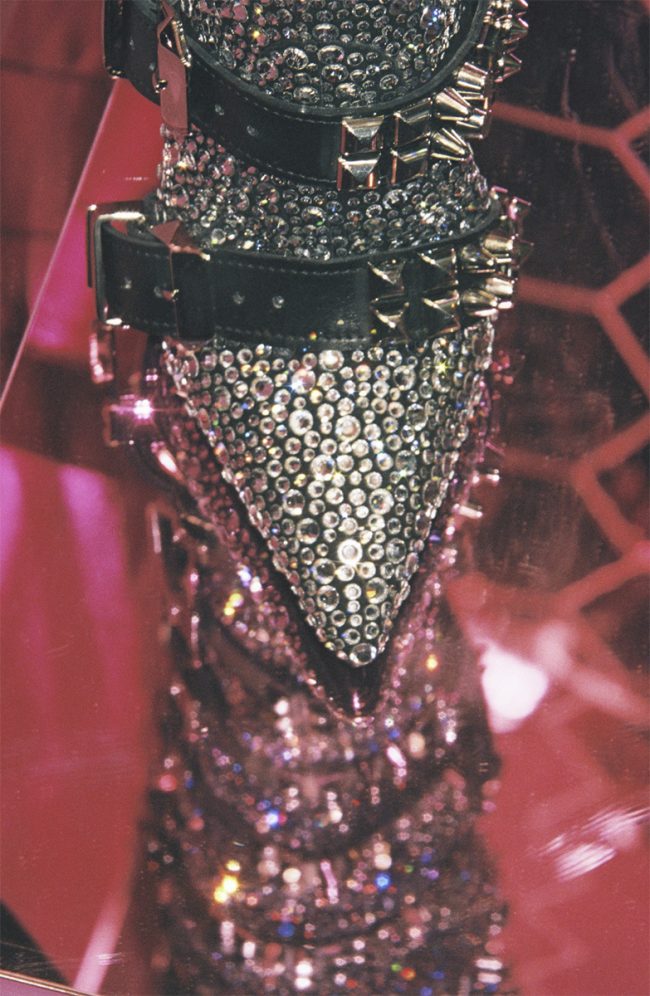
NOWs: Chic by Bruno Zhu
Chicsolo exhibition by Bruno Zhu
Opening
5 March, 7 pm
Fragile
Leipzigerstraße 63
10117 Berlin
Fragile is pleased to announce the collaboration with Bruno Zhu for his solo show Chic.
I kept returning to ‘whys’. Back then as I photographed: why the vertical format, why the raised, fallen figures? And now: why the recurring scenes, why bodies, events in arousal? Heat. Perhaps it never was about photographing ‘sex’, but about being driven by it, so a parallel between the camera lens and the phallus is drawn. Shooting, jerking, pressing. Constantly stunted by the shutter and the membrane.
Proverbs like ‘curiosity killed the cat’ or ‘Peeping Tom’ came to mind. They are folky warnings to not look beyond one’s means. But what if one does, what would one see? Peeping Tom went blind after spying Lady Godiva on her horse riding naked down the streets. And even though my work is not about Tom, it was poignant to remember cautionary tales where vision-knowledge-discovery are tied to human fatalism: when is an opportunity too risky, when is a cut too deep? Ah, according to folklore, Tom was a tailor!
About FRAGILE
FRAGILE fosters a program of conversation, antagonism, renegotiation, and celebration.
FRAGILE is a non-profit project for contemporary artistic practices located in Berlin. It encompasses an exhibition and a residency space.
FRAGILE is guided by curations etymology, the practice of caring and was founded on the warmest summerday of 2018 by Maurin Dietrich and Jonas Wendelin.
Chicsolo exhibition by Bruno Zhu
Opening
5 March, 7 pm
Fragile
Leipzigerstraße 63
10117 Berlin
Fragile is pleased to announce the collaboration with Bruno Zhu for his solo show Chic.
I kept returning to ‘whys’. Back then as I photographed: why the vertical format, why the raised, fallen figures? And now: why the recurring scenes, why bodies, events in arousal? Heat. Perhaps it never was about photographing ‘sex’, but about being driven by it, so a parallel between the camera lens and the phallus is drawn. Shooting, jerking, pressing. Constantly stunted by the shutter and the membrane.
Proverbs like ‘curiosity killed the cat’ or ‘Peeping Tom’ came to mind. They are folky warnings to not look beyond one’s means. But what if one does, what would one see? Peeping Tom went blind after spying Lady Godiva on her horse riding naked down the streets. And even though my work is not about Tom, it was poignant to remember cautionary tales where vision-knowledge-discovery are tied to human fatalism: when is an opportunity too risky, when is a cut too deep? Ah, according to folklore, Tom was a tailor!
About FRAGILE
FRAGILE fosters a program of conversation, antagonism, renegotiation, and celebration.
FRAGILE is a non-profit project for contemporary artistic practices located in Berlin. It encompasses an exhibition and a residency space.
FRAGILE is guided by curations etymology, the practice of caring and was founded on the warmest summerday of 2018 by Maurin Dietrich and Jonas Wendelin.
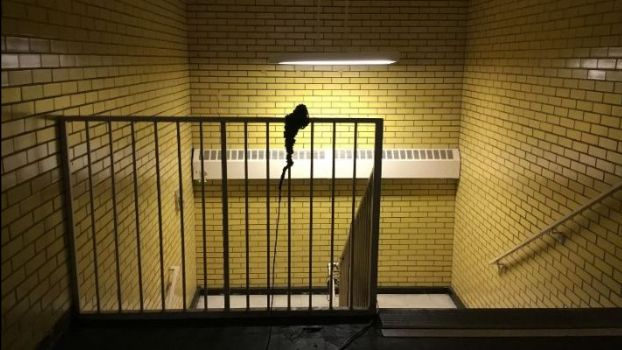
NOWs: Environment. A Future Retrospective
Environment: A Future Retrospectivesolo exhibition by Zorka Wollny
Overtone Hive - installation at Chicago Architecture Biennial 2019
Zorka Wollny
Environment: A Future Retrospective
curated by Joanna Warsza
TRAFO Center for Contemporary Art
Świętego Ducha st. 4, Szczecin
Opening
Saturday, February 15th, 14.00-20.00
exhibition runs until March 29thThe environment is typically a system of interpenetrating animate and inanimate elements. Zorka Wollny’s environment is acoustic, anthropogenic, artistic, degraded and animated. It comprises artworks, performances, and interactive installations, such as acoustic birds’ nests, sensory cushions made from buoys, and carpets of broken glass. The exhibition is mostly constructed from objects removed from their daily functions in Szczecin and surroundings, for example in a shipyard, paper mill, or cable factory. Some of these objects will be repaired and then restored to operation after the show closes.The works presented at the exhibition were created in collaboration with the following artists: Christine Schörkhuber, Kalle Enkellman, Jasmine Guffond, Małgorzata Mazur, Psychedelic Choir, Andrzej Wasilewski, N.U Unruh (Einstürzende Neubauten).
Commissioned by TRAFO Center for Contemporary Art in Szczecin in collaboration with CTM Festival 2020 Berlin, the Chicago Architecture Biennial, and the steirischer herbst festival, with support from Senat Berlin, Szczecin Shipyard and Habia Cable.
Jan Baszak preparing parts for the exhibition
OPENING SCHEDULE
Saturday / 15.02.2020
14.00-20.00 – Open Door
15.30 – Introduction Stanisław Ruksza, Joanna Warsza, Zorka Wollny and team
16.00 – Curatorial guided tour by Joanna Warsza (PL)
16.00-17.00 – Coffee table conversations with the team Ada Kusiak, Jędrzej Wijas, Andrzej Witczak about preapring the show
16.30-18.00 – Drum workshop/conversation with N.U. Unruh/Einstürzende Neubauten
16.30-18.00 – Coffee table conversations with Ewa Majewska about the planet, feminism and weak resistance
17.00-17.30 – Curatorial guided tour by Joanna Warsza (EN)
18.00 – Concert N.U. Unruh/Einstürzende Neubauten
19.00 – Concert Psychedelic Choir
at Stettin Shipyard with N.U Unruh
Environment: A Future Retrospectivesolo exhibition by Zorka Wollny
Overtone Hive - installation at Chicago Architecture Biennial 2019
Zorka Wollny
Environment: A Future Retrospective
curated by Joanna Warsza
TRAFO Center for Contemporary Art
Świętego Ducha st. 4, Szczecin
Opening
Saturday, February 15th, 14.00-20.00
exhibition runs until March 29thThe environment is typically a system of interpenetrating animate and inanimate elements. Zorka Wollny’s environment is acoustic, anthropogenic, artistic, degraded and animated. It comprises artworks, performances, and interactive installations, such as acoustic birds’ nests, sensory cushions made from buoys, and carpets of broken glass. The exhibition is mostly constructed from objects removed from their daily functions in Szczecin and surroundings, for example in a shipyard, paper mill, or cable factory. Some of these objects will be repaired and then restored to operation after the show closes.
The works presented at the exhibition were created in collaboration with the following artists: Christine Schörkhuber, Kalle Enkellman, Jasmine Guffond, Małgorzata Mazur, Psychedelic Choir, Andrzej Wasilewski, N.U Unruh (Einstürzende Neubauten).
Commissioned by TRAFO Center for Contemporary Art in Szczecin in collaboration with CTM Festival 2020 Berlin, the Chicago Architecture Biennial, and the steirischer herbst festival, with support from Senat Berlin, Szczecin Shipyard and Habia Cable.
Jan Baszak preparing parts for the exhibition
OPENING SCHEDULE
Saturday / 15.02.2020
14.00-20.00 – Open Door
15.30 – Introduction Stanisław Ruksza, Joanna Warsza, Zorka Wollny and team
16.00 – Curatorial guided tour by Joanna Warsza (PL)
16.00-17.00 – Coffee table conversations with the team Ada Kusiak, Jędrzej Wijas, Andrzej Witczak about preapring the show
16.30-18.00 – Drum workshop/conversation with N.U. Unruh/Einstürzende Neubauten
16.30-18.00 – Coffee table conversations with Ewa Majewska about the planet, feminism and weak resistance
17.00-17.30 – Curatorial guided tour by Joanna Warsza (EN)
18.00 – Concert N.U. Unruh/Einstürzende Neubauten
19.00 – Concert Psychedelic Choir
at Stettin Shipyard with N.U Unruh
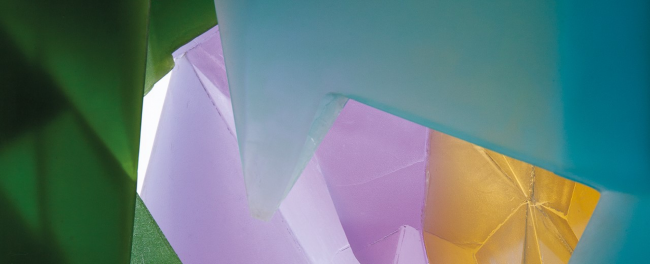
NOWs: Glass and Concrete. Manifestations of the Impossible
Glass and Concrete. Manifestations of the Impossiblegroup exhibition with Elín Hansdóttir et al.
Kai Schiemenz, Four-Colour Block (Detail), 2015, Glas, Betonsockel, 124 x 74 x 65 cm
Marta Herford
Goebenstraße 2–10
32052 Herford
Opening
28 February, 7:30 pm
Fragile delicacy or cool grandeur? Iridescent brilliance or brittle surface? Despite their apparent differences, glass and concrete are connected by a long history.
Like almost no other material they are associated with great architectural visions: from brightly illuminated church buildings to military fortifications, right up to functional domestic appliances. The artists in the exhibition react not only to the changed life in the metropolises of the world. Like in an alchemist’s laboratory, they explore the path of the material between flowing and setting, testing the limits of the possible to pose new questions about crumbling social concepts. Constructions of glass and concrete are staged elegantly and brutally while at the same time energetically shattering the apparent beauty of a hollowed-out metaphor.
In cooperation with Anne Schloen, Cologne
Artists:
Francis Alÿs, Peter Bialobrzeski, Oliver Boberg, Matti Braun, Andreas Bunte, Daniel Buren, Louisa Clement, Louis De Cordier, Alia Farid, Nina Fischer & Maroan el Sani, Thomas Florschuetz, Daniela Friebel, Vincent Ganivet, Jakub Geltner, Isa Genzken, Elín Hansdóttir, Mona Hatoum, Philipp Hennevogl, Stephan Huber, Thomas Huber, Aernoudt Jacobs, Jeffrey James, Isa Melsheimer, Jan Muche, Martin Mühlhoff & Christian Vossiek, Olaf Pernice, Túlio Pinto, Robin Rhode, Kilian Rüthemann, Kai Schiemenz, Wolfgang Schlegel, Adrien Tirtiaux, Tatiana Trouvé, Lena von Goedeke, Martin Walde (in cooperation with Bernd Weinmayer).
Glas und Beton. Manifestationen des UnmöglichenGruppenausstellung mit Elín Hansdóttir et al.
Kai Schiemenz, Four-Colour Block (Detail), 2015, Glas, Betonsockel, 124 x 74 x 65 cm
Marta Herford
Goebenstraße 2–10
32052 Herford
Eröffnung
28. Februar, 19:30 h
Fragile Zartheit oder kühle Erhabenheit? Schillernder Glanz oder spröde Oberfläche? Trotz ihrer augenscheinlichen Unterschiede besitzen Glas und Beton eine lange gemeinsame Geschichte.
Wie kaum ein anderes Material sind sie mit großen Architekturvisionen verbunden: von hell durchfluteten Kirchenbauten über militärische Festungen bis hin zu funktionalen Wohnmaschinen. Die Künstler*innen der Ausstellung reagieren nicht nur auf das veränderte Leben in den Metropolen dieser Welt. Wie in einem alchemistischen Labor erkunden sie selbst den Weg des Materials zwischen Fließen und Erstarren, testen die Grenzen des Möglichen aus, um brüchig gewordene Gesellschaftskonzepte neu zu befragen. Konstruktionen aus Glas und Beton werden elegant und brutal in Szene gesetzt, um zugleich den „schönen Schein“ einer ausgehöhlten Metaphorik energisch zu zerschmettern.
In Kooperation mit Anne Schloen, Köln
Künstler*innen:
Francis Alÿs, Peter Bialobrzeski, Oliver Boberg, Matti Braun, Andreas Bunte, Daniel Buren, Louisa Clement, Louis De Cordier, Alia Farid, Nina Fischer & Maroan el Sani, Thomas Florschuetz, Daniela Friebel, Vincent Ganivet, Jakub Geltner, Isa Genzken, Elín Hansdóttir, Mona Hatoum, Philipp Hennevogl, Stephan Huber, Thomas Huber, Aernoudt Jacobs, Jeffrey James, Isa Melsheimer, Jan Muche, Martin Mühlhoff & Christian Vossiek, Olaf Pernice, Túlio Pinto, Robin Rhode, Kilian Rüthemann, Kai Schiemenz, Wolfgang Schlegel, Adrien Tirtiaux, Tatiana Trouvé, Lena von Goedeke, Martin Walde (in cooperation with Bernd Weinmayer).

NOWs: Festival de l’Union, Tambacounda and The Rhythm of Giving and Taking, Dakar
Festival de l’Union, Tambacounda and The Rhythm of Giving and Taking, DakarGroup exhibition, lectures and talks
21 – 23 February
Festival de l’Union, Tambacounda
Centre Culturel Régional
Exhibition
With: Leone Contini, Aliou ‘Badou’ Diack, Binta Diaw, Saliou Diop, Thomas Dirrix, Jeewi Lee, Juan Pablo Macias, Raul Walch
Screening
With: Andreco, Julian Charriere, Kasia Fudakowski, Kahee Jeong, Mikhail Karikis, Raul Walch, Helen Zeru
Curated by Jeewi Lee and Raul Walch
Place de l’Hotel de Ville / city center
Theater Forum
With: Káddu Yaraax (Dakar), Ousmane Sinaré und Sikhou Diaby (Somankidi Coura, Mali)
28 February, 6 pm
Kër Thiossane, Dakar
Lectures and talks
With: Leone Contini, Binta Diaw, Jeewi Lee, Juan Pablo Macias, Negga Dou Tamba
Both collaborations in Tambacounda and Dakar mark the provisional conclusion of the artistic research and exhibition project SEEDS FOR FUTURE MEMORIES. Voicing the two ends of migration. In 2018, thirteen artists travelled to Sinthian, Senegal and Florence, Italy to confront the contemporary realities of colonialism, and to jointly develop an aesthetic and political dialogue. Hosts and partners were Villa Romana in Florence and the Thread Residency in Sinthian. In 2019, artistic works resulting from these researches were presented in three parallel exhibitions in Berlin and at Villa Romana in Florence followed by the symposium TRANSVERSE TRAJECTORIES.
Invited by the Senegalese acitivist, rapper and artist Negga Dou Tamba five artists – Leone Contini, Binta Diaw, Jeewi Lee, Juan Pablo Macias, Raul Walch – are now contributing to the Festival de l’Union in Tambacounda, joined by guests who were part of or whose paths have crossed with the project SEEDS in the past two years. This fifth edition of the festival is dedicated to the subject of environment, its preservation and its valuation. Negga Dou Tamba initiated the festival in 2016 as a big public event to praise the heritage, the common good and the power of imagination in Southeastern Senegal. Dozens of local, regional and international performers will participate in this joyful event.
Subsequently the artists Leone Contini, Binta Diaw, Jeewi Lee, Juan Pablo Macias and Negga Dou Tamba will reflect on the The Rhythm of Giving and Taking at Kër Thiossane in Dakar, a space for Art and Multimedia created in 2002. How do artists navigate in trans-cultural spaces contested with hierarchies of knowledge? What are the formats with which the artists respond to the site, to the issue of migration and to the festival’s major theme, ecology? The audience is invited to discuss collaborative artistic practices in a trans-continental context after a set of lectures and talks and to conclude the evening with a commonly created informal dinner.
www.ker-thiossane.org/
www.facebook.com/pg/festivaldelunion/
The Tambacounda region in Senegal is one of the major hubs of migration to Europe. Together with the Thread Residency in Sinthian, Senegal, the artist house Villa Romana started therefore a transcontinental exchange project in 2018. After exhibitions in Berlin and Florence and a symposium on rural art, the project returned to Tambacounda in February. At the invitation of the activist and rapper Negga Dou Tamba, the artists Binta Diaw, Leone Contini, Jeewi Lee, Juan Pablo Macias, Raul Walch participated in the 5th edition of the Festival de l’Union (21.-23.2.2020). Negga Dou Tamba initiated this hip-hop and cultural festival in 2016 as a major public event to praise the heritage, the common good and the imagination in Southeast Senegal. Curated by Agnes Stillger,”Intersection Tamba” included an exhibition, film screenings and theater. The project addressed the themes migration and ecology, but most importantly, participation was about building alternative relationships and giving international visibility to the region’s wealth and issues.
Festival de l’Union, Tambacounda and The Rhythm of Giving and Taking, DakarGroup exhibition, lectures and talks
21 – 23 February
Festival de l’Union, Tambacounda
Centre Culturel Régional
Exhibition
With: Leone Contini, Aliou ‘Badou’ Diack, Binta Diaw, Saliou Diop, Thomas Dirrix, Jeewi Lee, Juan Pablo Macias, Raul Walch
Screening
With: Andreco, Julian Charriere, Kasia Fudakowski, Kahee Jeong, Mikhail Karikis, Raul Walch, Helen Zeru
Curated by Jeewi Lee and Raul Walch
Place de l’Hotel de Ville / city center
Theater Forum
With: Káddu Yaraax (Dakar), Ousmane Sinaré und Sikhou Diaby (Somankidi Coura, Mali)
28 February, 6 pm
Kër Thiossane, Dakar
Lectures and talks
With: Leone Contini, Binta Diaw, Jeewi Lee, Juan Pablo Macias, Negga Dou Tamba
Both collaborations in Tambacounda and Dakar mark the provisional conclusion of the artistic research and exhibition project SEEDS FOR FUTURE MEMORIES. Voicing the two ends of migration. In 2018, thirteen artists travelled to Sinthian, Senegal and Florence, Italy to confront the contemporary realities of colonialism, and to jointly develop an aesthetic and political dialogue. Hosts and partners were Villa Romana in Florence and the Thread Residency in Sinthian. In 2019, artistic works resulting from these researches were presented in three parallel exhibitions in Berlin and at Villa Romana in Florence followed by the symposium TRANSVERSE TRAJECTORIES.
Invited by the Senegalese acitivist, rapper and artist Negga Dou Tamba five artists – Leone Contini, Binta Diaw, Jeewi Lee, Juan Pablo Macias, Raul Walch – are now contributing to the Festival de l’Union in Tambacounda, joined by guests who were part of or whose paths have crossed with the project SEEDS in the past two years. This fifth edition of the festival is dedicated to the subject of environment, its preservation and its valuation. Negga Dou Tamba initiated the festival in 2016 as a big public event to praise the heritage, the common good and the power of imagination in Southeastern Senegal. Dozens of local, regional and international performers will participate in this joyful event.
Subsequently the artists Leone Contini, Binta Diaw, Jeewi Lee, Juan Pablo Macias and Negga Dou Tamba will reflect on the The Rhythm of Giving and Taking at Kër Thiossane in Dakar, a space for Art and Multimedia created in 2002. How do artists navigate in trans-cultural spaces contested with hierarchies of knowledge? What are the formats with which the artists respond to the site, to the issue of migration and to the festival’s major theme, ecology? The audience is invited to discuss collaborative artistic practices in a trans-continental context after a set of lectures and talks and to conclude the evening with a commonly created informal dinner.
www.ker-thiossane.org/
www.facebook.com/pg/festivaldelunion/
The Tambacounda region in Senegal is one of the major hubs of migration to Europe. Together with the Thread Residency in Sinthian, Senegal, the artist house Villa Romana started therefore a transcontinental exchange project in 2018. After exhibitions in Berlin and Florence and a symposium on rural art, the project returned to Tambacounda in February. At the invitation of the activist and rapper Negga Dou Tamba, the artists Binta Diaw, Leone Contini, Jeewi Lee, Juan Pablo Macias, Raul Walch participated in the 5th edition of the Festival de l’Union (21.-23.2.2020). Negga Dou Tamba initiated this hip-hop and cultural festival in 2016 as a major public event to praise the heritage, the common good and the imagination in Southeast Senegal. Curated by Agnes Stillger,”Intersection Tamba” included an exhibition, film screenings and theater. The project addressed the themes migration and ecology, but most importantly, participation was about building alternative relationships and giving international visibility to the region’s wealth and issues.
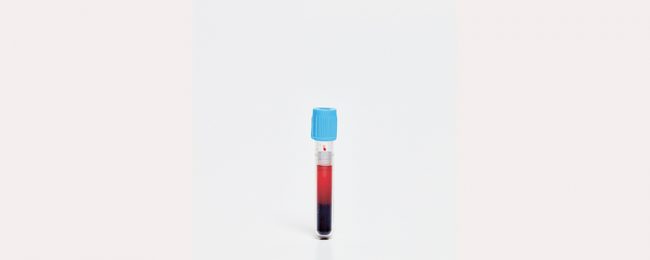
NOWs: DURST
DURSTgroup exhibition
Kunstraum Niederösterreich
Herrengasse 13
1014 Wien
Opening
31 March 2020
Artists: Inka ter Haar, Lauren Huret, Céline Manz, Alexandra Meyer, Sarah Rechberger, Katharina Swoboda, Cathrin Ulikowski
Guest Curator: Alice Wilke
Immortality, seduction, violence – the combination of these attributes associated with the figure of the vampire has laid the ground for popular sex & crime stories for centuries. The myth of the blood-sucking creature is firmly anchored in society’s collective desires, fears, and drives.
As is well known, Irishman Bram Stoker was not the first writer to focus on the figure of the vampire more closely – his famous novel “Dracula” (1897) was highly influenced by the work of his compatriot Joseph Sheridan Le Fanu and his female vampire “Carmilla” (1872). But it was Stoker’s Dracula character who became the quintessential vampire. His tale is not only a classic of Gothic literature; it has also been interpreted as a metaphor for the hypocrisy and prudery of the Victorian era. With his Count, he created the perfect anti-hero: superhumanly strong, supernatural, uninhibited.
Ever since, the vampire myth has adapted to societal contexts and conditions, along with a changing external appearance (from “Nosferatu” to “Twilight“). Secrets, power, sex, fetish, and anarchy are the political as well as aesthetic dimensions of the figure. The exhibition addresses the vampire and his/her enigmatic lifestyle as a fundamental sociocultural phenomenon: When vampirism is defined as the symbolic sucking of energy and resources from other living beings and our environment, the term can also be expanded to parasitic relations and toxic conditions – and doesn’t end with the fascinating character of a living blood-sucking undead. This exhibition stakes out the reception of the vampire myth in contemporary art, which is often conveyed through pop culture, and a broader semantic field that unfolds through the figure of the vampire.
Sarah Rechberger
*1983 in Vienna, lives and works in Vienna.
Sarah Rechberger’s artistic explorations are deeply rooted in a scientific investigative spirit. Her works often have a laboratory-like character and resemble precise, articulated experimental testbeds, which reflect fragile constellations of life and social processes and structures. In her project A-Symbiose (2012/2013) she created an in vitro biotope for the manual cultivation of orchids. The procedure developed for the industrial mass production of these plants served as a precedent: an artificial habitat sustained by nutrients and germ-free air and water.
The plants are isolated, only exposed to light from the outside, while needing to be protected from environmental influences like bacteria or mould. By contrast, in their natural habitat orchid seeds require a symbiotic fungus – mycorrhiza – that feeds the embryo for germination. This fungus infects the orchid seed, invades it, and provides it with all the necessary vital substances. Without this infection, the protocorm would die.
Upon human intervention, the orchids – which only grow in symbiosis with mycorrhizal fungi in nature – suddenly exist in “a-symbiosis”, a fundamental change of relations. When airborne mould spores enter this artificial habitat, a process of displacement commences. The spores land on the substrate, proliferate rapidly, and ultimately overgrow the orchids. The mould depletes the resources of the substrate and dominates the habitat forever.
Portrait Marion Ritzmann by Alexandra Meyer
DURSTGruppenausstellung
Kunstraum Niederösterreich
Herrengasse 13
1014 Wien
Opening
31 March 2020
Künstler_innen: Inka ter Haar, Lauren Huret, Céline Manz, Alexandra Meyer, Sarah Rechberger, Katharina Swoboda, Cathrin Ulikowski
Gastkuratorin: Alice Wilke
Unsterblichkeit, Verführung, Gewalt – die Kombination dieser Attribute der Figur des Vampirs liefert seit Jahrhunderten den Stoff für populäre “Sex & Crime”-Geschichten. Seit Anbeginn ist der Mythos der blutsaugenden Kreatur gesellschaftlich in kollektiven Sehnsüchten, Ängsten und Trieben verankert.
Der Ire Bram Stoker war bekanntlich nicht der erste Schriftsteller, der sich mit dem Roman “Dracula” der Figur des Vampirs ausführlicher widmete – seine berühmte Erzählung wurde wesentlich durch das Werk seines Landmannes Joseph Sheridan Le Fanu und dessen weiblicher Vampirfigur “Carmilla” (1872) geprägt. Doch Stokers Romanfigur “Dracula” (1897) wurde zum Inbegriff des Vampirs. Seine Erzählung ist nicht nur ein Klassiker der Schauerliteratur, sondern wurde auch als Metapher für die Doppelmoral und Prüderie des viktorianischen Zeitalters interpretiert. Er schuf mit seinem Grafen den perfekten Anti-Helden: übermenschlich stark, übersinnlich und tabulos.
Der Vampirmythos hat sich stets gesellschaftlichen Bedingungen und Verhältnissen angepasst, wobei sich das äußere Erscheinungsbild wandelte (von “Nosferatu” bis “Twilight”). Geheimnis, Macht, Sex, Fetisch und Anarchie sind die politischen und auch ästhetischen Dimensionen der Figur des Vampirs. Die Ausstellung begreift die Figur des Vampirs und seines mythischen Lebensstils als ein grundlegendes sozio-kulturelles Phänomen: Definieren wir Vampirismus als das sinnbildliche Absaugen von Energien und Ressourcen anderer Lebewesen und unserer Umwelt, so lässt sich der Begriff auf parasitäre Beziehungen und toxische Verhältnisse ausdehnen – und endet nicht bei der faszinierenden Figur des lebendigen, blutsaugenden Untoten. Die Ausstellung bewegt sich somit im Spannungsfeld der oft über die Popkultur vermittelten Rezeption des Vampirmythos in der Gegenwartskunst und eines breiteren semantischen Feldes, das die Figur des Vampirs eröffnet.
Sarah Rechberger
*1983 in Wien, lebt und arbeitet in Wien
Das künstlerische Interesse von Sarah Rechberger ist tief verbunden mit einem naturwissenschaftlichen Forscherinnengeist. Ihre Arbeiten besitzen einen Laborcharakter, gleichen präzise und ästhetisch gestalteten Versuchsanordnungen, die fragile Lebenszusammenhänge untersuchen und gesellschaftliche Prozesse und Strukturen reflektieren.
Mit ihrem Projekt „A-Symbiose“ (2012/2013) erschafft sie ein In-vitro-Biotop für die manuelle Aufzucht von Orchideen. Als Vorbild dient ihr das Verfahren, das für die industrielle Massenproduktion dieser Pflanzen entwickelt wurde: ein künstlicher Lebensraum mit Hilfe von Nährstoffen, keimfreier Luft und Wasser. Die Pflanzen sind abgeschirmt, dürfen nur Licht von außen aufnehmen, vor Umwelteinflüssen wie Bakterien oder Schimmelpilzen müssen sie geschützt werden. In ihrem natürlichen Lebensraum hingegen benötigen die Orchideensamen zur Keimung einen Symbiosepilz – Mykorrhiza –, der den Embryo ernährt. Dieser Pilz infiziert den Samen der Orchideen, dringt in ihn ein und versorgt ihn mit allen lebensnotwendigen Substanzen. Ohne diese Infektion würde das Protokorm absterben.
Die in der Natur ausschließlich in Symbiose mit Mykorrhizapilzen gedeihenden Orchideen existieren nach dem Eingreifen des Menschen plötzlich in A-Symbiose, eine fundamentale Veränderung der Beziehungen. Dringen dazu Schimmelpilzsporen aus der Luft in diesen künstlichen Lebensraum ein, beginnt ein Verdrängungsprozess. Die Sporen landen auf dem Nährboden, vermehren sich rasch und überwuchern schließlich die Orchideen. Der Pilz nimmt die Ressourcen des Nährbodens in sich auf und dominiert für immer den Lebensraum.
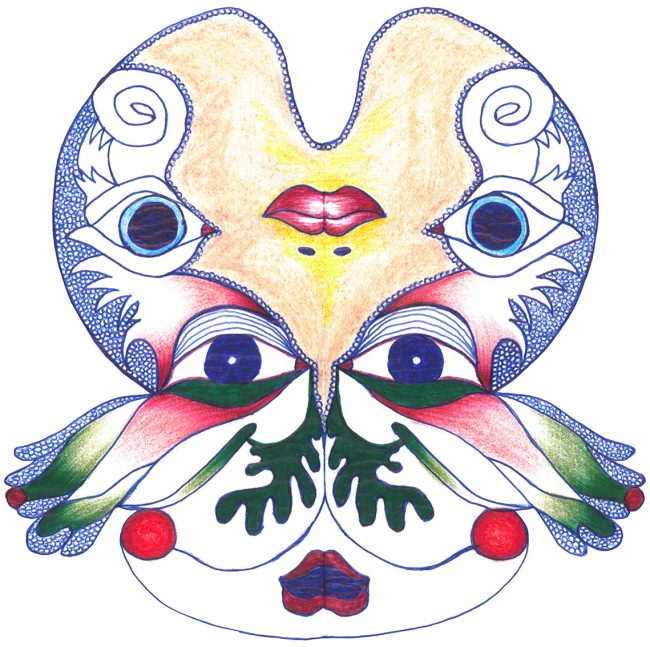
NOWs: I’m Meeting A Hybrid Of Past And Now
solo exhibition by Dardan Zhegrova
Opening
14 February 2020, 7 – 10 pm
For his first solo presentation I’m Meeting A Hybrid Of Past And Now in Germany at FRAGILE, Dardan Zhegrova (*1991, in Prishtina, Kosovo) conceived a new body of work, which consists of large-sized puppets based on dolls used in traditional shadow play and a newly recorded sound piece. The show derives from experiences reaching back to the artist’s childhood attending a famous puppet theatre in his home town Prishtina, which in the 1990s, during the wars in Yugoslavia, became an enclave for Albanian life and culture. The immersive installation follows the ongoing occupation of the artist with poetry, auto fiction as well the production of larger than life amorphous dolls. The specific blurry moment in the distinction of the self and the other – inherent in these works – through the notion of self-replication and role playing, is heavily influenced by the internet and reflects upon our contemporary conditions of life. The show reveals a personal encounter of the artist talking about childhood and imagination as a powerful tools in the process of self constitution.
About FRAGILE
FRAGILE fosters a program of conversation, antagonism, renegotiation, and celebration.
FRAGILE is a non-profit project for contemporary artistic practices located in Berlin. It encompasses an exhibition and a residency space.
FRAGILE is guided by curations etymology, the practice of caring and was founded on the warmest summerday of 2018 by Maurin Dietrich and Jonas Wendelin.
solo exhibition by Dardan Zhegrova
Opening
14 February 2020, 7 – 10 pm
For his first solo presentation I’m Meeting A Hybrid Of Past And Now in Germany at FRAGILE, Dardan Zhegrova (*1991, in Prishtina, Kosovo) conceived a new body of work, which consists of large-sized puppets based on dolls used in traditional shadow play and a newly recorded sound piece. The show derives from experiences reaching back to the artist’s childhood attending a famous puppet theatre in his home town Prishtina, which in the 1990s, during the wars in Yugoslavia, became an enclave for Albanian life and culture. The immersive installation follows the ongoing occupation of the artist with poetry, auto fiction as well the production of larger than life amorphous dolls. The specific blurry moment in the distinction of the self and the other – inherent in these works – through the notion of self-replication and role playing, is heavily influenced by the internet and reflects upon our contemporary conditions of life. The show reveals a personal encounter of the artist talking about childhood and imagination as a powerful tools in the process of self constitution.
About FRAGILE
FRAGILE fosters a program of conversation, antagonism, renegotiation, and celebration.
FRAGILE is a non-profit project for contemporary artistic practices located in Berlin. It encompasses an exhibition and a residency space.
FRAGILE is guided by curations etymology, the practice of caring and was founded on the warmest summerday of 2018 by Maurin Dietrich and Jonas Wendelin.

NOWs: Jan St. Werner + Guests at Ausland
Fiebplatter Catalogue: Jan St. Werner and Guestsconcert, salon, club night
AUSLAND
Lychener Str. 60
10437 Berlin
14 March 2020
Doors 7:30 pm, Start 8:30 pm | 9 EUR | @facebook
– tickets at the door | detailed timetable TBA in March –
CC No. 2 – Craving Coincidence
pt. 1
Premiere! For our new series CC No. 2 – Craving Coincidence, we’ve invited six musicians to curate one long ausland-night each, inbetween concert evening, salon and club night.
They’re weaving their own concert into a heterogenuos programme featuring contributions by further artists.
Tonight’s first edition was put together by Jan St. Werner (Microstoria, Mouse on Mars), who’ll bring Olivia Block, PITA, Rosa Barba, Patricia Reed and Eleni Poulou with him to ausland, and present the book “Decay Object” together with Rupert Smyth. The evening as such becomes part of St. Werner’s long-term project “Fiepblatter Catalogue”.
At project space Farbvision, the exhibition format Fiepblatter Short Decay Store follows the next weekend.
OLIVIA BLOCK live
– electronics –
www.oliviablock.net
PITA live
– electronics –
www.editionsmego.com/pita
JAN ST. WERNER live
– electronics –
www.thrilljockey.com/jan-st-werner
ROSA BARBA: “Somnium”
– film screening –
www.rosabarba.com/somnium-2011
PATRICIA REED: “Frames of Reference for the Inexistent”
– diagrammatic lecture –
www.aestheticmanagement.com
ELENI POULOU
DJ-Set
yiuu.bandcamp.com
JAN ST. WERNER + RUPERT SMYTH: “Decay Object”
– book presentation –
www.rupertsmyth.com
Cancelled: Sat /Sun March 21/22
FIEPBLATTER SHORT DECAY STORE at Farbvision
In connection to the CC No. 2-live programme at ausland, Farbvision presents an exhibition by Jan St. Werner referring to his long-term project Fieplatter Catalogue on the weekend of March 21/22 including graphics and artwork related to the series, special collectables and the complete Fiepblatter Catalogue-recordings.
Instead of the fiepblatter record store at farbvision, the new book is available at the fiepblatter catalogue bandcamp store:
fiepblatter.bandcamp.com
fiepblatter.bandcamp.com/merch/decay-object-fiepblatter-catalogue-7
Fiebplatter Catalogue: Jan St. Werner and Guestsconcert, salon, club night
AUSLAND
Lychener Str. 60
10437 Berlin
14. März 2020
Doors 19:30 Uhr, Start 20:30 Uhr | 9 EUR | @facebook
– tickets at the door | detailed timetable TBA in March –
CC No. 2 – Craving Coincidence
pt. 1
Premiere! Zur neuen ausland-Reihe CC No. 2 – Craving Coincidence sind sechs Musiker*innen eingeladen, je einen langen Abend frei zu gestalten:
Sie stellen ihren eigenen Auftritt in den Kontext eines heterogenen Programms zwischen Konzertabend, Salon und Clubnacht.
Den Auftakt heute macht Jan St. Werner (Microstoria, Mouse on Mars),
der Olivia Block, PITA, Rosa Barba, Patricia Reed und Eleni Poulou ins ausland mitbringt und zusammen mit Rupert Smyth das Buch “Decay Object” präsentieren wird. Der Abend wird selbst zu einem Teil von St. Werners Langzeitprojekt “Fiepblatter Catalogue”.
Am nächsten Wochenende folgt im Projektraum Farbvision das Ausstellungsformat Fiepblatter Short Decay Store.
OLIVIA BLOCK live
– electronics –
www.oliviablock.net
PITA live
– electronics –
www.editionsmego.com/pita
JAN ST. WERNER live
– electronics –
www.thrilljockey.com/jan-st-werner
ROSA BARBA: “Somnium”
– film screening –
www.rosabarba.com/somnium-2011
PATRICIA REED: “Frames of Reference for the Inexistent”
– diagrammatic lecture –
www.aestheticmanagement.com
ELENI POULOU
DJ-Set
yiuu.bandcamp.com
JAN ST. WERNER + RUPERT SMYTH: “Decay Object”
– book presentation –
www.rupertsmyth.com
Cancelled: Sat /Sun March 21/22
FIEPBLATTER SHORT DECAY STORE at Farbvision
In connection to the CC No. 2-live programme at ausland, Farbvision presents an exhibition by Jan St. Werner referring to his long-term project Fieplatter Catalogue on the weekend of March 21/22 including graphics and artwork related to the series, special collectables and the complete Fiepblatter Catalogue-recordings.
Instead of the fiepblatter record store at farbvision, the new book is available at the fiepblatter catalogue bandcamp store:
fiepblatter.bandcamp.com
fiepblatter.bandcamp.com/merch/decay-object-fiepblatter-catalogue-7

NOWs: When You Touch About Me, I Think Myself.
When You Touch About Me, I Think Myself.group show with Dan Stockholm et al.
With: Anish Kapoor, Amie Dicke, Asger Carlsen, Ayşe Erkmen, Burhan Kum, Cevdet Erek, Dan Stockholm, Elena Manferdini, Ergin Çavuşoğlu, Erol Akyavaş, Fischli & Weiss, Francis Alÿs, Hera Büyüktaşçıyan, Ibrahim Karakütük, Inci Furni, Joan Jonas, Malvina Panagiotidi, Martina Corà, Mehtap Baydu, Necla Rüzgar, Thomas Demand, Thomas Ruff and Yusuf Sevincli
SIGNS, Istanbul, a new platform for arts, is pleased to present its second group exhibition, titled When You Touch About Me, I Think Myself which can be seen between February 3-April 30, 2020.
In the exhibition, each of the works featured have been brought together inspired by thoughts on touch; the most primitive of all senses and at times most unclear to define the characteristics and the borders of. The palpable and tactile aspect of animate and inanimate beings and defined spaces assert one’s sense of self. The comfort of reaching out for a touch saves one from the eternal corridors of the void and the unending universe becomes altogether tangible, perceivable and equal to our physicality.
Skin, being that ubiquitous site of the act of touch, also becomes the undefined border between the self and the Other. It is undefined, since one can only touch another, by touching oneself first. Skin presents itself as a threshold defining an exterior and interior and it brings about questions on being the organ of touch or merely its medium. Passing along this thought, the exhibition moves on to discuss what that real organ of touch being situated farther inward could be, if any.
Tactility and thought, has been at odds since Antiquity with the hierarchical relation ascribed to them. While, touch is the most primal of senses possessed by all sentient beings, to think, is deemed as the highest faculty that belongs to solely the human. However, a causal relation attributed between the two have always made their connection significant.
The title of the exhibition suggesting an intermingling of touch and thought refers to the construction of an “I” within the realm of language and the Cartesian split of thought from the body. Philosopher Judith Butler’s unique consideration of how they are specifically separated through language has inspired the formation of the exhibition which doesn’t seek to offer a conclusion or a statement on their interconnectedness, but to open passageways on tact and thought through questions asked on their coexistence while communicating with the world, their lack, remnants, traces, results and relation to other sensory modalities.
The exhibition puts together works by Anish Kapoor, Amie Dicke, Asger Carlsen, Ayşe Erkmen, Burhan Kum, Cevdet Erek, Dan Stockholm, Elena Manferdini, Ergin Çavuşoğlu, Erol Akyavaş, Fischli & Weiss, Francis Alÿs, Hera Büyüktaşçıyan, Ibrahim Karakütük, Inci Furni, Joan Jonas, Malvina Panagiotidi, Martina Corà, Mehtap Baydu, Necla Rüzgar, Thomas Demand, Thomas Ruff and Yusuf Sevincli.
SIGNS wishes to thank Tepta and Jotun for their valuable contributions to the exhibition.
When You Touch About Me, I Think Myself.group show with Dan Stockholm et al.
With: Anish Kapoor, Amie Dicke, Asger Carlsen, Ayşe Erkmen, Burhan Kum, Cevdet Erek, Dan Stockholm, Elena Manferdini, Ergin Çavuşoğlu, Erol Akyavaş, Fischli & Weiss, Francis Alÿs, Hera Büyüktaşçıyan, Ibrahim Karakütük, Inci Furni, Joan Jonas, Malvina Panagiotidi, Martina Corà, Mehtap Baydu, Necla Rüzgar, Thomas Demand, Thomas Ruff and Yusuf Sevincli
SIGNS, Istanbul, a new platform for arts, is pleased to present its second group exhibition, titled When You Touch About Me, I Think Myself which can be seen between February 3-April 30, 2020.
In the exhibition, each of the works featured have been brought together inspired by thoughts on touch; the most primitive of all senses and at times most unclear to define the characteristics and the borders of. The palpable and tactile aspect of animate and inanimate beings and defined spaces assert one’s sense of self. The comfort of reaching out for a touch saves one from the eternal corridors of the void and the unending universe becomes altogether tangible, perceivable and equal to our physicality.
Skin, being that ubiquitous site of the act of touch, also becomes the undefined border between the self and the Other. It is undefined, since one can only touch another, by touching oneself first. Skin presents itself as a threshold defining an exterior and interior and it brings about questions on being the organ of touch or merely its medium. Passing along this thought, the exhibition moves on to discuss what that real organ of touch being situated farther inward could be, if any.
Tactility and thought, has been at odds since Antiquity with the hierarchical relation ascribed to them. While, touch is the most primal of senses possessed by all sentient beings, to think, is deemed as the highest faculty that belongs to solely the human. However, a causal relation attributed between the two have always made their connection significant.
The title of the exhibition suggesting an intermingling of touch and thought refers to the construction of an “I” within the realm of language and the Cartesian split of thought from the body. Philosopher Judith Butler’s unique consideration of how they are specifically separated through language has inspired the formation of the exhibition which doesn’t seek to offer a conclusion or a statement on their interconnectedness, but to open passageways on tact and thought through questions asked on their coexistence while communicating with the world, their lack, remnants, traces, results and relation to other sensory modalities.
The exhibition puts together works by Anish Kapoor, Amie Dicke, Asger Carlsen, Ayşe Erkmen, Burhan Kum, Cevdet Erek, Dan Stockholm, Elena Manferdini, Ergin Çavuşoğlu, Erol Akyavaş, Fischli & Weiss, Francis Alÿs, Hera Büyüktaşçıyan, Ibrahim Karakütük, Inci Furni, Joan Jonas, Malvina Panagiotidi, Martina Corà, Mehtap Baydu, Necla Rüzgar, Thomas Demand, Thomas Ruff and Yusuf Sevincli.
SIGNS wishes to thank Tepta and Jotun for their valuable contributions to the exhibition.
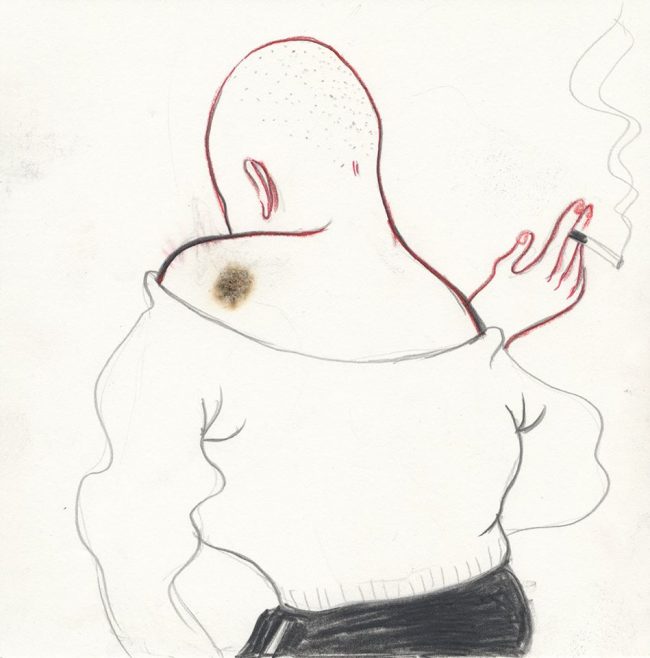
NOWs: Cruise Collection by Enver Hadzijaj
Cruise Collectionsolo exhibition by Enver Hadzijaj
Opening
31 JAN 2020, 7 – 10 pm
FRAGILE
Leipzigerstraße 63
10117 Berlin
I always loved watching my sister applying make-up in the morning, that calmness on her face while contouring her lips dark red like all the Yugo girls did. These were the early 90ies and St. Linda Evangelista was watching the scenery from a torn-out magazine page my sister had stuck to the wall. I tried to make her laugh but she was too focused and just poked me in the arm without looking away from the mirror. There was a petrol station near our house to which she would send me to buy red Gauloises for her and sweets for myself. In those mornings we would talk and wonder why things had turned out to be that difficult while she was smoking and drinking coffee from her metal Thermos jug until she left for work always in a hurry.
About FRAGILE
FRAGILE fosters a program of conversation, antagonism, renegotiation, and celebration.
FRAGILE is a non-profit project for contemporary artistic practices located in Berlin. It encompasses an exhibition and a residency space.
FRAGILE is guided by curations etymology, the practice of caring and was founded on the warmest summerday of 2018 by Maurin Dietrich and Jonas Wendelin.
Cruise Collectionsolo exhibition by Enver Hadzijaj
Opening
31 JAN 2020, 7 – 10 pm
FRAGILE
Leipzigerstraße 63
10117 Berlin
I always loved watching my sister applying make-up in the morning, that calmness on her face while contouring her lips dark red like all the Yugo girls did. These were the early 90ies and St. Linda Evangelista was watching the scenery from a torn-out magazine page my sister had stuck to the wall. I tried to make her laugh but she was too focused and just poked me in the arm without looking away from the mirror. There was a petrol station near our house to which she would send me to buy red Gauloises for her and sweets for myself. In those mornings we would talk and wonder why things had turned out to be that difficult while she was smoking and drinking coffee from her metal Thermos jug until she left for work always in a hurry.
About FRAGILE
FRAGILE fosters a program of conversation, antagonism, renegotiation, and celebration.
FRAGILE is a non-profit project for contemporary artistic practices located in Berlin. It encompasses an exhibition and a residency space.
FRAGILE is guided by curations etymology, the practice of caring and was founded on the warmest summerday of 2018 by Maurin Dietrich and Jonas Wendelin.

NOWs: DJ-Battle Lippok Bros. vs. Nicolai Bros.
DJ-Battle Lippok Bros. vs. Nicolai Bros.concert, performance
Hamburger Bahnhof – Museum für Gegenwart – Berlin
2 February, 9 pm – 12:30 am
Robert & Ronald Lippok, Carsten & Olaf Nicolai
4 Plattenspieler, 2 Mischpulte, 1 Dancefloor, 1 Jury, 1 Preis
Zur Feier von 20 Jahre “Musikwerke Bildender Künstler” treten die Brüderpaare Nicolai und Lippok erneut gegeneinander an: Wer legt besser auf, wer bringt die Leute mehr in Stimmung und Bewegung? Die Künstler unterziehen sich dabei dem strengen Urteil einer Jury.
Tickets: 10 €. Verkauf nur an der Abendkasse, geöffnet 1 Stunde vor Veranstaltungsbeginn.
Robert & Ronald Lippok, Carsten & Olaf Nicolai
4 Plattenspieler, 2 Mischpulte, 1 Dancefloor, 1 Jury, 1 Preis
Eine Koproduktion von Freunde Guter Musik Berlin e.V., Nationalgalerie im Hamburger Bahnhof – Museum für Gegenwart – Berlin, Staatliche Museen zu Berlin, und Ruhrtriennale. Gefördert durch die Kulturstiftung des Bundes, mit Unterstützung der SAHA Association.
Kuratorenteam:
Ingrid Buschmann / Freunde Guter Musik Berlin e.V.
Gabriele Knapstein / Nationalgalerie im Hamburger Bahnhof
Matthias Osterwold / Ruhrtriennale
Information:
www.freunde-guter-musik-berlin.de
www.musikwerke-bildender-kuenstler.de
www.smb.museum/hbf
www.facebook.com/hamburgerbahnhof
DJ-Battle Lippok Bros. vs. Nicolai Bros.concert, performance
Hamburger Bahnhof – Museum für Gegenwart – Berlin
2. Februar, 21 h – 00:30 h
Robert & Ronald Lippok, Carsten & Olaf Nicolai
4 Plattenspieler, 2 Mischpulte, 1 Dancefloor, 1 Jury, 1 Preis
Zur Feier von 20 Jahre “Musikwerke Bildender Künstler” treten die Brüderpaare Nicolai und Lippok erneut gegeneinander an: Wer legt besser auf, wer bringt die Leute mehr in Stimmung und Bewegung? Die Künstler unterziehen sich dabei dem strengen Urteil einer Jury.
Tickets: 10 €. Verkauf nur an der Abendkasse, geöffnet 1 Stunde vor Veranstaltungsbeginn.
Robert & Ronald Lippok, Carsten & Olaf Nicolai
4 Plattenspieler, 2 Mischpulte, 1 Dancefloor, 1 Jury, 1 Preis
Eine Koproduktion von Freunde Guter Musik Berlin e.V., Nationalgalerie im Hamburger Bahnhof – Museum für Gegenwart – Berlin, Staatliche Museen zu Berlin, und Ruhrtriennale. Gefördert durch die Kulturstiftung des Bundes, mit Unterstützung der SAHA Association.
Kuratorenteam:
Ingrid Buschmann / Freunde Guter Musik Berlin e.V.
Gabriele Knapstein / Nationalgalerie im Hamburger Bahnhof
Matthias Osterwold / Ruhrtriennale
Information:
www.freunde-guter-musik-berlin.de
www.musikwerke-bildender-kuenstler.de
www.smb.museum/hbf
www.facebook.com/hamburgerbahnhof
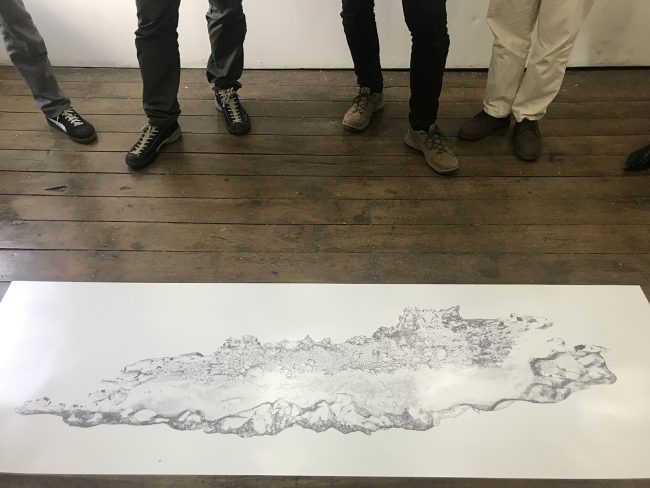
Mapping the Invisible City
Atmospheres and Subnatures at Arat Kilo
Workshop by Makeda Begashaw (Addis Ababa), Polina Chebotareva (Copenhagen) and Christina Werner (Berlin) at the Alle School of Fine Arts, Addis Ababa, November 5th – 8th, 2019
Presentations on November 11th, 2019 in the context of a workshop by the research network Atmospheres in the Urban Anthropocene – International and Cross-disciplinary Research Network held at Guramayne Art Center, Addis Ababa
The course introduces the participants to the terms ‘Atmosphere’ and ‘Subnature’ that allow to critically reflect upon the invisible things that make up a city. It introduces a method for documenting the atmosphere by registering the sensory and affective perception, the commented city walks, as well as a variety of artistic methods of mapping of atmospheres in specific urban contexts. Participants are encouraged to collect data on atmosphere and subnatures, mapping the Arat Kilo area and to rethink the scientific method of mapping atmospheres in their own artistic interpretation. The produced maps of the atmospheres and subnatures at Arat Kilo were presented at Guramayne Art Center as part of an international research workshop.
Participants: Muluadam Adane / Michael Hailu / Gashahun Kassahun / Tewodros Kifle / Temesgen Mastewal / Solomon Shifraw Abebe
photos: Polina Chebotareva, Christina Werner
Atmospheres and Subnatures at Arat Kilo
Workshop by Makeda Begashaw (Addis Ababa), Polina Chebotareva (Copenhagen) and Christina Werner (Berlin) at the Alle School of Fine Arts, Addis Ababa, November 5th – 8th, 2019
Presentations on November 11th, 2019 in the context of a workshop by the research network Atmospheres in the Urban Anthropocene – International and Cross-disciplinary Research Network held at Guramayne Art Center, Addis Ababa
The course introduces the participants to the terms ‘Atmosphere’ and ‘Subnature’ that allow to critically reflect upon the invisible things that make up a city. It introduces a method for documenting the atmosphere by registering the sensory and affective perception, the commented city walks, as well as a variety of artistic methods of mapping of atmospheres in specific urban contexts. Participants are encouraged to collect data on atmosphere and subnatures, mapping the Arat Kilo area and to rethink the scientific method of mapping atmospheres in their own artistic interpretation. The produced maps of the atmospheres and subnatures at Arat Kilo were presented at Guramayne Art Center as part of an international research workshop.
Participants: Muluadam Adane / Michael Hailu / Gashahun Kassahun / Tewodros Kifle / Temesgen Mastewal / Solomon Shifraw Abebe
photos: Polina Chebotareva, Christina Werner
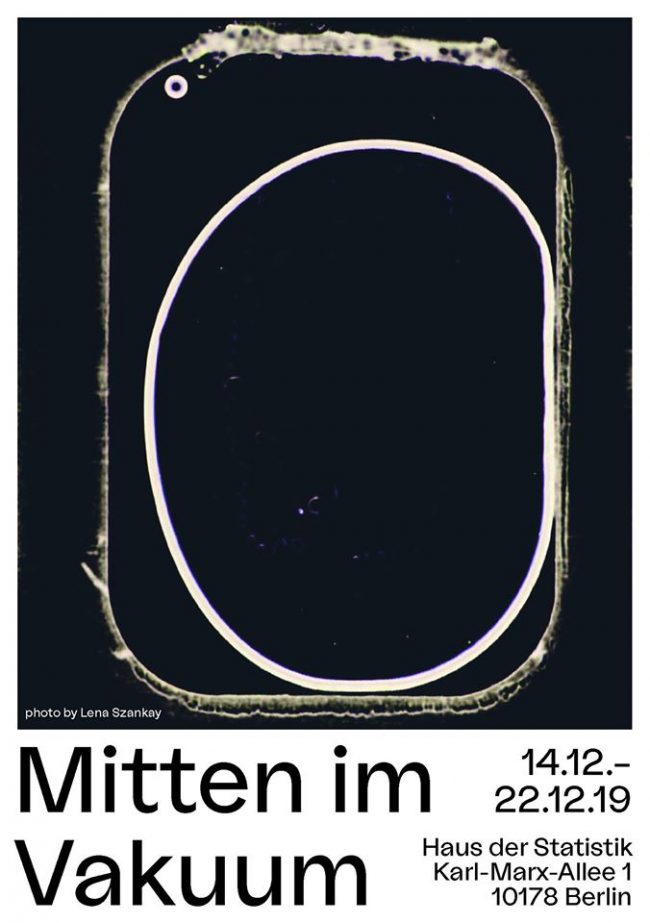
NOWs: Mitten im Vakuum
Mitten im VakuumGroup show
Haus der Statistik
Karl-Marx-Allee 1
10178 Berlin
Opening
14 December 2019, 4 pm
The exhibition title ‚Mitten im Vakuum’ (‚In the middle of a vacuum’) refers to empty spaces that open up in times of social upheaval. A vacuum that absorbs the individual aspiration for change; with the existential quest for impact. A stance that can likewise be found in our present culture and is negotiated within the framework of the exhibition through contemporary artistic positions.
Featuring:
AbBA
Daniele Ansidei
Malte Bartsch
Ekaterina Burlyga
Nadja Buttendorf
Sky M. J. Carranza
Monika Jagoda
Felix Kiessling
Philipp König
Manfred Pernice
David Polzin
Lena Szankay
Wermke/Leinkauf
Curated by Johanna Landscheidt & Benjamin Merten with the assistance of Gloria Holzer.
Gruppenausstellung
Haus der Statistik
Karl-Marx-Allee 1
10178 Berlin
Eröffnung
14. Dezember, 16 h
Der Titel der Ausstellung verweist auf leere Räume, die sich während gesellschaftlicher Umbrüche auftun. Ein Vakuum, das sich vollsaugt mit dem individuellen Bestreben nach Veränderung; mit dem existentiellen Kampf um Wirkung. Eine Haltung, die sich auch in unserer Gegenwartskultur finden lässt und im Rahmen der Ausstellung in zeitgenössischen künstlerischen Positionen verhandelt wird.
Mit den Künstler*innen:
AbBA
Daniele Ansidei
Malte Bartsch
Ekaterina Burlyga
Nadja Buttendorf
Sky M. J. Carranza
Monika Jagoda
Felix Kiessling
Philipp König
Manfred Pernice
David Polzin
Lena Szankay
Wermke/Leinkauf
Kuratiert von Johanna Landscheidt & Benjamin Merten unter Mitwirkung von Gloria Holzer.

NOWs: Ethics Spinoza by Jorge Miñano
Ethics SpinozaArtist Book
Ethics Spinoza by Jorge Minano
378 pages, english
Linen hardcover, magnets
ISBN: 978-3-948519-00-1
published by Material Review
Collector’s signed edition of 25 + 5 AP
Order a copy here
The philosophical treatise “Ethics, Demonstrated in Geometrical Order” by Baruch Spinoza, first published in 1667 was an ambitious humanist attempt to apply the method of Euclid in philosophy. Several definitions and axioms derive into propositions about the possible meanings of reality, nature, and the human emotions. And yet, the more mathematical it is, the more extraordinarily concrete, like a geometrical portrait of life. Spinoza’s understanding of affect (Affectus) is based on the belief that someone’s force of being in the world is in a continuous variation determined by ideas. It’s what we call existing: No problem, no question; or in other words, actions might require passions.
The book is a collector’s hardcover reprint cut in half. The whole, now consisting of two parts, can be united again by the force of magnets. Jorge Minano’s gesture of making the book magnetic reflects on the monist philosophy of Spinoza towards the linkage of body and mind, and challenges with an operation his attempt to define human ethics based on mathematics. In the age, when human creativity is credited as the dominant, yet destructive, influence on the planetary environment, new ethical frameworks that question human bondage might rise.
Ethics SpinozaArtist Book
Ethics Spinoza by Jorge Minano
378 pages, english
Linen hardcover, magnets
ISBN: 978-3-948519-00-1
published by Material Review
Collector’s signed edition of 25 + 5 AP
Order a copy here
The philosophical treatise “Ethics, Demonstrated in Geometrical Order” by Baruch Spinoza, first published in 1667 was an ambitious humanist attempt to apply the method of Euclid in philosophy. Several definitions and axioms derive into propositions about the possible meanings of reality, nature, and the human emotions. And yet, the more mathematical it is, the more extraordinarily concrete, like a geometrical portrait of life. Spinoza’s understanding of affect (Affectus) is based on the belief that someone’s force of being in the world is in a continuous variation determined by ideas. It’s what we call existing: No problem, no question; or in other words, actions might require passions.
The book is a collector’s hardcover reprint cut in half. The whole, now consisting of two parts, can be united again by the force of magnets. Jorge Minano’s gesture of making the book magnetic reflects on the monist philosophy of Spinoza towards the linkage of body and mind, and challenges with an operation his attempt to define human ethics based on mathematics. In the age, when human creativity is credited as the dominant, yet destructive, influence on the planetary environment, new ethical frameworks that question human bondage might rise.
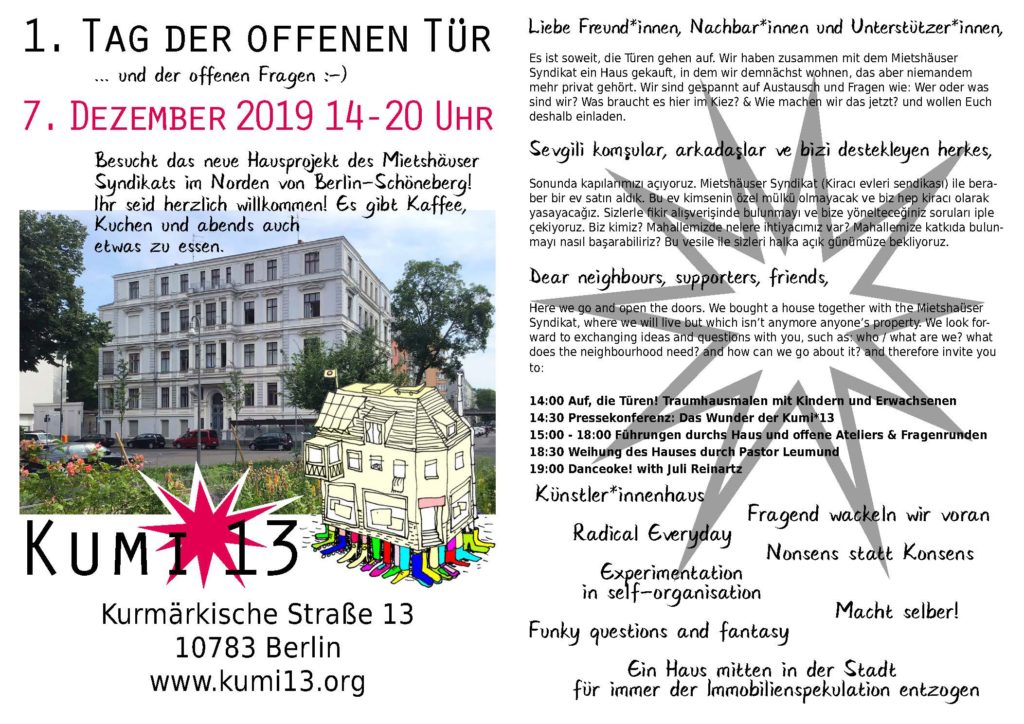
NOWs: 1st Open House at KUMI*13
1st Open House at KUMI*13anti speculative house project
kumi*13
Kurmärkische Straße 13
10783 Berlin
7 December, 2 – 8 pm
Dear neighbours, supporters, friends,
Here we go and open the doors. We bought a house together with the Mietshäuser Syndikat, where we will live but which isn’t anymore anyone’s property. We look forward to exchanging ideas and questions with you, such as: who / what are we? what does the neighbouhood need? and how can we go about it? and therefore invite you to:
14:00 Auf, die Türen! Traumhausmalen mit Kindern und Erwachsenen
14:30 Pressekonferenz: Das Wunder der Kumi*13
15:00 – 18:00 Führungen durchs Haus und offene Ateliers & Fragerunden
18:30 Weihung des Hauses durch Pastor Leumund
19:00 Danceoke! with Juli Reinartz
more info about the project here
1. Tag der offenen Tür im KUMI*13anti speculative house project
kumi*13
Kurmärkische Straße 13
10783 Berlin
7. December, 14 – 20 h
Liebe Freund*innen, Nachbar*innen und Unterstützer*innen,
Es ist soweit, die Türen gehen auf. Wir haben zusammen mit dem Mietshäuser Syndikat ein Haus gekauft, in dem wir demnächst wohnen, das aber niemendem mehr privat gehört. Wir sind gespannt auf Austausch und Fragen wie: Wer oder was sind wir? Was braucht es hier im Kiez? & Wie machen wir das jetzt? und wollen Euch deshalb einladen.
14:00 Auf, die Türen! Traumhausmalen mit Kindern und Erwachsenen
14:30 Pressekonferenz: Das Wunder der Kumi*13
15:00 – 18:00 Führungen durchs Haus und offene Ateliers & Fragerunden
18:30 Weihung des Hauses durch Pastor Leumund
19:00 Danceoke! with Juli Reinartz
Mehr Info über das Projekt hier
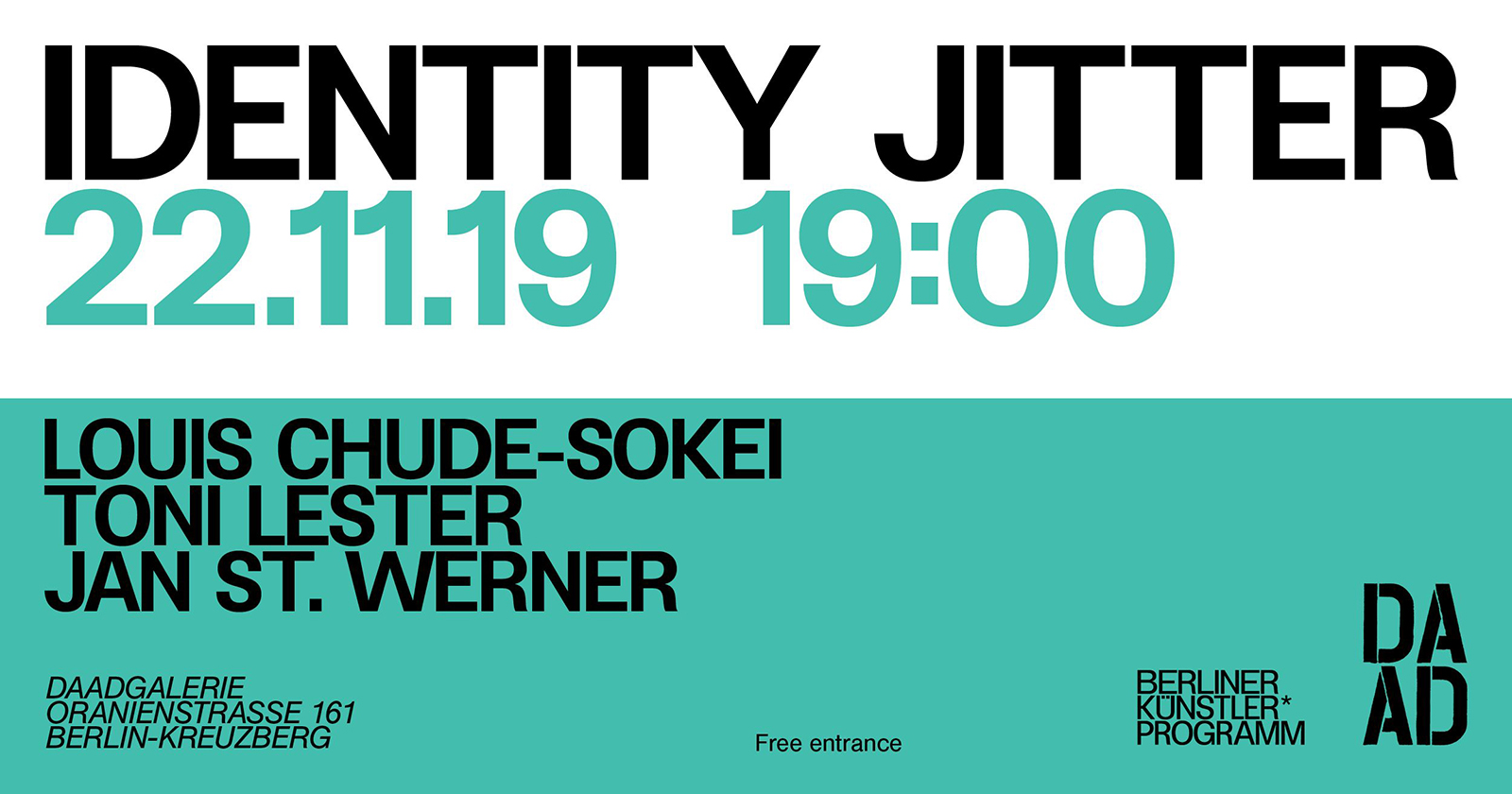
NOWs: Identity Jitter with Jan St. Werner, Toni Lester, Louis Chude-Sokei
Identity JitterConversation with Jan St. Werner, Toni Lester, Louis Chude-Sokei
daadgalerie
Oranienstraße 161
10969 Berlin
Conversation starts at 7pm (sharp)
Louis Chude-Sokei, Toni Lester, and Jan St. Werner will engage in a conversation about artificial intelligence in sound cultures. Starting with a presentation of an ongoing project by Mouse on Mars titled Anarchic Artificial Intelligence, the discussion will then move onto future scenarios, dangers, and utopias, traversing topics including authorship, identity politics, and ethics. How does the concept of identity change in the age of algorithms? How can sound and art in general not only reflect, but also influence socio-technological developments? How can we harness the potentials of instabilities and fragilities?
Louis Chude Sokei’s work includes the award-winning, The Last Darky: Bert Williams, Black on Black Minstrelsy and the African Diaspora (2006), The Sound of Culture: Diaspora and Black Technopoetics (2016) and the forthcoming, Dr. Satan’s Echo Chamber and Other Essays. He is the Editor in Chief of The Black Scholar, one of the oldest and currently leading journals of Black Studies in the United States, and a Professor of English and the Wein Chair and Director of African American Studies at Boston University. He is the founder of the Sonic Art/Archiving Project, Echolocution. Louis Chude-Sokei was invited to Berlin with an Arts & Media fellowship.
Toni Lester writes about arts and culture, innovation and creativity, human and civil rights, and privacy and intellectual property thru the lens of critical race, feminist, class and queer theory. She is particularly interested in examining how creative products and practices of marginalized people are produced and later appropriated without consent, attribution or compensation, and the ensuing legal, moral and ethical questions that arise therein. Lester was a member of the Scholar Advisory Group for the 2015 UN Office of Human Rights Special Rapporteur Report on Cultural Rights, Copyright Policy, and The Right To Science and Culture. Publications of note include: Questions of Trust, Betrayal and Authorial Control in the Avant Guard – The Case of Julius Eastman and John Cage (Marquette Intellectual Property Law Review, forthcoming, January 2020); Content-ID-Algorithmen und das Dilemma der falschen Treffer (i.e., Content Algorithms and False Positives in Innovative Music Creation) (with co-author Pachamanova), in: Lina Brion & Detlef Diederichsen (eds.), 100 Jahre Copyright (Matthes & Seitz – Culture Museum of Berlin (HDK) (2019, commemorating HDK’s 2018 One Hundred Years of Copyright Conference); and Blurred Lines – Where Copyright Ends and Cultural Appropriation Begins, Hastings Communication and Entertainment Law Journal (2014). Also a sound artist and award winning composer, Lester is a full professor at Babson College in the U.S. and currently a Visiting Scholar at the Kent University Centre for Sexuality, Race and Gender Justice in Canterbury, England.
Jan St. Werner is an artist and experimental music composer based in Berlin. Best known as one half of the innovative electronic duo Mouse on Mars, he has also pursued a solo career creating music under his own name. Starting in the mid-1990s, St. Werner released a steady stream of influential records both as a solo artist and with Mouse on Mars. He has been collaborating with Oval’s Markus Popp as Microstoria and writing music for installations and films by visual artist Rosa Barba. During the 2000s, he acted as the artistic director for Amsterdam’s Institute for Electronic Music (STEIM). As a solo artist as well as with Mouse on Mars Werner composed music for various ensembles including Musikfabrik, Chicago Symphony, Kaleidoskop or neoN. In 2013, St. Werner released Blaze Colour Burn, the first of a series of experimental recordings on Thrill Jockey Records, Chicago. Fiepblatter Catalogue #5 Spectric Acid was released in 2017. Werner has been a visiting lecturer at the Arts Culture and Technology department ACT of the Massachusetts Institute of Technology MIT and holds a position as a professor for Dynamic Acoustic Research (Dynamische Akustische Forschung) at the Academy of Fine Arts in Nuremberg, Germany.
Identity JitterConversation with Jan St. Werner, Toni Lester, Louis Chude-Sokei
daadgalerie
Oranienstraße 161
10969 Berlin
Conversation starts at 7pm (sharp)
Louis Chude-Sokei, Toni Lester, and Jan St. Werner will engage in a conversation about artificial intelligence in sound cultures. Starting with a presentation of an ongoing project by Mouse on Mars titled Anarchic Artificial Intelligence, the discussion will then move onto future scenarios, dangers, and utopias, traversing topics including authorship, identity politics, and ethics. How does the concept of identity change in the age of algorithms? How can sound and art in general not only reflect, but also influence socio-technological developments? How can we harness the potentials of instabilities and fragilities?
Louis Chude Sokei’s work includes the award-winning, The Last Darky: Bert Williams, Black on Black Minstrelsy and the African Diaspora (2006), The Sound of Culture: Diaspora and Black Technopoetics (2016) and the forthcoming, Dr. Satan’s Echo Chamber and Other Essays. He is the Editor in Chief of The Black Scholar, one of the oldest and currently leading journals of Black Studies in the United States, and a Professor of English and the Wein Chair and Director of African American Studies at Boston University. He is the founder of the Sonic Art/Archiving Project, Echolocution. Louis Chude-Sokei was invited to Berlin with an Arts & Media fellowship.
Toni Lester writes about arts and culture, innovation and creativity, human and civil rights, and privacy and intellectual property thru the lens of critical race, feminist, class and queer theory. She is particularly interested in examining how creative products and practices of marginalized people are produced and later appropriated without consent, attribution or compensation, and the ensuing legal, moral and ethical questions that arise therein. Lester was a member of the Scholar Advisory Group for the 2015 UN Office of Human Rights Special Rapporteur Report on Cultural Rights, Copyright Policy, and The Right To Science and Culture. Publications of note include: Questions of Trust, Betrayal and Authorial Control in the Avant Guard – The Case of Julius Eastman and John Cage (Marquette Intellectual Property Law Review, forthcoming, January 2020); Content-ID-Algorithmen und das Dilemma der falschen Treffer (i.e., Content Algorithms and False Positives in Innovative Music Creation) (with co-author Pachamanova), in: Lina Brion & Detlef Diederichsen (eds.), 100 Jahre Copyright (Matthes & Seitz – Culture Museum of Berlin (HDK) (2019, commemorating HDK’s 2018 One Hundred Years of Copyright Conference); and Blurred Lines – Where Copyright Ends and Cultural Appropriation Begins, Hastings Communication and Entertainment Law Journal (2014). Also a sound artist and award winning composer, Lester is a full professor at Babson College in the U.S. and currently a Visiting Scholar at the Kent University Centre for Sexuality, Race and Gender Justice in Canterbury, England.
Jan St. Werner is an artist and experimental music composer based in Berlin. Best known as one half of the innovative electronic duo Mouse on Mars, he has also pursued a solo career creating music under his own name. Starting in the mid-1990s, St. Werner released a steady stream of influential records both as a solo artist and with Mouse on Mars. He has been collaborating with Oval’s Markus Popp as Microstoria and writing music for installations and films by visual artist Rosa Barba. During the 2000s, he acted as the artistic director for Amsterdam’s Institute for Electronic Music (STEIM). As a solo artist as well as with Mouse on Mars Werner composed music for various ensembles including Musikfabrik, Chicago Symphony, Kaleidoskop or neoN. In 2013, St. Werner released Blaze Colour Burn, the first of a series of experimental recordings on Thrill Jockey Records, Chicago. Fiepblatter Catalogue #5 Spectric Acid was released in 2017. Werner has been a visiting lecturer at the Arts Culture and Technology department ACT of the Massachusetts Institute of Technology MIT and holds a position as a professor for Dynamic Acoustic Research (Dynamische Akustische Forschung) at the Academy of Fine Arts in Nuremberg, Germany.
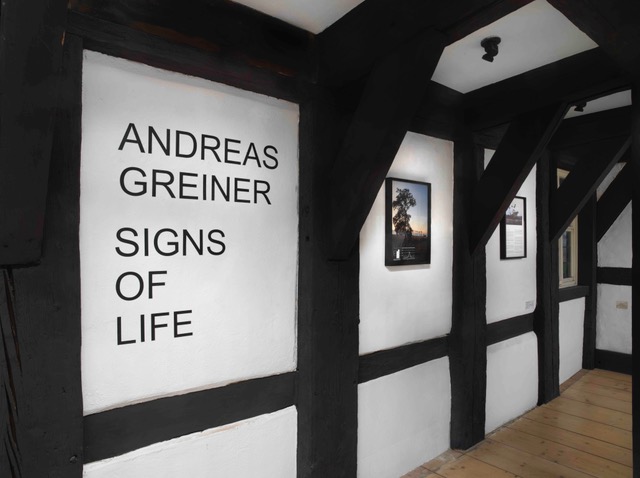
NOWs: Artist Talk with Andreas Greiner, Kaiserring Stipendiat 2019
Artist Talk with Andreas Greiner, Kaiserring Stipendiat 2019
Andreas Greiner: Signs of Life; exhibition room view. Mönchehaus Museum Goslar. Photo by Jens Ziehe, 2019
Mönchehaus Museum Goslar
Mönchestraße 1
38640 Goslar
24. November 2019
11:30 h
Am Sonntag, 24. November 2019 ist der diesjährige Kaiserringstipendiat Andreas Greiner zu Gast im Mönchehaus Museum.
Greiner gehört zu einer neuen Generation ökologisch denkender Künstler. In seinen Arbeiten verhandelt der 1979 geborene Künstler und Meisterschüler von Olafur Eliasson existentielle Zukunftsfragen der Menschheit. Globale Klimaveränderung, Wald- und Artensterben ebenso wie bedingungsloser wissenschaftlicher und wirtschaftlicher Fortschritt bieten den Hintergrund seines komplexen multimedialen Werks.
Für seine Ausstellung im Mönchehaus hat er zwei spektakuläre Installation geschaffen, in denen von einer künstlichen Intelligenz errechnete Waldbilder ebenso wie selbstleuchtende Algen zu finden sind.
Das Gespräch zwischen Andreas Greiner und Mönchehaus-Direktorin Dr. Bettina Ruhrberg beginnt um 11.30 Uhr.
Der Eintritt ist frei.
Andreas Greiner & Paul Rohlfs: Tree Planting. Kranich Museum, Hessenburg, 2019
Andreas Greiner & Paul Rohlfs: Adelheid. Mönchehaus Museum Goslar. Photo by Jens Ziehe, 2019
Andreas Greiner: 880. Mönchehaus Museum Goslar. Photo by Jens Ziehe, 2019
Artist Talk with Andreas Greiner, Kaiserring Stipendiat 2019
Andreas Greiner: Signs of Life; exhibition room view. Mönchehaus Museum Goslar. Photo by Jens Ziehe, 2019
Mönchehaus Museum Goslar
Mönchestraße 1
38640 Goslar
24. November 2019
11:30 h
Am Sonntag, 24. November 2019 ist der diesjährige Kaiserringstipendiat Andreas Greiner zu Gast im Mönchehaus Museum.
Greiner gehört zu einer neuen Generation ökologisch denkender Künstler. In seinen Arbeiten verhandelt der 1979 geborene Künstler und Meisterschüler von Olafur Eliasson existentielle Zukunftsfragen der Menschheit. Globale Klimaveränderung, Wald- und Artensterben ebenso wie bedingungsloser wissenschaftlicher und wirtschaftlicher Fortschritt bieten den Hintergrund seines komplexen multimedialen Werks.
Für seine Ausstellung im Mönchehaus hat er zwei spektakuläre Installation geschaffen, in denen von einer künstlichen Intelligenz errechnete Waldbilder ebenso wie selbstleuchtende Algen zu finden sind.
Das Gespräch zwischen Andreas Greiner und Mönchehaus-Direktorin Dr. Bettina Ruhrberg beginnt um 11.30 Uhr.
Der Eintritt ist frei.
Andreas Greiner & Paul Rohlfs: Tree Planting. Kranich Museum, Hessenburg, 2019
Andreas Greiner & Paul Rohlfs: Adelheid. Mönchehaus Museum Goslar. Photo by Jens Ziehe, 2019
Andreas Greiner: 880. Mönchehaus Museum Goslar. Photo by Jens Ziehe, 2019
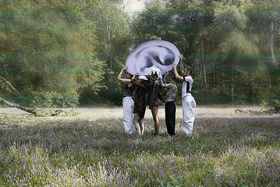
NOWs: Arcana Swarm by Kat Válastur / HAU
Kat Válastur / HAU: Arcana SwarmDance
HAU1
Stresemannstr. 29
10963 Berlin
What is joy when its ephemerality and fragility tend towards its own dissolution? In Kat Válastur’s new work the performers embody the emotional complexity of joy which constantly collapses. In a visually playful set where three human-sized sculptures are placed, the performers unfold a choreographic swing of joy that turns into horror. Arcana Swarm is a new HAU production for seven performers and the third part of the work cycle The Staggered Dances of Beauty, which deals with scenarios and varieties of our bodies exposed in a radically changing world. For this piece, Válastur works again with the technique of “morphing” as a transformative force. The body shows the affects and effects that derive from the tensions of the current technological, environmental and political conditions of a precarious and anthropocentric world.
After the event on November 22: Artist talk with Ana Vujanović (Berlin / Belgrade). Vujanović is a cultural worker focused on bringing together critical theory and contemporary art.
Cast
Concept, script & choreography: Kat Válastur / Performance: Juan Pablo Cámara, Ixchel Mendoza Hernandez, Gaetano Montecasino, Ogbitse Omagbemi, Tamar Sonn, Sarah Stanley, Tiran Willemse / Light design: Martin Beeretz / Sound desigh: Peter Breitenbach / Set design: Leon Eixenberger / Costume: Christina Nyffeler / Dramaturgical advice: Einav Katan-Schmid, Maja Zimmermann / Outside eye: Alexandra Balona / Assistance choreography: Kévin Quinaou / Production management: HAU Artist Office / Sabine Seifert / Touring & distribution: HAU Artist Office / Nicole Schuchardt
Wed 20.11.2019, 20:00 / HAU1 (Premiere)
Thu 21.11.2019, 19:00 / HAU1
Fri 22.11.2019, 19:00 / HAU1
Sat 23.11.2019, 19:00 / HAU1
Tickets available online
Credits
Production: Kat Válastur / HAU Hebbel am Ufer. Supported by: The Fondation d’entreprise Hermès as part of its New Settings Program.
Co-production: Théâtre de la Ville (Paris), PACT Zollverein (Essen), Theater Freiburg.
Funded by: Capital Cultural Fund (Berlin), Berlin Senate Department for Culture and Europe. Residency support: STUK Leuven, Tanzhaus Zürich, Centrale Fies / Live Works.
Kat Válastur / HAU: Arcana SwarmTanz
HAU1
Stresemannstr. 29
10963 Berlin
Was bedeutet Freude, die sich durch ihre Flüchtigkeit und Fragilität stets selbst auflöst? In Kat Válasturs neuer Arbeit verkörpern die Darsteller*innen die Komplexität dieser immer wieder in sich zusammenfallenden Emotion. Das verspielte Bühnenbild mit drei lebensgroßen Skulpturen lässt einen choreografischen Kippraum entstehen, in dem sich Freude in Grauen verwandelt. Die neue HAU-Produktion Arcana Swarm ist ein Stück für sieben Performer*innen und zugleich der dritte Teil des Werkzyklus The Staggered Dances of Beauty, in dem Válastur unterschiedliche Szenarien entwirft, die unseren Körper einer sich radikal verändernden Welt ausgesetzt zeigen. Einmal mehr setzt sie dabei die Technik des “Morphing” als transformative Kraft ein. Im Körper zeigen sich die Affekte und Effekte der heutigen technologischen, ökologischen und politischen Lage unserer gefährdeten und anthropozentrischen Welt.
Im Anschluss an die Vorstellung am 22.11.: Artist Talk mit Ana Vujanović (Berlin / Belgrad). Vujanović arbeitet im Kulturbereich mit Fokus auf das Zusammenbringen von Kritischer Theorie und zeitgenössischer Kunst.
Besetzung
Konzept, Skript & Choreografie: Kat Válastur / Performance: Juan Pablo Cámara, Ixchel Mendoza Hernandez, Gaetano Montecasino, Ogbitse Omagbemi, Tamar Sonn, Sarah Stanley, Tiran Willemse / Lichtdesign: Martin Beeretz / Sounddesign: Peter Breitenbach / Bühnenbild: Leon Eixenberger / Kostüm: Christina Nyffeler / Dramaturgische Beratung: Einav Katan-Schmid, Maja Zimmermann / Outside eye: Alexandra Balona / Assistenz Choreografie: Kévin Quinaou / Produktionsleitung: HAU Artist Office / Sabine Seifert / Touring & Distribution: HAU Artist Office / Nicole Schuchardt
Mi 20.11.2019, 20:00 / HAU1 (Premiere)
Do 21.11.2019, 19:00 / HAU1
Fr 22.11.2019, 19:00 / HAU1
Sa 23.11.2019, 19:00 / HAU1
Tickets online erhältlich
Förderung
Produktion: Kat Válastur / HAU Hebbel am Ufer. Unterstützt durch: Fondation d’entreprise Hermès im Rahmen des Programms “New Settings”. Koproduktion: Théâtre de la Ville (Paris), PACT Zollverein (Essen), Theater Freiburg. Gefördert durch: Hauptstadtkulturfonds, Berliner Senatsverwaltung für Kultur und Europa. Residenz-Unterstützung: STUK Leuven, Tanzhaus Zürich, Centrale Fies / Live Works.
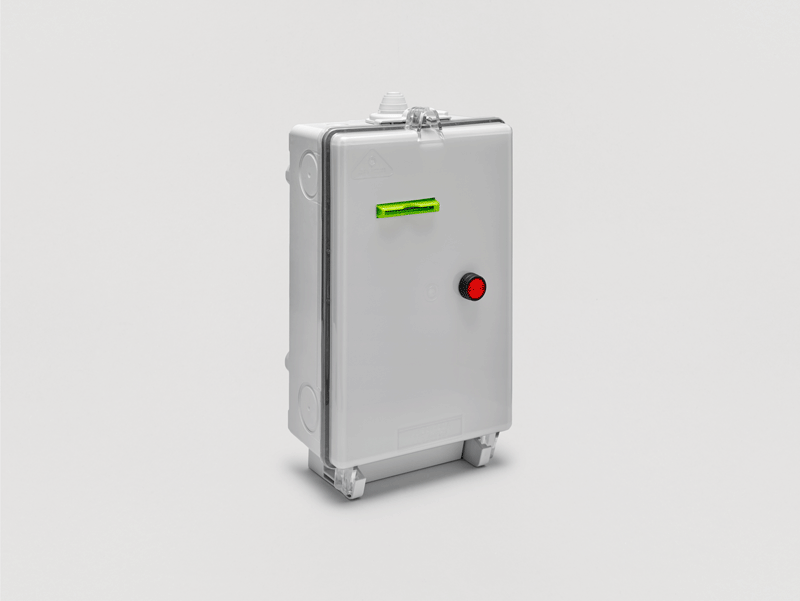
NOWs: Malte Bartsch, Bertrand Flanet, Igor Hosnedl, Signe Pierce and Raul Walch at EIGEN + ART Lab
image/video: Malte Bartsch, Time Machine, 2013 - ongoing
Malte Bartsch, Bertrand Flanet, Igor Hosnedl, Signe Pierce and Raul Walch at EIGEN + ART Labgroup exhibition
EIGEN + ART Lab
Torstraße 220
10115 Berlin
Opening: November 21, 2019, 5 – 7 pm
Exhibition: November 21, 2019 – December 19, 2019
Artists: Malte Bartsch, Bertrand Flanet, Igor Hosnedl, Signe Pierce and Raul Walch
image/video: Malte Bartsch, Time Machine, 2013 - ongoing
Malte Bartsch, Bertrand Flanet, Igor Hosnedl, Signe Pierce and Raul Walch at EIGEN + ART LabGruppenausstellung
EIGEN + ART Lab
Torstraße 220
10115 Berlin
Eröffnung: 21. November 2019, 17 – 21 Uhr
Aussellung: 21. November 2019 – 19. Dezember 2019
Künstler*innen: Malte Bartsch, Bertrand Flanet, Igor Hosnedl, Signe Pierce und Raul Walch

NOWs: Monologfestival 2019 – Die imaginäre Bewegung
Die imaginäre BewegungLive Performance zur Festivaleröffnung
THEATERDISCOUNTER
Klosterstraße 44
10179 Berlin
Installation täglich
Live Performance zur Festivaleröffnung 14. November 2019
ab 18.00 Uhr
Konzeptkünstler Raul Walch inszeniert aktuelle politische Positionen mit Fahnen, Bannern und Slogans in den öffentlichen Raum rund um den TD.
Die Installation fordert die Aufmerksamkeit der Passant*innen: Sie konfrontiert, indem komplexe Sachverhalte auf kurze Statements reduziert sind. Welche Vereinfachungen leuchten spontan ein, wo stolpern die Betrachter*innen in Widersprüche? Über diverse Aussagen formiert sich eine noch kaum greifbare Bewegung, die aus den aktuellen Krisen hervorgehen könnte. Welche Gestalt würde sie annehmen – und ist die Zeit reif dafür?
Da immer öfter politische Meinungen und Haltungen auf die Straße getragen werden stellt sich der Bildende Künstler Raul Walch der Herausforderung, die Betrachter jenseits des Kunstkontextes in eben diesem Raum und ganz direkt zu adressieren. Der aufgeladenen Stimmung, die sich über die Grenzen sozialer (Online-)Netzwerke im öffentlichen Raum breit macht, stellt er Die imaginäre Bewegung als Spielball, als Herausforderung zu einer eigenen, öffentlichen Positionierung gegenüber.
Idee / Umsetzung Raul Walch
Raul Walch überschreitet in seiner künstlerischen Praxis die Grenzen gängiger Kunst-Genres. Er arbeitet als Bildhauer und Konzeptkünstler, schlüpft in seinen Arbeiten aber ebenso natürlich in die Rolle des Performers oder Forschers. Im Mittelpunkt steht immer eine unkonventionelle, künstlerische Auseinandersetzung mit gesellschaftlicher Realität und nicht selten werden die Beobachter selbst zum Teil einer Performance. Die spielerischen Arbeiten und Aktionen von Walch beschränken sich nicht auf forschende Neugier oder teilnehmendes Beobachten, sondern sind oft ephemere und vor allem ortsspezifische Interventionen, die an den unterschiedlichsten Orten der Welt auf ihr Umfeld eingehen.
Monologfestival Konzeption & Kuration Janette Mickan / Michael Müller Raumkonzept Silke Bauer Presse björn & björn – Talea Schuré Produktionsleitung Imma Scarpato Grafik Christiane Patic / Christin Striegler Fotografie Dejan Patic Öffentlichkeitsarbeit Katarina Šakic Technische Leitung Anne Hübschmann / Stephan Mäusel Dokumentation Christopher Hewitt Produktion & Festivalteam Theaterdiscounter Gefördert durch Senatsverwaltung für Kultur und Europa Medienpartner taz – die tageszeitung / Theater heute / zitty
Die imaginäre BewegungLive Performance zur Festivaleröffnung
THEATERDISCOUNTER
Klosterstraße 44
10179 Berlin
Installation täglich
Live Performance zur Festivaleröffnung 14. November 2019
ab 18.00 Uhr
Konzeptkünstler Raul Walch inszeniert aktuelle politische Positionen mit Fahnen, Bannern und Slogans in den öffentlichen Raum rund um den TD.
Die Installation fordert die Aufmerksamkeit der Passant*innen: Sie konfrontiert, indem komplexe Sachverhalte auf kurze Statements reduziert sind. Welche Vereinfachungen leuchten spontan ein, wo stolpern die Betrachter*innen in Widersprüche? Über diverse Aussagen formiert sich eine noch kaum greifbare Bewegung, die aus den aktuellen Krisen hervorgehen könnte. Welche Gestalt würde sie annehmen – und ist die Zeit reif dafür?
Da immer öfter politische Meinungen und Haltungen auf die Straße getragen werden stellt sich der Bildende Künstler Raul Walch der Herausforderung, die Betrachter jenseits des Kunstkontextes in eben diesem Raum und ganz direkt zu adressieren. Der aufgeladenen Stimmung, die sich über die Grenzen sozialer (Online-)Netzwerke im öffentlichen Raum breit macht, stellt er Die imaginäre Bewegung als Spielball, als Herausforderung zu einer eigenen, öffentlichen Positionierung gegenüber.
Idee / Umsetzung Raul Walch
Raul Walch überschreitet in seiner künstlerischen Praxis die Grenzen gängiger Kunst-Genres. Er arbeitet als Bildhauer und Konzeptkünstler, schlüpft in seinen Arbeiten aber ebenso natürlich in die Rolle des Performers oder Forschers. Im Mittelpunkt steht immer eine unkonventionelle, künstlerische Auseinandersetzung mit gesellschaftlicher Realität und nicht selten werden die Beobachter selbst zum Teil einer Performance. Die spielerischen Arbeiten und Aktionen von Walch beschränken sich nicht auf forschende Neugier oder teilnehmendes Beobachten, sondern sind oft ephemere und vor allem ortsspezifische Interventionen, die an den unterschiedlichsten Orten der Welt auf ihr Umfeld eingehen.
Monologfestival Konzeption & Kuration Janette Mickan / Michael Müller Raumkonzept Silke Bauer Presse björn & björn – Talea Schuré Produktionsleitung Imma Scarpato Grafik Christiane Patic / Christin Striegler Fotografie Dejan Patic Öffentlichkeitsarbeit Katarina Šakic Technische Leitung Anne Hübschmann / Stephan Mäusel Dokumentation Christopher Hewitt Produktion & Festivalteam Theaterdiscounter Gefördert durch Senatsverwaltung für Kultur und Europa Medienpartner taz – die tageszeitung / Theater heute / zitty
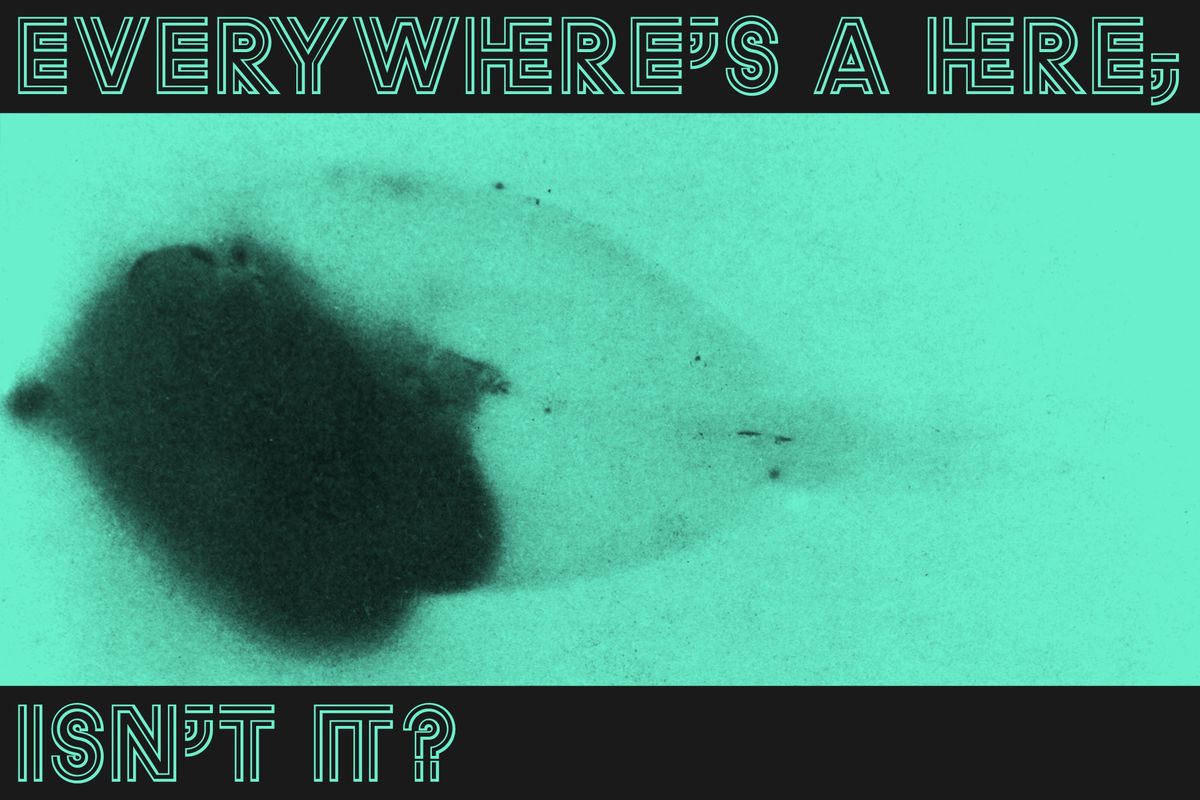
NOWs: The Long Term You Cannot Afford. On The Distribution Of The Toxic
The Long Term You Cannot Afford. On The Distribution Of The ToxicResearch, performance and exhibition Project
Exhibition
19.10.– 01.12.2019
Opening hours
Thurs–Sun 2 pm – 7 pm
SAVVY Contemporary
Plantagenstraße 31
13347 Berlin
Free entry – Donations welcome
With: Boris Anje, Julieta Aranda, Christian Danielewitz and Anu Ramdas, Anne Duk Hee Jordan and Pauline Doutreluingne, Assaf Gruber, He Xiangyu, Nona Inescu, Anja Kanngieser, Jessika Khazrik, Candice Lin, Natascha Sadr Haghighian and Ashkan Sepahvand, Neda Saeedi, Zina Saro-Wiwa, Jonas Staal in collaboration with Jonas Stuck, Stephan R. Thierbach and Nada Tshibuabua
Following our agropoetic endeavour around land struggle and agroecological resistance, this subsequent project examines a field closely connected: the complex notions and injustices surrounding the toxic and its ongoing power-plays, relations, and rhetorics that are deeply rooted in historical structures. Our aim is to open up a space for an artistic and critical registry that encourages us to pause and sense the toxic presences and textures otherwise, to acknowledge and mourn its ongoing victims, and to listen to the movement of its shadows. In so doing, we hope to shift sensibilities away from one of paranoid containment and fear to an outlook fueled by reflexivity and nuance, and to nurture the act of noticing how actions on the most intimate scale are closely tied to the global – as everywhere is ultimately a here.
The Long Term You Cannot Afford. On The Distribution Of The ToxicResearch, performance and exhibition Project
Exhibition
19.10.– 01.12.2019
Opening hours
Thurs–Sun 2 pm – 7 pm
SAVVY Contemporary
Plantagenstraße 31
13347 Berlin
Free entry – Donations welcome
With: Boris Anje, Julieta Aranda, Christian Danielewitz and Anu Ramdas, Anne Duk Hee Jordan and Pauline Doutreluingne, Assaf Gruber, He Xiangyu, Nona Inescu, Anja Kanngieser, Jessika Khazrik, Candice Lin, Natascha Sadr Haghighian and Ashkan Sepahvand, Neda Saeedi, Zina Saro-Wiwa, Jonas Staal in collaboration with Jonas Stuck, Stephan R. Thierbach and Nada Tshibuabua
Following our agropoetic endeavour around land struggle and agroecological resistance, this subsequent project examines a field closely connected: the complex notions and injustices surrounding the toxic and its ongoing power-plays, relations, and rhetorics that are deeply rooted in historical structures. Our aim is to open up a space for an artistic and critical registry that encourages us to pause and sense the toxic presences and textures otherwise, to acknowledge and mourn its ongoing victims, and to listen to the movement of its shadows. In so doing, we hope to shift sensibilities away from one of paranoid containment and fear to an outlook fueled by reflexivity and nuance, and to nurture the act of noticing how actions on the most intimate scale are closely tied to the global – as everywhere is ultimately a here.
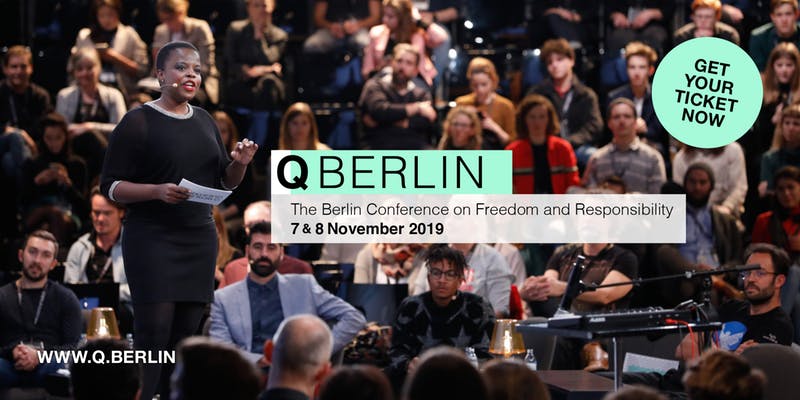
NOWs: Q Berlin – The Berlin Conference on Freedom and Responsibility
Q BerlinThe Berlin Conference on Freedom and Responsibility
Date And Time
Thu, 7 Nov 2019, 09:00 –
Fri, 8 Nov 2019, 20:00 CET
Location
STATION Berlin (7 Nov), Halls 4 & 5
Luckenwalder Straße 4-6
10963 Berlin
Berlin stands for freedom, courage and tolerance. We believe our dynamic city should act as a strong voice in tackling the most pressing issues of our time – revitalising our social values, and welcoming people from far and wide. Q BERLIN provides a space to share these global perspectives, disrupt, inspire, and tear down walls to shape the future we want to live in.
Q BERLIN invites you to hear and share perspectives on today’s most pressing issues. Spend a day full of inspirational talks, interviews and Q&A-sessions from and with international guests on the driving topics Civil Responsibility, Urban Life, New Work and Human Technologies.
In an increasingly globalised world: What values need to be renegotiated? What are opportunities and risks through artificial intelligence? What impact could life-long learning, basic income and volunteer work have on society? Sustainability and city planning for the future: What are the key factors?
Over the span of two days, Q BERLIN engages in an open dialogue on social values and the roles each of us plays shaping the future we want to live in.
DAY 1 Q CONFERENCE
STATION Berlin | 7 NOV 2019
Experts and unconventional minds share their perspectives on the fundamental questions driving Berlin, Europe and our contemporary world forward.
DAY 2 Q IMMERSIONS
MULTIPLE LOCATIONS | 8 NOV 2019Deep Dive into the conference topics. Select spaces, institutions and businesses where today’s fundamental questions are being negotiated open their doors.
Bundesministerium für Arbeit und Soziales
The Future of Work – will automation and AI make for a jobless future?
re:publica Berlin
ASAP („As Soon As Possible“) – transferring the immediacy of the digital to culture
Smart City | DB
Mobile working environments – How co-working at railway stations can improve our working lives
Infarm
Urban Farming – sustainable solutions for our growing cities
More info here
Q BerlinThe Berlin Conference on Freedom and Responsibility
Date And Time
Thu, 7 Nov 2019, 09:00 –
Fri, 8 Nov 2019, 20:00 CET
Location
STATION Berlin (7 Nov), Halls 4 & 5
Luckenwalder Straße 4-6
10963 Berlin
Berlin stands for freedom, courage and tolerance. We believe our dynamic city should act as a strong voice in tackling the most pressing issues of our time – revitalising our social values, and welcoming people from far and wide. Q BERLIN provides a space to share these global perspectives, disrupt, inspire, and tear down walls to shape the future we want to live in.
Q BERLIN invites you to hear and share perspectives on today’s most pressing issues. Spend a day full of inspirational talks, interviews and Q&A-sessions from and with international guests on the driving topics Civil Responsibility, Urban Life, New Work and Human Technologies.
In an increasingly globalised world: What values need to be renegotiated? What are opportunities and risks through artificial intelligence? What impact could life-long learning, basic income and volunteer work have on society? Sustainability and city planning for the future: What are the key factors?
Over the span of two days, Q BERLIN engages in an open dialogue on social values and the roles each of us plays shaping the future we want to live in.
DAY 1 Q CONFERENCE
STATION Berlin | 7 NOV 2019
Experts and unconventional minds share their perspectives on the fundamental questions driving Berlin, Europe and our contemporary world forward.
DAY 2 Q IMMERSIONS
MULTIPLE LOCATIONS | 8 NOV 2019Deep Dive into the conference topics. Select spaces, institutions and businesses where today’s fundamental questions are being negotiated open their doors.
Bundesministerium für Arbeit und Soziales
The Future of Work – will automation and AI make for a jobless future?
re:publica Berlin
ASAP („As Soon As Possible“) – transferring the immediacy of the digital to culture
Smart City | DB
Mobile working environments – How co-working at railway stations can improve our working lives
Infarm
Urban Farming – sustainable solutions for our growing cities
More info here
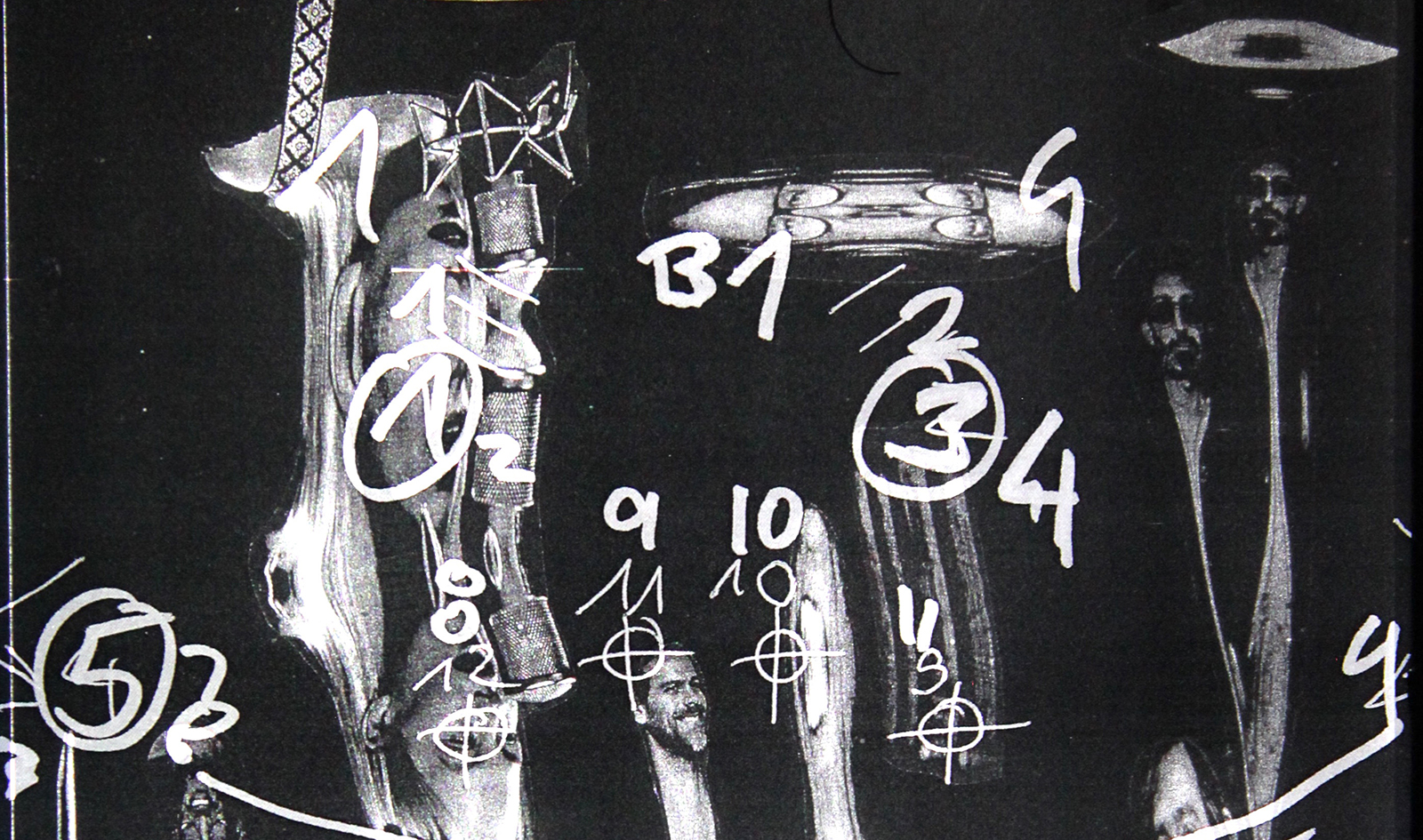
NOWs: The Spatio Sensory Soundcheck – Jan St. Werner & The National
Jan St. Werner & The National: The Spatio Sensory Soundcheckambient sound installation
Haus der Kulturen der Welt
John-Foster-Dulles-Allee 10
10557 Berlin
premiere
21 November, 6 pm
Sound becomes a spatial experience, band structures are deconstructed, a brand new sound technology celebrates its premiere in art: Last year, Jan St. Werner, part of the duo Mouse on Mars, listened to a festival sound check by the US indie rock band The National. Echoes, voices and acoustic artifacts overlapped, songs were begun and interrupted, harmonies were detuned and filtered. The picture of the perfect rock band was torn open, while at the same time the incompleteness of the action seemed to follow a method. The ambient sound installation The Spatio Sensory Soundcheck reconstructs this experience. The musician and composer disassembled a sound check recording as well as individual tracks of the current album I Am Easy to Find by The National, then electronically manipulated and reassembled them with his own elements. Mouse on Mars and The National had contributed music to each other’s most recent albums. Now Jan St. Werner goes a step further – the installation dissolves the categories of band and album and shifts the sounds in a continuous state of instability on a psychoacoustic stage: With a novel speaker system based on wave field synthesis, Jan St. Werner arranges the sounds independently of each other in the space; movements and perspectives of the listeners become part of the composition.
The installation employs a speaker system by Holoplot. The audio technology of the Berlin-based company creates fully digital 3D-beamforming of multiple audio beams based on its own wave field synthesis algorithms and real-time audio processing.
Duration: 70 minutes, beginning at
21 Nov: 6pm, 7.30pm, 9pm
22 Nov: 3pm, 4.30pm, 6pm, 7.30pm, 9pm, 10.30pm
23 Nov: 3pm, 4.30pm, 6pm, 7.30pm, 9pm, 10.30pm
24 Nov: 3pm, 4.30pm, 6pm, 7.30pm, 9pm
25 Nov: 3pm, 4.30pm, 6pm
27 Nov: 3pm, 4.30pm, 6pm
Jan Werner | Jan St. Werner & The National: The Spatio Sensory Soundcheck | © Promo
Jan St. Werner & The National: The Spatio Sensory SoundcheckRaumklanginstallation
Haus der Kulturen der Welt
John-Foster-Dulles-Allee 10
10557 Berlin
premiere
21. November, 18 h
Klang wird zum Erlebnisraum, Bandstrukturen werden dekonstruiert, eine völlig neue Raumklangtechnologie feiert Premiere in der Kunst: Im vergangenen Jahr hört Jan St. Werner, Teil des Duos Mouse on Mars, einem Festivalsoundcheck der US-Indie-Rock-Band The National zu. Echos, Stimmen und akustische Artefakte überlagern sich, Songs werden angestimmt und abgebrochen, Harmonien verstimmt und gefiltert. Das Bild der perfekten Rockband wird aufgerissen, gleichzeitig scheint die Unfertigkeit des Geschehens einer Methode zu folgen. Die Raumklanginstallation The Spatio Sensory Soundcheck rekonstruiert diese Erfahrung. Dazu hat der Musiker und Komponist einen Soundcheck-Mitschnitt sowie Einzelspuren des aktuellen Albums I Am Easy To Find von The National zerlegt, elektronisch manipuliert und mit eigenen Elementen neu zusammengesetzt. Bereits für ihre letzten Alben hatten Mouse on Mars und The National gegenseitig Musik beigesteuert. Nun geht Jan St. Werner einen Schritt weiter – die Installation löst die Kategorien von Band und Album auf und versetzt die Klänge in eine kontinuierliche Instabilität auf einer psychoakustischen Bühne: Mit einem neuartigen Lautsprechersystem, das auf Wellenfeldsysnthese basiert, arrangiert Jan St. Werner die Klänge unabhängig voneinander im Raum; Bewegung und Perspektive der Zuhörer*innen werden Teil der Komposition.
Die Installation verwendet ein Lautsprechersystem von Holoplot. Die Audiotechnik des Berliner Unternehmens realisiert volldigitale 3D-Strahlformung von mehreren Strahlen auf Basis eigener Wellenfeldsynthese-Algorithmen und Echtzeit-Audioverarbeitung.
Dauer: 70 Minuten, Beginn jeweils:
21.11.: 18h, 19.30h, 21h
22.11.: 15h, 16.30h, 18h, 19.30h, 21h, 22.30h
23.11.: 15h, 16.30h, 18h, 19.30h, 21h, 22.30h
24.11.: 15h, 16.30h, 18h, 19.30h, 21h
25.11.: 15h, 16.30h, 18h
27.11.: 15h, 16.30h, 18h
Jan Werner | Jan St. Werner & The National: The Spatio Sensory Soundcheck | © Promo
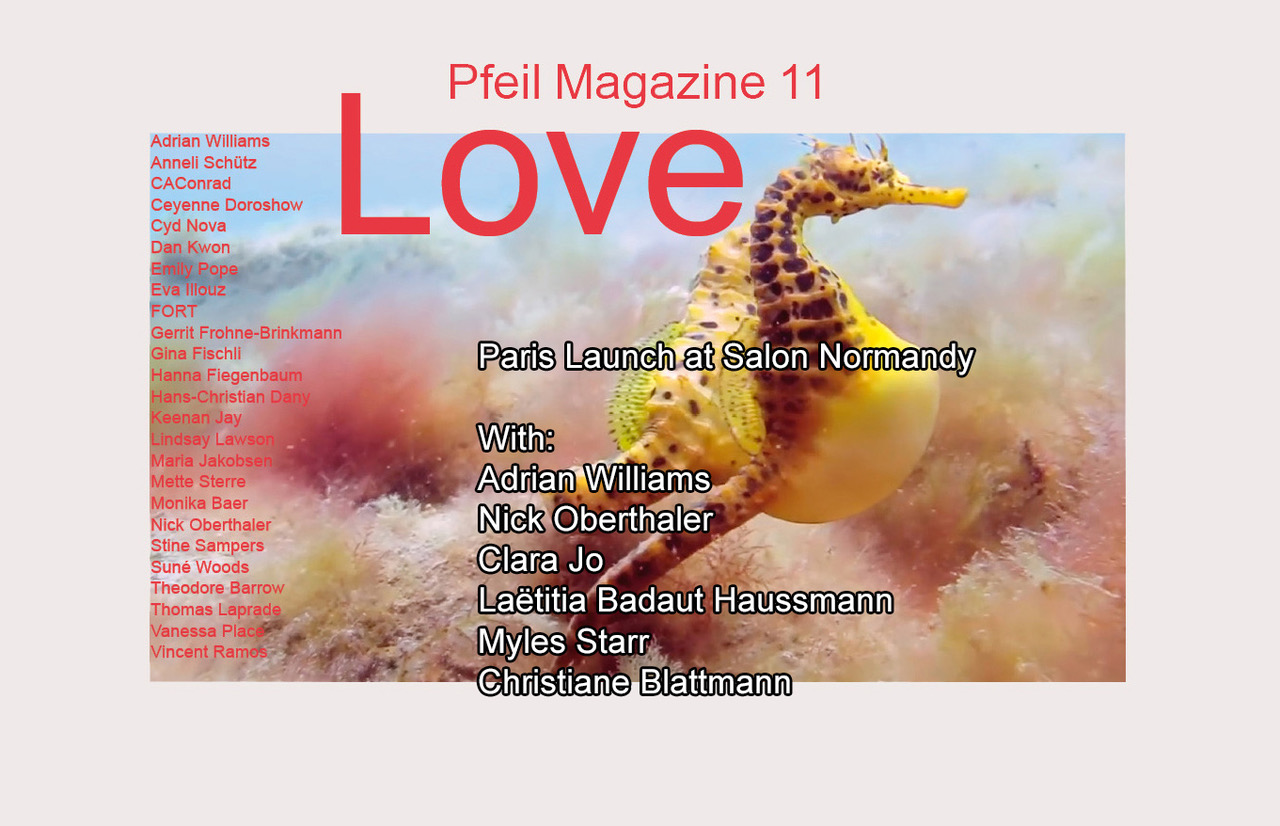
NOWs: Montez Press at Salon de Normandy
Sunday, 20 October, 4-5 pm
Salon de Normandy by The Community
Normandy Hôtel
7 Rue de l’Échelle
75001 Paris
Paris launch of the Pfeil Magazine LOVE issue at Salon de Normandy by The Community in collaboration with After 8 Books
with: Adrian Williams, Nick Oberthaler, Clara Jo, Laetitia Badaut Haussmann, Myles Starr, Christiane Blattmann
Sunday, 20 October, 4-5 pm
Salon de Normandy by The Community
Normandy Hôtel
7 Rue de l’Échelle
75001 Paris
Paris launch of the Pfeil Magazine LOVE issue at Salon de Normandy by The Community in collaboration with After 8 Books
with: Adrian Williams, Nick Oberthaler, Clara Jo, Laetitia Badaut Haussmann, Myles Starr, Christiane Blattmann
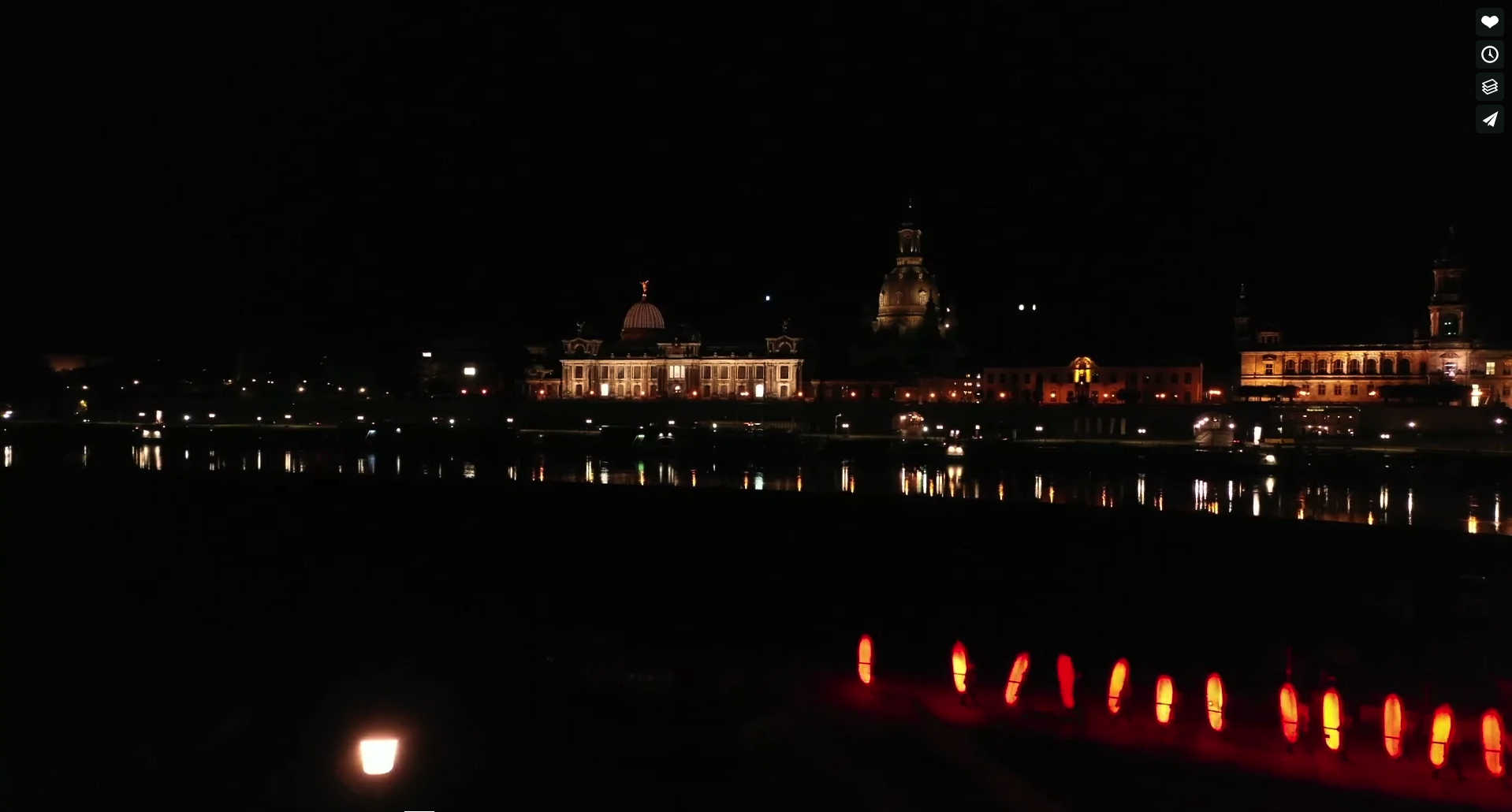
NOWS: Signals 3.0 – Call | Dresden | Goldener Reiter
Aufruf | Dresden | Goldener Reiter
9. November, 18 Uhr
Wir laden alle Dresdner*innen ein, am Samstag, den 9. November, um 18 Uhr am Goldenen Reiter zusammenzukommen, um gemeinsam Dresden zu erhellen. An der Elbe, im Herzen von Dresden wollen wir mit Dresdner*innen aus aller Welt und 80 Leuchtskulpturen die Stadt neu beleuchten. Unser Ziel ist es, an diesem historischen Datum im öffentlichen Raum von Dresden Präsenz zu zeigen und eine neue Form des kollektiven Gedenkens zu praktizieren in Erinnerung an die Resonanzräume des 9. November und seinen Dreiklang in der deutschen- und Weltgeschichte:
-am 9. November 1918 wurde die Republik ausgerufen;
-am 9. November 1938 fand die Reichspogromnacht statt;
-am 9. November 1989 öffneten sich die Grenzen der DDR.
Bitte bringt ein Licht mit – egal, ob Fahrradleuchte, Taschenlampe oder Handy. Kommt und leuchtet mit uns!
Tools for Action in Zusammenarbeit mit Tomás Espinosa, eine Koproduktion von Kunsthaus Dresden, HELLERAU – Europäisches Zentrum der Künste, Montagscafé/Staatsschauspiel Dresden
—
Signals 3.0 ist ein künstlerisches Projekt und eine Choreografie für Alle! von der Künstlergruppe Tools for Action in Zusammenarbeit mit Tomás Espinosa in einer Koproduktion von Kunsthaus Dresden, HELLERAU – Europäisches Zentrum der Künste und Montagscafé / Staatsschauspiel Dresden.
Mit Dank für die freundliche Zusammenarbeit an Vonovia Dresden.
Gefördert im Rahmen des Programms „Revolution und Demokratie” der Sächsischen Staatskanzlei. Dieses Projekt wird mitfinanziert mit Steuermitteln auf Grundlage des vom Sächsischen Landtag beschlossenen Haushaltes.
——
Credits:
Filmbilder: Tools for Action
Bilder von Dresden am 4. Oktober 1989 mit der freundlichen Unterstützung von dem Dresdner Künstler David Adam. Als Neunzehnjähriger fotografierte er den Gewaltausbruch am Dresdner Hauptbahnhof Nord, als Flüchtlingszüge mit DDR-Bürgern aus Tschechien kommend den Bahnhof im Transit durchfuhren in Richtung Westdeutschland.
Dokumentarische Fotos wikimedia Lizenzfrei.
Fackelzug des DDR-Jugendverbandes FDJ (Freie Deutsche Jugend) am Vorabend des 40. Jahrestages der DDR in Berlin Unter den Linden, aufgenommen am 6. Oktober 1989. (picture alliance/ZB/Peter Zimmermann)
Musik: Steev Lemercier | Barbudan remix
Schnitt: Artúr van Balen
Aufruf | Dresden | Goldener Reiter
9. November, 18 Uhr
Wir laden alle Dresdner*innen ein, am Samstag, den 9. November, um 18 Uhr am Goldenen Reiter zusammenzukommen, um gemeinsam Dresden zu erhellen. An der Elbe, im Herzen von Dresden wollen wir mit Dresdner*innen aus aller Welt und 80 Leuchtskulpturen die Stadt neu beleuchten. Unser Ziel ist es, an diesem historischen Datum im öffentlichen Raum von Dresden Präsenz zu zeigen und eine neue Form des kollektiven Gedenkens zu praktizieren in Erinnerung an die Resonanzräume des 9. November und seinen Dreiklang in der deutschen- und Weltgeschichte:
-am 9. November 1918 wurde die Republik ausgerufen;
-am 9. November 1938 fand die Reichspogromnacht statt;
-am 9. November 1989 öffneten sich die Grenzen der DDR.
Bitte bringt ein Licht mit – egal, ob Fahrradleuchte, Taschenlampe oder Handy. Kommt und leuchtet mit uns!
Tools for Action in Zusammenarbeit mit Tomás Espinosa, eine Koproduktion von Kunsthaus Dresden, HELLERAU – Europäisches Zentrum der Künste, Montagscafé/Staatsschauspiel Dresden
—
Signals 3.0 ist ein künstlerisches Projekt und eine Choreografie für Alle! von der Künstlergruppe Tools for Action in Zusammenarbeit mit Tomás Espinosa in einer Koproduktion von Kunsthaus Dresden, HELLERAU – Europäisches Zentrum der Künste und Montagscafé / Staatsschauspiel Dresden.
Mit Dank für die freundliche Zusammenarbeit an Vonovia Dresden.
Gefördert im Rahmen des Programms „Revolution und Demokratie” der Sächsischen Staatskanzlei. Dieses Projekt wird mitfinanziert mit Steuermitteln auf Grundlage des vom Sächsischen Landtag beschlossenen Haushaltes.
——
Credits:
Filmbilder: Tools for Action
Bilder von Dresden am 4. Oktober 1989 mit der freundlichen Unterstützung von dem Dresdner Künstler David Adam. Als Neunzehnjähriger fotografierte er den Gewaltausbruch am Dresdner Hauptbahnhof Nord, als Flüchtlingszüge mit DDR-Bürgern aus Tschechien kommend den Bahnhof im Transit durchfuhren in Richtung Westdeutschland.
Dokumentarische Fotos wikimedia Lizenzfrei.
Fackelzug des DDR-Jugendverbandes FDJ (Freie Deutsche Jugend) am Vorabend des 40. Jahrestages der DDR in Berlin Unter den Linden, aufgenommen am 6. Oktober 1989. (picture alliance/ZB/Peter Zimmermann)
Musik: Steev Lemercier | Barbudan remix
Schnitt: Artúr van Balen

NOWs: Towards No Earthly Pole by Julian Charrière
Julian Charrière - Towards No Earthly Pole, 2019, © the Artist; VG Bild-Kunst, Bonn, Germany
Towards No Earthly Polesolo exhibition
MASI Lugano
LAC Lugano Arte e Cultura
Piazza Bernardino Luini 6
CH – 6901 Lugano
Switzerland
Opening
26 October 2019, 6 pm
Between 27 October 2019 and 15 March 2020 the Museo d’arte della Svizzera italiana will be presenting a large solo exhibition by Julian Charrière, one of the most innovative and promising young Swiss artists of his generation. Titled Towards No Earthly Pole, the exhibition has been developed around a new videowork of the same name, for which the artist explored remote places subject to extremely hostile weather. The exhibition will subsequently be presented in a modified version at the Aargauer Kunsthaus in Aarau and at the Dallas Museum of Art.
Julian Charrière immediately stood out on the contemporary art scene as a modern explorer on a conceptual artistic quest that combines different disciplines, including geology, archaeology, physics and history. Employing performance, sculpture, photography and video, his work offers new and unexpected perspectives on some of the essential issues of our era, and related to humanity in general. Charrière spends much time travelling, visiting regions of the planet that are both very remote and invested with a strong geopolitical identity for instance, volcanoes, glaciers, radioactive sites where, using unconventional methods and materials, he investigates the tensions and elemental link that exists between human civilisation and the landscapes it inhabits.
The idea of the Towards No Earthly Pole project arose in 2017 when Charrière was invited on board a ship of Russian researchers passing through the Drake Passage that runs between Cape Horn and the Southern Shetland Islands. The powerful impression made on him by the Antarctic landscape and his readings of early 20th-century exploration gave rise to the work, which subsequently took him to the Rodano and Aletsch glaciers in Switzerland, Mont Blanc, Iceland and Greenland.
The title of the show and project is taken from a verse that the English poet Alfred Tennyson dedicated to John Franklin who died along with his entire team during his famous polar expedition of 1845 and creates an immediate association with the world of exploration of the 19th and early 20th centuries. During that period, the Poles and glaciers were the last regions of the Earth to be conquered and mapped; the last frontiers, they were mysterious and gruelling to cross. Today they are considered fragile ecosystems that need to be protected and are fundamental symbols of the Anthropocene, yet they are also the planet’s most alien places where life is extremely difficult. Although only a minuscule fraction of the human population has ever visited them, the North and South Poles are a fixed feature of the collective imaginary with a power of fascination generated by photographs, historic accounts and literature.
The exhibition at MASI has been conceived as a diorama that visitors can enter. With a projection at its centre, Charrière has created an environmental installation that transforms the entire exhibition space into a setting associated with the central subjects and themes of the videowork. The aim of the artist is to intensify the visitor’s involvement by means of a sensory experience as well as the rapport between the observer and the landscape represented.
The Arctic and glaciers are extremely different from our everyday world. The sounds, light and matter experienced during exploratory journeys in these places are fundamental elements of the process of discovery. They form a set of sensations that imbue the landscape with an ancient force and mystery, partly beautiful but also partly threatening, that emphasise each place’s individual existence despite not being free of man’s presence, as though to remind us that human activities today rival the power of the forces of nature, skewing the relationship between culture and nature, and the romantic poetics associated with them.
Alongside reinterpretations of previous works in the environmental installation, there will be new works produced by the artist for the MASI exhibition, for which he has included in his research local subjects and natural resources, and on which he has worked with Ticinese craftsmen.
Through his research, Charrière recreates a dialogue with the landscape and endeavours to rediscover the feeling of astonishment that ancient man felt confronted by nature: in the same way that man acts upon nature, nature acts upon man, and the place where this occurs is the setting for the birth of a work of art.
Julian Charrière – Towards No Earthly Pole has been made possible by the museum’s primary partner, Credit Suisse, by its scientific partner the IBSA Foundation for scientific research, by the exhibition sponsor La Prairie, and by the support of Pro Helvetia, Göhner Stiftung, the Stanley Thompson Foundation, Fondation Coromandel and Erna und Curt Burgauer Stiftung.
Julian Charrière - Towards No Earthly Pole, 2019, © the Artist; VG Bild-Kunst, Bonn, Germany
Julian Charrière - Towards No Earthly Pole, 2019, © the Artist; VG Bild-Kunst, Bonn, Germany
Julian Charrière - Towards No Earthly Pole, 2019, © the Artist; VG Bild-Kunst, Bonn, Germany
Towards No Earthly Polesolo exhibition
MASI Lugano
LAC Lugano Arte e Cultura
Piazza Bernardino Luini 6
CH – 6901 Lugano
Switzerland
Eröffnung
26. October 2019, 18 h
Between 27 October 2019 and 15 March 2020 the Museo d’arte della Svizzera italiana will be presenting a large solo exhibition by Julian Charrière, one of the most innovative and promising young Swiss artists of his generation. Titled Towards No Earthly Pole, the exhibition has been developed around a new videowork of the same name, for which the artist explored remote places subject to extremely hostile weather. The exhibition will subsequently be presented in a modified version at the Aargauer Kunsthaus in Aarau and at the Dallas Museum of Art.
Julian Charrière immediately stood out on the contemporary art scene as a modern explorer on a conceptual artistic quest that combines different disciplines, including geology, archaeology, physics and history. Employing performance, sculpture, photography and video, his work offers new and unexpected perspectives on some of the essential issues of our era, and related to humanity in general. Charrière spends much time travelling, visiting regions of the planet that are both very remote and invested with a strong geopolitical identity for instance, volcanoes, glaciers, radioactive sites where, using unconventional methods and materials, he investigates the tensions and elemental link that exists between human civilisation and the landscapes it inhabits.
The idea of the Towards No Earthly Pole project arose in 2017 when Charrière was invited on board a ship of Russian researchers passing through the Drake Passage that runs between Cape Horn and the Southern Shetland Islands. The powerful impression made on him by the Antarctic landscape and his readings of early 20th-century exploration gave rise to the work, which subsequently took him to the Rodano and Aletsch glaciers in Switzerland, Mont Blanc, Iceland and Greenland.
The title of the show and project is taken from a verse that the English poet Alfred Tennyson dedicated to John Franklin who died along with his entire team during his famous polar expedition of 1845 and creates an immediate association with the world of exploration of the 19th and early 20th centuries. During that period, the Poles and glaciers were the last regions of the Earth to be conquered and mapped; the last frontiers, they were mysterious and gruelling to cross. Today they are considered fragile ecosystems that need to be protected and are fundamental symbols of the Anthropocene, yet they are also the planet’s most alien places where life is extremely difficult. Although only a minuscule fraction of the human population has ever visited them, the North and South Poles are a fixed feature of the collective imaginary with a power of fascination generated by photographs, historic accounts and literature.
The exhibition at MASI has been conceived as a diorama that visitors can enter. With a projection at its centre, Charrière has created an environmental installation that transforms the entire exhibition space into a setting associated with the central subjects and themes of the videowork. The aim of the artist is to intensify the visitor’s involvement by means of a sensory experience as well as the rapport between the observer and the landscape represented.
The Arctic and glaciers are extremely different from our everyday world. The sounds, light and matter experienced during exploratory journeys in these places are fundamental elements of the process of discovery. They form a set of sensations that imbue the landscape with an ancient force and mystery, partly beautiful but also partly threatening, that emphasise each place’s individual existence despite not being free of man’s presence, as though to remind us that human activities today rival the power of the forces of nature, skewing the relationship between culture and nature, and the romantic poetics associated with them.
Alongside reinterpretations of previous works in the environmental installation, there will be new works produced by the artist for the MASI exhibition, for which he has included in his research local subjects and natural resources, and on which he has worked with Ticinese craftsmen.
Through his research, Charrière recreates a dialogue with the landscape and endeavours to rediscover the feeling of astonishment that ancient man felt confronted by nature: in the same way that man acts upon nature, nature acts upon man, and the place where this occurs is the setting for the birth of a work of art.
Julian Charrière – Towards No Earthly Pole has been made possible by the museum’s primary partner, Credit Suisse, by its scientific partner the IBSA Foundation for scientific research, by the exhibition sponsor La Prairie, and by the support of Pro Helvetia, Göhner Stiftung, the Stanley Thompson Foundation, Fondation Coromandel and Erna und Curt Burgauer Stiftung.
Julian Charrière - Towards No Earthly Pole, 2019, © the Artist; VG Bild-Kunst, Bonn, Germany
Julian Charrière - Towards No Earthly Pole, 2019, © the Artist; VG Bild-Kunst, Bonn, Germany
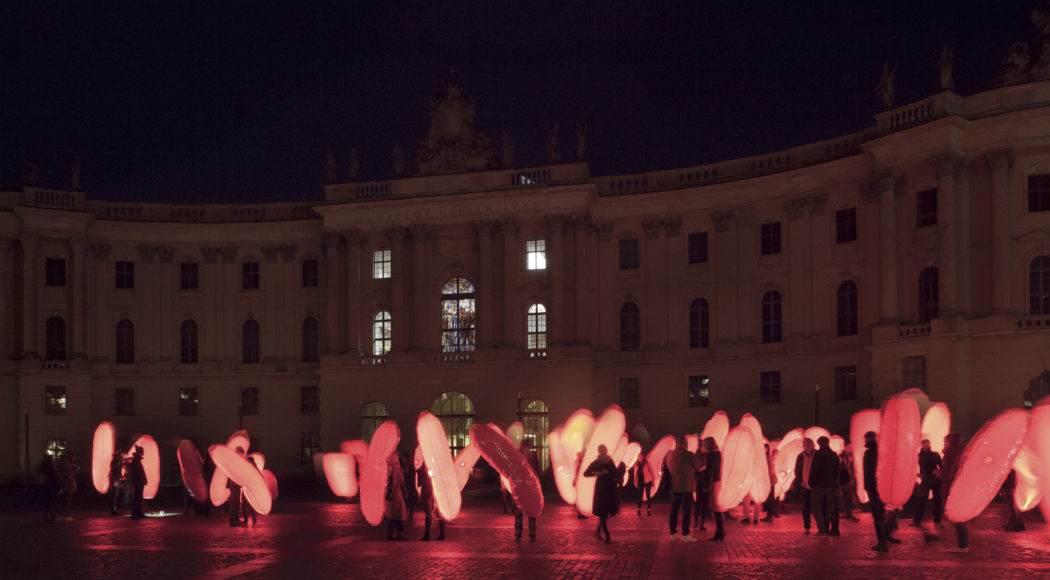
NOWs: Signals 3.0
Signals, Resonating Revolutions, Berlin 2018, Tools for Action Foundation in Kollaboration mit Tomas Espinosa und Kulturprojekte Berlin im Rahmen von 100 Jahre Revolution, Berlin 1918/19. Foto: Luca Giardini
Signals 3.0Eine Choreografie für Alle! im Dresdner Stadtraum
Open Call / Aufruf
und Eröffnung
15. Oktober 2019, 19 Uhr
Signals 3.0.!
Neuer Projektraum
Hauptstrasse 44
Nähe Albertplatz/ Jorge-Gomondai-Platz (neben dem Restaurant “Der Löwe”)
01097 Dresden
Wie sind Menschen und Orte mit Geschichte und Erinnerung verbunden? Welche Erinnerungen entstehen durch die gemeinsame Bewegung von Körpern im Raum? Wie könnte eine neue, lebendige Form des Gedenkens aussehen?
Als Choreografie für Alle! mit aufblasbaren Leuchtskulpturen für ca. 80 Performer*innen und aktiver Beteiligung vieler weiterer Menschen wird Signals 3.0 am Samstag, den 9. November im Herzen von Dresden neue Formen der Versammlung und der kollektiven Kommunikation erproben.
Der Impuls für das Experiment Signals 3.0 kommt durch den niederländisch-ungarischen Künstler Artúr van Balen und den kolumbianischen Künstler Tomas Espinosa sowie die Stiftung Tools for Action. Die Choreografie für Alle! am 9. November im Stadtraum von Dresden greift drei historische Ereignisse auf, die sich mit diesem Datum verbinden: Der Ausruf der ersten deutschen Republik 1918, die Novemberprogrome im Jahr 1938 und der Fall der Mauer 1989. Der Dreiklang dieser Ereignisse ruft auch in Dresden besondere Erinnerungen wach. Gemeinsam soll zu neuen Formen des Gedenkens und kollektiven Formen des Erzählens geforscht werden: Welche veränderte Rolle spielt das ‚Wir’ im Rückblick auf historische Ereignisse und welche neuen Formen des Austausches zwischen subjektiver Erfahrung von Gegenwart und Geschichte sind denkbar?
SIGNALS 3.0. Eröffnung am Dienstag, den 15. Oktober
Am kommenden Dienstag, den 15. Oktober eröffnet das Tools for Action-Studio in einem leerstehenden Ladenlokal auf der Hauptstraße. Das Studio fungiert als Begegnungsort, Werkstatt und als Ausstellungsraum für ein offenes gemeinsam erarbeitetes Archiv. Zu einer Reihe von Gesprächen und Workshops mit Zeitzeug*innen, Historiker*innen und Choreograf*innen laden Artúr van Balen und Tomas Espinosa hier gemeinsam mit dem Kunsthaus Dresden, HELLERAU –Europäisches Zentrum der Künste und dem Montagscafé/ Staatsschauspiel Dresden ein.Zur Eröffnung am kommenden Dienstag, den 15. Oktober um 19 Uhr laden wir Alle! im Tools for Action-Studio in der Hauptstrasse 44 nahe dem Albertplatz herzlich ein!
Mit Beiträgen von Artúr van Balen / Tools for Action und Tomas Espinosa zum Projekt Signals 3.0, dem Historiker Wolfgang Niess im Gespräch mit Dresdener Bürgerrechtler über die Resonanzräume des 9. November und der Choreografin Floor van Leeuwen über Kollektivität in ihrer Tanzpraxis.
OPEN CALL zum Offenen Archiv von 1918 bis 2019
Gern geben wir hiermit den Aufruf von Artúr van Balen und Tomas Espinosa weiter, zum offenen Archiv beizutragen. Bitte bringt Eure Erinnerungen in Form von Fotos, Filmen, Objekten oder Texten mit, die sich mit Jahreszahlen 1918, 1938, 1989 und 2019 verbinden!Nähere Informationen zu den folgenden Programmpunkten und Terminen im Projekt Signals 3.0 finden Sie unter www.kunsthausdresden.de.
Wir laden Sie ebenfalls herzlich ein, sich unter kunsthaus@museen-dresden.de oder bei Caro Gerlach, Produktionsleitung, unter carolingerlach@gmx.net oder Telefon 0351-20884833 zu melden. Gern vermitteln wir Ihnen Hinweise zu der aktiven Teilnahme an der öffentlichen Performance am 9. November!
Signals, Resonating Revolutions, Berlin 2018, Tools for Action Foundation in Kollaboration mit Tomas Espinosa und Kulturprojekte Berlin im Rahmen von 100 Jahre Revolution, Berlin 1918/19. Foto: Luca Giardini
Ein künstlerisches Projekt und eine Choreografie für Alle! in einer Koproduktion von Kunsthaus Dresden, HELLERAU – Europäisches Zentrum der Künste und Montagscafé/ Staatsschauspiel Dresden. Mit Dank für die freundliche Zusammenarbeit an Vonovia Dresden.
Gefördert im Rahmen des Programms “Revolution und Demokratie” der Sächsischen Staatskanzlei.
Diese Maßnahme wird mitfinanziert mit Steuermitteln auf Grundlage des vom Sächsischen Landtag beschlossenen Haushaltes.
Signals, Resonating Revolutions, Berlin 2018, Tools for Action Foundation in Kollaboration mit Tomas Espinosa und Kulturprojekte Berlin im Rahmen von 100 Jahre Revolution, Berlin 1918/19. Foto: Luca Giardini
Signals 3.0Eine Choreografie für Alle! im Dresdner Stadtraum
Open Call / Aufruf
und Eröffnung
15. Oktober 2019, 19 Uhr
Signals 3.0.!
Neuer Projektraum
Hauptstrasse 44
Nähe Albertplatz/ Jorge-Gomondai-Platz (neben dem Restaurant “Der Löwe”)
01097 Dresden
Wie sind Menschen und Orte mit Geschichte und Erinnerung verbunden? Welche Erinnerungen entstehen durch die gemeinsame Bewegung von Körpern im Raum? Wie könnte eine neue, lebendige Form des Gedenkens aussehen?
Als Choreografie für Alle! mit aufblasbaren Leuchtskulpturen für ca. 80 Performer*innen und aktiver Beteiligung vieler weiterer Menschen wird Signals 3.0 am Samstag, den 9. November im Herzen von Dresden neue Formen der Versammlung und der kollektiven Kommunikation erproben.
Der Impuls für das Experiment Signals 3.0 kommt durch den niederländisch-ungarischen Künstler Artúr van Balen und den kolumbianischen Künstler Tomas Espinosa sowie die Stiftung Tools for Action. Die Choreografie für Alle! am 9. November im Stadtraum von Dresden greift drei historische Ereignisse auf, die sich mit diesem Datum verbinden: Der Ausruf der ersten deutschen Republik 1918, die Novemberprogrome im Jahr 1938 und der Fall der Mauer 1989. Der Dreiklang dieser Ereignisse ruft auch in Dresden besondere Erinnerungen wach. Gemeinsam soll zu neuen Formen des Gedenkens und kollektiven Formen des Erzählens geforscht werden: Welche veränderte Rolle spielt das ‚Wir’ im Rückblick auf historische Ereignisse und welche neuen Formen des Austausches zwischen subjektiver Erfahrung von Gegenwart und Geschichte sind denkbar?
SIGNALS 3.0. Eröffnung am Dienstag, den 15. Oktober
Am kommenden Dienstag, den 15. Oktober eröffnet das Tools for Action-Studio in einem leerstehenden Ladenlokal auf der Hauptstraße. Das Studio fungiert als Begegnungsort, Werkstatt und als Ausstellungsraum für ein offenes gemeinsam erarbeitetes Archiv. Zu einer Reihe von Gesprächen und Workshops mit Zeitzeug*innen, Historiker*innen und Choreograf*innen laden Artúr van Balen und Tomas Espinosa hier gemeinsam mit dem Kunsthaus Dresden, HELLERAU –Europäisches Zentrum der Künste und dem Montagscafé/ Staatsschauspiel Dresden ein.Zur Eröffnung am kommenden Dienstag, den 15. Oktober um 19 Uhr laden wir Alle! im Tools for Action-Studio in der Hauptstrasse 44 nahe dem Albertplatz herzlich ein!
Mit Beiträgen von Artúr van Balen / Tools for Action und Tomas Espinosa zum Projekt Signals 3.0, dem Historiker Wolfgang Niess im Gespräch mit Dresdener Bürgerrechtler über die Resonanzräume des 9. November und der Choreografin Floor van Leeuwen über Kollektivität in ihrer Tanzpraxis.
OPEN CALL zum Offenen Archiv von 1918 bis 2019
Gern geben wir hiermit den Aufruf von Artúr van Balen und Tomas Espinosa weiter, zum offenen Archiv beizutragen. Bitte bringt Eure Erinnerungen in Form von Fotos, Filmen, Objekten oder Texten mit, die sich mit Jahreszahlen 1918, 1938, 1989 und 2019 verbinden!Nähere Informationen zu den folgenden Programmpunkten und Terminen im Projekt Signals 3.0 finden Sie unter www.kunsthausdresden.de.
Wir laden Sie ebenfalls herzlich ein, sich unter kunsthaus@museen-dresden.de oder bei Caro Gerlach, Produktionsleitung, unter carolingerlach@gmx.net oder Telefon 0351-20884833 zu melden. Gern vermitteln wir Ihnen Hinweise zu der aktiven Teilnahme an der öffentlichen Performance am 9. November!
Signals, Resonating Revolutions, Berlin 2018, Tools for Action Foundation in Kollaboration mit Tomas Espinosa und Kulturprojekte Berlin im Rahmen von 100 Jahre Revolution, Berlin 1918/19. Foto: Luca Giardini
Ein künstlerisches Projekt und eine Choreografie für Alle! in einer Koproduktion von Kunsthaus Dresden, HELLERAU – Europäisches Zentrum der Künste und Montagscafé/ Staatsschauspiel Dresden. Mit Dank für die freundliche Zusammenarbeit an Vonovia Dresden.
Gefördert im Rahmen des Programms “Revolution und Demokratie” der Sächsischen Staatskanzlei.
Diese Maßnahme wird mitfinanziert mit Steuermitteln auf Grundlage des vom Sächsischen Landtag beschlossenen Haushaltes.
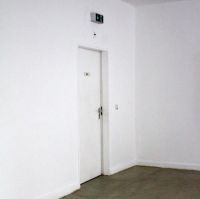
NOWs: back there
back theregroup exhibition
Galerie Nord – Kunstverein Tiergarten
Turmstraße 75
Berlin Moabit
Eröffnung:
27. September, 18 Uhr
Soundperformance von Anna Schimkat, 20 Uhr
back there
mit Arbeiten von Stefan Cantante, Birke Gorm, Rike Horb, YL Hsueh, Timo Kahlen, Nick Koppenhagen, Jeewi Lee, Jonas von Lenthe, Marina Naprushkina, Neue Nachbarschaft/Moabit, Stefan Riebel, Marion Ritzmann, Emmilou Rößling, Agnes Scherer + Paul DD Smith, Anna Schimkat, Gaby Taplick und Sung Tieu
Kuratiert von Ulrike Riebel und Christopher Weickenmeier
Im Rahmen des Ortstermin 2019 widmet sich die Ausstellung back there dem Offensichtlichen und dem weniger Offensichtlichem. Ist etwas offensichtlich, ist es genau so und nicht anders – offensichtlich, weil tatsächlich offen und einsichtig. So wirken die Räume der Galerie Nord | Kunstverein Tiergarten ebenfalls auf den ersten Blick überaus offen und einsichtig. Die physische Barriere zwischen Kunst- und Stadtraum besteht hier lediglich aus einer transparenten Glasscheibe, die sozialräumliche Distanz dagegen ist vielschichtiger. Die Ausstellung „back there“ nimmt dieses Paradox zum Anlass, die ansonsten unmerklichen räumlichen und gesellschaftlichen Bedingungen der Galerie Nord in den Vordergrund zu rücken. Verstärkt wird diese Auseinandersetzung durch eine speziell für die Ausstellung installierte Holzwand, die sich quer durch die Galerieräume zieht und als doppelte Rückseite die Grenze zwischen Vorder- und Hintergrund zusehends verwischt. Die versammelten Positionen bleiben auf der Oberfläche, beleuchten Hintergründe, machen sie unsichtbar und lassen Blicke ins Leere laufen.
Draußen, entlang der Turmstraße, setzt sich diese Arbeitsweise fort. Bewusst beiläufig, fast funktional präsentiert sich hier Kunst, dabei bewegt sie sich konsequent im Hintergrund. Sie versperrt sich gegenüber dem Buhlen um Aufmerksamkeit und nutzt schon vorhandene Medien und Strukturen, LED-Anzeigen in den Ladenfronten, Werbeaufsteller, Zäune oder Fahnenmasten. Sie konstituiert sich erst auf den zweiten oder dritten Blick und fordert so die Betrachter*innen auf innezuhalten, näherzutreten und sich der eigenen Perspektive und Position bewusst zu werden. Es gibt neben den individuellen auch historische und gesellschaftliche Gründe, warum genau das und nicht etwas anderes in diesem Augenblick ins Blickfeld rückt, offensichtlich ist, demnach vermeintlich wirklich und wichtig. Das scheinbar zufällige Treiben im städtischen Raum lässt sich anhand unterschiedlicher Kriterien analysieren. Eins davon ist Sichtbarkeit und als solche alles andere als neutral, sie ist umkämpft, ungleich verteilt und stets politisch. Ist der hier gewollt verunsicherte Blick nicht immer auch ein ästhetischer? Die Ausstellung „back there“ schafft Unschärfen und lädt dazu ein, an dem, was offensichtlich ist, absichtlich vorbeizuschauen, sich bewusst zu werden, wie der eigene Blick konstituiert, was sichtbar und bedeutsam ist, und somit vielleicht Verantwortung zu übernehmen für das, was offensichtlich übersehen wird.
Veranstaltungen/Events:Sa 28.9., 14 Uhr; Sa 12.10., 14 Uhr; Fr 25.10., 16 UhrNansen is missingPerformances von YL HsuehSo 29.9., 13 UhrKuratorenrundgang in englischer SpracheMi 9.10., 18 UhrKuratorenrundgang in deutscher SpracheSa 26.10., 19 UhrCascadePerformance von Emmilou RößlingMi 23.10., 20 Uhr, Neue Nachbarschaft/Moabit, Beusselstr. 26Unter Ausschluss der ÖffentlichkeitPerformative Lesung
back theregroup exhibition
Galerie Nord – Kunstverein Tiergarten
Turmstraße 75
Berlin Moabit
Opening
27 September, 6 pm
Soundperformance by Anna Schimkat, 8 pm
back there
with works by Stefan Cantante, Birke Gorm, Rike Horb, YL Hsueh, Timo Kahlen, Nick Koppenhagen, Jeewi Lee, Jonas von Lenthe, Marina Naprushkina, Neue Nachbarschaft/Moabit, Stefan Riebel, Marion Ritzmann, Emmilou Rößling, Agnes Scherer + Paul DD Smith, Anna Schimkat, Gaby Taplick und Sung Tieu
The group exhibition back there deals with the obvious. Something obvious is obviously so, and not something else. Something obvious is transparently so and so are the spaces of the Galerie Nord | Kunstverein Tiergarten. With its large glass front, the distance between the public space and the gallery space remains largely invisible. The actual social and economic distance is obviously much longer. The exhibition “back there“ takes this paradox as its starting point and works to bring the otherwise hidden conditions of the gallery to the surface. Specifically designed to split the gallery space into – what appears as – two backrooms, a wooden wall further undermines the distinction between surface and background. Outside along the Turmstraße, this work continues. The art appears here purposely incidental, borderline functional, always remaining in the background. Besides individual reasons, there are historical and social reasons that determine if something appears as obvious at a given moment and is thus considered real and important. Visibility is anything but politically neutral, it’s a contested resource that is distributed unequally. The exhibition “back there“ blurs the gaze and invites the visitors to look past the obvious. It’s an invitation to realize how the own gaze contributes to what appears as obvious and to take responsibility for what is obviously overlooked.
Veranstaltungen/Events:Sa 28.9., 14 Uhr; Sa 12.10., 14 Uhr; Fr 25.10., 16 UhrNansen is missingPerformances von YL HsuehSo 29.9., 13 UhrKuratorenrundgang in englischer SpracheMi 9.10., 18 UhrKuratorenrundgang in deutscher SpracheSa 26.10., 19 UhrCascadePerformance von Emmilou RößlingMi 23.10., 20 Uhr, Neue Nachbarschaft/Moabit, Beusselstr. 26Unter Ausschluss der ÖffentlichkeitPerformative Lesung
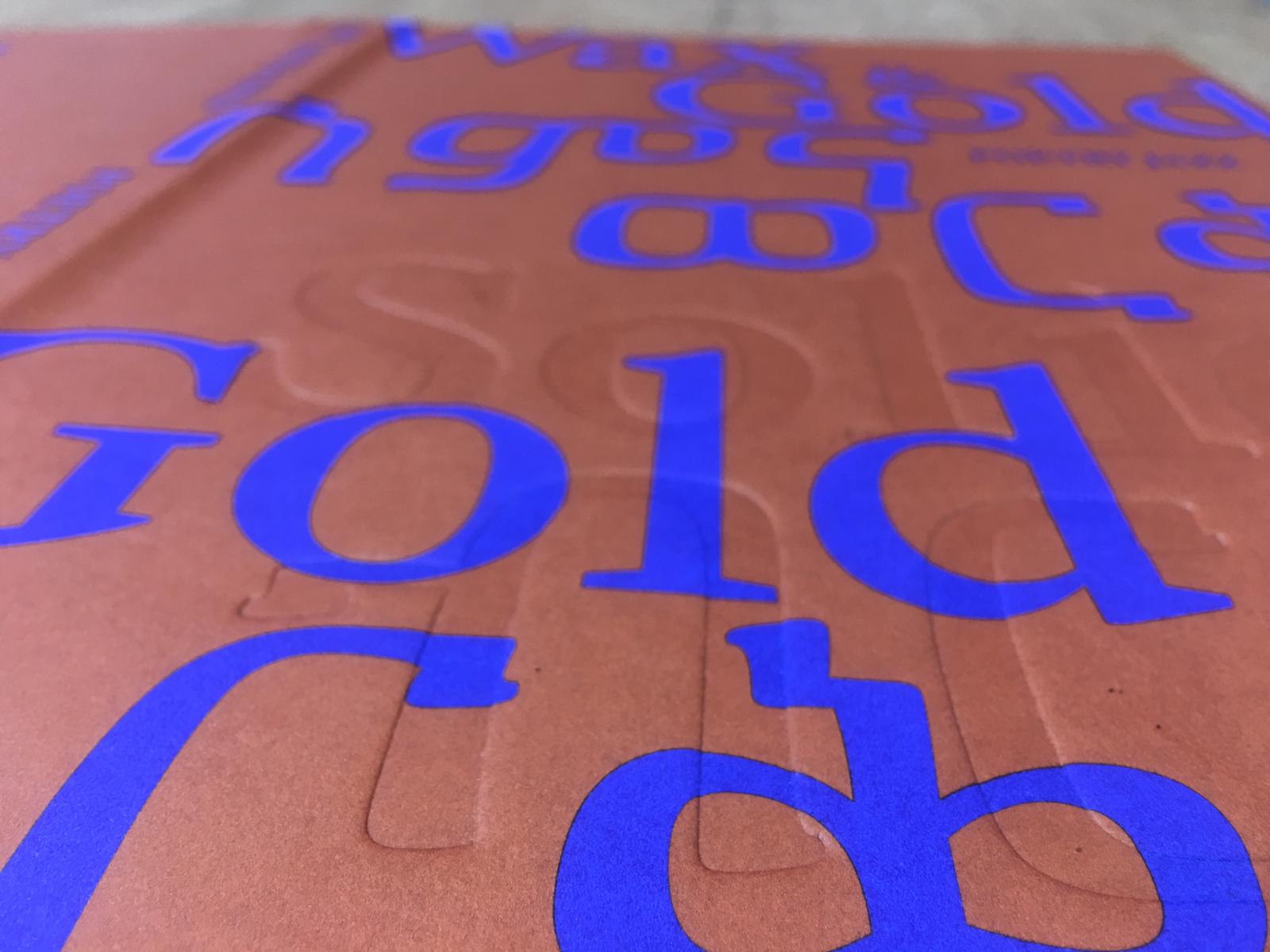
Poetry Jazz: Wax and Gold. Publication Preview
Poetry Jazz: Wax and GoldPoetry Publication in Amharic, English and German
With contributions by Frezer Admasu Molaligne, Olafur Eliasson, Eric Ellingsen, Clara Jo, Mihret Kebede Alwabie, Erica Licht, Robert Lippok, Bekele Mekonnen, Nebiy Mekonnen, Abebaw Melaku, Jorga Mesfin, Ari Benjamin Meyers, Neo Muyanga, Nolly Nesbit, Cia Rinne, Solomon Sahle Tizazu, Rike Scheffler, Robel Temesgen, Misrak Terefe Ergetu, Rediet Terefe Wegayehu, Christina Werner, Uljana Wolf, and Meheret Zelleke.
–
Poetry Jazz: Wax and Gold, Berlin, 2019
Edited by Institut für Raumexperimente e.V., Berlin;
in collaboration with Tobiya Poetic Jazz, Addis Ababa
Published by Koenig Books, London
Hardback; 256 pages; 22.0 cm x 33.0 cm
Amharic, English, and German
Graphic Design: BASICS09
ISBN: 978-3-86335-713-9
Price 29.80 euros
Available at Buchhandlung Walther König
–
This publication is part of the poetry series Poetry Jazz: Wax and Honey, I’m Home, initiated by the Institut für Raumexperimente, Berlin, in dialogue with Tobiya Poetic Jazz, Addis Ababa; in cooperation with the Akademie der Künste, Berlin; with support from Studio Olafur Eliasson, Berlin, the Graham Foundation for Advanced Studies in the Fine Arts, Chicago, and the Co-financing Fund of the Senate Department for Culture and Europe, Berlin.
It is funded by TURN Fund of the German Federal Cultural Foundation.
Poetry Jazz: Wax and GoldPoesie-Publikation, erschienen auf Amharisch, Englisch und Deutsch
Mit Beiträgen von Frezer Admasu Molaligne, Olafur Eliasson, Eric Ellingsen, Clara Jo, Mihret Kebede Alwabie, Erica Licht, Robert Lippok, Bekele Mekonnen, Nebiy Mekonnen, Abebaw Melaku, Jorga Mesfin, Ari Benjamin Meyers, Neo Muyanga, Nolly Nesbit, Cia Rinne, Solomon Sahle Tizazu, Rike Scheffler, Robel Temesgen, Misrak Terefe Ergetu, Rediet Terefe Wegayehu, Christina Werner, Uljana Wolf und Meheret Zelleke.
–
Poetry Jazz: Wax and Gold, Berlin, 2019
Institut für Raumexperimente e.V., Berlin;
in Zusammenarbeit mit Tobiya Poetic Jazz, Addis Ababa
Erschienen bei Koenig Books, London
Hardcover; 256 Seiten; 22,0 cm x 33,0 cm
Amharisch, Englisch und Deutsch
Grafikdesign: BASICS09
ISBN: 978-3-86335-713-9
29,80 Euro
Erhältlich bei Buchhandlung Walther König
–
Die Publikation ist Teil der Veranstaltungsreihe Poetry Jazz: Wax and Honey, I’m home des Institut für Raumexperimente in Berlin entstanden im Dialog mit Tobiya Poetic Jazz aus Addis Abeba und realisiert in Zusammenarbeit mit der Akademie der Künste in Berlin. Das Projekt wurde durch Studio Olafur Eliasson, Berlin, durch den Kofinanzierungsfonds der Senatsverwaltung für Kultur und Europa in Berlin und die Graham Foundation for Advanced Studies in the Fine Arts in Chicago unterstützt.
Es wurde finanziert durch den Fonds TURN der Kulturstiftung des Bundes.
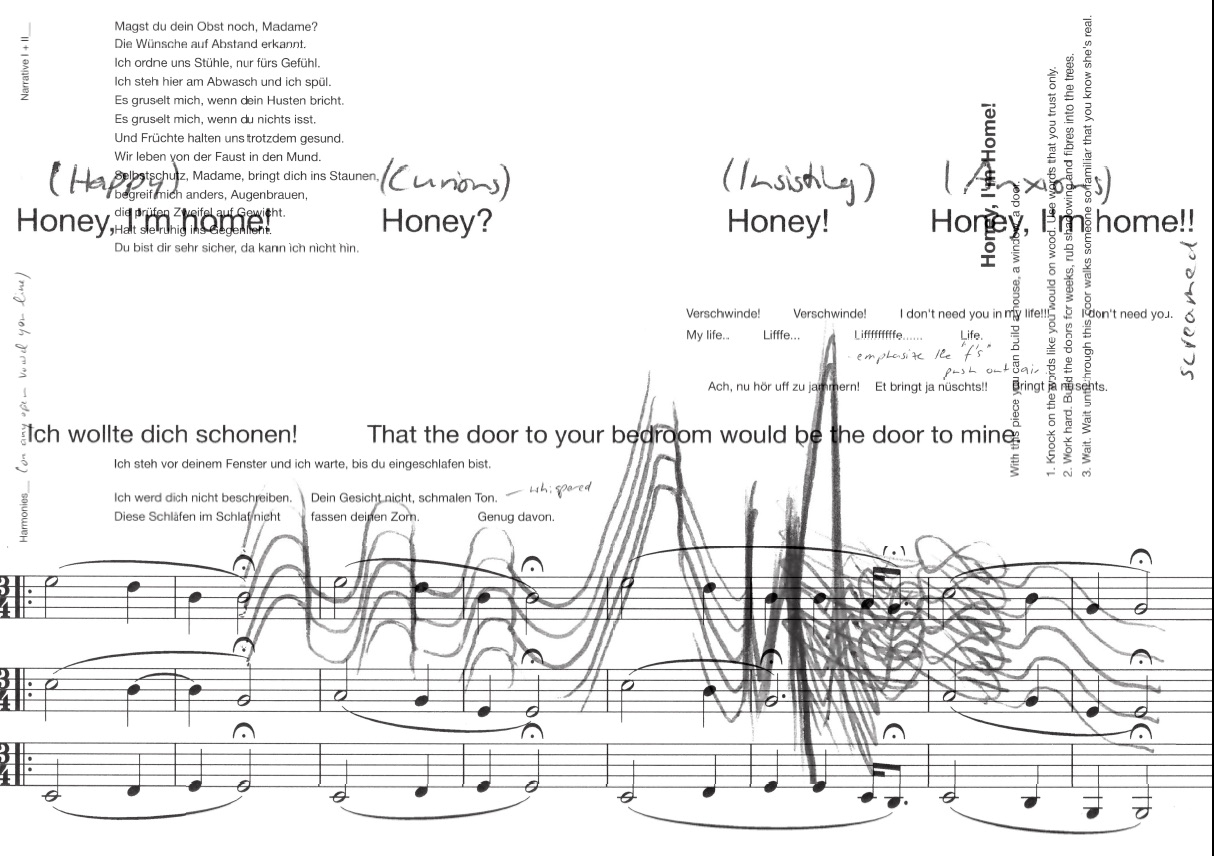
Poetry Jazz: Wax and Gold. Live Recordings
Hear Choir. Chorus I. Performed by Eric Ellingsen, Mihret Kebede Alwabie, Abebaw Melaku, and Misrak Terefe Ergetu
ፊደል / Alphabet. Performed by Mihret Kebede Alwabie, Abebaw Melaku, Jorga Mesfin (piano), and Misrak Terefe Ergetu
False Friends. Poem by Uljana Wolf. Performed by Uljana Wolf, Mihret Kebede Alwabie, Abebaw Melaku, Jorga Mesfin (piano), and Misrak Terefe Ergetu
እኔ ነኝ / It s me. Poem written and performed by Abebaw Melaku, accompanied by Mihret Kebede Alwabie, Robert Lippok (live electronics), Jorga Mesfin (piano), and Misrak Terefe Ergetu
Ambassel. Saxofon Solo by Jorga Mesfin
Instrumental. Performed by Jorga Mesfin (piano), Tasew Wendem Mose (flute), Robert Lippok (live electronics)
እኔነት by Frezer Admasu Molaligne. Translation by Rike Scheffler. Performed by Frezer Admasu Molaligne, Rike Scheffler
እኔነት by Frezer Admasu Molaligne. Translation by Eric Ellingsen. Performed by Frezer Admasu Molaligne, Eric Ellingsen, Rike Scheffler
Intermezzo. Performed by Jorga Mesfin (piano), Tasew Wendem Mose (flute and vocal), Robert Lippok (live electronics)
የሀገሬ ባሎች / Husbands of My Dear Country. Poem by Mihret Kebede Alwabie, translated by Eric Ellingsen, Jorga Mesfin and Uljana Wolf; performed by Mihret Kebede Alwabie und Uljana Wolf, with Jorga Mesfin (piano)
friends and enemies by Cia Rinne. Ethiopian version of Cia Rinne’s friends and enemies by Nebiy Mekonnen. Performed by Cia Rinne
Flags. Performed by Nebiy Mekonnen, Rike Scheffler, Misrak Terefe Ergetu, Frezer Admasu Molaligne
Flags
Flags
Instrumental. Performed by Jorga Mesfin (saxophone), Robert Lippok (live electronics)
A Sound Flag. United States of America by Eric Ellingsen and A Sound Flag. Ethiopia by Mihret Kebede Alwabie
If you see something say something by Eric Ellingsen. Performed by Eric Ellingsen with Mihret Kebede Alwabie, Rike Scheffler, Misrak Terefe Ergetu
የጸጥታ ወግ / Tales of Silence by Mihret Kebede Alwabie, translated and performed by Eric Ellingsen and Mihret Kebede Alwabie
የጸጥታ ወግ / Sagen, über die Stille by Mihret Kebede Alwabie, translated and performed by Rike Scheffler and Mihret Kebede Alwabie. Preface to Nebiy Mekonnen’s The Letter of the Water by Eric Ellingsen. የውሀው ደብዳቤ by Nebiy Mekonnen
የነፋስ ደብዳቤ by Misrak Terefe Ergetu
The Thinking Reed by Rike Scheffler
Instrumental by Jorga Mesfin (piano), Robert Lippok (live electronics)
የሰው ሀገር ሰው ነኝ by Solomon Sahle Tizazu
poem by Mihret Kebede Alwabie, (Oh center city) translated and performed by Eric Ellingsen and Mihret Kebede Alwabie. Mabayeke. Mabayeke (Thina Sizwe) conducted by Neo Muyanga
It’s not Saying What It Says It Says and That Too by Eric Ellingsen
Love Triangle by Nebiy Mekonnen, Misrak Terefe Ergetu, Rediet Terefe Wegayehu
Moving In by Rike Scheffler
ትዝታ እና ተስፋ by Frezer Admasu Molaligne
ነገን ኮረጅ በቃ / Plagiarize the future by Nebiy Mekonnen, translation by Eric Ellingsen and Meheret Zelleke
–
These live recordings are part of the poetry series Poetry Jazz: Wax and Honey, I’m Home, initiated by the Institut für Raumexperimente, Berlin; in dialogue with Tobiya Poetic Jazz, Addis Ababa; in cooperation with the Akademie der Künste, Berlin; with support from Studio Olafur Eliasson, Berlin, the Graham Foundation for Advanced Studies in the Fine Arts, Chicago, and the Co-financing Fund of the Senate Department for Culture and Europe, Berlin.
It is funded by TURN Fund of the German Federal Cultural Foundation.
Hear Choir. Chorus I. Ausgeführt von Eric Ellingsen, Mihret Kebede Alwabie, Abebaw Melaku und Misrak Terefe Ergetu
ፊደል / Alphabet. Ausgeführt von Mihret Kebede Alwabie, Abebaw Melaku, Jorga Mesfin (Klavier) und Misrak Terefe Ergetu
False Friends. Gedicht von Uljana Wolf. Ausgeführt von Uljana Wolf, Mihret Kebede Alwabie, Abebaw Melaku, Jorga Mesfin (Klavier) und Misrak Terefe Ergetu
እኔ ነኝ / It s me. Gedicht von Abebaw Melaku, ausgeführt von Abebaw Melaku, mit Mihret Kebede Alwabie, Robert Lippok (Live Electronics), Jorga Mesfin (Klavier) und Misrak Terefe Ergetu
Ambassel. Saxophon-Solo von Jorga Mesfin
Instrumental. Aufgeführt von Jorga Mesfin (Klavier), Tasew Wendem Mose (Flöte), Robert Lippok (Live Electronics)
እኔነት von Frezer Admasu Molaligne. Übersetzt von Rike Scheffler. Aufgeführt von Frezer Admasu Molaligne, Rike Scheffler
እኔነት von Frezer Admasu Molaligne. Übersetzt von Eric Ellingsen. Aufgeführt von Frezer Admasu Molaligne, Eric Ellingsen, Rike Scheffler
Intermezzo. Aufgeführt von Jorga Mesfin (Klavier), Tasew Wendem Mose (Flöte und Gesang), Robert Lippok (Live Electronics)
የሀገሬ ባሎች / Husbands of My Dear Country. Gedicht von Mihret Kebede Alwabie, übersetzt von Eric Ellingsen, Jorga Mesfin und Uljana Wolf; aufgeführt von Mihret Kebede Alwabie und Uljana Wolf, mit Jorga Mesfin (Klavier)
friends and enemies von Cia Rinne. Äthiopische Version von Cia Rinnes friends and enemies von Nebiy Mekonnen. Aufgeführt von Cia Rinne
Flags. Aufgeführt von Nebiy Mekonnen, Rike Scheffler, Misrak Terefe Ergetu, Frezer Admasu Molaligne
Flags
Flags
Instrumental. Aufgeführt von Jorga Mesfin (Saxofon), Robert Lippok (Electronics)
A Sound Flag. United States of America von Eric Ellingsen und A Sound Flag. Ethiopia von Mihret Kebede Alwabie
If you see something say something von Eric Ellingsen. Aufgeführt von Eric Ellingsen mit Mihret Kebede Alwabie, Rike Scheffler, Misrak Terefe Ergetu
የጸጥታ ወግ / Tales of Silence. Gedicht von Mihret Kebede Alwabie. Übersetzt und aufgeführt von Mihret Kebede Alwabie und Eric Ellingsen
የጸጥታ ወግ / Sagen, über die Stille von Mihret Kebede Alwabie, übersetzt und aufgeführt von Rike Scheffler. Einführung zu Nebiy Mekonnens The Letter of the Water von Eric Ellingsen. የውሀው ደብዳቤ von Nebiy Mekonnen
የነፋስ ደብዳቤ von Misrak Terefe Ergetu
The Thinking Reed von Rike Scheffler
Instrumental von Jorga Mesfin (Klavier), Robert Lippok (Live Electronics)
የሰው ሀገር ሰው ነኝ von Solomon Sahle Tizazu
Gedicht von Mihret Kebede Alwabie, (Oh center city) übersetzt und aufgeführt von Eric Ellingsen und Mihret Kebede Alwabie. Mabayeke (Thina Sizwe) dirigiert von Neo Muyanga
It’s not Saying What It Says It Says and That Too von Eric Ellingsen
Love Triangle von Nebiy Mekonnen, Misrak Terefe Ergetu, Rediet Terefe Wegayehu
Moving In von Rike Scheffler
ትዝታ እና ተስፋ von Frezer Admasu Molaligne
ነገን ኮረጅ በቃ / Plagiarize the future von Nebiy Mekonnen, übersetzt von Eric Ellingsen und Meheret Zelleke
–
Die Hörbeispiele sind Teil der Veranstaltungsreihe Poetry Jazz: Wax and Honey, I’m home des Institut für Raumexperimente in Berlin entstanden im Dialog mit Tobiya Poetic Jazz aus Addis Abeba und realisiert in Zusammenarbeit mit der Akademie der Künste in Berlin. Das Projekt wurde durch Studio Olafur Eliasson, Berlin, durch den Kofinanzierungsfonds der Senatsverwaltung für Kultur und Europa in Berlin und die Graham Foundation for Advanced Studies in the Fine Arts in Chicago unterstützt.
Es wurde finanziert durch den Fonds TURN der Kulturstiftung des Bundes.

Poetry Jazz: Wax and Gold. Films
Making of Poetry Jazz: Wax and GoldFilms by Clara Jo
Clara Jo documented the workshops and concerts for the long-term Poetry collaboration between the Institut für Raumexperimente (Berlin) and Tobiya Poetic Jazz (Addis Ababa). As a filmmaker, she focused on the sensual and aural qualities in the participants’ physical and linguistic search for common vernacular expressions, particularly lending her eyes and ears to the gaps of literal translation. In these artistic making-of films, she follows the rehearsal and production process and offers a glance behind the scenes to the dynamics between stage and audience.
–
Poetry Jazz: Solid Gold (2019)
Director: Clara Jo; Featuring: Frezer Admasu, Eric Ellingsen, Mihret Kebede, Robert Lippok, Nebiy Mekonnen, Jorga Mesfin, Neo Muyanga, Solomon Sahle Tizazu, Rike Scheffler, Misrak Terefe, Rediet Terefe Wegayehu, Tasew Wendem Mose, Christina Werner.
Poetry Jazz: Solid Gold, a film by Clara Jo
–
Poetry Jazz: The Rehearsal (2019)
Director: Clara Jo; Featuring: Frezer Admasu, Eric Ellingsen, Mihret Kebede, Robert Lippok, Nebiy Mekonnen, Jorga Mesfin, Neo Muyanga, Solomon Sahle Tizazu, Rike Scheffler, Misrak Terefe, Rediet Terefe Wegayehu, Tasew Wendem Mose, Christina Werner.
Poetry Jazz: The Rehearsal, a film by Clara Jo
–
Poetry Jazz: Wax and Gold (2018)
Director: Clara Jo; Featuring: Frezer Admasu, Eric Ellingsen, Mihret Kebede, Robert Lippok, Nebiy Mekonnen, Jorga Mesfin, Tasew Wendem Mose, Cia Rinne, Rike Scheffler, Misrak Terefe, Christina Werner.
Poetry Jazz: Wax and Gold, a film by Clara Jo
These films are part of the poetry series Poetry Jazz: Wax and Honey, I’m Home by the Institut für Raumexperimente, Berlin; in cooperation with the Akademie der Künste, Berlin; in dialogue with Tobiya Poetic Jazz, Addis Ababa; choreographed by Christina Werner; supported by the Studio Olafur Eliasson, Berlin; Graham Foundation for Advanced Studies in the Fine Arts, Chicago; Co-financing Fund of the Senate Department for Culture and Europe, Berlin. Funded by the TURN Fund of the German Federal Cultural Foundation.
–
A-B-A-B-A: from here to hear (2016)
Director: Clara Jo; Featuring: Gashahn Abateneh, Eric Ellingsen, Mihret Kebede, Erica Licht, Robert Lippok, Nebiy Mekonnen, Abebaw Melaku, Jorga Mesfin, Ari Benjamin Meyers, Bekele Mekonnen, Rike Scheffler, Misrak Terefe, Christina Werner, Uljana Wolf, The Moseb Traditional Music Band, Addis Ababa.
A-B-A-B-A: from here to hear, a film by Clara Jo
–
Roter Salon. A-B-A-B-A: from hear to here (2014)
Director: Clara Jo; Featuring: Eric Ellingsen, Mihret Kebede, Robert Lippok, Abebaw Melaku, Jorga Mesfin, Ari Benjamin Meyers, Rike Scheffler, Misrak Terefe, Christina Werner, Uljana Wolf.
Roter Salon. A-B-A-B-A: from hear to here, a film by Clara Jo
These films are part of the event series A-B-A-B-A : from hear to here as part of Acting Archives, a project initiated by Institut für Raumexperimente, Berlin University of the Arts together with the Alle School of Fine Arts and Design, Addis Ababa University. The project is choreographed by Christina Werner and Eric Ellingsen; realized together with Palais Wittgenstein at Roter Salon at Volksbühne Berlin and the Alliance Ethio-Française d’Addis-Abeba. It is supported by Studio Olafur Eliasson and funded by the TURN Fund of the German Federal Cultural Foundation.
Making of Poetry Jazz: Wax and GoldFilme von Clara Jo
Clara Jo hielt die Workshops und Konzerte der langfristig angelegten Poetry Jazz Kooperation zwischen dem Institut für Raumexperimente, Berlin und Tobiya Poetic Jazz, Addis Abeba mit der Kamera fest. Als Filmemacherin stellte sie dabei das Sinnliche und Aurale in der körperlichen wie sprachlichen Suche der Teilnehmer:innen nach gemeinsamen und doch eigenen Ausdrucksformen in den Fokus, insbesondere schenkte sie dabei den beim Übersetzen entstehenden Sollbruchstellen ihre Aufmerksamkeit. In ihre künstlerischen Making-ofs begleitet sie die Proben- und Produktionsprozesse und ermöglicht einen Blick hinter die Kulissen und folgt den Dynamiken, die den Resonanzraum zwischen Bühne und Publikum in Schwingung versetzten.
–
Poetry Jazz: Solid Gold (2019)
Regie: Clara Jo; mit Frezer Admasu, Eric Ellingsen, Mihret Kebede, Robert Lippok, Nebiy Mekonnen, Jorga Mesfin, Neo Muyanga, Solomon Sahle Tizazu, Rike Scheffler, Misrak Terefe, Rediet Terefe Wegayehu, Tasew Wendem Mose, Christina Werner.
Poetry Jazz: Solid Gold, a film by Clara Jo
–
Poetry Jazz: The Rehearsal (2019)
Regie: Clara Jo; mit Frezer Admasu, Eric Ellingsen, Mihret Kebede, Robert Lippok, Nebiy Mekonnen, Jorga Mesfin, Neo Muyanga, Solomon Sahle Tizazu, Rike Scheffler, Misrak Terefe, Rediet Terefe Wegayehu, Tasew Wendem Mose, Christina Werner.
Poetry Jazz: The Rehearsal, a film by Clara Jo
–
Poetry Jazz: Wax and Gold (2018)
Regie: Clara Jo; mit Frezer Admasu, Eric Ellingsen, Mihret Kebede, Robert Lippok, Nebiy Mekonnen, Jorga Mesfin, Tasew Wendem Mose, Cia Rinne, Rike Scheffler, Misrak Terefe, Christina Werner.
Poetry Jazz: Wax and Gold, a film by Clara Jo
Die Filme sind im Rahmen der Veranstaltungsreihe Poetry Jazz: Wax and Honey, I’m Home des Instituts für Raumexperimente in Berlin entstanden, im Dialog mit Tobiya Poetic Jazz aus Addis Abeba und realisiert in Zusammenarbeit mit der Akademie der Künste in Berlin. Das Projekt wurde durch den Kofinanzierungsfonds der Senatsverwaltung für Kultur und Europa in Berlin und die Graham Foundation for Advanced Studies in the Fine Arts in Chicago unterstützt. Es wurde finanziert durch den Fonds TURN der Kulturstiftung des Bundes.
–
A-B-A-B-A: from here to hear (2016)
Regie: Clara Jo; mit Gashahn Abateneh, Eric Ellingsen, Mihret Kebede, Erica Licht, Robert Lippok, Nebiy Mekonnen, Abebaw Melaku, Jorga Mesfin, Ari Benjamin Meyers, Bekele Mekonnen, Rike Scheffler, Misrak Terefe, Christina Werner, Uljana Wolf, The Moseb Traditional Music Band, Addis Ababa.
A-B-A-B-A: from here to hear, a film by Clara Jo
–
Roter Salon. A-B-A-B-A: from hear to here (2014)
Regie: Clara Jo; mit Eric Ellingsen, Mihret Kebede, Robert Lippok, Abebaw Melaku, Jorga Mesfin, Ari Benjamin Meyers, Rike Scheffler, Misrak Terefe, Christina Werner, Uljana Wolf.
Roter Salon. A-B-A-B-A: from hear to here, a film by Clara Jo
Die Filme sind im Rahmen der Veranstaltungsreihe A-B-A-B-A : from hear to here entstanden als Teil des Projekts Acting Archives, initiiert durch das Institut für Raumexperimente, Universität der Künste Berlin in Zusammenarbeit mit der Alle School of Fine Arts and Design, Addis Ababa University. Das Projekt ist von Christina Werner and Eric Ellingsen choreographiert, realisiert mit der Unterstützung der Alle School of Fine Arts and Design der Universität Addis Abeba, der Alliance Ethio-Française d’Addis Abeba, dem Palais Wittgenstein im Roten Salon der Volksbühne Berlin und dem Studio Olafur Eliasson in Berlin. Es wurde finanziert durch den Fonds TURN der Kulturstiftung des Bundes.
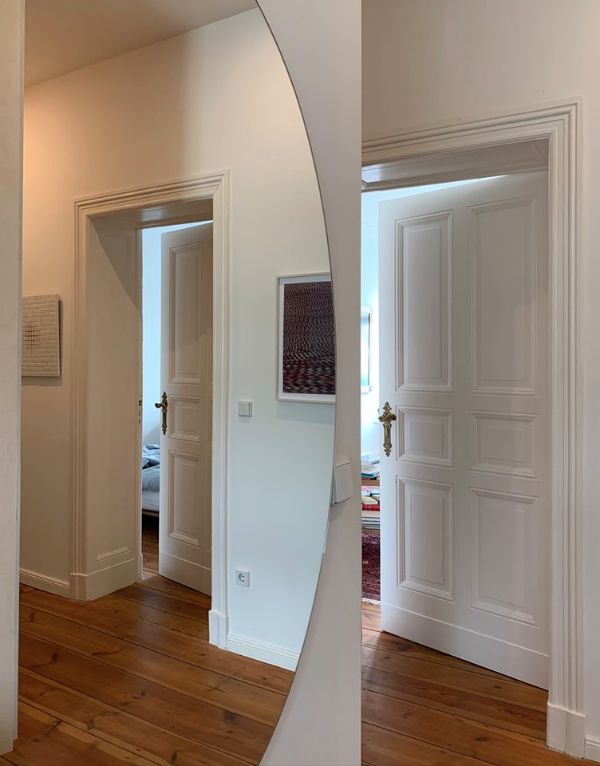
NOWs: Hausstellen
HausstellenGroup Exhibition at Pompéry Privat
Pompéry Privat
Bredowstr. 35a
10551 Berlin-Moabit
Opening
27 September, 6 -10 pm
Maria Anwander, Gabriel Blétel, Dachroth + Jeschonnek, Olafur Eliasson, Tom Früchtl, Miriam Jonas, Lajos Kassák, Caroline Kryzecki, Florian Lechner, Inge Mahn, Manfred Mohr, Vera Molnár, Pätzug / Hertweck, Sophia Pompéry, Sinta Werner, Lena von Goedeke
Physikalisch ist eine Fata Morgana als Luftspiegelung leicht erklärbar. Metaphorisch steht sie für Sinnestäuschung und bildet das Thema des diesjährigen Ortstermins, an dem rund 80 Ateliers und Ausstellungsräume Berlin-Moabits teilnehmen. „Die Fata Morgana bringt optische Zerrbilder der Realität oder gar Halluzinationen hervor. Als Vision unerreichbarer Orte scheint sie mit der Sehnsucht nach einer anderen Wirklichkeit verbunden zu sein, aber auch mit – womöglich nicht einlösbaren – Versprechungen. Das optische Flimmern könnte aber durchaus auch Visionen hervorbringen, die uns kein Trugbild vorgaukeln, sondern utopisches Potential in sich bergen“, so schreiben die Organisatoren des Moabiter Kunstfestivals.
Im Rahmen dieses Programmes wird die Künstlerin Sophia Pompéry ihr „Haus stellen“, um feinsinnige, doppelbödige Arbeiten zu zeigen, die ihren Ausgangspunkt in naturwissenschaftlichen Phänomenen finden. Die 16 teilnehmenden Künstler*Innen beschäftigen sich in ihren Malereien, Installationen, Papierarbeiten, Objekten und Fotographien eingehend mit Wahrnehmungsfragen. Subtil und scharfsinnig schlagen sie in ihren minimalistischen und schwerelos wirkenden Arbeiten eine Brücke zwischen Kunst, Philosophie und Physik.
Zusammen mit Alltagsgegenständen einer Wohnung verdichtet sich die Ausstellung zu einer Gesamtinszenierung: zum einen geht es darum die einzelnen Werke für sich gelten zu lassen, zum anderen sie in spannungsvolle Dialoge untereinander zu bringen, sie nach einer bestimmten Ordnung zu sortieren oder sie mit Alltagsgegenständen zu kombinieren.
Das Zusammenspiel von Luft und Licht, das zu einer Fata Morgana führt, verleitet uns zu einem Perspektivenwechsel, schafft Bewegungen und Spiegelungen, wie auch Brechungen in Raum und Zeit. Ist unsere Sehnsucht nach dem Authentischen eine Falle? Und wie wirkt sich das auf unsere Wahrnehmung und unseren Erkenntnisgewinn aus? Die ausgestellten Werke sind eigenständige Räume die nebeneinander bestehen und sich im Laufe der Ausstellung zueinander in Beziehung setzen. Hausstellen täuscht eine Wohnsituation vor, bleibt aber der flüchtige Moment einer trügerischen Privatheit.
Besuchszeiten
Freitag, den 27.9, Vernissage 18-22h
Samstag, den 28.9, 15-18h
Sonntag, den 29.9, 15-20h
Führungen werden zur halben Stunde (15:30, 16:30, usw.) angeboten.
Weitere Orte im Rahmen des Kunstfestivals Moabit:
https://ortstermin.kunstverein-tiergarten.de
HausstellenGroup Exhibition at Pompéry Privat
Pompéry Privat
Bredowstr. 35a
10551 Berlin-Moabit
Opening
27 September, 6 -10 pm
Maria Anwander, Gabriel Blétel, Dachroth + Jeschonnek, Olafur Eliasson, Tom Früchtl, Miriam Jonas, Lajos Kassák, Caroline Kryzecki, Florian Lechner, Inge Mahn, Manfred Mohr, Vera Molnár, Pätzug / Hertweck, Sophia Pompéry, Sinta Werner, Lena von Goedeke
Physikalisch ist eine Fata Morgana als Luftspiegelung leicht erklärbar. Metaphorisch steht sie für Sinnestäuschung und bildet das Thema des diesjährigen Ortstermins, an dem rund 80 Ateliers und Ausstellungsräume Berlin-Moabits teilnehmen. „Die Fata Morgana bringt optische Zerrbilder der Realität oder gar Halluzinationen hervor. Als Vision unerreichbarer Orte scheint sie mit der Sehnsucht nach einer anderen Wirklichkeit verbunden zu sein, aber auch mit – womöglich nicht einlösbaren – Versprechungen. Das optische Flimmern könnte aber durchaus auch Visionen hervorbringen, die uns kein Trugbild vorgaukeln, sondern utopisches Potential in sich bergen“, so schreiben die Organisatoren des Moabiter Kunstfestivals.
Im Rahmen dieses Programmes wird die Künstlerin Sophia Pompéry ihr „Haus stellen“, um feinsinnige, doppelbödige Arbeiten zu zeigen, die ihren Ausgangspunkt in naturwissenschaftlichen Phänomenen finden. Die 16 teilnehmenden Künstler*Innen beschäftigen sich in ihren Malereien, Installationen, Papierarbeiten, Objekten und Fotographien eingehend mit Wahrnehmungsfragen. Subtil und scharfsinnig schlagen sie in ihren minimalistischen und schwerelos wirkenden Arbeiten eine Brücke zwischen Kunst, Philosophie und Physik.
Zusammen mit Alltagsgegenständen einer Wohnung verdichtet sich die Ausstellung zu einer Gesamtinszenierung: zum einen geht es darum die einzelnen Werke für sich gelten zu lassen, zum anderen sie in spannungsvolle Dialoge untereinander zu bringen, sie nach einer bestimmten Ordnung zu sortieren oder sie mit Alltagsgegenständen zu kombinieren.
Das Zusammenspiel von Luft und Licht, das zu einer Fata Morgana führt, verleitet uns zu einem Perspektivenwechsel, schafft Bewegungen und Spiegelungen, wie auch Brechungen in Raum und Zeit. Ist unsere Sehnsucht nach dem Authentischen eine Falle? Und wie wirkt sich das auf unsere Wahrnehmung und unseren Erkenntnisgewinn aus? Die ausgestellten Werke sind eigenständige Räume die nebeneinander bestehen und sich im Laufe der Ausstellung zueinander in Beziehung setzen. Hausstellen täuscht eine Wohnsituation vor, bleibt aber der flüchtige Moment einer trügerischen Privatheit.
Besuchszeiten
Freitag, den 27.9, Vernissage 18-22h
Samstag, den 28.9, 15-18h
Sonntag, den 29.9, 15-20h
Führungen werden zur halben Stunde (15:30, 16:30, usw.) angeboten.
Weitere Orte im Rahmen des Kunstfestivals Moabit:
https://ortstermin.kunstverein-tiergarten.de
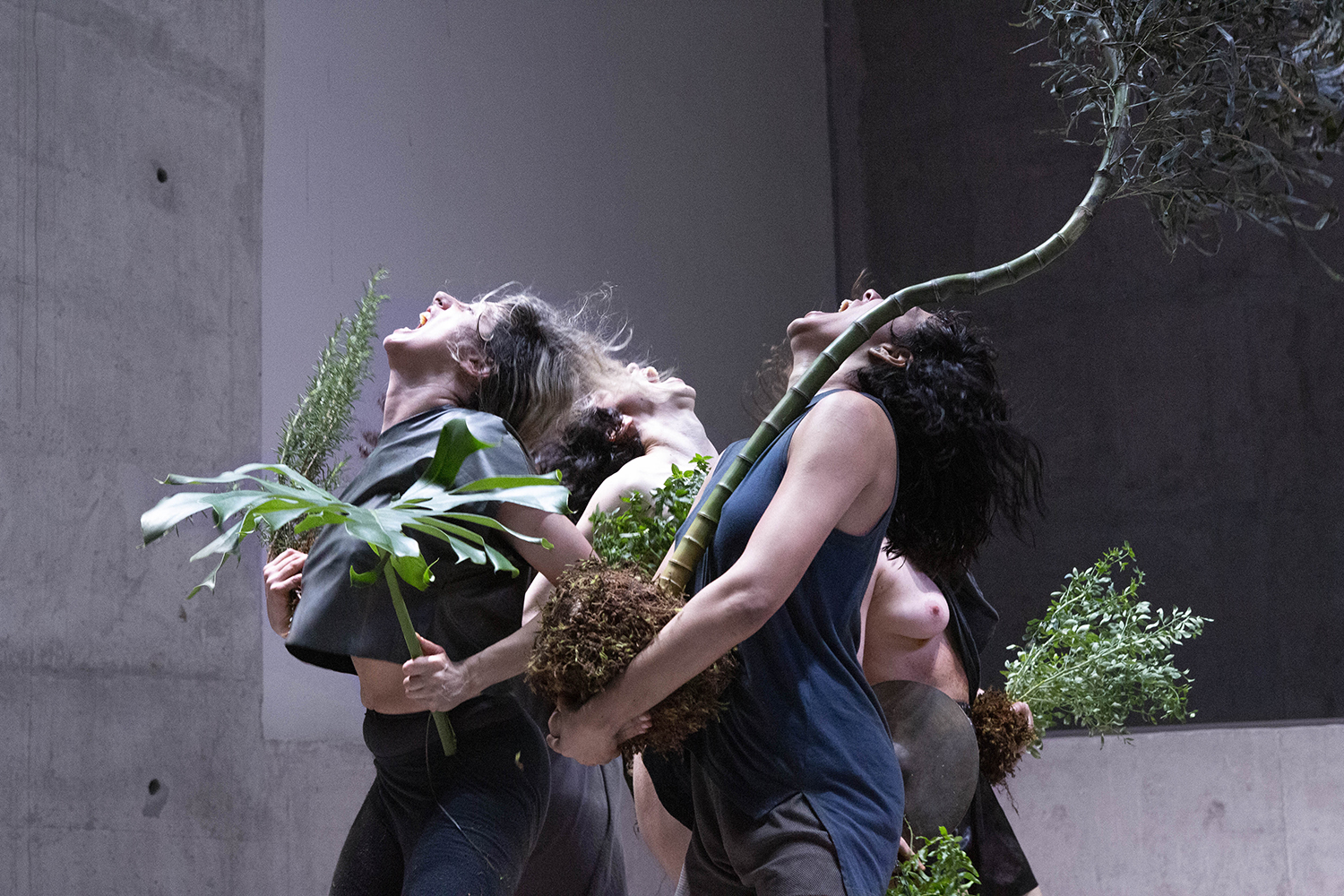
NOWs: Sensing Nature from Within
MONSTRA - performance by Elisabete Finger & Manuela Eichner, Photo: Debby Gram
Sensing Nature from WithinGroup Exhibition
Moderna Museet Malmö
Ola Billgrens plats 2-4
211 29 Malmö
The natural world, from which humanity has so thoroughly distanced itself, no longer exists, at least not in the same way or to the same extent it once did. This realization is starting to dawn on an increasing number of us, including many artists, and has resulted in a growing desire to reconsider old truths and seek out new ways of living and understanding the world. With the exhibition project Sensing Nature from Within, Moderna Museet Malmö wants to offer an artistic and philosophical sounding board for these existential explorations of our time.
In many places around the world today, texts are being written, lectures given, and exhibitions held that in a variety of ways explore man’s complex relationship with the environment in which we live. Criticism has hardened against the logic of a culture that leads to irrevocable destruction and the extinction of species. At the same time, there is a growing interest in more holistic world views and in the fascinating exercise of rethinking our relationships with the more-than-human world.
Moderna Museet Malmö wants to actively contribute to these important reflections and is therefore presenting Sensing Nature from Within during the fall of 2019 and spring of 2020. The project will combine an international art exhibition with an interdisciplinary program of lectures, discussions, and performances.
The seminar series that is part of the program is arranged in collaboration with Lund University Agenda 2030 Graduate School which is a global, cutting-edge research school and collaboration platform for issues related to societal challenges, sustainability and Agenda 2030.
Binary divisions, such as between nature and culture, and man and animal will be challenged in both the exhibition and the program. Intelligence, subjectivity, and emotional life will be explored within as well as beyond the human sphere. In this way, Sensing Nature from Within aims to awaken our sensibility towards the nature that surrounds us at the same time as it constitutes our own inner world.
Sensing Nature from Within is freely inspired by new and old insights into life and matter and reflects aspects of the growing search beyond our exploitative culture, for a new code of ethics.
Participating artists: Ursula Biemann & Paolo Tavares; Cecilia Edefalk; Elisabete Finger & Manuela Eichner; Hans Hammarskiöld; Ingela Ihrman, Anne Duk Hee Jordan; Tuija Lindström, Hanna Ljungh; Hilde Skancke Pedersen; The Otolith Group; Shimabuku; Christine Ödlund.
Curator: Joa Ljungberg
The Otolith Group: O Horizon, 2018 © Courtesy of The Otolith Group and LUX, London
Hilde Skancke Pedersen: Eana, 2018 © Courtesy the artist. Photo: Andreas Ausland
Ingela Ihrman: Giant clam, 2019, reading performance in Seved, Malmö © Courtesy the artist. Photo: Marte Edvarda Tidslevold Bildupphovsrätt 2019
Ursula Biemann & Paolo Tavares: Forest Law, 2014 © Courtesy the artists
MONSTRA - performance by Elisabete Finger & Manuela Eichner, Photo: Debby Gram
Sensing Nature from WithinGroup Exhibition
Moderna Museet Malmö
Ola Billgrens plats 2-4
211 29 Malmö
The natural world, from which humanity has so thoroughly distanced itself, no longer exists, at least not in the same way or to the same extent it once did. This realization is starting to dawn on an increasing number of us, including many artists, and has resulted in a growing desire to reconsider old truths and seek out new ways of living and understanding the world. With the exhibition project Sensing Nature from Within, Moderna Museet Malmö wants to offer an artistic and philosophical sounding board for these existential explorations of our time.
In many places around the world today, texts are being written, lectures given, and exhibitions held that in a variety of ways explore man’s complex relationship with the environment in which we live. Criticism has hardened against the logic of a culture that leads to irrevocable destruction and the extinction of species. At the same time, there is a growing interest in more holistic world views and in the fascinating exercise of rethinking our relationships with the more-than-human world.
Moderna Museet Malmö wants to actively contribute to these important reflections and is therefore presenting Sensing Nature from Within during the fall of 2019 and spring of 2020. The project will combine an international art exhibition with an interdisciplinary program of lectures, discussions, and performances.
The seminar series that is part of the program is arranged in collaboration with Lund University Agenda 2030 Graduate School which is a global, cutting-edge research school and collaboration platform for issues related to societal challenges, sustainability and Agenda 2030.
Binary divisions, such as between nature and culture, and man and animal will be challenged in both the exhibition and the program. Intelligence, subjectivity, and emotional life will be explored within as well as beyond the human sphere. In this way, Sensing Nature from Within aims to awaken our sensibility towards the nature that surrounds us at the same time as it constitutes our own inner world.
Sensing Nature from Within is freely inspired by new and old insights into life and matter and reflects aspects of the growing search beyond our exploitative culture, for a new code of ethics.
Participating artists: Ursula Biemann & Paolo Tavares; Cecilia Edefalk; Elisabete Finger & Manuela Eichner; Hans Hammarskiöld; Ingela Ihrman, Anne Duk Hee Jordan; Tuija Lindström, Hanna Ljungh; Hilde Skancke Pedersen; The Otolith Group; Shimabuku; Christine Ödlund.
Curator: Joa Ljungberg
The Otolith Group: O Horizon, 2018 © Courtesy of The Otolith Group and LUX, London
Hilde Skancke Pedersen: Eana, 2018 © Courtesy the artist. Photo: Andreas Ausland
Ingela Ihrman: Giant clam, 2019, reading performance in Seved, Malmö © Courtesy the artist. Photo: Marte Edvarda Tidslevold Bildupphovsrätt 2019
Ursula Biemann & Paolo Tavares: Forest Law, 2014 © Courtesy the artists
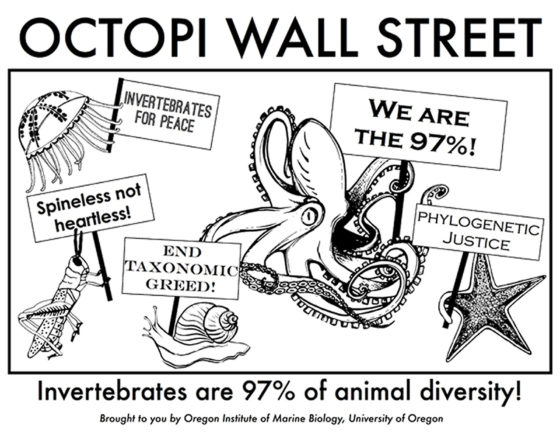
NOWs: Honorary Vertebrate Club
Sarah Browne: Report to an Academy, 2016. HD video, 28 minutes.
Honorary Vertebrate ClubGroup Exhibition
A Tale of a Tub
Justus van Effenstraat 44
3027 TK Rotterdam,
the Netherlands
An exhibition—with Bianca Baldi, Sarah Browne, Anne Duk Hee Jordan, Tuomas A. Laitinen, Sophie Mallett, Jean Painlevé & Geneviève Hamon, and Sarah Ancelle Schönfeld—that carries a part of its brain outside of its body.
Reality is an active verb, and the nouns all seem to be gerunds with more appendages than an octopus. Through their reaching into each other, through their “prehensions” or graspings, beings constitute each other and themselves. Beings do not preexist their relations. “Prehensions” have consequences. The world is a knot in motion.1
The exhibition Honorary Vertebrate Club addresses marine life and ecology in a time of unprecedented environmental change, the rapid depletion of life forms and loss of biodiversity. Focussing primarily on the octopus and other molluscan cephalopods, such as the squid, cuttlefish and the nautilus, the exhibition is centered around modes of survival and adaptation in aquatic climates where environmental backdrops have become increasingly unstable and subject to ecological breakdown, or have ceased to exist altogether. Introducing a number of templates and artistic practices concerned with marine life, the exhibition establishes analogies between human and non-human animals—the octopus often deemed as a radical form of otherness—in an aim to underline persistent anthropocentric tendencies and human exceptionalism. Instead of the human figure we follow the octopus as main protagonist: an inventive environmental engineer and expert tool-user with complex social behaviors, thriving together with the jellyfish in oceanic climates increasingly subject to manmade acidification, rising sea temperatures, and underwater colonialism through deep sea mining. What can we learn from the adaptive qualities of the octopus, its shape-changing capacities and internet of brains? Can we develop “tentacular thinking” as a way of learning to “stay with the trouble,” rather than keeping to engage in acts of business as usual?
The exhibition title is derived from an animal cruelty legislation act that was passed in The United Kingdom in 1986, regarding cephalopods as honorary vertebrates—extending to them protections not normally afforded to invertebrates, such as the octopus. This act was implemented more broadly with an EU directive in 2010, treating the octopus as a vertebrate— commonly possessing a more complex nervous systems than invertebrates—for legal protection in animal testing, as based on scientific evidence of their ability to experience pain, suffering, distress and lasting harm. Apart from the well-intentioned aims to protect cephalopods, the overarching discussion of human exceptionalism and our tendency to endow the human figure with the capacity to be at the basis of a judgement or reconstruction remains striking. In other words still, how many times haven’t humans dragged a non-human animal into its court—from the mimicry of the parrot, to the language of dolphins and the jazzsongs of whales—claiming that its being could be deemed intelligent, insofar as we consider ourselves the standard measure of intelligence.
Searching for new relational templates and approaches in inter-agentivity between humans and non-humans, the exhibition advocates a loosening of thought from the constraints of human phenomenality, as structures of being do not necessarily correspond with structures of lived experience.2 This resonates with the octopus’s bodily morphology and intelligence: of the octopus’s half a billion neurons—six times the number in a mouse—it is the only animal that has a segment of its brain located in its eight arms. Without a central nervous system, each arm “thinks” as well as “senses” the surrounding world with total autonomy, and yet, each arm is part of the animal.3 To further consider these decentralized actors forming a congruent whole it is relevant to cite philosopher Donna Haraway’s notion of “tentacular thinking”: The tentacular are not disembodied figures; they are cnidarians, spiders, fingery beings like humans and raccoons, squid, jellyfish, neural extravaganzas, fibrous entities, flagellated beings, myofibril braids, matted and felted microbial and fungal tangles, probing creepers, swelling roots, reaching and climbing tendrilled ones. The tentacular are also nets and networks, it critters, in and out of clouds. Tentacularity is about life lived along lines—and such a wealth of lines—not at points, not in spheres. “The inhabitants of the world, creatures of all kinds, human and non-human, are wayfarers”; generations are like “a series of interlaced trails.”4
For the exhibition Honorary Vertebrate Club we understand “tentacular thinking” as a mode of raising decentralized perception, as an expansive and generative practice of fragmentary knowledge production that unmakes self-organizing units and ties them together as part of collectives seeking for the possibilities of life in capitalist ruins. As cephalopod and jellyfish populations are proliferating in response to a changing climate, we may as well reach out to make kin with the aquatic overlords, engage in acts of learning through empathic nonunderstanding, towards devising ways of living together on a damaged planet.
Footnotes
1 Donna J. Haraway, The Companion Species Manifesto – Dogs, People, and Significant Otherness (Chicago: The University of Chicago Press), 6.
2 Anthropologist Tim Ingold has coined the term “interagentivity,” which he uses to highlight the constitutive quality of the “dwelt-in world” of hunter gatherers. Here, human beings engage intimately with one another as well as with non-human components in the environment. Ingold prefers to speak of “interagentivity” rather than of “intersubjectivity,” as we should not infer that every agent, with practical conscience, is subjectively determined, thoughtful and intellectual, with discursive, narrative awareness, as we commonly believe adult humans to be.
3 Chus Martinez, “The Octopus in Love,” e-flux journal 55 (May 2014): 1.
4 Donna J. Haraway, Staying with the Trouble – Making Kin in the Chthulucene (Durham and London: Duke University Press, 2016), 32.
This exhibition is made possible with the support of the City of Rotterdam and the Mondriaan Fund
Sarah Browne: Report to an Academy, 2016. HD video, 28 minutes.
Honorary Vertebrate ClubGroup Exhibition
A Tale of a Tub
Justus van Effenstraat 44
3027 TK Rotterdam,
the Netherlands
An exhibition—with Bianca Baldi, Sarah Browne, Anne Duk Hee Jordan, Tuomas A. Laitinen, Sophie Mallett, Jean Painlevé & Geneviève Hamon, and Sarah Ancelle Schönfeld—that carries a part of its brain outside of its body.
Reality is an active verb, and the nouns all seem to be gerunds with more appendages than an octopus. Through their reaching into each other, through their “prehensions” or graspings, beings constitute each other and themselves. Beings do not preexist their relations. “Prehensions” have consequences. The world is a knot in motion.1
The exhibition Honorary Vertebrate Club addresses marine life and ecology in a time of unprecedented environmental change, the rapid depletion of life forms and loss of biodiversity. Focussing primarily on the octopus and other molluscan cephalopods, such as the squid, cuttlefish and the nautilus, the exhibition is centered around modes of survival and adaptation in aquatic climates where environmental backdrops have become increasingly unstable and subject to ecological breakdown, or have ceased to exist altogether. Introducing a number of templates and artistic practices concerned with marine life, the exhibition establishes analogies between human and non-human animals—the octopus often deemed as a radical form of otherness—in an aim to underline persistent anthropocentric tendencies and human exceptionalism. Instead of the human figure we follow the octopus as main protagonist: an inventive environmental engineer and expert tool-user with complex social behaviors, thriving together with the jellyfish in oceanic climates increasingly subject to manmade acidification, rising sea temperatures, and underwater colonialism through deep sea mining. What can we learn from the adaptive qualities of the octopus, its shape-changing capacities and internet of brains? Can we develop “tentacular thinking” as a way of learning to “stay with the trouble,” rather than keeping to engage in acts of business as usual?
The exhibition title is derived from an animal cruelty legislation act that was passed in The United Kingdom in 1986, regarding cephalopods as honorary vertebrates—extending to them protections not normally afforded to invertebrates, such as the octopus. This act was implemented more broadly with an EU directive in 2010, treating the octopus as a vertebrate— commonly possessing a more complex nervous systems than invertebrates—for legal protection in animal testing, as based on scientific evidence of their ability to experience pain, suffering, distress and lasting harm. Apart from the well-intentioned aims to protect cephalopods, the overarching discussion of human exceptionalism and our tendency to endow the human figure with the capacity to be at the basis of a judgement or reconstruction remains striking. In other words still, how many times haven’t humans dragged a non-human animal into its court—from the mimicry of the parrot, to the language of dolphins and the jazzsongs of whales—claiming that its being could be deemed intelligent, insofar as we consider ourselves the standard measure of intelligence.
Searching for new relational templates and approaches in inter-agentivity between humans and non-humans, the exhibition advocates a loosening of thought from the constraints of human phenomenality, as structures of being do not necessarily correspond with structures of lived experience.2 This resonates with the octopus’s bodily morphology and intelligence: of the octopus’s half a billion neurons—six times the number in a mouse—it is the only animal that has a segment of its brain located in its eight arms. Without a central nervous system, each arm “thinks” as well as “senses” the surrounding world with total autonomy, and yet, each arm is part of the animal.3 To further consider these decentralized actors forming a congruent whole it is relevant to cite philosopher Donna Haraway’s notion of “tentacular thinking”: The tentacular are not disembodied figures; they are cnidarians, spiders, fingery beings like humans and raccoons, squid, jellyfish, neural extravaganzas, fibrous entities, flagellated beings, myofibril braids, matted and felted microbial and fungal tangles, probing creepers, swelling roots, reaching and climbing tendrilled ones. The tentacular are also nets and networks, it critters, in and out of clouds. Tentacularity is about life lived along lines—and such a wealth of lines—not at points, not in spheres. “The inhabitants of the world, creatures of all kinds, human and non-human, are wayfarers”; generations are like “a series of interlaced trails.”4
For the exhibition Honorary Vertebrate Club we understand “tentacular thinking” as a mode of raising decentralized perception, as an expansive and generative practice of fragmentary knowledge production that unmakes self-organizing units and ties them together as part of collectives seeking for the possibilities of life in capitalist ruins. As cephalopod and jellyfish populations are proliferating in response to a changing climate, we may as well reach out to make kin with the aquatic overlords, engage in acts of learning through empathic nonunderstanding, towards devising ways of living together on a damaged planet.
Footnotes
1 Donna J. Haraway, The Companion Species Manifesto – Dogs, People, and Significant Otherness (Chicago: The University of Chicago Press), 6.
2 Anthropologist Tim Ingold has coined the term “interagentivity,” which he uses to highlight the constitutive quality of the “dwelt-in world” of hunter gatherers. Here, human beings engage intimately with one another as well as with non-human components in the environment. Ingold prefers to speak of “interagentivity” rather than of “intersubjectivity,” as we should not infer that every agent, with practical conscience, is subjectively determined, thoughtful and intellectual, with discursive, narrative awareness, as we commonly believe adult humans to be.
3 Chus Martinez, “The Octopus in Love,” e-flux journal 55 (May 2014): 1.
4 Donna J. Haraway, Staying with the Trouble – Making Kin in the Chthulucene (Durham and London: Duke University Press, 2016), 32.
This exhibition is made possible with the support of the City of Rotterdam and the Mondriaan Fund

NOWs: I’ll be your mirror
documantary film by Johanna Faust
Die Künstlerin Johanna Faust will ihre Kinder verlassen, um sich endlich wieder ihrer Kunst zu widmen. Da kommt ihr eine vage Erinnerung hoch: Hat ihre Grossmutter nicht dasselbe getan, mit schlimmen Folgen? Das intime Road Movie erzählt von verlorenen Müttern und verlassenen Kindern, von den Verlockungen und dem Preis der Selbstverwirklichung, von den Abgründen des Mutterseins und von der tiefen Sehnsucht nach einem anderen Leben.
Johanna fühlt sich in ihrem Alltagsleben mit Partner und drei Kindern immer einsamer und unerfüllter. Sie sehnt sich danach, wieder voll und ganz in ihre künstlerische Arbeit abzutauchen. Da kommt die Einladung zum Masterstudium an einer Kunstschule in Oxford gerade recht. Aber soll sie ihre Kinder wirklich verlassen? Darf das eine Mutter? Ihr Partner würde sie unterstützen und zu den Kindern schauen, trotzdem kommen Johanna Zweifel. Dunkel erinnert sie sich, dass ihre Grossmutter in jungen Jahren ihre Familie ebenfalls verlassen hatte, um sich der Kunst zu widmen, mit schlimmen Folgen für Johannas Mutter. Aber wie war das damals genau? Darüber wurde in der Familie nie wirklich geredet. Johanna spürt, dass sie zuerst ihrer eigenen Familiengeschichte auf den Grund gehen muss, bevor sie sich für oder gegen Oxford entscheiden kann. Mit Mann und Kindern macht sie sich zu einer Reise tief in die Vergangenheit auf, die sie aus der Schweiz über die USA bis in die Wüste Mexikos führt. Schicht um Schicht legt sie die Geschichten von vier Generationen von Frauen frei, die alle mit ihrer Mutterrolle haderten, gegen gesellschaftliche Erwartungen verstiessen und dabei in einen schmerzhaften Konflikt zwischen den eigenen Wünschen und den Bedürfnissen ihrer Kinder gerieten.
I’ll be your mirror ist ein Road Movie, das auf sehr persönliche Weise ein Tabu hinterfragt. Mit schonungsloser Ehrlichkeit und berückenden Bildern erzählt der Film von generationsübergreifenden Erschütterungen, die unser Leben mitbestimmen, ohne dass wir es wissen.
Links:
www.soapfactory.ch/filme-mirror2.html
zff.com/de/archiv/24691/
Genre: DOK: Familie & Beziehung
Land, Jahr: Schweiz, 2019
Länge: 91 Min
Sprachen: Schweizerdeutsch, Englisch, Spanisch
Untertitel: Englisch
Regie: Johanna Faust
Drehbuch: Johanna Faust
Kamera: Ute Freund, Johanna Faust, Jeremias Holliger
Schnitt: Rune Schweitzer
Ton: Ulla Kösterke, Jeremias Holliger
Musik: Fred Frith
Produzent: Frank Matter
Produktionsfirma: soap factory GmbH
CH-Verleih: Cineworx Filmverleih GmbH
Dokumentarfilm von Johanna Faust
Die Künstlerin Johanna Faust will ihre Kinder verlassen, um sich endlich wieder ihrer Kunst zu widmen. Da kommt ihr eine vage Erinnerung hoch: Hat ihre Grossmutter nicht dasselbe getan, mit schlimmen Folgen? Das intime Road Movie erzählt von verlorenen Müttern und verlassenen Kindern, von den Verlockungen und dem Preis der Selbstverwirklichung, von den Abgründen des Mutterseins und von der tiefen Sehnsucht nach einem anderen Leben.
Johanna fühlt sich in ihrem Alltagsleben mit Partner und drei Kindern immer einsamer und unerfüllter. Sie sehnt sich danach, wieder voll und ganz in ihre künstlerische Arbeit abzutauchen. Da kommt die Einladung zum Masterstudium an einer Kunstschule in Oxford gerade recht. Aber soll sie ihre Kinder wirklich verlassen? Darf das eine Mutter? Ihr Partner würde sie unterstützen und zu den Kindern schauen, trotzdem kommen Johanna Zweifel. Dunkel erinnert sie sich, dass ihre Grossmutter in jungen Jahren ihre Familie ebenfalls verlassen hatte, um sich der Kunst zu widmen, mit schlimmen Folgen für Johannas Mutter. Aber wie war das damals genau? Darüber wurde in der Familie nie wirklich geredet. Johanna spürt, dass sie zuerst ihrer eigenen Familiengeschichte auf den Grund gehen muss, bevor sie sich für oder gegen Oxford entscheiden kann. Mit Mann und Kindern macht sie sich zu einer Reise tief in die Vergangenheit auf, die sie aus der Schweiz über die USA bis in die Wüste Mexikos führt. Schicht um Schicht legt sie die Geschichten von vier Generationen von Frauen frei, die alle mit ihrer Mutterrolle haderten, gegen gesellschaftliche Erwartungen verstiessen und dabei in einen schmerzhaften Konflikt zwischen den eigenen Wünschen und den Bedürfnissen ihrer Kinder gerieten.
I’ll be your mirror ist ein Road Movie, das auf sehr persönliche Weise ein Tabu hinterfragt. Mit schonungsloser Ehrlichkeit und berückenden Bildern erzählt der Film von generationsübergreifenden Erschütterungen, die unser Leben mitbestimmen, ohne dass wir es wissen.
Links:
www.soapfactory.ch/filme-mirror2.html
zff.com/de/archiv/24691/
Genre: DOK: Familie & Beziehung
Land, Jahr: Schweiz, 2019
Länge: 91 Min
Sprachen: Schweizerdeutsch, Englisch, Spanisch
Untertitel: Englisch
Regie: Johanna Faust
Drehbuch: Johanna Faust
Kamera: Ute Freund, Johanna Faust, Jeremias Holliger
Schnitt: Rune Schweitzer
Ton: Ulla Kösterke, Jeremias Holliger
Musik: Fred Frith
Produzent: Frank Matter
Produktionsfirma: soap factory GmbH
CH-Verleih: Cineworx Filmverleih GmbH

NOWs: I don’t know if there is time by Nina Schuiki
book release (Nina Schuiki) and performance (Rike Scheffler)
Reception
13 September 2019, 7 pm
with a guest reading by Rike Scheffler
FORUM STADTPARK
Stadtpark 1
8010 Graz
Berlin-based artist Nina Schuiki (b. 1983, Graz) focuses upon an engagement with spatial structures, temporal phenomena and historical context. Taking the form of installation, sculpture and mixed media work, her investigations open the parameters of perception, making visible the traces of hidden occurrence and that which is already inscribed but escapes attention.
As her first monograph, I don’t know if there is time presents the multiple layers of Schuiki’s artistic approach by opening dialogues between her work and a series of newly-written text contributions ranging from the theoretical to philosophical and poetic. In addition to conceptually underpinning her manner of working, the publication also includes a comprehensive documentation of her body of work.
The catalogue includes texts by Stefan Vicedom, Julia Katharina Thiemann, Rike Scheffler, Elaine W. Ho, Nico Anklam, Boat Zhang, zweintopf and Marion Meyer.
Design by Studio Daniel Rother, Berlin
I don’t know if there is time
Nina Schuiki
published by Forum Stadtpark, Graz
English, German
132 pages, 27.3 x 21.5 cm
softcover, envelope
ISBN: 9783901109591
Available at Forum Stadtpark, Graz, Motto, Berlin, Art and Culture Outreach, Hong Kong, and online
book release (Nina Schuiki) and performance (Rike Scheffler)
Buchpräsentation
13 September 2019, 19 h
mit Gastlesung von Rike Scheffler
FORUM STADTPARK
Stadtpark 1
8010 Graz
Die Beschäftigung mit räumlichen Strukturen, zeitlichen Phänomenen und historischen Kontexten zeigen sich als zentrale Momente für das Schaffen der in Berlin lebenden Künstlerin Nina Schuiki (* 1983, Graz). Anhand installativer, skulpturaler und intermedial angelegter Werke erprobt sie hierbei Prinzipien der Wahrnehmung und folgt gleichsam der Sichtbarmachung verborgener Begebenheiten und Einschreibungen.
Als erster monografischer Katalog legt das vorliegende Buch I don’t know if there is time die vielschichtigen Ebenen ihres künstlerischen Ansatzes dar, indem es einen offenen Dialog zwischen ihren Arbeiten und einer Reihe neu verfasster kunsttheoretischer, philosophischer und poetischer Textformen initiiert. Neben der inhaltlichen Verortung umfasst die Publikation ebenso eine umfassende Dokumentation ihres bisherigen Werkkörpers.
Der Katalog beinhaltet Textbeiträge von Stefan Vicedom, Julia Katharina Thiemann, Rike Scheffler, Elaine W. Ho, Nico Anklam, Boat Zhang, zweintopf und Marion Meyer.
Design: Studio Daniel Rother, Berlin
I don’t know if there is time
Nina Schuiki
Erschienen im Verlag Forum Stadtpark, Graz
Englisch, Deutsch
132 Seiten, 27.3 x 21.5 cm
Softcover, Umschlag
ISBN: 9783901109591
Erhältlich bei Forum Stadtpark, Graz, Motto, Berlin, Art and Culture Outreach, Hong Kong und online
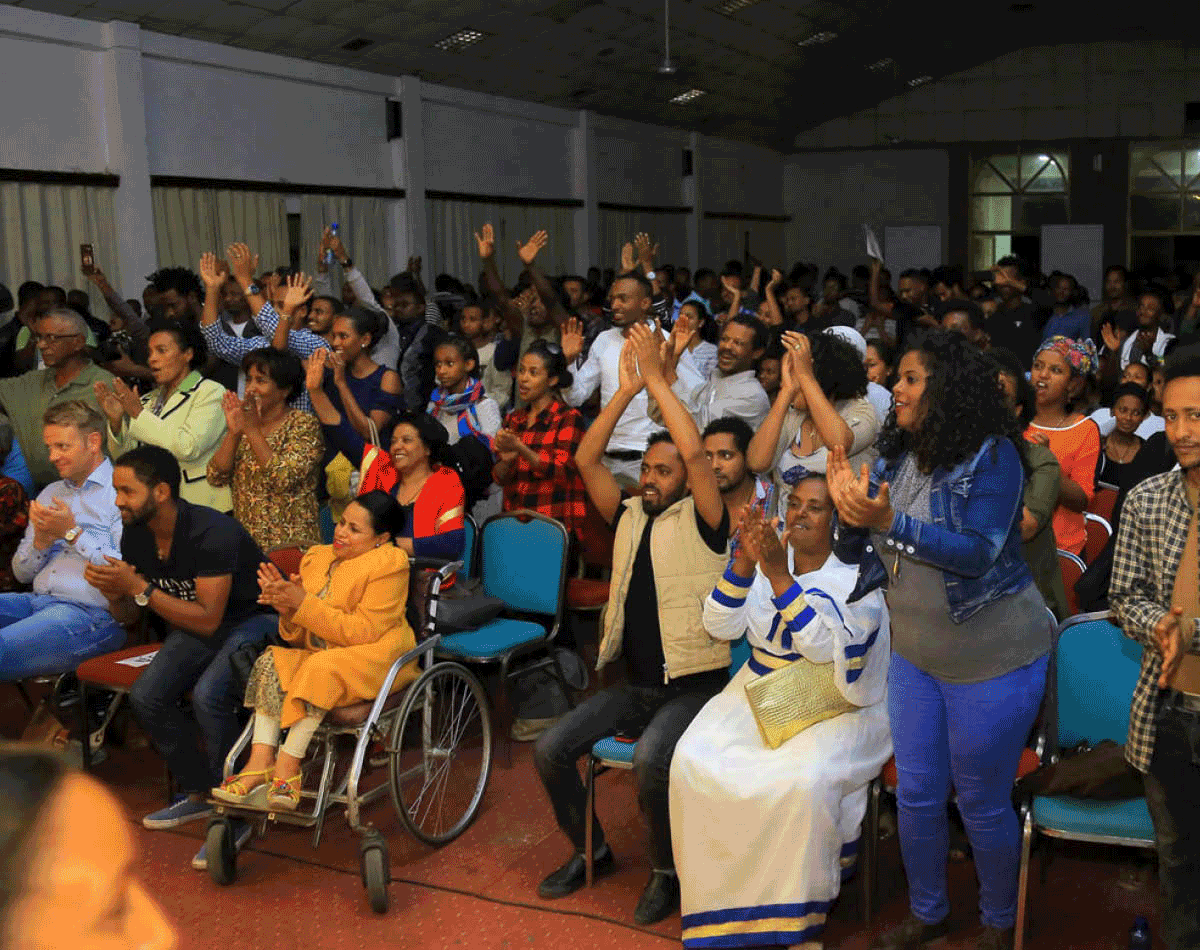
Poetry Jazz – Publication
Poetry Jazz: Wax and GoldPoetry Publication in Amharic, English and German
“No word is said without a world around it, these networks of words – spoken, exchanged, received, and reconfigured – co-produce our collective reality. They constitute not only a saying but an action.” – Olafur Eliasson
In the context of a long-term collaboration co-produced by the Institut für Raumexperimente, Berlin and Tobyia Poetic Jazz, Addis Ababa, the publication Poetry Jazz: Wax and Gold collects the voices of poets, wordsmiths, sound artists, musicians, composers and translators based in Ethiopia, Germany, the United States and South Africa.
The book is a collection of translation acts that chronicles six editions of live events alternating between Addis Ababa and Berlin. Fusing poetry in Amharic, English and German with live music, primed players from the international collective perform in critical and entertaining concert, drawing connections between diverse lyrical traditions, traditional Ethiopian pentatonic music, jazz influences, protest songs and contemporary electronic music. The practice of poetry jazz activates the invested audience through ‘Wax and Gold’, an Ethiopian form of artistic communication imbued with layered, clandestine meanings. The literal, superficial layer of ‘wax’ conceals a core of ‘gold’ that reveals itself through the intimate exchange between performers and public.
The Poetry Jazz artists act as popular ambassadors for the lively crowds and broadcast (hi)stories of destabilized communities from Addis Ababa to Berlin, Chicago or Cape Town. The story behind the scenes is just as compelling and suggests subversive methodologies to challenge threats to the freedom of expression.
The book both presents a selection of best practice examples that vibrated between stage and auditorium and offers insight into the working processes of the Poetry Jazz artists, their detours of uncertainty and the gaps in their translations acts and modes of shared knowledge-production. The texts derive from linguistic collisions that turn poetry into physical spaces where history is continually approached, negotiated, tuned and returned to. Poetry Jazz: Wax and Gold showcases poems, word experiments, acoustic mappings, visual renderings, essays and reflections in various states of translation and documentation.
With contributions by Frezer Admasu Molaligne, Olafur Eliasson, Eric Ellingsen, Clara Jo, Mihret Kebede Alwabie, Erica Licht, Robert Lippok, Bekele Mekonnen, Nebiy Mekonnen, Abebaw Melaku, Jorga Mesfin, Ari Benjamin Meyers, Neo Muyanga, Nolly Nesbit, Cia Rinne, Solomon Sahle Tizazu, Rike Scheffler, Robel Temesgen, Misrak Terefe Ergetu, Rediet Terefe Wegayehu, Christina Werner, Uljana Wolf, and Meheret Zelleke.
–
Poetry Jazz: Wax and Gold, Berlin, 2019
Edited by Institut für Raumexperimente e.V., Berlin;
in collaboration with Tobiya Poetic Jazz, Addis Ababa
Published by Koenig Books, London
Hardback; 256 pages; 22.0 cm x 33.0 cm
Amharic, English and German
Graphic Design: BASICS09
ISBN: 978-3-86335-713-9
Price 29.80 euros
Available at Buchhandlung Walther König
–
The Institut für Raumexperimente (Institute for Spatial Experiments) was affiliated with the Berlin University of the Arts from 2009 to 2014 as an experimental education and research project led by its founding director Olafur Eliasson. Since January 2015, the institute has operated as a non-profit registered organization (e.V.). It continues the work of the original five-year project and its goal of supporting artistic research and education.
Tobiya Poetic Jazz was founded by poets Abebaw Melaku, Mihret Kebede, Demissew Mersha, and Misrak Terefe in Addis Ababa in 2008. They established monthly poetry and jazz events that became increasingly popular and have grown to attract audiences of more than 1500 people each month. The Netsa Awechi Band, founded and led by Jorga Mesfin, has been the backbone of the events with open-ended experimental music compositions. The protagonists reach a national audience in Ethiopia through performances in cities across the country and through TV and radio broadcasts. Tobiya Poetic Jazz aims for critical independence to offer a creative platform to its audience.
This publication is part of the poetry series Poetry Jazz: Wax and Honey, I’m Home, initiated by the Institut für Raumexperimente, Berlin, in dialogue with Tobiya Poetic Jazz, Addis Ababa; in cooperation with the Akademie der Künste, Berlin; with support from Studio Olafur Eliasson, Berlin, the Graham Foundation for Advanced Studies in the Fine Arts, Chicago, and the Co-financing Fund of the Senate Department for Culture and Europe, Berlin.
It is funded by TURN Fund of the German Federal Cultural Foundation.
Poetry Jazz: Wax and GoldPoesie-Publikation, erschienen auf Amharisch, Englisch und Deutsch
“Es gibt keine Worte ohne eine Welt, die sie umgibt. Diese Netzwerke aus gesprochenen, ausgetauschten, empfangenen und verwandelten Worten erschaffen unsere kollektive Realität. Worte sind mehr als nur das Gesagte, sie stehen für Handlungen.” – Olafur Eliasson
Im Rahmen der langfristigen Kooperation zwischen dem Institut für Raumexperimente in Berlin und Tobiya Poetic Jazz aus Addis Abeba präsentiert die Publikation Poetry Jazz: Wax and Gold Beiträge von Dichter:innen, Sprachschöpfer:innen, Klangkünstler:innen, Musiker:innen, Komponist:innen und Übersetzer:innen aus Äthiopien, Deutschland, Südafrika und den Vereinigten Staaten von Amerika.
Das vorliegende Buch ist eine Sammlung von Übersetzungshandlungen und dokumentiert zudem sechs Live-Aufführungen, die abwechselnd in Addis Abeba und Berlin stattfanden: Poesie und Live-Musik verbindend, präsentieren die aufeinander eingespielten Künstler:innen des internationalen Kollektivs unterhaltsame wie zeitkritische Konzerte, die auf der Rezitation und Übersetzung amharischer, englischer und deutscher Texte beruhen und dabei Spoken-Word-Performance und Lyrikvortag mit musikalischen Elementen – von traditioneller äthiopischer Pentatonik-Musik über Jazz bis hin zu Protestliedern und zeitgenössischer elektronischer Musik – verbinden.
Poetry Jazz inspiriert ein involviertes Publikum mithilfe von „Wax and Gold“, einer lyrischen Form und künstlerischen Kommunikationsweise voller vielschichtiger, verborgener Bedeutungen: Die vordergründige, wörtlich verstandene Schicht aus „Wachs“ verbirgt einen Kern aus „Gold“.
Die Poetry-Jazz-Künstler:innen sind gefragte Botschafter:innen, die in unruhigen Zeiten ihrer Zuhörererschaft Geschichten erzählen und Geschichte vermitteln. Das Buch eröffnet einen Blick hinter die Kulissen der Zusammenarbeit und ist gleichzeitig eine widerständige Praxis, die Antworten auf die drängenden Herausforderungen der freien Meinungsäußerung sucht.
Poetry Jazz: Wax and Gold stellt einerseits eine Auswahl an Best-Practice-Beispielen vor, die den Resonanzraum zwischen Bühne und Publikum in Schwingung versetzen, und ermöglicht Einblicke in die Arbeitsmethoden der Mitwirkenden, beleuchtet ihre Abstecher ins Ungewisse, die Untiefen der Übersetzungspraxis und die Prozesse der gemeinsamen Wissensproduktion. Die Gedichte und Texte sind Ausdruck aktiven künstlerischen Wirkens, das Poesie in physische Räume verwandelt, in denen Geschichte fortwährend befragt, verhandelt, neu bestimmt und wieder angeeignet wird.
Mit Beiträgen von Frezer Admasu Molaligne, Olafur Eliasson, Eric Ellingsen, Clara Jo, Mihret Kebede Alwabie, Erica Licht, Robert Lippok, Bekele Mekonnen, Nebiy Mekonnen, Abebaw Melaku, Jorga Mesfin, Ari Benjamin Meyers, Neo Muyanga, Nolly Nesbit, Cia Rinne, Solomon Sahle Tizazu, Rike Scheffler, Robel Temesgen, Misrak Terefe Ergetu, Rediet Terefe Wegayehu, Christina Werner, Uljana Wolf und Meheret Zelleke.
–
Poetry Jazz: Wax and Gold, Berlin, 2019
Institut für Raumexperimente e.V., Berlin;
in Zusammenarbeit mit Tobiya Poetic Jazz, Addis Ababa
Erschienen bei Koenig Books, London
Hardcover; 256 Seiten; 22,0 cm x 33,0 cm
Amharisch, Englisch und Deutsch
Grafikdesign: BASICS09
ISBN: 978-3-86335-713-9
29,80 Euro
Erhältlich bei Buchhandlung Walther König
–
Das Institut für Raumexperimente war von 2009 bis 2014 als experimentelles Bildungs- und Forschungsprojekt unter der Leitung des Gründungsdirektors Olafur Eliasson an die Universität der Künste Berlin angeschlossen. Seit Januar 2015 ist das Institut als gemeinnütziger
Verein (e. V.) eingetragen und setzt die Arbeit des ursprünglich auf fünf Jahre angelegten Projekts zur Förderung künstlerischer Forschung und Lehre fort.
Tobiya Poetic Jazz wurde 2008 von den Dichter:innen Abebaw Melaku, Mihret Kebede Alwabie, Demissew Mersha und Misrak Terefe Ergetu gegründet. Gemeinsam entwickelten sie ein Veranstaltungsformat, das Dichtung und Jazz miteinander verband und zunehmend beliebter wurde, sodass in Kürze regelmässig monatlich mehr als 1.500 Zuschauer:innen kamen. Netsa Awechi, die Band des Musikers und Komponisten Jorga Mesfin, bildete mit ihrer improvisierten und experimentellen Art zu musizieren von Anfang an das Fundament der Veranstaltung. Die Protagonist:innen des Kollektivs treten landesweit auf und erreichen ihre Zuhörerschaft national über Radio und Fernsehen. Tobiya Poetic Jazz biete ihrem Publikum eine kritische und unabhängig kreative Plattform.
Die Publikation ist Teil der Veranstaltungsreihe Poetry Jazz: Wax and Honey, I’m home des Institut für Raumexperimente in Berlin, entstanden im Dialog mit Tobiya Poetic Jazz aus Addis Abeba und realisiert in Zusammenarbeit mit der Akademie der Künste in Berlin. Das Projekt wurde durch Studio Olafur Eliasson, Berlin, durch den Kofinanzierungsfonds der Senatsverwaltung für Kultur und Europa in Berlin und die Graham Foundation for Advanced Studies in the Fine Arts in Chicago unterstützt.
Es wurde finanziert durch den Fonds TURN der Kulturstiftung des Bundes.
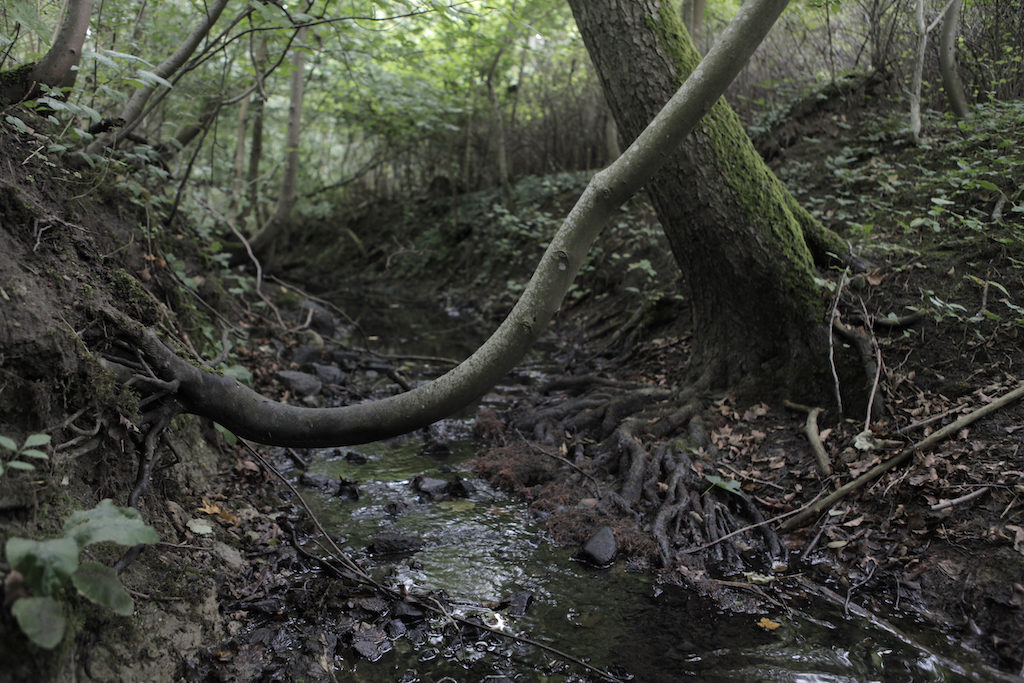
NOWs: The Trail or Time Between Trees
The Trail or Time Between Treessolo exhibition by Rune Bosse
OVERGADEN. Institut for Samtidskunst
Overgaden neden Vandet 17
DK-1414 København K
Opening
20 September 2019, 5 – 8 pm
What happens to an art institution when it has been abandoned by people and nature takes over the reins? In the interface between art and nature, Rune Bosse challenges the boundaries of what an art exhibition can be and how far an art institution is prepared to go in this, his first major solo exhibition.
For more info and a text by Rune Bosse click on the image above
Since he graduated from the Royal Danish Academy of Fine Arts in 2016, Rune Bosse has been working specifically with nature as both a liberating and poetic force, but also as a destructive and threatening space outside human control.
For the first time in Overgaden’s thirty-three years of existence, the art centre faces closure for a period of about six months in connection with an extensive and much-needed refurbishment. Rune Bosse has seized this unique situation and created an exhibition which, being the last one before the refurbishment, leaves Overgaden’s ground floor in ruins. The gallery spaces emerge with smashed windows, knocked-down walls, and overgrown floors and, due to the damaged electricity supply, the spaces will be enveloped in growing darkness during the exhibition period, as the period of daylight will gradually decrease. An apocalyptic wasteland where nature is allowed to take over Overgaden, so that the boundary between inside and outside, past and (possibly) future, is blurred.
For the exhibition, Rune Bosse leaves plant species to sprout and grow indoors, so that they penetrate the walls and erode significant parts of Overgaden’s interior. The artist has entered into a collaborative arrangement with the landowner August Hage at the manor Oremandsgaard Gods, who has more or less given him a free rein to use the forest belonging to the manor as both a laboratory and a materials store for the production and examination of organic links. All plants and greenery later to be transferred to Overgaden will grow organically and undisturbed throughout the exhibition period – beyond the control of the art centre.
The exhibition unfolds as a course of events where the awakening process of nature gradually intensifies. The audience steps into a laboratory which presents the artist’s examinations of organic material and plants over a period of time. Jam jars containing plants and work tables with studies of current and potential projects and processes appear side by side with tree roots and parts of plants, fungi, etc. From here, we move, via soil-covered passages, into the wood where a path leads us to the heart of the wood – where circular and ritual elements also form part of the encounter between man and nature.
With this uncompromising intervention at Overgaden, Rune Bosse offers visitors a radically different and unique exhibition experience and contact with nature, which is stimulating in view of a future where humans, potentially, no longer control nature or have been displaced by other species.
Rune Bosse (b.1987) graduated from the Royal Danish Academy of Fine Arts in 2016, combining this with studies at Olafur Eliasson’s experimental art school, Institut für Raumexperimente, Berlin. Bosse’s shows include the group show Festival For Future Nows at Hamburger Bahnhof, Berlin, in 2014, EXTRACT at the exhibition venue Kunstforeningen GL Strand, Copenhagen, in 2017, the ARoS Triennial The Garden also in 2017, and the exhibition Jordforbindelser (Down to Earth) at Fuglsang Kunstmuseum in 2018.
Installation view. Photo: Anders Sune Berg
Installation view. Photo: Anders Sune Berg
Installation view. Photo: Anders Sune Berg
Installation view. Photo: Anders Sune Berg
Installation view. Photo: Anders Sune Berg
Installation view. Photo: Anders Sune Berg
The Trail or Time Between Treessolo exhibition by Rune Bosse
OVERGADEN. Institut for Samtidskunst
Overgaden neden Vandet 17
DK-1414 København K
Eröffnung
20. September 2019, 17 – 20 h
What happens to an art institution when it has been abandoned by people and nature takes over the reins? In the interface between art and nature, Rune Bosse challenges the boundaries of what an art exhibition can be and how far an art institution is prepared to go in this, his first major solo exhibition.
For more info and a text by Rune Bosse click on the image above
Since he graduated from the Royal Danish Academy of Fine Arts in 2016, Rune Bosse has been working specifically with nature as both a liberating and poetic force, but also as a destructive and threatening space outside human control.
For the first time in Overgaden’s thirty-three years of existence, the art centre faces closure for a period of about six months in connection with an extensive and much-needed refurbishment. Rune Bosse has seized this unique situation and created an exhibition which, being the last one before the refurbishment, leaves Overgaden’s ground floor in ruins. The gallery spaces emerge with smashed windows, knocked-down walls, and overgrown floors and, due to the damaged electricity supply, the spaces will be enveloped in growing darkness during the exhibition period, as the period of daylight will gradually decrease. An apocalyptic wasteland where nature is allowed to take over Overgaden, so that the boundary between inside and outside, past and (possibly) future, is blurred.
For the exhibition, Rune Bosse leaves plant species to sprout and grow indoors, so that they penetrate the walls and erode significant parts of Overgaden’s interior. The artist has entered into a collaborative arrangement with the landowner August Hage at the manor Oremandsgaard Gods, who has more or less given him a free rein to use the forest belonging to the manor as both a laboratory and a materials store for the production and examination of organic links. All plants and greenery later to be transferred to Overgaden will grow organically and undisturbed throughout the exhibition period – beyond the control of the art centre.
The exhibition unfolds as a course of events where the awakening process of nature gradually intensifies. The audience steps into a laboratory which presents the artist’s examinations of organic material and plants over a period of time. Jam jars containing plants and work tables with studies of current and potential projects and processes appear side by side with tree roots and parts of plants, fungi, etc. From here, we move, via soil-covered passages, into the wood where a path leads us to the heart of the wood – where circular and ritual elements also form part of the encounter between man and nature.
With this uncompromising intervention at Overgaden, Rune Bosse offers visitors a radically different and unique exhibition experience and contact with nature, which is stimulating in view of a future where humans, potentially, no longer control nature or have been displaced by other species.
Rune Bosse (b.1987) graduated from the Royal Danish Academy of Fine Arts in 2016, combining this with studies at Olafur Eliasson’s experimental art school, Institut für Raumexperimente, Berlin. Bosse’s shows include the group show Festival For Future Nows at Hamburger Bahnhof, Berlin, in 2014, EXTRACT at the exhibition venue Kunstforeningen GL Strand, Copenhagen, in 2017, the ARoS Triennial The Garden also in 2017, and the exhibition Jordforbindelser (Down to Earth) at Fuglsang Kunstmuseum in 2018.
Installation view. Photo: Anders Sune Berg
Installation view. Photo: Anders Sune Berg
Installation view. Photo: Anders Sune Berg
Installation view. Photo: Anders Sune Berg
Installation view. Photo: Anders Sune Berg
Installation view. Photo: Anders Sune Berg
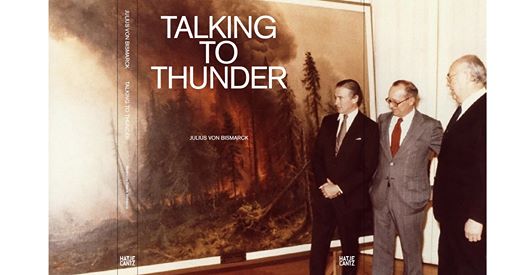
NOWs: Talking to Thunder by Julius von Bismarck
Talking to Thunderbook release
In a historical moment gripped by environmental catastrophes of our own making, Julius von Bismarck confronts the forces of nature at their unruly extremes. Deploying sculpture, photography, video and technological devices designed to harness the elements, Bismarck stills water droplets and fragments of exploding stone, shaping them into slow-motion disasters calibrated to the rate of human perception. Through performative encounters with lightning, wildfires, hurricanes and ocean waves, the artist stages a timely reckoning with the fate of age-old ideas of nature. Following a forward by museum director Susanne Pfleger, Talking to Thunder explores the implications of Bismarck’s latest work through essays by philosopher Dehlia Hannah and curator Nadim Samman, interviews with Wiwa shaman Taita, Jurgen Trittin of the German Green Party, and fire historian Stephen Pyne, and excerpts from Gaston Bachelard and Max Frisch.
Julius von Bismarck (*1983) grew up in Riad, Saudi Arabia, and Freiburg, Germany. He studied visual communications at the Berlin University of the Arts and at Hunter College in New York, and finished his graduate studies under Olafur Eliasson in 2013.
Julius von Bismarck
Talking to ThunderEd. Susanne Pfleger, Dehlia Hannah, graphic design by Karsten Heller, text(s) by Dehlia Hannah, Nadim Samman, contributions by Julius von Bismarck, Jürgen Trittin
English
2019. 176 pp., 80 ills.
softcover with a swiss binding
22.50 x 27.50 cm
Talking to Thunderbook release
In einem historischen Augenblick, der von vom Menschen ausgelösten Umweltkatastrophen geprägt ist, tritt Julius von Bismarck den Naturgewalten in ihren extremsten Formen entgegen. Er setzt Skulptur, Fotografie, Video und technische Hilfsmittel ein, um sich die Elemente zunutze zu machen und schafft Momentaufnahmen von Wassertropfen und Fragmenten explodierenden Gesteins, womit er sie zu Katastrophen in Zeitlupe formt, die der menschlichen Wahrnehmung angepasst sind. Durch performative Begegnungen mit Blitzen, Lauffeuern, Hurrikans und Meereswellen inszeniert der Künstler eine zeitgemäße Abrechnung mit dem Schicksal uralter Naturvorstellungen. Eingeleitet von einem Vorwort der Museumsdirektorin Susanne Pfleger erkundet Talking to Thunder mittels Essays von Philosophin Dehlia Hannah und Kurator Nadim Samman, Interviews mit Wiwa shaman Taita, dem deutschen Grünen-Politiker Jürgen Trittin, dem Feuerhistoriker Stephen Pyne und Auszügen aus dem Werk von Gaston Bachelard und Max Frisch die Auswirkungen von Bismarcks jüngsten Arbeiten.
Julius von Bismarck (*1983) wuchs in Riad (Saudi-Arabien) und Freiburg auf und studierte an der Universität der Künste Berlin und am Hunter College New York Visuelle Kommunikation. 2013 absolvierte er die Meisterklasse von Olafur Eliasson.
Julius von Bismarck
Talking to Thunder
Hrsg. Susanne Pfleger, Dehlia Hannah, Gestaltung von Karsten Heller, Text(e) von Dehlia Hannah, Nadim Samman, Beiträge von Julius von Bismarck, Jürgen Trittin
Englisch
2019. 176 Seiten, 80 Abb.
Schweizer Broschur
22,50 x 27,50 cm
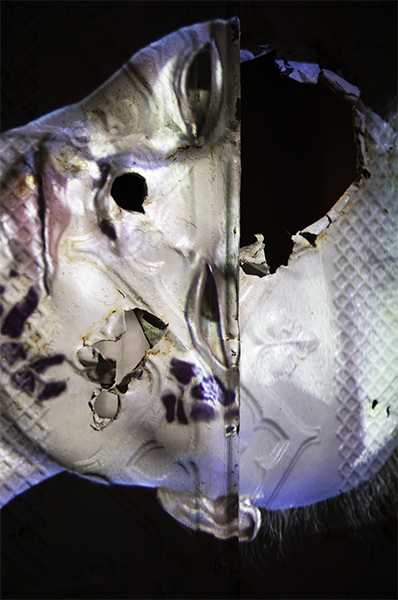
NOWs: Tribute Pallet
Tribute Palletmulti-media installation by Analisa Teachworth
Opening
11 SEP 2019, 7 – 10 pm
FRAGILE
Leipzigerstraße 63
10117 Berlin
FRAGILE is pleased to announce Tribute Pallet, a multi-media installation by Analisa Teachworth.
The artwork invites the audience into a shack-like scaffolding construction. The architectural qualities refer to structures built in rapidly changing circumstances with found materials typically determined by purpose, necessity, scarcity, and economic interdependencies. The work’s characteristics also tribute to earthier dwellings primarily emitted by society, yet occupying such a large part of our modern world. In seduce and repulse, the made artefact explores aesthetic qualities of sculpture that triumph and deconstruct the spectrum from shelter to contemporary urbanism erected in both opposition and sympathy to the utilitarian.
A table of glass jars holding sugar proposes the commodity in reference to what had been historically the highest traded product for roughly 350 years. Symbolically the sugarcane notes to the transatlantic slave trade at the peak of colonialism, while also illustrating a ceremony on how the global economy came to blossom. Even today sugars ritual to pleasure is unrivaled, holding novelties of memory, production, demand, and revealing an unawareness in the active individual participation within unavoidable global markets.
Abstractly the elements in this conversation express a mastery of economic process, a hunger to consume, a fetish for the exotic, a force of power, the exodus and decimation of millions of lives, and an uncountable amount of labor
Projections of hybrid siren creatures surround the inner space while a sound piece of language and hymn plays. The score speaks to the complexity of inert cultural systems while offering perspectives on progress, sorrow, and transformation. The renderings allegorically intertwine a narrative between current aesthetics, being products of digital labor, and space they exist within. Their anthropomorphised bodies celebrate and expose the gesture of collective hardship and sacrifice via choreography.
A perceived collapse of the systems we rely upon entirely is not a faraway apocalyptic future for many who remain anonymous.
Analisa Teachworth (b.1985 Detroit, Michigan) is a New York City—based interdisciplinary artist whose practice includes video, sculpture, sound, and performance. Teachworth’s work has been exhibited at institutions such as The Shed, MoMA PS1, Hamburger Bahnhof Staatliche Museen Berlin, Kunst-Werke Institute for Contemporary Art Berlin, and The New Museum.
www.analisateachworth.net
About FRAGILE
FRAGILE fosters a program of conversation, antagonism, renegotiation, and celebration.
FRAGILE is a non-profit project for contemporary artistic practices located in Berlin. It encompasses an exhibition and a residency space.
FRAGILE is guided by curations etymology, the practice of caring and was founded on the warmest summerday of 2018 by Maurin Dietrich and Jonas Wendelin.
Tribute PalletMultimedia-Installation von Analisa Teachworth
Eröffnung
11. September 2019, 19 – 22 h
FRAGILE
Leipzigerstraße 63
10117 Berlin
FRAGILE is pleased to announce Tribute Pallet, a multi-media installation by Analisa Teachworth.
The artwork invites the audience into a shack-like scaffolding construction. The architectural qualities refer to structures built in rapidly changing circumstances with found materials typically determined by purpose, necessity, scarcity, and economic interdependencies. The work’s characteristics also tribute to earthier dwellings primarily emitted by society, yet occupying such a large part of our modern world. In seduce and repulse, the made artefact explores aesthetic qualities of sculpture that triumph and deconstruct the spectrum from shelter to contemporary urbanism erected in both opposition and sympathy to the utilitarian.
A table of glass jars holding sugar proposes the commodity in reference to what had been historically the highest traded product for roughly 350 years. Symbolically the sugarcane notes to the transatlantic slave trade at the peak of colonialism, while also illustrating a ceremony on how the global economy came to blossom. Even today sugars ritual to pleasure is unrivaled, holding novelties of memory, production, demand, and revealing an unawareness in the active individual participation within unavoidable global markets.
Abstractly the elements in this conversation express a mastery of economic process, a hunger to consume, a fetish for the exotic, a force of power, the exodus and decimation of millions of lives, and an uncountable amount of labor
Projections of hybrid siren creatures surround the inner space while a sound piece of language and hymn plays. The score speaks to the complexity of inert cultural systems while offering perspectives on progress, sorrow, and transformation. The renderings allegorically intertwine a narrative between current aesthetics, being products of digital labor, and space they exist within. Their anthropomorphised bodies celebrate and expose the gesture of collective hardship and sacrifice via choreography.
A perceived collapse of the systems we rely upon entirely is not a faraway apocalyptic future for many who remain anonymous.
Analisa Teachworth (b.1985 Detroit, Michigan) is a New York City—based interdisciplinary artist whose practice includes video, sculpture, sound, and performance. Teachworth’s work has been exhibited at institutions such as The Shed, MoMA PS1, Hamburger Bahnhof Staatliche Museen Berlin, Kunst-Werke Institute for Contemporary Art Berlin, and The New Museum.
www.analisateachworth.net
About FRAGILE
FRAGILE fosters a program of conversation, antagonism, renegotiation, and celebration.
FRAGILE is a non-profit project for contemporary artistic practices located in Berlin. It encompasses an exhibition and a residency space.
FRAGILE is guided by curations etymology, the practice of caring and was founded on the warmest summerday of 2018 by Maurin Dietrich and Jonas Wendelin.
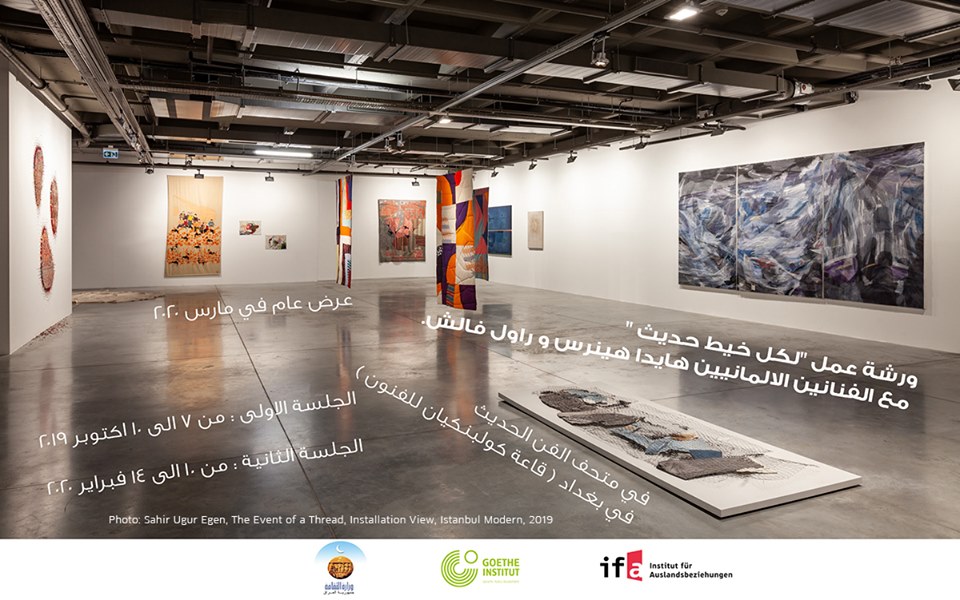
NOWs: The Event of a Thread
The Event of a ThreadWorkshop and exhibition with Raul Walch
Du bist Künstler aus Bagdad, interessiert dich für die Arbeit mit Stoffen und möchtest mit zwei deutschen KünstlerInnen zusammenarbeiten? Bewirb dich jetzt.
THE EVENT OF A THREAD – zwei 4-tägige Workshops mit dem deutschen Künstler Raul Walch und einer öffentlichen Präsentation innerhalb der gleichnamigen Ausstellung im März 2020.
Interventionen und neue künstlerische Initiativen im öffentlichen Raum und an früheren Kulturorten Bagdads.
Workshop 1: 07.10. – 10.10. von 10.00 bis 16.00 Uhr im Museum für Moderne Kunst (Gulbenkian Halle) in Bagdad
Der Workshop ist gerichtet an Künstler aus Bagdad zwischen 18 und 35 Jahren von unterschiedlichen Kunstsparten kommend.
Bewirb Dich hier: https://forms.gle/gtxGyLGJ7A7hWZWk8
Der zweiteilige Workshop greift Themen des Zusammenlebens in Bagdad auf. Wir suchen öffentliche Räume, unkonventionelle Orte und verwaiste Kulturstätten als Potentialfläche für künstlerischen Ausdruck und Initiativen unter Verwendung von Textilem. Das Experimentieren mit Textilen, die Verarbeitung, die Farben, Muster und Formen, das Schaffen von Volumen und Raum – all die vielseitigen Möglichkeiten mit Textilen zu arbeiten, über Kleidung zu Performances, Installationen oder Architektur wird unser gemeinsamer Arbeitsschwerpunkt in Bezug auf die von uns gefundenen Orte sein.
Zu unseren Aktivitäten werden Arbeitspräsentationen, Ausflüge und gemeinsame Essen zählen. Im zweiten Workshop vom 10.02. bis 14.02.2019 wirst Du die Gelegenheit haben, Dein Kunstwerk fertigzustellen.
Der Workshop ist Teil der ifa Wanderausstellung THE EVENT OF A THREAD. Global Narratives in Textiles, die vom 1. bis 30. März 2020 im Museum für Moderne Kunst (Gulbenkian Halle) in Bagdad gezeigt wird. Die Ausstellung wurde von ifa, dem Deutschen Institut für Auslandsbeziehungen konzipiert und produziert. Die präsentierten Arbeiten befassen sich mit dem Kontext von Textilien, ihren spezifischen Eigenschaften und ihrer Geschichte.
Der Workshop und die Ausstellung THE EVENT OF A THREAD ist eine Kooperation zwischen ifa, dem deutschen Institut für Auslandsbeziehungen, dem Goethe-Institut Irak und dem Ministerium für Kultur, Tourismus und Antiquitäten, Republik Irak.
Raul Walch überschreitet in seiner künstlerischen Praxis die Grenzen gängiger Kunst-Genres. Er arbeitet als Bildhauer und Konzeptkünstler, schlüpft in seinen Arbeiten aber ebenso in die Rolle des Performers oder Forschers. Im Mittelpunkt steht immer eine unkonventionelle, künstlerische Auseinandersetzung mit gesellschaftlicher Realität. Die Arbeiten und Aktionen von Walch sind vor allem ortsspezifische Interventionen, die auf ihr Umfeld eingehen.
أنت فنان من بغداد ، مهتم بالعمل مع المنسوجات مع فنانين ألمان؟ سجل الآن!
( لكل خيط حديث ) – دورتين تدريبيتين مدتهما اربعة ايام مع الفنان الالماني راوول فالش وعرض فني ضخم في مارس 2020
مبادرة و تفاعل فني في الوسط الثقافي العام و المواقع الثقافية السابقة .
الجلسه الاولى : 7- 10 / 10 اكتوبر / 2019 من الساعة العاشرة الى الساعة الرابعة في متحف الفن المعاصر ( قاعه كولبنكيان )
الورشه تستهدف فنانين من بغداد بأعمار 18 – 35 من جميع التخصصات .
سجل هنا : https://forms.gle/gtxGyLGJ7A7hWZWk8
ورشتي العمل ستظهر جوانب التعايش الاجتماعي في بغداد . سنقوم بالبحث عن اماكن مهمله غير تقليديه لخلق مضاهر فنيه باستخدام الانسجه . سنختبر استخدام الانسجه , الاعمال اليدويه , لالوان , القوالب و الاشكال , سنخلق حجوما و مساحات بكل الطرق المتنوعه للعمل مع المنسوجات , ملابس للاداء و التركيب , الهندسه المعماريه ستكون طريقة عملنا الاساسيه من خلال علاقة هذه الامور بالاماكن التي وجدناها .
فعالياتنا ستتضمن عرضا للاعمال , رحلات و وجبات طعام متعددة . الجزء الثاني من ورشة العمل من 10-14 / 2 فبراير /2020 سنركز على الشكل النهائي للاعمال الفنيه لتكون جاهزه للعرض العام .
ورشة العمل هذه هي جزء من معرض ايفا الجوال ( لكل خيط حديث ) . الروايات العالميه في المنسوجات , و التي ستقدم في بغداد في متحف الفن المعاصر ( قاعه كولبنكيان ) من 1- 30/ 3 مارس / 2020 . صمم و انتج المعرض من قبل ايفا , معهد العلاقات الخارجيه الثقافيه الالماني . الأعمال المقدمة تستهدف المنسوجات ، صفاتها المحددة وتاريخها .
كنتيجه لورشتي العمل في الاربعة ايام ستكون لديكم فرصه لتقديم عملك في معرض ( لكل خيط حديث ) في متحف الفن المعاصر ( قاعة كولبنكيان ) في مارس 2020 .
ورشة العمل و المعرض الفني ( لكل خيط حديث ) هو تعاون بين ايفا , معهد العلاقات الخارجيه الثقافيه الالماني و معهد غوتا العراق و وزارة الثقافه و السياحه و الاثار , جمهورية العراق .
في هذا التمرين الفني , الالماني راوول فالش يعبر الحدود التقليديه لأنواع الفن . هو يعمل كنحات و فنان مفاهيمي , و يعمل ايضا كفنان مؤدي او باحث .يركز دوما في الطرق غير التقليديه , الاختبارات الفنيه للواقع المجتمعي . ان عمل و افعال فالش بشكل اساسي تحاكي وتستهدف و تتفاعل مع بيئات المواقع التي يعمل فيها .
The Event of a ThreadWorkshop und Ausstellung mit Raul Walch
Du bist Künstler aus Bagdad, interessiert dich für die Arbeit mit Stoffen und möchtest mit zwei deutschen KünstlerInnen zusammenarbeiten? Bewirb dich jetzt.
THE EVENT OF A THREAD – zwei 4-tägige Workshops mit dem deutschen Künstler Raul Walch und einer öffentlichen Präsentation innerhalb der gleichnamigen Ausstellung im März 2020.
Interventionen und neue künstlerische Initiativen im öffentlichen Raum und an früheren Kulturorten Bagdads.
Workshop 1: 07.10. – 10.10. von 10.00 bis 16.00 Uhr im Museum für Moderne Kunst (Gulbenkian Halle) in Bagdad
Der Workshop ist gerichtet an Künstler aus Bagdad zwischen 18 und 35 Jahren von unterschiedlichen Kunstsparten kommend.
Bewirb Dich hier: https://forms.gle/gtxGyLGJ7A7hWZWk8
Der zweiteilige Workshop greift Themen des Zusammenlebens in Bagdad auf. Wir suchen öffentliche Räume, unkonventionelle Orte und verwaiste Kulturstätten als Potentialfläche für künstlerischen Ausdruck und Initiativen unter Verwendung von Textilem. Das Experimentieren mit Textilen, die Verarbeitung, die Farben, Muster und Formen, das Schaffen von Volumen und Raum – all die vielseitigen Möglichkeiten mit Textilen zu arbeiten, über Kleidung zu Performances, Installationen oder Architektur wird unser gemeinsamer Arbeitsschwerpunkt in Bezug auf die von uns gefundenen Orte sein.
Zu unseren Aktivitäten werden Arbeitspräsentationen, Ausflüge und gemeinsame Essen zählen. Im zweiten Workshop vom 10.02. bis 14.02.2019 wirst Du die Gelegenheit haben, Dein Kunstwerk fertigzustellen.
Der Workshop ist Teil der ifa Wanderausstellung THE EVENT OF A THREAD. Global Narratives in Textiles, die vom 1. bis 30. März 2020 im Museum für Moderne Kunst (Gulbenkian Halle) in Bagdad gezeigt wird. Die Ausstellung wurde von ifa, dem Deutschen Institut für Auslandsbeziehungen konzipiert und produziert. Die präsentierten Arbeiten befassen sich mit dem Kontext von Textilien, ihren spezifischen Eigenschaften und ihrer Geschichte.
Der Workshop und die Ausstellung THE EVENT OF A THREAD ist eine Kooperation zwischen ifa, dem deutschen Institut für Auslandsbeziehungen, dem Goethe-Institut Irak und dem Ministerium für Kultur, Tourismus und Antiquitäten, Republik Irak.
Raul Walch überschreitet in seiner künstlerischen Praxis die Grenzen gängiger Kunst-Genres. Er arbeitet als Bildhauer und Konzeptkünstler, schlüpft in seinen Arbeiten aber ebenso in die Rolle des Performers oder Forschers. Im Mittelpunkt steht immer eine unkonventionelle, künstlerische Auseinandersetzung mit gesellschaftlicher Realität. Die Arbeiten und Aktionen von Walch sind vor allem ortsspezifische Interventionen, die auf ihr Umfeld eingehen.
أنت فنان من بغداد ، مهتم بالعمل مع المنسوجات مع فنانين ألمان؟ سجل الآن!
( لكل خيط حديث ) – دورتين تدريبيتين مدتهما اربعة ايام مع الفنان الالماني راوول فالش وعرض فني ضخم في مارس 2020
مبادرة و تفاعل فني في الوسط الثقافي العام و المواقع الثقافية السابقة .
الجلسه الاولى : 7- 10 / 10 اكتوبر / 2019 من الساعة العاشرة الى الساعة الرابعة في متحف الفن المعاصر ( قاعه كولبنكيان )
الورشه تستهدف فنانين من بغداد بأعمار 18 – 35 من جميع التخصصات .
سجل هنا : https://forms.gle/gtxGyLGJ7A7hWZWk8
ورشتي العمل ستظهر جوانب التعايش الاجتماعي في بغداد . سنقوم بالبحث عن اماكن مهمله غير تقليديه لخلق مضاهر فنيه باستخدام الانسجه . سنختبر استخدام الانسجه , الاعمال اليدويه , لالوان , القوالب و الاشكال , سنخلق حجوما و مساحات بكل الطرق المتنوعه للعمل مع المنسوجات , ملابس للاداء و التركيب , الهندسه المعماريه ستكون طريقة عملنا الاساسيه من خلال علاقة هذه الامور بالاماكن التي وجدناها .
فعالياتنا ستتضمن عرضا للاعمال , رحلات و وجبات طعام متعددة . الجزء الثاني من ورشة العمل من 10-14 / 2 فبراير /2020 سنركز على الشكل النهائي للاعمال الفنيه لتكون جاهزه للعرض العام .
ورشة العمل هذه هي جزء من معرض ايفا الجوال ( لكل خيط حديث ) . الروايات العالميه في المنسوجات , و التي ستقدم في بغداد في متحف الفن المعاصر ( قاعه كولبنكيان ) من 1- 30/ 3 مارس / 2020 . صمم و انتج المعرض من قبل ايفا , معهد العلاقات الخارجيه الثقافيه الالماني . الأعمال المقدمة تستهدف المنسوجات ، صفاتها المحددة وتاريخها .
كنتيجه لورشتي العمل في الاربعة ايام ستكون لديكم فرصه لتقديم عملك في معرض ( لكل خيط حديث ) في متحف الفن المعاصر ( قاعة كولبنكيان ) في مارس 2020 .
ورشة العمل و المعرض الفني ( لكل خيط حديث ) هو تعاون بين ايفا , معهد العلاقات الخارجيه الثقافيه الالماني و معهد غوتا العراق و وزارة الثقافه و السياحه و الاثار , جمهورية العراق .
في هذا التمرين الفني , الالماني راوول فالش يعبر الحدود التقليديه لأنواع الفن . هو يعمل كنحات و فنان مفاهيمي , و يعمل ايضا كفنان مؤدي او باحث .يركز دوما في الطرق غير التقليديه , الاختبارات الفنيه للواقع المجتمعي . ان عمل و افعال فالش بشكل اساسي تحاكي وتستهدف و تتفاعل مع بيئات المواقع التي يعمل فيها .

NOWs: Ziggy goes wild
Anne Duk Hee Jordan: bare bottom tucan, 2019. Crayons on paper
Ziggy goes wildsolo exhibition by Anne Duk Hee Jordan
Opening
20 September, 7 pm
Kunstverein Arnsberg
Königstraße 24 / Neumarkt
59821 Arnsberg
Nach Ziggy on the Land of Drunken Trees (Galerie Wedding, Berlin 2018) und Ziggy and the Starfish. How one becomes One with a Fish (Riga International Biennial of Contemporary Art 2018) kommt die Ausstellungstrilogie der Künstlerin Anne Duk Hee Jordan nun mit Ziggy goes wild im Kunstverein Arnsberg zu einem krönenden Abschluss.
Ziggy ist einer fiktiven Figur aus dem Werk David Bowies (Ziggy Stardust, 1972) entlehnt und verkörpert dort einen bisexuellen und promiskuitiven (Mars-?) Menschen, der mit apokalyptischen Gedanken über das Ende der Welt sinniert. Als Gegenstück zum Seestern (Starfish) steht der/die unsichtbar bleibende Ziggy bei Anne Duk Hee Jordan für Schönheit, Fremdartigkeit, Queerness und Exotik der Meeresbewohner, die angesichts des globalen Klimawandels diversen Mutationen und Veränderungen ihrer Sexualität unterliegen. In einem Rechercheprojekt mit der Kuratorin Pauline Doutreluingne realisierte die versierte Taucherin eine wandumspannende Multi-Media-Collage Changing Sex in Ecology (2016-2018). Jordan entwirft in ihrer dreiteiligen Filmgeschichte das Szenario eines post-anthropozentrischen Zeitalters, in dem der Mensch nicht mehr im Zentrum des Geschehens steht, statt dessen die Perspektive der (nicht nur) sie faszinierenden „Anderen“ eingenommen wird. Sie wählt keine katastrophalen Bilder, sondern eine durchaus wundervolle, fantastisch und verspielt anmutende Ästhetik, die Betrachterinnen und Betrachter in ihren Bann zu ziehen vermag.
Im Kunstverein Arnsberg zeigt Anne Duk Hee Jordan Zeichnungen, mehrere Filme, darunter Staying with the trouble und skulpturale, kinetische Objekte wie Homo Stupidus Goethe Robot, eine fliegende Seegurke und einen monumentalen Seestern, die alle ein Eigenleben zu führen scheinen und den Ausstellungsraum für sich beanspruchen.
Erst kürzlich konzipierte sie ein skulpturales Bühnenbild für das Donna Haraway entlehnte Stück des Künstlers Carlos Manuel in Berlin, betitelt Unruhig bleiben/Staying with the trouble (2019), eine spekulative Fabel über die Verbindung zwischen Mensch und Monarchfalter. Den Film zeigt sie nun erstmals im Kunstverein. Die Feministin und Wissenschaftstheoretikerin Haraway beschwört in ihrem gleichnamigen Buch für das Leben nach dem Anthropozän neue Formen der Verwandtschaft. Weder Technikeuphorie noch apokalyptische Endzeitstimmung seien die Lösung, stattdessen haben wir nur eine Chance, wenn wir unruhig bleiben, alte Hierarchien und Wertvorstellungen hinterfragen und als sogenannte ‘Symbionten‘ in der Zukunft weiterleben – Gedanken, die für das künstlerische Œuvre Jordans eine wichtige Rolle spielen. Dieses „Mit-Werden“ mit anderen Spezies beschreibt Haraway als ‘Sympoiesis‘ und richtet dabei den Blick auf die Bedrängten unseres Planeten, etwa die indigene Bevölkerung oder aussterbende Tierarten.
Kernstück der Ausstellung von Anne Duk Hee Jordan ist die raumgreifende Arbeit Into the Wild, eine soziale Food Sculpture, eine überbordende Tafel, die aus essbaren Kräutern, Wurzeln, verschiedenen Gemüsesorten und anderen, teils vergessenen Pflanzen besteht – umrahmt von einem klappernden Muschelchor (Clapping Clams, 2018). In einer konzeptuellen Performance werden die Besucherinnen und Besuchern diese miteinander verspeisen. Während der Laufzeit werden die Überreste zunehmend zerfallen, verrotten und schlussendlich kompostiert wieder als fruchtbarer Humus dem organischen Zyklus zugeführt. ‘Human‘ stamme nicht von ‘homo‘, sondern von ‘Humus‘, so Haraway in ihrer ökologischen Ethik, die mit der Strategie des Kompostierens eine Verwertung bisherigen, gebrauchten Materials anspricht, das zersetzt ein neues ‘Produkt‘ ergibt. Sind wir also letztendlich nichts weiter als Kompost, wie Haraway vermutet? „We are compost, not posthuman; we inhabit the humusities, not the humanities.“
Diese und vergleichbare Fragen stellt Anne Duk Hee Jordan in ihrem vielfältigen Werk und regt damit zu einer Reflektion unseres Verhältnisses zur Umwelt und ihren unterschiedlichen Erdbewohnern an, die eine Trennung zwischen Natur und Kultur längst obsolet werden lassen.
Anne Duk Hee Jordan: bare bottom tucan, 2019. Crayons on paper
Ziggy goes wildEinzelausstellung von Anne Duk Hee Jordan
Eröffnung
20. September, 19 h
Kunstverein Arnsberg
Königstraße 24 / Neumarkt
59821 Arnsberg
Nach Ziggy on the Land of Drunken Trees (Galerie Wedding, Berlin 2018) und Ziggy and the Starfish. How one becomes One with a Fish (Riga International Biennial of Contemporary Art 2018) kommt die Ausstellungstrilogie der Künstlerin Anne Duk Hee Jordan nun mit Ziggy goes wild im Kunstverein Arnsberg zu einem krönenden Abschluss.
Ziggy ist einer fiktiven Figur aus dem Werk David Bowies (Ziggy Stardust, 1972) entlehnt und verkörpert dort einen bisexuellen und promiskuitiven (Mars-?) Menschen, der mit apokalyptischen Gedanken über das Ende der Welt sinniert. Als Gegenstück zum Seestern (Starfish) steht der/die unsichtbar bleibende Ziggy bei Anne Duk Hee Jordan für Schönheit, Fremdartigkeit, Queerness und Exotik der Meeresbewohner, die angesichts des globalen Klimawandels diversen Mutationen und Veränderungen ihrer Sexualität unterliegen. In einem Rechercheprojekt mit der Kuratorin Pauline Doutreluingne realisierte die versierte Taucherin eine wandumspannende Multi-Media-Collage Changing Sex in Ecology (2016-2018). Jordan entwirft in ihrer dreiteiligen Filmgeschichte das Szenario eines post-anthropozentrischen Zeitalters, in dem der Mensch nicht mehr im Zentrum des Geschehens steht, statt dessen die Perspektive der (nicht nur) sie faszinierenden „Anderen“ eingenommen wird. Sie wählt keine katastrophalen Bilder, sondern eine durchaus wundervolle, fantastisch und verspielt anmutende Ästhetik, die Betrachterinnen und Betrachter in ihren Bann zu ziehen vermag.
Im Kunstverein Arnsberg zeigt Anne Duk Hee Jordan Zeichnungen, mehrere Filme, darunter Staying with the trouble und skulpturale, kinetische Objekte wie Homo Stupidus Goethe Robot, eine fliegende Seegurke und einen monumentalen Seestern, die alle ein Eigenleben zu führen scheinen und den Ausstellungsraum für sich beanspruchen.
Erst kürzlich konzipierte sie ein skulpturales Bühnenbild für das Donna Haraway entlehnte Stück des Künstlers Carlos Manuel in Berlin, betitelt Unruhig bleiben/Staying with the trouble (2019), eine spekulative Fabel über die Verbindung zwischen Mensch und Monarchfalter. Den Film zeigt sie nun erstmals im Kunstverein. Die Feministin und Wissenschaftstheoretikerin Haraway beschwört in ihrem gleichnamigen Buch für das Leben nach dem Anthropozän neue Formen der Verwandtschaft. Weder Technikeuphorie noch apokalyptische Endzeitstimmung seien die Lösung, stattdessen haben wir nur eine Chance, wenn wir unruhig bleiben, alte Hierarchien und Wertvorstellungen hinterfragen und als sogenannte ‘Symbionten‘ in der Zukunft weiterleben – Gedanken, die für das künstlerische Œuvre Jordans eine wichtige Rolle spielen. Dieses „Mit-Werden“ mit anderen Spezies beschreibt Haraway als ‘Sympoiesis‘ und richtet dabei den Blick auf die Bedrängten unseres Planeten, etwa die indigene Bevölkerung oder aussterbende Tierarten.
Kernstück der Ausstellung von Anne Duk Hee Jordan ist die raumgreifende Arbeit Into the Wild, eine soziale Food Sculpture, eine überbordende Tafel, die aus essbaren Kräutern, Wurzeln, verschiedenen Gemüsesorten und anderen, teils vergessenen Pflanzen besteht – umrahmt von einem klappernden Muschelchor (Clapping Clams, 2018). In einer konzeptuellen Performance werden die Besucherinnen und Besuchern diese miteinander verspeisen. Während der Laufzeit werden die Überreste zunehmend zerfallen, verrotten und schlussendlich kompostiert wieder als fruchtbarer Humus dem organischen Zyklus zugeführt. ‘Human‘ stamme nicht von ‘homo‘, sondern von ‘Humus‘, so Haraway in ihrer ökologischen Ethik, die mit der Strategie des Kompostierens eine Verwertung bisherigen, gebrauchten Materials anspricht, das zersetzt ein neues ‘Produkt‘ ergibt. Sind wir also letztendlich nichts weiter als Kompost, wie Haraway vermutet? „We are compost, not posthuman; we inhabit the humusities, not the humanities.“
Diese und vergleichbare Fragen stellt Anne Duk Hee Jordan in ihrem vielfältigen Werk und regt damit zu einer Reflektion unseres Verhältnisses zur Umwelt und ihren unterschiedlichen Erdbewohnern an, die eine Trennung zwischen Natur und Kultur längst obsolet werden lassen.
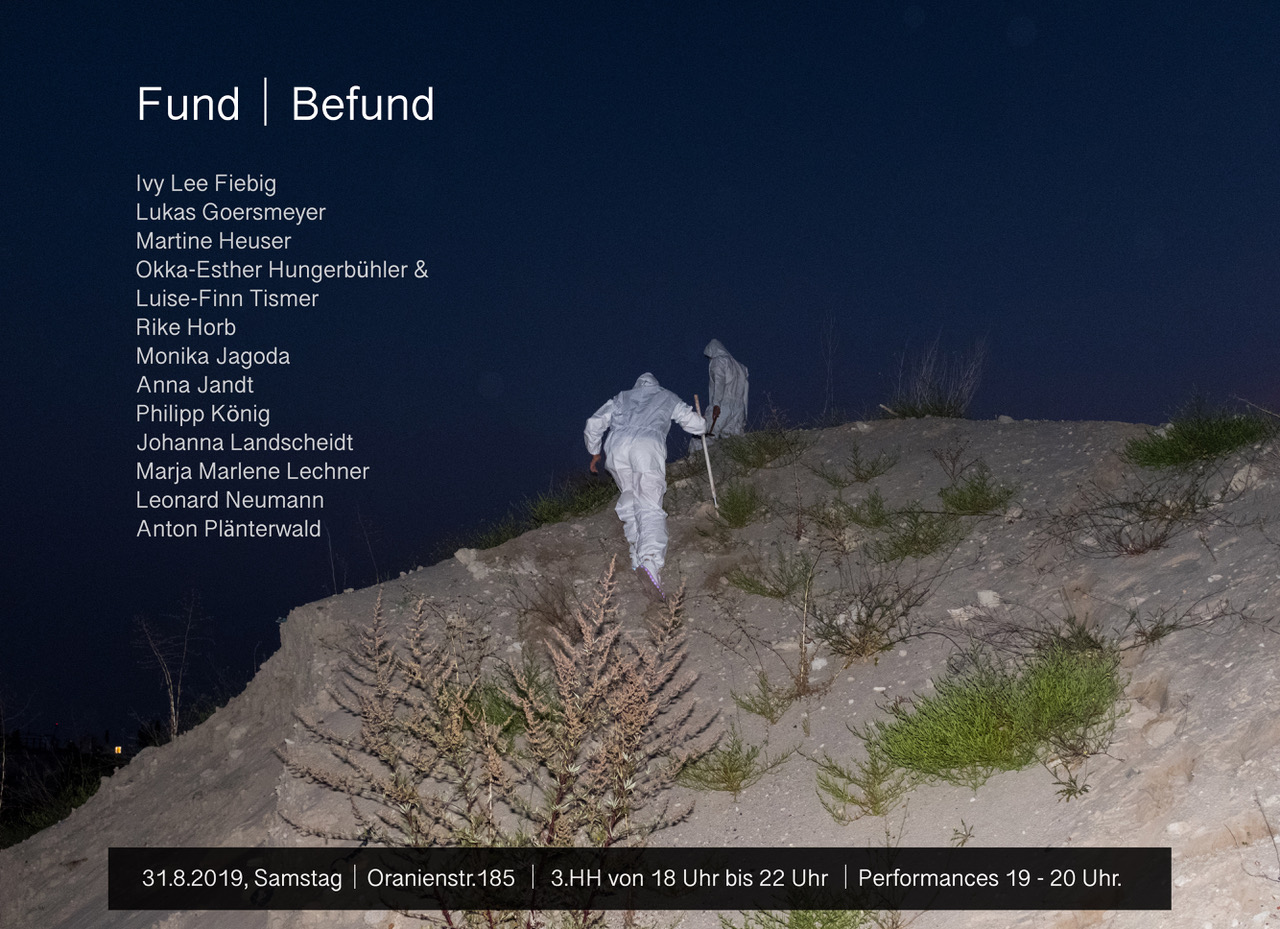
NOWs: Fund I Befund
Fund I Befundgroup exhibition
Oranienstr.185
10999 Berlin – Kreuzberg
3 HH
31 August 2019
6-10 pm
performances 7-8 pm
Artists:
Ivy Lee Fiebig
Lukas Goersmeyer
Martine Heuser
Okka-Esther Hungerbühler &
Luise-Finn Tismer
Rike Horb
Monika Jagoda
Anna Jandt
Philipp König
Johanna Landscheidt
Marja Marlene Lechner
Leonard Neumann
Anton Plänterwald
Fund I BefundGruppenausstellung
Oranienstr.185
10999 Berlin – Kreuzberg
3 HH
31. August 2019
18-22 Uhr
Performances 19-20 Uhr
Mit den Künstler*innen:
Ivy Lee Fiebig
Lukas Goersmeyer
Martine Heuser
Okka-Esther Hungerbühler &
Luise-Finn Tismer
Rike Horb
Monika Jagoda
Anna Jandt
Philipp König
Johanna Landscheidt
Marja Marlene Lechner
Leonard Neumann
Anton Plänterwald
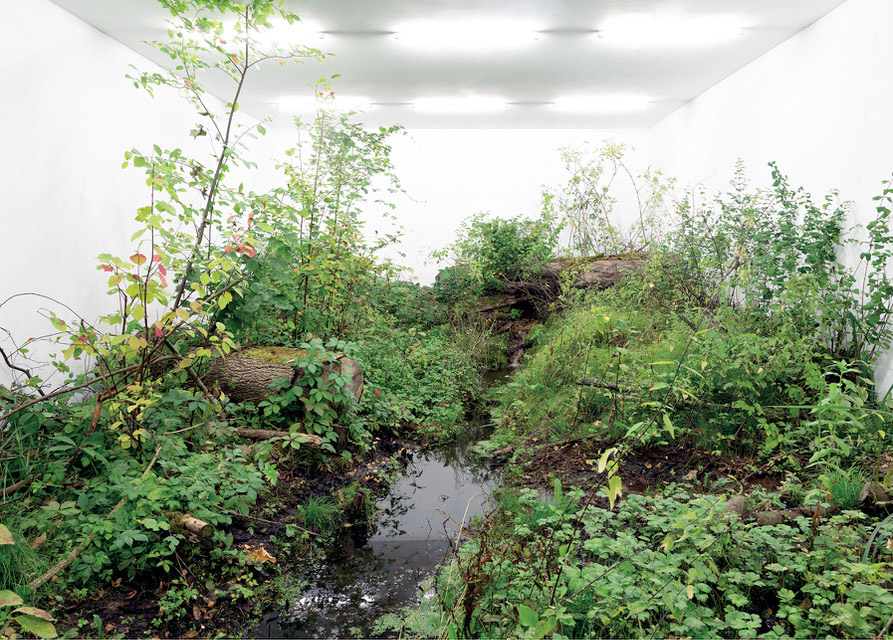
Isolation (52°33’44.1”N 14°03’12.8”E) by Fabian Knecht
FABIAN KNECHT
Isolation (52°33’44.1”N 14°03’12.8”E)
Eröffnung: 7.9.2019, 16-22 Uhr
Anmeldung Transfer vom / zum Bahnhof Müncheberg zur Eröffnung
(info@alexanderlevy.net)
Ausstellungsdauer: 7.9.-22.9.2019
Täglich 13-18 Uhr
Adresse:
Haus Erlengrund
Fischerberg 11
15377 Buckow (Märkische Schweiz)
kuratiert von Dehlia Hannah und Nadim Samman
Architektur von Marcel Schnabel, Ivy Lee Fiebig und Andre Simonow
Mit Unterstützung von alexander levy, Haus Erlengrund, Untere Naturschutzbehörde Märkisch-Oderland und Holz Possling
Forest of the Real
Dehlia Hannah | Nadim Samman
At 52°33’44.1”N 14°03’12.8”E, a precise Global Positioning System coordinate provided by Google Maps, the blindfold is removed. As you warily tread the muddy ground, your eyes adjust to bright white fluorescent light. A trickle of water catches your ear. You arrive, surrounded on all sides by windowless white walls, in a truncated thatch of forest. The smell of damp earth slows your pace as you navigate the terrain of fallen logs and low growing shrubs. Venturing beyond the first enclosure, a well-trampled corridor opens onto another white-walled room. The sound leads you along a stream fringed by greenery towards a small waterfall, whose pool offers a rippling reflection of the harsh ceiling lights. Every leaf is thrown into sharp relief against the saturated hues of the forest floor.
ISOLATION by Fabian Knecht is a series of artworks staged within a white-cube gallery space built up around specially selected sites. At first glance, the images appear to photos of galleries filled up with landscape installations. One thinks of Walter de Maria’s Earth Room (1977-present), or Olafur Eliasson’s Riverbed (2014-15), to which Knecht has previously referred in a visual essay about the origins of the series. But in fact, the large format photographs makes of actual ground a figure, like a sculpture in a room, inviting viewers to attend to it with heightened care. At each of the selected sites, a fluorescent lit white box is dropped atop a rectangular swatch of land—a fragment which, decontextualized from its surroundings, evokes its own set of associations, analogies, desires and anxieties. The boxed scenes vary and trick the eye. A luscious field of wildflowers recedes into infinity in perfect one-point perspective. In another circumstance, the flat ground is strewn with trash. A snow-covered stretch of a piled-up ice flow is clearly selected for its resemblance to Caspar David Friedrich’s iconic Eismeer (1823/24). One wonders how far the artist and his crew had to wander the Russian winter in search of that vantage point, how his eye had to squint, and how the camera had to be trained at just the right angle, height, and time of day, to catch the resemblance (without overemphasizing the identity between the scenes). This is not a matter of matching found landscapes to familiar scenes from paintings or historical photographs. In Isolation we are presented with the workings of a frame by means of the scenes that they enclose.
Indeed, beginning with an isolated fragment of a landscape, the logic of the frame echoes outwards—the structure built around it, the frame of the camera viewfinder, leading to a photograph of its interior; the frame of the photograph (with its own reflective glass surface), now hanging on the white wall of a gallery—whose form is repeated ad nauseum in the temporary architecture of the art world, from fairs and biennales to museum shows. But the mis en abyme runs inward too: in one work from the series, created at a grassy swamp outside Berlin, the box-frame’s fluorescent lights are reflected in the water below. Adding another dimension to the image, this mirror effect amplifies the logic of Isolation, with the swamp’s still water mimicking the photographic enterprise and the image-culture of the gallery world. In Water and Dreams (1942), Gaston Bachelard describes reveries afforded by ponds, lakes and rivers, in whose reflective surfaces the sky itself contemplates its own image. In Knecht’s transfiguration, the sky becomes a ceiling, the sun, rows of fluorescent bulbs; and the water, a photograph recording the self-reflexive narcissism of the gallery space.
Yet Knecht’s re-framing sequence does not end here. Previously, vitrines full of smaller photographs depicted the ‘making-of’ the studio architecture from a distance, so that its exterior walls were shown surrounded by a much larger landscape. Functionally, these behind-the-scenes images reversed the gestalt, rendering the terrain ground again, while turning the built object into a (diminished) figure. The cumulative effect of so many distancing mechanisms destabilizes the viewer’s relation to photographic truth-telling, transforming it into a problem. Or does it? Such destabilization might suggest that Knecht is provoking the viewer to doubt the veracity of everything they are seeing—in the work and the world. If the gallery isn’t real, perhaps neither is the interior landscape. Perhaps it is a digital confection, small-scale model, or terrarium. The specter of deep fakes, scripted reality, and ‘alternative facts’ casts a familiar chill here. It bears remembering that by its very nature the frame or “parergon is a form which has as its traditional determination not that it stands out but that it disappears, buries itself, effaces itself, melts away at the moment that it deploys its greatest energy.” However, in keeping with contemporary ungroundings of the reality principle at work in mass culture, the pleasing detail and smooth packaging of an Isolation print also swings the other way. It is compatible with an entirely different viewer relation: conveniently, what was once an unpalatable corner of a brownfield site, its rutted dirt and tufts of grass, is now ready to be swallowed in its photographic candy-coating. Which is to say, the viewer can take the apocryphal ‘red-pill’ of the virtual reality culture war, served on a clean white plate, and enjoy the colourful whatever-it-is (shunning the ‘blue pill’ of a harsh encounter reality). They key is that the image is consumable.
Problem/What problem? In setting up tension between a deeper question and, alternatively, its pleasing sublimation, Knecht’s series stages the conflict between Brechtian episches Theater and its rightward-leaning antagonist, the total illusion of the Wagnerian Gesamtkunswerk. In order to conserve the phenomena that resonate within its walls, the theater’s own architecture must resist exposure.
52°33’44.1”N 14°03’12.8”E
The box is also a shelter. Knecht opened Isolation to visitors for the first time at his solo show at Kunstverein Arnsberg (Radition, 2017), where the mossy remains of a dead tree took center stage. Subsequently, at Kunsthalle Baden-Baden’s “Exhibiting the Exhibition” (2018), rather than a sprawling landscape in miniature, visitors confronted with a single closely cropped tree trunk. With this ‘live’ iteration, landscapes are transformed into the Great Indoors. Knecht’s newest variation of Isolation—his largest yet, incorporating three connected galleries for a combined 180 sqm—is set within the Märkische Schweiz national park. Just across the lake is the Berthold Brecht house, whose one-time owner’s contribution to drama foregrounded the perspectival nature of audience experience, creating works that encouraged viewers not to suspend their disbelief in what they were seeing (as part of the episches Theater tendency). It is, one imagines, with him in mind that Knecht’s Buckow intstallation deploys its own Verfremdungseffekt. Until this moment, despite a critical edge, the series has mostly performed at a degree of distance from the audience. The landscape-figure remains fully isolated within three gallery walls and closed in by the fourth wall of photographic re-presentation. By virtue of their medium, even the supplementary ‘behind the scenes’ photos (which reverse the perceived enclosure) operated at a distance. In Buckow, Isolation categorically puts the viewer into the picture, both figuratively and literally. Ironically, through this embrace of epic ‘total installation’ (which completely surrounds the viewer), Knecht’s spectacular project stages an exit from Wagnerian gesamtkunstwerk and its 21st century counterpart, the filter bubble. Indeed, dramatic emphasis proceeds from the visitor literally taking leave of art(ifice)—moving through the artwork out into the world.
As mentioned, during the vernissage visitors are blindfolded and led into the constructed space—dropped into the architecturally framed landscape in media res, without having seen the structure or its surroundings from the outside. This is quite the opposite of a normal encounter with an artwork, where one approaches a proposed world and attempts, imaginatively, to penetrate its milieu. Here, after the blindfold is removed, the visitor explores the inside of a frame wherein everything is offered up for pleasure and contemplation, whether or not they are amendable as such in reality. (Perhaps mud is getting into your shoes; perhaps you oppressed by the white lights, or harassed by insects.) Now comes the crucial moment: however the teleported visitor relates to the situation, they must eventually emerge from it, into a beyond. The must leave the structure. In a reverse telescoping effect, it seems that Knecht’s box frames everything outside it too. Every tree and puddle surrounding the structure become benefactors of a heightened psychological investment in twigs, leaves, etc. How long will it take for this uncanny perspective on the world beyond the artwork to wear off?
It must be noted that Buckow is also known for guided, intensive experiences of terrain that are meant to be curative. Indeed, it is home to a number of paths designed in accordance with the naturopathic philosophy of the an eighteenth century monk Sebastian Kneipp, who espoused the virtues of bare-foot walking through ice cold water, dewy grass and mud. This type of practice of is less about the appreciation of nature or landscape (as an object of value) than it is about being physically and spiritually transformed by it. One might ask after the contraction of Kneipp and Brecht, how many steps can the visitor take away from the white box before they lose that special mode of attention proposed by Knecht’s cure?
Zum Artikel auf Berlin Art Link
FABIAN KNECHT
Isolation (52°33’44.1”N 14°03’12.8”E)
Eröffnung: 7.9.2019, 16-22 Uhr
Anmeldung Transfer vom / zum Bahnhof Müncheberg zur Eröffnung
(info@alexanderlevy.net)
Ausstellungsdauer: 7.9.-22.9.2019
Täglich 13-18 Uhr
Adresse:
Haus Erlengrund
Fischerberg 11
15377 Buckow (Märkische Schweiz)
kuratiert von Dehlia Hannah und Nadim Samman
Architektur von Marcel Schnabel, Ivy Lee Fiebig und Andre Simonow
Mit Unterstützung von alexander levy, Haus Erlengrund, Untere Naturschutzbehörde Märkisch-Oderland und Holz Possling
Forest of the Real
Dehlia Hannah | Nadim Samman
At 52°33’44.1”N 14°03’12.8”E, a precise Global Positioning System coordinate provided by Google Maps, the blindfold is removed. As you warily tread the muddy ground, your eyes adjust to bright white fluorescent light. A trickle of water catches your ear. You arrive, surrounded on all sides by windowless white walls, in a truncated thatch of forest. The smell of damp earth slows your pace as you navigate the terrain of fallen logs and low growing shrubs. Venturing beyond the first enclosure, a well-trampled corridor opens onto another white-walled room. The sound leads you along a stream fringed by greenery towards a small waterfall, whose pool offers a rippling reflection of the harsh ceiling lights. Every leaf is thrown into sharp relief against the saturated hues of the forest floor.
ISOLATION by Fabian Knecht is a series of artworks staged within a white-cube gallery space built up around specially selected sites. At first glance, the images appear to photos of galleries filled up with landscape installations. One thinks of Walter de Maria’s Earth Room (1977-present), or Olafur Eliasson’s Riverbed (2014-15), to which Knecht has previously referred in a visual essay about the origins of the series. But in fact, the large format photographs makes of actual ground a figure, like a sculpture in a room, inviting viewers to attend to it with heightened care. At each of the selected sites, a fluorescent lit white box is dropped atop a rectangular swatch of land—a fragment which, decontextualized from its surroundings, evokes its own set of associations, analogies, desires and anxieties. The boxed scenes vary and trick the eye. A luscious field of wildflowers recedes into infinity in perfect one-point perspective. In another circumstance, the flat ground is strewn with trash. A snow-covered stretch of a piled-up ice flow is clearly selected for its resemblance to Caspar David Friedrich’s iconic Eismeer (1823/24). One wonders how far the artist and his crew had to wander the Russian winter in search of that vantage point, how his eye had to squint, and how the camera had to be trained at just the right angle, height, and time of day, to catch the resemblance (without overemphasizing the identity between the scenes). This is not a matter of matching found landscapes to familiar scenes from paintings or historical photographs. In Isolation we are presented with the workings of a frame by means of the scenes that they enclose.
Indeed, beginning with an isolated fragment of a landscape, the logic of the frame echoes outwards—the structure built around it, the frame of the camera viewfinder, leading to a photograph of its interior; the frame of the photograph (with its own reflective glass surface), now hanging on the white wall of a gallery—whose form is repeated ad nauseum in the temporary architecture of the art world, from fairs and biennales to museum shows. But the mis en abyme runs inward too: in one work from the series, created at a grassy swamp outside Berlin, the box-frame’s fluorescent lights are reflected in the water below. Adding another dimension to the image, this mirror effect amplifies the logic of Isolation, with the swamp’s still water mimicking the photographic enterprise and the image-culture of the gallery world. In Water and Dreams (1942), Gaston Bachelard describes reveries afforded by ponds, lakes and rivers, in whose reflective surfaces the sky itself contemplates its own image. In Knecht’s transfiguration, the sky becomes a ceiling, the sun, rows of fluorescent bulbs; and the water, a photograph recording the self-reflexive narcissism of the gallery space.
Yet Knecht’s re-framing sequence does not end here. Previously, vitrines full of smaller photographs depicted the ‘making-of’ the studio architecture from a distance, so that its exterior walls were shown surrounded by a much larger landscape. Functionally, these behind-the-scenes images reversed the gestalt, rendering the terrain ground again, while turning the built object into a (diminished) figure. The cumulative effect of so many distancing mechanisms destabilizes the viewer’s relation to photographic truth-telling, transforming it into a problem. Or does it? Such destabilization might suggest that Knecht is provoking the viewer to doubt the veracity of everything they are seeing—in the work and the world. If the gallery isn’t real, perhaps neither is the interior landscape. Perhaps it is a digital confection, small-scale model, or terrarium. The specter of deep fakes, scripted reality, and ‘alternative facts’ casts a familiar chill here. It bears remembering that by its very nature the frame or “parergon is a form which has as its traditional determination not that it stands out but that it disappears, buries itself, effaces itself, melts away at the moment that it deploys its greatest energy.” However, in keeping with contemporary ungroundings of the reality principle at work in mass culture, the pleasing detail and smooth packaging of an Isolation print also swings the other way. It is compatible with an entirely different viewer relation: conveniently, what was once an unpalatable corner of a brownfield site, its rutted dirt and tufts of grass, is now ready to be swallowed in its photographic candy-coating. Which is to say, the viewer can take the apocryphal ‘red-pill’ of the virtual reality culture war, served on a clean white plate, and enjoy the colourful whatever-it-is (shunning the ‘blue pill’ of a harsh encounter reality). They key is that the image is consumable.
Problem/What problem? In setting up tension between a deeper question and, alternatively, its pleasing sublimation, Knecht’s series stages the conflict between Brechtian episches Theater and its rightward-leaning antagonist, the total illusion of the Wagnerian Gesamtkunswerk. In order to conserve the phenomena that resonate within its walls, the theater’s own architecture must resist exposure.
52°33’44.1”N 14°03’12.8”E
The box is also a shelter. Knecht opened Isolation to visitors for the first time at his solo show at Kunstverein Arnsberg (Radition, 2017), where the mossy remains of a dead tree took center stage. Subsequently, at Kunsthalle Baden-Baden’s “Exhibiting the Exhibition” (2018), rather than a sprawling landscape in miniature, visitors confronted with a single closely cropped tree trunk. With this ‘live’ iteration, landscapes are transformed into the Great Indoors. Knecht’s newest variation of Isolation—his largest yet, incorporating three connected galleries for a combined 180 sqm—is set within the Märkische Schweiz national park. Just across the lake is the Berthold Brecht house, whose one-time owner’s contribution to drama foregrounded the perspectival nature of audience experience, creating works that encouraged viewers not to suspend their disbelief in what they were seeing (as part of the episches Theater tendency). It is, one imagines, with him in mind that Knecht’s Buckow intstallation deploys its own Verfremdungseffekt. Until this moment, despite a critical edge, the series has mostly performed at a degree of distance from the audience. The landscape-figure remains fully isolated within three gallery walls and closed in by the fourth wall of photographic re-presentation. By virtue of their medium, even the supplementary ‘behind the scenes’ photos (which reverse the perceived enclosure) operated at a distance. In Buckow, Isolation categorically puts the viewer into the picture, both figuratively and literally. Ironically, through this embrace of epic ‘total installation’ (which completely surrounds the viewer), Knecht’s spectacular project stages an exit from Wagnerian gesamtkunstwerk and its 21st century counterpart, the filter bubble. Indeed, dramatic emphasis proceeds from the visitor literally taking leave of art(ifice)—moving through the artwork out into the world.
As mentioned, during the vernissage visitors are blindfolded and led into the constructed space—dropped into the architecturally framed landscape in media res, without having seen the structure or its surroundings from the outside. This is quite the opposite of a normal encounter with an artwork, where one approaches a proposed world and attempts, imaginatively, to penetrate its milieu. Here, after the blindfold is removed, the visitor explores the inside of a frame wherein everything is offered up for pleasure and contemplation, whether or not they are amendable as such in reality. (Perhaps mud is getting into your shoes; perhaps you oppressed by the white lights, or harassed by insects.) Now comes the crucial moment: however the teleported visitor relates to the situation, they must eventually emerge from it, into a beyond. The must leave the structure. In a reverse telescoping effect, it seems that Knecht’s box frames everything outside it too. Every tree and puddle surrounding the structure become benefactors of a heightened psychological investment in twigs, leaves, etc. How long will it take for this uncanny perspective on the world beyond the artwork to wear off?
It must be noted that Buckow is also known for guided, intensive experiences of terrain that are meant to be curative. Indeed, it is home to a number of paths designed in accordance with the naturopathic philosophy of the an eighteenth century monk Sebastian Kneipp, who espoused the virtues of bare-foot walking through ice cold water, dewy grass and mud. This type of practice of is less about the appreciation of nature or landscape (as an object of value) than it is about being physically and spiritually transformed by it. One might ask after the contraction of Kneipp and Brecht, how many steps can the visitor take away from the white box before they lose that special mode of attention proposed by Knecht’s cure?
Zum Artikel auf Berlin Art Link
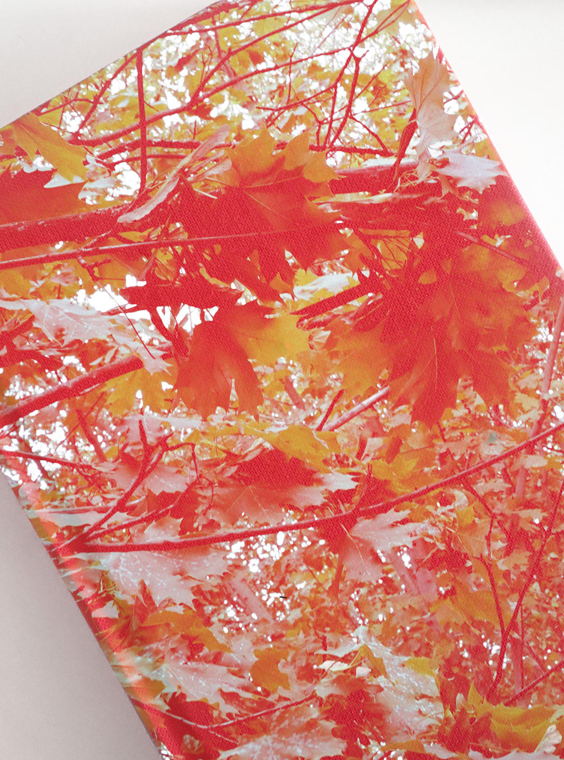
ICH LIEBE DICH! by Nina Schuiki & Leon Eixenberger
ICH LIEBE DICH!Nina Schuiki &Leon Eixenberger
The title is based upon a chance occurrence; these are the same three words which Miss Müller shouts towards her husband while saying “Write soon!”, which the author understands as a request for him to start writing his novel as soon as possible. The reader is thus confronted with a work-in-progress. During the journey, the work unfolds and the 66 interludes of the novel represent 66 railway stations.— from the afterword of „Ich liebe Dich! Ein Eisenbahnroman“ by Paul Scheerbart, Berlin 1897The exhibition of Eixenberger & Schuiki echoes the line of vision between the inoperative Siemensbahn and the housing estates by Hans Scharoun, whereby the artists read the axis as a metaphor of transience against Paul Scheerbart’s eponymous railway novel.Opening: Saturday, September 7th 2019, 6pm Exhibition: September 7th until October 27th 2019At “Tag des Offenen Denkmals” (Day of the Open Monument)September 7th + 8th 2019 open from 11.00 – 18.00 hOpening hours by appointment:info@scharaun.de or 0162-8289 332Scharaun | Jungfernheideweg 4 | 13629 Berlin-Siemensstadt U-Bhf Siemensdammhttp://www.scharaun.de/
ICH LIEBE DICH!Nina Schuiki &Leon Eixenberger
“Der Titelwahl liegt eine zufällige Begebenheit zugrunde: Es sind die gleichen drei Worte, die die Frau Müllers ihrem Mann beim Abschied, zusammen mit einem »Schreib’ bald!« zuruft, was der Erzähler als Aufforderung nimmt, den Roman bald zu schreiben. Dem Leser wird regelrecht ein work-in-progress vorgeführt, bei dem während der Fahrt das Werk entsteht und die 66 Intermezzos im Roman 66 Eisenbahnstationen gleichkommen.“Paul Scheerbart, Ich liebe Dich!, Ein Eisenbahnroman, Berlin 1897 Für die Ausstellung interpretieren Schuiki & Eixenberger die Blickachse zwischen stillgelegter Siemensbahn und der Siedlungsarchitektur Hans Scharouns und lesen diese als Vergänglichkeitsmetapher gegen Paul Scheerbarts epochalem Eisenbahnroman gleichen Titels. Eröffnung: Samstag, 7. September 2019, 18 UhrAusstellung: 7. September bis 27. Oktober 2019 Am Tag des Offenen Denkmals, 7. + 8. September 2019geöffnet von 11.00 – 18.00 UhrÖffnungszeiten nach Vereinbarung:info@scharaun.de oder 0162-8289 332 Scharaun | Jungfernheideweg 4 | 13629 Berlin-Siemensstadt
U-Bhf Siemensdamm http://www.scharaun.de/

Baghdad Walk I
Group exhibition in public space
Baghdad Walk is a group exhibition by emerging Iraqi artists presented in the public space and in different locations in Karada, Baghdad. The walk starts at Iraqi Independent Film Centre, leads along Al Rasheed Street to Midan Square, connects Tayeran Square, Tahrir Square and Kahramana Square, spreads along the Abu Nawas riverside and meanders through Karada neighborhood, featuring time-based works and interventions. It is an exhibition and a narrative tour of the city. The participating artists connect their works with the specific locations, introducing background information on site. Manifold stories about the city of Baghdad are told and retold anew through the artists’ perspectives and the encounters they create.
Please find further information here and find the project’s bilingual (English-Arabic) website here.
—
Baghdad Walk is the result of a workshop series Arts Seminar in Baghdad, conceived and organised by the Goethe-Institut Irak, in collaboration with the Institut für Raumexperimente (Institut for Spatial Experiments), Berlin and hosted by TARKIB Baghdad Contemporary Arts Institute in BAIT TARKIB. Hosted by TARKIB Baghdad Contemporary Arts Institute. Choreographed by Hella Mewis and Christina Werner.
Group exhibition in public space
Baghdad Walk is a group exhibition by emerging Iraqi artists presented in the public space and in different locations in Karada, Baghdad. The walk starts at Iraqi Independent Film Centre, leads along Al Rasheed Street to Midan Square, connects Tayeran Square, Tahrir Square and Kahramana Square, spreads along the Abu Nawas riverside and meanders through Karada neighborhood, featuring time-based works and interventions. It is an exhibition and a narrative tour of the city. The participating artists connect their works with the specific locations, introducing background information on site. Manifold stories about the city of Baghdad are told and retold anew through the artists’ perspectives and the encounters they create.
Please find further information here and find the project’s bilingual (English-Arabic) website here.
—
Baghdad Walk is the result of a workshop series Arts Seminar in Baghdad, conceived and organised by the Goethe-Institut Irak, in collaboration with the Institut für Raumexperimente (Institut for Spatial Experiments), Berlin and hosted by TARKIB Baghdad Contemporary Arts Institute in BAIT TARKIB. Hosted by TARKIB Baghdad Contemporary Arts Institute. Choreographed by Hella Mewis and Christina Werner.

NOWs: IT’S A GREAT PRESSURE TO BE HERE by Raul Walch
Book Release
22 August 2019, 6 pm
book launch, artist talk,
drinks, snacks, and a brand-new edition
Eigen+Art Lab
Torstraße 220
10115 Berlin
Raul Walch is a sculptor and conceptual artist. Yet, in his site-specific interventions, he turns into a critical investigator, performer, and activist as well.
Aside from being a concise survey of his artistic practice, his new artist book IT’S A GREAT PRESSURE TO BE HERE, is a both wry and agitating comment on the globalized present, the human condition, and urgent contemporary societal issues.
A topical glossary of inspirations, ideas, people, and places, several scholarly essays, and an interview convey how artistic engagement can become instrumental in the examination and possible transformation of the given socio-political realities.
And in accordance with Raul Walch‘s multifaceted practice, the book itself has been designed with manifold perspectives and several, unusual ways to read it …
Raul Walch
IT’S A GREAT PRESSURE TO BE HERE
Hardcover, 27,5 × 20,5 cm
240 pp., num. col. ills.
Edited by Lukas Feireiss
Texts by Lukas Feireiss, Francesca Gavin, Fiona Shipwright
Designed by Korbinian Kainz / Basic09
English
Kerber
Bielefeld · Berlin 2019
ISBN 978-3-7356-0610-5
Book Release
22 August 2019, 6 pm
book launch, artist talk,
drinks, snacks, and a brand-new edition
Eigen+Art Lab
Torstraße 220
10115 Berlin
Raul Walch is a sculptor and conceptual artist. Yet, in his site-specific interventions, he turns into a critical investigator, performer, and activist as well.
Aside from being a concise survey of his artistic practice, his new artist book IT’S A GREAT PRESSURE TO BE HERE, is a both wry and agitating comment on the globalized present, the human condition, and urgent contemporary societal issues.
A topical glossary of inspirations, ideas, people, and places, several scholarly essays, and an interview convey how artistic engagement can become instrumental in the examination and possible transformation of the given socio-political realities.
And in accordance with Raul Walch‘s multifaceted practice, the book itself has been designed with manifold perspectives and several, unusual ways to read it …
Raul Walch
IT’S A GREAT PRESSURE TO BE HERE
Hardcover, 27,5 × 20,5 cm
240 pp., num. col. ills.
Edited by Lukas Feireiss
Texts by Lukas Feireiss, Francesca Gavin, Fiona Shipwright
Designed by Korbinian Kainz / Basic09
English
Kerber
Bielefeld · Berlin 2019
ISBN 978-3-7356-0610-5
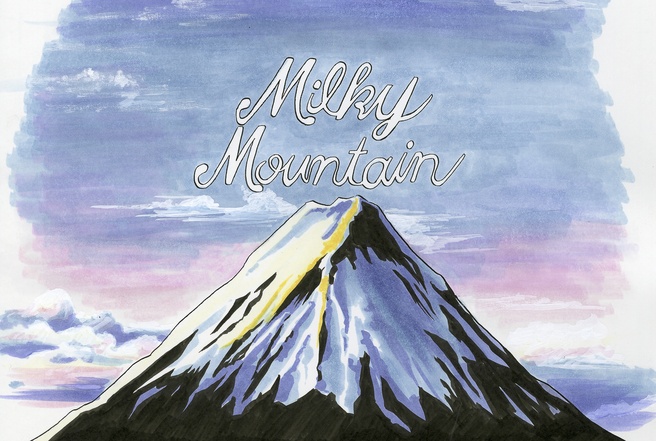
NOWs: Milky Mountain / 裏返りの山 by Yuichiro Tamura
Yuichiro Tamura KAIZO 2019, illustrated by Ryoga Seko. Courtesy the artist and Yuka Tsuruno Gallery, Tokyo
Milky Mountain / 裏返りの山Solo exhibition by Yuichiro Tamura
Govett-Brewster Art Gallery
42 Queen Street
New Plymouth, 4310
Aotearoa New ZealandArtist Talk with Yuichiro Tamura and curator Sarah Wall
11 am — 12 pm
Galleries 2-4
Milky Mountain / 裏返りの山 is the resulting work from Tamura’s time spent in New Plymouth, Aotearoa New Zealand as the 2018 Govett-Brewster Art Gallery International Artist in Residence.
Yuichiro Tamura’s new exhibition Milky Mountain / 裏返りの山 forges unexpected ties between New Plymouth, Aotearoa New Zealand, Mishima and Japan.
Curated by Sarah Wall
The work of Japanese artist Yuichiro Tamura is marked by his extensive ‘search’ into the histories and contexts of specific sites and places in which it is presented. Working in a variety of media, such as video, installation, photography and performance, Tamura builds new narratives out of seemingly unconnected fragments.
Tamura’s exhibition Milky Mountain / 裏返りの山, departs from a number of events that will be well known to the people of New Plymouth. Among them is the filming of The Last Samurai, a momentous occasion which saw Hollywood descend on the region over the summer of 2003. A second is the metamorphosis of a picture theatre into the Govett-Brewster Art Gallery. Fascination for the film and what’s fondly remembered as the ‘Samurai Summer’, along with the history of the former ‘bug house’, continues to endure amongst local residents to this day.
Presented across four galleries of the Govett-Brewster, Milky Mountain will include videos, archival materials, architectural excavation, original artwork from a comic book commissioned by Tamura for the exhibition, and artworks by Billy Apple from the Govett-Brewster Art Gallery Collection.
Join Govett-Brewster International Artist in Residence Yuichiro Tamura and curator Sarah Wall for a walk and talk through Tamura’s new exhibition Milky Mountain | 裏返りの山, followed by a film screening and discussion.
Yuichiro Tamura KAIZO 2019, illustrated by Ryoga Seko. Courtesy the artist and Yuka Tsuruno Gallery, Tokyo
Milky Mountain / 裏返りの山Solo exhibition by Yuichiro Tamura
Govett-Brewster Art Gallery
42 Queen Street
New Plymouth, 4310
Aotearoa New ZealandArtist Talk with Yuichiro Tamura and curator Sarah Wall
11 am — 12 pm
Galleries 2-4
Milky Mountain / 裏返りの山 is the resulting work from Tamura’s time spent in New Plymouth, Aotearoa New Zealand as the 2018 Govett-Brewster Art Gallery International Artist in Residence.
Yuichiro Tamura’s new exhibition Milky Mountain / 裏返りの山 forges unexpected ties between New Plymouth, Aotearoa New Zealand, Mishima and Japan.
Curated by Sarah Wall
The work of Japanese artist Yuichiro Tamura is marked by his extensive ‘search’ into the histories and contexts of specific sites and places in which it is presented. Working in a variety of media, such as video, installation, photography and performance, Tamura builds new narratives out of seemingly unconnected fragments.
Tamura’s exhibition Milky Mountain / 裏返りの山, departs from a number of events that will be well known to the people of New Plymouth. Among them is the filming of The Last Samurai, a momentous occasion which saw Hollywood descend on the region over the summer of 2003. A second is the metamorphosis of a picture theatre into the Govett-Brewster Art Gallery. Fascination for the film and what’s fondly remembered as the ‘Samurai Summer’, along with the history of the former ‘bug house’, continues to endure amongst local residents to this day.
Presented across four galleries of the Govett-Brewster, Milky Mountain will include videos, archival materials, architectural excavation, original artwork from a comic book commissioned by Tamura for the exhibition, and artworks by Billy Apple from the Govett-Brewster Art Gallery Collection.
Join Govett-Brewster International Artist in Residence Yuichiro Tamura and curator Sarah Wall for a walk and talk through Tamura’s new exhibition Milky Mountain | 裏返りの山, followed by a film screening and discussion.

Kick-Off Workshop – Day 3
Kick-Off Workshop in Baghdad with Christina Werner
Sound mapping exercises around the Freedom Monument at Tahrir Square
Sound mapping exercises
Sound mapping exercises
Sound mapping exercises
Sound map
Sound map
Sound experiments at Tahrir Square park
Sound experiments and discussion
–
This event is part of a workshop series Arts Seminar in Baghdad, conceived and organised by the Goethe-Institut Irak, in collaboration with the Institut für Raumexperimente (Institut for Spatial Experiments), Berlin and hosted by TARKIB Baghdad Contemporary Arts Institute in BAIT TARKIB.
Kick-Off Workshop in Baghdad with Christina Werner
Sound mapping exercises around the Freedom Monument at Tahrir Square
Sound mapping exercises
Sound mapping exercises
Sound mapping exercises
Sound map
Sound map
Sound experiments at Tahrir Square park
Sound experiments and discussion
–
This event is part of a workshop series Arts Seminar in Baghdad, conceived and organised by the Goethe-Institut Irak, in collaboration with the Institut für Raumexperimente (Institut for Spatial Experiments), Berlin and hosted by TARKIB Baghdad Contemporary Arts Institute in BAIT TARKIB.
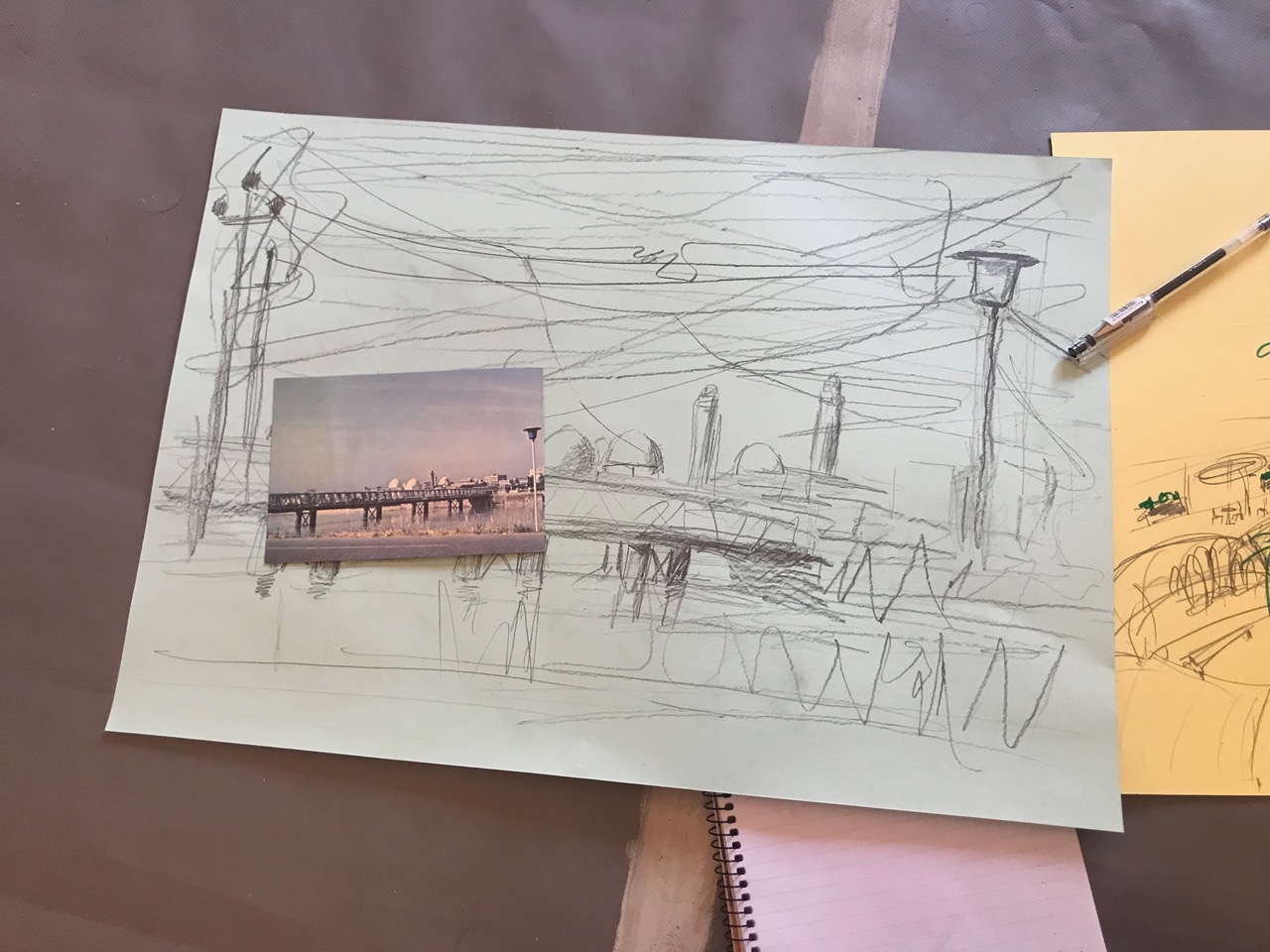
Kick-Off Workshop – Day 2
Kick-Off Workshop in Baghdad with Christina Werner
Workshop excerises with Christina Werner
Urban memories and future visions of Baghdad
Presentation of first ideas for Baghdad Walk
–
This event is part of a workshop series Arts Seminar in Baghdad, conceived and organised by the Goethe-Institut Irak, in collaboration with the Institut für Raumexperimente (Institut for Spatial Experiments), Berlin and hosted by TARKIB Baghdad Contemporary Arts Institute in BAIT TARKIB.
Kick-Off Workshop in Baghdad with Christina Werner
Workshop excerises with Christina Werner
Urban memories and future visions of Baghdad
Presentation of first ideas for Baghdad Walk
–
This event is part of a workshop series Arts Seminar in Baghdad, conceived and organised by the Goethe-Institut Irak, in collaboration with the Institut für Raumexperimente (Institut for Spatial Experiments), Berlin and hosted by TARKIB Baghdad Contemporary Arts Institute in BAIT TARKIB.
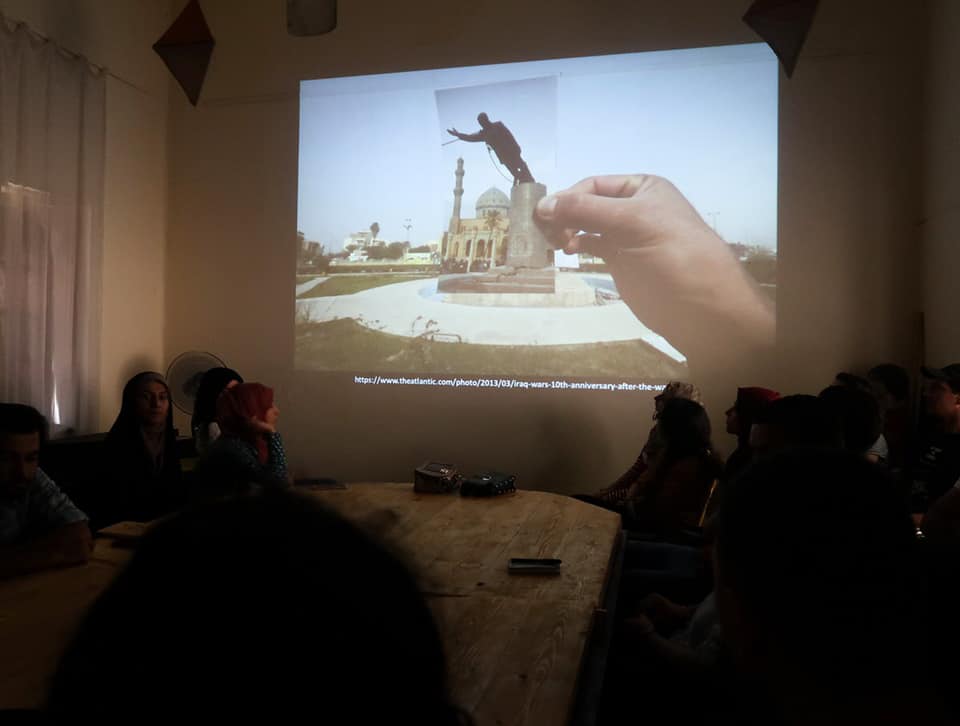
Kick-Off Workshop – Day 1
Kick-Off Workshop in Baghdad with Christina Werner
Presentation and discussion with Christina Werner
Workshop excerises with Christina Werner
Memories revisited; postcards from Baghdad
–
This event is part of a workshop series Arts Seminar in Baghdad, conceived and organised by the Goethe-Institut Irak, in collaboration with the Institut für Raumexperimente (Institut for Spatial Experiments), Berlin and hosted by TARKIB Baghdad Contemporary Arts Institute in BAIT TARKIB.
Kick-Off Workshop in Baghdad with Christina Werner
Presentation and discussion with Christina Werner
Workshop excerises with Christina Werner
Memories revisited; postcards from Baghdad
–
This event is part of a workshop series Arts Seminar in Baghdad, conceived and organised by the Goethe-Institut Irak, in collaboration with the Institut für Raumexperimente (Institut for Spatial Experiments), Berlin and hosted by TARKIB Baghdad Contemporary Arts Institute in BAIT TARKIB.
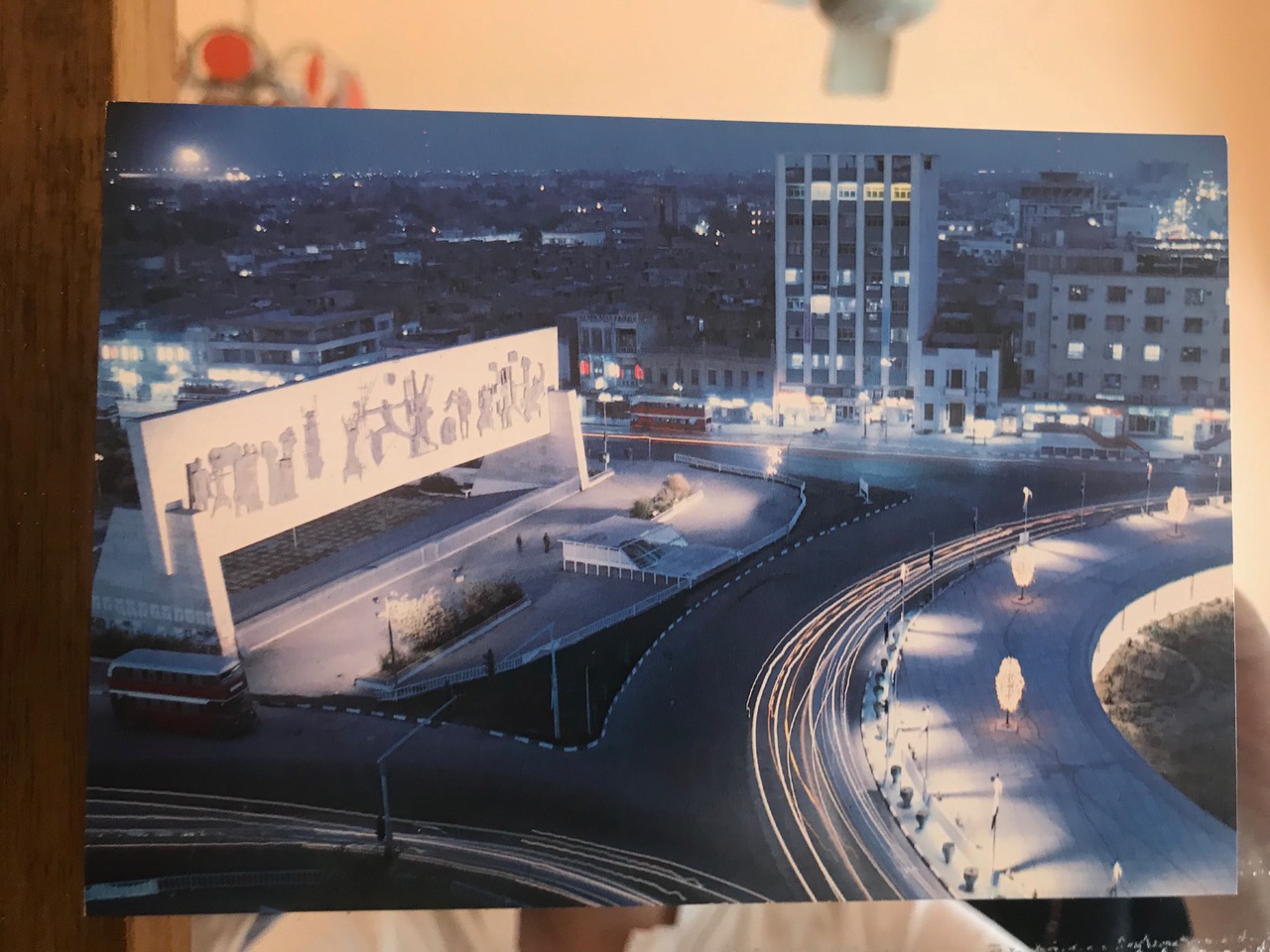
Arts Seminar in Baghdad, 2019
Memories revisited; postcard from Baghdad
Arts Seminar in Baghdad - Workshop SeriesCultures of Memory
Arts Seminar in Baghdad is a workshop series that prepares the participants to engage with their art works and interventions in the urban space of Baghdad. The seminar starts with a kick-off session – an intense 3-day workshop at TARKIB Baghdad Contemporary Arts Institute –, followed by regular skype sessions and will result in an exhibition, that is also a guided tour of the city, titled Baghdad Walk.
The seminar examines questions on memory cultures. It explores how memory understood as both a psychological and a social–cultural process can find its forms in the immaterial and material realm. Memory is deeply entwined with social relationships, with stories orally transmitted, as well as passed on in film, social media or literature, it leaves traces in form of buildings and monuments, ritual practices or commemorations, material artifacts or other cultural devices.
The exhibition Baghdad Walk will present site-specific interventions that address the paradigmatic shifts that the city of Baghdad has witnessed; historical, ideological, sociopolitical, and symbolic turns of events seen through the lense of the personal. The artists zoom in and out, finding microscopic details or distant perspectives, always looking for locations that are part of the collective memory or part of a personal trajectory within the larger frame of society’s past. The question is not whether to be part of the city’s history but how and on what terms. And what should change and what shouldn’t?
Baghdad Walk takes the Iraqi capital as a case study, addressing the memories embedded in the texture of urban life, from personal events and stories, to architectural heritage and public monuments, the urban web is saturated with memories to be re-visited and revealed.
Participants: Zainab Abbas | Ban Ahmed | Tabark Al Atrakchi | Hiba A. AL Azzawi | Maryam Mary | Aisha Saad | Amna Rafaa | Raneen Sami | Loay Al Hadhary | Nawful Hussein | Atef Al Jaffal | Faruq Al Jamal | Ahmed Al Majid | Husam Mohammed | Muhaned Mohammed | Sajjad Mohammed | Ameen Mokdad | Hussain Muttar | Mohammed Ridha | Zaid Saad | Muhaned Taha | Hadjer Qussay | Fatima Raad
—
This event is part of a workshop series Arts Seminar in Baghdad, conceived and organised by the Goethe-Institut Irak, in collaboration with the Institut für Raumexperimente (Institut for Spatial Experiments), Berlin and hosted by TARKIB Baghdad Contemporary Arts Institute in BAIT TARKIB. The series is choreographed by Christina Werner and realized with support by Hella Mewis.
Memories revisited; postcard from Baghdad
Arts Seminar in Baghdad - Workshop SeriesCultures of Memory
Arts Seminar in Baghdad is a workshop series that prepares the participants to engage with their art works and interventions in the urban space of Baghdad. The seminar starts with a kick-off session – an intense 3-day workshop at TARKIB Baghdad Contemporary Arts Institute –, followed by regular skype sessions and will result in an exhibition, that is also a guided tour of the city, titled Baghdad Walk.
The seminar examines questions on memory cultures. It explores how memory understood as both a psychological and a social–cultural process can find its forms in the immaterial and material realm. Memory is deeply entwined with social relationships, with stories orally transmitted, as well as passed on in film, social media or literature, it leaves traces in form of buildings and monuments, ritual practices or commemorations, material artifacts or other cultural devices.
The exhibition Baghdad Walk will present site-specific interventions that address the paradigmatic shifts that the city of Baghdad has witnessed; historical, ideological, sociopolitical, and symbolic turns of events seen through the lense of the personal. The artists zoom in and out, finding microscopic details or distant perspectives, always looking for locations that are part of the collective memory or part of a personal trajectory within the larger frame of society’s past. The question is not whether to be part of the city’s history but how and on what terms. And what should change and what shouldn’t?
Baghdad Walk takes the Iraqi capital as a case study, addressing the memories embedded in the texture of urban life, from personal events and stories, to architectural heritage and public monuments, the urban web is saturated with memories to be re-visited and revealed.
Participants: Zainab Abbas | Ban Ahmed | Tabark Al Atrakchi | Hiba A. AL Azzawi | Maryam Mary | Aisha Saad | Amna Rafaa | Raneen Sami | Loay Al Hadhary | Nawful Hussein | Atef Al Jaffal | Faruq Al Jamal | Ahmed Al Majid | Husam Mohammed | Muhaned Mohammed | Sajjad Mohammed | Ameen Mokdad | Hussain Muttar | Mohammed Ridha | Zaid Saad | Muhaned Taha | Hadjer Qussay | Fatima Raad
—
This event is part of a workshop series Arts Seminar in Baghdad, conceived and organised by the Goethe-Institut Irak, in collaboration with the Institut für Raumexperimente (Institut for Spatial Experiments), Berlin and hosted by TARKIB Baghdad Contemporary Arts Institute in BAIT TARKIB. The series is choreographed by Christina Werner and realized with support by Hella Mewis.
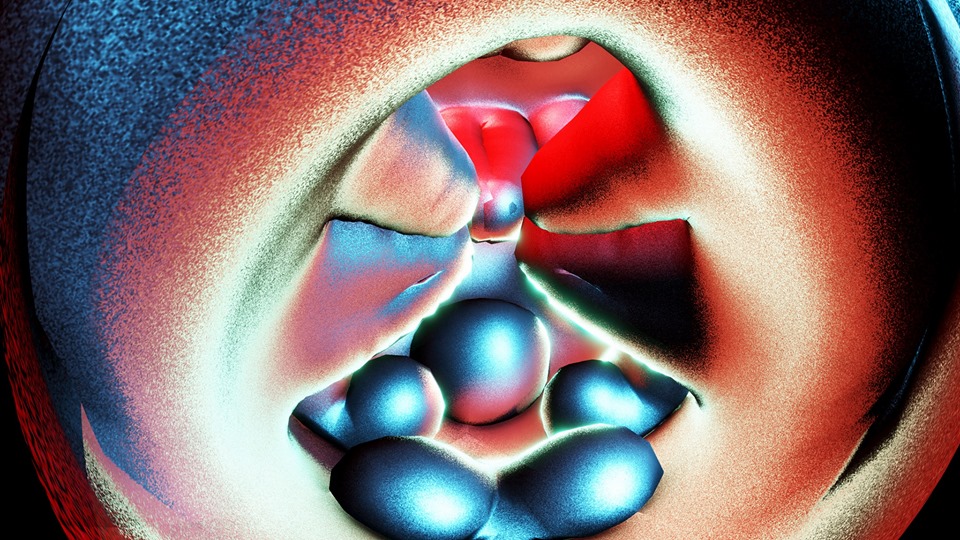
NOWs: The New Infinity – Non-face
The New Infinity: Non-faceArtist Talk with Robert Lippok, Lucas Gutierrez & Natalie Koerner
17 September, 2019
8 pm – 9:30 pm
Mobile Dome on Mariannenplatz
10997 Berlin
The New Infinity: Artist talk with Robert Lippok and Lucas Gutierres, moderated by Natalie Körner
Non-manifold geometries describe ‘fake-objects’ – items that may look realistic, but can in fact not exist in the physical world. They develop their sensual plausibility in the digital world. One famous example is the Penrose-triangle: Its three beams appear to be positioned at right angles to each other, and yet they are connected to form a triangle. In 3D-animation, such objects regularly surface through so-called mesh-mistakes. For their first joint Fulldome-piece, sound artist Robert Lippok and digital artist Lucas Gutierrez have identified these frequently occurring mistakes in their own artistic practice and develop data structures to explore these fantastic objects. Their work produces different dimensionalities and creates new topological relations. This might not determine the inside or the outside of these impossible objects, but it will render the sonic and visual boundaries of a three-dimensional space tangible. To this end, the composition uses simulated reflections in physical and virtual spaces. Various methods of traditional instrument building are used to transcribe the virtual geometries into musical patterns which, in turn, weave sequences of notes and real-time emulations of different sound sources into multi-layered textures.
Free admission
The New Infinity: Non-faceArtist Talk with Robert Lippok, Lucas Gutierrez & Natalie Koerner
17. September 2019
20 – 21:30 h
Mobile Dome auf dem Mariannenplatz
10997 Berlin
The New Infinity: Künstlergespräch mit Robert Lippok and Lucas Gutierres, Moderation Natalie Körner
Nicht-mannigfaltige Geometrien beschreiben ‘Fake-Objekte’ – Gegenstände, die zwar realistisch aussehen, aber in der physischen Welt unmöglich existieren können und die in der digitalen Realität ihre sinnliche Plausibilität entfalten. Ein berühmtes Beispiel hierfür ist etwa das Penrose-Dreieck, dessen drei Balken jeweils im rechten Winkel zueinander zu stehen scheinen und dennoch zu einem Dreieck verbunden sind. In der 3D-Animation treten solche Objekte regelmäßig durch sogenannte Mesh-Fehler in Erscheinung. Für ihre erste gemeinsame Fulldome-Arbeit identifizieren der Klangkünstler Robert Lippok und der Digitalkünstler Lucas Gutierrez diese häufig auftretenden Fehler in ihrer eigenen künstlerischen Praxis und entwickeln Datenstrukturen zur Erforschung dieser phantastischen Objekte. Ihre Arbeit erzeugt andersartige Dimensionalitäten und kreiert neue topologische Verbindungen. Ohne das Innere und Äußere dieser unmöglichen Objekte zu bestimmen, macht sie die akustischen und visuellen Grenzen des dreidimensionalen Raums erfahrbar. Dafür verwendet die Komposition simulierte Echos in physischen und virtuellen Räumen. Verschiedene Methoden des traditionellen Instrumentenbaus dienen zur Transkription der virtuellen Geometrien als musikalische Muster, die Notensequenzen und die Echtzeit-Emulationen verschiedener Klangquellen zu vielschichtigen Texturen verweben.
Freier Eintritt

NOWs: The New Infinity – Applied Autonomy
The New Infinity: Applied Autonomyaudiovisual performance by Robert Lippok & Lucas Gutierrez
22 Sep 2019
8 pm
Mobile Dome on Mariannenplatz
10997 Berlin
The artwork Lucas Gutierrez designed for Robert Lippok 2018’s critically acclaimed full-length album Applied Autonomy (Raster Media) was based on a virtual object in motion. A few months later the two developed the video installation My Eyes, My Body based on this object and created an Applied Autonomy audiovisual concert. Lippok’s raw melodic approach and rhythmical abstraction build a unique force in connection with Gutierrez abstract quotes from 3D modeling for industrial design and the language of colorful, chaotic metaphysics. For the very first time Lucas Gutierrez and Robert Lippok will perform the full-dome audiovisual version of Applied Autonomy at The New Infinity.
Free admission. More information & ticket raffle coming soon.
The New Infinity: Applied Autonomyaudiovisuelle Performance von Robert Lippok & Lucas Gutierrez
22. Sep 2019
20 h
Mobile Dome auf dem Mariannenplatz
10997 Berlin
Für Robert Lippoks vielbeachtetes Soloalbum Applied Autonomy (Raster) von 2018 schuf Lucas Gutierrez ein Bild auf Basis eines virtuellen Objektes in Bewegung. Einige Monate danach erarbeiteten die beiden ausgehend von diesem Objekt ihre Videoinstallation My Eyes, My Body und eine Ton-Bild-Konzertfassung von Applied Autonomy. Lippoks ungekünstelt melodischer Ansatz und seine rhythmische Abstraktion entfalten ihre einzigartige Kraft in Verbindung mit Gutierrez‘ abstrakten Zitaten aus der 3D-Modellierung im Industriedesign und aus der Bildsprache der bunten Metaphysik des Chaos. Die audiovisuelle Fassung von Applied Autonomy für Fulldome werden Lucas Gutierrez und Robert Lippok zum ersten Mal bei The New Infinity aufführen.
Eintritt frei! Weitere Infos & Ticketverlosung in Kürze.

Poetry Jazz: Wax and Gold Workshop, Berlin
Poetry Jazz: Wax and Gold. Workshop
Akademie der Künste
Hanseatenweg 10, Berlin
Participating artists: Frezer Admasu, Eric Ellingsen, Mihret Kebede, Robert Lippok, Nebiy Mekonnen, Jorga Mesfin, Tasew Wendem Mose, Cia Rinne, Rike Scheffler, Misrak Terefe
Workshop and rehearsal at Akademie der Künste, Berlin
This project series by the Institut für Raumexperimente (Institute for Spatial Experiments) and Tobiya Poetic Jazz fuses contemporary expressive poetry styles in Amharic, German and English, and combines them with traditional Ethiopian music, jazz influences and electronic music. Continual shifts in languages, metres and rhythms create awareness of the subtle divergences of meaning that can be attributed to social and cultural influences. It is an experimental get-together of poets, musicians and translators, joining in an exercise of styles.
–
The workshop is part of the poetry series “Poetry Jazz: Wax and Honey, I’m Home” by the Institut für Raumexperimente, Berlin; in cooperation with the Akademie der Künste, Berlin; in dialogue with Tobiya Poetic Jazz, Addis Ababa; choreographed by Christina Werner; supported by the Studio Olafur Eliasson, Berlin; Graham Foundation for Advanced Studies in the Fine Arts, Chicago; Co-financing Fund of the Senate Department for Culture and Europe, Berlin
Funded by the TURN Fund of the German Federal Cultural Foundation.
Rehearsal at Akademie der Künste, Berlin
Poetry Jazz: Wax and Gold. Workshop
Akademie der Künste
Hanseatenweg 10, Berlin
Participating artists: Frezer Admasu, Eric Ellingsen, Mihret Kebede, Robert Lippok, Nebiy Mekonnen, Jorga Mesfin, Tasew Wendem Mose, Cia Rinne, Rike Scheffler, Misrak Terefe
Workshop and rehearsal at Akademie der Künste, Berlin
This project series by the Institut für Raumexperimente (Institute for Spatial Experiments) and Tobiya Poetic Jazz fuses contemporary expressive poetry styles in Amharic, German and English, and combines them with traditional Ethiopian music, jazz influences and electronic music. Continual shifts in languages, metres and rhythms create awareness of the subtle divergences of meaning that can be attributed to social and cultural influences. It is an experimental get-together of poets, musicians and translators, joining in an exercise of styles.
–
The workshop is part of the poetry series “Poetry Jazz: Wax and Honey, I’m Home” by the Institut für Raumexperimente, Berlin; in cooperation with the Akademie der Künste, Berlin; in dialogue with Tobiya Poetic Jazz, Addis Ababa; choreographed by Christina Werner; supported by the Studio Olafur Eliasson, Berlin; Graham Foundation for Advanced Studies in the Fine Arts, Chicago; Co-financing Fund of the Senate Department for Culture and Europe, Berlin
Funded by the TURN Fund of the German Federal Cultural Foundation.
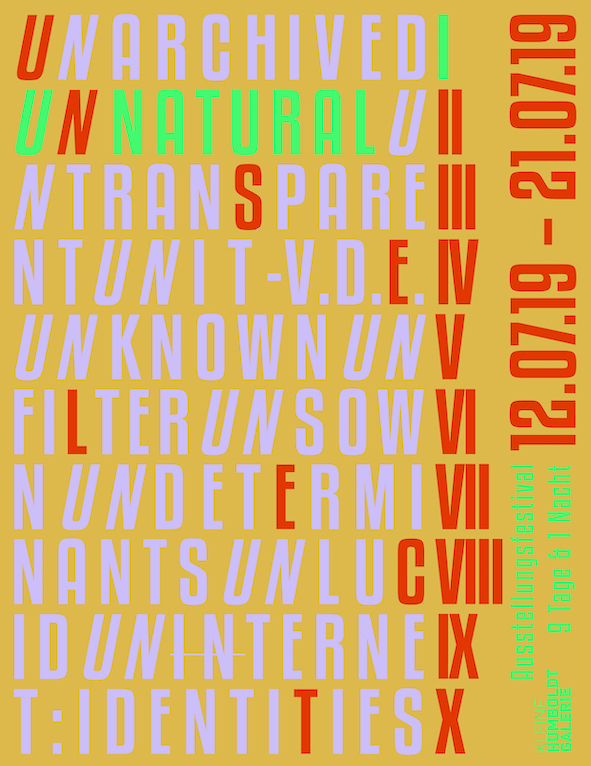
NOWs: UNnatural
graphic design © Charlotte Hansel: & color design © Susi Hinz unnatural
unnaturalgroup show with Mark Dion, Duy Hoàng, Saskia Krafft, Silvia Noronha, Nina Schuiki, Markus Wirthmann; curated by Julia Modes
Kleine Humboldt Galerie
Lichthof Ost
Unter den Linden 6
10117 Berlin
Opening
12 July, 6.30 to 9 pm
Programme
keynote lecture: July 12, 5.15 to 6.30 pm
Prof. Dr. Philipp Sarasin: Darwins natural selection
Lecture: August 7, 6.15 to 8 pm
Prof. Dr. Anke te Heesen: Kastenräume. Zur Geschichte eingefriedeter Pflanzen
unnatural is dedicated to the dichotomy of humans and nature, by exploring the human fascination with, as well as our influence on natural cycles and the consequences of this activity in the age of the Anthropocene.
The biologist Charles Darwin defined natural selection as the principle of survival and reproduction of any variation that provided advantageous, no matter how small. His evolutionary theory plainly explained the mechanisms of species’ variation in the plant and animal kingdoms. Humans were no longer the pride of creation but rather part of a protracted process in which they prevailed over other species.
However, within their culturally created social structures, humans are subjected to very different, everyday mechanisms of selection – and further, they themselves do the selecting. When humans attempt to comprehend the forces of nature, acquire them, and utilize them for their own needs, they make decisions based on their own value systems, which affect nature in turn. In this manner, human activity has become a crucial factor within the evolutionary process. Can the conscious selection by humans still be regarded as natural or does it have to be understood as unnatural?
The exhibition unnatural is dedicated to this dichotomy of humans and nature. Six contemporary artists will explore the human fascination with, as well as our influence on, natural cycles and the consequences of this activity in the age of the Anthropocene. Their works will discuss natural catastrophes caused by human action, attempts to imitate natural processes, and the practice of collecting organic materials in order to instigate a discourse on natural and unnatural selection mechanisms.
Celebrating the 10th anniversary of Kleine Humboldt Galerie’s curatorial practice at Lichthof Ost, the show will be on view until August 9!
Künstler*innen/ artists
Duy Hoàng (New York)
Saskia Krafft (New York)
Nina Schuiki (Berlin)
Silvia Noronha (Berlin)
Markus Wirthmann (Berlin)
Mark Dion (New York)
Kuratorin/ curator: Julia Modes
Kuratorische Assistenz / assistant: Lotte Wilhelm
graphic design © Charlotte Hansel: & color design © Susi Hinz unnatural
unnaturalGruppenausstellung mit Mark Dion, Duy Hoàng, Saskia Krafft, Silvia Noronha, Nina Schuiki, Markus Wirthmann; kuratiert von Julia Modes
Kleine Humboldt Galerie
Lichthof Ost
Unter den Linden 6
10117 Berlin
Eröffnung
12 July, 6.30 to 9 pm
Programm
Keynote Lecture: 12. Juli, 17:15 to 18.30 h
Prof. Dr. Philipp Sarasin: Darwins natural selection
Lecture: 7. August , 18.15 bis 20:00 h
Prof. Dr. Anke te Heesen: Kastenräume. Zur Geschichte eingefriedeter Pflanzen
unnatural widmet sich der Dichotomie von Mensch und Natur, indem die Ausstellung die menschliche Faszination für, wie auch seinen Einfluss auf natürliche Kreisläufe und deren Folgen im Zeitalter des Anthroprozäns thematisiert.
Der Naturforscher Charles Darwin definierte die natürliche Selektionals Prinzip der Erhaltung jeder kleinsten, sofern nützlichen Variation. Seine Evolutionstheorie erklärt auf einfache Weise den Mechanismus der Artenvariation im Pflanzen- und Tierreich, der den Menschen nicht als “Krone der Schöpfung”, sondern als Teil eines natürlichen Ausleseverfahrens beschreibt.
Doch der Mensch unterliegt in dem von ihm eigens hervorgebrachten sozialen Gefüge heute ganz anderen, alltäglichen Selektionsmechanismen – und mehr noch: er selbst selektiert. Während der Mensch zwar die Gesetze der Natur seit jeher zu durchdringen versucht, sie sich aneignet und für seine eigenen Zwecke nutzt, trifft er Entscheidungen auf der Grundlage eines eigens erfundenen Wertesystems, denen sich seine Umwelt beugen muss. So wurde er zu einem entscheidenden Selektionsfaktor der natürlichen Auslese. Kann jedoch das bewusste Selektieren des Menschen noch als ein natürliches oder muss es als ein unnatürliches verstanden werden?
Im Rahmen des Festivals unselect greifen in der Ausstellung unnatural Sechs Künstler*innen durch ihre Arbeiten die vom Menschen verursachten Naturkatastrophen, den Versuch, Prozesse der Natur nachzuahmen und das Prinzip des Sammelns organischer Materialien auf, um zum Nachdenken und Diskutieren über natürliche, wie unnatürliche Selektionsmechanismen anzuregen.
Die Ausstellung wird anlässlich der zehnjährigen Ausstellungspraxis der Kleinen Humboldt Galerie im Lichthof Ost bis zum 09. August zu sehen sein!
Künstler*innen/ artists
Duy Hoàng (New York)
Saskia Krafft (New York)
Nina Schuiki (Berlin)
Silvia Noronha (Berlin)
Markus Wirthmann (Berlin)
Mark Dion (New York)
Kuratorin/ curator: Julia Modes
Kuratorische Assistenz / assistant: Lotte Wilhelm
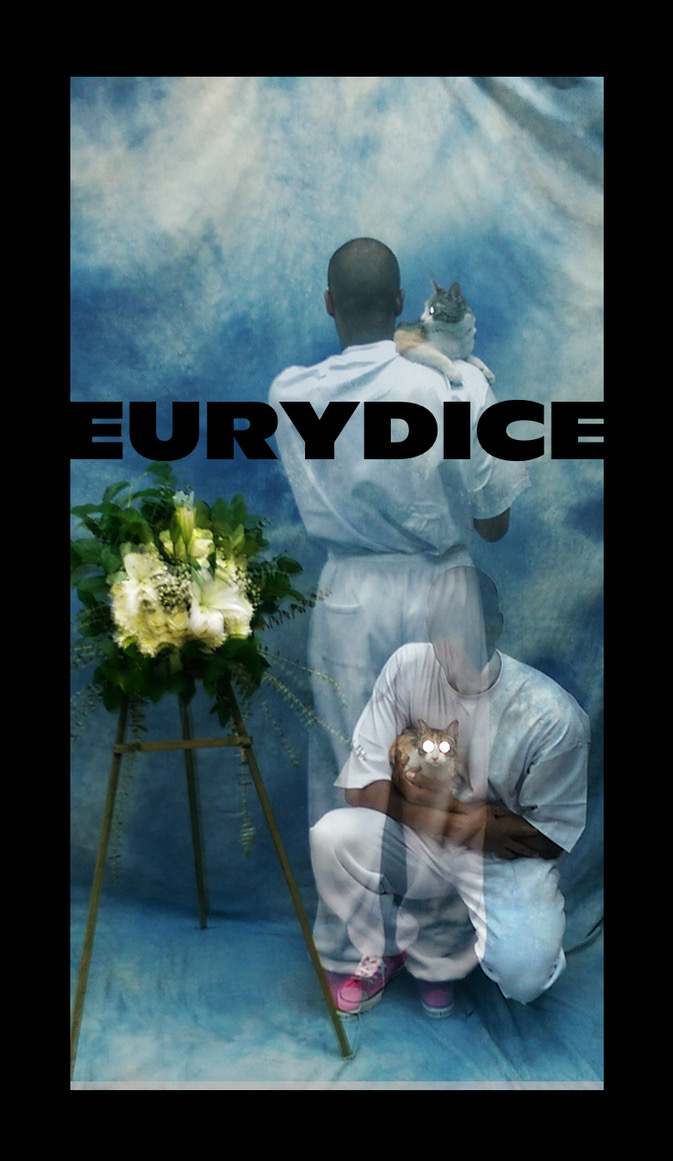
NOWs: Eurydice, Orpheus, And The Maenads
Eurydice, Orpheus, And The Maenadsperformance by Kandis Williams in dialog with Bracha L. Ettinger
13 July, 8 pm
Perfromance starts at 9pm
Spittelkolonnaden
Leipzigerstr. 49
10117 Berlin
Williams’ ongoing Eurydice project confronts the crisis of metaphorical entanglements around the aesthetic and political intersections of loss and inspiration, the ‘coming into being of artistic gestures’, echo, form, and mimesis as instances of the formal gathering of significant agential loss for the black subject. This full performance, stemming from a series of videos, collages, sculptures, and floral arrangements, makes porous the relationship between “black identity” and “mainstream culture.” The Greek myth of Eurydice is a vehicle for Williams’ inquiry into the subjects of a racialized imagination and its subsequent logics, by staging a structured engagement of blackness and spectacle within a mythic pre-Socratic configuration of the underworld. This installment will follow Orpheus from his loss of Eurydice into the hands of the Maenads.
The performance is developed in dialog with Bracha L. Ettinger, features movement by Josh Johnson and music by Patrick Belaga.
About FRAGILE
FRAGILE fosters a program of conversation, antagonism, renegotiation, and celebration.
FRAGILE is a non-profit project for contemporary artistic practices located in Berlin. It encompasses an exhibition and a residency space.
FRAGILE is guided by curations etymology, the practice of caring and was founded on the warmest summerday of 2018 by Maurin Dietrich and Jonas Wendelin.
Eurydice, Orpheus, And The Maenadsperformance by Kandis Williams in dialog with Bracha L. Ettinger
13 July, 8 pm
Perfromance starts at 9pm
Spittelkolonnaden
Leipzigerstr. 49
10117 Berlin
Williams’ ongoing Eurydice project confronts the crisis of metaphorical entanglements around the aesthetic and political intersections of loss and inspiration, the ‘coming into being of artistic gestures’, echo, form, and mimesis as instances of the formal gathering of significant agential loss for the black subject. This full performance, stemming from a series of videos, collages, sculptures, and floral arrangements, makes porous the relationship between “black identity” and “mainstream culture.” The Greek myth of Eurydice is a vehicle for Williams’ inquiry into the subjects of a racialized imagination and its subsequent logics, by staging a structured engagement of blackness and spectacle within a mythic pre-Socratic configuration of the underworld. This installment will follow Orpheus from his loss of Eurydice into the hands of the Maenads.
The performance is developed in dialog with Bracha L. Ettinger, features movement by Josh Johnson and music by Patrick Belaga.
About FRAGILE
FRAGILE fosters a program of conversation, antagonism, renegotiation, and celebration.
FRAGILE is a non-profit project for contemporary artistic practices located in Berlin. It encompasses an exhibition and a residency space.
FRAGILE is guided by curations etymology, the practice of caring and was founded on the warmest summerday of 2018 by Maurin Dietrich and Jonas Wendelin.
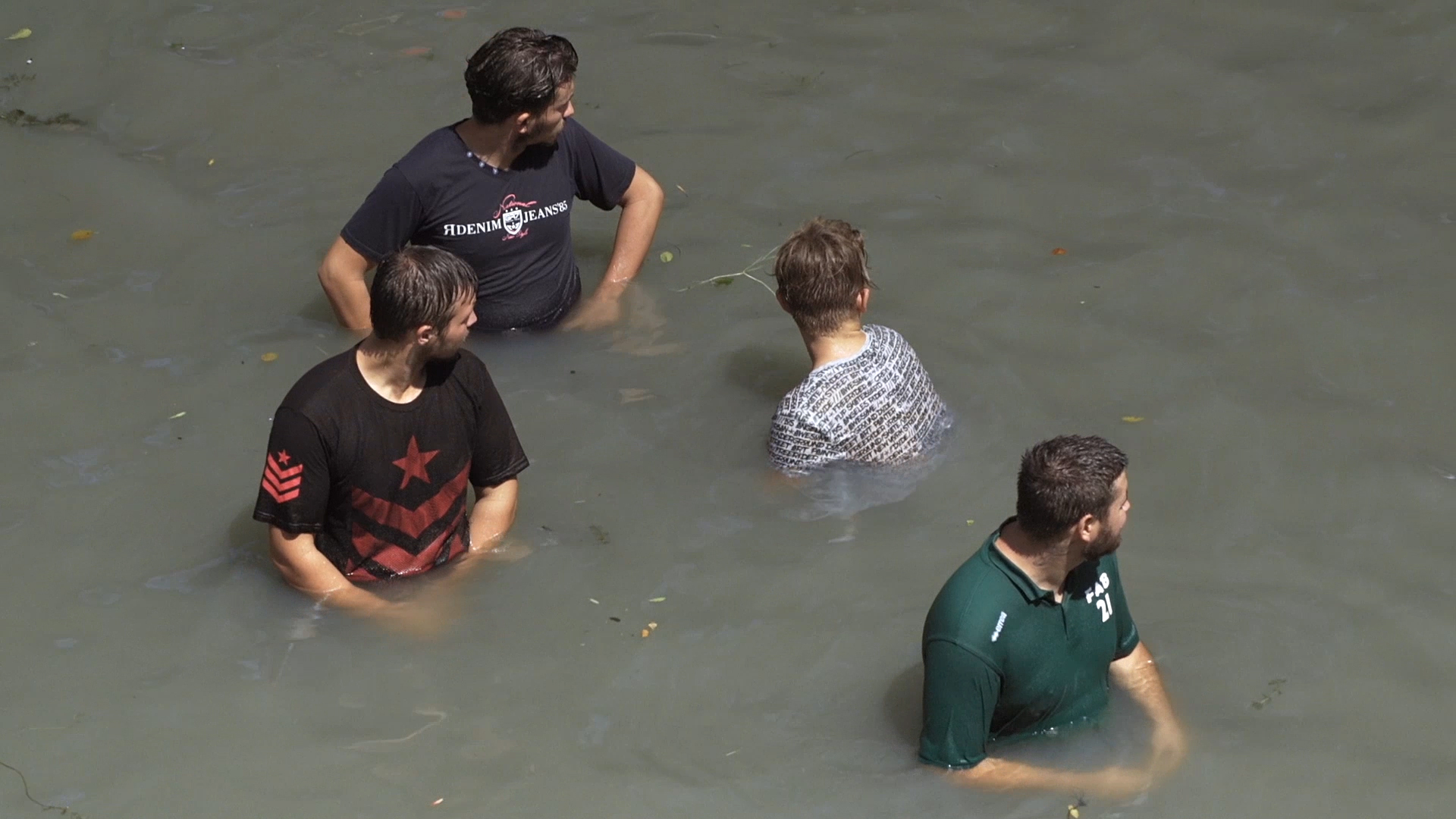
NOWs: Quissac by Yalda Afsah
Quissacsolo exhibition by Yalda Afsah
Still from Yaldah Afsah, Vidourle, 2019
Opening
6 JULY 2019, 5 – 9 pm
FRAGILE
Leipzigerstraße 63
10117 Berlin
FRAGILE is pleased to announce the solo exhibition Quissac by Yalda Afsah.
The exhibition brings together two films that were developed in relation to each other, their location both being a small town in the south of France where the narrative follows a bizarre sequence of bullfights.
The films “Vidourle” and “Tourneur” both portray and fictionalize the setting for expressions of supposed dominance between human and animal, gestures of provoked violence and performed masculinity. Between strategies of construction and reality scenes unfold in which man and animal, rage and performance collapse into one another.
Vidourle, 2019, 10 min
Tourneur, 2018, 14 min
About FRAGILE
FRAGILE fosters a program of conversation, antagonism, renegotiation, and celebration.
FRAGILE is a non-profit project for contemporary artistic practices located in Berlin. It encompasses an exhibition and a residency space.
FRAGILE is guided by curations etymology, the practice of caring and was founded on the warmest summerday of 2018 by Maurin Dietrich and Jonas Wendelin.
Quissacsolo exhibition by Yalda Afsah
Still from Yaldah Afsah, Vidourle, 2019
Opening
6 JULY 2019, 5 – 9 pm
FRAGILE
Leipzigerstraße 63
10117 Berlin
FRAGILE is pleased to announce the solo exhibition Quissac by Yalda Afsah.
The exhibition brings together two films that were developed in relation to each other, their location both being a small town in the south of France where the narrative follows a bizarre sequence of bullfights.
The films “Vidourle” and “Tourneur” both portray and fictionalize the setting for expressions of supposed dominance between human and animal, gestures of provoked violence and performed masculinity. Between strategies of construction and reality scenes unfold in which man and animal, rage and performance collapse into one another.
Vidourle, 2019, 10 min
Tourneur, 2018, 14 min
About FRAGILE
FRAGILE fosters a program of conversation, antagonism, renegotiation, and celebration.
FRAGILE is a non-profit project for contemporary artistic practices located in Berlin. It encompasses an exhibition and a residency space.
FRAGILE is guided by curations etymology, the practice of caring and was founded on the warmest summerday of 2018 by Maurin Dietrich and Jonas Wendelin.

NOWs: 4/10 –A CRITICAL INVENTORY OF THE IKOB COLLECTION
4/10 –A CRITICAL INVENTORY OF THE IKOB COLLECTIONGroup exhibition
Opening: 30 June 2019, 5 pm
IKOB – Museum of Contemporary Art
Rotenberg 12
4700 Eupen
Belgien
With regard to the equal treatment of female and male artists, 2019 is apparently turning out to be a year of reappraisal at several art- and culture-institutions. For example, for twelve months starting this April the Tate Modern in London is exclusively featuring female artists from its own collection. Through a focus on works of art by women, which are exhibited percentage-wise far less frequently than those by men, female artists are to be more strongly represented and their contribution to art history is to be more appropriately acknowledged. There are also projects such as these outside the visual arts. Thus the Karlsruhe State Theatre is hiring only female directors for the 2018/19 season. The IKOB is likewise seeking to make its contribution to an endeavour that is actually long overdue. We engaged in a closer analysis of our collection and investigated the question as to how many works of art came from women and how many from men. It turned out that exactly 40% of the works in the collection were done by women. Four out of ten is not a bad ratio in comparison to other museums, whose percentage seems to be stuck at around 25%. In comparison, between 2009 and 2011 the share of works by female artists purchased by museums in North Rhine-Westphalia was no more than 28%, and only 22% of all solo exhibitions receiving financial support from that German state were by female artists. Why is this low percentage surprising? Because for decades the share of women at German art academies has been constantly over 60%; and with regard to the art prizes awarded by the state, there is at least an even distribution between women and men. But as soon as it is a matter of participation in exhibitions at galleries, museums and art associations, it is striking that women lag behind men with shocking regularity. If one then examines the list of the most commercially successful artists, it becomes evident that the number of top earners who are women continues to be infinitesimally small.
Since a reappraisal can only take place there where people are aware of this differentiation, the exhibition 4/10, A Critical Inventory of the IKOB Collection, constitutes the beginning of an endeavour to do justice to the female artists from our collection with regard to contents, and to support their contributions to the uniqueness of the (East-)Belgian art scene by bringing those creations to light. For that reason, the motto of the moment is ‘men into storage, women into the museum.
The exhibition is conceived as an invitation to communication: above all between the IKOB and the female artists represented in its collection, but also among visitors, both female and male, who have not seen many of these works of art for a long time or possibly never at all.
With: Marie-France Bonmariage, Ellen Brusselmans, Jeanne-Claude, Johanna Deiglmayr-Buchholz, Delphine Deguislage, Lili Dujourie, Margret Eicher, Karin Frank, Casaluce Geiger, Denise Gilles, Laurence Gonry, Maria Hasemeier-Eulenbruch, Vera Hilger, Irmel Kamp, Stefanie Klingemann, Marie-Claire Krell, Sophie Langohr, Andrea Lehnert, Barbara Leisgen, Esther Liégeois, Lilith Love, Sylvie Macías Díaz, Nora Mertes, Beatrice Minda, Karin Missy Paule, Tanja Mosblech, Yvonne Mostard, Sali Muller, Chloé Op de Beeck, Timea Anita Oravecz, Tinka Pittoors, Andrea Radermacher-Mennicken, Jana Rusch, Bärbel Schulte Kellinghaus, Alice Smeets, Merlin Spie, Catharina van Eetvelde, Marlies Vermeulen (Dear Hunter), Sophie Whettnall, Denyse Willem
4/10 –EINE KRITISCHE BESTANDSAUFNAHME DER IKOB SAMMLUNG
Eröffnung: 30.06.2019, 17 h
IKOB – Museum für Zeitgenössische Kunst
Rotenberg 12
4700 Eupen
Belgien
2019 ist in Sachen Gleichstellung von Künstlerinnen und Künstlern, in einigen Kunst- und Kulturinstitutionen, offensichtlich ein Jahr des Umdenkens. So zeigt die Tate Modern in London seit April für zwölf Monate ausschließlich Künstlerinnen aus der eigenen Sammlung. Durch den Fokus auf die prozentual viel seltener ausgestellten Kunstwerke von Frauen sollen diese stärker repräsentiert und ihr Beitrag zur Kunstgeschichte angemessen gewürdigt werden. Auch außerhalb der bildenden Kunst gibt es solche Projekte. So engagiert das Staatstheater Karlsruhe für die Spielzeit 2018/2019 nur Regisseurinnen. Zu diesen eigentlich längst überfälligen Handlungen will auch das IKOB seinen Beitrag leisten. So unterzogen wir unsere Sammlung einer genaueren Analyse und gingen der Frage nach wie viele Kunstwerke von Frauen und wie viele von Männern stammen. Es zeigte sich, dass genau 40% der Kunstwerke in der Sammlung von Künstlerinnen geschaffen wurden. Vier von zehn ist zwar kein schlechter Schnitt im Vergleich zu anderen Museen, deren Quote immer noch bei etwa 25% festgefahren zu sein scheint. Zum Vergleich lag zwischen 2009 und 2011 der Frauenanteil bei Kunsteinkäufen der Museen in Nordrhein-Westfalen gerade einmal bei 28% und nur 22% aller vom Land geförderten Einzelausstellungen waren Ausstellungen von Künstlerinnen. Warum diese niedrige Quote überrascht? Weil seit Jahrzehnten der Frauenanteil an den deutschen Kunstakademien bei konstant über 60% liegt und auch bei den staatlichen Kunstpreisen zumindest noch Gleichstand zwischen Männern und Frauen herrscht. Sobald es jedoch an die Teilnahme an Ausstellungen in Galerien, Museen und Kunstvereinen geht, fällt auf, dass Frauen mit auffälliger Konsequenz ins Hintertreffen geraten. Schaut man sich dann noch die Liste der kommerziell erfolgreichsten Künstlerinnen und Künstler an, so sieht man, dass die Anzahl der weiblichen Topverdienerinnen noch immer verschwindend gering ist.
Da ein Umdenken nur dort stattfinden kann, wo man sich dieser Differenzierung bewusst wird, ist die Ausstellung 4/10 – Eine kritische Bestandsaufnahme der IKOB Sammlung der Anfang den Künstlerinnen aus unserer Sammlung inhaltlich gerecht zu werden und ihren Beitrag an der Einzigartigkeit in der (Ost-)belgischen Kunstwelt durch ihre Sichtbarmachung zu fördern. Daher heißt es aktuell: Männer ins Depot, Frauen ins Museum. Die Ausstellung versteht sich als eine Einladung zur Kommunikation. In erster Linie zwischen dem IKOB und den in seiner Sammlung vertretenen Künstlerinnen, aber auch zwischen Besucherinnen und Besuchern, die viele der Kunstwerke seit längerer Zeit oder noch nie gesehen haben.
Mit: Marie-France Bonmariage, Ellen Brusselmans, Jeanne-Claude, Johanna Deiglmayr-Buchholz, Delphine Deguislage, Lili Dujourie, Margret Eicher, Karin Frank, Casaluce Geiger, Denise Gilles, Laurence Gonry, Maria Hasemeier-Eulenbruch, Vera Hilger, Irmel Kamp, Stefanie Klingemann, Marie-Claire Krell, Sophie Langohr, Andrea Lehnert, Barbara Leisgen, Esther Liégeois, Lilith Love, Sylvie Macías Díaz, Nora Mertes, Beatrice Minda, Karin Missy Paule, Tanja Mosblech, Yvonne Mostard, Sali Muller, Chloé Op de Beeck, Timea Anita Oravecz, Tinka Pittoors, Andrea Radermacher-Mennicken, Jana Rusch, Bärbel Schulte Kellinghaus, Alice Smeets, Merlin Spie, Catharina van Eetvelde, Marlies Vermeulen (Dear Hunter), Sophie Whettnall, Denyse Willem

NOWs: Ziggy & The Starfish at Roskilde Festival
Ziggy & The Starfish at Roskilde FestivalSolo exhibition by Anne Duk Hee Jordan
See the world from a fish perspective in Anne Duk Hee Jordan’s Ziggy & The Starfish
Make yourself comfortable in the enormous bed covered by a blue fishnet curtain, which makes up Anne Duk Hee Jordan’s installation Ziggy & The Starfish. Here, you will see a vibrant and seductive performative mating dance taking place among sea slugs, octopuses and star fish, which are affected by climate change.
By zooming in on a microcosm that many people have forgotten, Ziggy & The Starfish examines how humans use and treat the environment and the ocean in particular, but also how sea animals have a fluid and diverse sexuality. Through a playful and humorous approach, Anne Duk Hee Jordan illustrates new perspectives on climate change and their tangible effects on the hormones of living organisms by allowing us to experience the world through the eyes of the sealife. The title also refers to the late David Bowie’s androgynous glam alter ego Ziggy Stardust in the early 70s.
The accessory large board ‘Changing Sex in Ecology’ next to the bed installation gives an overview of how animals and humans are adapting to climate change today. The work and research are created in collaboration with curator and writer Pauline Doutreluingne.
Ziggy & The Starfish and Changing Sex in Ecology are part of the exhibition Sensorium: A Laboratory for the Deceleration of the Body and for a New Politics of the Senses, curated by Solvej Helweg Ovesen and co-produced by the Riga International Biennale of Contemporary Art, 2018. Ziggy & the Starfish is created by Anne Hee Duk, and the bed is designed by her and Tilman Wendland.
Ziggy & The Starfish at Roskilde FestivalSolo exhibition by Anne Duk Hee Jordan
See the world from a fish perspective in Anne Duk Hee Jordan’s Ziggy & The Starfish
Make yourself comfortable in the enormous bed covered by a blue fishnet curtain, which makes up Anne Duk Hee Jordan’s installation Ziggy & The Starfish. Here, you will see a vibrant and seductive performative mating dance taking place among sea slugs, octopuses and star fish, which are affected by climate change.
By zooming in on a microcosm that many people have forgotten, Ziggy & The Starfish examines how humans use and treat the environment and the ocean in particular, but also how sea animals have a fluid and diverse sexuality. Through a playful and humorous approach, Anne Duk Hee Jordan illustrates new perspectives on climate change and their tangible effects on the hormones of living organisms by allowing us to experience the world through the eyes of the sealife. The title also refers to the late David Bowie’s androgynous glam alter ego Ziggy Stardust in the early 70s.
The accessory large board ‘Changing Sex in Ecology’ next to the bed installation gives an overview of how animals and humans are adapting to climate change today. The work and research are created in collaboration with curator and writer Pauline Doutreluingne.
Ziggy & The Starfish and Changing Sex in Ecology are part of the exhibition Sensorium: A Laboratory for the Deceleration of the Body and for a New Politics of the Senses, curated by Solvej Helweg Ovesen and co-produced by the Riga International Biennale of Contemporary Art, 2018. Ziggy & the Starfish is created by Anne Hee Duk, and the bed is designed by her and Tilman Wendland.
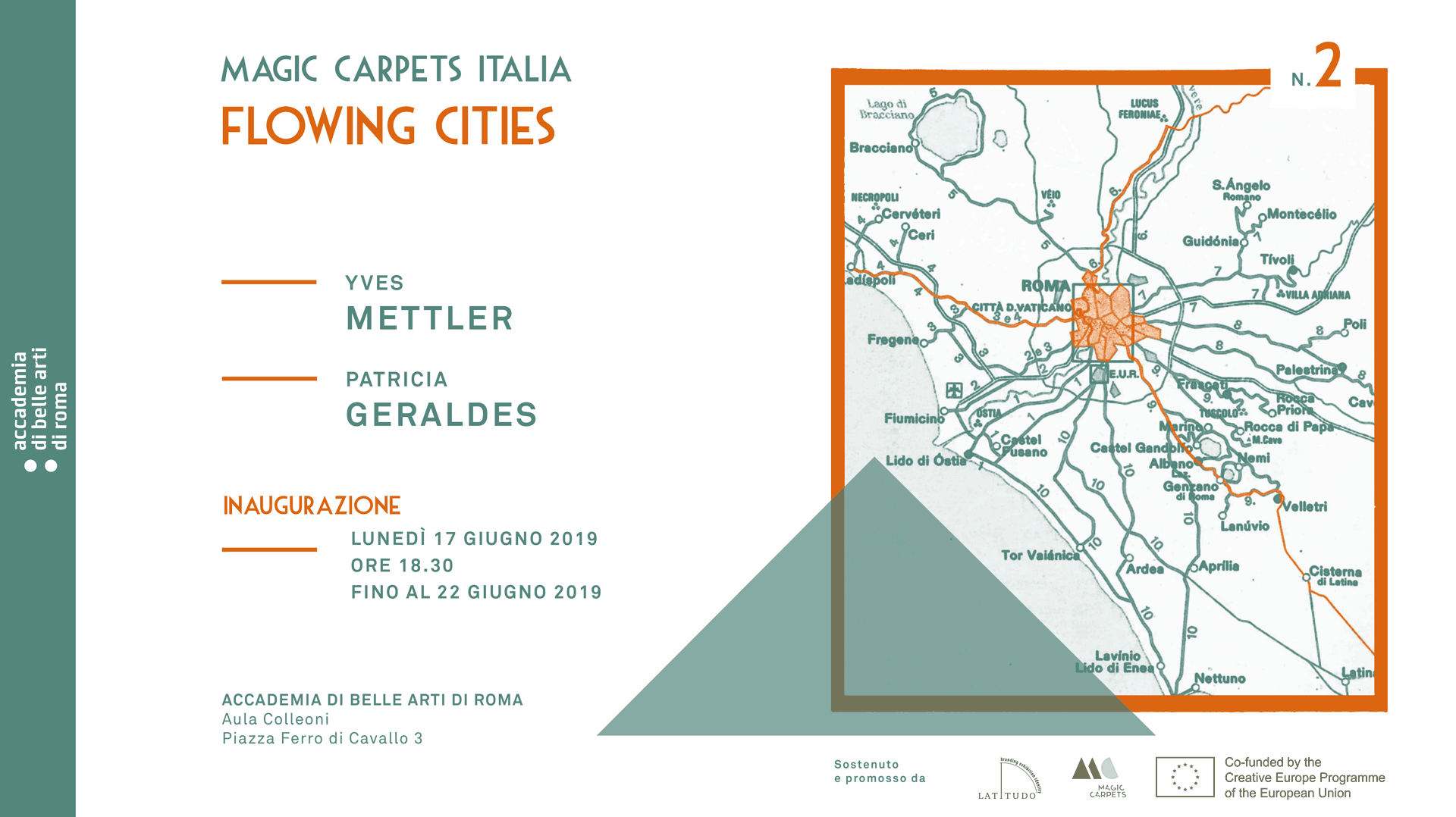
NOWs: Magic Carpets Italy – Flowing Cities
Flowing Citiesdouble solo show
Accademia di Belle Arti di Roma
Via di Ripetta, 222
00186 Roma
Opening
17 June 2019, 06.30 pm
Flowing Cities is an international artists’ residence project created by Benedetta Carpi De Resmini and curated with Giulia Pardini.
Latitudo-Art Projects and the Accademia di Belle Arti di Roma present the exhibition Flowing Cities, a double solo show dedicated to the artists Yves Mettler and Patricia Geraldes as part of the international platform Magic Carpets, now in its second edition, from 17 to 22 June 2019 in the Accademia’s exhibition spaces, where an installation by Patricia Geraldes will be on view until 27 June in Piazza Ferro di Cavallo.
For the exhibition, Yves Mettler will present a two-channel video work, projected in the Sala Colleoni, stemming from the artist’s research in Laurentino 38. On the walls of the room, a story that the artist prepared during his workshops with neighbourhood youth will be displayed: posters, photos and comics will compete to share the intricate world of the Laurentino.
Patricia Geraldes will present the diaries she created with the residents of the Corviale: photos, memories, collages and drawings will create varying and contrasting visions of the neighbourhood. In the central square, Piazza Ferro di Cavallo, the artist will present a sculpture based on the idea of restoring a virtuous balance between humans and their environment: the site specific work will be composed of branches carved with memories and emotions drawn from her work at the Corviale.
In the spaces adjacent to the Sala Colleoni, there will be a timeline, visual narration of the residences of these two artists, using photos of their time studying and working in Rome, taken by the photographer Luis Do Rosario. Alongside the project carried out in Italy, Magic Carpets sponsors the work of Italian artists abroad, with the idea of cultural exchange between European countries. For this second edition, the artists invited to develop a residence project linked to a place by starting a dialogue with the community were Elena Mazzi, selected by ZK/U di Berlin, and Virginia Zanetti, chosen by Ideias Emergentes in Porto. Along with Luis do Rosario’s photos, there are photographs realized by the Lithuanian journalists collective Nanook (Mindaugas Drigotas), who had followed the two Italian artists in their residencies. There are also shown documents and drawings made by the artists themselves.
Flowing Citiesdouble solo show
Accademia di Belle Arti di Roma
Via di Ripetta, 222
00186 Roma
Opening
17 June 2019, 06.30 pm
Flowing Cities is an international artists’ residence project created by Benedetta Carpi De Resmini and curated with Giulia Pardini.
Latitudo-Art Projects and the Accademia di Belle Arti di Roma present the exhibition Flowing Cities, a double solo show dedicated to the artists Yves Mettler and Patricia Geraldes as part of the international platform Magic Carpets, now in its second edition, from 17 to 22 June 2019 in the Accademia’s exhibition spaces, where an installation by Patricia Geraldes will be on view until 27 June in Piazza Ferro di Cavallo.
For the exhibition, Yves Mettler will present a two-channel video work, projected in the Sala Colleoni, stemming from the artist’s research in Laurentino 38. On the walls of the room, a story that the artist prepared during his workshops with neighbourhood youth will be displayed: posters, photos and comics will compete to share the intricate world of the Laurentino.
Patricia Geraldes will present the diaries she created with the residents of the Corviale: photos, memories, collages and drawings will create varying and contrasting visions of the neighbourhood. In the central square, Piazza Ferro di Cavallo, the artist will present a sculpture based on the idea of restoring a virtuous balance between humans and their environment: the site specific work will be composed of branches carved with memories and emotions drawn from her work at the Corviale.
In the spaces adjacent to the Sala Colleoni, there will be a timeline, visual narration of the residences of these two artists, using photos of their time studying and working in Rome, taken by the photographer Luis Do Rosario. Alongside the project carried out in Italy, Magic Carpets sponsors the work of Italian artists abroad, with the idea of cultural exchange between European countries. For this second edition, the artists invited to develop a residence project linked to a place by starting a dialogue with the community were Elena Mazzi, selected by ZK/U di Berlin, and Virginia Zanetti, chosen by Ideias Emergentes in Porto. Along with Luis do Rosario’s photos, there are photographs realized by the Lithuanian journalists collective Nanook (Mindaugas Drigotas), who had followed the two Italian artists in their residencies. There are also shown documents and drawings made by the artists themselves.
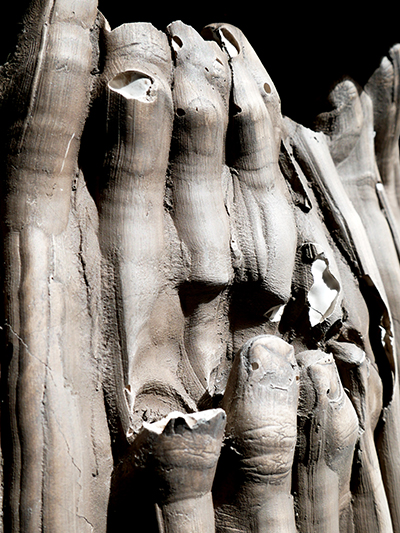
NOWs: The Dig by Dan Stockholm
The DigSolo exhibition
R E I T E R | Berlin prospect
Potsdamer Strasse 81B
10785 Berlin
opening
20 June 6 pm
In The Dig Dan Stockholm adopts the role of a creative archaeologist, utilizing methods of excavation, preservation and display in the creation of three new series of works. The Dig speculates on how we tend to view the entire story of history as though it’s a straight line that leads directly to us. In archaeology we dig to uncover ourselves, but is it us that we find, or were we someone else?
Read the article about the exhibition on artmirror
The DigEinzelausstellung
R E I T E R | Berlin prospect
Potsdamer Strasse 81B
10785 Berlin
Eröffnung
Donnerstag 20. Juni 18 h
Für The Dig wird Dan Stockholm zum kreativen Archäologen, indem er die Methoden von Ausgrabung, Konservierung und Präsentation zur Erschaffung neuer Kunstwerke nutzt. Daraus sind drei Werkreihen entstanden die die Ausstellung thematisiert. The Dig spekuliert über unsere Neigung, die gesamte Geschichte als gerade Linie zu betrachten, welche auf direktem Wege zu uns führt. In der Archäologie graben wir, um uns selbst zu entdecken. Aber sind wir es, die wir da wiederfinden? Oder müssen wir annehmen, dass wir Andere waren?
Artikel über die Ausstellung auf artmirror
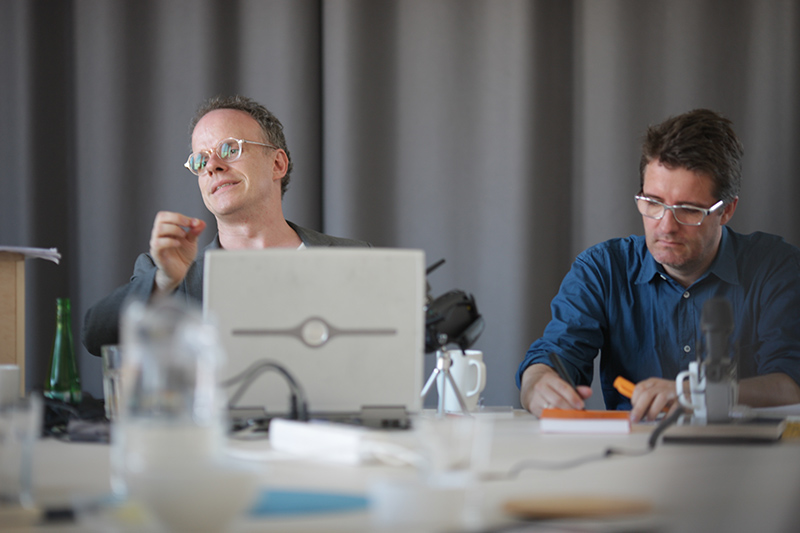
#8: Hans Ulrich Obrist and Olafur Eliasson, 25 May 2009
present > past >>>>>>>>>
<<<<<<<<< fast < forward
Meeting up with the beginnings #8:
Workshop with Hans Ulrich Obrist and Olafur Eliasson
Hans Ulrich Obrist and Olafur Eliasson
present > past >>>>>>>>>
<<<<<<<<< fast < forward
Meeting up with the beginnings #8:
Workshop mit Hans Ulrich Obrist und Olafur Eliasson
Hans Ulrich Obrist und Olafur Eliasson
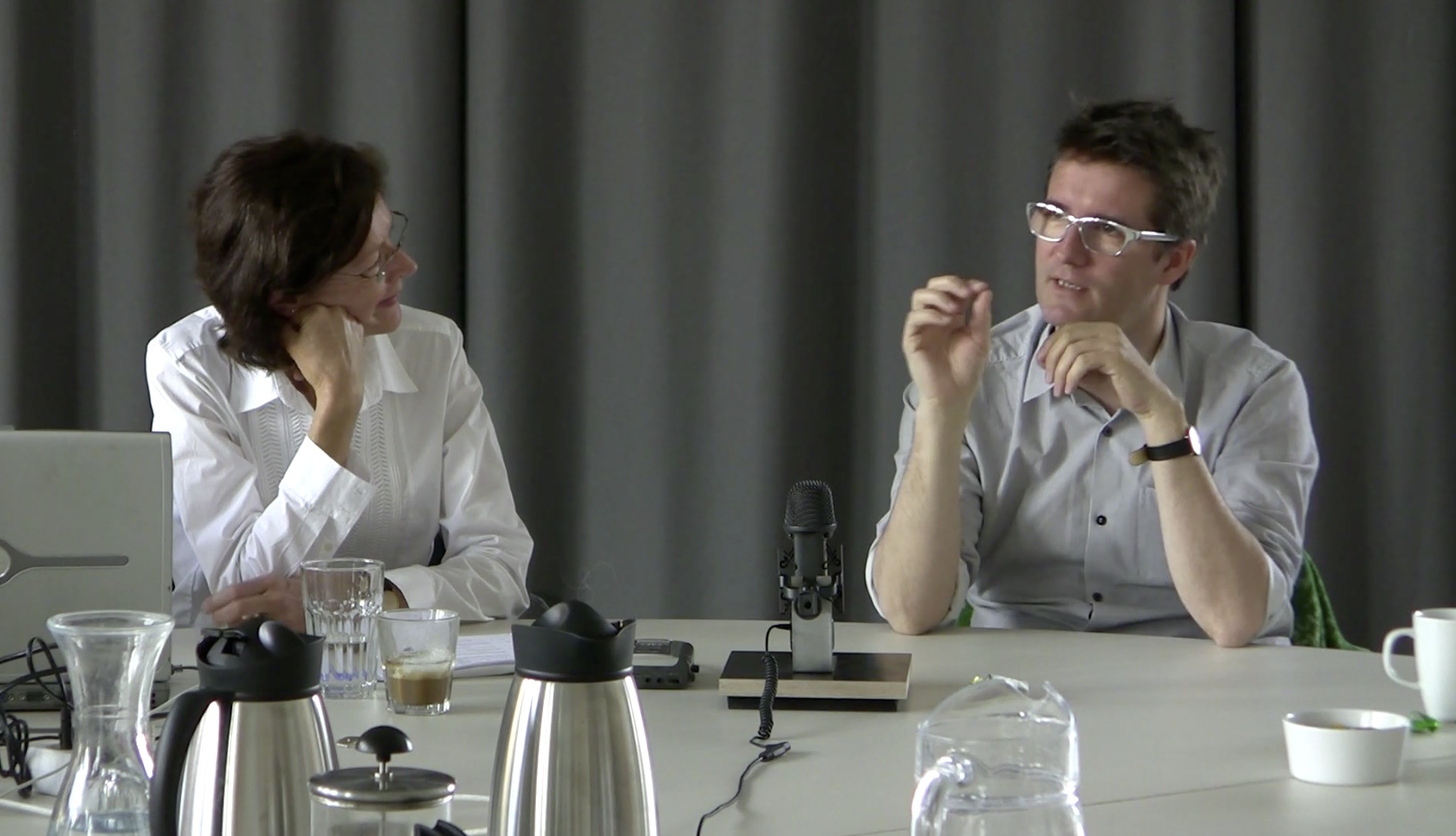
#7: Jennifer A. McMahon Interviews Olafur Eliasson, 19 May 2009
present > past >>>>>>>>>
<<<<<<<<< fast < forward
Meeting up with the beginnings #7:
Jennifer A. McMahon interviews Olafur Eliasson
Jennifer A. McMahon interviews Olafur Eliasson
present > past >>>>>>>>>
<<<<<<<<< fast < forward
Meeting up with the beginnings #7:
Jennifer A. McMahon interviewt Olafur Eliasson
Jennifer A. McMahon interviewt Olafur Eliasson

#5: Peter Weibel – The Negative Space, Part I, 8 May 2009
present > past >>>>>>>>>
<<<<<<<<< fast < forward
Meeting up with the beginnings #5:
A conversation between Peter Weibel, Caroline A. Jones and Olafur Eliasson. 8 May 2009
Peter Weibel: The Negative Space, Part I
present > past >>>>>>>>>
<<<<<<<<< fast < forward
Meeting up with the beginnings #5:
A conversation between Peter Weibel, Caroline A. Jones and Olafur Eliasson. 8 May 2009
Peter Weibel: The Negative Space, Part I

#6: Workshops and Experiments – On Models, 18 – 22 May 2009
present > past >>>>>>>>>
<<<<<<<<< fast < forward
Meeting up with the beginnings #6:
“On Models”, Workshops and experiments with Eric Ellingsen and Olafur Eliasson
18 – 22 May 2009
Eric Ellingsen lecture, part I, on models
Eric Ellingsen lecture, part II, on photography
Eric Ellingsen experiments with strobe light
Eric Ellingsen lecture part III, on models
present > past >>>>>>>>>
<<<<<<<<< fast < forward
Meeting up with the beginnings #6:
“Über Modelle”, Workshops und Experimente mit Eric Ellingsen und Olafur Eliasson
18. – 22. Mai 2009
Eric Ellingsen Vortrag, Teil I, Über Modelle
Eric Ellingsen Vortrag, Teil II, Über Fotografie
Eric Ellingsen Experimente mit Stroboskoplicht
Eric Ellingsen Vortrag, Teil III, Über Modelle
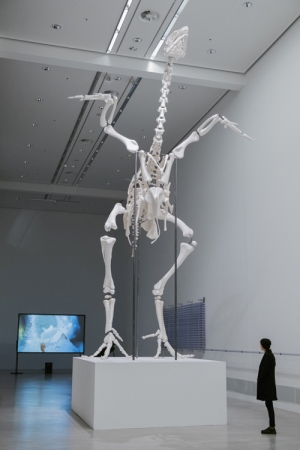
NOWs: Andreas Greiner – Recipient of Kaiserring Stipendium 2019
Monument for the 308.
Exhibition view Berlinische Galerie 2016
Andreas Greiner - Recipient of Kaiserring Stipendium 2019and solo exhibition at Mönchehaus Museum Goslar
Mönchehaus Museum
Mönchestraße 1
D–38640 Goslar
Signs of Life
8 September 2019 – 26 January 2020
Das seit 1984 vom Verein zur Förderung Moderner Kunst verliehene und seit 2014 von der AKB Stiftung in Einbeck geförderte Goslarer Kaiserringstipendium für junge Kunst geht in diesem Jahr an den Künstler Andreas Greiner.
Monument für die 308.
Installationsansicht Berlinische Galerie 2016
Andreas Greiner - Kaiserring Stipendiat 2019und Einzelausstellung im Mönchehaus Museum Goslar
Mönchehaus Museum
Mönchestraße 1
D–38640 Goslar
Signs of Life
8. September 2019 – 26. Januar 2020
Das seit 1984 vom Verein zur Förderung Moderner Kunst verliehene und seit 2014 von der AKB Stiftung in Einbeck geförderte Goslarer Kaiserringstipendium für junge Kunst geht in diesem Jahr an den Künstler Andreas Greiner.
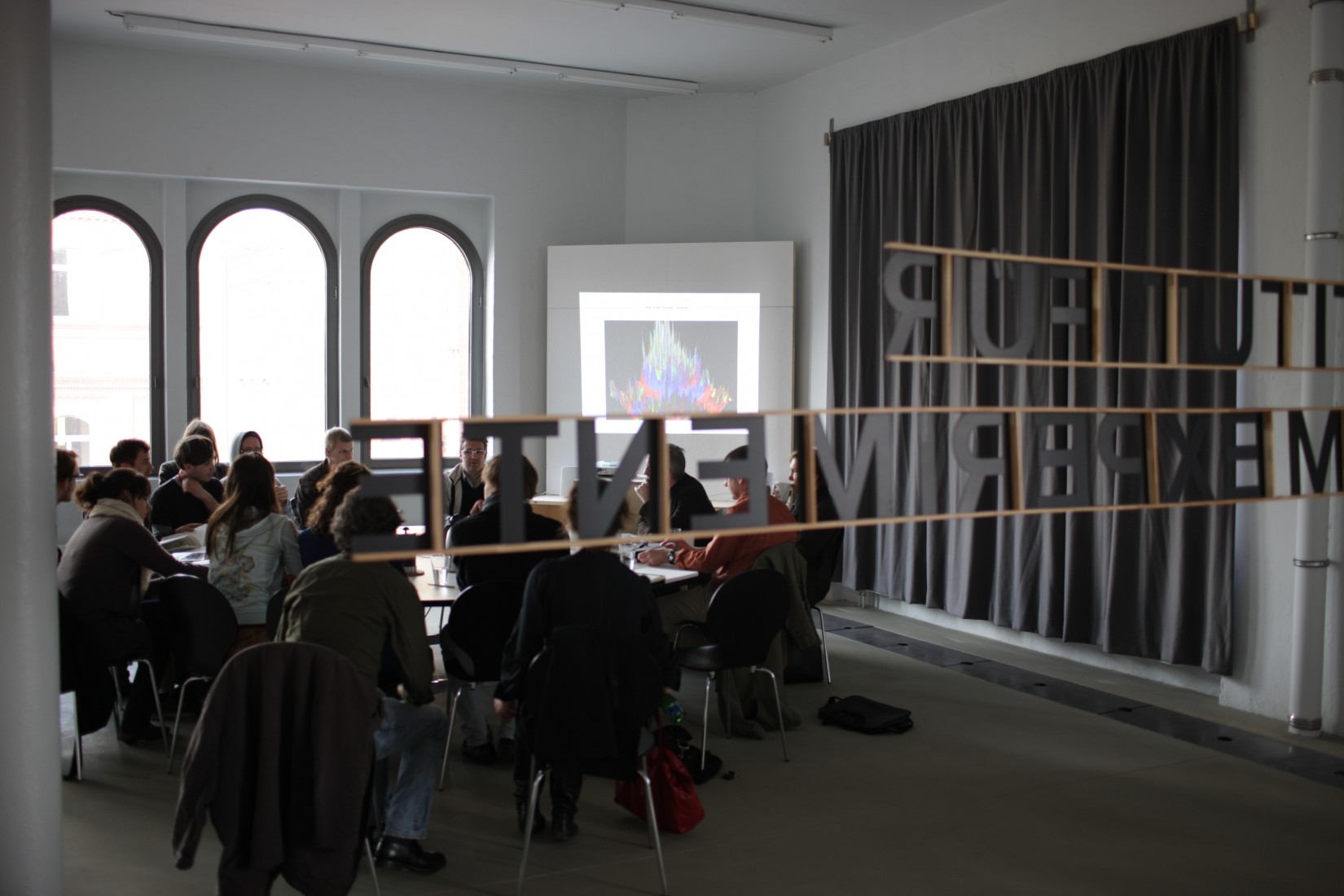
#4: Peter Coles and Matthew Ritchie in conversation with Caroline A. Jones and Olafur Eliasson, 7 May 2009
present > past >>>>>>>>>
<<<<<<<<< fast < forward
Meeting up with the beginnings #4:
Peter Coles and Matthew Ritchie in conversation with Caroline A. Jones and Olafur Eliasson. 7 May 2009
Peter Coles and Matthew Ritchie, Part 1
Peter Coles and Matthew Ritchie, Part 2
present > past >>>>>>>>>
<<<<<<<<< fast < forward
Meeting up with the beginnings #4:
Peter Coles and Matthew Ritchie in conversation with Caroline A. Jones and Olafur Eliasson. 7 May 2009
Peter Coles and Matthew Ritchie, Part 1
Peter Coles and Matthew Ritchie, Part 2

#3: Luc Steels and Olafur Eliasson: Robotic Experiments, 22 April 2009
present > past >>>>>>>>>
<<<<<<<<< fast < forward
Meeting up with the beginnings #3:
Robotic Experiments: Experience of Space in Relation to Language. Workshop with Luc Steels and Olafur Eliasson.22 April 2009
Workshop with Luc Steels and Olafur Eliasson
present > past >>>>>>>>>
<<<<<<<<< fast < forward
Meeting up with the beginnings #3:
Robotic Experiments: Experience of Space in Relation to Language. Workshop with Luc Steels and Olafur Eliasson.22 April 2009
Workshop with Luc Steels and Olafur Eliasson
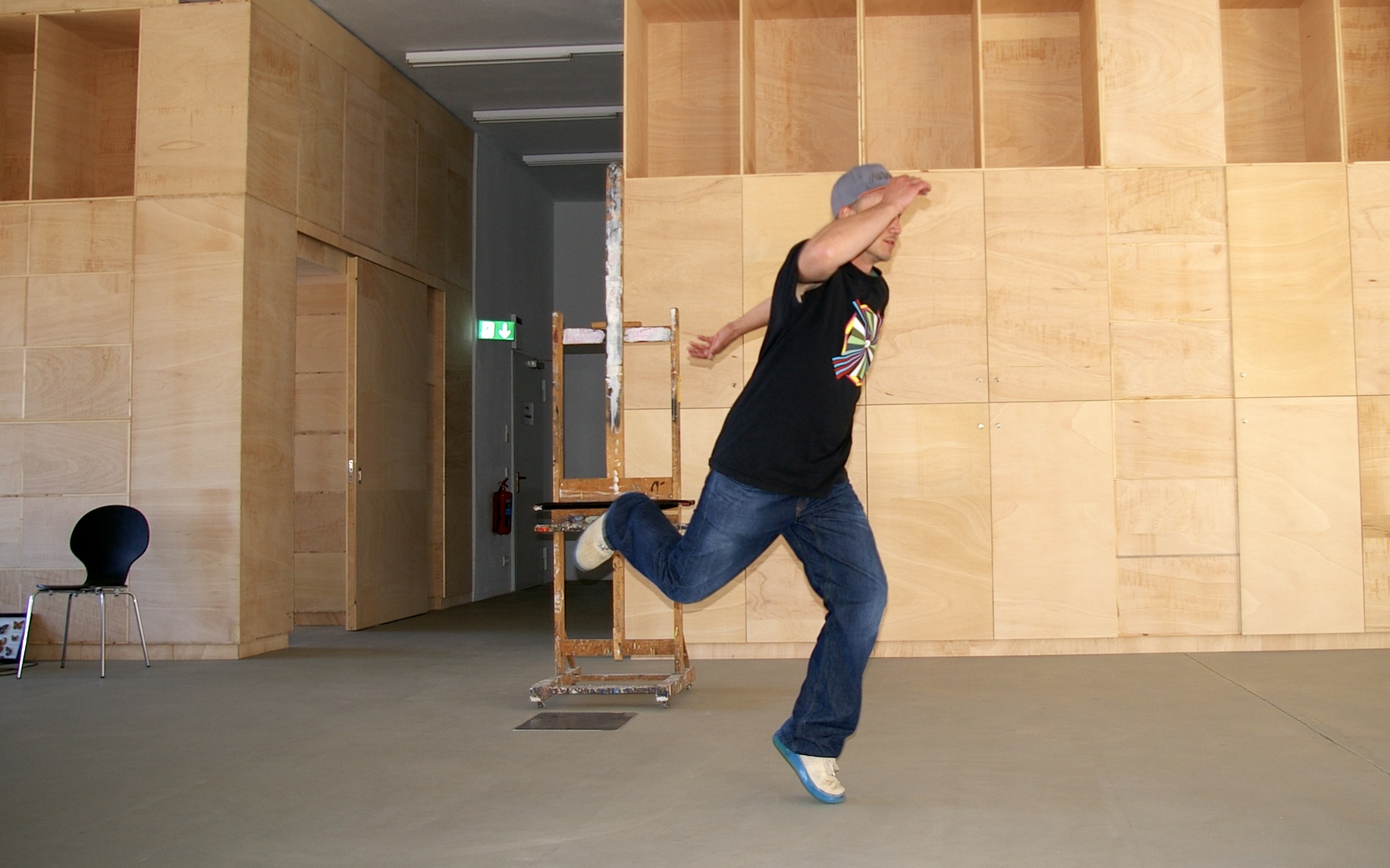
#2: Steen Kørner and Olafur Eliasson: Body Movement, 21 April 2009
present > past >>>>>>>>>
<<<<<<<<< fast < forward
Meeting up with the beginnings #2:
Body Movement, a workshop with dancer and movement expert Steen Koerner and Olafur Eliasson21 April 2009
Steen Koerner Workshop
present > past >>>>>>>>>
<<<<<<<<< fast < forward
Meeting up with the beginnings #2:
Body Movement, a workshop with dancer and movement expert Steen Koerner and Olafur Eliasson21 April 2009
Steen Koerner Workshop
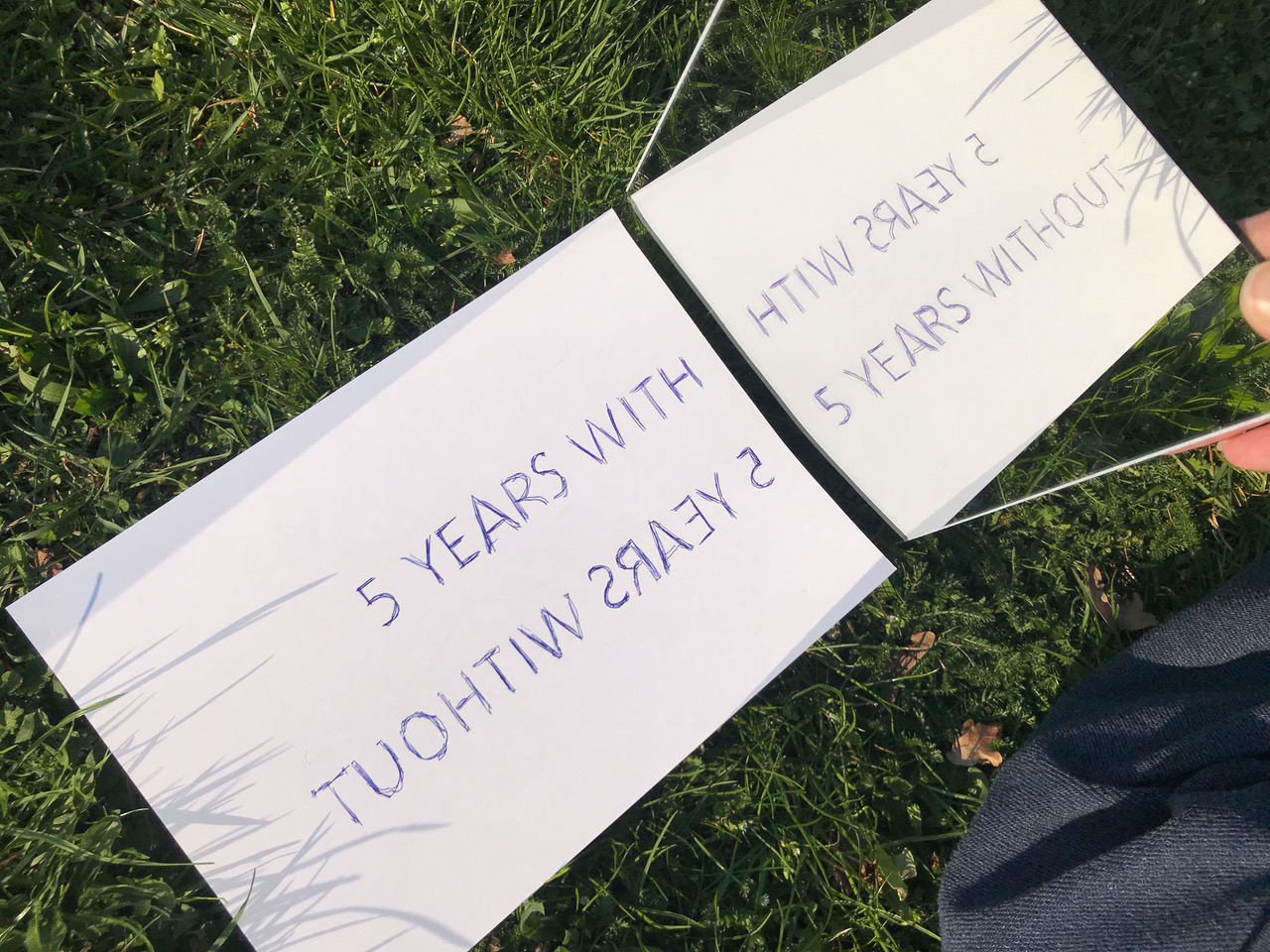
Ten years rewind: Institut für Raumexperimente
present > past >>>>>>>>>
<<<<<<<<< fast < forwardMeeting up with the beginnings
photo by Euan Williams
When walking along a street with a mirror in front of your face – you see the journey that you have taken in front of you.
5 years ago the institute came to an official end.
There have been 5 years with the institute and 5 years without.
I am enjoying the symmetry and taking a moment to be reflective.
Those 5 years still reverberate in my head.
Euan Williams
Mirror Walk, 06 January 2010
Five years of experimentation have passed through the minds and bodies of more than 400 people – including non-violent-communication experts, vegan cooks, composers, lawyers, philosophers, social scientists, astrophysicists, architects, poets, parkour and slacklining specialists, choreographers, artists, a deer imitator, a kung-fu master, and a politician. All came to the Institut für Raumexperimente (Institute for Spatial Experiments) and made their mark as participants, teachers, friends. They became the Institut für Raumexperimente – ifrex in daily use – by charting out a path of questioning and learning that remained permanently under construction. The institute stayed, by design, a model of education in the making. No conclusive model ever arrived – we never wanted it to. From 2009 to 2014 the Institute was based one storey above my studio in Berlin, but it went its own way. It was a cacophony of voices and encounters – and still is. The activities remain accessible at www.raumexperimente.net, an archival resource that we have made public to allow the accumulated thoughts and actions to move (us and you) into the future.
Olafur Eliasson
Looking back: Five years of the Institut für Raumexperimente. By Olafur Eliasson
present > past >>>>>>>>>
<<<<<<<<< fast < forwardMeeting up with the beginnings
photo by Euan Williams
Five years of experimentation have passed through the minds and bodies of more than 400 people – including non-violent-communication experts, vegan cooks, composers, lawyers, philosophers, social scientists, astrophysicists, architects, poets, parkour and slacklining specialists, choreographers, artists, a deer imitator, a kung-fu master, and a politician. All came to the Institut für Raumexperimente (Institute for Spatial Experiments) and made their mark as participants, teachers, friends. They became the Institut für Raumexperimente – ifrex in daily use – by charting out a path of questioning and learning that remained permanently under construction. The institute stayed, by design, a model of education in the making. No conclusive model ever arrived – we never wanted it to. From 2009 to 2014 the Institute was based one storey above my studio in Berlin, but it went its own way. It was a cacophony of voices and encounters – and still is. The activities remain accessible at www.raumexperimente.net, an archival resource that we have made public to allow the accumulated thoughts and actions to move (us and you) into the future.
Olafur Eliasson
Looking back: Five years of the Institut für Raumexperimente. By Olafur Eliasson
Mirror Walk, 06 January 2010
When walking along a street with a mirror in front of your face – you see the journey that you have taken in front of you.
5 years ago the institute came to an official end.
There have been 5 years with the institute and 5 years without.
I am enjoying the symmetry and taking a moment to be reflective.
Those 5 years still reverberate in my head.
Euan Williams

NOWs: reprint. Change through Reproduction
reprint. Change through ReproductionGroup exhibition
Gesellschaft für zeitgenössische Kunst Osnabrück e. V.
Kunstraum hase29
Hasestr. 29/30
49074 Osnabrück
Opening: 9 May, 7 pm
With: Manfred Blieffert, Nick Ervinck, Jonas Fleckenstein, Kati Gausmann, Birgit Kannengießer, Lola Läufer, Jan Neukirchen, Sophia Pompéry, Hannah Regenberg, David Semper, Nasan Tur, Wiebke Wilms
Reproducing things not only means reproducing them, but also opens up the question of how the reproduced is changed by the process of reproduction? Does what is reproduced influence our old idea of a unique original? In today’s digital world, the originals no longer exist, but artificial artefacts, complex ideas and digital images that at best refer back to what has already been reproduced.
The change that has been introduced since the beginnings of reproduction processes (19th century: Photography; 20th century: Film / video; 21st century: 3-D printing) is likely to continue. The old idea of the original masterpiece will not dissolve, but will change fundamentally – reproductions are images that reproduce their own creation process in a refined and now highly technical way, thereby relativizing the earlier claim of art to produce unique originals. Reproduction means today: to take up old pictures and new procedures in order to transform them into new pictorial realities with applied reproduction techniques. Everything that can be repeated and, above all, digitalized today can be reproduced at will.
This exhibition presents works by artists who take a given “model” (a typographic detail, a mesh pattern, a napkin ornament, a stamp pad) as their starting point and create new variations. The result is always a result between a changed original pattern (original) and a newly documented form of reproduction, which gradually emerges through an ever-new reproduction.
reprint. Wandel durch ReproduktionGruppenausstellung
Gesellschaft für zeitgenössische Kunst Osnabrück e. V.
Kunstraum hase29
Hasestr. 29/30
49074 Osnabrück
Eröffnung: 9. Mai, 19 h
Mit: Manfred Blieffert, Nick Ervinck, Jonas Fleckenstein, Kati Gausmann, Birgit Kannengießer, Lola Läufer, Jan Neukirchen, Sophia Pompéry, Hannah Regenberg, David Semper, Nasan Tur, Wiebke Wilms
Dinge zu reproduzieren, bedeutet nicht nur, diese zu vervielfältigen, sondern eröffnet auch die Frage, wie das Reproduzierte durch den Vorgang der Reproduktion verändert wird? Beeinflusst das jeweils Reproduzierte unsere alte Vorstellung von einem einmaligen Original? In der heutigen digitalen Welt existieren längst nicht mehr die Originale, sondern künstliche Artefakte, komplexe Ideen und digitale Bilder, die bestenfalls auf bereits früher Reproduziertes zurückverweisen.
Der Wandel, der seit den Anfängen von Reproduktionsverfahren eingeleitet wurde (19. Jahrhundert: Fotografie; 20. Jahrhundert: Film / Video; 21. Jahrhundert: 3-D- Druck), wird sich wahrscheinlich noch fortsetzen. Die alte Idee des originalen Meisterwerks wird sich dabei nicht auflösen, aber doch grundlegend verändern – Reproduktionen sind Bilder, die auf raffinierte und inzwischen hochgradig technische Weise ihren eigenen Entstehungsprozess reproduzieren und dabei den früheren Anspruch der Kunst, einzigartige Originale zu produzieren, relativieren.
Reproduzieren heißt also heute: Alte Bilder und neue Verfahren aufzugreifen, um sie mit angewandten Reproduktionstechniken in neue Bildwirklichkeiten zu transformieren. Alles was wiederholbar und vor allem wie heute digitalisierbar ist, lässt sich beliebig vervielfältigen.
Diese Ausstellung präsentiert Werke von Künstlerinnen und Künstlern, die von einem gegebenen „Vorbild“ (einer typographischen Detail, einem Maschenmuster, einem Serviettenornament, einem Stempelkissen) ausgehen und neuartige Varianten erzeugen. Das Resultat ist jeweils ein Ergebnis zwischen einem veränderten Ursprungsmuster (Original) und einer jeweils neu dokumentierten Form von Reproduktion, die durch ein immer neues Reproduzieren allmählich entsteht.
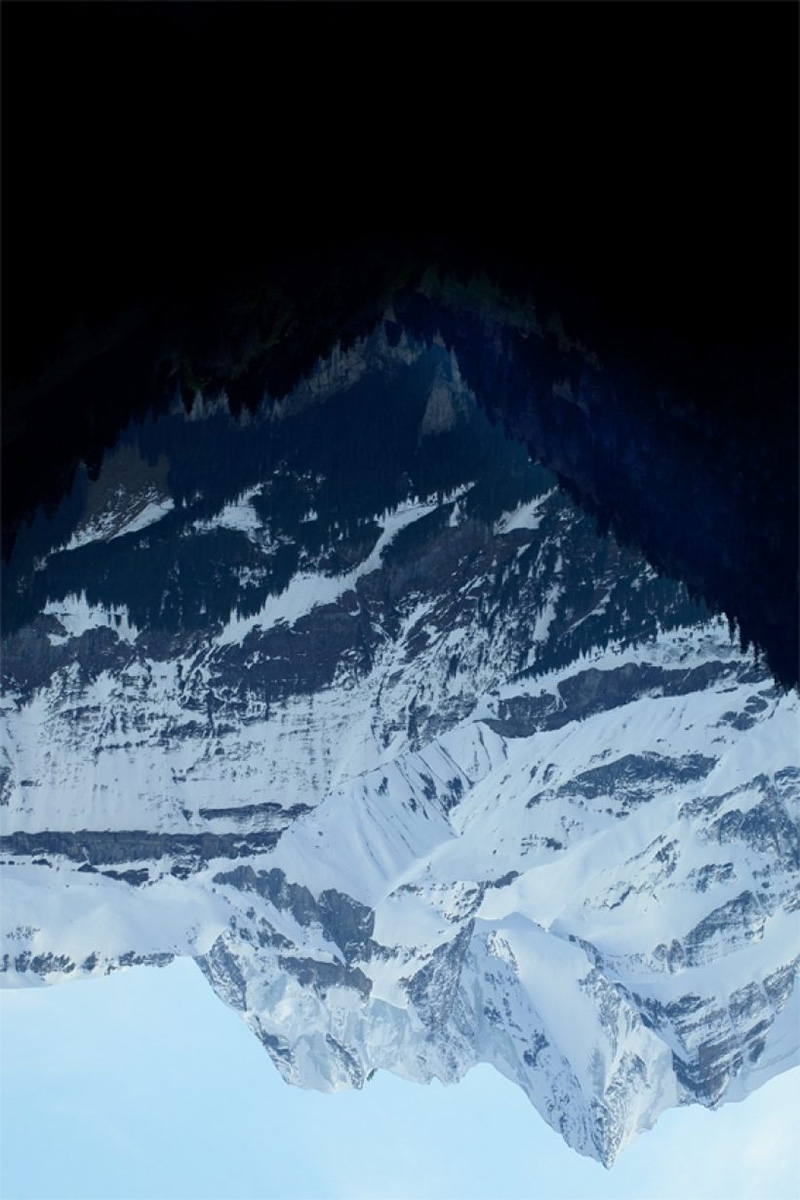
NOWs: Passpunkt
PasspunktSolo exhibition by Sophia Pompéry
Galerie WAGNER + PARTNER
Koppenplatz 5-6
10115 Berlin
Opening: 17 May, 7 pm
WAGNER + PARTNER is pleased to present Passpunkt (Control Point), the third solo exhibition by the Berlin artist Sophia Pompéry. Following on from previous projects, Pompéry continues her exploration of aesthetics at the intersection of art, physics and philosophy and with astonishing results.
Pompéry began this project during a residency in the Swiss mountains where she was inspired by the landscape. What sets a photograph of a mountain panorama apart from that of a valley? Are there objective “truths” for the answer or appraisal? Ultimately, we instinctively trust a camera’s objectivity.
The exhibition’s title alludes to the “control points” used in the surveying sector to clearly define an exact location – thus determining its meaning in an overriding sense. In the WAGNER + PARTNER exhibition, Sophia Pompéry explores this concept to absurdity and creates states of suspense through minimal artistic intervention. A photo of a mountain is also that of a valley, a negative becomes a positive, a yes becomes a no …
Sophia Pompéry (*1984 in Berlin) lives and works in Berlin. She graduated from the Kunsthochschule Berlin-Weissensee with a Masters degree and then participated in the UdK (Berlin University of the Arts) Institute for Spatial Experiments with Olafur Eliasson. Numerous prizes, residencies and international exhibitions testify to her artistic achievements.
PasspunktSolo exhibition by Sophia Pompéry
Galerie WAGNER + PARTNER
Koppenplatz 5-6
10115 Berlin
Eröffnung: 17. Mai, 19 h
Galerie WAGNER + PARTNER freut sich, mit „Passpunkt“ die dritte Einzelausstellung der Berliner Künstlerin Sophia Pompéry zu präsentieren. Wie in anderen Projekten auch, stellt Pompéry generelle ästhetische Fragen am Schnittpunkt von Kunst, Physik und Philosophie und überrascht mit deren Antworten.
Ausgangpunkt war ein Residence-Aufenthalt in den Schweizer Bergen, bei dem die Künstlerin sich fotografisch mit der Landschaft vor Ort auseinandergesetzt hat. Was unterscheidet das Foto eines Bergpanoramas von dem einer Talaufnahme? Gibt es objektive „Wahrheiten“ für die Antwort oder Bewertung? Schließlich vertrauen wir der Objektivität eines Fotoapperates instiktiv.
Im Vermessungswesen bedient man sich sogenannter – in Anspielung auf den Ausstellungstitel – Passpunkte, um eine räumliche Lage eindeutig zu bestimmen – und damit in einem übergeordneten Sinne auch seine Bedeutung. Sophia Pompéry hat in der Ausstellung bei WAGNER + PARTNER dieses Vorgehen ad absurdum geführt und durch minimale künstlerische Eingriffe die Bezüge in einen Schwebzustand gebracht. Ein Foto vom Berg ist zugleich ein Foto vom Tal, ein Negativ wird ein Positiv, ein Ja wird ein Nein…
Sophia Pompéry (*1984 in Berlin) lebt und arbeitet in Berlin. Sie hat ein Meisterschülerinnen-Studium an der Kunsthochschule Berlin-Weissensee absolviert und später am Institut für Raumexperimente bei Olafur Eliasson an der Universität der Künste teilgenommen. Zahlreiche Preise, Auslandsaufenthalte und internationale Ausstellungen zeugen von ihrem hohen künstlerischen Profil.
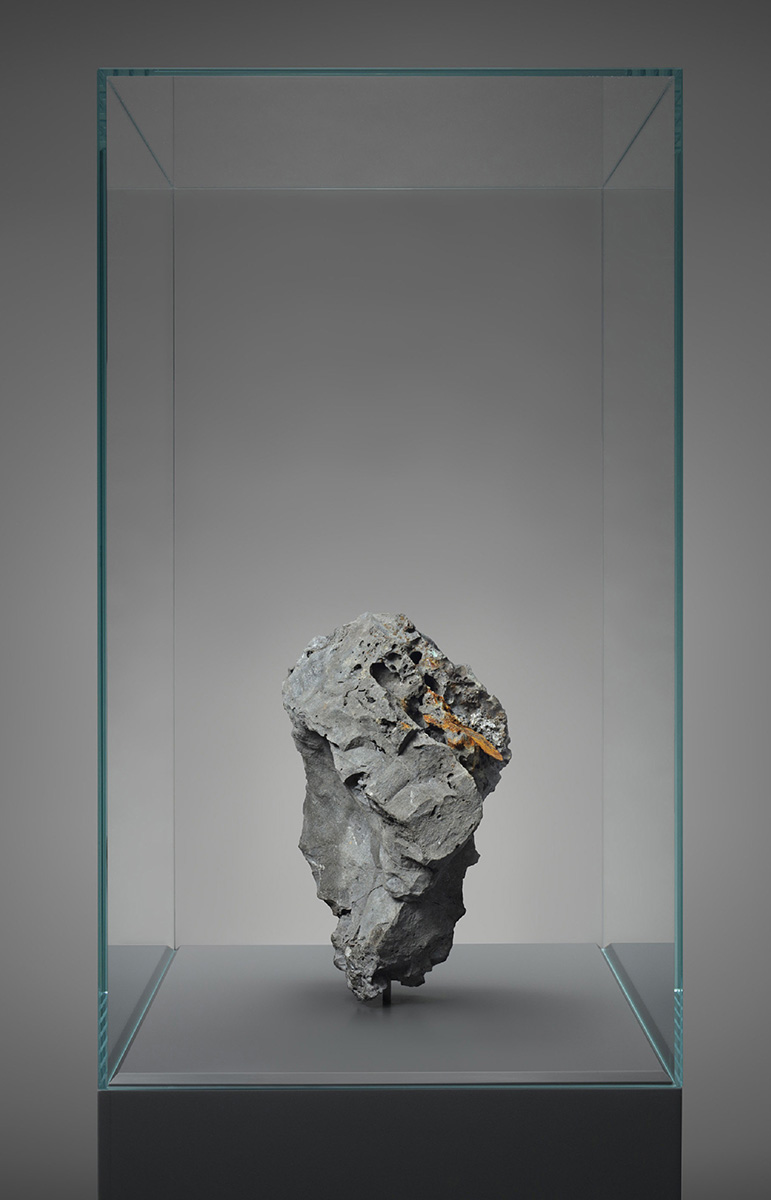
NOWs: Artists Need To Create On The Same Scale That Society Has The Capacity To Destroy: Mare Nostrum
Artists Need To Create On The Same Scale That Society Has The Capacity To Destroy: Mare NostrumGroup Exhibition with Julian Charrière et al
Chiesa delle Penitenti
Fondamenta Cannaregio 910
30121 Venezia
Italy
Opening
8 May 8, 5pm – 6pm
Poetry Reading with Milli Graffi, Luigi Ballerini, John Giorno, Vincent Katz, and Mónica de la Torre
8 May, 6pm – 8pm
Cooking Performance with Rirkrit Tiravanija and Tomas Vu
11 & 12 May, 5pm
A two-day discussion amongst scientists, artists, and philosophers on climate change and the Mediterranean, featuring Lauren Bon, Justin Brice Guariglia, Emanuele Coccia (Ecole des Hautes Etudes en Sciences Sociales, Paris), Jaroslav Mysiak (Euro-Mediterranean Center on Climate Changes, Venice), and Enrica De Cian (Director, Master of Research in Science and Management of Climate Change, Ca’ Foscari University, Venice), among others.
Inspired by Lauren Bon’s text-based neon work on view in the courtyard—from which it borrows its title—this exhibition, together with its accompanying public programming 1001 Stories for Survival, addresses the environmental crisis in the age of climate change, with a focus on the Mediterranean Sea. The show brings together 73 artists of different generations and cultural backgrounds whose selected works, in a wide range of media, invite critical awareness on the fragility of nature and human life while poetically invoking the regeneration of living systems. On view are works by Shoja Azari & Shahram Karimi, Lauren Bon, Julian Charrière, Newton Harrison, Wolfgang Laib, Maya Lin, Shirin Neshat, Amy Sillman, Kiki Smith, Rirkrit Tiravanija, Tomas Vu, Jack Witten, and Lisa Yuskavage, among many others that meditate on themes such as ephemerality, transformation, and interconnectedness. The exhibition and the programing are co-curated by Phong Bui and Francesca Pietropaolo.
Art as a Social Activity
Present with its staff during the course of the exhibition, the Brooklyn Rail—a radical and free publication based in New York City—recreates its Social Environment in Venice. The inspiration for our Social Environment comes from an understanding of our work as a creative act, which produces the monthly journal, public forums, and informal gatherings that are a platform for the diverse voices of our community. In Venice, we will produce our monthly issues in addition to a special issue of the River Rail, a publication documenting our exhibition and its interdisciplinary public programming bringing together artists, scientists, scholars, poets, writers, and musicians focusing on environment and climate change.
Artists Need To Create On The Same Scale That Society Has The Capacity To Destroy: Mare NostrumGroup Exhibition with Julian Charrière et al
Chiesa delle Penitenti
Fondamenta Cannaregio 910
30121 Venezia
Italy
Opening
8 May 8, 5pm – 6pm
Poetry Reading with Milli Graffi, Luigi Ballerini, John Giorno, Vincent Katz, and Mónica de la Torre
8 May, 6pm – 8pm
Cooking Performance with Rirkrit Tiravanija and Tomas Vu
11 & 12 May, 5pm
A two-day discussion amongst scientists, artists, and philosophers on climate change and the Mediterranean, featuring Lauren Bon, Justin Brice Guariglia, Emanuele Coccia (Ecole des Hautes Etudes en Sciences Sociales, Paris), Jaroslav Mysiak (Euro-Mediterranean Center on Climate Changes, Venice), and Enrica De Cian (Director, Master of Research in Science and Management of Climate Change, Ca’ Foscari University, Venice), among others.
Inspired by Lauren Bon’s text-based neon work on view in the courtyard—from which it borrows its title—this exhibition, together with its accompanying public programming 1001 Stories for Survival, addresses the environmental crisis in the age of climate change, with a focus on the Mediterranean Sea. The show brings together 73 artists of different generations and cultural backgrounds whose selected works, in a wide range of media, invite critical awareness on the fragility of nature and human life while poetically invoking the regeneration of living systems. On view are works by Shoja Azari & Shahram Karimi, Lauren Bon, Julian Charrière, Newton Harrison, Wolfgang Laib, Maya Lin, Shirin Neshat, Amy Sillman, Kiki Smith, Rirkrit Tiravanija, Tomas Vu, Jack Witten, and Lisa Yuskavage, among many others that meditate on themes such as ephemerality, transformation, and interconnectedness. The exhibition and the programing are co-curated by Phong Bui and Francesca Pietropaolo.
Art as a Social Activity
Present with its staff during the course of the exhibition, the Brooklyn Rail—a radical and free publication based in New York City—recreates its Social Environment in Venice. The inspiration for our Social Environment comes from an understanding of our work as a creative act, which produces the monthly journal, public forums, and informal gatherings that are a platform for the diverse voices of our community. In Venice, we will produce our monthly issues in addition to a special issue of the River Rail, a publication documenting our exhibition and its interdisciplinary public programming bringing together artists, scientists, scholars, poets, writers, and musicians focusing on environment and climate change.

NOWs: Tool Shed with Eric Ellingsen
Sketch of Tool Shed. Courtesy the artist.
Tool ShedWalkshop series with Eric Ellingsen
Contemporary Art Museum St. Louis
3750 Washington Boulevard
St. Louis, MO 63108
Register here for the next walkshop on July 19th
During the summer of 2019, non-disciplinary artist Eric Ellingsen guides “walkshops” throughout the city. If, as urbanist and author Jane Jacobs asserts, we need eyes on the streets then we need ears on the streets, too. Participants in the first phase of the project—including members of the Samaritan United Methodist Church, Third Baptist Church, and other CAM neighbors—construct and wear hearing devices based on early 20th-century technologies to engage protocols of listening. Ellingsen and CAM staff guide walkshops to observe and collect sounds from the surrounding neighborhood, with musicians, poets, field scientists, and landscape architects. These field recordings are gathered, archived, and mixed into sound installations, creating aural portraits. Visitors can experience soundscapes of St. Louis neighborhoods in an acoustically designed tool shed in CAM’s courtyard throughout the summer.
Eric Ellingsen: Tool Shed is organized for the Contemporary Art Museum St. Louis by Wassan Al-Khudhairi, Chief Curator; Alex Almestad, Director of Learning and Engagement; and Misa Jeffereis, Assistant Curator.
The project is generously supported by the Divided City, an urban humanities initiative funded by the Andrew W. Mellon Foundation, a joint project of the Center for the Humanities and the Sam Fox School, College of Architecture and Urban Design at Washington University in St. Louis. Special thanks to project partners John Baugh, Neo Muyanga, and Casey O’Callaghan, and to KDHX.
First Walkshop. Photo by Virginia Harold
First Walkshop. Photo by Virginia Harold
Sketch of Tool Shed. Courtesy the artist.
Tool ShedWalkshop series with Eric Ellingsen
Contemporary Art Museum St. Louis
3750 Washington Boulevard
St. Louis, MO 63108
Register here for the next walkshop on July 19th
During the summer of 2019, non-disciplinary artist Eric Ellingsen guides “walkshops” throughout the city. If, as urbanist and author Jane Jacobs asserts, we need eyes on the streets then we need ears on the streets, too. Participants in the first phase of the project—including members of the Samaritan United Methodist Church, Third Baptist Church, and other CAM neighbors—construct and wear hearing devices based on early 20th-century technologies to engage protocols of listening. Ellingsen and CAM staff guide walkshops to observe and collect sounds from the surrounding neighborhood, with musicians, poets, field scientists, and landscape architects. These field recordings are gathered, archived, and mixed into sound installations, creating aural portraits. Visitors can experience soundscapes of St. Louis neighborhoods in an acoustically designed tool shed in CAM’s courtyard throughout the summer.
Eric Ellingsen: Tool Shed is organized for the Contemporary Art Museum St. Louis by Wassan Al-Khudhairi, Chief Curator; Alex Almestad, Director of Learning and Engagement; and Misa Jeffereis, Assistant Curator.
The project is generously supported by the Divided City, an urban humanities initiative funded by the Andrew W. Mellon Foundation, a joint project of the Center for the Humanities and the Sam Fox School, College of Architecture and Urban Design at Washington University in St. Louis. Special thanks to project partners John Baugh, Neo Muyanga, and Casey O’Callaghan, and to KDHX.
First Walkshop. Photo by Virginia Harold
First Walkshop. Photo by Virginia Harold
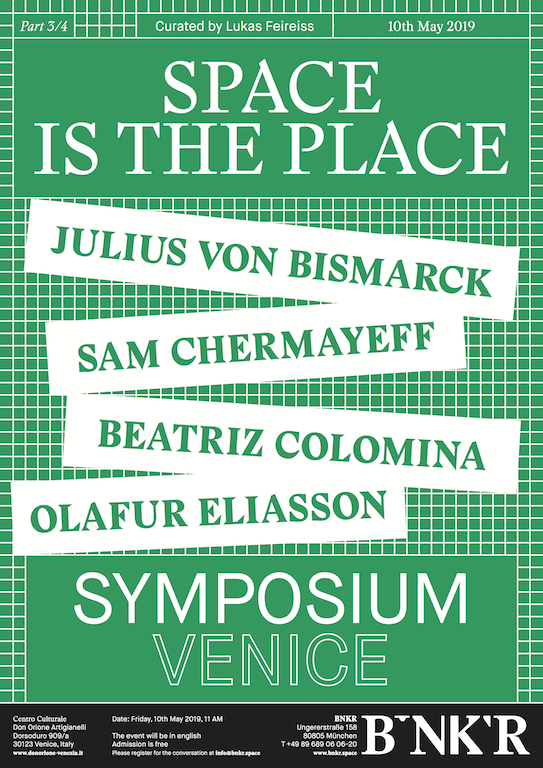
NOWs: SPACE IS THE PLACE (3/4)
Space is the Place (3/4)Symposium with Beatriz Colomina, Julius von Bismarck, Sam Chermayeff, Olafur Eliasson, Lukas Feireiss
Centro Culturale Don Orione Artigianelli
Dorsoduro 909/a
30123 Venice
Close to Ponte dell’Academia
10 May, 2019, 11am
Under the title SPACE IS THE PLACE the current exhibition cycle 2018 – 2019 at BNKR conceived by Berlin-based curator Lukas Feireiss is dedicated to the artistic exploration of space.
Another highlight of the 2018/2019 exhibition cycle is an international symposium of the same name during the opening days of the 58th Venice Art Biennale on 10th May 2019. Together with curator and architectural theorist Beatriz Colomina, artists Olafur Eliasson and Julius von Bismarck, as well as architect Sam Chermayeff, Lukas Feireiss explores the experience, design, reflection and imagination of space. Common to these positions is a multi-layered approach to space that addresses, questions and challenges the senses and sensations in very different ways.
Space is the Place (3/4)Symposium mit Beatriz Colomina, Julius von Bismarck, Sam Chermayeff, Olafur Eliasson, Lukas Feireiss
Centro Culturale Don Orione Artigianelli
Dorsoduro 909/a
30123 Venice
Nähe Ponte dell’Academia
10. Mai 2019, 11h
Im Rahmen des von Lukas Feireiss kuratierten BNKR-Ausstellungsturnus 2018/2019 SPACE IS THE PLACE widmen sich, neben Einzel- und Gruppenausstellungen, zahlreiche öffentliche Veranstaltungen der künstlerischen Wahrnehmung und Aneignung von Raum und Architektur. Unter Berücksichtigung theoretisch wie praktisch fundierter Disziplinen erfolgt dabei eine Art künstlerischer Spurensicherung durch welche sich der uns umgebende Raum als Gegenstand der Untersuchung auf vielfältige Weise erschließt.
Ein weiterer Höhepunkt des Ausstellungsturnus 2018/2019 ist ein gleichnamiges internationales Symposium während der Eröffnungstage der 58. Kunstbiennale Venedig im Mai 2019. Gemeinsam mit der Kuratorin und Architekturtheoretikerin Beatriz Colomina, den Künstlern Olafur Eliasson und Julius von Bismarck sowie dem Architekten Sam Chermayeff erforscht Lukas Feireiss das Erleben, Gestalten, Reflektieren und Imaginieren von Raum. Gemein ist den inhaltlichen Positionen ein vielschichtiger Zugang zum Raum, welcher die Sinne und Empfindungen auf ganz unterschiedliche Weise anspricht, hinterfragt und herausfordert. Das Symposium findet in englischer Sprache statt.
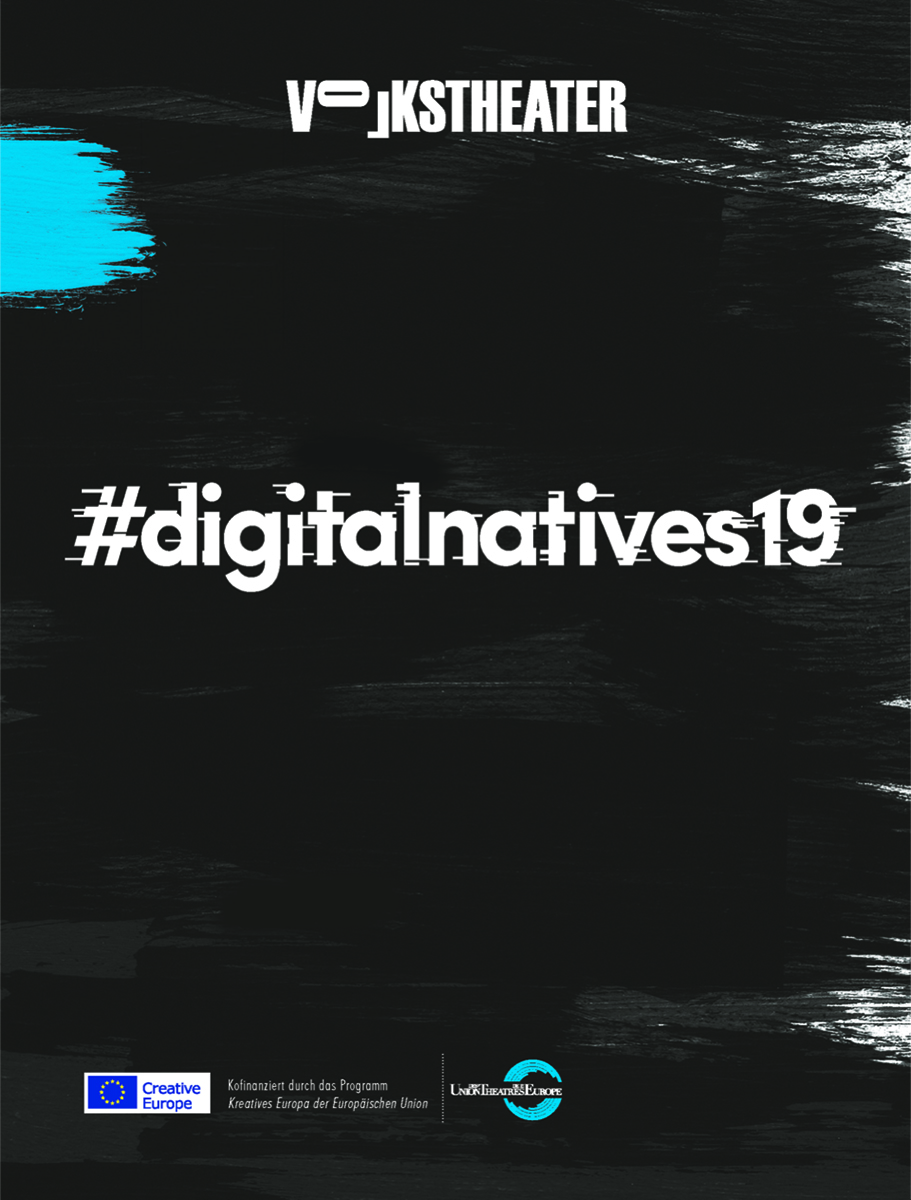
NOWs: The Data of the Heart by Sarah Rechberger
The Data of the HeartInstallation by Sarah Rechberger
Volkstheater, Weißer Salon
Neustiftgasse 1
1070 Vienna
The installation The Data of Heart makes the movements of audience members heart visible. Heart rate in beats per minute (bpm) is transmitted externally to the artwork by a sensor, facilitating a new form of communication and interaction.
This direct experience turns the physical body into a place where light, information, movement and space intersect. In the digital age, the transmission of light, or electricity and information plays a key role. This transmission is not linear: similar to our heartbeats, it takes a pulsing, wave-like form (alternating current, binary code).
In the installation, a straight beam of light is bent into a curve on all sides. The heart is not only an efficient mechanical pump. It is a location of empathy, emotional connection and direct communication. This living impulse connects us all – regardless of ethnic origin, gender, age or religion – including other forms of life such as animals. Even the planet earth has a heartbeat. Its magnetic field constantly pulsates to its own rhythm.
31 May 2019, 1pm, 2pm, 3pm
01 June 2019, 1pm, 2pm, 3pm
Free admission
The Data of the HeartInstallation von Sarah Rechberger
Volkstheater, Weißer Salon
Neustiftgasse 1
1070 Wien
Die Installation The Data of the Heart macht die Bewegungen der Herzen der Besucher/innen sichtbar. Die Herzfrequenz in bpm (beats per minute) wird durch einen Sensor nach außen auf das Kunstwerk übertragen und ermöglicht eine andere Form von Kommunikation und Interaktion. Diese unmittelbare Erfahrung macht den menschlichen Körper zu einer Schnittstelle zwischen Licht, Information, Bewegung und Raum.
Im digitalen Zeitalter spielt die Übertragung von Licht bzw. Strom und Information eine wichtige Rolle. Die Übertragung findet nicht linear, sondern ähnlich unserem Herzen, in einer pulsierenden und wellenartigen Form statt (Wechselstrom, 0/1 Binärcode). In der Installation wird die gerade Lichtlinie auf jeder Seite zu einer Kurve gekrümmt. Das Herz ist nicht nur eine effiziente mechanische Pumpe, sondern ein Ort der Empathie, der emotionalen Verbindung und der direkten Kommunikation. Dieser Lebensimpuls verbindet uns alle − unabhängig von ethnischer Herkunft, Geschlecht, Alter oder Religion – auch mit anderen Lebewesen wie den Tieren. Selbst die Erde hat einen „Herzschlag“. Ihr Magnetfeld pulsiert konstant im eigenen Rhythmus.
31. Mai 2019, 13h, 14h, 15h
01. Juni 2019, 13h, 14h, 15h
Freier Eintritt
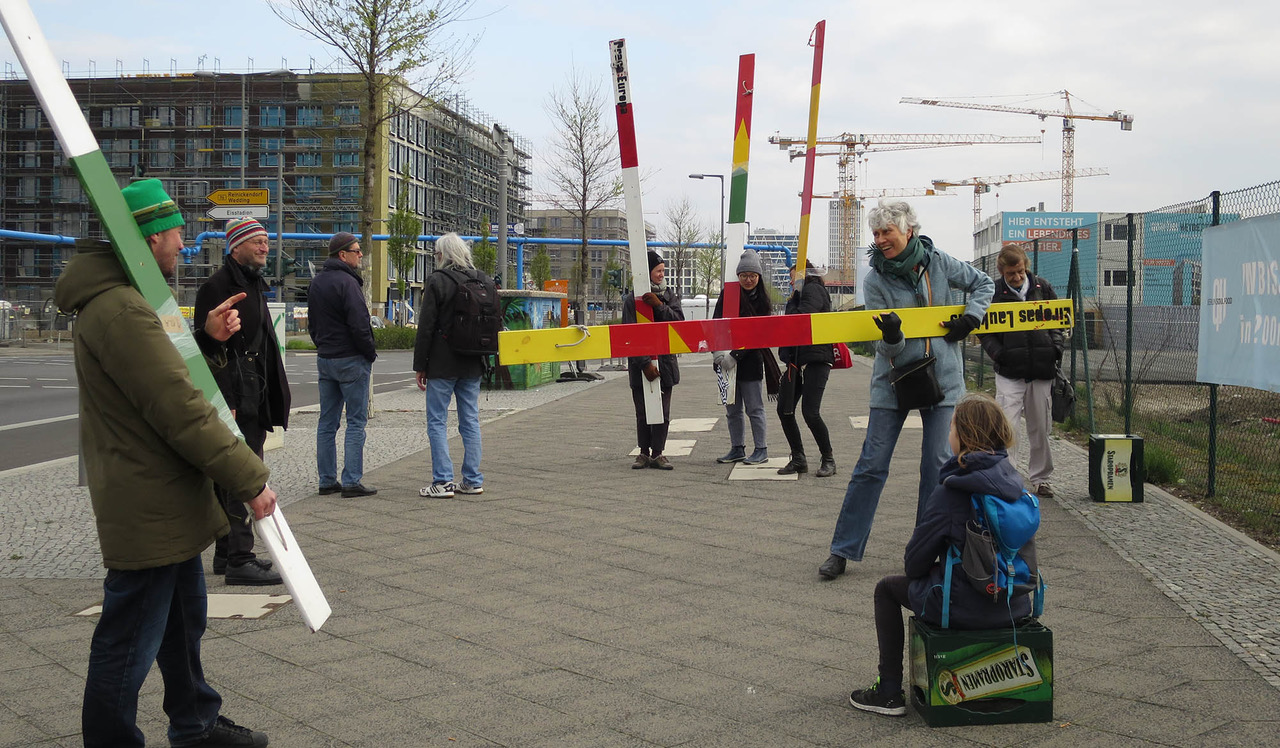
NOWs: Am Rand von EuropaCity
Am Rand von EuropaCityEine künstlerische Veranstaltungsreihe von Yves Mettler mit Alexis Hyman Wolff und Scriptings/Wedding
28. April, 15h
Tegelerstraße 6
Hinterhof
Aufgang B
Klingel Straub/Jackson
Liebe Nachbar*innen und Interessierte!
Wir hatten ein tolles Treffen mit der Gruppe Intervention und Spaziergang und freuen uns über die Entwicklungen. Im Anhang ein paar Bilder – Danke an Linda und Jürgen. Wir treffen uns erneut am 28. April um 15h in der Tegelerstrasse 6, Hinterhof, Aufgang B, Klingel Straub/Jackson. Bei diesem Treffen wollen wir den Parcours, die Stationen und unsere weiteren Aktionen festlegen.
Es wäre ideal für die Aktion am 26. Mai, wenn wir etwa 50 Leute zusammmen trommeln könnten. Wenn jede_r von Euch noch weitere Nachbar*innen und Freund*innen ansprechen könnte, wäre das toll – danke im Voraus.Treffpunkt am Sonntag, den 26. Mai ist 14h im Sellerpark.Die Abschlussveranstaltung wird mit kleiner Party ab 18 Uhr am Klara-Franke-Platz stattfinden.
Die Postergruppe wird sich noch einmal treffen, um die finale Auswahl der Poster zu machen.
Mit besten Grüßen !
Gilles Aubry, Alexis Hyman Wolff und Yves Mettler
Am Rand von EuropaCity : Eine künstlerische Veranstaltungsreihe zur Europacity Berlin ist ein Projekt von Yves Mettler mit Alexis Hyman Wolff und Scriptings/Wedding. Es wird von der Berliner Senatsverwaltung für Kultur und Europa gefördert.
Am Rand von EuropaCityEine künstlerische Veranstaltungsreihe von Yves Mettler mit Alexis Hyman Wolff und Scriptings/Wedding
28. April, 15h
Tegelerstraße 6
Hinterhof
Aufgang B
Klingel Straub/Jackson
Liebe Nachbar*innen und Interessierte!
Wir hatten ein tolles Treffen mit der Gruppe Intervention und Spaziergang und freuen uns über die Entwicklungen. Im Anhang ein paar Bilder – Danke an Linda und Jürgen. Wir treffen uns erneut am 28. April um 15h in der Tegelerstrasse 6, Hinterhof, Aufgang B, Klingel Straub/Jackson. Bei diesem Treffen wollen wir den Parcours, die Stationen und unsere weiteren Aktionen festlegen.
Es wäre ideal für die Aktion am 26. Mai, wenn wir etwa 50 Leute zusammmen trommeln könnten. Wenn jede_r von Euch noch weitere Nachbar*innen und Freund*innen ansprechen könnte, wäre das toll – danke im Voraus.Treffpunkt am Sonntag, den 26. Mai ist 14h im Sellerpark.Die Abschlussveranstaltung wird mit kleiner Party ab 18 Uhr am Klara-Franke-Platz stattfinden.
Die Postergruppe wird sich noch einmal treffen, um die finale Auswahl der Poster zu machen.
Mit besten Grüßen !
Gilles Aubry, Alexis Hyman Wolff und Yves Mettler
Am Rand von EuropaCity : Eine künstlerische Veranstaltungsreihe zur Europacity Berlin ist ein Projekt von Yves Mettler mit Alexis Hyman Wolff und Scriptings/Wedding. Es wird von der Berliner Senatsverwaltung für Kultur und Europa gefördert.
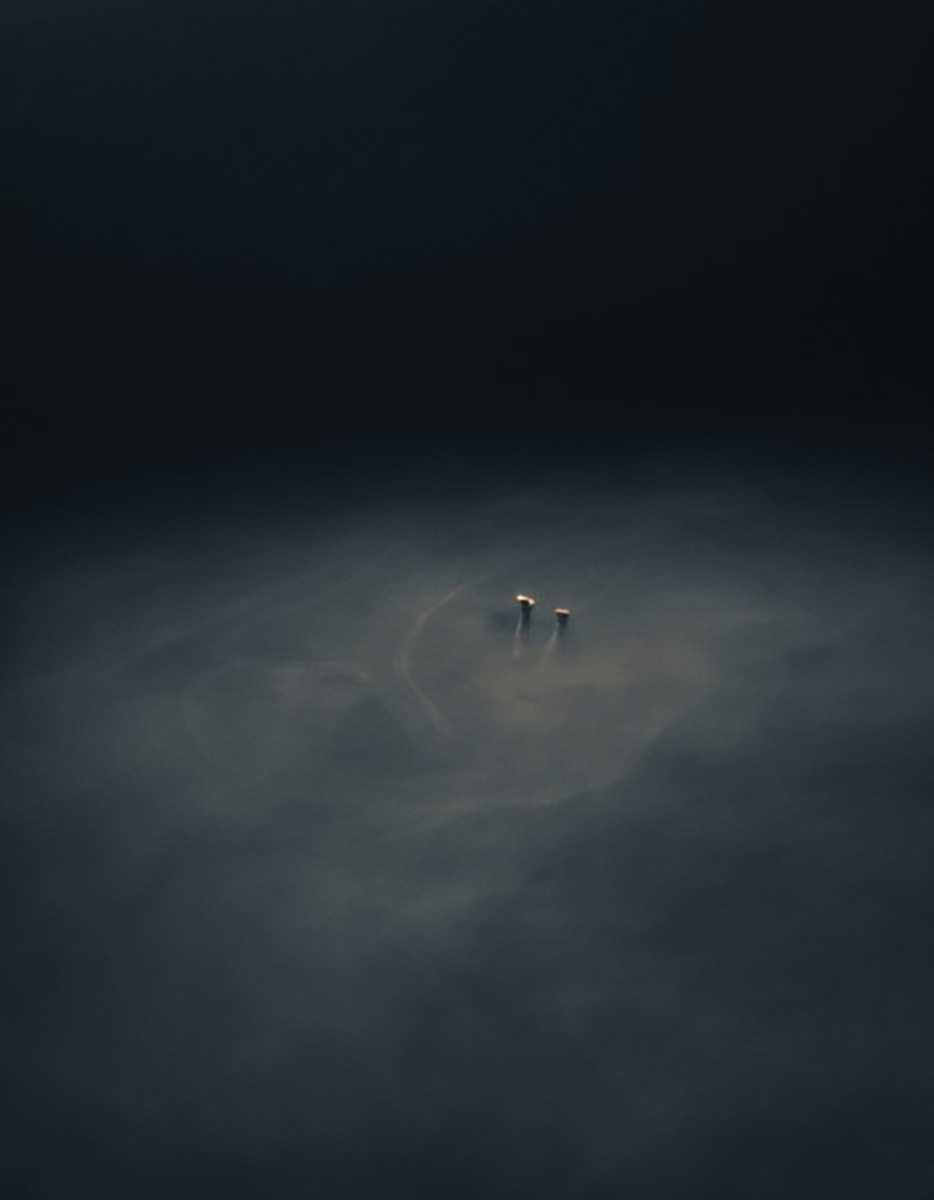
NOWs: Silent World by Julian Charrière
Silent WorldSolo exhibition
DITTRICH & SCHLECHTRIEM
Linienstraße 23
10178 Berlin
Opening: 26 April, 6pm
DITTRICH & SCHLECHTRIEM is pleased to present our fourth solo exhibition with Julian Charrière, titled Silent World opening during GALLERY WEEKEND BERLIN 2019. Charrière (b. 1987, Morges, Switzerland) is a Swiss-French artist based in Berlin whose work bridges the realms of environmental science and cultural history. Through performance, sculpture, photography and video, his projects often stem from fieldwork in remote locations with acute geophysical identities – such as volcanoes, ice-fields and radioactive sites.
Silent World is a meditation on the undersea realm as an oneiric atmosphere: a space that is central to our imagination precisely because of its unfamiliarity and indistinct aspects. Marshalling photography and video, the exhibition stages encounters between human outlines and their visible dissolution. The works include images of free-divers captured inside an aquatic cave in Mexico’s Cenotes, half of their bodies obscured as they penetrate what is known as a chemocline, entering an opaque layer of bottom water—a soup of sulfurous bacteria. Through the iconographic unconscious of these images, the divers’ descent into a literal abyss conjures up a sea of metaphorical allusion. Despite this profusion, however, it is a silent world—as no individual can comprehensively speak for it. Yet that does not stop us from trying. Charrière’s exhibition borrows its title from an early underwater film by Jacques Cousteau, the first of its kind to bring moving images from the ocean depths to screen. Since this important opening-up of the visual imaginary of the undersea realm, consolidated by today’s high-definition broadcast documentaries, it is tempting to think that we (including those who have never practiced scuba) know this place. The fact is, however, that the ocean is largely still mystery. As Charrière’s new work seems to suggest, deeper engagement with this space may yet reorder perceptions of who we are.
Silent World debuts a series of photographs of free divers disappearing into liquid obscurity. Naked and, in pictorial terms, dissolving, his figures physically enter another layer of the ocean imaginary. These are lakes and rivers within oceans; unique micro-biological universes. Contributing to a picture of the oceanic system that has grown significantly more complex in recent decades, such worlds within worlds are relatively recent discoveries. As we come to better understand the sea, domains from evolutionary theory through to climate science are being revolutionized. Sliding into this previously silent (unseen and unthought) realm, Charrière’s free-divers seem caught in some kind of dance; a graceful fall. From where—and to what?
Accompanying the photographs, a ceiling-mounted projector beams video onto a screen lying on the gallery floor, from which vapor emanates: footage of the sun’s rays breaking through the water’s surface, streaming down from above. During filming the camera was positioned looking skyward, towards the light. In terms of spatial orientation, the installation proposes an inverse scenario—whereby the sun occupies a submerged position, shining up from the deep. The conceptual gravity of the gesture is heightened by this reversal. As well as turning down into up, and up into down, fire appears to be present in water. Moreover, the apparently falling divers (in the photographs) may yet be ascending; and the audience, according to this logic, not upright but flipped. Everything has undergone a sea-change.
The ocean is an ancient well of metaphor that has served religious thought and philosophy from the beginning of recorded history. Commonly, it represents an ungraspable magnitude; an infinite. This mystical idea delivers colonial hubris—for how can one expropriate what is seemingly unlimited? How can depths, unfathomable in their vastness, be exhausted; and is there not always another fish in the sea? We are only now being disabused of such ideas. The ocean’s monsters are our own, not animals; and its atmospheres are ours, too. Charrière’s images complement the revelations being developed by the oceanographic and biological sciences. Proposing a deep dive into real things, his exhibition reminds us that this sea is the furthest thing from a metaphysical ideal.
The above is a press text from Nadim Samman. The exhibition catalogue published by the gallery features an essay from Samman titled The Diver, and will be available at the gallery in May.
Silent WorldEinzelausstellung
DITTRICH & SCHLECHTRIEM
Linienstraße 23
10178 Berlin
Eröffnung: 26. April, 18 h
DITTRICH & SCHLECHTRIEM freuen sich, die vierte Einzelausstellung des Künstlers Julian Charrière in unserer Galerie zu präsentieren. Sie trägt den Titel Silent World und eröffnet zum GALLERY WEEKEND BERLIN 2019. Der schweizerisch-französische Künstler Julian Charrière (geb. Morges, Schweiz, 1987), der in Berlin lebt und arbeitet, schafft Werke, die Brücken zwischen Umweltwissenschaft und Kulturgeschichte schlagen. Seine Performances, Skulpturen, Fotografien und Videos umfassenden Projekte entstehen oft aus Feldforschungen an entlegenen Schauplätzen mit besonderen geophysikalischen Profilen wie Vulkanen,
Eisfeldern und radioaktiv verseuchten Orten.
Silent World widmet sich der Unterwasserwelt als einem Reich der Träume: einem Raum, der in unserem Imaginären gerade deshalb einen herausgehobenen Platz einnimmt, weil er so fremdartig und nur schemenhaft erkennbar ist. Mittels Fotografie und Video inszeniert die Ausstellung Begegnungen zwischen den Umrissen menschlicher Körper und ihrer augenfälligen Auflösung. Mehrere Bilder zeigen Freitaucher in einer Cenote, einer mit Wasser gefüllten Höhle in Mexiko, in dem Moment, in dem sie eine sogenannte Chemokline durchdringen; ihre Körper verschwinden zur Hälfte in einer Suppe von Schwefelbakterien. In den Aufnahmen wird ein ikonografisches Unbewusstes wach, das den Tauchgang in einen wahrhaften Höllenschlund zu einem höchst anspielungsreichen Abenteuer werden lässt. Gleichzeitig ist die Welt, die sie zeigen, schweigend, denn über sie zu sprechen übersteigt das Vermögen jedes einzelnen Zeugen. Was nicht heißt, dass Menschen es nicht versucht hätten. Der Titel von Charrières Ausstellung ist einem frühen Unterwasserfilm von Jacques Cousteau entliehen, mit dem bewegte Bilder aus den Tiefen des Ozeans die Kinoleinwände erreichten. Damit war die Tür zur Tiefsee als Ort der Imagination aufgestoßen, die erste Bergung eines Schatzes, den heute Fernsehdokumentationen in hoher Auflösung vor uns ausbreiten, und so sind sogar Zuschauer, die noch nie auch nur einen Tauchkurs gemacht haben, versucht zu meinen, dieser Ort sei ihnen vertraut. In Wirklichkeit haben die Ozeane viele ihrer Geheimnisse bewahrt. Eine eingehendere Auseinandersetzung mit diesem Raum, so legen Charrières neue Arbeiten nahe, könnte auch unsere eigene Identität in ein ganz neues Licht rücken.
In Silent World präsentiert der Künstler eine neue fotografische Serie: Freitaucher, die sich im flüssigen Halbdunkel verlieren. Ihre nackten und, im Bildsinn gesprochen, verschwommenen Figuren dringen in eine neue Tiefenschicht der ozeanischen Vorstellungswelt vor – Seen und Flüsse innerhalb der Meere; einzigartige mikrobiologische Kosmen. Als Beitrag zum in den letzten Jahrzehnten komplexer gewordenen Gesamtbild des ozeanischen Systems sind solche Welten innerhalb von Welten eine recht neue Entdeckung. Unser wachsendes Wissen über die Ozeane hat eine Revolution in zahlreichen Feldern, von der Theorie der Evolution bis hin zur Klimaforschung, ausgelöst. An der Schwelle dieses bisher schweigenden (ungesehenen und ungedachten) Reichs verharren Charrières Taucher in beinahe tänzerischen Posen. Oder fangen die Bilder sie in einem anmutigen Sturz in die Tiefe ein? Woher kommen sie, wohin führt ihr Weg?
Begleitet werden die Fotografien von Videobildern, die ein Projektor unter der Decke auf einen Bildschirm wirft, von dem Dunst aufsteigt: die Strahlen der Sonne, die, durch die Wasseroberfläche gebrochen, in die Tiefe dringen. Für die Aufnahmen wurde die Kamera himmelwärts dem Licht entgegen gerichtet. In der Installation wird diese räumliche Orientierung genau umgekehrt – die Sonne, so scheint es, ist in der Tiefe versunken und leuchtet aus ihr hervor. Die Verkehrung unterstreicht den großen konzeptuellen Ernst der Geste. Unten wird oben, oben wird unten, ein Feuer scheint in der kalten Tiefe zu brennen. Und die scheinbar hinabstürzenden Taucher (in den Fotografien) steigen vielleicht in Wirklichkeit doch auf. Nach dieser Logik jedenfalls ist es am Ende womöglich der Betrachter selbst, der auf dem Kopf steht. Alles ist im Umbruch.
Das Meer ist eine uralte Quelle von Metaphern, deren sich religiöses und philosophisches Denken seit grauer Vorzeit bedient haben. Gemeinhin steht es für eine unfassliche Größe, ein Unendliches. Aus solcher Mystik erwächst koloniale Hybris – denn wie kann man sich aneignen, was endlos scheint? Wie können unermessliche und unergründliche Tiefen ausgeschöpft werden; und sind die Fische in der See nicht ohne Zahl? Wir beginnen zu begreifen, dass wir von dieser Vorstellung Abschied nehmen müssen. Die Monstren des Ozeans sind die unseren, nicht Tiere; auch seine Atmosphären bringen wir mit. Die neuen Einsichten der Ozeanografie und Biologie ergänzen Charrières Bilder, indem sie uns auf einen Tauchgang in die Tiefen der wahren Dinge mitnehmen, der uns daran erinnert, dass die See durchaus kein metaphysisches Ideal ist.
Der oben stehende Pressetext stammt von Nadia Samman. Ein Essay von Samman mit dem Titel Der Taucher wird in dem von der Galerie publizierten Ausstellungskatalog erscheinen, der ab Mai in der Galerie erhältlich sein wird.

NOWs: Auf der Grenze
Auf der GrenzeSolo exhibition by Raul Walch
St.-Matthäus-Kirche
Matthäikirchplatz 1
10785 Berlin
Eröffnung: 25. April 2019, 19:00
Grenzen haben Konjunktur. Seit sich Europa mit einer steigenden Zahl von Schutzsuchenden konfrontiert sieht, werden die Rufe nach „sicheren Außengrenzen“ wieder lauter. Doch was bedeuten Außengrenzen für die europäische Idee? Und was bedeuten sie für Menschen, die eine Zukunft in Europa suchen? Der Berliner Künstler Raul Walch hat sich dreißig Jahre nach dem Berliner Mauerfall auf den Weg an die Ränder Europas gemacht, um an den Außengrenzen nach den Wurzeln Europas zu suchen. Im Kontext seiner künstlerischen Forschung entstanden Fotografien, Stoff- und Flugobjekte, die sich im Kirchenraum der St. Matthäus-Kirche zu einem raumgreifenden Mobile verdichten: Der Balanceakt Europa, die vielteilige Identität eines Kontinents als bewegliche Mindmap über den Köpfen der Kirchenbesucher. Der Kirchenraum, selbst Grenzort zwischen dem Sichtbaren und dem Unsichtbaren, dem Profanen und dem Heiligen, zwischen Kunst und Kirche, wird zum Dreh- und Angelpunkt der Frage nach einem Zusammenleben der Vielen im Gleichgewicht.
Begleitprogramm zur Ausstellung:
28.04., 12 Uhr | Matinée und Artist Talk am Gallery Weekend
24.05., 19 Uhr | Diskussion „Über Grenzen. Künstlerische Perspektiven auf Europa“ am „Tag der Nachbarn“ mit u.a. Lutz Henke, Kurator, Rebecca Harms, MdEP, dem Journalisten Dr. Paul Ingendaay und Raul Walch
Auf der GrenzeEinzelausstellung von Raul Walch
St.-Matthäus-Kirche
Matthäikirchplatz 1
10785 Berlin
Eröffnung: 25. April 2019, 19:00
Grenzen haben Konjunktur. Seit sich Europa mit einer steigenden Zahl von Schutzsuchenden konfrontiert sieht, werden die Rufe nach „sicheren Außengrenzen“ wieder lauter. Doch was bedeuten Außengrenzen für die europäische Idee? Und was bedeuten sie für Menschen, die eine Zukunft in Europa suchen? Der Berliner Künstler Raul Walch hat sich dreißig Jahre nach dem Berliner Mauerfall auf den Weg an die Ränder Europas gemacht, um an den Außengrenzen nach den Wurzeln Europas zu suchen. Im Kontext seiner künstlerischen Forschung entstanden Fotografien, Stoff- und Flugobjekte, die sich im Kirchenraum der St. Matthäus-Kirche zu einem raumgreifenden Mobile verdichten: Der Balanceakt Europa, die vielteilige Identität eines Kontinents als bewegliche Mindmap über den Köpfen der Kirchenbesucher. Der Kirchenraum, selbst Grenzort zwischen dem Sichtbaren und dem Unsichtbaren, dem Profanen und dem Heiligen, zwischen Kunst und Kirche, wird zum Dreh- und Angelpunkt der Frage nach einem Zusammenleben der Vielen im Gleichgewicht.
Begleitprogramm zur Ausstellung:
28.04., 12 Uhr | Matinée und Artist Talk am Gallery Weekend
24.05., 19 Uhr | Diskussion „Über Grenzen. Künstlerische Perspektiven auf Europa“ am „Tag der Nachbarn“ mit u.a. Lutz Henke, Kurator, Rebecca Harms, MdEP, dem Journalisten Dr. Paul Ingendaay und Raul Walch
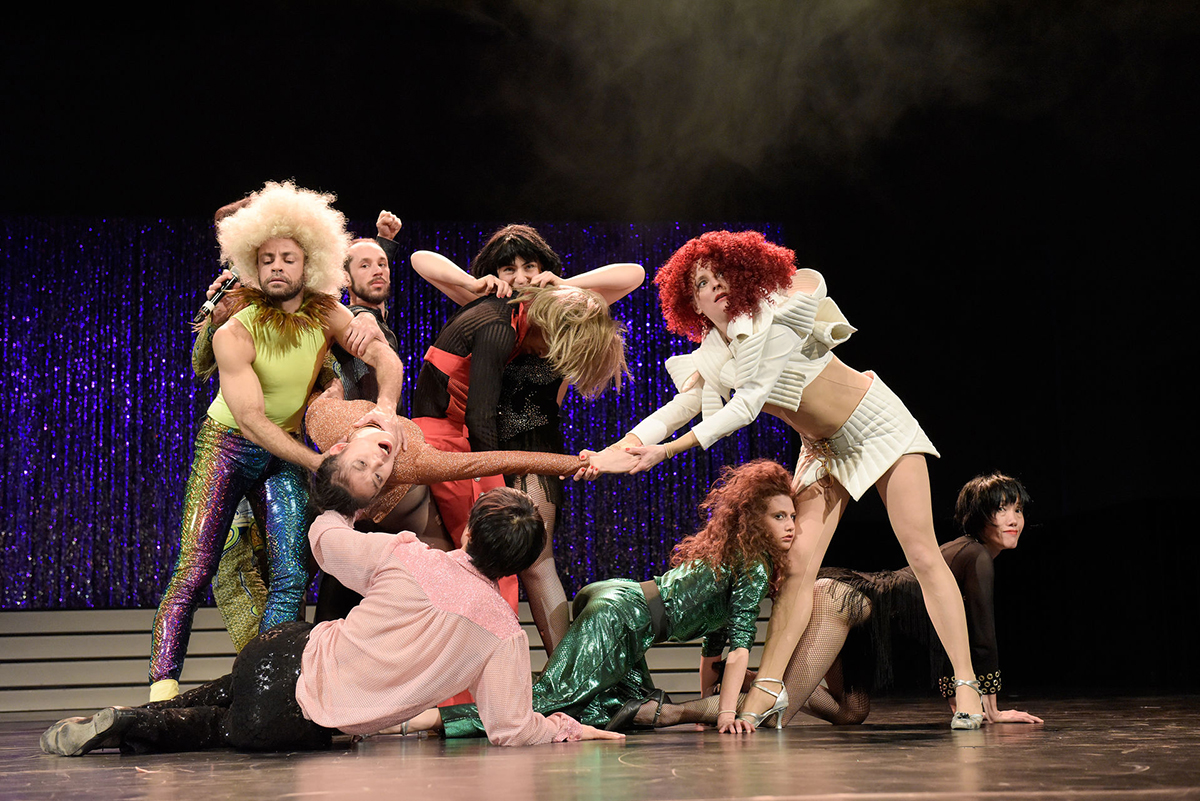
NOWs: Der Palast
Foto: Thomas Aurin
Der PalastTanztheater von Constanza Macras / DorkyPark
Volksbühne Berlin
Linienstraße 227
10178 Berlin
Premiere 4. April, 20:00
Mit sieben Tänzer*innen, drei Schauspieler*innen und drei Musiker*innen erarbeiten Constanza Macras und ihr Ensemble DorkyPark ein Stück, das sich unter dem Titel Der Palast mit der Stadt Berlin beschäftigt, die als „Global City“ (Saskia Sassen) besonders von den radikalen Veränderungen der Globalisierung betroffen ist.
Die Entwicklung der Mitte Berlins seit dem Mauerfall ist allseits bekannt: Leerstehende, zerrüttete Altbauten wurden von einer jungen Generation besetzt und bespielt. In den Folgejahren wurde Lebensraum knapp, die Wohn- und Lebenskosten stiegen massiv an, die einstigen Pioniere und ihre Nachfolger*innen wurden aus ihren Vierteln verdrängt. Was macht das mit der Kultur, wenn Viertel sich verändern, Geschäfte schließen und Menschen zwangsgeräumt werden?
Der Palast setzt sich mit dieser Problematik auseinander, indem es einerseits die Architektur in Berlins Mitte thematisiert, andererseits Geschichte, Gegenwart und Zukunftsvorstellungen der Stadt und ihrer Bewohner*innen behandelt. Ausgangspunkt sind Bilder des preisgekrönten englischen Fotografen Tom Hunter, der als Visual Artist der Produktion im Februar u.a. in Berlin-Weißensee, Rummelsburg, Kreuzberg und in der Volksbühne fotografiert hat. Bekannt geworden ist Tom Hunter mit Porträts, die gesellschaftliche Themen im Stil der Alten Meister inszenieren. So hat er sich in seiner Serie „Persons Unknown“ intensiv mit der britischen Hausbesetzer*innen-Szene auseinandergesetzt, indem er die von Zwangsräumungen betroffenen Menschen ins Bild gesetzt hat.
Seine Berliner Fotografien treffen in Der Palast auf eine ausufernde Bühnenbild-Architektur, die das globalisierte Format der Reality-TV-Shows mit Juroren und konkurrierenden Teilnehmer*innen widerspiegelt. In diesem Spannungsverhältnis möchte Der Palast neue Narrative zwischen Fiktion und Realität entwickeln. Der Soundtrack stammt von Robert Lippok und einer Live-Band.
Weitere Vorstellungen:
14. April, 20:00
16. Mai, 20:00
17. Mai, 20:00
Von und mit: Adaya Berkovich, Emil Bordás, Chia-Ying Chiang, Fernanda Farah, Yuya Fujinami, Luc Guiol, Ronni Maciel, Thulani Lord Mgidi, Anne Ratte-Polle, Miki Shoji
Live-Musik von und mit: Santiago Blaum, Kristina Lösche-Löwensen, Jacob Thein
Regie und Choreografie: Constanza Macras
Visual Artist: Tom Hunter
Komposition: Robert Lippok
Bühne: Alissa Kolbusch
Kostüme: Roman Handt
Lichtdesign: Sergio de Carvalho Pessanha
Ton: Stephan Wöhrmann
Dramaturgie: Carmen Mehnert
Produktionsmanagement: Alisa Golomzina, Xiao Yu, Keiko Tominaga
Regieassistenz: Helena Casas
Eine Produktion von Constanza Macras / DorkyPark in Koproduktion mit der Volksbühne Berlin.
Constanza Macras / DorkyPark wird gefördert von der Senatsverwaltung für Kultur und Europa.
Foto: Thomas Aurin
Der PalastTanztheater von Constanza Macras / DorkyPark
Volksbühne Berlin
Linienstraße 227
10178 Berlin
Premiere 4. April, 20:00
Mit sieben Tänzer*innen, drei Schauspieler*innen und drei Musiker*innen erarbeiten Constanza Macras und ihr Ensemble DorkyPark ein Stück, das sich unter dem Titel Der Palast mit der Stadt Berlin beschäftigt, die als „Global City“ (Saskia Sassen) besonders von den radikalen Veränderungen der Globalisierung betroffen ist.
Die Entwicklung der Mitte Berlins seit dem Mauerfall ist allseits bekannt: Leerstehende, zerrüttete Altbauten wurden von einer jungen Generation besetzt und bespielt. In den Folgejahren wurde Lebensraum knapp, die Wohn- und Lebenskosten stiegen massiv an, die einstigen Pioniere und ihre Nachfolger*innen wurden aus ihren Vierteln verdrängt. Was macht das mit der Kultur, wenn Viertel sich verändern, Geschäfte schließen und Menschen zwangsgeräumt werden?
Der Palast setzt sich mit dieser Problematik auseinander, indem es einerseits die Architektur in Berlins Mitte thematisiert, andererseits Geschichte, Gegenwart und Zukunftsvorstellungen der Stadt und ihrer Bewohner*innen behandelt. Ausgangspunkt sind Bilder des preisgekrönten englischen Fotografen Tom Hunter, der als Visual Artist der Produktion im Februar u.a. in Berlin-Weißensee, Rummelsburg, Kreuzberg und in der Volksbühne fotografiert hat. Bekannt geworden ist Tom Hunter mit Porträts, die gesellschaftliche Themen im Stil der Alten Meister inszenieren. So hat er sich in seiner Serie „Persons Unknown“ intensiv mit der britischen Hausbesetzer*innen-Szene auseinandergesetzt, indem er die von Zwangsräumungen betroffenen Menschen ins Bild gesetzt hat.
Seine Berliner Fotografien treffen in Der Palast auf eine ausufernde Bühnenbild-Architektur, die das globalisierte Format der Reality-TV-Shows mit Juroren und konkurrierenden Teilnehmer*innen widerspiegelt. In diesem Spannungsverhältnis möchte Der Palast neue Narrative zwischen Fiktion und Realität entwickeln. Der Soundtrack stammt von Robert Lippok und einer Live-Band.
Weitere Vorstellungen:
14. April, 20:00
16. Mai, 20:00
17. Mai, 20:00
Von und mit: Adaya Berkovich, Emil Bordás, Chia-Ying Chiang, Fernanda Farah, Yuya Fujinami, Luc Guiol, Ronni Maciel, Thulani Lord Mgidi, Anne Ratte-Polle, Miki Shoji
Live-Musik von und mit: Santiago Blaum, Kristina Lösche-Löwensen, Jacob Thein
Regie und Choreografie: Constanza Macras
Visual Artist: Tom Hunter
Komposition: Robert Lippok
Bühne: Alissa Kolbusch
Kostüme: Roman Handt
Lichtdesign: Sergio de Carvalho Pessanha
Ton: Stephan Wöhrmann
Dramaturgie: Carmen Mehnert
Produktionsmanagement: Alisa Golomzina, Xiao Yu, Keiko Tominaga
Regieassistenz: Helena Casas
Eine Produktion von Constanza Macras / DorkyPark in Koproduktion mit der Volksbühne Berlin.
Constanza Macras / DorkyPark wird gefördert von der Senatsverwaltung für Kultur und Europa.

NOWs: Rune Bosse at The Hirschsprung Collection
Down to earth.Danish painting 1780-1920 and landscapes of the anthropocene
The Hirschsprung Collection
Stockholmsgade 20
2100 København Ø
Down to Earth is a visionary exhibition, which brings art and the natural sciences together to discuss one of the most urgent questions of our times. In the exhibition, the question of what we are doing to our planet is asked through a historical reflection of how we got to this precarious moment.
The landscape, nature, and our surroundings have changed dramatically in the last 200 years. We live in the Anthropocene Epoch, in which humanity’s impact on nature has run so deep as to have left its own geological traces. Down to Earth shows us how, as early as the nineteenth century, landscape painting and the natural sciences were already working together to document and interpret the landscape’s profound transformation.
The two renowned contemporary artists Rune Bosse and Camilla Berner add a current dimension to the subject with new works that are locally anchored and site-specific.
This exhibition is a collaboration between Faaborg Museum, Fuglsang Kunstmuseum, the Ribe Art Museum and The Hirschsprung Collection, Copenhagen. The exhibition is curated by Gry Hedin (Faaborg Museum), Gertrud Oelsner (The Hirschsprung Collection), and Thor J. Mednick (University of Toledo).
Down to earth.Danish painting 1780-1920 and landscapes of the anthropocene
The Hirschsprung Collection
Stockholmsgade 20
2100 København Ø
Down to Earth is a visionary exhibition, which brings art and the natural sciences together to discuss one of the most urgent questions of our times. In the exhibition, the question of what we are doing to our planet is asked through a historical reflection of how we got to this precarious moment.
The landscape, nature, and our surroundings have changed dramatically in the last 200 years. We live in the Anthropocene Epoch, in which humanity’s impact on nature has run so deep as to have left its own geological traces. Down to Earth shows us how, as early as the nineteenth century, landscape painting and the natural sciences were already working together to document and interpret the landscape’s profound transformation.
The two renowned contemporary artists Rune Bosse and Camilla Berner add a current dimension to the subject with new works that are locally anchored and site-specific.
This exhibition is a collaboration between Faaborg Museum, Fuglsang Kunstmuseum, the Ribe Art Museum and The Hirschsprung Collection, Copenhagen. The exhibition is curated by Gry Hedin (Faaborg Museum), Gertrud Oelsner (The Hirschsprung Collection), and Thor J. Mednick (University of Toledo).

NOWs: Unruhig bleiben / Staying with the trouble
Theatre play by Donna Haraway
Zitadelle, Bastion Kronprinz
Am Juliusturm 64
13599 Berlin
Premiere 8 May, 7pm
How can we reshape living together on a damaged planet? From the early 21st century, the communities of “compostists” committed themselves to radically reducing the world’s human population and developing countless practices of cross-species environmental justice. STAYING WITH THE TROUBLE follows five generations of a symbiosis between the human child Camille and monarch butterflies between the year 2025 and 2425. Much unrest, much kinship, to carry on.
Directed by Carlos Manuel
Set design / Installation / Video: Anne Duk Hee Jordan
Sound Objects / Composition: Mathias Hinke
Costumes: Verena Hay
Performers: Fernanda Farah, Franziska Ritter, Helmut Geffke and Josep Caballero Garcia
14 years and older. Registration at: schreiner@jtw-spandau.de
Further performances:Do 09. Mai, 19:00Sa 18. Mai, 19:00So 19. Mai, 16:00Mo 20. Mai, 11:00Do 23. Mai, 19:00Fr 24. Mai, 19:00Sa 25. Mai, 19:00 (mit Audio-Deskription und Gebärden-Übersetzung (Bühnenführung um 18Uhr)Mo 27. Mai, 11:00Mi 29. Mai, 19:00 (im Rahmen des PAF, Performing Art Festival Berlin)
The installation by Anne Duk Hee Jordan is on view daily from 09 until 29 May (11am – 5pm)
Das Performing Arts Festival Berlin 2019 wird veranstaltet vom LAFT Berlin in Kooperation mit den Spielstätten Ballhaus Ost, Hau Hebbel am Ufer, Sophiensaele und Theaterdiscounter und wird gefördert durch das Land Berlin – Senatsverwaltung für Kultur und Europa.
Gefördert vom Senat Berlin
Eine Kooperation des Kulturamts Spandau und der JTW Spandau
Theatre play by Donna Haraway
Zitadelle, Bastion Kronprinz
Am Juliusturm 64
13599 Berlin
Premiere 8. Mai, 19:00
Wie können wir das Zusammenleben auf einem beschädigten Planeten neu gestalten?
Die Gemeinschaften der „Kompostisten“ bekannten sich ab dem frühen 21. Jahrhundert dazu,
die menschliche Weltbevölkerung radikal zu verringern und unzählige Praktiken artenübergreifender Umweltgerechtigkeit zu entwickeln. UNRUHIG BLEIBEN verfolgt fünf Generationen einer Symbiose zwischen dem Menschenkind Camille und Monarchfaltern und begleitet sie zwischen der Geburt von Camille 1 im Jahr 2025 und dem Tod von Camille 5 im Jahr 2425. Viel Unruhe, viel Verwandtschaft, um weiterzumachen.
Regie: Carlos Manuel
Rauminstallation / Bühnenbild: Anne Duk Hee Jordan
Musik: Mathias Hinke
Kostüme: Verena Hay
Darsteller*innen: Fernanda Farah, Franziska Ritter, Helmut Geffke und Josep Caballero Garcia
Ab 14 Jahren. Um Anmeldung wird gebeten: schreiner@jtw-spandau.de
Weitere Vorstellungen:Do 09. Mai, 19:00Sa 18. Mai, 19:00So 19. Mai, 16:00Mo 20. Mai, 11:00Do 23. Mai, 19:00Fr 24. Mai, 19:00Sa 25. Mai, 19:00 (mit Audio-Deskription und Gebärden-Übersetzung (Bühnenführung um 18Uhr)Mo 27. Mai, 11:00Mi 29. Mai, 19:00 (im Rahmen des PAF, Performing Art Festival Berlin)
Die Installation von Anne Duk Hee Jordan ist vom 09.05. bis 29.05. zwischen 11h und 17h zu sehen.
Das Performing Arts Festival Berlin 2019 wird veranstaltet vom LAFT Berlin in Kooperation mit den Spielstätten Ballhaus Ost, Hau Hebbel am Ufer, Sophiensaele und Theaterdiscounter und wird gefördert durch das Land Berlin – Senatsverwaltung für Kultur und Europa.
Gefördert vom Senat Berlin
Eine Kooperation des Kulturamts Spandau und der JTW Spandau

NOWs: Exploding Rock Videos – How Two Berlin Artists Fooled American Media
Exploding Rock Videos: How Two Berlin Artists Fooled American MediaArticle about art project by Julius von Bismarck and Julian Charrière in DIE WELT. By Swantje Karich
Two Berlin artists have produced videos of exploding rock arches and hoodoos in Utah – and fooled American media from CNN to FOX and even the FBI. Read the full article here.
Vermeintliche Anschläge in USA: Der große Bluff in der Ära der HalbwahrheitenArtikel über Kunstprojekt von Julius von Bismarck und Julian Charrière in DIE WELT. Von Swantje Karich
Zwei Berliner Künstler haben amerikanische Medien von CNN bis FOX mit Filmen über gesprengte Naturdenmäler getäuscht. Und auch das FBI. Lies den vollständigen Artikel hier.
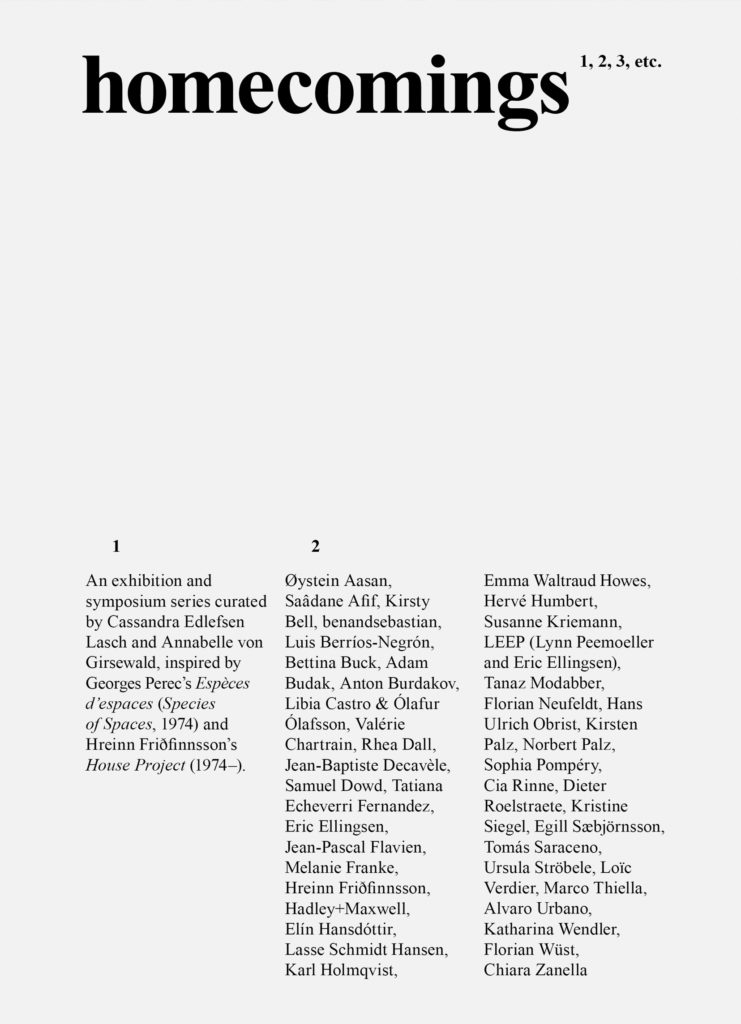
NOWs: homecomings 1, 2, 3, etc.
homecomings 1, 2, 3, etc.book launch
CHANGING ROOM
Lüderitzstr. 11
2nd yard
13351 Berlin
6 April, 6pm
Readings and performances will start at 6:30 pm
1
Inspired by Georges Perec’s Espèces d’espaces (Species of Spaces, 1974) and Hreinn Friðfinnsson’s House Project (1974–), homecomings 1, 2, 3, etc. revisits, through varying means of translation, spatial and conceptual loci of homecoming within artistic practice.
2
Published with Archive Books, Berlin and curated and edited by Cassandra Edlefsen Lasch and Annabelle von Girsewald, the publication features contributions by:
Øystein Aasan, Saâdane Afif, Kirsty Bell, benandsebastian, Luis Berríos-Negrón, Bettina Buck, Adam Budak, Anton Burdakov, Libia Castro & Ólafur Ólafsson, Valérie Chartrain, Rhea Dall, Jean-Baptiste Decavèle, Samuel Dowd, Tatiana Echeverri Fernandez, Eric Ellingsen, Jean-Pascal Flavien, Melanie Franke, Hreinn Friðfinnsson, Hadley+Maxwell, Elín Hansdóttir, Lasse Schmidt Hansen, Karl Holmqvist, Emma Waltraud Howes, Hervé Humbert, Susanne Kriemann, LEEP (Lynn Peemoeller and Eric Ellingsen), Tanaz Modabber, Florian Neufeldt, Hans Ulrich Obrist, Kirsten Palz, Norbert Palz, Sophia Pompéry, Cia Rinne, Dieter Roelstraete, Kristine Siegel, Egill Sæbjörnsson, Tomás Saraceno, Ursula Ströbele, Loïc Verdier, Marco Thiella, Alvaro Urbano, Katharina Wendler, Florian Wüst, Chiara Zanella
3
The book launch features a series of readings and performances by, among others:
Shane Anderson
Samuel Dowd
Tatiana Echeverri Fernandez
Susanne Kriemann & Cia Rinne
etc.
The exhibition and symposium series, homecomings, from which this publication stems, draws its principle inspiration from the architectural and linguistic returns and repetitions punctuating artist Hreinn Friðfinnsson’s House Project (1974–) and author Georges Perec’s Espèces d’espaces (Species of Spaces, 1974).
In 1974, through an ephemeral gesture, Friðfinnsson claimed the whole universe within the site of a small house, turned inside-out, in the middle of an Icelandic lava field. Encountered only through happenstance or hearsay, a timeless lore grew around the house. House Project became a resonating series of works, appearing in multiple iterations, inversions, and reductions in form. Also in 1974, Georges Perec set out to approach the topic of space, creating a telescopic “journal of a user of space” by layering deliberate and protracted observation with writing constraints and wordplay. Perec starts with the page and zooms outward to space itself, always mirroring and reflecting the influx of the everyday in his call to read and reread surrounding spaces.
Testing the concept of “homecomings” against a number of artistic practices, this volume grows out of an imperative to act according to the referentiality hallmarked in the conceptually rigorous works of Friðfinnsson and Perec. homecomings 1, 2, 3, etc. opens a flood of personal wellsprings, where no two connotations align perfectly. The collected contributions oscillate between self-referential modes—creating full-circle loops within singular practices—and far-reaching trajectories, gaining momentum and associations upon every rereading. Like Perec, many works call for an attuned presence, and in so doing, proffer a homecoming at the very site of reading.
Order the publication online here
*
CHANGING ROOM / Wedding: is a new project space focusing on sound art and performance. The programming consists of interdisciplinary projects based on sound art, speech/voice, and movement and offers talks, performances, and deep listening sessions on a regular basis. CHANGING ROOM is situated in a former horse stable on Lüderitzstraße in Berlin Wedding’s African Quarter, which will soon be renamed to Cornelius-Frederiks-Straße.
homecomings 1, 2, 3, etc.book launch
CHANGING ROOM
Lüderitzstr. 11
2nd yard
13351 Berlin
6 April, 6pm
Readings and performances will start at 6:30 pm
1
Inspired by Georges Perec’s Espèces d’espaces (Species of Spaces, 1974) and Hreinn Friðfinnsson’s House Project (1974–), homecomings 1, 2, 3, etc. revisits, through varying means of translation, spatial and conceptual loci of homecoming within artistic practice.
2
Published with Archive Books, Berlin and curated and edited by Cassandra Edlefsen Lasch and Annabelle von Girsewald, the publication features contributions by:
Øystein Aasan, Saâdane Afif, Kirsty Bell, benandsebastian, Luis Berríos-Negrón, Bettina Buck, Adam Budak, Anton Burdakov, Libia Castro & Ólafur Ólafsson, Valérie Chartrain, Rhea Dall, Jean-Baptiste Decavèle, Samuel Dowd, Tatiana Echeverri Fernandez, Eric Ellingsen, Jean-Pascal Flavien, Melanie Franke, Hreinn Friðfinnsson, Hadley+Maxwell, Elín Hansdóttir, Lasse Schmidt Hansen, Karl Holmqvist, Emma Waltraud Howes, Hervé Humbert, Susanne Kriemann, LEEP (Lynn Peemoeller and Eric Ellingsen), Tanaz Modabber, Florian Neufeldt, Hans Ulrich Obrist, Kirsten Palz, Norbert Palz, Sophia Pompéry, Cia Rinne, Dieter Roelstraete, Kristine Siegel, Egill Sæbjörnsson, Tomás Saraceno, Ursula Ströbele, Loïc Verdier, Marco Thiella, Alvaro Urbano, Katharina Wendler, Florian Wüst, Chiara Zanella
3
The book launch features a series of readings and performances by, among others:
Shane Anderson
Samuel Dowd
Tatiana Echeverri Fernandez
Susanne Kriemann & Cia Rinne
etc.
The exhibition and symposium series, homecomings, from which this publication stems, draws its principle inspiration from the architectural and linguistic returns and repetitions punctuating artist Hreinn Friðfinnsson’s House Project (1974–) and author Georges Perec’s Espèces d’espaces (Species of Spaces, 1974).
In 1974, through an ephemeral gesture, Friðfinnsson claimed the whole universe within the site of a small house, turned inside-out, in the middle of an Icelandic lava field. Encountered only through happenstance or hearsay, a timeless lore grew around the house. House Project became a resonating series of works, appearing in multiple iterations, inversions, and reductions in form. Also in 1974, Georges Perec set out to approach the topic of space, creating a telescopic “journal of a user of space” by layering deliberate and protracted observation with writing constraints and wordplay. Perec starts with the page and zooms outward to space itself, always mirroring and reflecting the influx of the everyday in his call to read and reread surrounding spaces.
Testing the concept of “homecomings” against a number of artistic practices, this volume grows out of an imperative to act according to the referentiality hallmarked in the conceptually rigorous works of Friðfinnsson and Perec. homecomings 1, 2, 3, etc. opens a flood of personal wellsprings, where no two connotations align perfectly. The collected contributions oscillate between self-referential modes—creating full-circle loops within singular practices—and far-reaching trajectories, gaining momentum and associations upon every rereading. Like Perec, many works call for an attuned presence, and in so doing, proffer a homecoming at the very site of reading.
Order the publication online here
*
CHANGING ROOM / Wedding: is a new project space focusing on sound art and performance. The programming consists of interdisciplinary projects based on sound art, speech/voice, and movement and offers talks, performances, and deep listening sessions on a regular basis. CHANGING ROOM is situated in a former horse stable on Lüderitzstraße in Berlin Wedding’s African Quarter, which will soon be renamed to Cornelius-Frederiks-Straße.
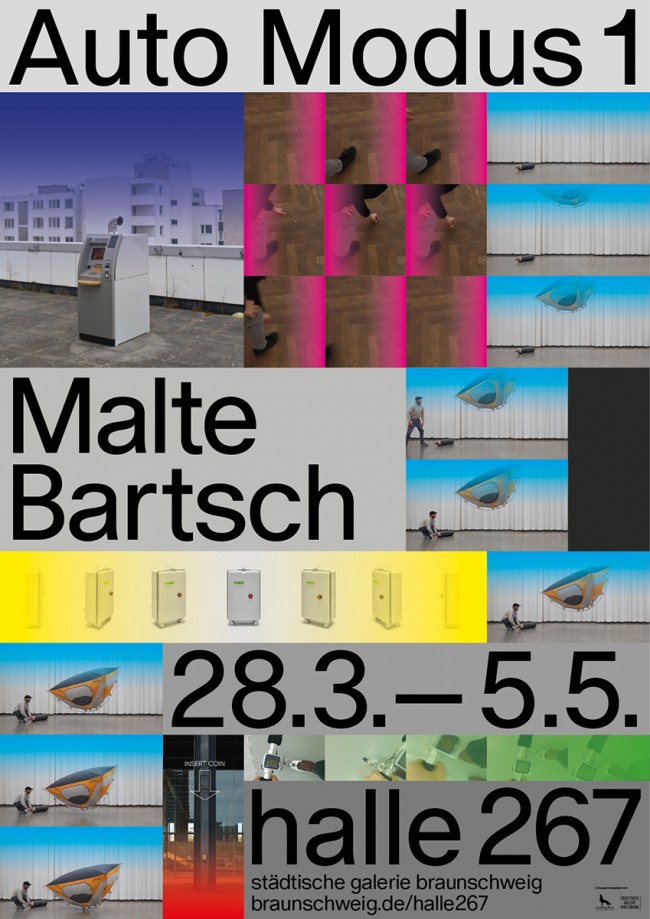
NOWs: Auto Modus 1 by Malte Bartsch
Auto Modus 1Solo Exhibition
halle267 – städtische galerie braunschweig
Hamburger Straße 267
38114 Braunschweig
Eröffnung
28. März 2019, 19 h
Eröffnung: Dr. Anja Hesse (Dezernentin für Kultur und Wissenschaft der Stadt Braunschweig)
Grußwort: Dr. Susanne Pfleger (Direktorin der Städtischen Galerie Wolfsburg)
Einführung: Marcus Körper & Malte Bartsch im Dialog
Gemeinsam präsentieren die „Städtische Galerie Wolfsburg“ und die „halle267 – städtische galerie braunschweig“ die erste große institutionelle Einzelausstellung mit Werken des Künstlers Malte Bartsch. Der Fokus der Ausstellungen liegt auf dem Spannungsverhältnis zwischen Mensch und Technik, Zeit und Raum, künstlerischer Aktion und kunstschaffender Interaktion.
Malte Bartschs situative, kommunikative und spontane Art sind wichtiges Merkmal seiner künstlerischen Arbeit. Die Ergebnisse seiner Erkundungen sind weniger ausgestellte Kunstwerke als eher von Anfang an dialogische Vorgänge und Interventionen.
Malte Bartsch ist in Braunschweig geboren und aufgewachsen. Nach dem Studium der Humangeographie und Ökonomie begann er 2009 sein Studium der Freien Kunst an der HBK Braunschweig bei Boromir Eckes. 2012 wechselte er an das Institut für Raumexperimente in die Klasse von Olafur Eliasson an die UDK Berlin. Er erlangte dort 2014 den Absolvententitel bei Olafur Eliasson und 2015 den Meisterschülertitel bei Manfred Pernice.
Detaillierte Informationen zum Begleitprogramm hier.
Veranstalter:
Stadt Braunschweig, Dezernat für Kultur und Wissenschaft
Fachbereich Kultur und Wissenschaft – Kulturinstitut
Auto Modus 1Einzelausstellung
halle267 – städtische galerie braunschweig
Hamburger Straße 267
38114 Braunschweig
Eröffnung
28. März 2019, 19 h
Eröffnung: Dr. Anja Hesse (Dezernentin für Kultur und Wissenschaft der Stadt Braunschweig)
Grußwort: Dr. Susanne Pfleger (Direktorin der Städtischen Galerie Wolfsburg)
Einführung: Marcus Körper & Malte Bartsch im Dialog
Gemeinsam präsentieren die „Städtische Galerie Wolfsburg“ und die „halle267 – städtische galerie braunschweig“ die erste große institutionelle Einzelausstellung mit Werken des Künstlers Malte Bartsch. Der Fokus der Ausstellungen liegt auf dem Spannungsverhältnis zwischen Mensch und Technik, Zeit und Raum, künstlerischer Aktion und kunstschaffender Interaktion.
Malte Bartschs situative, kommunikative und spontane Art sind wichtiges Merkmal seiner künstlerischen Arbeit. Die Ergebnisse seiner Erkundungen sind weniger ausgestellte Kunstwerke als eher von Anfang an dialogische Vorgänge und Interventionen.
Malte Bartsch ist in Braunschweig geboren und aufgewachsen. Nach dem Studium der Humangeographie und Ökonomie begann er 2009 sein Studium der Freien Kunst an der HBK Braunschweig bei Boromir Eckes. 2012 wechselte er an das Institut für Raumexperimente in die Klasse von Olafur Eliasson an die UDK Berlin. Er erlangte dort 2014 den Absolvententitel bei Olafur Eliasson und 2015 den Meisterschülertitel bei Manfred Pernice.
Detaillierte Informationen zum Begleitprogramm hier.
Veranstalter:
Stadt Braunschweig, Dezernat für Kultur und Wissenschaft
Fachbereich Kultur und Wissenschaft – Kulturinstitut
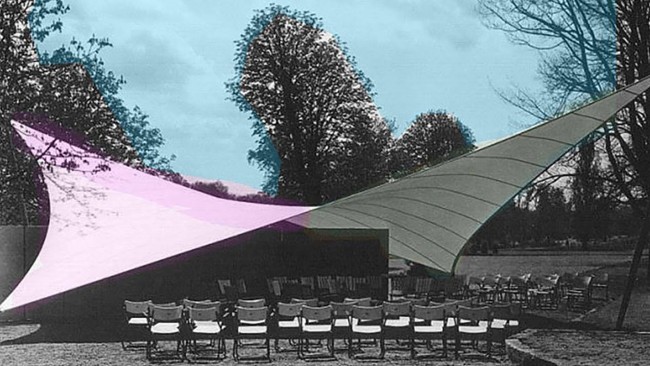
NOWs: New Dresden setzt Segel_Workshop mit Raul Walch
New Dresden setzt SegelWorkshop with Raul Walch
Montagscafé
Glacisstraße 28
01099 Dresden
Part III
25 March, 5 pm
Frei Otto erfand 1955 das Vierpunktzelt, das uns als Modell für eine neue Projektreihe stehen soll: Zusammen mit dem Berliner Künstler Raul Walch werden wir in mehreren Etappen bis zum Sommer einen eigenen Montagscafé-Pavillon entwerfen und realisieren. Bereits im letzten November haben wir mit Raul Walch diverse Fahnen fürs Montagscafé angefertigt, die wir an den jeweiligen Montagen ebenfalls fertigstellen wollen. Kommt, näht, plant und entwerft mit uns ein neues Objekt für den öffentlichen Raum!
Montagscafé – Refugees are welcome here
Ein offener Treffpunkt für Geflüchtete und Einheimische jeden Montag ab 15 Uhr im Kleinen Haus. Kommt vorbei!
New Dresden setzt SegelWorkshop mit Raul Walch
Montagscafé
Glacisstraße 28
01099 Dresden
Teil III
25. März, 17 h
Frei Otto erfand 1955 das Vierpunktzelt, das uns als Modell für eine neue Projektreihe stehen soll: Zusammen mit dem Berliner Künstler Raul Walch werden wir in mehreren Etappen bis zum Sommer einen eigenen Montagscafé-Pavillon entwerfen und realisieren. Bereits im letzten November haben wir mit Raul Walch diverse Fahnen fürs Montagscafé angefertigt, die wir an den jeweiligen Montagen ebenfalls fertigstellen wollen. Kommt, näht, plant und entwerft mit uns ein neues Objekt für den öffentlichen Raum!
Montagscafé – Refugees are welcome here
Ein offener Treffpunkt für Geflüchtete und Einheimische jeden Montag ab 15 Uhr im Kleinen Haus. Kommt vorbei!

NOWs: Art + Landscape STL at Granite City Art and Design District
Art + Landscape STLshort-term laboratory
Granite City, Illinois, USA
Art + Landscape STL is an intensive, short-term laboratory for St. Louis-based artists and designers working at the intersection of art and landscape.
Emerging from an ongoing series of private discussions and excursions, the project is anchored by a public exhibition, Art + Landscape STL, installed throughout G-CADD’s campus and unfolding through five weekends of programs on-site—performances, talks, walks, and more.
Participants: Michael Allen, Betsy Brandt, Christopher Carl, Jennifer Colten, Sage Dawson, Eric Ellingsen, Meghan Grubb, Derek Hoeferlin, Shabez Jamal, Gavin Kroeber, Yowshien Kuo, Aaron Owens, Tim Portlock, Jenny Price, Katherine Simóne Reynolds, Allana Ross, Micah Stanek, Rory Thibault, Westhaven Ensemble, and Rachel Youn. The project is organized by Gavin Kroeber.
The exhibition will be open select days from Sunday 10 March to Saturday 6 April as follows:
Sunday 10 March
5-8pm Special Event: Mississippi. An Anthropocene River
Presented in partnership with HKW (Haus der Kulturen der Welt, Berlin) and the Max Planck Institute (Berlin) as part of their wider initiative Mississippi. An Anthropocene River.
5pm Exhibition opens
6pm Public Dialogue: Confluences with HKW and Art + Landscape STL
7pm How Not What: Power, Time & Landscape | Performance by Michael Allen
*HKW will additionally be organizing an 11am public program, Anthropocene. Archaeology of the Present at Cahokia Mounds World Heritage Site.
Saturday 16 March
6-10pm Opening Celebration + STNDRD reception
7pm Public Dialogue: Curating the Landscape with Gavin Kroeber, Michael Behle, Jessi Cerutti, Kristin Fleischmann Brewer, Charis Norell, Dana Turkovic
Ambient Performances by Betsy Brandt
Saturday 23 March
1-5pm
1pm Public Dialogue: Locating the Human. Contemporary Landscape as Eco Art with Ila Sheren
2pm Poetry Readings curated by Ted Mathys
With Eric Ellingsen, Jacqui Germain, David Alejandro Hernandez, Devin Johnston, Dana Levin, Aditi Machado, Ted Mathys
3pm Scaping Habitus | Workshop with Esther & Beth Neff (MARSH)
4pm Public Dialogue: Art + Landscape Roundtable
Ambient Performances by Betsy Brandt
Thursday 28 March
6-7:30 pm Special Off-Site Event: Cocktails & Conversation at Laumeier Sculpture Park
6pm Conversation with Art + Landscape STL participating artists Christopher Carl, Sage Dawson, Meghan Grubb, Yowshien Kuo, and Allana Ross
Saturday 30 March
1-5 pm
1pm Public Dialogue: Landscapes of Belonging
2pm the heartland landscape in the time of Rulers | Performance by Eric Ellingsen
3pm NNN Cook “Coordinates Checker (Traverse)” 2019 | Sound Performances
4pm Public Dialogue: Art + Landscape Roundtable
Saturday 6 April, Closing Day
1-5 pm
1pm Explorative Walk with Chris Carl & Jennifer Colten
2pm Performances:
The Homestead Project by Jenny Price
How Not What: Power, Time & Landscape by Michael Allen
Approaching Landscape City by Westhaven Ensemble
3pm Public Dialogue: Art + Landscape Closing Roundtable
Ambient Performances by Betsy Brandt
Art + Landscape STL Team:
Curatorial Assistant and Project Coordinator: Amela Parcic
AV Installations lead: Aaron Owens
Outdoor Installations lead: Allana Ross
Interns: Marshall Karchunas, Dongzhe Tao
Acknowledgements: Kranzberg Arts Foundation, Simiya Sudduth
Special Thanks to Mississippi. An Anthropocene River, a project by Haus der Kulturen der Welt (HKW), Berlin, and the Max Planck Institute for the History of Science (MPIWG), Berlin, in collaboration with numerous international partners, funded by the German Federal Foreign Office as part of the initiative #WunderbarTogether as well as by the Max Planck Society.
Art + Landscape STLshort-term laboratory
Granite City, Illinois, USA
Art + Landscape STL is an intensive, short-term laboratory for St. Louis-based artists and designers working at the intersection of art and landscape.
Emerging from an ongoing series of private discussions and excursions, the project is anchored by a public exhibition, Art + Landscape STL, installed throughout G-CADD’s campus and unfolding through five weekends of programs on-site—performances, talks, walks, and more.
Participants: Michael Allen, Betsy Brandt, Christopher Carl, Jennifer Colten, Sage Dawson, Eric Ellingsen, Meghan Grubb, Derek Hoeferlin, Shabez Jamal, Gavin Kroeber, Yowshien Kuo, Aaron Owens, Tim Portlock, Jenny Price, Katherine Simóne Reynolds, Allana Ross, Micah Stanek, Rory Thibault, Westhaven Ensemble, and Rachel Youn. The project is organized by Gavin Kroeber.
The exhibition will be open select days from Sunday 10 March to Saturday 6 April as follows:
Sunday 10 March
5-8pm Special Event: Mississippi. An Anthropocene River
Presented in partnership with HKW (Haus der Kulturen der Welt, Berlin) and the Max Planck Institute (Berlin) as part of their wider initiative Mississippi. An Anthropocene River.
5pm Exhibition opens
6pm Public Dialogue: Confluences with HKW and Art + Landscape STL
7pm How Not What: Power, Time & Landscape | Performance by Michael Allen
*HKW will additionally be organizing an 11am public program, Anthropocene. Archaeology of the Present at Cahokia Mounds World Heritage Site.
Saturday 16 March
6-10pm Opening Celebration + STNDRD reception
7pm Public Dialogue: Curating the Landscape with Gavin Kroeber, Michael Behle, Jessi Cerutti, Kristin Fleischmann Brewer, Charis Norell, Dana Turkovic
Ambient Performances by Betsy Brandt
Saturday 23 March
1-5pm
1pm Public Dialogue: Locating the Human. Contemporary Landscape as Eco Art with Ila Sheren
2pm Poetry Readings curated by Ted Mathys
With Eric Ellingsen, Jacqui Germain, David Alejandro Hernandez, Devin Johnston, Dana Levin, Aditi Machado, Ted Mathys
3pm Scaping Habitus | Workshop with Esther & Beth Neff (MARSH)
4pm Public Dialogue: Art + Landscape Roundtable
Ambient Performances by Betsy Brandt
Thursday 28 March
6-7:30 pm Special Off-Site Event: Cocktails & Conversation at Laumeier Sculpture Park
6pm Conversation with Art + Landscape STL participating artists Christopher Carl, Sage Dawson, Meghan Grubb, Yowshien Kuo, and Allana Ross
Saturday 30 March
1-5 pm
1pm Public Dialogue: Landscapes of Belonging
2pm the heartland landscape in the time of Rulers | Performance by Eric Ellingsen
3pm NNN Cook “Coordinates Checker (Traverse)” 2019 | Sound Performances
4pm Public Dialogue: Art + Landscape Roundtable
Saturday 6 April, Closing Day
1-5 pm
1pm Explorative Walk with Chris Carl & Jennifer Colten
2pm Performances:
The Homestead Project by Jenny Price
How Not What: Power, Time & Landscape by Michael Allen
Approaching Landscape City by Westhaven Ensemble
3pm Public Dialogue: Art + Landscape Closing Roundtable
Ambient Performances by Betsy Brandt
Art + Landscape STL Team:
Curatorial Assistant and Project Coordinator: Amela Parcic
AV Installations lead: Aaron Owens
Outdoor Installations lead: Allana Ross
Interns: Marshall Karchunas, Dongzhe Tao
Acknowledgements: Kranzberg Arts Foundation, Simiya Sudduth
Special Thanks to Mississippi. An Anthropocene River, a project by Haus der Kulturen der Welt (HKW), Berlin, and the Max Planck Institute for the History of Science (MPIWG), Berlin, in collaboration with numerous international partners, funded by the German Federal Foreign Office as part of the initiative #WunderbarTogether as well as by the Max Planck Society.

NOWs: Erol Sarp & Robert Lippok at XJAZZ Festival 2019
Erol Sarp & Robert Lippok at XJAZZ Festival 2019Concert
Emmauskirche
Lausitzer Platz 8a
10997 Berlin
Doors: 22:30
Stage: 23:00
As part of the dancefloor oriented electronic combo Grandbrothers Erol Sarp’s right to the heart piano chords move the masses on a regular basis and have led to international success. As an outstandingly gifted pianist who will explore the more experimental realms of electronic music with To Rococo Rot’s Robert Lippok who has already worked with numerous artists like Ludovico Einaudi and Barbara Morgenstern among many others.
Tickets and more here
Erol Sarp & Robert Lippok at XJAZZ Festival 2019Concert
Emmauskirche
Lausitzer Platz 8a
10997 Berlin
Doors: 22:30
Stage: 23:00
As part of the dancefloor oriented electronic combo Grandbrothers Erol Sarp’s right to the heart piano chords move the masses on a regular basis and have led to international success. As an outstandingly gifted pianist who will explore the more experimental realms of electronic music with To Rococo Rot’s Robert Lippok who has already worked with numerous artists like Ludovico Einaudi and Barbara Morgenstern among many others.
Tickets and more here
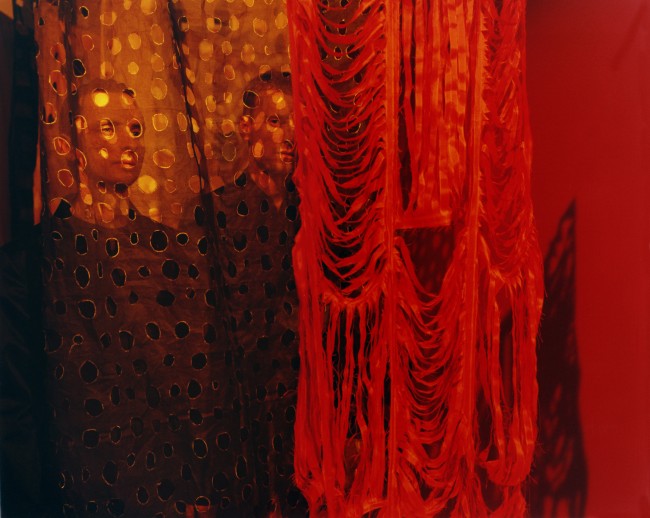
NOWs: These New Puritans and Hans-Henning Korb at the ICA London
These New Puritans and Hans-Henning Korb at the ICA LondonConcert and performance
These New Puritans premiere new work from their forthcoming album Inside the Rose alongside performance, music and installation by artists Soojin Chang, Freya Don and Graham Sutton.
Performing inside a specially-designed installation by textile artist Freya Don, the band present new music that couples powerful, progressive melodies with strings and brutal electronics.
Their performance is preceded by State of Possession, a live interactive presentation by Soojin Chang created to be experienced one-on-one with the artist, and a DJ set from producer Graham Sutton (of band Bark Psychosis and drum and bass project Boymerang).
The evening will also include the debut of recent These New Puritans video projects made in collaboration with photographer Harley Weir, filmmaker Daniel Askill and artist Hans-Henning Korb.
Founded by twin brothers Jack and George Barnett, These New Puritans are an English experimental music group whose music is not easily categorised. Their fourth album Inside the Rose will be released 22 March 2019.
Daniel Askill is a critically-acclaimed Australian filmmaker and long-time collaborator of These New Puritans. His unique sensibility spans a diverse body of work, which includes music videos, films, stage, commercials, photography and video installations. Askill’s recent projects include Take Flight (2015), a virtual reality film for The New York Times featuring Michael Fassbender, Benicio del Toro and Charlize Theron.
Soojin Chang’s artistic practice is led by an inquiry into political and individual trauma, particularly the way these are internalised and inherited in the body schema. Her performance and video works are driven by examinations into the agency and fertility of both humans and nonhumans. Her work seeks to deconstruct systems of oppression and power in order to rethink ecological destruction. She uses appropriation to challenge authorship and renegotiate representations, survival mechanisms, and immigration patterns of colonised cultures and diasporas. Selected exhibitions include MoMA PS1, New York; Institute of Contemporary Arts, London; Centre for Contemporary Arts, Glasgow; Microscope Gallery, New York; La Capela, Paris; and the Art/Life Institute, New York.
Freya Don is a London-based artist known for her dramatic, painterly use of textiles and collaborations with Harley Weir. Freya previously worked with the Barnett brothers on their music video for the single Inside the Rose and the subsequent album artwork.
Hans-Henning Korb is an artist based in Berlin. His practice combines sculpture, installation and performance, and often involves music, film, computer animation, virtual worlds, plants, and organic processes. Korb has exhibited internationally in venues including Hamburger Bahnhof, Berlin (2017); Empty Gallery, Hong Kong (2016); Neue Nationalgalerie, Berlin (2014); and Photo LA, Los Angeles (2012).
Graham Sutton is an English musician, songwriter, composer and record producer. He is best known for his role as the leader and key figure of seminal post-rock band Bark Psychosis, as well as his work as a producer for alternative rock bands since the late 1990s.
Harley Weir is London-born photographer and director known for creating intimate images and films in her personal, editorial and commercial work. Harley had her first solo exhibition in 2017 at Foam, Amsterdam, where her work is now in the permanent collection. She is a regular exhibitor at Photo London and Paris Photo. Her second solo exhibition Homes opened at the Brighton Biennial in September 2018.
With thanks to Media Partner Another Man
Tickets available here
These New Puritans and Hans-Henning Korb at the ICA LondonConcert and performance
These New Puritans premiere new work from their forthcoming album Inside the Rose alongside performance, music and installation by artists Soojin Chang, Freya Don and Graham Sutton.
Performing inside a specially-designed installation by textile artist Freya Don, the band present new music that couples powerful, progressive melodies with strings and brutal electronics.
Their performance is preceded by State of Possession, a live interactive presentation by Soojin Chang created to be experienced one-on-one with the artist, and a DJ set from producer Graham Sutton (of band Bark Psychosis and drum and bass project Boymerang).
The evening will also include the debut of recent These New Puritans video projects made in collaboration with photographer Harley Weir, filmmaker Daniel Askill and artist Hans-Henning Korb.
Founded by twin brothers Jack and George Barnett, These New Puritans are an English experimental music group whose music is not easily categorised. Their fourth album Inside the Rose will be released 22 March 2019.
Daniel Askill is a critically-acclaimed Australian filmmaker and long-time collaborator of These New Puritans. His unique sensibility spans a diverse body of work, which includes music videos, films, stage, commercials, photography and video installations. Askill’s recent projects include Take Flight (2015), a virtual reality film for The New York Times featuring Michael Fassbender, Benicio del Toro and Charlize Theron.
Soojin Chang’s artistic practice is led by an inquiry into political and individual trauma, particularly the way these are internalised and inherited in the body schema. Her performance and video works are driven by examinations into the agency and fertility of both humans and nonhumans. Her work seeks to deconstruct systems of oppression and power in order to rethink ecological destruction. She uses appropriation to challenge authorship and renegotiate representations, survival mechanisms, and immigration patterns of colonised cultures and diasporas. Selected exhibitions include MoMA PS1, New York; Institute of Contemporary Arts, London; Centre for Contemporary Arts, Glasgow; Microscope Gallery, New York; La Capela, Paris; and the Art/Life Institute, New York.
Freya Don is a London-based artist known for her dramatic, painterly use of textiles and collaborations with Harley Weir. Freya previously worked with the Barnett brothers on their music video for the single Inside the Rose and the subsequent album artwork.
Hans-Henning Korb is an artist based in Berlin. His practice combines sculpture, installation and performance, and often involves music, film, computer animation, virtual worlds, plants, and organic processes. Korb has exhibited internationally in venues including Hamburger Bahnhof, Berlin (2017); Empty Gallery, Hong Kong (2016); Neue Nationalgalerie, Berlin (2014); and Photo LA, Los Angeles (2012).
Graham Sutton is an English musician, songwriter, composer and record producer. He is best known for his role as the leader and key figure of seminal post-rock band Bark Psychosis, as well as his work as a producer for alternative rock bands since the late 1990s.
Harley Weir is London-born photographer and director known for creating intimate images and films in her personal, editorial and commercial work. Harley had her first solo exhibition in 2017 at Foam, Amsterdam, where her work is now in the permanent collection. She is a regular exhibitor at Photo London and Paris Photo. Her second solo exhibition Homes opened at the Brighton Biennial in September 2018.
With thanks to Media Partner Another Man
Tickets available here

NOWs: The Seven Lamps of The Art Museum
30th Anniversary Exhibition: The Seven Lamps of The Art MuseumThings That the Museum Protects, and Things That Protect the Museum
1-1 Hijiyama koen Minami-ku Hiroshima-city
Japan
732-0815
The Hiroshima City Museum of Contemporary Art was opened in 1989 as the first public museum in Japan specializing in contemporary art. Commemorating the facility’s 30th anniversary, this exhibition focuses primarily on the trajectory of the museum’s activities and the architecture that has served as a foundation for them. Drawing on the collection, which has been amassed over the years, and documents related to the museum’s various programs along with some new works by participating artists and other materials, the exhibition will unfold throughout the entire facility. Based on a series of keywords such as viewer, architecture, place, conservation, history, deviation, and in-between, the exhibition looks back at these aspects and sets out to reexamine the museum’s appropriate role and various factors that support its activities.
Installation by Yuichiro Tamura: Re-Search: Exploration and Deviation?
Relying both on history and context, and imaginative leaps, the artist Yuichiro Tamura examines the background of places and things as he spins a fanciful story composed of various elements. These efforts will come to fruition in an installation work based on Tamura’s research of the museum’s architecture and the era in which the facility opened, and his own bold associations.
Section6. Referential Image by Yuichiro Tamura
1. The Viewer: Expressions Rooted in Participation
Needless to say, the museum could not survive without visitors. In this section, adorning the beginning of the exhibition, we present a group of works that are realized through visitors’ influence and participation, seemingly exemplifying the special features of the museum as a place.
2. Storage and Symbols: Museum Architecture and Outdoor Sculpture
The Hiroshima City Museum of Contemporary Art is in itself a work of architecture designed by Kisho Kurokawa, and the sculpture on permanent display combines with various design elements within the building to create a place for storing and viewing art. In this section, we examine the facility’s architectural appeal while showcasing the design of the furniture and sign system, and the sculptural works that are integrated into the architecture.
3. Here: Hiroshima and HIROSHIMA
The museum is inseparably linked to the place where it was built. Moreover, in order to emphasize the fact that Hiroshima is an atomic-bombed city, its name is often written in the katakana syllabary (in English, we have used all caps to convey the same meaning). At the museum, both Hiroshima and HIROSHIMA are important themes in our work.
4. Leaving Something Behind: The Current State of Restoration and Conservation
One of the museum’s most important functions is to collect and preserve artworks and documents. To achieve this, one of our primary tasks is to save works of contemporary art, which often make use of non-traditional materials and methods, and which are based on completely different concepts.
5. Accumulation: Recording Museum Activities through Documents and Related Works ? Art Direction by Mata Mata
While striving for continuity and accumulating data, the museum considers different approaches and directions according to each project. By combining related works and documents charting the museum’s course from the preparatory stage to the present, the locally-based design unit Mata Mata will oversee the art direction for this retrospective.
6. Re-Search: Exploration and Deviation ? A New Installation by Yuichiro Tamura
Relying both on history and context, and imaginative leaps, the artist Yuichiro Tamura examines the background of places and things as he spins a fanciful story composed of various elements. These efforts will come to fruition in an installation work based on Tamura’s research of the museum’s architecture and the era in which the facility opened, and his own bold associations.
7. In-Between, Openings, Etc.: Works That Make Use of Gaps in the Museum
In events such as the Open Call for Art Project Ideas, in which the public is invited to submit new practical plans for places in the museum that are not used for normal exhibitions, many artists have created displays by reinterpreting spaces in a creative manner. Perhaps these efforts indicate that certain expressions that cannot be conveyed using the traditional museum framework.
Exhibition Flyer
30th Anniversary Exhibition: The Seven Lamps of The Art MuseumThings That the Museum Protects, and Things That Protect the Museum
1-1 Hijiyama koen Minami-ku Hiroshima-city
Japan
732-0815
The Hiroshima City Museum of Contemporary Art was opened in 1989 as the first public museum in Japan specializing in contemporary art. Commemorating the facility’s 30th anniversary, this exhibition focuses primarily on the trajectory of the museum’s activities and the architecture that has served as a foundation for them. Drawing on the collection, which has been amassed over the years, and documents related to the museum’s various programs along with some new works by participating artists and other materials, the exhibition will unfold throughout the entire facility. Based on a series of keywords such as viewer, architecture, place, conservation, history, deviation, and in-between, the exhibition looks back at these aspects and sets out to reexamine the museum’s appropriate role and various factors that support its activities.
Installation by Yuichiro Tamura: Re-Search: Exploration and Deviation?
Relying both on history and context, and imaginative leaps, the artist Yuichiro Tamura examines the background of places and things as he spins a fanciful story composed of various elements. These efforts will come to fruition in an installation work based on Tamura’s research of the museum’s architecture and the era in which the facility opened, and his own bold associations.
Section6. Referential Image by Yuichiro Tamura
1. The Viewer: Expressions Rooted in Participation
Needless to say, the museum could not survive without visitors. In this section, adorning the beginning of the exhibition, we present a group of works that are realized through visitors’ influence and participation, seemingly exemplifying the special features of the museum as a place.
2. Storage and Symbols: Museum Architecture and Outdoor Sculpture
The Hiroshima City Museum of Contemporary Art is in itself a work of architecture designed by Kisho Kurokawa, and the sculpture on permanent display combines with various design elements within the building to create a place for storing and viewing art. In this section, we examine the facility’s architectural appeal while showcasing the design of the furniture and sign system, and the sculptural works that are integrated into the architecture.
3. Here: Hiroshima and HIROSHIMA
The museum is inseparably linked to the place where it was built. Moreover, in order to emphasize the fact that Hiroshima is an atomic-bombed city, its name is often written in the katakana syllabary (in English, we have used all caps to convey the same meaning). At the museum, both Hiroshima and HIROSHIMA are important themes in our work.
4. Leaving Something Behind: The Current State of Restoration and Conservation
One of the museum’s most important functions is to collect and preserve artworks and documents. To achieve this, one of our primary tasks is to save works of contemporary art, which often make use of non-traditional materials and methods, and which are based on completely different concepts.
5. Accumulation: Recording Museum Activities through Documents and Related Works ? Art Direction by Mata Mata
While striving for continuity and accumulating data, the museum considers different approaches and directions according to each project. By combining related works and documents charting the museum’s course from the preparatory stage to the present, the locally-based design unit Mata Mata will oversee the art direction for this retrospective.
6. Re-Search: Exploration and Deviation ? A New Installation by Yuichiro Tamura
Relying both on history and context, and imaginative leaps, the artist Yuichiro Tamura examines the background of places and things as he spins a fanciful story composed of various elements. These efforts will come to fruition in an installation work based on Tamura’s research of the museum’s architecture and the era in which the facility opened, and his own bold associations.
7. In-Between, Openings, Etc.: Works That Make Use of Gaps in the Museum
In events such as the Open Call for Art Project Ideas, in which the public is invited to submit new practical plans for places in the museum that are not used for normal exhibitions, many artists have created displays by reinterpreting spaces in a creative manner. Perhaps these efforts indicate that certain expressions that cannot be conveyed using the traditional museum framework.
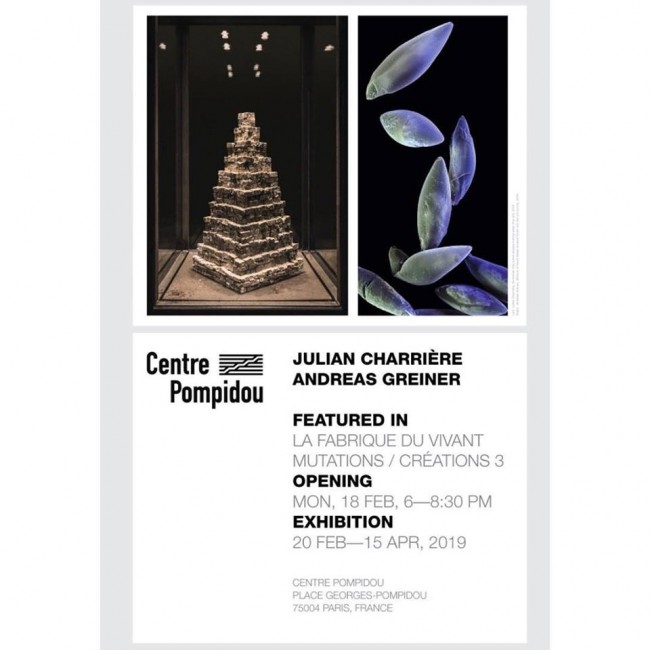
NOWs: La Fabrique du Vivant – Designing the Living
La Fabrique du Vivant - Mutations / Créations 3Group exhibition with Andreas Greiner, Julian Charrière et al.
Galerie 4 – Centre Georges Pompidou
Places Georges Pompidou
75004 Paris
Discover an archaeology of living things and artificial life in an exhibition that presents, in a forward-looking manner, the recent works of fifty creators along with the research coming from scientific laboratories. The very material of the exhibition is evolving, certain works being involved in a process of growth or degeneration. One hundred projects are exhibited, several of which have been designed for the occasion.
Mutations/Créations, the annual creation and innovation laboratory at the Centre Pompidou questions the links between the arts, science, engineering and innovation. The cycle brings together artists, engineers, scientists and entrepreneurs, all the protagonists of the sensory and the intelligible, who affect and transgress our present. For its third edition, the event brings together the visual and digital arts, design and speech, in the course of a collective exhibition: “Designing the Living [La Fabrique du Vivant]”, the first personal and monographic exhibition in Europe of the Brazilian artist Erika Verzutti, and the third edition of the Vertigo forum, conducted by the Ircam.
Mutations / Créations 3 summons up design, visual and digital art, through a group exhibition, Designing the Living [La Fabrique du vivant], the first European monographic exhibition of Brazilian artist Erika Verzutti, and the third edition of the «Vertigo» forum, organised by Ircam.
In this digital era, a new interaction between creation and life sciences is in motion. The notion of ‘life’ is presented today in an artificial form where matter itself is explored. Biotechnologies are now a medium used by artists, designers and architects. If digital simulation tools allow us to recreate the living, we must ask ourselves the question: how do we programme the living?
In partnership with Ircam, Designing the Living [La Fabrique du vivant] examines the changes in the concept of nature linked to technological production. The exhibition retraces an archaeology of the living and artificial life. Decidedly forward-looking, it presents the most significant creations and innovations in the field of art, design and architecture through works by some fifty designers. Its matter is changeable; certain works are undergoing a process of growth or deterioration. Among the hundred or so works on exhibit, some have been created especially for this event. Ircam presents Biotope, an installation by the composer Jean-Luc Hervé, which interacts along the visitor’s path, like a living organism.
Between biology and genetics, design takes a cross-disciplinary approach, like a biotechnological artefact where living matter dictates the form. Design now makes use of ‘bio-manufacturing’ and of new ‘disruptive technologies’ around living matter. Bio-materials, produced from biological organisms (fungus mycelium and bacteria, etc.) have generated innovative objects, such as the Half Life Lamp (2010), a bioluminescent lamp formed from genetically modified material by the Dutch designer Joris Laarman. Sustainable objects by designers Jonas Edvard and Maurizio Montalti (Officina Corpuscoli) explore the potential of fungus mycelium, or the biodegradable objects by Eric Klarenbeek produced from microalgae are among many others. To create an architectural sculpture in situ, specially designed for the exhibition, the American artist David Benjamin (The Living) uses a new building method based on bricks which grow together and are assembled by bio-welding.
Micro-organisms thus become an architectural medium and building material. The architects implement models based on the self-generating processes of matter, simulating the evolving systems of developing life. They produce new composites, made from both living and synthetic materials (the Aguahoja project by Neri Oxman with her laboratory at the MIT Media Lab) to develop environmental projects (energy efficiency, pollution-removing materials and bio-photovoltaics, etc.). The future of architecture lies in genetic engineering and synthetic biology, in order to produce new forms of nature between the ‘digital ecosystem’ and life systems. The installations on an architectural scale presented here are authentic biotechnological ecosystems. The London-based architects from EcologicStudio have built a structure through 3D printing, a sort of ‘cyber-garden’ integrating photosynthetic micro-algae. Marcos Cruz and his BiotA Lab at University College London present panels in bio-receptive concrete, designed to foster the growth of micro-organisms, moss and lichen in an urban environment. The French agency X-TU is leading research around organically-inspired architecture, in the firm belief that living organisms are the bio-technological revolution of the future.
The congruence of living matter and technologies took hold in the field of artistic creation towards the mid-1990s. In 1998, Eduardo Kac advocated transgenic art, transforming natural organisms by inoculating them with synthetic genes or by transferring the genetic material of one organism to another in an effort to create new forms of life. In Australia in the early 2000s, The Tissue Culture & Art Project (Oron Catts & Ionat Zurr) explored life technologies as an artistic medium through the implementation of a new object/subject, a sort of ‘semi-living’. In this wake followed Amy Congdon’s research in cell regeneration, or the work of the designer Hongjie Yang, who created the Semi-Human Vase (2015) from human cells, thus crossing over a new boundary. Between nature and technology, a new ‘half-living’ artefact emerged, the result of automated manufacture and life-simulating software. Artists explored the hybridisation of human and plant cells (Spela Petric, Elaine Whittaker) using new technologies, or created self-generating works with endlessly developing forms (Hicham Berrada). Alexandra Daisy Ginsberg, Christina Agapakis and Sissel Tolaas recreated the scent of plants which had disappeared in the 19th century. The emblematic Crystal Works (2008-2012) by the Japanese artist and designer Tokujin Yoshioka constitute a highlight of the exhibition. He developed a unique production procedure which enables the development of organic forms through a crystallisation process, resulting in objects such the Venus Chair.
A timeline retraces an archaeology of the living and artificial life, including naturalist photos dating from the 1930s by Jean Painlevé or Laure Albin Guillot and a video by Karl Sims. The German artist Andreas Greiner presents photos which capture life by electronic microscopy. Lastly, projects from the field of scientific and medical research are also featured.
With
Shamees Aden; Laure Albin Guillot; François Azambourg; Heather Barnett; Sonja Bäumel and Manuel Selg; BCL (Georg Tremmel + Shiho Fukuhara); Hicham Berrada; Burton Nitta (Michael Burton and Michiko Nitta); Julian Charrière; Natsai Audrey Chieza; Carole Collet; Amy Congdon; Marcos Cruz and Brenda Parker (Bio-ID, UCL); The Disease Biophysics Group from Harvard University; Alexandre Echasseriau; Jonas Edvard; Alexandra Daisy Ginsberg, Christina Agapakis and Sissel Tolaas; Lia Giraud; Guillian Graves (Big Bang Project); Andreas Greiner; Ernst Haeckel; Perry Hall; Jean-Luc Hervé; Marlène Huissoud; Eduardo Kac; Amy Karle; Allison Kudla; Joris Laarman; The Living (David Benjamin); Julia Lohmann; Julian Melchiorri; MIT Media Lab (Cindy Hsin-Liu Kao) in collaboration with Microsoft Research; Mogu; Isaac Monté; Gabriela Munguia; Officina Corpuscoli; Neri Oxman & The Mediated Matter Group, MIT; Jean Painlevé; Claudia Pasquero and Marco Poletto (EcoLogicStudio); Institut Pasteur; Špela Petric; PILI (Marie-Sarah Adenis); Pamela Rosenkranz; Daan Roosegaarde; Karl Sims; Studio Formafantasma (Andrea Trimarchi and Simone Farresin); Studio Nienke Hoogvliet (Nienke Hoogvliet); Studio Klarenbeek & Dros; Studio Libertiny (Tomas Libertiny); The Tissue Culture & Art Project (Oron Catts & Ionat Zurr) in collaboration with Robert Foster; Samuel Tomatis; Urban Morphogenesis Lab (The Bartlett UCL); Tim van Cromvoirt; Teresa van Dongen; Elaine Whittaker; Worcester Polytechnic Institute; Wyss Institute from Harvard University; XTU Architects (Anouk Legendre and Nicolas Desmazières); Hongjie Yang; Tokujin Yoshioka
Curated by Marie-Ange Brayer and Olivier Zeitoun
La Fabrique du Vivant - Mutations / Créations 3Group exhibition with Andreas Greiner, Julian Charrière et al.
Galerie 4 – Centre Georges Pompidou
Places Georges Pompidou
75004 Paris
Discover an archaeology of living things and artificial life in an exhibition that presents, in a forward-looking manner, the recent works of fifty creators along with the research coming from scientific laboratories. The very material of the exhibition is evolving, certain works being involved in a process of growth or degeneration. One hundred projects are exhibited, several of which have been designed for the occasion.
Mutations/Créations, the annual creation and innovation laboratory at the Centre Pompidou questions the links between the arts, science, engineering and innovation. The cycle brings together artists, engineers, scientists and entrepreneurs, all the protagonists of the sensory and the intelligible, who affect and transgress our present. For its third edition, the event brings together the visual and digital arts, design and speech, in the course of a collective exhibition: “Designing the Living [La Fabrique du Vivant]”, the first personal and monographic exhibition in Europe of the Brazilian artist Erika Verzutti, and the third edition of the Vertigo forum, conducted by the Ircam.
Mutations / Créations 3 summons up design, visual and digital art, through a group exhibition, Designing the Living [La Fabrique du vivant], the first European monographic exhibition of Brazilian artist Erika Verzutti, and the third edition of the «Vertigo» forum, organised by Ircam.
In this digital era, a new interaction between creation and life sciences is in motion. The notion of ‘life’ is presented today in an artificial form where matter itself is explored. Biotechnologies are now a medium used by artists, designers and architects. If digital simulation tools allow us to recreate the living, we must ask ourselves the question: how do we programme the living?
In partnership with Ircam, Designing the Living [La Fabrique du vivant] examines the changes in the concept of nature linked to technological production. The exhibition retraces an archaeology of the living and artificial life. Decidedly forward-looking, it presents the most significant creations and innovations in the field of art, design and architecture through works by some fifty designers. Its matter is changeable; certain works are undergoing a process of growth or deterioration. Among the hundred or so works on exhibit, some have been created especially for this event. Ircam presents Biotope, an installation by the composer Jean-Luc Hervé, which interacts along the visitor’s path, like a living organism.
Between biology and genetics, design takes a cross-disciplinary approach, like a biotechnological artefact where living matter dictates the form. Design now makes use of ‘bio-manufacturing’ and of new ‘disruptive technologies’ around living matter. Bio-materials, produced from biological organisms (fungus mycelium and bacteria, etc.) have generated innovative objects, such as the Half Life Lamp (2010), a bioluminescent lamp formed from genetically modified material by the Dutch designer Joris Laarman. Sustainable objects by designers Jonas Edvard and Maurizio Montalti (Officina Corpuscoli) explore the potential of fungus mycelium, or the biodegradable objects by Eric Klarenbeek produced from microalgae are among many others. To create an architectural sculpture in situ, specially designed for the exhibition, the American artist David Benjamin (The Living) uses a new building method based on bricks which grow together and are assembled by bio-welding.
Micro-organisms thus become an architectural medium and building material. The architects implement models based on the self-generating processes of matter, simulating the evolving systems of developing life. They produce new composites, made from both living and synthetic materials (the Aguahoja project by Neri Oxman with her laboratory at the MIT Media Lab) to develop environmental projects (energy efficiency, pollution-removing materials and bio-photovoltaics, etc.). The future of architecture lies in genetic engineering and synthetic biology, in order to produce new forms of nature between the ‘digital ecosystem’ and life systems. The installations on an architectural scale presented here are authentic biotechnological ecosystems. The London-based architects from EcologicStudio have built a structure through 3D printing, a sort of ‘cyber-garden’ integrating photosynthetic micro-algae. Marcos Cruz and his BiotA Lab at University College London present panels in bio-receptive concrete, designed to foster the growth of micro-organisms, moss and lichen in an urban environment. The French agency X-TU is leading research around organically-inspired architecture, in the firm belief that living organisms are the bio-technological revolution of the future.
The congruence of living matter and technologies took hold in the field of artistic creation towards the mid-1990s. In 1998, Eduardo Kac advocated transgenic art, transforming natural organisms by inoculating them with synthetic genes or by transferring the genetic material of one organism to another in an effort to create new forms of life. In Australia in the early 2000s, The Tissue Culture & Art Project (Oron Catts & Ionat Zurr) explored life technologies as an artistic medium through the implementation of a new object/subject, a sort of ‘semi-living’. In this wake followed Amy Congdon’s research in cell regeneration, or the work of the designer Hongjie Yang, who created the Semi-Human Vase (2015) from human cells, thus crossing over a new boundary. Between nature and technology, a new ‘half-living’ artefact emerged, the result of automated manufacture and life-simulating software. Artists explored the hybridisation of human and plant cells (Spela Petric, Elaine Whittaker) using new technologies, or created self-generating works with endlessly developing forms (Hicham Berrada). Alexandra Daisy Ginsberg, Christina Agapakis and Sissel Tolaas recreated the scent of plants which had disappeared in the 19th century. The emblematic Crystal Works (2008-2012) by the Japanese artist and designer Tokujin Yoshioka constitute a highlight of the exhibition. He developed a unique production procedure which enables the development of organic forms through a crystallisation process, resulting in objects such the Venus Chair.
A timeline retraces an archaeology of the living and artificial life, including naturalist photos dating from the 1930s by Jean Painlevé or Laure Albin Guillot and a video by Karl Sims. The German artist Andreas Greiner presents photos which capture life by electronic microscopy. Lastly, projects from the field of scientific and medical research are also featured.
With
Shamees Aden; Laure Albin Guillot; François Azambourg; Heather Barnett; Sonja Bäumel and Manuel Selg; BCL (Georg Tremmel + Shiho Fukuhara); Hicham Berrada; Burton Nitta (Michael Burton and Michiko Nitta); Julian Charrière; Natsai Audrey Chieza; Carole Collet; Amy Congdon; Marcos Cruz and Brenda Parker (Bio-ID, UCL); The Disease Biophysics Group from Harvard University; Alexandre Echasseriau; Jonas Edvard; Alexandra Daisy Ginsberg, Christina Agapakis and Sissel Tolaas; Lia Giraud; Guillian Graves (Big Bang Project); Andreas Greiner; Ernst Haeckel; Perry Hall; Jean-Luc Hervé; Marlène Huissoud; Eduardo Kac; Amy Karle; Allison Kudla; Joris Laarman; The Living (David Benjamin); Julia Lohmann; Julian Melchiorri; MIT Media Lab (Cindy Hsin-Liu Kao) in collaboration with Microsoft Research; Mogu; Isaac Monté; Gabriela Munguia; Officina Corpuscoli; Neri Oxman & The Mediated Matter Group, MIT; Jean Painlevé; Claudia Pasquero and Marco Poletto (EcoLogicStudio); Institut Pasteur; Špela Petric; PILI (Marie-Sarah Adenis); Pamela Rosenkranz; Daan Roosegaarde; Karl Sims; Studio Formafantasma (Andrea Trimarchi and Simone Farresin); Studio Nienke Hoogvliet (Nienke Hoogvliet); Studio Klarenbeek & Dros; Studio Libertiny (Tomas Libertiny); The Tissue Culture & Art Project (Oron Catts & Ionat Zurr) in collaboration with Robert Foster; Samuel Tomatis; Urban Morphogenesis Lab (The Bartlett UCL); Tim van Cromvoirt; Teresa van Dongen; Elaine Whittaker; Worcester Polytechnic Institute; Wyss Institute from Harvard University; XTU Architects (Anouk Legendre and Nicolas Desmazières); Hongjie Yang; Tokujin Yoshioka
Curated by Marie-Ange Brayer and Olivier Zeitoun
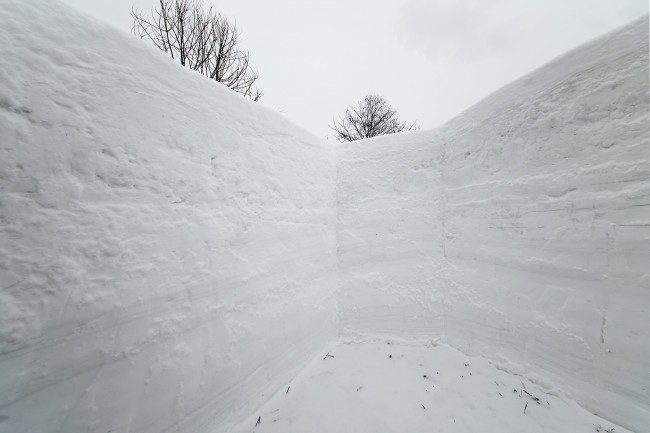
NOWs: s(k)now – snow + know
s(k)now - snow + knowElise Eeraerts at Sapporo Tenjinyama Art Studio
Sapporo Tenjinyama Art Studio
62-0932
Hokkaido, Sapporo
Opening 23 February, 5 pm
s(k)now - snow + knowElise Eeraerts at Sapporo Tenjinyama Art Studio
Sapporo Tenjinyama Art Studio
62-0932
Hokkaido, Sapporo
Opening 23 February, 5 pm

NOWs: Am Rand von EuropaCity
Am Rand von EuropaCityEine künstlerische Veranstaltungsreihe von Yves Mettler mit Alexis Hyman Wolff und Scriptings/Wedding
Café MOAB
Lehrter Str. 36
10557 Berlin
Liebe Nachbar*innen und Interessierte!
Am kommenden Sonntag, dem 24.2. von 15-17 Uhr findet der erste Workshop zum Spazieren und Intervenieren im Stadtraum im Cafe MOAB in der Lehrter Str. 36, 10557 Berlin, statt.
Wir werden am Sonntag uns darüber austauschen, was eine Intervention im öffentlichen Raum bewirken kann und soll und anhand unserer bisherigen Erfahrungen und Wünsche, wollen wir die ersten Ideen für eine Aktion am 26. Mai spinnen, sowie unsere nächste Schritte am Rand von EuropaCity und über ihre Grenzen hinaus, vorbereiten.
Bitte meldet Euch kurz zurück um Eure Teilnahme zu bestätigen:
info@amrandvoneuropa.city
Am Rand von EuropaCity: Eine künstlerische Veranstaltungsreihe zur Europacity Berlin ist ein Projekt von Yves Mettler mit Alexis Hyman Wolff und Scriptings/Wedding. Es wird von der Berliner Senatsverwaltung für Kultur und Europa gefördert.
Am Rand von EuropaCityEine künstlerische Veranstaltungsreihe von Yves Mettler mit Alexis Hyman Wolff und Scriptings/Wedding
Café MOAB
Lehrter Str. 36
10557 Berlin
Liebe Nachbar*innen und Interessierte!
Am kommenden Sonntag, dem 24.2. von 15-17 Uhr findet der erste Workshop zum Spazieren und Intervenieren im Stadtraum im Cafe MOAB in der Lehrter Str. 36, 10557 Berlin, statt.
Wir werden am Sonntag uns darüber austauschen, was eine Intervention im öffentlichen Raum bewirken kann und soll und anhand unserer bisherigen Erfahrungen und Wünsche, wollen wir die ersten Ideen für eine Aktion am 26. Mai spinnen, sowie unsere nächste Schritte am Rand von EuropaCity und über ihre Grenzen hinaus, vorbereiten.
Bitte meldet Euch kurz zurück um Eure Teilnahme zu bestätigen:
info@amrandvoneuropa.city
Am Rand von EuropaCity: Eine künstlerische Veranstaltungsreihe zur Europacity Berlin ist ein Projekt von Yves Mettler mit Alexis Hyman Wolff und Scriptings/Wedding. Es wird von der Berliner Senatsverwaltung für Kultur und Europa gefördert.

NOWs: BPA Exhibition BPA // Berlin program for artists
BPA Exhibitiongroup show
Artitious Showroom
Möhrenstrasse 61
10117 Berlin
FRAGILE
Leipziger Str. 63
10117 Berlin
ITALIC
Leipziger Str. 61
10117 Berlin
Opening
25 February, 6 pm
With: Yalda Afsah, Aliénor Dauchez, Nadine Hattom, Adam Kaplan, Yuki Kishino, Cosima zu Knyphausen, Mickael Marman, ae73edb7@aeaeaeae.io, Scott Roben
curated by Maurin Dietrich
The Berlin Program for Artists (BPA) is pleased to announce BPA Exhibition. Curated by Maurin Dietrich, the exhibition stretches over three locations and includes works by each of the program’s 2018 mentees.
A ritual that creates meaning through repetition requires that its results not be determined in advance. For BPA, a regular practice of studio visits becomes such an unforeseeable ritual, with a series of fortnightly conversations between two people in which themes emerge, questions are formulated, and meanings can be (re)created and described in each visit. The nine young artists that took part as participants in last year’s program will conclude their year with an exhibition at three neighboring spaces. There will be three artists in each of the three locations.
BPA ExhibitionGruppenausstellung
Artitious Showroom
Möhrenstrasse 61
10117 Berlin
FRAGILE
Leipziger Str. 63
10117 Berlin
ITALIC
Leipziger Str. 61
10117 Berlin
Eröffnung
25. Februar, 18 h
Mit: Yalda Afsah, Aliénor Dauchez, Nadine Hattom, Adam Kaplan, Yuki Kishino, Cosima zu Knyphausen, Mickael Marman, ae73edb7@aeaeaeae.io, Scott Roben
Kuratiert von Maurin Dietrich
Berlin Program for Artists (BPA) freut sich, seine dritte Abschluss Ausstellung anzukündigen. BPA Exhibition wird von Maurin Dietrich kuratiert und zeigt an drei Orten die Arbeiten der Mentees des letzten Jahres.
Ein Ritual, das seine Bedeutung bei jeder Wiederholung neu herstellt bedarf dem produktiven Fehlen eines vorbestimmten Resultates. Für BPA (re-)manifestiert sich dieses Ritual ein Jahr lang in der Struktur jedes zweiten Montags; im Gespräch zweier Personen in dem sich Thematiken herausbilden, Fragen formuliert werden und sich Bedeutungen jedes mal neu her- und darstellen lassen. Neun KünstlerInnen umfasst das vorherige Berlin Program for Artists Jahr und findet seinen Abschluss in einer an drei Orten stattfindenden Ausstellung. In diesen drei Ausstellungsräumen, fußläufig zueinander positioniert, finden sich Arbeiten von jeweils drei KünstlerInnen die zueinander in Bezug gesetzt werden.
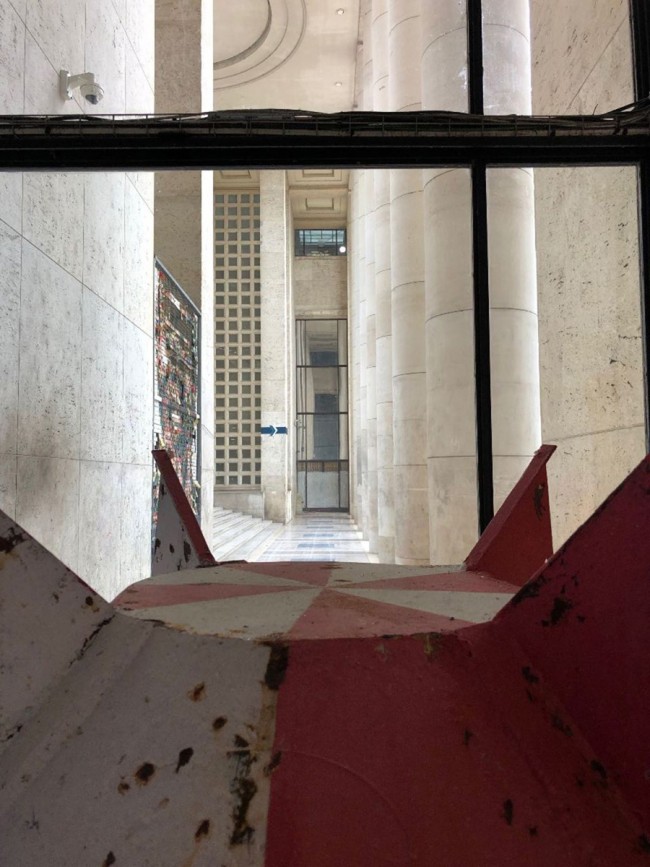
NOWs: Julius von Bismarck at Palais de Tokyo
Die Mimik der TethysJulius von Bismarck at Palais de Tokyo
Palais de Tokyo
13 Avenue du Président Wilson
75116 Paris
Opening
18 February, 9pm
Inspired by the figure of Tethys – a sea goddess in Greek mythology, the daughter of the sky (Ouranos) and of the earth (Gaia) – Julius von Bismarck has conceived the original project Die Mimik der Tethys (the expressions of Tethys), for which he has moved the oceans. That is at least the sensation produced by the presence of a buoy hung over the Palais de Tokyo’s Palier d’honneur, corroded by sea salt and covered by dry seaweed. In perpetual motion, the buoy reproduces the movements of its original setting, off the Atlantic coast. It is in this way that the visitors find themselves metaphorically under the ocean, and can directly perceive the sway of its waves, which can be either gentle, or wild.
The artist works on the human perception of natural phenomena, either by using highly technical approaches, or by simple site specific gestures. As he puts it: “it’s about the perfect image we have of nature. In reality, it doesn’t look like we imagine it does in a Caspar David Friedrich pastoral painting.” The astonishing sensation created by his moving buoy does indeed depict a misappropriated or modified vision of nature, transforming the building into a submarine world, paced by a giant pendulum that obeys only itself.
Die Mimik der Tethys works like a barometer of nature’s moods. As a random alternation of moments of calm and violence, this hypnotic installation plunges the visitors into the heart of an immersive relationship with nature. Far from being idealised, it takes over the Palais de Tokyo and is unveiled in an extremely unstable way, a tireless heaving that reminds us of the tender osmosis that links us, just like our vain desire to control our environment, with the risk of utterly destroying it.
Curated by Anna Morettini & Daria de Beauvais
Interview with Julius von Bismarck in Monopol here
Die Mimik der TethysJulius von Bismarck at Palais de Tokyo
Palais de Tokyo
13 Avenue du Président Wilson
75116 Paris
Eröffnung
18. Februar, 21 h
Inspired by the figure of Tethys – a sea goddess in Greek mythology, the daughter of the sky (Ouranos) and of the earth (Gaia) – Julius von Bismarck has conceived the original project Die Mimik der Tethys (the expressions of Tethys), for which he has moved the oceans. That is at least the sensation produced by the presence of a buoy hung over the Palais de Tokyo’s Palier d’honneur, corroded by sea salt and covered by dry seaweed. In perpetual motion, the buoy reproduces the movements of its original setting, off the Atlantic coast. It is in this way that the visitors find themselves metaphorically under the ocean, and can directly perceive the sway of its waves, which can be either gentle, or wild.
The artist works on the human perception of natural phenomena, either by using highly technical approaches, or by simple site specific gestures. As he puts it: “it’s about the perfect image we have of nature. In reality, it doesn’t look like we imagine it does in a Caspar David Friedrich pastoral painting.” The astonishing sensation created by his moving buoy does indeed depict a misappropriated or modified vision of nature, transforming the building into a submarine world, paced by a giant pendulum that obeys only itself.
Die Mimik der Tethys works like a barometer of nature’s moods. As a random alternation of moments of calm and violence, this hypnotic installation plunges the visitors into the heart of an immersive relationship with nature. Far from being idealised, it takes over the Palais de Tokyo and is unveiled in an extremely unstable way, a tireless heaving that reminds us of the tender osmosis that links us, just like our vain desire to control our environment, with the risk of utterly destroying it.
Curated by Anna Morettini & Daria de Beauvais
Interview mit Julius von Bismarck in Monopol hier

NOWs: Villa Heike & Other Stories
Photo: Eric Duch
Villa Heike & Other StoriesGroup Exhibition
Villa Heike
Freienwalder Str. 17
13055 Berlin
Alt-Hohenschönhausen
Opening
16 February, 6pm
With: Bram Braam, Pierre Granoux, Vanessa Henn, Valérie Leray, Wiebke Loeper, Jens Lüstraeten, Arwed Messmer, Manfred Pernice, Sophia Pompéry, Peter Ruehle, Torsten Ruehle, Michael Schäfer, Sonya Schönberger, Nina E. Schönefeld, Christof Zwiener
Die Ausstellung zeigt eine Auseinandersetzung mit den Transformationsprozessen einer Stadt und eines vergangenen Staates, dessen Gebäude und Architektur untrennbar mit seiner Geschichte verbunden sind. Der Ingenieur Richard Heike gründete 1903 eine Fabrik für Fleischereimaschinen und nutzte die dreistöckige preußische Villa Heike als Verwaltungs- und Wohngebäude. Ende des zweiten Weltkriegs marschierten die Sowjets ein und erschossen den Fabrikanten Heike vor der seiner Tür. 1951 übergaben sie das Gebiet an die Stasi, die in der Villa ihr geheimes NS-Archiv lagerte. Die Villa Heike wurde somit Teil eines sogenannten „Sperrgebietes” welches auf DDR-Straßenkarten nur als weißer Fleck existierte. Mit der deutschen Wiedervereinigung wurden die NS-Akten dem Bundesarchiv übergeben.
Im Jahr 2016 übernahm der Künstler Michael Schäfer mit vier Künstlerkollegen die Villa Heike, um Künstlerateliers einzurichten. Nach der Renovierung öffnet die Villa erstmals Anfang 2019 ihre Pforten für die Ausstellung VILLA & OTHER STORIES*, 30 Jahre nach dem Mauerfall.
Foto: Eric Duch
Villa Heike & Other StoriesGroup Exhibition
Villa Heike
Freienwalder Str. 17
13055 Berlin
Alt-Hohenschönhausen
Eröffnung
16. Februar, 18h
Mit: Bram Braam, Pierre Granoux, Vanessa Henn, Valérie Leray, Wiebke Loeper, Jens Lüstraeten, Arwed Messmer, Manfred Pernice, Sophia Pompéry, Peter Ruehle, Torsten Ruehle, Michael Schäfer, Sonya Schönberger, Nina E. Schönefeld, Christof Zwiener
Die Ausstellung zeigt eine Auseinandersetzung mit den Transformationsprozessen einer Stadt und eines vergangenen Staates, dessen Gebäude und Architektur untrennbar mit seiner Geschichte verbunden sind. Der Ingenieur Richard Heike gründete 1903 eine Fabrik für Fleischereimaschinen und nutzte die dreistöckige preußische Villa Heike als Verwaltungs- und Wohngebäude. Ende des zweiten Weltkriegs marschierten die Sowjets ein und erschossen den Fabrikanten Heike vor der seiner Tür. 1951 übergaben sie das Gebiet an die Stasi, die in der Villa ihr geheimes NS-Archiv lagerte. Die Villa Heike wurde somit Teil eines sogenannten „Sperrgebietes” welches auf DDR-Straßenkarten nur als weißer Fleck existierte. Mit der deutschen Wiedervereinigung wurden die NS-Akten dem Bundesarchiv übergeben.
Im Jahr 2016 übernahm der Künstler Michael Schäfer mit vier Künstlerkollegen die Villa Heike, um Künstlerateliers einzurichten. Nach der Renovierung öffnet die Villa erstmals Anfang 2019 ihre Pforten für die Ausstellung VILLA & OTHER STORIES*, 30 Jahre nach dem Mauerfall.
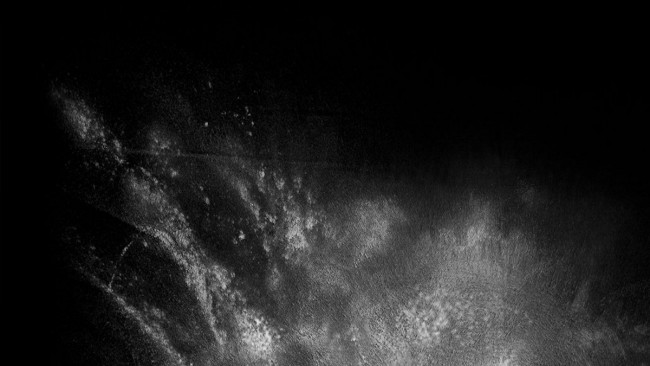
NOWs: Luv und Lee by Sophia Pompéry and Lena von Goedeke
Luv und LeeInstallation
hase29, Kunstverein Osnabrück
Hasestr. 29/30
49074 Osnabrück
Opening
15 February, 7pm
Welcome: Volker Bajus, leader of the Green parliamentary group on behalf of the Lord Mayor of Osnabrück
Introduction: Elisabeth Lumme & Michael Kröger, curators
Lena von Goedeke und Sophia Pompéry realisieren für den Osnabrücker Kunstverein hase29 unter dem Titel Luv und Lee eine raumspezifische Installation, die den gemaserten Fußboden des Ausstellungsortes in besonderer Weise inszeniert: Mit einem Gebläse verteilen sich vier Tonnen Sand, sodass Wirbel entstehen, Verwehungen Spuren bestimmen, Luftstöße den Boden frei fegen oder wieder unter weichem Sand verbergen. In diesem Strömungsfeld werden unterschiedliche Störkörper eingefügt, die den Sand stellenweise zurück halten, sodass Zeichen auf dem Boden je nach Verwehung sichtbar werden, oder im Sand verschwinden.
Luv und LeeInstallation
hase29, Kunstverein Osnabrück
Hasestr. 29/30
49074 Osnabrück
Eröffnung
15. Februar, 19h
Begrüßung: Volker Bajus, Fraktionsvorsitzender der Grünen in Vertretung für den Oberbürgermeister der Stadt Osnabrück
Einführung: Elisabeth Lumme & Michael Kröger, Kuratoren
Lena von Goedeke und Sophia Pompéry realisieren für den Osnabrücker Kunstverein hase29 unter dem Titel Luv und Lee eine raumspezifische Installation, die den gemaserten Fußboden des Ausstellungsortes in besonderer Weise inszeniert: Mit einem Gebläse verteilen sich vier Tonnen Sand, sodass Wirbel entstehen, Verwehungen Spuren bestimmen, Luftstöße den Boden frei fegen oder wieder unter weichem Sand verbergen. In diesem Strömungsfeld werden unterschiedliche Störkörper eingefügt, die den Sand stellenweise zurück halten, sodass Zeichen auf dem Boden je nach Verwehung sichtbar werden, oder im Sand verschwinden.
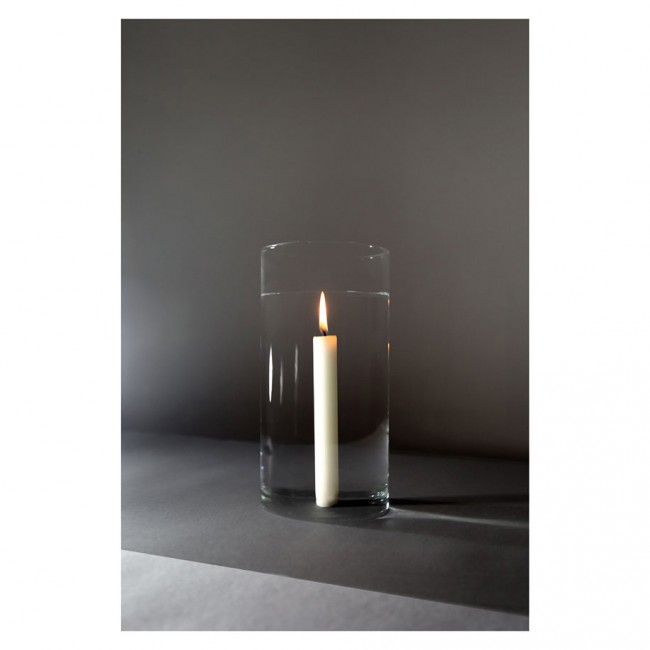
NOWs: unbuntpunkt
Sophia Pompéry, Schein, 2015, C-Print, 54 x 36 cm, Ed. 5 + 2 AP, © Sophia Pompéry / VG-Bildkunst Bonn, 2015
unbuntpunktGroup Exhibition
Galerie Britta von Rettberg
Gabelsbergerstraße 51
80333 München
Opening: 7 February, 6pm
With: Tom Früchtl, Simone Lanzenstiel, Florian Lechner, Sophia Pompéry
Die Gruppenausstellung unbuntpunkt (08.02.-22.03.2019) bringt vier künstlerische Positionen zusammen, die besonders das Interesse für Illusion, Licht und Raum vereint: Tom Früchtl, Simone Lanzenstiel, Florian Lechner und Sophia Pompéry. In Installationen und Skulpturen, Fotografien und malerischen Arbeiten legen die vier Künstlerinnen und Künstler ihr Augenmerk auf die Frage, wie sich die Wirkung alltäglicher Materialien und Situationen durch künstlerische Aneignung verändert. Die meist konzeptuellen, in ihrer Farbigkeit stark reduzierten Arbeiten überwinden kompositorische Bildgrenzen und hinterfragen alltägliche Sehgewohnheiten. Dafür nutzt jede Künstlerin und jeder Künstler seine eigene Strategie: Tom Früchtl hebt in seinen Arbeiten die Grenze zwischen Gegenstand und Abbild auf, Simone Lanzenstiel kreiert aus zerbrechlichen Materialien sensible Bildlandschaften, Florian Lechner komponiert Skulpturen und Installationen aus Licht und Schatten und Sophia Pompéry bringt in ihrer Kunst physikalische Gesetze ins Wanken.
Die Ausstellung wurde von den Künstlerinnen und Künstlern selbst in Zusammenarbeit mit der Galerie Rettberg kuratiert. Der Titel der Ausstellung unbuntpunkt bezieht sich auf den Weißpunkt, der beim Messen von Licht- und Farbwerten als Referenzpunkt verwendet wird. Auch im Verlauf des Schaffensprozesses und in der finalen Bildauswahl stimmten sich die Künstler aufeinander ab, wodurch ihre Arbeiten zu gegenseitigen Bezugspunkten wurden. Es entwickelte sich ein Gesamtkonzept, das sowohl thematisch als auch in ihrer künstlerischen Herangehensweise ineinandergreift.
Sophia Pompéry, Schein, 2015, C-Print, 54 x 36 cm, Ed. 5 + 2 AP, © Sophia Pompéry / VG-Bildkunst Bonn, 2015
unbuntpunktGroup Exhibition
Galerie Britta von Rettberg
Gabelsbergerstraße 51
80333 München
Eröffnung: 7. Februar, 18h
Mit: Tom Früchtl, Simone Lanzenstiel, Florian Lechner, Sophia Pompéry
Die Gruppenausstellung unbuntpunkt (08.02.-22.03.2019) bringt vier künstlerische Positionen zusammen, die besonders das Interesse für Illusion, Licht und Raum vereint: Tom Früchtl, Simone Lanzenstiel, Florian Lechner und Sophia Pompéry. In Installationen und Skulpturen, Fotografien und malerischen Arbeiten legen die vier Künstlerinnen und Künstler ihr Augenmerk auf die Frage, wie sich die Wirkung alltäglicher Materialien und Situationen durch künstlerische Aneignung verändert. Die meist konzeptuellen, in ihrer Farbigkeit stark reduzierten Arbeiten überwinden kompositorische Bildgrenzen und hinterfragen alltägliche Sehgewohnheiten. Dafür nutzt jede Künstlerin und jeder Künstler seine eigene Strategie: Tom Früchtl hebt in seinen Arbeiten die Grenze zwischen Gegenstand und Abbild auf, Simone Lanzenstiel kreiert aus zerbrechlichen Materialien sensible Bildlandschaften, Florian Lechner komponiert Skulpturen und Installationen aus Licht und Schatten und Sophia Pompéry bringt in ihrer Kunst physikalische Gesetze ins Wanken.
Die Ausstellung wurde von den Künstlerinnen und Künstlern selbst in Zusammenarbeit mit der Galerie Rettberg kuratiert. Der Titel der Ausstellung unbuntpunkt bezieht sich auf den Weißpunkt, der beim Messen von Licht- und Farbwerten als Referenzpunkt verwendet wird. Auch im Verlauf des Schaffensprozesses und in der finalen Bildauswahl stimmten sich die Künstler aufeinander ab, wodurch ihre Arbeiten zu gegenseitigen Bezugspunkten wurden. Es entwickelte sich ein Gesamtkonzept, das sowohl thematisch als auch in ihrer künstlerischen Herangehensweise ineinandergreift.
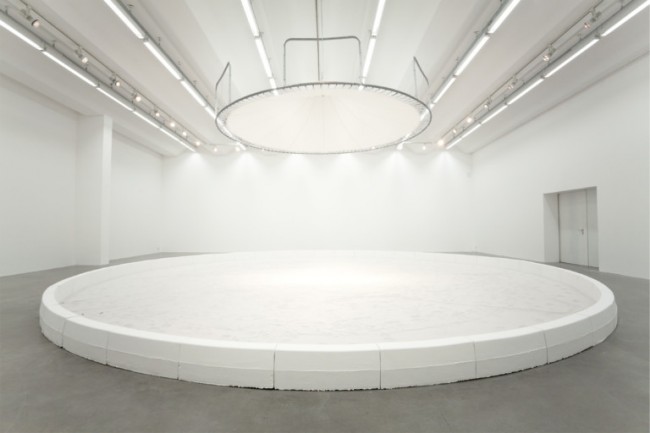
NOWs: SLEEK’s 7 emerging Berlin artists you need to know in 2019
EC. Courtesy of Malte Bartsch
7 emerging Berlin artists you need to know in 2019Article on Malte Bartsch, Jeewi Jee among others
Text by Isaac Moss
You don’t need us to tell you that Berlin is something of a Mecca when it comes to attracting emerging and underground artists. Every year, young artists flock to the city in their droves in search of bright studio spaces, rustic artist abodes, cheap beer and döner, and of course, a nightlife just ripe for exhibition opening tales of excess. And unlike its counterparts in London, Paris or New York, the art scene here is also relatively accessible due to state-funded galleries and a plethora of independent projects spaces that stud the city from Wedding to Weserstraße. As we start a new year, we take a look at some of the most promising artists making waves in the German capital — from those who are just shy of making their big breakthrough to those bubbling beneath the surface. Here are some of our favourites:
Feuerwerkautomat. Courtesy of Malte Bartsch
Malte Bartsch caught our attention because of the inclusive, interactive and social components to his practice. A student of Ólafur Eliasson, Bartsch became a name in Berlin last year with his piece, FEUERWERKAUTOMAT — an intervention at this year’s German reunification celebrations. Designed as an app where members of the public could purchase fireworks and create a display based on democratic polls, FEUERWERKAUTOMAT indicated the unpredictable nature of the voting process. In September at the Biesenthal, the multidisciplinary artist exhibited an old ATM reconfigured as a wood burning stove. Audiences were encouraged to burn their money, if they so wished.
Blinder Beifall, 2016. Courtesy of Jeewi Lee.
Originally from Seoul, Jeewi Lee has been based in Berlin since 2008. By using natural materials such as salt and rock, Jeewi investigates the trace left by human activity, reimagining it as a luminescent stamp. Her most arresting piece, Blinder Beifall (2016), consists of a circus ring composed of salt instead of sand, flanked with large white kerbstones. Jeewi then invited a variety of entertainers to perform in the salt — the final art work was the marks left in the substance.
Read full article here.
EC. Courtesy of Malte Bartsch
7 emerging Berlin artists you need to know in 2019Article on Malte Bartsch, Jeewi Jee among others
Text by Isaac Moss
You don’t need us to tell you that Berlin is something of a Mecca when it comes to attracting emerging and underground artists. Every year, young artists flock to the city in their droves in search of bright studio spaces, rustic artist abodes, cheap beer and döner, and of course, a nightlife just ripe for exhibition opening tales of excess. And unlike its counterparts in London, Paris or New York, the art scene here is also relatively accessible due to state-funded galleries and a plethora of independent projects spaces that stud the city from Wedding to Weserstraße. As we start a new year, we take a look at some of the most promising artists making waves in the German capital — from those who are just shy of making their big breakthrough to those bubbling beneath the surface. Here are some of our favourites:
Feuerwerkautomat. Courtesy of Malte Bartsch
Malte Bartsch caught our attention because of the inclusive, interactive and social components to his practice. A student of Ólafur Eliasson, Bartsch became a name in Berlin last year with his piece, FEUERWERKAUTOMAT — an intervention at this year’s German reunification celebrations. Designed as an app where members of the public could purchase fireworks and create a display based on democratic polls, FEUERWERKAUTOMAT indicated the unpredictable nature of the voting process. In September at the Biesenthal, the multidisciplinary artist exhibited an old ATM reconfigured as a wood burning stove. Audiences were encouraged to burn their money, if they so wished.
Blinder Beifall, 2016. Courtesy of Jeewi Lee.
Originally from Seoul, Jeewi Lee has been based in Berlin since 2008. By using natural materials such as salt and rock, Jeewi investigates the trace left by human activity, reimagining it as a luminescent stamp. Her most arresting piece, Blinder Beifall (2016), consists of a circus ring composed of salt instead of sand, flanked with large white kerbstones. Jeewi then invited a variety of entertainers to perform in the salt — the final art work was the marks left in the substance.
Read full article here.
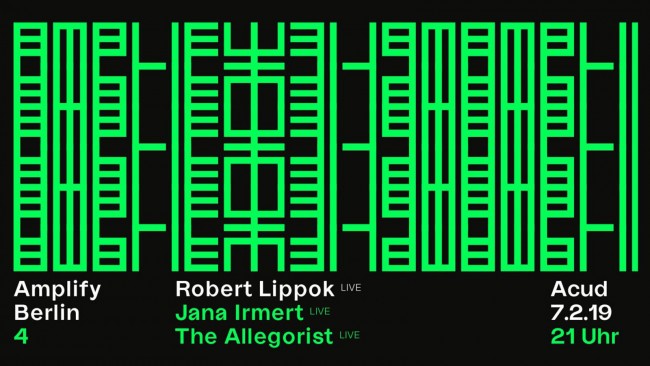
NOWs: Amplify Berlin 4
Amplify Berlin 4Concert with Robert Lippok, Jana Irmert, The Allegorist
Acud Macht Neu
Veteranenstraße 21
10119 Berlin
7 February
9pm
Acud Macht Neu presents: the fourth edition of the creative development program Amplify Berlin features live sets from mentees Jana Irmert and The Allegorist followed by a live set from their mentor Robert Lippok.
LINE-UP
Jana Irmert
… is a sound and media artist based in Berlin. Her practice involves audiovisual installations and performances, electroacoustic multichannel compositions, experimental film work and sound design and music for film. Being interested in less tangible aspects of existence like temporality and impermanence, she creates atmospheric audiovisual or sonic spaces ‘that work with dis/harmony in such a way as to mirror our imperfect world at the moment.’ (TJ Norris, Toneshift)
Her first album End of Absence was released in 2016 on Fabrique Records, followed by her second album FLOOD in 2018. Both received critical praise from various music blogs and magazines and have been internationally broadcast on RAI 3, Resonance FM and BBC Radio 3.
http://janairmert.com
The Allegorist
… aka Anna Jordan uses the pseudonym “Anna Jordan Project” for her visual artworks since 2004. In 2015 she took up another artistic name “The Allegorist” to express her auditive visions. The Allegorist stands for an imaginative journey through all ages, for a better future. It mixes all styles and genres and sets no limitations. Every great idea is welcomed and included into the mindset of a diverse unity. The Allegorist sings in the fictional and majestic Mondoneoh language, to connect all nations and honour all our ancestors. In 2016 her debut album „Botanical Utopia“ was released by „Kraak Records“. In 2017 Anna Jordan began working simultaneously on music and video production, which resulted in her latest audio-visual works for her second album „Hybrid Dimension I.“
http://www.theallegoristmusic.com
Robert Lippok [Raster-Noton]
Avant-garde German visual artist and composer Robert Lippok has been an influential player in Berlin’s thriving experimental music scene from a very early age. In 1983, he co-founded dissident punk band Ornament und Verbrechen with his brother Ronald, inspired by industrial trailblazers Throbbing Gristle. An open platform to explore jazz, electronic, and industrial concepts with like-minded collaborators of the East German underground persuasion, the group remained active until the mid-1990s, at which point it was overtaken by the brothers’ next and most well-known collaboration, the palindromic To Rococo Rot. The Krautrockish band ushered in a new generation of electronic acts committed to acoustic investigations and improvisation of all stripes. Known for his expansive imagination, inventive rhythmic reflexes, and layers of fuzzy tones, Lippok’s solo work is just as wide-ranging – from funky, glitch-y, twisted techno to stage design for operas, gallery exhibitions, and a variety of notable collaborations.
https://soundcloud.com/robert-lippok
DJ set by NE before, between and after the live sets
ABOUT AMPLIFY BERLIN
Amplify Berlin is a creative development program at ACUD Kunsthaus. Each month, Berlin-based emerging musicians have the chance to be mentored in composition, production and live performance by established musicians.
During each one-month residency, two emerging artists receive feedback and advice from their mentor, work in a private music studio, develop their live set in the ACUD Clubs concert space, as well as present an online radio show. Each residency will culminate in a live set performed by the mentees at a showcase event, on a lineup alongside their mentor.
Amplify Berlin is co-financed by the Europäischer Fonds für regionale Entwicklung (EFRE) and Musicboard Berlin.
More Info:
https://bit.ly/2CVAc2D
http://www.amplify-berlin.de
Admission: 10€ presales (plus fees), 10€ door
Amplify Berlin 4Concert with Robert Lippok, Jana Irmert, The Allegorist
Acud Macht Neu
Veteranenstraße 21
10119 Berlin
07. Februar
21 h
Acud Macht Neu presents: the fourth edition of the creative development program Amplify Berlin features live sets from mentees Jana Irmert and The Allegorist followed by a live set from their mentor Robert Lippok.
LINE-UP
Jana Irmert
… is a sound and media artist based in Berlin. Her practice involves audiovisual installations and performances, electroacoustic multichannel compositions, experimental film work and sound design and music for film. Being interested in less tangible aspects of existence like temporality and impermanence, she creates atmospheric audiovisual or sonic spaces ‘that work with dis/harmony in such a way as to mirror our imperfect world at the moment.’ (TJ Norris, Toneshift)
Her first album End of Absence was released in 2016 on Fabrique Records, followed by her second album FLOOD in 2018. Both received critical praise from various music blogs and magazines and have been internationally broadcast on RAI 3, Resonance FM and BBC Radio 3.
http://janairmert.com
The Allegorist
… aka Anna Jordan uses the pseudonym “Anna Jordan Project” for her visual artworks since 2004. In 2015 she took up another artistic name “The Allegorist” to express her auditive visions. The Allegorist stands for an imaginative journey through all ages, for a better future. It mixes all styles and genres and sets no limitations. Every great idea is welcomed and included into the mindset of a diverse unity. The Allegorist sings in the fictional and majestic Mondoneoh language, to connect all nations and honour all our ancestors. In 2016 her debut album „Botanical Utopia“ was released by „Kraak Records“. In 2017 Anna Jordan began working simultaneously on music and video production, which resulted in her latest audio-visual works for her second album „Hybrid Dimension I.“
http://www.theallegoristmusic.com
Robert Lippok [Raster-Noton]
Avant-garde German visual artist and composer Robert Lippok has been an influential player in Berlin’s thriving experimental music scene from a very early age. In 1983, he co-founded dissident punk band Ornament und Verbrechen with his brother Ronald, inspired by industrial trailblazers Throbbing Gristle. An open platform to explore jazz, electronic, and industrial concepts with like-minded collaborators of the East German underground persuasion, the group remained active until the mid-1990s, at which point it was overtaken by the brothers’ next and most well-known collaboration, the palindromic To Rococo Rot. The Krautrockish band ushered in a new generation of electronic acts committed to acoustic investigations and improvisation of all stripes. Known for his expansive imagination, inventive rhythmic reflexes, and layers of fuzzy tones, Lippok’s solo work is just as wide-ranging – from funky, glitch-y, twisted techno to stage design for operas, gallery exhibitions, and a variety of notable collaborations.
https://soundcloud.com/robert-lippok
DJ set by NE before, between and after the live sets
ABOUT AMPLIFY BERLIN
Amplify Berlin is a creative development program at ACUD Kunsthaus. Each month, Berlin-based emerging musicians have the chance to be mentored in composition, production and live performance by established musicians.
During each one-month residency, two emerging artists receive feedback and advice from their mentor, work in a private music studio, develop their live set in the ACUD Clubs concert space, as well as present an online radio show. Each residency will culminate in a live set performed by the mentees at a showcase event, on a lineup alongside their mentor.
Amplify Berlin is co-financed by the Europäischer Fonds für regionale Entwicklung (EFRE) and Musicboard Berlin.
More Info:
https://bit.ly/2CVAc2D
http://www.amplify-berlin.de
Admission: 10€ presales (plus fees), 10€ door

NOWs: New Dresden setzt Segel_Workshop mit Raul Walch
New Dresden setzt SegelWorkshop with Raul Walch
Montagscafé
Glacisstraße 28
01099 Dresden
Part II
4 February, 5 pm
Part III
25 March, 5 pm
Frei Otto erfand 1955 das Vierpunktzelt, das uns als Modell für eine neue Projektreihe stehen soll: Zusammen mit dem Berliner Künstler Raul Walch werden wir in mehreren Etappen bis zum Sommer einen eigenen Montagscafé-Pavillon entwerfen und realisieren. Bereits im letzten November haben wir mit Raul Walch diverse Fahnen fürs Montagscafé angefertigt, die wir an den jeweiligen Montagen ebenfalls fertigstellen wollen. Kommt, näht, plant und entwerft mit uns ein neues Objekt für den öffentlichen Raum!
Montagscafé – Refugees are welcome here
Ein offener Treffpunkt für Geflüchtete und Einheimische jeden Montag ab 15 Uhr im Kleinen Haus. Kommt vorbei!
New Dresden setzt SegelWorkshop mit Raul Walch
Montagscafé
Glacisstraße 28
01099 Dresden
Teil II
4. Februar, 17 h
Teil III
25. März, 17 h
Frei Otto erfand 1955 das Vierpunktzelt, das uns als Modell für eine neue Projektreihe stehen soll: Zusammen mit dem Berliner Künstler Raul Walch werden wir in mehreren Etappen bis zum Sommer einen eigenen Montagscafé-Pavillon entwerfen und realisieren. Bereits im letzten November haben wir mit Raul Walch diverse Fahnen fürs Montagscafé angefertigt, die wir an den jeweiligen Montagen ebenfalls fertigstellen wollen. Kommt, näht, plant und entwerft mit uns ein neues Objekt für den öffentlichen Raum!
Montagscafé – Refugees are welcome here
Ein offener Treffpunkt für Geflüchtete und Einheimische jeden Montag ab 15 Uhr im Kleinen Haus. Kommt vorbei!
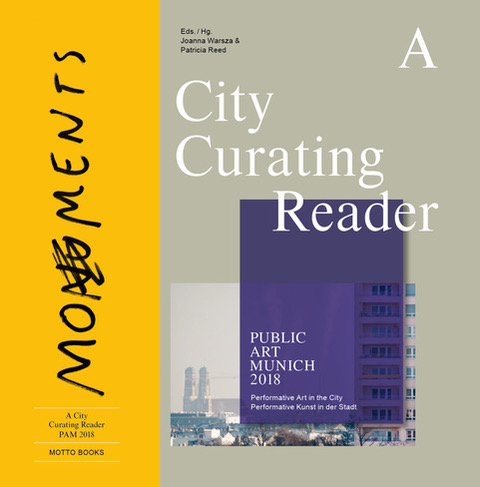
NOWs: A City Curating Reader by Joanna Warsza & Patricia Reed
A City Curating Reader. Public Art Munich 2018Book release
Spike
Rosa-Luxemburg-Straße 45
10178 Berlin
Wednesday, 30 January, 7.30 pm
Statements & Discussion: Cana Bilir-Meier, Maria Lind, Alexander Koch, Patricia Reed and Joanna Warsza
Artists / Künstler*Innen: Aleksandra Wasilkowska, Alexander Kluge & Sarah Morris, Alexandra Pirici, Anders Eiebakke, Anna McCarthy & Gabi Blum, Ari Benjamin Meyers, Cana Bilir-Meier, Dan Perjovschi, Flaka Haliti & Markus Miessen, Franz Wanner, Jonas Lund, Lawrence Abu Hamdan, Leon Eixenberger, Mariam Ghani, Massimo Furlan, Michaela Melián, Olaf Nicolai, Rudolf Herz & Julia Wahren, Students of the Academy of Fine Arts in Munich, The 9th Futurological Congress/Julieta Aranda & Mareike Dittmer
Contributors / Beitragende: Alexander Koch, Bassam El Baroni, Behzad Khosravi Noori, Bellevue di Monaco: Achim Waseem Seger, Kissi Baumann, Marvis Gabriel & You have to be as cool as Alain Delon; Chantal Mouffe, Chris Fitzpatrick, Cordula Schütz, Daniela Stöppel, Emilie Houdent, Ewa Majewska, Gürsoy Doğtaş, Harry Thorne, Jens Maier-Rothe, Joanna Warsza, Jovana Reisinger, Katja Kobolt, Klasse Florian Matzner & Ann-Jasmin Ullrich, María Inés Plaza Lazo, Maria Lind, Maria Muhle, Mathieu Wellner, Mirela Baciak, Moritz Hollinger, Patricia Reed, Stefanie Peter, Sven Beckstette, Sven Lütticken, Thomas Girst, Thomas Meinecke
What is public in public art? What are the contingencies of working outside of the protection of the institutional walls? What makes city curating? This reader takes Munich as a case study, and documents the projects of PUBLIC ART MUNICH 2018 dealing with political, ideological and economical shifts, spanning from the founding of the Bavarian Soviet Republic in 1919 to the arrival of refugees at the Hauptbahnhof in 2015. It contextualizes art within the broader questions of the grammar of the public sphere and of what constitutes publicness today. It also reflects on the concept of context-specific city curating, performativity and art conceived in minutes rather than square meters. Art projects, conversations and essays plot a narrative of how art can cultivate encounters with the unpredictable, negotiate the uncommonness, and provoke the counter-publics to come.
A City Curating Reader. Public Art Munich 2018Book release
Spike
Rosa-Luxemburg-Straße 45
10178 Berlin
Wednesday, 30 January, 7.30 pm
Statements & Discussion: Cana Bilir-Meier, Maria Lind, Alexander Koch, Patricia Reed and Joanna Warsza
Artists / Künstler*Innen: Aleksandra Wasilkowska, Alexander Kluge & Sarah Morris, Alexandra Pirici, Anders Eiebakke, Anna McCarthy & Gabi Blum, Ari Benjamin Meyers, Cana Bilir-Meier, Dan Perjovschi, Flaka Haliti & Markus Miessen, Franz Wanner, Jonas Lund, Lawrence Abu Hamdan, Leon Eixenberger, Mariam Ghani, Massimo Furlan, Michaela Melián, Olaf Nicolai, Rudolf Herz & Julia Wahren, Students of the Academy of Fine Arts in Munich, The 9th Futurological Congress/Julieta Aranda & Mareike Dittmer
Contributors / Beitragende: Alexander Koch, Bassam El Baroni, Behzad Khosravi Noori, Bellevue di Monaco: Achim Waseem Seger, Kissi Baumann, Marvis Gabriel & You have to be as cool as Alain Delon; Chantal Mouffe, Chris Fitzpatrick, Cordula Schütz, Daniela Stöppel, Emilie Houdent, Ewa Majewska, Gürsoy Doğtaş, Harry Thorne, Jens Maier-Rothe, Joanna Warsza, Jovana Reisinger, Katja Kobolt, Klasse Florian Matzner & Ann-Jasmin Ullrich, María Inés Plaza Lazo, Maria Lind, Maria Muhle, Mathieu Wellner, Mirela Baciak, Moritz Hollinger, Patricia Reed, Stefanie Peter, Sven Beckstette, Sven Lütticken, Thomas Girst, Thomas Meinecke
What is public in public art? What are the contingencies of working outside of the protection of the institutional walls? What makes city curating? This reader takes Munich as a case study, and documents the projects of PUBLIC ART MUNICH 2018 dealing with political, ideological and economical shifts, spanning from the founding of the Bavarian Soviet Republic in 1919 to the arrival of refugees at the Hauptbahnhof in 2015. It contextualizes art within the broader questions of the grammar of the public sphere and of what constitutes publicness today. It also reflects on the concept of context-specific city curating, performativity and art conceived in minutes rather than square meters. Art projects, conversations and essays plot a narrative of how art can cultivate encounters with the unpredictable, negotiate the uncommonness, and provoke the counter-publics to come.

NOWs: Am Rand von EuropaCity
Parzellengrenzgang am Nordhafen, 30.9.18
Am Rand von EuropaCityEine künstlerische Veranstaltungsreihe von Alexis Hyman Wolff und Yves Mettler
Liebe Nachbar*innen und Interessierte,
wir hoffen, Ihr seid alle gut ins neue Jahr angekommen. Die zweite Phase des Projekts Am Rand von EuropaCity nimmt nun, dank Eurer Mitarbeit, weiter Form an, und wir freuen uns, folgende Möglichkeiten zur weiteren Zusammenarbeit in 2019 vorzustellen.
Das Wochenende der Europaparlamentswahlen (25./26. Mai 2019) bleibt ein wichtiges symbolisches Datum, um Fragen um die Verbindung zwischen lokalen und globalen „Entwicklungen“ anhand der EuropaCity öffentlich zu thematisieren. Wir arbeiten darauf hin sowohl eine PLAKATKAMPAGNE als auch eine INTERVENTION IM ÖFFENTLICHEN RAUM am 26. Mai zu realisieren. Beide Aktionen wollen wir gerne gemeinsam mit Euch und weiteren Nachbar*innen und Interessierten entwickeln. Ebenso werden die “KLANG-FORSCHUNG” des Projekts durch eine Workshopreihe mit Gilles Aubry weitergeführt.
Beim Workshop am 1. Dezember haben einige schon Interesse an einer Teilnahme angekündigt und sich in Arbeitsgruppen eingetragen. Bitte schaut Euch unten die kurzen Beschreibungen der drei Gruppen an, die die Vorhaben und den damit verbundenen Zeitaufwand beschreiben. Meldet euch bitte per Email so bald wie möglich, aber spätestens bis zum 10.Februar zurück und für die jeweiligen Gruppen an.
PLAKATKAMPAGNE (2 Treffen/Workshops)
Erstes Treffen: 17. Februar, 15-18 Uhr, Treffpunkt wird noch bekannt gegeben
Auf dem Hintergrund des “Zuhörens” als radikales politisches Akt, möchte das Projekt Am Rand von EuropaCity als Sprachrohr und Verstärker für Stimmen der Bürger*innen angesichts städtebaulicher Entscheidungen und gesellschaftlicher Entwicklungen in ihrem unmittelbaren Wohnraum dienen. Die Plakat-Gruppe wird sich mit dem Medium Plakat auseinandersetzen. Es werden Plakate gemeinsam realisiert, die sowohl im öffentlichen Raum aufgehängt werden, als auch Teil eines Spaziergangs/Umzugs im Mai verwendet werden sollen. Als Material werden u.a die im Dezember-Workshop entstanden Mitschriften weiterverarbeitet.
INTERVENTION IM STADTRAUM (3-4 Treffen/Workshops/Spaziergänge)
Erstes Treffen: Sonntag 27. Januar, 15-17h, Treffpunkt wird noch bekannt gegeben
Wir wollen Draussen was MACHEN! Der Anspruch auf öffentlichen Raum, kulturellen Räume, Räume zum Zusammenkommen wollen wir in einer kreativen und unerwarteten INTERVENTION stellen. Eine Idee wäre, mit den unterschiedlichen “Erden” aus den Nachbarschaften Moabit, Wedding und Mitte, am Rand der EuropaCity eine Sitzbank zu bauen. Hier kommt die „Spaziergang“-Gruppe zusammen mit all den Nachbarschafts-Interessierten, die mit künstlerisch-aktivistischen Mitteln etwas im Stadtraum verändern wollen.
KLANG-FORSCHUNG (3-4 Terminen zwischen April und Juni 2019)
Erstes Treffen am Wochenende 20. oder 21. April bei Scriptings/Wedding
Im Anschluss an unserem Workshop zum kollektiven Zuhören im Dezember, unternimmt die „Klang-Gruppe” weitere sonische Erkundungen der Europacity und ihrer Ränder. Im Rahmen von vier Nachmittags-Treffen, werden neue Stimmen der Nachbarschaft identifiziert, aufgenommen und zusammenmontiert. Diese Stimmen können die der Bewohner*innen der Europacity sein, ungehörte Stimmen von spezifischen Communities, atmosphärische und nicht-menschliche Stimmen, als auch die Stimmen der EuropaCity-Gruppe selber. Die daraus entstehende Komposition soll die vorgesehene Print-Publikation ergänzen und über Cashmere Radio Berlin gesendet werden.
Mit herzlichen Grüßen
Alexis Hyman Wolff, Gilles Aubry, Achim Lengerer, Yves Mettler
Temporäre Sitzegelegenheit am Europaplatz, Sommer 2015
Parzellengrenzgang am Nordhafen, 30.9.18
Am Rand von EuropaCityEine künstlerische Veranstaltungsreihe von Alexis Hyman Wolff und Yves Mettler
Liebe Nachbar*innen und Interessierte,
wir hoffen, Ihr seid alle gut ins neue Jahr angekommen. Die zweite Phase des Projekts Am Rand von EuropaCity nimmt nun, dank Eurer Mitarbeit, weiter Form an, und wir freuen uns, folgende Möglichkeiten zur weiteren Zusammenarbeit in 2019 vorzustellen.
Das Wochenende der Europaparlamentswahlen (25./26. Mai 2019) bleibt ein wichtiges symbolisches Datum, um Fragen um die Verbindung zwischen lokalen und globalen „Entwicklungen“ anhand der EuropaCity öffentlich zu thematisieren. Wir arbeiten darauf hin sowohl eine PLAKATKAMPAGNE als auch eine INTERVENTION IM ÖFFENTLICHEN RAUM am 26. Mai zu realisieren. Beide Aktionen wollen wir gerne gemeinsam mit Euch und weiteren Nachbar*innen und Interessierten entwickeln. Ebenso werden die “KLANG-FORSCHUNG” des Projekts durch eine Workshopreihe mit Gilles Aubry weitergeführt.
Beim Workshop am 1. Dezember haben einige schon Interesse an einer Teilnahme angekündigt und sich in Arbeitsgruppen eingetragen. Bitte schaut Euch unten die kurzen Beschreibungen der drei Gruppen an, die die Vorhaben und den damit verbundenen Zeitaufwand beschreiben. Meldet euch bitte per Email so bald wie möglich, aber spätestens bis zum 10.Februar zurück und für die jeweiligen Gruppen an.
PLAKATKAMPAGNE (2 Treffen/Workshops)
Erstes Treffen: 17. Februar, 15-18 Uhr, Treffpunkt wird noch bekannt gegeben
Auf dem Hintergrund des “Zuhörens” als radikales politisches Akt, möchte das Projekt Am Rand von EuropaCity als Sprachrohr und Verstärker für Stimmen der Bürger*innen angesichts städtebaulicher Entscheidungen und gesellschaftlicher Entwicklungen in ihrem unmittelbaren Wohnraum dienen. Die Plakat-Gruppe wird sich mit dem Medium Plakat auseinandersetzen. Es werden Plakate gemeinsam realisiert, die sowohl im öffentlichen Raum aufgehängt werden, als auch Teil eines Spaziergangs/Umzugs im Mai verwendet werden sollen. Als Material werden u.a die im Dezember-Workshop entstanden Mitschriften weiterverarbeitet.
INTERVENTION IM STADTRAUM (3-4 Treffen/Workshops/Spaziergänge)
Erstes Treffen: Sonntag 27. Januar, 15-17h, Treffpunkt wird noch bekannt gegeben
Wir wollen Draussen was MACHEN! Der Anspruch auf öffentlichen Raum, kulturellen Räume, Räume zum Zusammenkommen wollen wir in einer kreativen und unerwarteten INTERVENTION stellen. Eine Idee wäre, mit den unterschiedlichen “Erden” aus den Nachbarschaften Moabit, Wedding und Mitte, am Rand der EuropaCity eine Sitzbank zu bauen. Hier kommt die „Spaziergang“-Gruppe zusammen mit all den Nachbarschafts-Interessierten, die mit künstlerisch-aktivistischen Mitteln etwas im Stadtraum verändern wollen.
KLANG-FORSCHUNG (3-4 Terminen zwischen April und Juni 2019)
Erstes Treffen am Wochenende 20. oder 21. April bei Scriptings/Wedding
Im Anschluss an unserem Workshop zum kollektiven Zuhören im Dezember, unternimmt die „Klang-Gruppe” weitere sonische Erkundungen der Europacity und ihrer Ränder. Im Rahmen von vier Nachmittags-Treffen, werden neue Stimmen der Nachbarschaft identifiziert, aufgenommen und zusammenmontiert. Diese Stimmen können die der Bewohner*innen der Europacity sein, ungehörte Stimmen von spezifischen Communities, atmosphärische und nicht-menschliche Stimmen, als auch die Stimmen der EuropaCity-Gruppe selber. Die daraus entstehende Komposition soll die vorgesehene Print-Publikation ergänzen und über Cashmere Radio Berlin gesendet werden.
Mit herzlichen Grüßen
Alexis Hyman Wolff, Gilles Aubry, Achim Lengerer, Yves Mettler
Temporäre Sitzegelegenheit am Europaplatz, Sommer 2015
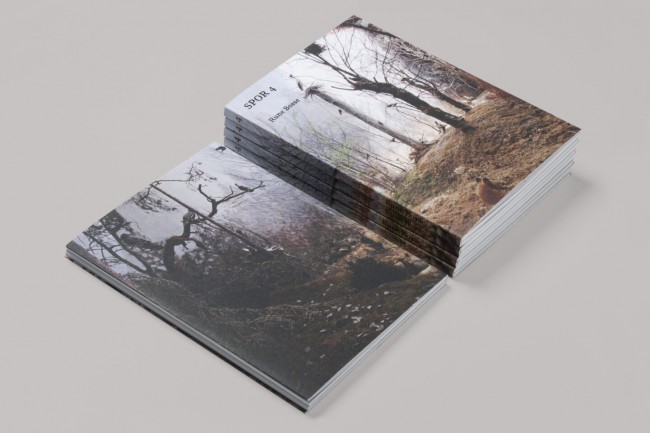
NOWs: SPOR 4 by Rune Bosse
SPOR 4Book release
SPOR 4 Rune Bosse
Text in Danish and English
Richly illustrated
100 pages
In the book series TRACKS, each publication becomes the mouthpiece of a young Danish artist, who is at the beginning of his or her career. In an interview, the artist talks about his or her work and the thoughts they have about their own artistic practice. TRACKS 4 invites Rune Bosse in conversation with art critic Louise Steiwer.
The book series TRACKS is supported by 15. Juni Fonden and Solar Fonden.
Get a copy online at rouletterusse
SPOR 4Book release
SPOR 4 Rune Bosse
Text in Danish and English
Richly illustrated
100 pages
In the book series TRACKS, each publication becomes the mouthpiece of a young Danish artist, who is at the beginning of his or her career. In an interview, the artist talks about his or her work and the thoughts they have about their own artistic practice. TRACKS 4 invites Rune Bosse in conversation with art critic Louise Steiwer.
The book series TRACKS is supported by 15. Juni Fonden and Solar Fonden.
Get a copy online at rouletterusse
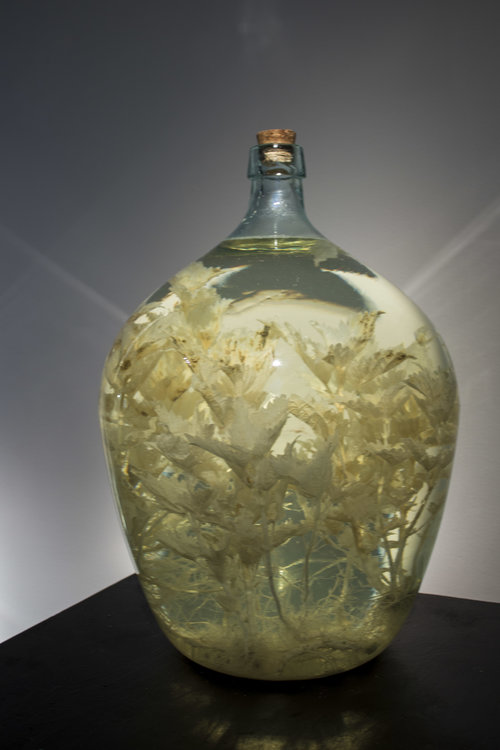
NOWs: UR- by Rune Bosse
UR -Solo exhibition by Rune Bosse
Galleri Jacob Bjørn
Thorvaldsensgade 33a
DK-8000 Aarhus C
We proudly present the first solo exhibition by danish artist Rune Bosse at the gallery. This much awaited solo comprise new works themed over Johan Wolfgang von Goethes (1749-1832) Ur-Phänomen theories the artist has been using as catalyst for this new body of works. Along side Bosses cardinal photo works of chlorine exposed plants this exhibition will also be showcasing his dried ‘Ur-pflanze’ series where various sorts of plants are mounted together as one plant (or tree) symbolizing the whole flora of nature as one unified element.
Link for 3d exhibition view here
UR -Solo exhibition by Rune Bosse
Galleri Jacob Bjørn
Thorvaldsensgade 33a
DK-8000 Aarhus C
We proudly present the first solo exhibition by danish artist Rune Bosse at the gallery. This much awaited solo comprise new works themed over Johan Wolfgang von Goethes (1749-1832) Ur-Phänomen theories the artist has been using as catalyst for this new body of works. Along side Bosses cardinal photo works of chlorine exposed plants this exhibition will also be showcasing his dried ‘Ur-pflanze’ series where various sorts of plants are mounted together as one plant (or tree) symbolizing the whole flora of nature as one unified element.
Link for 3d exhibition view here
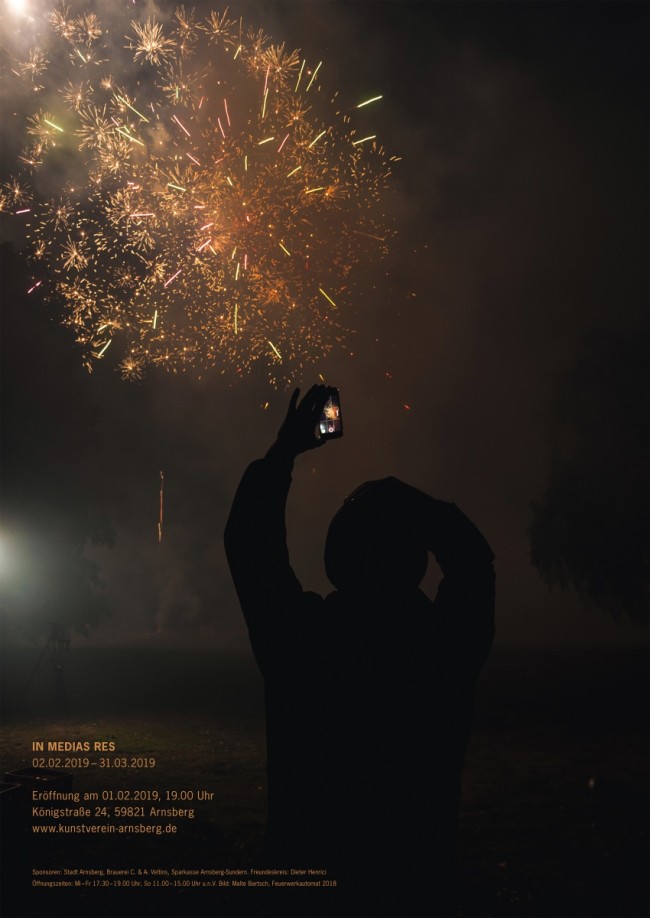
NOWs: In Medias Res
Malte Bartsch, Feuerwerkautomat 2018
In Medias ResGroup exhibition
Kunstverein Arnsberg
Königstraße 24
59821 Arnsberg
Opening
1 February 2019, 7 pm
With: Morehshin Allahyari & Daniel Rourke, Banz & Bowinkel, Malte Bartsch, Mariechen Danz, Angela Fette, Hans Haacke, Konsortium (Lars Breuer, Sebastian Freytag, Guido Münch), Reiner Maria Matysik, Theresa Schubert, Anja Schwörer
curated by Ursula Ströbele
Kommen wir gleich zur Sache und gehen ohne Umschweife ‘mitten in die Dinge‘. Die lateinische Redewendung IN MEDIAS RES stammt aus der Ars Poetica des römischen Dichters Horaz und versteht sich als lobende Äußerung gegenüber seinem griechischen Kollegen Homer. Dieser führe in seiner epochalen Illias Zuhörer*innen und Leser*innen von Beginn an in die Handlung ein, ohne sich lange in einführenden und atmosphärischen Schilderungen (ab ovo = vom Ei an) zu verlieren. An dieses lyrische Ideal anknüpfend, liegt in der Gruppenausstellung IN MEDIAS RES im Kunstverein Arnsberg das Augenmerk auf den hier versammelten Werken selbst und ihren unterschiedlichen Kontexten.
„Kunst ist die Weise, wie wir zu einer bestimmten Zeit die Realität betrachten.“
In einem Interview (1969) erläutert Hans Haacke dieses Zitat des Schriftstellers Oscar Wilde am Beispiel der Impressionisten, die im 19. Jahrhundert dazu beitrugen, dass seitdem eine neue Sensibilität für die Wahrnehmung von Licht- und Farbwerten existiert.
Doch wie hat sich heute im Zeitalter der Digitalisierung unser Blick auf die Realität geändert und wie reagieren die Künste darauf? Hybride, interagierende Realitätsformen bestimmen unseren Alltag, vom physischen Raum, natürlicher oder urbaner Umgebung bis zu virtuellen Welten, Netzwerkverknüpfungen, Synapsen- und Molekülstrukturen ungeahnter Komplexität, die sich in systemischen Verbänden ausbreiten.
Selbst das Bild, das wir von der Natur haben, entsteht heute im Computer. Wie ist die wechselseitige Bedingtheit von Parallel-Realitäten sogenannter erster, zweiter und dritter Natur zu beschreiben, bzw. welche Auswege in Paralleluniversen malen wir uns aus? Nicht nur die Naturwahrnehmung hat sich heute von der ‘unmittelbaren‘ Wahrnehmung durch unsere Sinnesorgane zur Wahrnehmung mittels vorgeschalteter Sehapparate wie Teleskop, Mikroskop, Smartphone- und Drohnenkameras oder Head Mounted Displays verschoben, sondern ist zunehmend durch Computerberechnungen geprägt.
Besitzt Kunst also das Potential einer Orientierungshilfe bzw. Kommentarfunktion, indem sie multiple, ko-existente, sich teils überlagernde Realitätsformen und -entwicklungen evident macht, dabei etwaige Realitätsverluste problematisiert und ein Bewusstsein für Zeitstrukturen schafft?
IN MEDIAS RES – aus den Dingen bzw. Werken heraus lassen sich in der individuellen Rezeption Fragen formulieren und Antworten über die eigene Position finden.
Malte Bartsch, Feuerwerkautomat 2018
In Medias ResGroup exhibition
Kunstverein Arnsberg
Königstraße 24
59821 Arnsberg
Eröffnung
01. Februar 2019, 19h
Mit: Morehshin Allahyari & Daniel Rourke, Banz & Bowinkel, Malte Bartsch, Mariechen Danz, Angela Fette, Hans Haacke, Konsortium (Lars Breuer, Sebastian Freytag, Guido Münch), Reiner Maria Matysik, Theresa Schubert, Anja Schwörer
kuratiert von Ursula Ströbele
Kommen wir gleich zur Sache und gehen ohne Umschweife ‘mitten in die Dinge‘. Die lateinische Redewendung IN MEDIAS RES stammt aus der Ars Poetica des römischen Dichters Horaz und versteht sich als lobende Äußerung gegenüber seinem griechischen Kollegen Homer. Dieser führe in seiner epochalen Illias Zuhörer*innen und Leser*innen von Beginn an in die Handlung ein, ohne sich lange in einführenden und atmosphärischen Schilderungen (ab ovo = vom Ei an) zu verlieren. An dieses lyrische Ideal anknüpfend, liegt in der Gruppenausstellung IN MEDIAS RES im Kunstverein Arnsberg das Augenmerk auf den hier versammelten Werken selbst und ihren unterschiedlichen Kontexten.
„Kunst ist die Weise, wie wir zu einer bestimmten Zeit die Realität betrachten.“
In einem Interview (1969) erläutert Hans Haacke dieses Zitat des Schriftstellers Oscar Wilde am Beispiel der Impressionisten, die im 19. Jahrhundert dazu beitrugen, dass seitdem eine neue Sensibilität für die Wahrnehmung von Licht- und Farbwerten existiert.
Doch wie hat sich heute im Zeitalter der Digitalisierung unser Blick auf die Realität geändert und wie reagieren die Künste darauf? Hybride, interagierende Realitätsformen bestimmen unseren Alltag, vom physischen Raum, natürlicher oder urbaner Umgebung bis zu virtuellen Welten, Netzwerkverknüpfungen, Synapsen- und Molekülstrukturen ungeahnter Komplexität, die sich in systemischen Verbänden ausbreiten.
Selbst das Bild, das wir von der Natur haben, entsteht heute im Computer. Wie ist die wechselseitige Bedingtheit von Parallel-Realitäten sogenannter erster, zweiter und dritter Natur zu beschreiben, bzw. welche Auswege in Paralleluniversen malen wir uns aus? Nicht nur die Naturwahrnehmung hat sich heute von der ‘unmittelbaren‘ Wahrnehmung durch unsere Sinnesorgane zur Wahrnehmung mittels vorgeschalteter Sehapparate wie Teleskop, Mikroskop, Smartphone- und Drohnenkameras oder Head Mounted Displays verschoben, sondern ist zunehmend durch Computerberechnungen geprägt.
Besitzt Kunst also das Potential einer Orientierungshilfe bzw. Kommentarfunktion, indem sie multiple, ko-existente, sich teils überlagernde Realitätsformen und -entwicklungen evident macht, dabei etwaige Realitätsverluste problematisiert und ein Bewusstsein für Zeitstrukturen schafft?
IN MEDIAS RES – aus den Dingen bzw. Werken heraus lassen sich in der individuellen Rezeption Fragen formulieren und Antworten über die eigene Position finden.
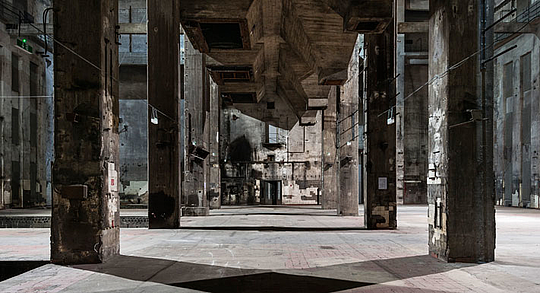
NOWs: Eishalle at CTM Festival
Photo by Stefan Lucks
EishalleAdventurous Music—Now on Ice!
Eishalle
Halle am Berghain II
am Wriezener Bahnhof
10243 Berlin-Friedrichshain
29 January 2019, 4pm
With Kyoka, Grischa Lichtenberger, Mieko Suzuki, Robert Lippok
Full Program
An ice skating rink arrives at the gargantuan Halle am Berghain, soundtracked by an array of adventurous artists. Bring your skates (or rent a pair) and practice your ice dancing skills to eclectic and free-roaming DJ sets.
Skatebård is the Norwegian producer, DJ, and Berghain regular. His sound weaves across emotional techno, neo-italo, futuristic electro, and a “Scando-cosmic” reinterpretation of classic Detroit sounds. In a continuation of CTM’s collaboration with Raster, renowned artists Kyoka, Robert Lippok, Grischa Lichtenberger, and Mieko Suzuki appear. The latter will also be repping female:pressure together with Mo Loschelder, a driving force behind Berlin’s club scene. Freak de l’Afrique are a German Afro-house group known for hosting parties such as the Afro House Experience, Bantu’s Diary, and Black Paper. Room 4 Resistance resident DJ Occult spins ghettotech and booty bass; celebrated music journalist Joe Muggsdelivers an ambient set; passionate dancer, attentive listener, and Rinse France resident Marylou appears; and Morphine label boss Rabih Beaini can be relied on to deliver a confounding set chock-full of gems.
More music is still to come! Warm up with a hot drink and watch the spectacle under a dazzling kinetic light array courtesy of Berlin’s premier light artist Christopher Bauder.
Photo by Stefan Lucks
EishalleAdventurous Music—Now on Ice!
Eishalle
Halle am Berghain II
am Wriezener Bahnhof
10243 Berlin-Friedrichshain
29. Januar 2019, 16:00
With Kyoka, Grischa Lichtenberger, Mieko Suzuki, Robert Lippok
Full Program
An ice skating rink arrives at the gargantuan Halle am Berghain, soundtracked by an array of adventurous artists. Bring your skates (or rent a pair) and practice your ice dancing skills to eclectic and free-roaming DJ sets.
Skatebård is the Norwegian producer, DJ, and Berghain regular. His sound weaves across emotional techno, neo-italo, futuristic electro, and a “Scando-cosmic” reinterpretation of classic Detroit sounds. In a continuation of CTM’s collaboration with Raster, renowned artists Kyoka, Robert Lippok, Grischa Lichtenberger, and Mieko Suzuki appear. The latter will also be repping female:pressure together with Mo Loschelder, a driving force behind Berlin’s club scene. Freak de l’Afrique are a German Afro-house group known for hosting parties such as the Afro House Experience, Bantu’s Diary, and Black Paper. Room 4 Resistance resident DJ Occult spins ghettotech and booty bass; celebrated music journalist Joe Muggsdelivers an ambient set; passionate dancer, attentive listener, and Rinse France resident Marylou appears; and Morphine label boss Rabih Beaini can be relied on to deliver a confounding set chock-full of gems.
More music is still to come! Warm up with a hot drink and watch the spectacle under a dazzling kinetic light array courtesy of Berlin’s premier light artist Christopher Bauder.
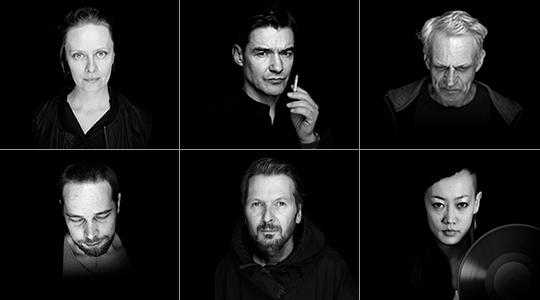
NOWs: Raster. Labor at CTM Festival
Raster.Labor at CTM FestivalWith works by: Byetone + Mieko Suzuki, Dasha Rush, Frank Bretschneider, Grischa Lichtenberger, Robert Lippok
nGbK
Oranienstr. 25
10999 Berlin-Kreuzberg
Opening
25 January 2019, 18:00
Runs
26 January – 3 February 2019, 12:00 – 22:00
With the premiere of Labor, CTM and seminal electronic imprint Raster celebrate a collaboration almost as old as the festival itself. Byetone + Mieko Suzuki, Dasha Rush, Frank Bretschneider, Grischa Lichtenberger, and Robert Lippok will take part in the inaugural edition of the piece, utilizing sparse hardware setups to craft perpetual, regenerating compositions.
Active since 1996, Raster is the influential German label that has released music from Ryoji Ikeda, Kyoka, Atom ™, William Basinski, Kangding Ray, and Belief Defect, among others. Conceived by Olaf Bender, David Letellier, and Frank Bretschneider, Labor is created in close collaboration with Raster artists.
With Labor, Raster explore artistic processes, and how they diverge and develop from the same starting point or set of conditions. Five tables with minimal Eurorack setups and a handful of studio monitors form the basis of the piece. The analogue hardware generates and manipulates control voltages, forming a framework in which the artists can complete, connect, and interact with the modules. As the setup does not contain any sound producing components, participating artists will select sound sources themselves, which could range from minuscule to gargantuan sonic objects. They may choose to mechanically generate sound, or to integrate microphones and amplify sound.
Generative composition, whether through regulating sonic events or strategic compositional decisions, has been a key part of electronic music’s history. Labor references both academic and DIY histories of analogue synthesis, exploring open and dynamic fields of hardware experimentation. The intention of the setup is to enable interested audience members to directly observe cause and effect, so digital software will be avoided.
Berlin’s neue Gesellschaft für bildende Kunst (nGbK) will host the inaugural iteration of the piece. Active since 1969, nGbK is one of Germany’s foremost art societies – they are invested in exhibitions, artistic interventions, research projects, interdisciplinary projects, publications, and more. nGbK is built on a unique structure that allows members to be directly involved in its activities; they understand art as a form of action that directly impacts social processes.
Raster.Labor at CTM FestivalWith works by: Byetone + Mieko Suzuki, Dasha Rush, Frank Bretschneider, Grischa Lichtenberger, Robert Lippok
nGbK
Oranienstr. 25
10999 Berlin-Kreuzberg
Opening
25 January 2019, 18:00
Runs
26 January – 3 February 2019, 12:00 – 22:00
With the premiere of Labor, CTM and seminal electronic imprint Raster celebrate a collaboration almost as old as the festival itself. Byetone + Mieko Suzuki, Dasha Rush, Frank Bretschneider, Grischa Lichtenberger, and Robert Lippok will take part in the inaugural edition of the piece, utilizing sparse hardware setups to craft perpetual, regenerating compositions.
Active since 1996, Raster is the influential German label that has released music from Ryoji Ikeda, Kyoka, Atom ™, William Basinski, Kangding Ray, and Belief Defect, among others. Conceived by Olaf Bender, David Letellier, and Frank Bretschneider, Labor is created in close collaboration with Raster artists.
With Labor, Raster explore artistic processes, and how they diverge and develop from the same starting point or set of conditions. Five tables with minimal Eurorack setups and a handful of studio monitors form the basis of the piece. The analogue hardware generates and manipulates control voltages, forming a framework in which the artists can complete, connect, and interact with the modules. As the setup does not contain any sound producing components, participating artists will select sound sources themselves, which could range from minuscule to gargantuan sonic objects. They may choose to mechanically generate sound, or to integrate microphones and amplify sound.
Generative composition, whether through regulating sonic events or strategic compositional decisions, has been a key part of electronic music’s history. Labor references both academic and DIY histories of analogue synthesis, exploring open and dynamic fields of hardware experimentation. The intention of the setup is to enable interested audience members to directly observe cause and effect, so digital software will be avoided.
Berlin’s neue Gesellschaft für bildende Kunst (nGbK) will host the inaugural iteration of the piece. Active since 1969, nGbK is one of Germany’s foremost art societies – they are invested in exhibitions, artistic interventions, research projects, interdisciplinary projects, publications, and more. nGbK is built on a unique structure that allows members to be directly involved in its activities; they understand art as a form of action that directly impacts social processes.
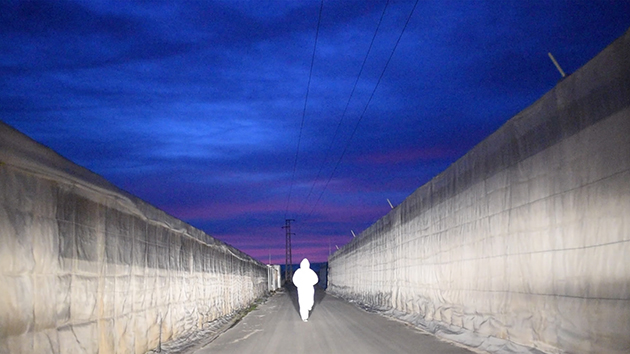
NOWs: Raul Walch – The Sceptical Chemist
Raul Walch: The Sceptical Chemist, 2018, Inkjet-Print auf Hahnemühle Photo Rag, 34 x 48 cm
The Sceptical ChemistSolo exhibition by Raul Walch
EIGEN + ART Lab
Torstraße 220
10115 Berlin
Opening
18 January 2019, 5 – 9 pm
The Sceptical Chymist wanders through life undocumented. The figure is both one of a reactionary nature and ghost of life. It observes from a vantage point that others never decide to tread. The Sceptical Chymist is not an agent in the network but the Gardner of the Rhizome.
Raul Walch is both the Sceptical Chymist, the Artist, the Viewer and the Ethnographer. His installations mark a world of his own viewing and that of his own making. This can be seen both as the Imaginarium and the Archive. In his new works, he guides the viewer into infinite drifting angles of clandestine territories, criss-cross woven textile sheets make up the body of this new border. These monotone Spanish plastic architectures discreetly hide the mass-manufactured winter vegetable urban fuel line from Spain to Germany. An epic bed of white plastic crusts the southern tip of Spain. Covert yet visible via Google Earth, not a human in sight. Only the words Death King „Earth Warriors“ are found by Walch as he conducts his pilgrimage into another world, a deeper web of the unseen polyethylene lies beyond the gateway we now know as our life.
Text excerpt by Penny Rafferty
Raul Walch: The Sceptical Chemist, 2018, Inkjet-Print auf Hahnemühle Photo Rag, 34 x 48 cm
The Sceptical ChemistSolo exhibition by Raul Walch
EIGEN + ART Lab
Torstraße 220
10115 Berlin
Eröffnung
18. Januar 2019, 17 – 21 h
Der skeptische Chemiker* führt sein Leben undokumentiert. Die Figur ist beides: Reaktionär vom Wesen her und Lebensgeist. Sie beobachtet aus einem Blickwinkel, den andere niemals von sich aus einnehmen würden. Der skeptische Chemiker ist kein Rädchen im Getriebe, sondern der Gärtner des Rhizoms.
Raul Walch ist der skeptische Chemiker, er ist aber auch Künstler, Betrachter und Ethnograf. Seine Installationen künden von seiner ureigensten Sicht auf eine von ihm selbst geschaffene Welt. Man kann sie ebenso als Traumwelt wie als Archiv betrachten. In seinen neuen Werken eröffnet er dem/der Betrachter*in endlos fließende Perspektiven auf geheime Regionen, kreuz und quer verflochtene Stofftücher sind der wesentliche Bestandteil dieses neuen Grenzbereichs. Die eintönigen spanischen Plastikkonstruktionen verbergen diskret die urbane Pipeline von Spanien nach Deutschland für das massenproduzierte Wintergemüse. Ein monumentales Feld aus weißem Plastik überzieht die Südspitze Spaniens. Versteckt, aber mittels Google Earth trotzdem erkennbar. Kein Mensch ist in Sicht. Walch findet auf seiner Pilgerreise in eine andere Welt nur die Worte Death King „Earth Warriors“. Jenseits des Tors zu dem, was wir heute als unser Leben kennen, liegt ein tiefer gehendes Netz aus unbemerktem Polyäthylen.
*Anmerkung des Übersetzers: Robert Boyle, The Sceptical Chymist, London 1661. Gekürzt auf Deutsch erschienen als Der skeptische Chemiker, Leipzig, Akademische Verlagsgesellschaft, 1929.
Textauszug von Penny Rafferty
Übersetzung von Frank Süßdorf
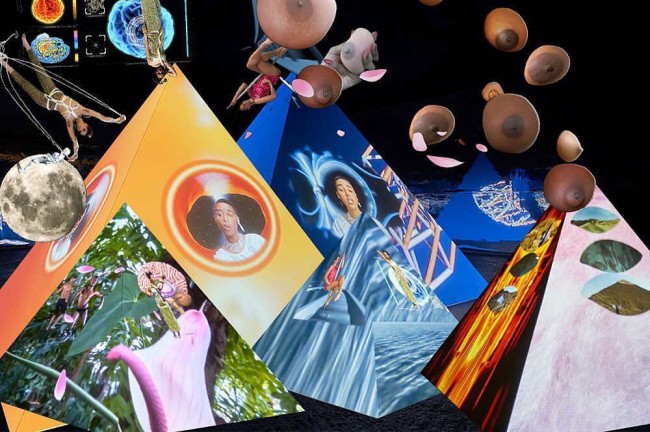
NOWs: Ecologies of Darkness. Building Grounds on Shifting Sands
Tabita Rezaire: Riding Infinity, 2018
Ecologies of Darkness. Building Grounds on Shifting SandsGroup Exhibition
Savvy Contemporary
Plantagenstraße 31
13347 Berlin
Opening
10 January 2019, 7 pm
Artists: Hera Chan & Xiaoshi Vivian Vivian Qin, Mandy El-Sayegh, Nilbar Güreş, Natasha Mendonca, Markues, Beatriz Santiago Muñoz, Pallavi Paul, Luiza Prado de O. Martins, Tabita Rezaire, Bahia Shehab, Sheida Soleimani, Ana Vaz, Helen Zeru, Pamela Z
Colonial Neighbours will be in conversation with Sepideh Rahaa
Curated by Elena Agudio, Nathalie Mba Bikoro and Federica Bueti
Tabita Rezaire: Riding Infinity, 2018
Ecologies of Darkness. Building Grounds on Shifting SandsGroup Exhibition
Savvy Contemporary
Plantagenstraße 31
13347 Berlin
Opening
10 January 2019, 7 pm
Artists: Hera Chan & Xiaoshi Vivian Vivian Qin, Mandy El-Sayegh, Nilbar Güreş, Natasha Mendonca, Markues, Beatriz Santiago Muñoz, Pallavi Paul, Luiza Prado de O. Martins, Tabita Rezaire, Bahia Shehab, Sheida Soleimani, Ana Vaz, Helen Zeru, Pamela Z
Colonial Neighbours will be in conversation with Sepideh Rahaa
Curated by Elena Agudio, Nathalie Mba Bikoro and Federica Bueti

NOWs: Artists Care About Bridges
FUNDRAISING initiated by Artists Care About Bridges at Acud Macht NeuIn support of the international movement SEEBRÜCKE
13.12.2018
from 10pm to open end at Acud Club
FUNDRAISING CLUB NIGHT
16.12.2018
from 4-7pm at Acud Studio
FUNDRAISING ART AUCTION
13.12 – 16.12.2018
from 12 – 9pm at Acud Courtyard
FUNDRAISING CHRISTMAS TREE SALE
Acud Macht Neu
Veteranenstrasse 21
10119 Berlin
Under the current social and political climate, in which the rise of ever more global nationalism and political backwardness is strengthened daily, we as artists, curators, activists and people need literal and metaphorical bridges to stand united and to take action together. Bridges are meeting places, they allow for possibility and for discourse. The collaboration Artists Care About Bridges is hosting a series of fundraising events on the third weekend in Advent at Acud Macht Neu; including a club night, an art auction as well as the sale of Christmas trees from organic farming. These profits go to the organization SEEBRÜCKE. SEEBRÜCKE is an international movement that receives support from the community as well as several civil society alliances and whose mission is to create safe harbors. SEEBRÜCKE will not accept Policy Makers and Governments who let people drown in the Mediterranean Sea to further seal off Europe and win political points. Artists Care About Bridges agrees that this is unbearable and against any humanitarian values. Migration is and has always been part of our society! Instead of closing borders, we need to provide more bridges, to encourage a Europe that is open, and support cities that show solidarity and provide harbors that are safe and humane. We declare our solidarity with societies who are forced to flee their homes. From German and European policy makers, we demand the establishment of safe routes for refugees, to stop the criminalization of sea rescue and to receive them in a human way whilst respecting their rights.
Artists Care About Bridges is a collaboration of activists that was conceived by cultural producer Kathrin Pohlmann and artist Anne Duk Hee Jordan, joined by the curators Pauline Doutreluingne and Petra Poelzl (Karma Ltd. Extended) and supported by Bioland Herbarium Leipzig and Acud Macht Neu. Build a bridge by extending your hand and joining us in creating an open, inclusive and progressive Europe.
FUNDRAISING CLUB NIGHT
13.12.2018
10pm – open end
at Acud Club
To launch the collaboration Artists Care About Bridges, we organize a kick off fundraising club night with a pumping line up featuring Nedalot, Perera Elsewhere, DJ Residue (TTT) and Akmê (://about blank).
Nedalot
NEDALOT aka Neda Sanai is a Berlin based DJ & and producer that moves in the queer underground scene of Europe. With their skillful mixing of different club genres, including rap, R&B, bass music, Jersey club, 2 step, all mixed up in an ocean of twisted pop Acapella, the vibe is always intense-warped-sexy. https://soundcloud.com/nedalot
Perera Elsewhere (FoF) – Dj Set
Sasha Perera, aka Perera Elsewhere, is a polyglot, if there ever were one. Her music proclivities are not resigned only to her output under that name on Los Angeles imprint Friends of Friends or to her previous work she did as a member of Berlin-based globalist club project Jahcoozi. Perera also DJs and when she does, it’s all about bass music. Rooted in her love of UK sounds, she delivers a banquet selection of contemporary club sounds from all over the world to keep the bodies popping and people hungry. https://soundcloud.com/bordermovement-2/mother-perera-border-movement
DJ Residue (TTT)
Techno Excursions
Akmê (://about blank)
Akmê’s sets are known for their diversity. They are profound improvisational odysseys, which explore deep planes of emotions. Simply put: Techno with groove.
https://soundcloud.com/lostakme
FUNDRAISING ART AUCTION
16.12.2018
4 – 7pm
at Acud Studio
In the spirit of the necessity of “building bridges and not borders”, Artist Care About Bridges curates an art auction. There is a growing list of reputable artists, supporting joint social action by donating an art work for the auction.
Carla Åhlander, Uli Aigner, Akinbode Akinbiyi, Ariel Efraim Ashbel, Norbert Bisky, Ally Bisshop, Monika Bonvicini, Lysann Buschbeck, Johannes Buss (Radical Adults Productions), Sol Calero, Jennis Li Chengtien, Anouk De Clercq, Isaac Chong Wai, Elly Clarke, Cucula, Lucinda Dayhew, Viviana Druga, Jesper Dyrehauge, Antje Engelmann, FAMED, Azin Feizabadi, Abrie Fourie, Moritz Frei, Simon Fujiwara, Alexandra Gaul, Alexander Gehring, April Gertler, Surya Gied, Michel Gockel, Sebastian Gögel, Monika Grabuschnigg, Roman Graneist, Grit Hachmeister, Matthias Hamann, Paule Hammer, Stine Marie Jacobsen, Clara Jo, Anne Duk Hee Jordan, Steffen Junghans, Aneta Kajzer, Tobias Kaspar, Susanne Keichel, Fabian Knecht, Cyrill Lachauer, Matt Lambert, Lorenz Lindner, Hanne Lippard, Lemia Monet Bodden, Rachel Monosov, Marco Montiel Soto, Raphael Nagel, Henrike Naumann, Heide Nord, Emeka Ogboh, Ahmet Ögüt, Murat Önen, Funda Özgynaydin, Peaches and Black Cracker, Alona Rodeh, Tere Recarens, Matthias Reinmuth, Johannes Rochhausen, Egill Saebjörnsson, Michael Sailstorfer, Sophia Schama, Ralf Schmerberg, Tilo Schulz, Maya Schweizer, Jenna Seedorf, Farkhondeh Shahroudi, Slavs and Tatars, Katja Stoye-Cetin, Anna Szilit, Anna Run Tryggvadottir, Markus Uhr, Viron Erol Vert, VIP, Shira Wachsmann, Raul Walch, Clemens von Wedemeyer, Tilman Wendland, Gernot Wieland, Euan Williams, Susanne M. Winterling, Tobias Zielony and more.
The auction catalogue will be online via www.revoluzy.org on December 6th.
Auktionator: Fares Al-Hassan
www.fly-auctions.com
Furthermore, there will be the chance to buy artist books as an additional opportunity to donate into the Seebrücke Movement.
FUNDRAISING CHRISTMAS TREE SALE
13.12 – 16.12.2018
12 – 9pm
at Acud Courtyard
Christmas Trees for Sale by Bioland Herbarium Leipzig
Herbarium Leipzig promotes and practices organic farming and develops it further through interdisciplinary collaborations. The Christmas trees for sale are from organic slow growing fields in the area around Leipzig.
Follow Artists Care About Bridges on Instagram
artistscareaboutbridges
FUNDRAISING initiated by Artists Care About Bridges at Acud Macht NeuIn support of the international movement SEEBRÜCKE
Artists Care About Bridges veranstaltet eine Reihe von Fundraising Events im Acud Macht Neu. Alle Einnahmen werden direkt der international agierenden Bewegung SEEBRÜCKE gespendet.
13.12.2018
ab 22:00 Uhr im Acud Club
FUNDRAISING CLUBNACHT
16.12.2018
16:00-19:00 Uhr
Acud Studio
FUNDRAISING ART AUCTION
13.12. – 16.12.2018
12:00-21:00 Uhr
Acud Innenhof
FUNDRAISING CHRISTMAS TREE SALE
Acud Macht Neu
Veteranenstrasse 21
10119 Berlin
Im gegenwärtigen sozialen und politischen Klima, in welchem Abschottungspolitik und globaler Nationalismus ins Unermessliche zu wachsen drohen, brauchen wir als KünstlerInnen, KuratorInnen, AktivistInnen und Menschen buchstäblich Brücken, um gemeinsam zu agieren und unseren Handlungsspielraum erweitern zu können. Aus diesem Grund veranstaltet die aktivistische Kollaboration Artists Care About Bridges am dritten Adventswochenende eine Reihe von Fundraising Aktionen am Acud Macht Neu um metaphorisch eine Brücke zu bauen und einen Ort der Begegnung zu schaffen. Eine Clubnacht, eine Kunstauktion, sowie der Verkauf von nachhaltigen Weihnachtsbäumen dienen zur Unterstützung der international agierenden Bewegung SEEBRÜCKE ist eine dezentral organisierte, zivilgesellschaftliche Bewegung, die sich gegen die europäische Abschottungspolitik sowie gegen die Kriminalisierung von Seenotrettung im Mittelmeer richtet. Artists Care About Bridges stehen vollumfänglich hinter der Forderung der SEEBRÜCKE, europaweit sichere Fluchtwege, eine menschenwürdige Aufnahme von Geflüchteten und eine Entkriminalisierung der Seenotrettung zu sichern. Migration ist der Motor, der Kultur und Gesellschaft schon immer bereichert hat. Anstatt Grenzen zu schließen, müssen wir Brücken schaffen und für ein offenes Europa eintreten.
Artists Care About Bridges ist eine aktivistische Kollaboration, welche von der Kulturproduzentin Kathrin Pohlmann und der Künstlerin Anne Duk Hee Jordan initiiert, von den Kuratorinnen Pauline Doutreluingne und Petra Poelzl (Karma Ltd. Extended) mitkonzipiert und durch Bioland Herbarium Leipzig und Acud Macht Neu unterstützt wird.
FUNDRAISING CLUBNACHT
13.12.2018
ab 22:00 Uhr
Acud Club
Zum Launch von Artists Care About Bridges gibt es eine Clubnacht mit einem pumpenden Line-Up featuring Nedalot, Perera Elsewhere, DJ Residue (TTT) und Akmê (://aboutblank).
Nedalot
NEDALOT ist eine in Berlin ansässige Hip-Hop und R’n‘B-DJ, die sich im queeren Untergrund bewegt. Mit ihren kunstvollen Mixen aus klassischem Hip-Hop gepaart mit neuer beatbasierter Bassmusik hat sie sich schon einen Namen als Support für Künstlerinnen und Künstler wie Diplo, A.G. Cook und Zebra Katz gemacht.
https://soundcloud.com/nedalot
Perera Elsewhere (FoF) – DJ Set
Als Kind sri-lankischer Eltern in London geboren und aufgewachsen, sozialisiert von Dub und Notting Hill Carnival, ist Sasha Perera im Jahr 2000 in Berlin gestrandet und hat von dort aus als Sängerin der Band Jahcoozi nachhaltig die Club-Kultur beeinflusst. Anderswo verorten möchte sich Perera allerdings mit ihrem Solo-Projekt Perera Elsewhere, dessen verwaschener Sound, politische Texte und postdigitale Ästhetik seit ihrem Debütalbum „Everlast“ international Wogen schlägt. Auf Reisen sammelt Perera klangliche Inspirationen und vermengt diese mit einer Prise Trip Hop zu grenzübergreifender Popmusik. Im Zuge der Fundraising Clubnacht wird Perera Elsewhere uns mit einem DJ-Set beehren.
https://soundcloud.com/bordermovement-2/mother-perera-border-movement
DJ Residue (TTT)
Techno Excursions
Akmê (://about blank)
Akmê’s DJ-Sets sind profunde improvisierte Odysseen, die in die Gefilde tiefer Emotionen eindringen. Einfach gesagt: Techno mit Groove.
FUNDRAISING ART AUCTION
16.12.2018
16:00-19:00 Uhr
Acud Studio
Unter dem Leitsatz ‘Baut Brücken und keine Grenzen‘ veranstaltet Artist Care About Bridges eine Kunstauktion. Für diese Auktion haben zahlreiche in Berlin lebende Künstlerinnen und Künstler spontan Arbeiten gespendet, welche im Zuge dieser Auktion ersteigert werden können. Die Liste der beteiligten Künstlerinnen und Künstler wächst stetig.
Carla Åhlander, Uli Aigner, Akinbode Akinbiyi, Ariel Efraim Ashbel, Norbert Bisky, Ally Bisshop, Monika Bonvicini, Lysann Buschbeck, Johannes Buss (Radical Adults Productions), Sol Calero, Jennis Li Chengtien, Anouk De Clercq, Isaac Chong Wai, Elly Clarke, Cucula, Lucinda Dayhew, Viviana Druga, Jesper Dyrehauge, Antje Engelmann, FAMED, Azin Feizabadi, Abrie Fourie, Moritz Frei, Simon Fujiwara, Alexandra Gaul, Alexander Gehring, April Gertler, Surya Gied, Michel Gockel, Sebastian Gögel, Monika Grabuschnigg, Roman Graneist, Grit Hachmeister, Matthias Hamann, Paule Hammer, Stine Marie Jacobsen, Clara Jo, Anne Duk Hee Jordan, Steffen Junghans, Aneta Kajzer, Tobias Kaspar, Susanne Keichel, Fabian Knecht, Cyrill Lachauer, Matt Lambert, Lorenz Lindner, Hanne Lippard, Lemia Monet Bodden, Rachel Monosov, Marco Montiel Soto, Raphael Nagel, Henrike Naumann, Heide Nord, Emeka Ogboh, Ahmet Ögüt, Murat Önen, Funda Özgynaydin, Peaches and Black Cracker, Alona Rodeh, Tere Recarens, Matthias Reinmuth, Johannes Rochhausen, Egill Saebjörnsson, Michael Sailstorfer, Sophia Schama, Ralf Schmerberg, Tilo Schulz, Maya Schweizer, Jenna Seedorf, Farkhondeh Shahroudi, Slavs and Tatars, Katja Stoye-Cetin, Anna Szilit, Anna Run Tryggvadottir, Markus Uhr, Viron Erol Vert, VIP, Shira Wachsmann, Raul Walch, Clemens von Wedemeyer, Tilman Wendland, Gernot Wieland, Euan Williams, Susanne M. Winterling, Tobias Zielony.
Der Auktionskatalog ist ab 06.12.2018 via http://www.revoluzy.org einsehbar.
Auktionator: Fares Al-Hassan
www.fly-auctions.com
Ebenso wird es die Möglichkeit geben, Bücher von Künstlerinnen und Künstlern bei der Auktion zu erstehen. Der Ertrag des Büchertisches geht ebenso an SEEBRÜCKE.
FUNDRAISING CHRISTMAS TREE SALE
13.12 – 16.12.2018
von 12:00-21:00 Uhr
Acud Courtyard
Verkauf von Weihnachtsbäumen aus kontrolliert biologischem Anbau Vom 13. Bis 16.12. schlägt das Bioland Herbarium Leipzig im Innenhof des Acud Macht Neu seine Zelte auf und bietet Weihnachtsbäume aus kontrolliert biologischem Anbau aus Leipzig zum Verkauf an. Herbarium Leipzig fördert und praktiziert ökologischen Landbau und lässt sein Wissen um diesen immer wieder in eine Vielzahl von interdisziplinären künstlerischen Kooperationen einfließen.
Folgt uns auf Instagram
artistscareaboutbridges
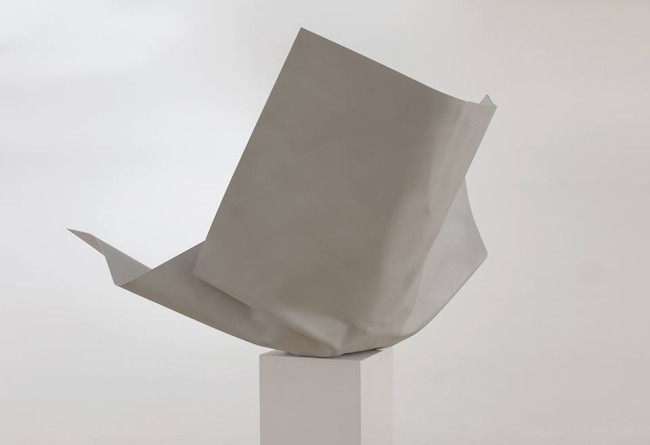
NOWs: IMPACT
IMPACTGroupshow with Julius von Bismarck, Dorian Gaudin, Felix Kiessling, Minyoung Paik, Anne Pfeifer, Laure Prouvost und Johanna Schelle. Curated by Anna Deilmann
Kunst- und Gewerbeverein Regensburg
Ludwigstraße 6
93047 Regensburg
Opening: 23 November 2018
Die Ausstellung IMPACT gibt einen ersten Einblick in das Schaffen von sieben ausgewählten Künstlerlnnen, deren Arbeiten im Rahmen des von Anna Deilmann kuratierten Projektes Quartier am Kunstpark in Zukunft den öffentlichen Raum der Stadt Regensburg bereichern werden. Dabei steht die Wirkkraft von Kunst im Vordergrund. Wo verläuft die Grenze zwischen Werk und Betrachter? Welchen Einfluss hat Kunst auf die Gesellschaft? Welche Botschaften kann sie überbringen?
Der Titel leitet sich aus der beinahe gleichnamigen und eigens für Regensburg realisierten Werkserie Impakt von Felix Kiessling ab. Der Künstler, der am Institut für Raumexperimente in Berlin bei Olafur Eliasson studierte, widmet sich dem flüchtigen Moment von Meteoroideneinschlägen und versucht, ihn greifbar zu machen: die Kollision zweier Körper, den damit einhergehenden physikalischen Ausnahmezustand sowie die kaum zu fassende, kurze Zeitspanne, in der sich enorme Kräfte entfalten. In der Ausstellung zeugen mehrere verformte Aluminiumplatten vom Aufprall eines bis zu einer Tonne schweren, vom Künstler gefertigten ‚Meteoroids‘. Die verbliebene Negativform des Einschlags kann von allen Seiten betrachtet werden. Die Skulpturen rufen die Unberechenbarkeit und Macht der Natur in Erinnerung: So waren es wahrscheinlich Meteoroiden, die das Leben auf der Erde entstehen ließen und es, wie beim Untergang der Dinosaurier, auch wieder auslöschten.
Mit Naturgewalten setzt sich auch Julius von Bismarck, der ebenfalls bei Olafur Eliasson studierte, auseinander. Das achtstündige Video Baumanalyse (2013) zeigt wie der Künstler mit der rechten Hand am Stamm einer Eiche entlang streicht. Die tastende Geste entpuppt sich als allmähliche Verletzung der Natur, denn von Bismarck hält ein Taschenmesser in der Hand und trägt einen Jahresring nach dem anderen ab. Seine gleichmäßige Bewegung hinterlässt einen ringförmigen Pfad am Boden und rückt die Eiche noch deutlicher ins Bildzentrum. Der stundenlange Zweikampf zwischen Mensch und Natur scheint unentschieden. Erst am Ende der täglichen Ausstellungsöffnungszeit gibt der Baum nach und fällt. Der Kreis wird zum Sinnbild für den ewigen Lauf von Werden und Vergehen. Metaphorisch kappt der Künstler sowohl ein deutsches Nationalsymbol, als auch seine eigene Ahnengeschichte, denn die Eiche ist traditionell mit dem Wappen der Familie von Bismarck verbunden. Der Künstler bringt also im wörtlichen Sinne seinen Stammbaum zu Fall.
Während sich Kiessling und von Bismarck dem Verhältnis von Mensch und Natur widmen, konzentriert sich Dorian Gaudin auf das Verhältnis von Mensch und Maschine. Der Künstler, der an der École nationale supérieure des Arts Décoratifs in Paris studierte und als Sohn von professionellen Tänzern und Choreografen aufwuchs, überträgt sein geschultes Bewusstsein für Körper und Bewegung auf technikbasierte Installationen und Objekte. Gaudin schafft Maschinen, die menschliche Züge annehmen und sich autonom bewegen. Der Anschein von unantastbarer und perfekter Technik wird im Laufe ihrer Performance jedoch gebrochen: Sie verletzen sich, die Oberflächen erhalten Kratzer und Verschleißspuren. Wie Narben am menschlichen Körper zeugen sie von der Lebzeit der Objekte und vom Prozess ihrer Entstehung. Oft werden sie vom Künstler farbig hervorgehoben. Gaudins Werke bewegen sich schließlich zwischen Technophilie und Technophobie: Die Liebe des Künstlers zu Maschinen und technischer Perfektion wird immer wieder durch deren Zerstörung gebrochen. Das Eigenleben seiner Arbeiten wirkt dabei rührend und beängstigend zugleich. In der Regensburger Ausstellung sind Objekte aus der Werkschau Rites and Aftermath zu sehen, die im Palais de Tokyo in Paris gezeigt wurde. Darauf aufbauend entwickelt Gaudin für das Quartier am Kunstpark das Projekt Knot: einen Knoten aus Aluminiumbändern, der den Endpunkt einer Bewegung materialisiert.
Auch die monochromen Objekte und Skulpturen von Anne Pfeifer, die an der Akademie der Künste in München bei Jorinde Voigt studierte, bergen ein technisches Innenleben und werden zu lebendigen Maschinen. Im Gegensatz zu Gaudin konzentriert sich die Künstlerin jedoch nicht auf die Bewegung, sondern vor allem auf den Ton. So lässt jedes Objekt eine bestimmte Komposition erklingen, die sich ebenso wie die Proportionen der Arbeit auf den Menschen, auf seine Organe und sein emotionales Innenleben beziehen. Zu hören sind beispielsweise Sounds, die auf den Herzschlag oder Wut, Trauer und Freude referieren. Der Betrachter wird zum elementaren Bestandteil ihrer Arbeiten: In der Spiegelung erkennt er sich selbst, setzt sich in Beziehung zum Kunstwerk, fühlt sich persönlich angesprochen oder wird, wie bei Please sit down (2016) oder der für den Außenraum geplanten Skulptur Cavea, zur Interaktion mit dem Kunstwerk angehalten.
Die ‚Landschaften des Inneren‘ untersucht auch Johanna Schelle, die ebenfalls an der Akademie der Bildenden Künste in München bei unter anderem Hermann Pitz studierte. Schelle arbeitet im klassischen Sinne als Bildhauerin: Die bis zu lebensgroßen und aus Lindenholz geschnitzten Figuren sind das Ergebnis gründlicher Studien auf Papier. Modelle in Ton und Gips bereiten das Arbeiten an den finalen Holzskulpturen vor, die abschließend in Pastelltönen bemalt werden. Die Haltung der Figuren deutet Handlungen an, ihre Mimik gibt kaum Aufschluss über ihre Gemütslage. Sie scheinen auf seltsame Weise entrückt, im Moment gefangen und eingefroren. Als emphatisches Wesen, ist der Mensch versucht das Gegenüber, das hier ebenfalls beinahe menschlich erscheint, zu lesen und zu verstehen. Der Betrachter setzt sich in Beziehung zum Objekt. Der Moment des Innehaltens und Betrachtens von Kunst wird vom Werk selbst gespiegelt. Das Ende des Dialogs ist dabei nicht festgeschrieben. Skulptur und Betrachter befinden sich auf der gleichen Bühne, jedoch ohne Skript.
Diesen Dialog zwischen Mensch und Kunstwerk treibt Minyoung Paik weiter: So nähert sich die Künstlerin, die ebenfalls an der Akademie der Bildenden Künste in München bei Gregor Schneider studierte, unter anderem gesellschaftlichen und politischen Fragestellungen und schafft einen spielerischen Zugang zu Themen, die gewöhnlich mit großer Ernsthaftigkeit behandelt werden. Die Arbeit Map of Korea 2018 zeigt ein Satellitenbild der koreanischen Halbinsel. In der Landschaftsaufnahme sind die anhaltenden Spannungen zwischen Nord- und Südkorea nicht sichtbar. Nur wenige rote Markierungen deuten auf die Grenze hin. Paiks Blick auf ihr eigenes Land paart sich hier mit einem persönlichen Erlebnis der Künstlerin: Der Verlust von Kunstwerken bei einem Transport – die Arbeiten waren für ein Jahr verschollen – gab Anlass zu dieser Installation. Das gerahmte Werk liegt auf dem Boden in einer Transportkiste. Ein Aufkleber weist auf die fragile Fracht hin, doch das Glas ist dennoch gebrochen. Der Riss verläuft dabei nicht zufällig entlang der Demarkationslinie. In Zukunft werden die gesamtkoreanischen Landesgrenzen auch im Außenraum zu sehen sein, dann jedoch in Form einer Tischtennisplatte.
Kunst eröffnet schließlich die Möglichkeit, sich zwischen Realität und Fiktion zu bewegen. Eben diesen Freiraum nutzt Laure Prouvost, die in London am Central Saint Martins College of Arts und der Goldsmiths University studierte. 2013 gewann sie mit Wantee den Turner-Preis. Die Videoarbeit nimmt den Betrachter mit auf die Suche nach ihrem Großvater und einem ‚High Tea‘-Treffen zwischen ihm und seinem Künstlerfreund Kurt Schwitters. Die fiktive Reise in die Vergangenheit ist eng mit der Installation in Regensburg verknüpft. Im Kühlschrank sind Teetassen zu entdecken, die bereits im Video zu sehen waren. Die Keramiken dienen als Modelle für die Skulptur, die auch im Außenraum realisiert werden soll. Zudem lädt die Künstlerin mit Schrifttafeln wie Ideally This Sign Would Make You Sink In Some Warm Tea immer wieder dazu ein, ihr auf der weiteren fiktiven Reise zu folgen.
Das Projekt Quartier am Kunstpark wurde von Anna Deilmann für das Immobilien Zentrum Regensburg entwickelt. Als Gründerin von Anna Deilmann Art Concepts widmet sie sich der Schnittstelle von Architektur, Stadt und Kunst mit dem Fokus auf die Konzeption von Kunst-am-Bau-Projekten. Die Ausstellung IMPACT wurde durch den Kunst- und Gewerbeverein Regensburg und die freundliche Unterstützung des Immobilien Zentrums Regensburg ermöglicht.
Text: Lydia Korndörfer
IMPACTGroupshow with Julius von Bismarck, Dorian Gaudin, Felix Kiessling, Minyoung Paik, Anne Pfeifer, Laure Prouvost und Johanna Schelle. Curated by Anna Deilmann
Kunst- und Gewerbeverein Regensburg
Ludwigstraße 6
93047 Regensburg
Eröffnung: 23. November 2018
Die Ausstellung IMPACT gibt einen ersten Einblick in das Schaffen von sieben ausgewählten Künstlerlnnen, deren Arbeiten im Rahmen des von Anna Deilmann kuratierten Projektes Quartier am Kunstpark in Zukunft den öffentlichen Raum der Stadt Regensburg bereichern werden. Dabei steht die Wirkkraft von Kunst im Vordergrund. Wo verläuft die Grenze zwischen Werk und Betrachter? Welchen Einfluss hat Kunst auf die Gesellschaft? Welche Botschaften kann sie überbringen?
Der Titel leitet sich aus der beinahe gleichnamigen und eigens für Regensburg realisierten Werkserie Impakt von Felix Kiessling ab. Der Künstler, der am Institut für Raumexperimente in Berlin bei Olafur Eliasson studierte, widmet sich dem flüchtigen Moment von Meteoroideneinschlägen und versucht, ihn greifbar zu machen: die Kollision zweier Körper, den damit einhergehenden physikalischen Ausnahmezustand sowie die kaum zu fassende, kurze Zeitspanne, in der sich enorme Kräfte entfalten. In der Ausstellung zeugen mehrere verformte Aluminiumplatten vom Aufprall eines bis zu einer Tonne schweren, vom Künstler gefertigten ‚Meteoroids‘. Die verbliebene Negativform des Einschlags kann von allen Seiten betrachtet werden. Die Skulpturen rufen die Unberechenbarkeit und Macht der Natur in Erinnerung: So waren es wahrscheinlich Meteoroiden, die das Leben auf der Erde entstehen ließen und es, wie beim Untergang der Dinosaurier, auch wieder auslöschten.
Mit Naturgewalten setzt sich auch Julius von Bismarck, der ebenfalls bei Olafur Eliasson studierte, auseinander. Das achtstündige Video Baumanalyse (2013) zeigt wie der Künstler mit der rechten Hand am Stamm einer Eiche entlang streicht. Die tastende Geste entpuppt sich als allmähliche Verletzung der Natur, denn von Bismarck hält ein Taschenmesser in der Hand und trägt einen Jahresring nach dem anderen ab. Seine gleichmäßige Bewegung hinterlässt einen ringförmigen Pfad am Boden und rückt die Eiche noch deutlicher ins Bildzentrum. Der stundenlange Zweikampf zwischen Mensch und Natur scheint unentschieden. Erst am Ende der täglichen Ausstellungsöffnungszeit gibt der Baum nach und fällt. Der Kreis wird zum Sinnbild für den ewigen Lauf von Werden und Vergehen. Metaphorisch kappt der Künstler sowohl ein deutsches Nationalsymbol, als auch seine eigene Ahnengeschichte, denn die Eiche ist traditionell mit dem Wappen der Familie von Bismarck verbunden. Der Künstler bringt also im wörtlichen Sinne seinen Stammbaum zu Fall.
Während sich Kiessling und von Bismarck dem Verhältnis von Mensch und Natur widmen, konzentriert sich Dorian Gaudin auf das Verhältnis von Mensch und Maschine. Der Künstler, der an der École nationale supérieure des Arts Décoratifs in Paris studierte und als Sohn von professionellen Tänzern und Choreografen aufwuchs, überträgt sein geschultes Bewusstsein für Körper und Bewegung auf technikbasierte Installationen und Objekte. Gaudin schafft Maschinen, die menschliche Züge annehmen und sich autonom bewegen. Der Anschein von unantastbarer und perfekter Technik wird im Laufe ihrer Performance jedoch gebrochen: Sie verletzen sich, die Oberflächen erhalten Kratzer und Verschleißspuren. Wie Narben am menschlichen Körper zeugen sie von der Lebzeit der Objekte und vom Prozess ihrer Entstehung. Oft werden sie vom Künstler farbig hervorgehoben. Gaudins Werke bewegen sich schließlich zwischen Technophilie und Technophobie: Die Liebe des Künstlers zu Maschinen und technischer Perfektion wird immer wieder durch deren Zerstörung gebrochen. Das Eigenleben seiner Arbeiten wirkt dabei rührend und beängstigend zugleich. In der Regensburger Ausstellung sind Objekte aus der Werkschau Rites and Aftermath zu sehen, die im Palais de Tokyo in Paris gezeigt wurde. Darauf aufbauend entwickelt Gaudin für das Quartier am Kunstpark das Projekt Knot: einen Knoten aus Aluminiumbändern, der den Endpunkt einer Bewegung materialisiert.
Auch die monochromen Objekte und Skulpturen von Anne Pfeifer, die an der Akademie der Künste in München bei Jorinde Voigt studierte, bergen ein technisches Innenleben und werden zu lebendigen Maschinen. Im Gegensatz zu Gaudin konzentriert sich die Künstlerin jedoch nicht auf die Bewegung, sondern vor allem auf den Ton. So lässt jedes Objekt eine bestimmte Komposition erklingen, die sich ebenso wie die Proportionen der Arbeit auf den Menschen, auf seine Organe und sein emotionales Innenleben beziehen. Zu hören sind beispielsweise Sounds, die auf den Herzschlag oder Wut, Trauer und Freude referieren. Der Betrachter wird zum elementaren Bestandteil ihrer Arbeiten: In der Spiegelung erkennt er sich selbst, setzt sich in Beziehung zum Kunstwerk, fühlt sich persönlich angesprochen oder wird, wie bei Please sit down (2016) oder der für den Außenraum geplanten Skulptur Cavea, zur Interaktion mit dem Kunstwerk angehalten.
Die ‚Landschaften des Inneren‘ untersucht auch Johanna Schelle, die ebenfalls an der Akademie der Bildenden Künste in München bei unter anderem Hermann Pitz studierte. Schelle arbeitet im klassischen Sinne als Bildhauerin: Die bis zu lebensgroßen und aus Lindenholz geschnitzten Figuren sind das Ergebnis gründlicher Studien auf Papier. Modelle in Ton und Gips bereiten das Arbeiten an den finalen Holzskulpturen vor, die abschließend in Pastelltönen bemalt werden. Die Haltung der Figuren deutet Handlungen an, ihre Mimik gibt kaum Aufschluss über ihre Gemütslage. Sie scheinen auf seltsame Weise entrückt, im Moment gefangen und eingefroren. Als emphatisches Wesen, ist der Mensch versucht das Gegenüber, das hier ebenfalls beinahe menschlich erscheint, zu lesen und zu verstehen. Der Betrachter setzt sich in Beziehung zum Objekt. Der Moment des Innehaltens und Betrachtens von Kunst wird vom Werk selbst gespiegelt. Das Ende des Dialogs ist dabei nicht festgeschrieben. Skulptur und Betrachter befinden sich auf der gleichen Bühne, jedoch ohne Skript.
Diesen Dialog zwischen Mensch und Kunstwerk treibt Minyoung Paik weiter: So nähert sich die Künstlerin, die ebenfalls an der Akademie der Bildenden Künste in München bei Gregor Schneider studierte, unter anderem gesellschaftlichen und politischen Fragestellungen und schafft einen spielerischen Zugang zu Themen, die gewöhnlich mit großer Ernsthaftigkeit behandelt werden. Die Arbeit Map of Korea 2018 zeigt ein Satellitenbild der koreanischen Halbinsel. In der Landschaftsaufnahme sind die anhaltenden Spannungen zwischen Nord- und Südkorea nicht sichtbar. Nur wenige rote Markierungen deuten auf die Grenze hin. Paiks Blick auf ihr eigenes Land paart sich hier mit einem persönlichen Erlebnis der Künstlerin: Der Verlust von Kunstwerken bei einem Transport – die Arbeiten waren für ein Jahr verschollen – gab Anlass zu dieser Installation. Das gerahmte Werk liegt auf dem Boden in einer Transportkiste. Ein Aufkleber weist auf die fragile Fracht hin, doch das Glas ist dennoch gebrochen. Der Riss verläuft dabei nicht zufällig entlang der Demarkationslinie. In Zukunft werden die gesamtkoreanischen Landesgrenzen auch im Außenraum zu sehen sein, dann jedoch in Form einer Tischtennisplatte.
Kunst eröffnet schließlich die Möglichkeit, sich zwischen Realität und Fiktion zu bewegen. Eben diesen Freiraum nutzt Laure Prouvost, die in London am Central Saint Martins College of Arts und der Goldsmiths University studierte. 2013 gewann sie mit Wantee den Turner-Preis. Die Videoarbeit nimmt den Betrachter mit auf die Suche nach ihrem Großvater und einem ‚High Tea‘-Treffen zwischen ihm und seinem Künstlerfreund Kurt Schwitters. Die fiktive Reise in die Vergangenheit ist eng mit der Installation in Regensburg verknüpft. Im Kühlschrank sind Teetassen zu entdecken, die bereits im Video zu sehen waren. Die Keramiken dienen als Modelle für die Skulptur, die auch im Außenraum realisiert werden soll. Zudem lädt die Künstlerin mit Schrifttafeln wie Ideally This Sign Would Make You Sink In Some Warm Tea immer wieder dazu ein, ihr auf der weiteren fiktiven Reise zu folgen.
Das Projekt Quartier am Kunstpark wurde von Anna Deilmann für das Immobilien Zentrum Regensburg entwickelt. Als Gründerin von Anna Deilmann Art Concepts widmet sie sich der Schnittstelle von Architektur, Stadt und Kunst mit dem Fokus auf die Konzeption von Kunst-am-Bau-Projekten. Die Ausstellung IMPACT wurde durch den Kunst- und Gewerbeverein Regensburg und die freundliche Unterstützung des Immobilien Zentrums Regensburg ermöglicht.
Text: Lydia Korndörfer

While Walking – Streetscapes
Courtyard at the Iraqi Independent Film Centre
At the Iraqi Independent Film Centre
Tigris river side
Tigris river side
Tigris river side
At Al Rasheed Street
At Al Rasheed Street
At Al Rasheed Street
At Al Rasheed Street
Abboud Building by Rifat Chadirji and Abdullah Ihsan Kamil
The Marjan Mosque
At Al Rasheed Street
At Al Rasheed Street
At Al Rasheed Street
At Al Rasheed Street
At Tahrir Square
Along Alumma Park
Along Alumma Park
At Tayeran Square
Karada Dajel
Karada Dajel
Karada Dajel
Street behind Shataa Al Jameel
At Abu Nawas Theater
At Abu Nawas Theater
Abu Nawas
Infront of the Palestine Hotel
Infront of the Palestine Hotel
Infront of the Palestine Hotel
The 17 Ramadan Mosque
At Tigris river side
Photo series by Christina Werner
Courtyard at the Iraqi Independent Film Centre
At the Iraqi Independent Film Centre
Tigris river side
Tigris river side
Tigris river side
At Al Rasheed Street
At Al Rasheed Street
At Al Rasheed Street
At Al Rasheed Street
Abboud Building by Rifat Chadirji and Abdullah Ihsan Kamil
The Marjan Mosque
At Al Rasheed Street
At Al Rasheed Street
At Al Rasheed Street
At Al Rasheed Street
At Tahrir Square
Along Alumma Park
Along Alumma Park
At Tayeran Square
Karada Dajel
Karada Dajel
Karada Dajel
Street behind Shataa Al Jameel
At Abu Nawas Theater
At Abu Nawas Theater
Abu Nawas
Infront of the Palestine Hotel
Infront of the Palestine Hotel
Infront of the Palestine Hotel
The 17 Ramadan Mosque
At Tigris river side
Photo series by Christina Werner
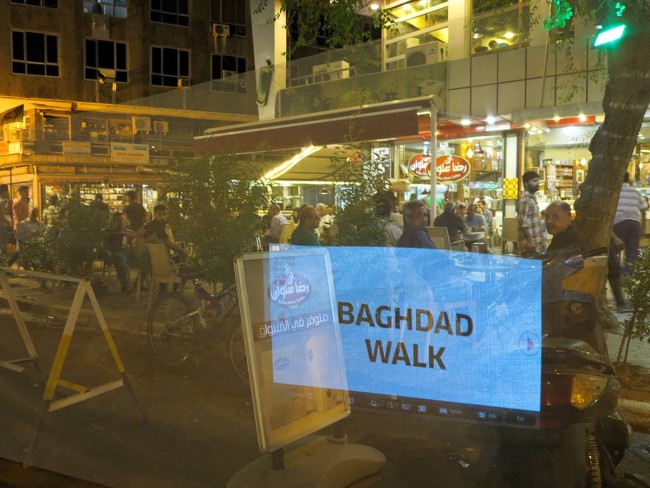
13. Ammar Hussein
Ammar Hussein: Chess (live)In front of Ridha Alwan Coffee
Photo by Christina Werner
Photo by Christina Werner
Photo by Hella Mewis
Photo by Christina Werner
Photo by Christina Werner
Ammar Hussein: Chess (live)In front of Ridha Alwan Coffee
Photo by Christina Werner
Photo by Christina Werner
Photo by Hella Mewis
Photo by Christina Werner
Photo by Christina Werner
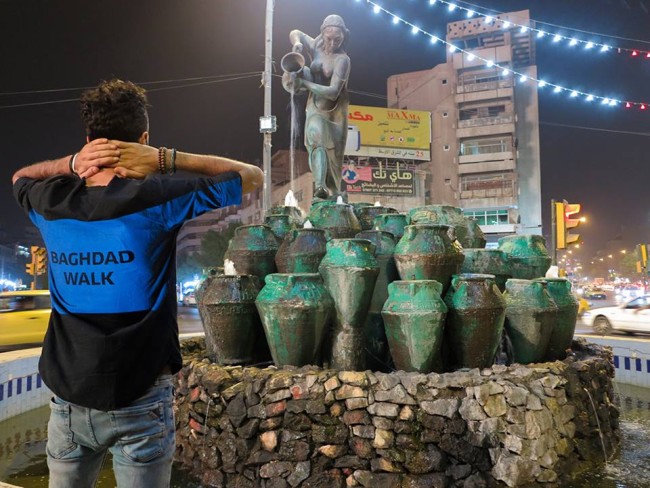
12. Muhaned Taha
Muhaned Taha: How LongAt Kahramana Square
Photo by Yasir Razaq/Mahdi Al-Shididy
Photo by Christina Werner
Photo by Hella Mewis
Photo by Christina Werner
Photo by Christina Werner
Muhaned Taha’s installation consisted of a two-metre-high funnel filled with sand and gravel and three paintings arranged as a triangle. The paintings were crowned with the shape of a brain hovering at the rim of the funnel, tied to a bundle of white balloons. In HOW LONG, Tana talks about the connection between dream and reality. The three paintings resemble different dreams, with scenes oscillating between sweet dreams and nightmares. Taha positioned his installation to be the third object in a second, larger triangle connecting his work to two other significant objects in the nearby cityscape. The installation thereby created a dialogue with the popular Kahramana fountain by Mohammed Ghani Hikmat in Kahramana Square, which shows a figure from the story of Ali Baba and the 40 robbers, and a surveillance tower disguised as a statue shaped like a palm tree. The work created a web of associations of how society and our individual mind sets (as depicted by the literal brain) are influenced and shaped by narrations and memory, and how control evolves.
Muhaned Taha: How LongAt Kahramana Square
Photo by Yasir Razaq/Mahdi Al-Shididy
Photo by Christina Werner
Photo by Hella Mewis
Photo by Christina Werner
Photo by Christina Werner
Muhaned Taha’s installation consisted of a two-metre-high funnel filled with sand and gravel and three paintings arranged as a triangle. The paintings were crowned with the shape of a brain hovering at the rim of the funnel, tied to a bundle of white balloons. In HOW LONG, Tana talks about the connection between dream and reality. The three paintings resemble different dreams, with scenes oscillating between sweet dreams and nightmares. Taha positioned his installation to be the third object in a second, larger triangle connecting his work to two other significant objects in the nearby cityscape. The installation thereby created a dialogue with the popular Kahramana fountain by Mohammed Ghani Hikmat in Kahramana Square, which shows a figure from the story of Ali Baba and the 40 robbers, and a surveillance tower disguised as a statue shaped like a palm tree. The work created a web of associations of how society and our individual mind sets (as depicted by the literal brain) are influenced and shaped by narrations and memory, and how control evolves.

11. Husam Mohammed
Husam Mohammed: ExpressionIn front of the Abu Nawas statue
Photo by Hella Mewis
Photo by Hella Mewis
Photo by Yasir Razaq/Mahdi Al-Shididy
Photo by Hella Mewis
With his participatory work EXPRESSIONS, Husam Mohammed invited the audience to join together in a circle. He then proceeded to address each guest with a personal question, and the participants would answer each question without using words. With EXPRESSIONS, he wanted to challenge the audience and have people rely on their facial expressions, gestures, and body language as a means of communication. Mohammed is very critical of forms of expression used in social media today, such as relying on simplified icons, and he questions what the excessive use of emojis does to our everyday human interactions. The performance took place in front of the Abu Nawas statue, located in the park at the end of the boulevard Abu Nawas. The statue, designed by Ismael Fatteh and erected in 1962, honours the Iraqi poet Abu Nawas (756–814), who was a master of Arabic poetry. In poetry, the complexity and vitality of manifold ways to express human emotions stand in contrast to our reductionist forms of digital communication today. Following the performance, visitors were led back to the street; the exit was marked with a painting of faces on one side that showed lively expressions, and a sculpture resembling a judgment seat on the other side, to remind the visitors that they had the choice.
Husam Mohammed: ExpressionIn front of the Abu Nawas statue
Photo by Hella Mewis
Photo by Hella Mewis
Photo by Yasir Razaq/Mahdi Al-Shididy
Photo by Hella Mewis
With his participatory work EXPRESSIONS, Husam Mohammed invited the audience to join together in a circle. He then proceeded to address each guest with a personal question, and the participants would answer each question without using words. With EXPRESSIONS, he wanted to challenge the audience and have people rely on their facial expressions, gestures, and body language as a means of communication. Mohammed is very critical of forms of expression used in social media today, such as relying on simplified icons, and he questions what the excessive use of emojis does to our everyday human interactions. The performance took place in front of the Abu Nawas statue, located in the park at the end of the boulevard Abu Nawas. The statue, designed by Ismael Fatteh and erected in 1962, honours the Iraqi poet Abu Nawas (756–814), who was a master of Arabic poetry. In poetry, the complexity and vitality of manifold ways to express human emotions stand in contrast to our reductionist forms of digital communication today. Following the performance, visitors were led back to the street; the exit was marked with a painting of faces on one side that showed lively expressions, and a sculpture resembling a judgment seat on the other side, to remind the visitors that they had the choice.
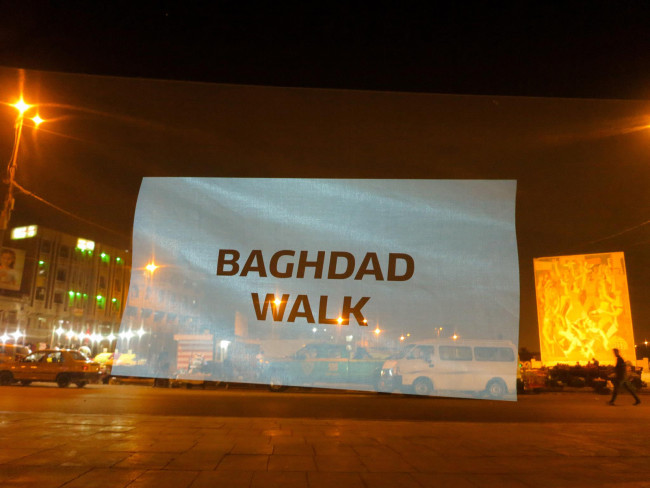
6. Ahmed Al Saad
Ahmed Al Saad: Lady Baghdad. In collaboration with Tabarek Al AtrakchiAt Tayeran Square
Photos by Christina Werner
Ahmed Al Saad: Lady Baghdad. 2018
The video installation LADY BAGHDAD used documentation of an intervention by Ahmed Al Saad in collaboration with Tabarek Al Atrackchi. The pop-art-style video shows a young woman playing the violin in front of the The Freedom Monument, a large-scale mosaic by Faek Hassan at al-Tayaran Square. A guitar player joins the violinist for a spontaneous street concert, while a female artist makes live drawings of the situation. Al Saad’s video captures both the artistic interaction and the urban surroundings and goings-on. For BAGHDAD WALK, Al Saad projected the video at night in front of the monument where the intervention had taken place. Installed on a traffic island, the video screen faced one way, while on the opposite side of the screen, Al Atrackchi installed a canvas with her drawings, capturing the moments of the intervention in another medium. With LADY BAGHDAD, Al Saad wants to encourage women be more present in public life in Baghdad and to increase their visibility in the cityscape. Al-Tayaran Square is an important public space and transportation hub in Baghdad, at the foot of Baghdad’s Alumma Park, opposite Tahrir Square. The mosaic monument Celebration of Victory, by Faek Hassan, erected in the 1960s, is widely visible and depicts a celebrating crowd with women and freed doves. It was the first mosaic in Baghdad representing the people’s desire to live together in peace and harmony. Al Saad references an artwork and a time with a potent emphasis on equality and quality of life.
Ahmed Al Saad: Lady Baghdad. In collaboration with Tabarek Al AtrakchiAt Tayeran Square
Photos by Christina Werner
Ahmed Al Saad: Lady Baghdad. 2018
The video installation LADY BAGHDAD used documentation of an intervention by Ahmed Al Saad in collaboration with Tabarek Al Atrackchi. The pop-art-style video shows a young woman playing the violin in front of the The Freedom Monument, a large-scale mosaic by Faek Hassan at al-Tayaran Square. A guitar player joins the violinist for a spontaneous street concert, while a female artist makes live drawings of the situation. Al Saad’s video captures both the artistic interaction and the urban surroundings and goings-on. For BAGHDAD WALK, Al Saad projected the video at night in front of the monument where the intervention had taken place. Installed on a traffic island, the video screen faced one way, while on the opposite side of the screen, Al Atrackchi installed a canvas with her drawings, capturing the moments of the intervention in another medium. With LADY BAGHDAD, Al Saad wants to encourage women be more present in public life in Baghdad and to increase their visibility in the cityscape. Al-Tayaran Square is an important public space and transportation hub in Baghdad, at the foot of Baghdad’s Alumma Park, opposite Tahrir Square. The mosaic monument Celebration of Victory, by Faek Hassan, erected in the 1960s, is widely visible and depicts a celebrating crowd with women and freed doves. It was the first mosaic in Baghdad representing the people’s desire to live together in peace and harmony. Al Saad references an artwork and a time with a potent emphasis on equality and quality of life.

9. Zaid Saad
Zaid Saad: Sanduk (Box)On the riverbank of Tigris
Photo by Christina Werner
Photo by Christina Werner
Photo by Yasir Razaq/Mahdi Al-Shididy
Photo by Yasir Razaq/Mahdi Al-Shididy
Photo by Hella Mewis
The site-specific installation ZANDUK (the Arabic word for ‘box’) by Zaid Saad was made of eleven cardboard moving boxes. These boxes were stacked and ready to be transported to an unknown destination. They were labelled ‘From Iraq to the Sea’ and featured stencils of transportation symbols that Saad designed to signal: don’t kill them, don’t put them in jail, don’t return to sender. The installation was accompanied by a sound piece wherein the audience would listen to voices of Iraqis who shared stories about those others who had left Iraq because of the war. Saad addresses the wave of migration that has taken away many Iraqis in the last few years. Mostly the younger generations have been sent abroad, in a way similar to what governments all over the world do during wartime with national treasures and artefacts, to keep them safe outside the country. Yet people are often sent from one insecure situation to another, or even to their death. Saad lends his artistic voice to the mourning families who stay behind and lose their loved ones one way or another, ripping society off its future foundation. The installation is positioned on the riverbank of the Tigris, which leads towards the sea. In the background, on the other side of the river, the wall of the so-called International Zone, where the national decision-makers reside, is visible.
Zaid Saad: Sanduk (Box)On the riverbank of Tigris
Photo by Christina Werner
Photo by Christina Werner
Photo by Yasir Razaq/Mahdi Al-Shididy
Photo by Yasir Razaq/Mahdi Al-Shididy
Photo by Hella Mewis
The site-specific installation ZANDUK (the Arabic word for ‘box’) by Zaid Saad was made of eleven cardboard moving boxes. These boxes were stacked and ready to be transported to an unknown destination. They were labelled ‘From Iraq to the Sea’ and featured stencils of transportation symbols that Saad designed to signal: don’t kill them, don’t put them in jail, don’t return to sender. The installation was accompanied by a sound piece wherein the audience would listen to voices of Iraqis who shared stories about those others who had left Iraq because of the war. Saad addresses the wave of migration that has taken away many Iraqis in the last few years. Mostly the younger generations have been sent abroad, in a way similar to what governments all over the world do during wartime with national treasures and artefacts, to keep them safe outside the country. Yet people are often sent from one insecure situation to another, or even to their death. Saad lends his artistic voice to the mourning families who stay behind and lose their loved ones one way or another, ripping society off its future foundation. The installation is positioned on the riverbank of the Tigris, which leads towards the sea. In the background, on the other side of the river, the wall of the so-called International Zone, where the national decision-makers reside, is visible.
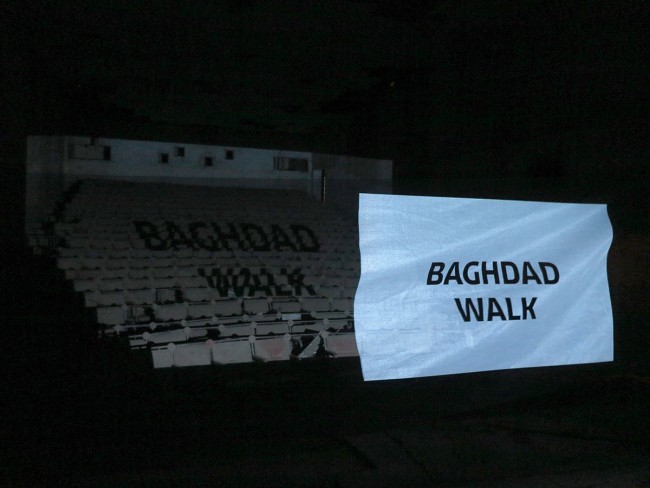
8. Ameen Mokdad
Ameen Mokdad: Sonic InterventionAt Abu Nawas Theater
Photo by Christina Werner
Photo by Hella Mewis
Photo by Yasir Razaq/Mahdi Al-Shididy
Video by Christina Werner
Composer and musician Ameen Mokdad conducted a body-percussion event, using the human body as an instrument to create sounds and vibrations. All participants in the BAGHDAD WALK were invited to join on stage and take part in the performance. The group exercise took place on the stage of the derelict, empty, and unused Abu Nawas Theatre, playing off the architectural features and astounding acoustics of the space. Mokdad is interested in activating social interaction through music; the participants were encouraged to listen to each other, letting the rhythm of their movements fall in sync, creating a small concert with nothing more than an exercise of collaboration. While everyone involved was both on stage and ‘in’ the audience at the same time, they experienced a sense of what the building once was, and what it could be used for again. The Abu Nawas Theatre was once one of the main attractions on the boulevard Abu Nawas, which follows the riverside of the Tigris and mostly used to host film screenings. Because the unresolved property situation today keeps private investors away, the theatre building is currently in the hands of the city administration and mainly used as a waste-disposal site.
Ameen Mokdad: Sonic InterventionAt Abu Nawas Theater
Photo by Christina Werner
Photo by Hella Mewis
Photo by Yasir Razaq/Mahdi Al-Shididy
Video by Christina Werner
Composer and musician Ameen Mokdad conducted a body-percussion event, using the human body as an instrument to create sounds and vibrations. All participants in the BAGHDAD WALK were invited to join on stage and take part in the performance. The group exercise took place on the stage of the derelict, empty, and unused Abu Nawas Theatre, playing off the architectural features and astounding acoustics of the space. Mokdad is interested in activating social interaction through music; the participants were encouraged to listen to each other, letting the rhythm of their movements fall in sync, creating a small concert with nothing more than an exercise of collaboration. While everyone involved was both on stage and ‘in’ the audience at the same time, they experienced a sense of what the building once was, and what it could be used for again. The Abu Nawas Theatre was once one of the main attractions on the boulevard Abu Nawas, which follows the riverside of the Tigris and mostly used to host film screenings. Because the unresolved property situation today keeps private investors away, the theatre building is currently in the hands of the city administration and mainly used as a waste-disposal site.
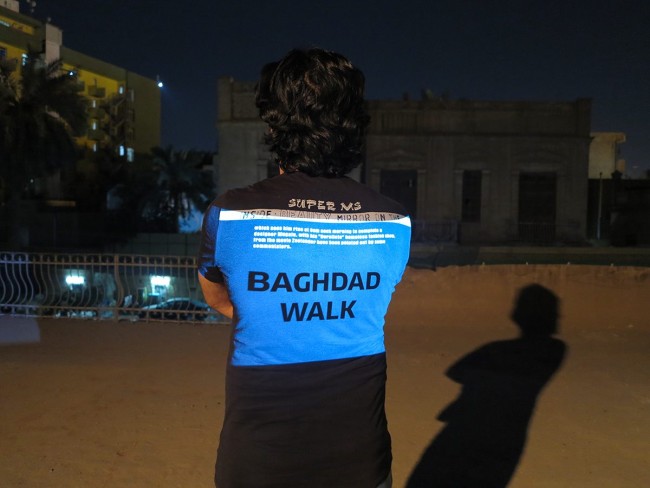
7. Akram Assam
Akram Assam: The History TreeAt Bait Tarkib
Photos by Christina Werner
Photo by Yasir Razaq/Mahdi Al-Shididy
THE HISTORY TREE by Akram Assam was an installation of a tree trunk, and the annual rings on its surface were painted in a variety of colours. Larger coloured ellipses were also drawn into the packed earth surrounding the trunk, resembling planetary orbits. Each coloured ring reflected a historical period of the Republic of Iraq, and the rings on the ground expanded beyond the lifetime of the tree. Each visitor was invited to take a notepad and write down an event that was an important marker in time for them, imagining the relation of the life span of the tree, their individual lifetime, and the historical moment. Placed on the rooftop of the creative arts centre BAIT TARKIB, the tree – when imagined in full growth – seems to blend in with the row of palm trees in the neighbouring yards. It rooted the location of BAIT TARKIB in the neighbourhood and the city’s history. BAIT TARKIB is in a typical Baghdad building, originally a family home that was built in the 1920s, when the Republic of Iraq was founded.
Akram Assam: The History TreeAt Bait Tarkib
Photos by Christina Werner
Photo by Yasir Razaq/Mahdi Al-Shididy
THE HISTORY TREE by Akram Assam was an installation of a tree trunk, and the annual rings on its surface were painted in a variety of colours. Larger coloured ellipses were also drawn into the packed earth surrounding the trunk, resembling planetary orbits. Each coloured ring reflected a historical period of the Republic of Iraq, and the rings on the ground expanded beyond the lifetime of the tree. Each visitor was invited to take a notepad and write down an event that was an important marker in time for them, imagining the relation of the life span of the tree, their individual lifetime, and the historical moment. Placed on the rooftop of the creative arts centre BAIT TARKIB, the tree – when imagined in full growth – seems to blend in with the row of palm trees in the neighbouring yards. It rooted the location of BAIT TARKIB in the neighbourhood and the city’s history. BAIT TARKIB is in a typical Baghdad building, originally a family home that was built in the 1920s, when the Republic of Iraq was founded.

5. Tabarek Al Atrakchi
Tabarek Al Atrakchi: What Is A DreamIn front of the Calouste Gulbenkian Museum/Museum of Modern Art
Photo by Christina Werner
Photo by Anees Amer
Photo by Christina Werner
Photo by Christina Werner
The installation WHAT IS A DREAM by Tabarek Al Atrakchi showed a series of crayon drawings made by street kids, in an installation setting that included an arabana (a kind of wheelbarrow for transporting goods) loaded with water bottles, chewing gum, and cleaning materials – all items that are typically sold by children on the street. Al Atrakchi sought out the children in the city streets and asked them to draw their dreams and to tell her what those dreams were about. WHAT IS A DREAM depicts the hopes and future visions of the children. The dreams range from having a boat to work on the river and becoming a photographer or a doctor to travelling to an island in the turquoise sea. Al Atrakchi criticises child labour and the living conditions of many street kids in Iraq by looking into their wishes for a future that contrasts their everyday situation. She presented her artwork in front of the Museum of Modern Art in Baghdad, the first exhibition space for modern art in Iraq, built in 1962 and also known as ‘The Gulbenkian Hall’. The place embodies a collision of worlds that is typical for Baghdad: the governmental, state-run art museum is located in the midst of a bazaar that gathers small businesses, day labourers, and the poorest of the city, from thieves to street kids. The children’s drawings on the street stand in an imagined dialogue with the art inside the galleries, while they show how far removed one reality is from the other.
Tabarek Al Atrakchi: What Is A DreamIn front of the Calouste Gulbenkian Museum/Museum of Modern Art
Photo by Christina Werner
Photo by Anees Amer
Photo by Christina Werner
Photo by Christina Werner
The installation WHAT IS A DREAM by Tabarek Al Atrakchi showed a series of crayon drawings made by street kids, in an installation setting that included an arabana (a kind of wheelbarrow for transporting goods) loaded with water bottles, chewing gum, and cleaning materials – all items that are typically sold by children on the street. Al Atrakchi sought out the children in the city streets and asked them to draw their dreams and to tell her what those dreams were about. WHAT IS A DREAM depicts the hopes and future visions of the children. The dreams range from having a boat to work on the river and becoming a photographer or a doctor to travelling to an island in the turquoise sea. Al Atrakchi criticises child labour and the living conditions of many street kids in Iraq by looking into their wishes for a future that contrasts their everyday situation. She presented her artwork in front of the Museum of Modern Art in Baghdad, the first exhibition space for modern art in Iraq, built in 1962 and also known as ‘The Gulbenkian Hall’. The place embodies a collision of worlds that is typical for Baghdad: the governmental, state-run art museum is located in the midst of a bazaar that gathers small businesses, day labourers, and the poorest of the city, from thieves to street kids. The children’s drawings on the street stand in an imagined dialogue with the art inside the galleries, while they show how far removed one reality is from the other.
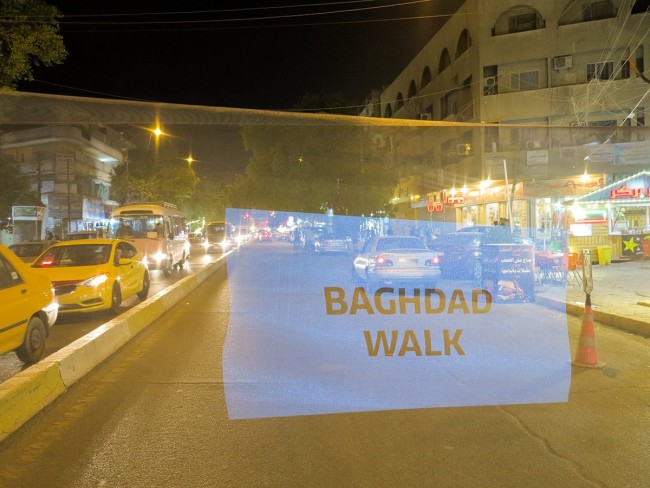
3. Ameen Mokdad
Ameen Mokdad: 1000 Iraqui Lip PrintsAt Karada Ridha Alwan
Photos by Christina Werner
Videos by Christina Werner
Ameen Mokdad collected 1000 empty water bottles that littered the streets of Baghdad with his own hands and formed a large sphere from the waste material. This huge plastic ball was returned to the street, placed in the middle of Karada Dajel in front of Ridha Alwan Café and blocking traffic. 1000 IRAQI LIP PRINTS are 1000 pieces of evidence of polluting crime happening every second in Baghdad, the lip prints tracing back to the very DNA of individual involvement. With his intervention, Mokdad wanted to create awareness of the enormous amount of waste in Baghdad’s streets and how this is influenced by our understanding of which spaces we care for and how habits and responsibility for communal spaces are intertwined. The intervention took place on Karada Dajel, a thriving shopping street at the heart of the city of Karada, in front of the art cafe Ridha Alwan, where socially diverse clientele meet under one roof. The spot seemed ideal for eliciting diverse reactions from a mixed crowd in a quite everyday situation. To Mokdad, it was important that the audience comprised inhabitants of Baghdad, who can achieve change if they want.
Ameen Mokdad: 1000 Iraqui Lip PrintsAt Karada Ridha Alwan
Photos by Christina Werner
Videos by Christina Werner
Ameen Mokdad collected 1000 empty water bottles that littered the streets of Baghdad with his own hands and formed a large sphere from the waste material. This huge plastic ball was returned to the street, placed in the middle of Karada Dajel in front of Ridha Alwan Café and blocking traffic. 1000 IRAQI LIP PRINTS are 1000 pieces of evidence of polluting crime happening every second in Baghdad, the lip prints tracing back to the very DNA of individual involvement. With his intervention, Mokdad wanted to create awareness of the enormous amount of waste in Baghdad’s streets and how this is influenced by our understanding of which spaces we care for and how habits and responsibility for communal spaces are intertwined. The intervention took place on Karada Dajel, a thriving shopping street at the heart of the city of Karada, in front of the art cafe Ridha Alwan, where socially diverse clientele meet under one roof. The spot seemed ideal for eliciting diverse reactions from a mixed crowd in a quite everyday situation. To Mokdad, it was important that the audience comprised inhabitants of Baghdad, who can achieve change if they want.
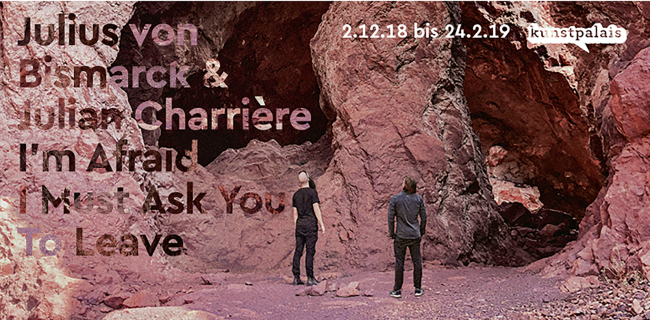
NOWs: I’m afraid I must ask you to leave
I’m afraid I must ask you to leaveJulius von Bismarck and Julian Charrière
Kunstpalais Erlangen
Palais Stutterheim
Marktplatz 1
91054 Erlangen
Opening: Dec 01, 2018
Julian Charrière and Julius von Bismarck are each outstanding artists. They are best friends. And sometimes they are partners in their artistic work. The first major exhibition of these two as a duo will take place at the end of 2018 in the Kunstpalais. Despite the diversity and autonomy of their works, they are united in their claim to initiate an intensive reflection about our relationship to nature and our place in society through their art. Both work at the interface of art and science.
Julian Charrière (* 1987 in Morges, Switzerland) is fascinated by geology and archeology. These however, are not perceived as backward-looking by him: with his works he analyzes the present – and dives deep into the earth. For his large installation at the Venice Biennale 2017 he extracted sediments from the Bolivian salt desert Salar de Uyuni and thus creating a salt-pinned landscape. With these excavations in the salt desert Charrière anticipates excavations at the same site of much greater extent, given that the salt desert is also the world’s largest lithium deposit. And lithium is becoming gradually the most important resource in the digital world. Therefore Charrières Future Fossil Spaces are future archaeologies.
Julius von Bismarck (* 1983 in Breisach am Rhein), who like Julian Charrière was a student of Olafur Eliasson, describes himself as a wannabe physicist. Movement, especially in circles, characterizes many of his works. For the Art Basel Unlimited 2015 for example he created an Egocentric system: he set himself up on a parabolic turntable with a mattress, a desk, a laptop and food and spent the entire duration of the fair in this room in constant motion under the influence of gravity and centrifugal force.
With other works, such as the video Irma To Come In Earnest on the hurricane in Florida, he discusses our dealings with nature and climate change. As an artist, Bismarck regards it as his social responsibility to raise awareness of current topics and problems. In his work series Punishment he did this, for example, by personally whipping legendary places such as the Alps.
When both artists work together, artworks emerge that are equally scientific, sensual, curious, auratic, sophisticated, humorous, and, in the best sense of the word, megalomaniacal.
I’m afraid I must ask you to leaveJulius von Bismarck and Julian Charrière
Kunstpalais Erlangen
Palais Stutterheim
Marktplatz 1
91054 Erlangen
Eröffnung: 1. Dez. 2018
Julius von Bismarck (*1983 in Breisach am Rhein) und Julian Charrière (*1987 in Morges, Schweiz) vereint eine besondere Herangehensweise an das Kunstschaffen: mit Forschungsreisen bis ans Ende der Welt und quasi-naturwissenschaftlichen Experimenten nähern sie sich dem Thema ihres Interesses, um ihren eigenen Hypothesen dazu schließlich in Skulptur, Video oder Fotografie Ausdruck zu geben – humorvoll und bildgewaltig.
Beide arbeiten mit unterschiedlichen Schwerpunkten an der Schnittstelle von Kunst und Wissenschaft. Seit sich Charrière und von Bismarck bei ihrem Studium bei Olafur Eliasson an der Universität der Künste in Berlin kennen lernten, teilen sie sich ein Atelier und sind beste Freunde. Für ausgewählte Projekte finden sie auch in ihrer Arbeit zusammen.
Für ihr Werk Some Pigeons Are More Equal Than Others entwickelten Charrière und von Bismarck eine Maschine, in der Tauben auf öffentlichen Plätzen eingefangen, mit natürlichen Farbstoffen eingefärbt und dann wieder in die Umwelt entlassen wurden. Die Taube, oft als schmutziges oder im besten Fall unscheinbares Tier missachtet, erfährt so nicht nur im wörtlichen Sinne neues Ansehen.
In Ägypten, Deutschland, Island, Mexiko und der Schweiz beschrifteten sie für die Serie Kunst seit 2012 mit einer Art überdimensionalem Graffiti natürliche Orte. Unter anderem die koloniale Geste des Beanspruchens und Benennens von Natur wird implizit thematisiert, wenn Mountain den Berg, Jungle das Blätterdickicht in riesigen Lettern bezeichnet.
Während sie sich in diesen beiden Arbeiten mit menschlichen Eingriffen in die Natur und deren Wirkungen und Aussagen beschäftigen, dreht es sich in ihrer neuesten Arbeit um die symbolische Aufladung einzelner Naturmonumente und die Fetischisierung der Natur: Thounds And Thounds Of Years And Only Now Things Happen entstand anlässlich der Ausstellung im Kunstpalais und ist hier erstmals zu sehen.
Mit ihrem gemeinsamen Œuvre stoßen Julian Charrière und Julius von Bismarck eine intensive Reflexion über unser Verhältnis zur Natur an. Arbeiten beide zusammen, entstehen Werke, die gleichermaßen wissenschaftlich, sinnlich, kurios, auratisch, gelehrt, hintergründig und – im allerbesten Sinne – größenwahnsinnig sind. I’m Afraid I Must Ask You To Leave ist ihre erste große Ausstellung als Duo.
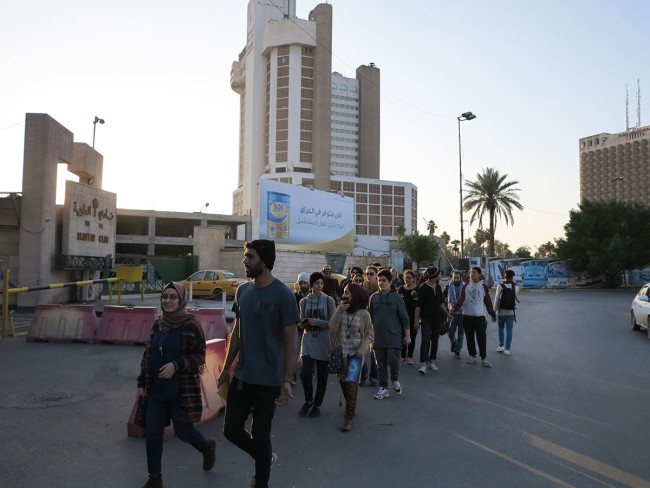
Baghdad Walk – Follow us
The two-day walk started at the Iraqi Independent Film Centre, led along Al Rasheed Street to Midan Square, connected Karada Dajel with Tayeran Square and Tahrir Square; it led from Tarkib Baghdad Contemporary Arts Institute to the Abu Nawas Theater, spread along the Abu Nawas riverside and meandered through Karada neighborhood from Kahramana Square to Ridah Alwan Coffeeshop.
Please find the documentation of each of the artist’s interventions on the following pages.
Photo by Anees Amer
Photo by Anees Amer
Photo by Christina Werner
Photo by Anees Amer
Photo by Yasir Razaq/Mahdi Al-Shididy
Photo by Anees Amer
Photo by Anees Amer
Photo by Yasir Razaq/Mahdi Al-Shididy
Photo by Anees Amer
Photo by Hella Mewis
Photo by Christina Werner
Photo by Hella Mewis
Photo by Yasir Razaq/Mahdi Al-Shididy
Photo by Christina Werner
Photo by Hella Mewis
Photo by Hella Mewis
Photo by Christina Werner
Photo by Hella Mewis
The two-day walk started at the Iraqi Independent Film Centre, led along Al Rasheed Street to Midan Square, connected Karada Dajel with Tayeran Square and Tahrir Square; it led from Tarkib Baghdad Contemporary Arts Institute to the Abu Nawas Theater, spread along the Abu Nawas riverside and meandered through Karada neighborhood from Kahramana Square to Ridah Alwan Coffeeshop.
Please find the documentation of each of the artist’s interventions on the following pages.
Photo by Anees Amer
Photo by Anees Amer
Photo by Christina Werner
Photo by Anees Amer
Photo by Yasir Razaq/Mahdi Al-Shididy
Photo by Anees Amer
Photo by Anees Amer
Photo by Yasir Razaq/Mahdi Al-Shididy
Photo by Anees Amer
Photo by Hella Mewis
Photo by Christina Werner
Photo by Hella Mewis
Photo by Yasir Razaq/Mahdi Al-Shididy
Photo by Christina Werner
Photo by Hella Mewis
Photo by Hella Mewis
Photo by Christina Werner
Photo by Hella Mewis
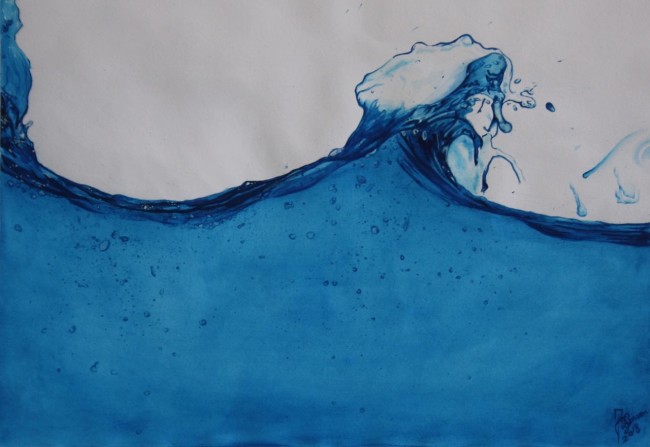
NOWs: Towards a Sentimental Cartography of Water
Towards a Sentimental Cartography of WaterGroup show with Nina Schuiki and Das Numen et. al.
Greatmore Artists Studios
47-49 Greatmore Street Woodstock
Western Cape 7925
South Africa
opening: 28 November 2018, 6pm
Curated by Stefan Vicedom
With Madeleine Bazil // Lizette Chirrime // Das Numen // Denver Jansen // Io Makandal // Koleka Putuma // Nina Schuiki // Dennis Siering
Greatmore Art Studios are glad to invite you to the upcoming group exhibition Towards a Sentimental Cartography of Water.
The effects of the latest water crisis still shape the social, economical and environmental life of Cape Town and the Western Cape. What once was thought to be a finite state of emergency thus more and more becomes a new form of normality. But which attributes define and characterise this labile situation of a new normal? How has the crisis modified the personal and public relation to water? And to what extent can the crisis even serve as a catalyst for change that transforms the negative implications into a positive outlook?
The exhibition Towards a Sentimental Cartography of Water explores these issues through a range of photographic images, drawings, installations and media works by artists based in South Africa and Europe. In an associative way they provide first coordinates for an yet unwritten cartography that describes our far-reaching connectedness with water.
The exhibition is organised by Berlin-based curator Stefan Vicedom who currently participates in the Greatmore Art Studios’ residency programme.
Towards a Sentimental Cartography of WaterGroup show with Nina Schuiki and Das Numen et. al.
Greatmore Artists Studios
47-49 Greatmore Street Woodstock
Western Cape 7925
South Africa
opening: 28 November 2018, 6pm
Curated by Stefan Vicedom
With Madeleine Bazil // Lizette Chirrime // Das Numen // Denver Jansen // Io Makandal // Koleka Putuma // Nina Schuiki // Dennis Siering
Greatmore Art Studios are glad to invite you to the upcoming group exhibition Towards a Sentimental Cartography of Water.
The effects of the latest water crisis still shape the social, economical and environmental life of Cape Town and the Western Cape. What once was thought to be a finite state of emergency thus more and more becomes a new form of normality. But which attributes define and characterise this labile situation of a new normal? How has the crisis modified the personal and public relation to water? And to what extent can the crisis even serve as a catalyst for change that transforms the negative implications into a positive outlook?
The exhibition Towards a Sentimental Cartography of Water explores these issues through a range of photographic images, drawings, installations and media works by artists based in South Africa and Europe. In an associative way they provide first coordinates for an yet unwritten cartography that describes our far-reaching connectedness with water.
The exhibition is organised by Berlin-based curator Stefan Vicedom who currently participates in the Greatmore Art Studios’ residency programme.

4. Loay Al Hadhary
Loay Al Hadhary: Not For SaleAt Tahrir Square
Photo by Yasir Razaq/Mahdi Al-Shididy
Photo by Yasir Razaq/Mahdi Al-Shididy
Photo by Yasir Razaq/Mahdi Al-Shididy
Photo by Anees Amer
Photo by Anees Amer
Photo by Hella Mewis
The sculpture NOT FOR SALE by Loay Al Hadhary shows a Yazidi woman wrapped in plastic foil, which represents the traditional Abaya robe. Underneath the semi-transparent veil, her naked skin is covered with marks, inscriptions of newspaper clippings and symbols that refer to slavery and misuse. Her hands are raised, tearing a chain apart. The statue stands for the fate of thousands of Yazidi women, kidnapped, enslaved, sold, and raped by members of the Islamic State (IS) during the years of genocide of the Yazidi community in Iraq. Al Hadhari positioned the sculpture underneath the Freedom Monument, known as Nasb al-Hurriyah, by sculptor Jawad Saleem and architect Rifat Chadirji, at Tahrir Square (Liberation Square), where people have historically held demonstrations. The monument was unveiled in 1961; it expresses the struggle of the Iraqi people before the 14 July Revolution in 1958 and commemorates the establishment of the Republic of Iraq. The monument symbolises the people’s strife against tyranny, a struggle that hasn’t been put to an end, fought again in the present day. IS has been pursuing a genocidal campaign against the Yazidi of Sinjar in northern Iraq, but to date, no perpetrator has been held accountable for the genocide.
Loay Al Hadhary: Not For SaleAt Tahrir Square
Photo by Yasir Razaq/Mahdi Al-Shididy
Photo by Yasir Razaq/Mahdi Al-Shididy
Photo by Yasir Razaq/Mahdi Al-Shididy
Photo by Anees Amer
Photo by Anees Amer
Photo by Hella Mewis
The sculpture NOT FOR SALE by Loay Al Hadhary shows a Yazidi woman wrapped in plastic foil, which represents the traditional Abaya robe. Underneath the semi-transparent veil, her naked skin is covered with marks, inscriptions of newspaper clippings and symbols that refer to slavery and misuse. Her hands are raised, tearing a chain apart. The statue stands for the fate of thousands of Yazidi women, kidnapped, enslaved, sold, and raped by members of the Islamic State (IS) during the years of genocide of the Yazidi community in Iraq. Al Hadhari positioned the sculpture underneath the Freedom Monument, known as Nasb al-Hurriyah, by sculptor Jawad Saleem and architect Rifat Chadirji, at Tahrir Square (Liberation Square), where people have historically held demonstrations. The monument was unveiled in 1961; it expresses the struggle of the Iraqi people before the 14 July Revolution in 1958 and commemorates the establishment of the Republic of Iraq. The monument symbolises the people’s strife against tyranny, a struggle that hasn’t been put to an end, fought again in the present day. IS has been pursuing a genocidal campaign against the Yazidi of Sinjar in northern Iraq, but to date, no perpetrator has been held accountable for the genocide.
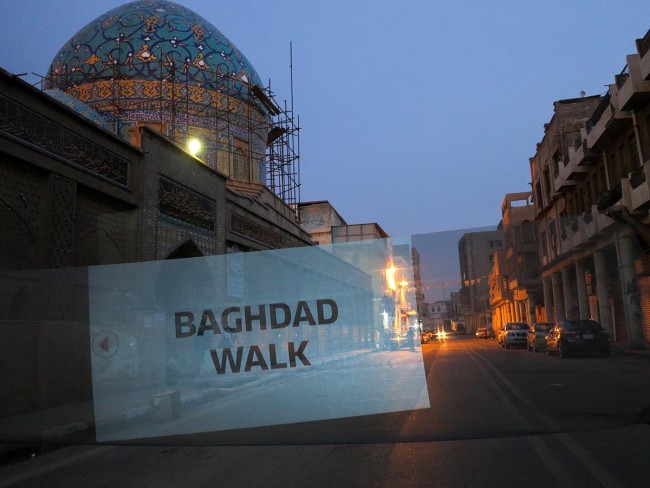
2. Hussain Muttar
Hussain Muttar: 1000 Stories & A StoryAt Al Rasheed Street
Photo by Christina Werner
Photo by Christina Werner
Photo by Yasir Razaq/Mahdi Al-Shididy
Photo by Christina Werner
Photo by Hella Mewis
Photo by Christina Werner
Photos by Christina Werner
Hussain Muttar’s 1000 STORIES AND A STORY is based on his on-going research. He collects historical photographs of Baghdad city views from archives as well as from private households and reconstructs the images in the present day, photographing the same location from the same angles and perspectives. For BAGHDAD WALK, he chose to present comparisons of architectural landscapes, landmarks, and sights in Baghdad. The work juxtaposes past and present, installing large posters of the historical and current photographs of facades and buildings of Al Rasheed Street along that very street, covering a distance of 2.7 kilometres from Zinek Bridge to Midan Square. Muttar’s ambition is to raise awareness of Baghdas architectural heritage and to encourage residents to see their neighbourhood’s rich history. He involves the local community by collecting the photos and stories about the buildings and their use and function, and he depends on the cooperation of residents to access rooftops and sites in order to reconstruct the original perspectives. For BAGHDAD WALK, Muttar chose to present ten sites on Al Rasheed Street, not just to highlight the richness of architectural tradition, but also to emphasise how architecturally and historically valuable treasures dwindle away through human misuse and neglect.
Hussain Muttar: 1000 Stories & A StoryAt Al Rasheed Street
Photo by Christina Werner
Photo by Christina Werner
Photo by Yasir Razaq/Mahdi Al-Shididy
Photo by Christina Werner
Photo by Hella Mewis
Photo by Christina Werner
Photos by Christina Werner
Hussain Muttar’s 1000 STORIES AND A STORY is based on his on-going research. He collects historical photographs of Baghdad city views from archives as well as from private households and reconstructs the images in the present day, photographing the same location from the same angles and perspectives. For BAGHDAD WALK, he chose to present comparisons of architectural landscapes, landmarks, and sights in Baghdad. The work juxtaposes past and present, installing large posters of the historical and current photographs of facades and buildings of Al Rasheed Street along that very street, covering a distance of 2.7 kilometres from Zinek Bridge to Midan Square. Muttar’s ambition is to raise awareness of Baghdas architectural heritage and to encourage residents to see their neighbourhood’s rich history. He involves the local community by collecting the photos and stories about the buildings and their use and function, and he depends on the cooperation of residents to access rooftops and sites in order to reconstruct the original perspectives. For BAGHDAD WALK, Muttar chose to present ten sites on Al Rasheed Street, not just to highlight the richness of architectural tradition, but also to emphasise how architecturally and historically valuable treasures dwindle away through human misuse and neglect.

1. Ammar Hussein
Ammar Hussein: Tree of HeavenAt the Iraqi Independent Film Center (IIFC)
Photo by Yasir Razaq/Mahdi Al-Shididy
Photo by Yasir Razaq/Mahdi Al-Shididy
Photo by Yasir Razaq/Mahdi Al-Shididy
Photo by Yasir Razaq/Mahdi Al-Shididy
Photo by Yasir Razaq/Mahdi Al-Shididy
Photo by Anees Amer
TREE OF HEAVEN by Ammar Hussein presented five montage works combining different types of processed wood on canvas. The works were arranged on the ground, set into the soil of a former yard. Hussain highlights the significance of the medium of wood and its importance to humanity, both in our built environment and in narrative traditions. The installation was presented in the yard of the Iraqi Independent Film Center (IIFC), a shanasheel building constructed in the early 1920s on Al Rasheed Street. The IIFC plays a pioneering role in the independent arts and creative industries in Baghdad. The building is currently under renovation, and its traditional shanasheel features, for instance, the finely crafted bay windows, were once completed with intricate wooden latticework and ornate stained glass, which allow inhabitants to see outside without being seen.
Ammar Hussein: Tree of HeavenAt the Iraqi Independent Film Center (IIFC)
Photo by Yasir Razaq/Mahdi Al-Shididy
Photo by Yasir Razaq/Mahdi Al-Shididy
Photo by Yasir Razaq/Mahdi Al-Shididy
Photo by Yasir Razaq/Mahdi Al-Shididy
Photo by Yasir Razaq/Mahdi Al-Shididy
Photo by Anees Amer
TREE OF HEAVEN by Ammar Hussein presented five montage works combining different types of processed wood on canvas. The works were arranged on the ground, set into the soil of a former yard. Hussain highlights the significance of the medium of wood and its importance to humanity, both in our built environment and in narrative traditions. The installation was presented in the yard of the Iraqi Independent Film Center (IIFC), a shanasheel building constructed in the early 1920s on Al Rasheed Street. The IIFC plays a pioneering role in the independent arts and creative industries in Baghdad. The building is currently under renovation, and its traditional shanasheel features, for instance, the finely crafted bay windows, were once completed with intricate wooden latticework and ornate stained glass, which allow inhabitants to see outside without being seen.
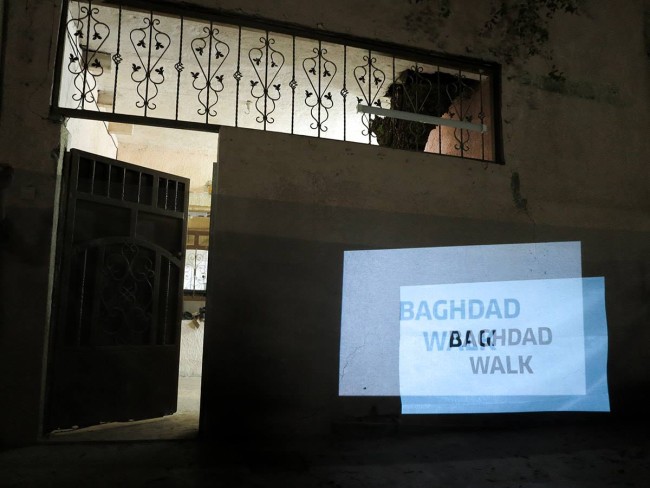
10. Atef Al Jaffal
Atef Al Jaffal: CircleStreet behind Shataa Al Jameel
Photos by Christina Werner
CIRCLE is a mural by Atef Al Jaffal, a young designer who painted a circle on the exterior wall of an ordinary one-family house and integrated eight images on plates, designed in contrasting colours, with the circle. Each design mirrors disputed issues within the Iraqi community. The images are ambivalent: a veiled woman stands for the discrepancy of tradition versus modern life, intertwined hands point to topics of gender and love, walls and roadblocks tackle questions of danger and control. Al Jaffal sees the country of Iraq as one big family. He thinks that to be able to live a normal life, the people should start to learn to respect each other and allow for different ways of being part of a community. The artist chose this ordinary family home in order to render a clear connection between the bonds of family life and how we operate in the larger community – to raise the question of how our domestic intimacies, responsibilities, and behaviour can influence our participation in society as a whole.
Atef Al Jaffal: CircleStreet behind Shataa Al Jameel
Photos by Christina Werner
CIRCLE is a mural by Atef Al Jaffal, a young designer who painted a circle on the exterior wall of an ordinary one-family house and integrated eight images on plates, designed in contrasting colours, with the circle. Each design mirrors disputed issues within the Iraqi community. The images are ambivalent: a veiled woman stands for the discrepancy of tradition versus modern life, intertwined hands point to topics of gender and love, walls and roadblocks tackle questions of danger and control. Al Jaffal sees the country of Iraq as one big family. He thinks that to be able to live a normal life, the people should start to learn to respect each other and allow for different ways of being part of a community. The artist chose this ordinary family home in order to render a clear connection between the bonds of family life and how we operate in the larger community – to raise the question of how our domestic intimacies, responsibilities, and behaviour can influence our participation in society as a whole.
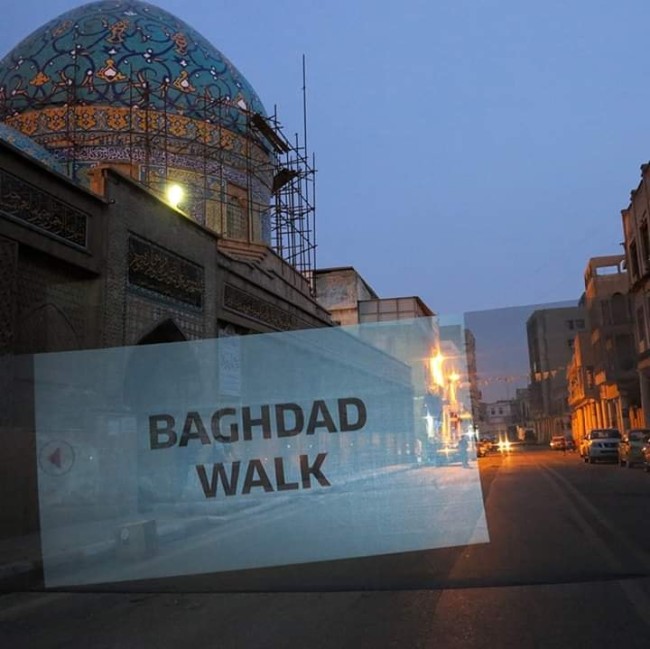
Baghdad Walk I
BAGHDAD WALKGroup exhibition in public space
Baghdad Walk is a group exhibition by emerging Iraqi artists presented in the public space and in different locations in Karada, Baghdad. The walk starts at Iraqi Independent Film Centre, leads along Al Rasheed Street to Midan Square, connects Tayeran Square, Tahrir Square and Kahramana Square, spreads along the Abu Nawas riverside and meanders through Karada neighborhood, featuring time-based works and interventions.
Baghdad Walk is an exhibition and a narrative tour of the city. The participating artists connect their works with the specific locations, introducing background information on site. Manifold stories about the city of Baghdad are told and retold anew through the artists’ perspectives and the encounters they create.
Participants:
Ahmed Al Saad, Tabarek Al Atrakchi, Akram Assam, Ameen Mokdad, Ammar Hussein, Atef Al Jaffal, Hussam Mohammed, Hussain Muttar, Loay Al Hadhary, Muhaned Taha, Zaid Saad.
—
Please find the project’s bilingual (Englisch-Arabic) website here.
—
Baghdad Walk is the result of a workshop series Arts Seminar in Baghdad, conceived and organised by the Goethe-Institut Irak, in collaboration with the Institut für Raumexperimente (Institut for Spatial Experiments), Berlin and hosted by TARKIB Baghdad Contemporary Arts Institute in BAIT TARKIB. Hosted by TARKIB Baghdad Contemporary Arts Institute. Choreographed by Hella Mewis and Christina Werner
BAGHDAD WALKGroup exhibition in public space
Baghdad Walk is a group exhibition by emerging Iraqi artists presented in the public space and in different locations in Karada, Baghdad. The walk starts at Iraqi Independent Film Centre, leads along Al Rasheed Street to Midan Square, connects Tayeran Square, Tahrir Square and Kahramana Square, spreads along the Abu Nawas riverside and meanders through Karada neighborhood, featuring time-based works and interventions.
Baghdad Walk is an exhibition and a narrative tour of the city. The participating artists connect their works with the specific locations, introducing background information on site. Manifold stories about the city of Baghdad are told and retold anew through the artists’ perspectives and the encounters they create.
Participants:
Ahmed Al Saad, Tabarek Al Atrakchi, Akram Assam, Ameen Mokdad, Ammar Hussein, Atef Al Jaffal, Hussam Mohammed, Hussain Muttar, Loay Al Hadhary, Muhaned Taha, Zaid Saad.
—
Please find the project’s bilingual (Englisch-Arabic) website here.
—
Baghdad Walk is the result of a workshop series Arts Seminar in Baghdad, conceived and organised by the Goethe-Institut Irak, in collaboration with the Institut für Raumexperimente (Institut for Spatial Experiments), Berlin and hosted by TARKIB Baghdad Contemporary Arts Institute in BAIT TARKIB. Hosted by TARKIB Baghdad Contemporary Arts Institute. Choreographed by Hella Mewis and Christina Werner
